Table of Contents
- About This Guide
- Accessing the Switch
- Managing System
- Managing Physical Interfaces
- Configuring LAG
- Monitoring Traffic
- Managing MAC Address Table
- Configuring DDM
- Configuring L2PT
- Configuring 802.1Q VLAN
- Configuring MAC VLAN
- Configuring Protocol VLAN
- Configuring VLAN-VPN
- Configuring GVRP
- Configuring Private VLAN
- Configuring Spanning Tree
- Configuring OAM
- Configuring Layer 2 Multicast
- Layer 2 Multicast
- IGMP Snooping Configurations
- Using the GUI
- Configuring IGMP Snooping Globally
- Configuring the Port’s Basic IGMP Snooping Features
- Configuring IGMP Snooping in the VLAN
- Configuring the Multicast VLAN
- (Optional) Configuring the Querier
- Configuring IGMP Profile
- Binding Profile and Member Ports
- Viewing IGMP Statistics on Each Port
- Enabling IGMP Accounting and Authentication
- Configuring Static Member Port
- Using the CLI
- Enabling IGMP Snooping Globally
- Enabling IGMP Snooping on the Port
- Configuring IGMP Snooping Parameters Globally
- Configuring IGMP Snooping Parameters on the Port
- Configuring IGMP Snooping Last Listener Query
- Configuring IGMP Snooping Parameters in the VLAN
- Configuring IGMP Snooping Parameters in the Multicast VLAN
- Configuring the Querier
- Configuring Multicast Filtering
- Enabling IGMP Accounting and Authentication
- Using the GUI
- Configuring MLD Snooping
- Using the GUI
- Configuring MLD Snooping Globally
- Configuring the Port’s Basic MLD Snooping Features
- Configuring MLD Snooping in the VLAN
- Configuring the Multicast VLAN
- (Optional) Configuring the Querier
- Configuring MLD Profile
- Binding Profile and Member Ports
- Viewing MLD Statistics on Each Port
- Configuring Static Member Port
- Using the CLI
- Enabling MLD Snooping Globally
- Enabling MLD Snooping on the Port
- Configuring MLD Snooping Parameters Globally
- Configuring MLD Snooping Parameters on the Port
- Configuring MLD Snooping Last Listener Query
- Configuring MLD Snooping Parameters in the VLAN
- Configuring MLD Snooping Parameters in the Multicast VLAN
- Configuring the Querier
- Configuring Multicast Filtering
- Using the GUI
- Viewing Multicast Snooping Configurations
- Configuration Examples
- Appendix: Default Parameters
- Configuring Logical Interfaces
- Configuring Static Routing
- Configuring DHCP
- Configuring ARP
- Configuring QoS
- Configuring Voice VLAN
- Configuring PoE
- Configuring ACL
- Configuring Network Security
- Network Security
- IP-MAC Binding Configurations
- IPv6-MAC Binding Configurations
- DHCP Snooping Configuration
- DHCPv6 Snooping Configuration
- ARP Inspection Configurations
- ND Detection Configuration
- IP Source Guard Configuration
- DoS Defend Configuration
- 802.1X Configuration
- PPPoE ID-Insertion Configuration
- AAA Configuration
- Configuration Examples
- Appendix: Default Parameters
- Configuring LLDP
- Configuring Maintenance
- Configuring SNMP & RMON
TP-Link T2600G-28TS(TL-SG3424) User Manual
Displayed below is the user manual for T2600G-28TS(TL-SG3424) by TP-Link which is a product in the Network Switches category. This manual has pages.

Configuration Guide
T2600G Series Switches
T2600G-18TS (TL-SG3216) / T2600G-28TS (TL-SG3424)
T2600G-52TS (TL-SG3452) / T2600G-28MPS (TL-SG3424P)
1910012207 REV2.1.1
July 2017

COPYRIGHT & TRADEMARKS
Specifications are subject to change without notice. is a registered trademark
of TP-Link Technologies Co., Ltd. Other brands and product names are trademarks or
registered trademarks of their respective holders.
No part of the specifications may be reproduced in any form or by any means or used to
make any derivative such as translation, transformation, or adaptation without permission
from TP-Link Technologies Co., Ltd. Copyright © 2017 TP-Link Technologies Co., Ltd. All
rights reserved.
http://www.tp-link.com
FCC STATEMENT
This equipment has been tested and found to comply with the limits for a Class A digital
device, pursuant to part 15 of the FCC Rules. These limits are designed to provide
reasonable protection against harmful interference when the equipment is operated in a
commercial environment. This equipment generates, uses, and can radiate radio frequency
energy and, if not installed and used in accordance with the instruction manual, may cause
harmful interference to radio communications. Operation of this equipment in a residential
area is likely to cause harmful interference in which case the user will be required to correct
the interference at his own expense.
This device complies with part 15 of the FCC Rules. Operation is subject to the following
two conditions:
1) This device may not cause harmful interference.
2) This device must accept any interference received, including interference that may
cause undesired operation.
Any changes or modifications not expressly approved by the party responsible for
compliance could void the user’s authority to operate the equipment.
CE Mark Warning
This is a class A product. In a domestic environment, this product may cause radio
interference, in which case the user may be required to take adequate measures.
Industry Canada Statement
CAN ICES-3 (A)/NMB-3(A)

BSMI Notice
安全諮詢及注意事項
•請使用原裝電源供應器或只能按照本產品注明的電源類型使用本產品。
•清潔本產品之前請先拔掉電源線。請勿使用液體、噴霧清潔劑或濕布進行清潔。
•注意防潮,請勿將水或其他液體潑灑到本產品上。
•插槽與開口供通風使用,以確保本產品的操作可靠並防止過熱,請勿堵塞或覆蓋開口。
•請勿將本產品置放於靠近熱源的地方。除非有正常的通風,否則不可放在密閉位置中。
•請不要私自打開機殼,不要嘗試自行維修本產品,請由授權的專業人士進行此項工作。
此為甲類資訊技術設備,于居住環境中使用時,可能會造成射頻擾動,在此種情況下,使用者
會被要求採取某些適當的對策。
限用物質含有情況標示聲明書
產品元件名稱 限用物質及其化學符號
鉛
Pb
鎘
Cd
汞
Hg
六價鉻
CrVI
多溴聯苯
PBB
多溴二苯醚
PBDE
PCB ○ ○ ○ ○ ○ ○
外殼 ○ ○ ○ ○ ○ ○
電源供應板 —○ ○ ○ ○ ○
電源適配器 —○ ○ ○ ○ ○
備考 1. “超出 0.1 wt %”及“超出 0.01 wt %”系指限用物質之百分比含量超出百分比
含量基準值。
備考 2. “○”系指該項限用物質之百分比含量未超出百分比含量基準值。
備考 3. “—”系指該項限用物質為排除項目。
Продукт сертифіковано згідно с правилами системи УкрСЕПРО на відповідність
вимогам нормативних документів та вимогам, що передбачені чинними законодавчими
актами України.

Safety Information
When product has power button, the power button is one of the way to shut off the
product; When there is no power button, the only way to completely shut off power is to
disconnect the product or the power adapter from the power source.
Don’t disassemble the product, or make repairs yourself. You run the risk of electric
shock and voiding the limited warranty. If you need service, please contact us.
Avoid water and wet locations.
Please read and follow the above safety information when operating the device. We cannot
guarantee that no accidents or damage will occur due to improper use of the device.
Please use this product with care and operate at your own risk.
Explanation of the symbols on the product label
Symbol Explanation
AC voltage
Indoor use only
RECYCLING
This product bears the selective sorting symbol for Waste electrical and electronic
equipment (WEEE). This means that this product must be handled pursuant to
European directive 2012/19/EU in order to be recycled or dismantled to minimize
its impact on the environment.
User has the choice to give his product to a competent recycling organization or
to the retailer when he buys a new electrical or electronic equipment.
この装置は、クラスA情報技術装置です。この装置を家庭環境で使用すると電波妨害を引き起こすことがありま
す。この場合には使用者が適切な対策を講ずるよう要求されることがあります。
VCCI-A

CONTENTS
About This Guide
Intended Readers ................................................................................................................................................................1
Conventions ...........................................................................................................................................................................1
More Information .................................................................................................................................................................2
Accessing the Switch
Overview ................................................................................................................................................................................4
Web Interface Access ........................................................................................................................................................5
Login .................................................................................................................................................................................................................5
Save Config Function ..............................................................................................................................................................................6
Disable the Web Server .........................................................................................................................................................................7
Configure the Switch's IP Address and Default Gateway ...................................................................................................8
Command Line Interface Access ............................................................................................................................... 11
Console Login (only for switch with console port) ...............................................................................................................11
Telnet Login ...............................................................................................................................................................................................13
SSH Login ...................................................................................................................................................................................................14
Disable Telnet login ...............................................................................................................................................................................18
Disable SSH login ...................................................................................................................................................................................19
Copy running-config startup-config ............................................................................................................................................19
Change the Switch's IP Address and Default Gateway .....................................................................................................20
Managing System
System .................................................................................................................................................................................. 22
Overview ......................................................................................................................................................................................................22
Supported Features ..............................................................................................................................................................................22
System Info Configurations .......................................................................................................................................... 24
Using the GUI ............................................................................................................................................................................................24
Viewing the System Summary ...........................................................................................................................................24
Specifying the Device Description ..................................................................................................................................26
Setting the System Time ......................................................................................................................................................26
Setting the Daylight Saving Time .....................................................................................................................................28
Specifying the Serial Port Parameter .............................................................................................................................29
Using the CLI .............................................................................................................................................................................................30
Viewing the System Summary ...........................................................................................................................................30

Specifying the Device Description ..................................................................................................................................31
Setting the System Time ......................................................................................................................................................32
Setting the Daylight Saving Time .....................................................................................................................................34
Specifying the Serial Port Parameter .............................................................................................................................36
User Management Configurations ............................................................................................................................. 38
Using the GUI ............................................................................................................................................................................................38
Creating Admin Accounts ....................................................................................................................................................38
Creating Accounts of Other Types .................................................................................................................................39
Using the CLI .............................................................................................................................................................................................41
Creating Admin Accounts ....................................................................................................................................................41
Creating Accounts of Other Types .................................................................................................................................42
System Tools Configurations ...................................................................................................................................... 46
Using the GUI ............................................................................................................................................................................................46
Configuring the Boot File ......................................................................................................................................................46
Restoring the Configuration of the Switch .................................................................................................................47
Backing up the Configuration File ....................................................................................................................................48
Upgrading the Firmware ........................................................................................................................................................48
Configuring Auto Install Function .....................................................................................................................................49
Rebooting the switch ..............................................................................................................................................................50
Configuring the Reboot Schedule ...................................................................................................................................50
Reseting the Switch .................................................................................................................................................................51
Using the CLI .............................................................................................................................................................................................51
Configuring the Boot File ......................................................................................................................................................51
Restoring the Configuration of the Switch .................................................................................................................52
Backing up the Configuration File ....................................................................................................................................53
Upgrading the firmware .........................................................................................................................................................53
Configuring Auto Install Function .....................................................................................................................................54
Rebooting the switch ..............................................................................................................................................................55
Configuring the Reboot Schedule ...................................................................................................................................56
Reseting the Switch .................................................................................................................................................................57
Access Security Configurations ................................................................................................................................. 58
Using the GUI ............................................................................................................................................................................................58
Configuring the Access Control Feature .....................................................................................................................58
Configuring the HTTP Function ........................................................................................................................................60
Configuring the HTTPS Function .....................................................................................................................................61
Configuring the SSH Feature .............................................................................................................................................63
Enabling the Telnet Function ..............................................................................................................................................64
Using the CLI .............................................................................................................................................................................................64

Configuring the Access Control .......................................................................................................................................64
Configuring the HTTP Function ........................................................................................................................................66
Configuring the HTTPS Function .....................................................................................................................................67
Configuring the SSH Feature .............................................................................................................................................69
Enabling the Telnet Function ..............................................................................................................................................72
SDM Template Configuration ....................................................................................................................................... 73
Using the GUI ............................................................................................................................................................................................73
Using the CLI .............................................................................................................................................................................................74
Appendix: Default Parameters ..................................................................................................................................... 76
Managing Physical Interfaces
Physical Interface ............................................................................................................................................................. 80
Overview ......................................................................................................................................................................................................80
Supported Features ..............................................................................................................................................................................80
Basic Parameters Configurations ............................................................................................................................... 81
Using the GUI ............................................................................................................................................................................................81
Using the CLI .............................................................................................................................................................................................82
Port Mirror Configuration ............................................................................................................................................... 85
Using the GUI ............................................................................................................................................................................................85
Using the CLI .............................................................................................................................................................................................87
Port Security Configuration .......................................................................................................................................... 89
Using the GUI ............................................................................................................................................................................................89
Using the CLI .............................................................................................................................................................................................90
Port Isolation Configurations ....................................................................................................................................... 93
Using the GUI ............................................................................................................................................................................................93
Using the CLI .............................................................................................................................................................................................94
Loopback Detection Configuration ........................................................................................................................... 96
Using the GUI ............................................................................................................................................................................................96
Using the CLI .............................................................................................................................................................................................98
Configuration Examples ...............................................................................................................................................100
Example for Port Mirror ....................................................................................................................................................................100
Network Requirements .......................................................................................................................................................100
Configuration Scheme ........................................................................................................................................................100
Using the GUI ............................................................................................................................................................................ 100
Using the CLI ............................................................................................................................................................................102
Example for Port Isolation ...............................................................................................................................................................102
Network Requirements .......................................................................................................................................................102

Configuration Scheme ........................................................................................................................................................103
Using the GUI ............................................................................................................................................................................ 103
Using the CLI ............................................................................................................................................................................104
Example for Loopback Detection...............................................................................................................................................105
Network Requirements .......................................................................................................................................................105
Configuration Scheme ........................................................................................................................................................105
Using the GUI ............................................................................................................................................................................ 105
Using the CLI ............................................................................................................................................................................106
Appendix: Default Parameters ...................................................................................................................................108
Configuring LAG
LAG ....................................................................................................................................................................................... 111
Overview ...................................................................................................................................................................................................111
Supported Features ...........................................................................................................................................................................111
LAG Configuration ..........................................................................................................................................................112
Using the GUI .........................................................................................................................................................................................113
Configuring Load-balancing Algorithm .....................................................................................................................113
Configuring Static LAG or LACP....................................................................................................................................114
Using the CLI ..........................................................................................................................................................................................116
Configuring Load-balancing Algorithm .....................................................................................................................116
Configuring Static LAG or LACP....................................................................................................................................117
Configuration Example .................................................................................................................................................121
Network Requirements .....................................................................................................................................................................121
Configuration Scheme .....................................................................................................................................................................121
Using the GUI .........................................................................................................................................................................................122
Using the CLI ..........................................................................................................................................................................................123
Appendix: Default Parameters ...................................................................................................................................125
Monitoring Traffic
Traffic Monitor .................................................................................................................................................................127
Using the GUI .........................................................................................................................................................................................127
Viewing the Traffic Summary ..........................................................................................................................................127
Viewing the Traffic Statistics in Detail ........................................................................................................................128
Using the CLI ..........................................................................................................................................................................................130
Appendix: Default Parameters ...................................................................................................................................131

Managing MAC Address Table
MAC Address Table .......................................................................................................................................................133
Overview ...................................................................................................................................................................................................133
Supported Features ...........................................................................................................................................................................133
Address Configurations ...............................................................................................................................................135
Using the GUI .........................................................................................................................................................................................135
Adding Static MAC Address Entries ..........................................................................................................................135
Modifying the Aging Time of Dynamic Address Entries...................................................................................137
Adding MAC Filtering Address Entries.......................................................................................................................138
Viewing Address Table Entries ....................................................................................................................................... 138
Using the CLI ..........................................................................................................................................................................................139
Adding Static MAC Address Entries ..........................................................................................................................139
Modifying the Aging Time of Dynamic Address Entries...................................................................................140
Adding MAC Filtering Address Entries.......................................................................................................................141
Security Configurations ...............................................................................................................................................143
Using the GUI .........................................................................................................................................................................................143
Configuring MAC Notification Traps ...........................................................................................................................143
Limiting the Number of MAC Addresses in VLANs ............................................................................................145
Using the CLI ..........................................................................................................................................................................................146
Configuring MAC Notification Traps ...........................................................................................................................146
Limiting the Number of MAC Addresses in VLANs ............................................................................................147
Example for Security Configurations ......................................................................................................................149
Network Requirements .....................................................................................................................................................................149
Configuration Scheme .....................................................................................................................................................................149
Using the GUI .........................................................................................................................................................................................150
Using the CLI ..........................................................................................................................................................................................151
Appendix: Default Parameters ...................................................................................................................................152
Configuring DDM
Overview ............................................................................................................................................................................154
DDM Configuration.........................................................................................................................................................155
Using the GUI .........................................................................................................................................................................................155
Configuring DDM Globally .................................................................................................................................................155
Configuring the Temperature Threshold ..................................................................................................................156
Configuring the Voltage Threshold .............................................................................................................................. 156
Configuring the Bias Current Threshold ...................................................................................................................157
Configuring the Tx Power Threshold ..........................................................................................................................158

Configuring the Rx Power Threshold ..........................................................................................................................159
Viewing DDM Status ............................................................................................................................................................. 159
Using the CLI ..........................................................................................................................................................................................160
Configuring DDM Globally .................................................................................................................................................160
Configuring DDM Shutdown ............................................................................................................................................161
Configuring Temperature Threshold ..........................................................................................................................162
Configuring Voltage Threshold ......................................................................................................................................163
Configuring Bias Current Threshold ............................................................................................................................ 164
Configuring Tx Power Threshold ................................................................................................................................... 166
Configuring Rx Power Threshold ..................................................................................................................................167
Viewing DDM Configuration .............................................................................................................................................168
Viewing DDM Status ............................................................................................................................................................. 169
Appendix: Default Parameters ...................................................................................................................................170
Configuring L2PT
Overview ............................................................................................................................................................................172
L2PT Configuration ........................................................................................................................................................174
Using the GUI .........................................................................................................................................................................................174
Using the CLI ..........................................................................................................................................................................................175
Configuration Example .................................................................................................................................................178
Network Requirements .....................................................................................................................................................................178
Configuration Scheme .....................................................................................................................................................................178
Using the GUI .........................................................................................................................................................................................178
Using the CLI ..........................................................................................................................................................................................179
Appendix: Default Parameters ...................................................................................................................................181
Configuring 802.1Q VLAN
Overview ...........................................................................................................................................................................183
802.1Q VLAN Configuration .......................................................................................................................................184
Using the GUI .........................................................................................................................................................................................184
Configuring the PVID of the Port ...................................................................................................................................184
Configuring the VLAN .......................................................................................................................................................... 186
Using the CLI ..........................................................................................................................................................................................187
Creating a VLAN .....................................................................................................................................................................187
Configuring the Port .............................................................................................................................................................188
Adding the Port to the Specified VLAN .....................................................................................................................189
Configuration Example .................................................................................................................................................191

Network Requirements .....................................................................................................................................................................191
Configuration Scheme .....................................................................................................................................................................191
Network Topology ...............................................................................................................................................................................192
Using the GUI .........................................................................................................................................................................................192
Using the CLI ..........................................................................................................................................................................................195
Appendix: Default Parameters ..................................................................................................................................197
Configuring MAC VLAN
Overview ............................................................................................................................................................................199
MAC VLAN Configuration ............................................................................................................................................200
Using the GUI .........................................................................................................................................................................................200
Configuring 802.1Q VLAN ................................................................................................................................................200
Binding the MAC Address to the VLAN .....................................................................................................................201
Enabling MAC VLAN for the Port ................................................................................................................................... 201
Using the CLI ..........................................................................................................................................................................................202
Configuring 802.1Q VLAN ................................................................................................................................................202
Binding the MAC Address to the VLAN .....................................................................................................................202
Enabling MAC VLAN for the Port ................................................................................................................................... 203
Configuration Example ................................................................................................................................................205
Network Requirements .....................................................................................................................................................................205
Configuration Scheme .....................................................................................................................................................................205
Using the GUI .........................................................................................................................................................................................206
Using the CLI ..........................................................................................................................................................................................210
Appendix: Default Parameters ...................................................................................................................................213
Configuring Protocol VLAN
Overview ............................................................................................................................................................................215
Protocol VLAN Configuration.....................................................................................................................................216
Using the GUI .........................................................................................................................................................................................216
Configuring 802.1Q VLAN ................................................................................................................................................216
Creating Protocol Template ............................................................................................................................................217
Configuring Protocol VLAN ............................................................................................................................................. 218
Using the CLI ..........................................................................................................................................................................................218
Configuring 802.1Q VLAN ................................................................................................................................................218
Creating a Protocol Template ......................................................................................................................................... 219
Configuring Protocol VLAN ..............................................................................................................................................220
Configuration Example ................................................................................................................................................222

Network Requirements .....................................................................................................................................................................222
Configuration Scheme .....................................................................................................................................................................222
Using the GUI .........................................................................................................................................................................................223
Using the CLI ..........................................................................................................................................................................................229
Appendix: Default Parameters ...................................................................................................................................234
Configuring VLAN-VPN
VLAN-VPN .........................................................................................................................................................................236
Overview ...................................................................................................................................................................................................236
Supported Features ...........................................................................................................................................................................237
Basic VLAN-VPN Configuration ................................................................................................................................238
Using the GUI .........................................................................................................................................................................................238
Configuring 802.1Q VLAN ................................................................................................................................................238
Configuring Global VLAN-VPN and Up-link Ports ................................................................................................ 239
Configuring VPN Ports ........................................................................................................................................................240
Using the CLI ..........................................................................................................................................................................................240
Configuring 802.1Q VLAN ................................................................................................................................................240
Configuring Basic VLAN-VPN .........................................................................................................................................241
Flexible VLAN-VPN Configuration ............................................................................................................................244
Using the GUI .........................................................................................................................................................................................244
Using the CLI ..........................................................................................................................................................................................245
Configuration Example .................................................................................................................................................247
Network Requirements .....................................................................................................................................................................247
Configuration Scheme .....................................................................................................................................................................247
Using the GUI .........................................................................................................................................................................................248
Using the CLI ..........................................................................................................................................................................................252
Appendix: Default Parameters ...................................................................................................................................255
Configuring GVRP
Overview ............................................................................................................................................................................257
GVRP Configuration .......................................................................................................................................................258
Using the GUI .........................................................................................................................................................................................258
Using the CLI ..........................................................................................................................................................................................260
Configuration Example .................................................................................................................................................263
Network Requirements .....................................................................................................................................................................263
Configuration Scheme .....................................................................................................................................................................263
Using the GUI .........................................................................................................................................................................................264

Using the CLI ..........................................................................................................................................................................................267
Appendix: Default Parameters ...................................................................................................................................271
Configuring Private VLAN
Overview ............................................................................................................................................................................273
Private VLAN Configurations .....................................................................................................................................275
Using the GUI .........................................................................................................................................................................................275
Creating Private VLAN.........................................................................................................................................................275
Configuring the Up-link Port ............................................................................................................................................276
Configuring the Down-link Port ......................................................................................................................................277
Using the CLI ..........................................................................................................................................................................................278
Creating Private VLAN.........................................................................................................................................................278
Configuring the Up-link Port ............................................................................................................................................280
Configuring the Down-link Port ......................................................................................................................................281
Configuration Example .................................................................................................................................................283
Network Requirements .....................................................................................................................................................................283
Configuration Scheme .....................................................................................................................................................................283
Network Topology ...............................................................................................................................................................................283
Using the GUI .........................................................................................................................................................................................284
Using the CLI ..........................................................................................................................................................................................286
Appendix: Default Parameters ...................................................................................................................................289
Configuring Spanning Tree
Spanning Tree ..................................................................................................................................................................291
Overview ...................................................................................................................................................................................................291
Basic Concepts ....................................................................................................................................................................................291
STP/RSTP Concepts ............................................................................................................................................................ 291
MSTP Concepts .....................................................................................................................................................................295
STP Security ...........................................................................................................................................................................................296
STP/RSTP Configurations ...........................................................................................................................................299
Using the GUI .........................................................................................................................................................................................299
Configuring STP/RSTP Parameters on Ports ......................................................................................................... 299
Configuring STP/RSTP Globally .....................................................................................................................................301
Verifying the STP/RSTP Configurations .................................................................................................................... 303
Using the CLI ..........................................................................................................................................................................................304
Configuring STP/RSTP Parameters on Ports ......................................................................................................... 304
Configuring Global STP/RSTP Parameters .............................................................................................................306

Enabling STP/RSTP Globally ............................................................................................................................................307
MSTP Configurations ....................................................................................................................................................309
Using the GUI .........................................................................................................................................................................................309
Configuring Parameters on Ports in CIST ................................................................................................................309
Configuring the MSTP Region ........................................................................................................................................311
Configuring MSTP Globally ............................................................................................................................................... 316
Verifying the MSTP Configurations .............................................................................................................................318
Using the CLI ..........................................................................................................................................................................................319
Configuring Parameters on Ports in CIST ................................................................................................................319
Configuring the MSTP Region .......................................................................................................................................321
Configuring Global MSTP Parameters .......................................................................................................................324
Enabling Spanning Tree Globally...................................................................................................................................326
STP Security Configurations ......................................................................................................................................329
Using the GUI .........................................................................................................................................................................................329
Configuring the STP Security .......................................................................................................................................... 329
(Optional) Configuring the Threshold and TC Protect Cycle ......................................................................... 330
Using the CLI ..........................................................................................................................................................................................331
Configuring the STP Security .......................................................................................................................................... 331
Configuring the TC Protect ..............................................................................................................................................333
Configuration Example for MSTP .............................................................................................................................335
Network Requirements .....................................................................................................................................................................335
Configuration Scheme .....................................................................................................................................................................335
Using the GUI .........................................................................................................................................................................................336
Using the CLI ..........................................................................................................................................................................................347
Appendix: Default Parameters ...................................................................................................................................354
Configuring OAM
Ethernet OAM ................................................................................................................................................................... 357
Overview ...................................................................................................................................................................................................357
Supported Features ...........................................................................................................................................................................358
Ethernet OAM Configurations ....................................................................................................................................361
Using the GUI .........................................................................................................................................................................................361
Enabling OAM and Configuring OAM Mode ...........................................................................................................361
Configuring Link Monitoring ............................................................................................................................................. 362
Configuring RFI ........................................................................................................................................................................364
Configuring Remote Loopback ...................................................................................................................................... 365
Viewing OAM Status ............................................................................................................................................................. 366

Using the CLI ..........................................................................................................................................................................................368
Enabling OAM and Configuring OAM Mode ...........................................................................................................368
Configuring Link Monitoring ............................................................................................................................................. 369
Configuring Remote Failure Indication ....................................................................................................................... 375
Configuring Remote Loopback ...................................................................................................................................... 376
Verifying OAM Connection ............................................................................................................................................... 377
Viewing OAM Statistics ................................................................................................................................................380
Using the GUI .........................................................................................................................................................................................380
Viewing OAMPDUs ................................................................................................................................................................ 380
Viewing Event Logs...............................................................................................................................................................382
Using the CLI ..........................................................................................................................................................................................383
Viewing OAMPDUs ................................................................................................................................................................ 383
Viewing Event Logs...............................................................................................................................................................385
Configuration Example .................................................................................................................................................387
Network Requirements .....................................................................................................................................................................387
Configuration Scheme ........................................................................................................................................................387
Using the GUI ............................................................................................................................................................................ 387
Using the CLI ............................................................................................................................................................................392
Appendix: Default Parameters ...................................................................................................................................397
Configuring Layer 2 Multicast
Layer 2 Multicast .............................................................................................................................................................399
Overview ...................................................................................................................................................................................................399
Supported Layer 2 Multicast Protocols ..................................................................................................................................400
IGMP Snooping Configurations ................................................................................................................................. 401
Using the GUI .........................................................................................................................................................................................401
Configuring IGMP Snooping Globally .........................................................................................................................401
Enabling IGMP Snooping Globally ................................................................................................................401
(Optional) Configuring Unknown Multicast ..............................................................................................401
(Optional) Configuring Report Message Suppression ......................................................................402
Configuring Router Port Time and Member Port Time ..................................................................... 402
Configuring IGMP Snooping Last Listener Query ...............................................................................403
Verifying IGMP Snooping Status ................................................................................................................... 403
Configuring the Port’s Basic IGMP Snooping Features....................................................................................404
Enabling IGMP Snooping on the Port .........................................................................................................404
(Optional) Configuring Fast Leave ................................................................................................................404
Configuring IGMP Snooping in the VLAN .................................................................................................................405

Configuring IGMP Snooping Globally in the VLAN .............................................................................. 405
(Optional) Configuring the Static Router Ports in the VLAN ..........................................................406
(Optional) Configuring the Forbidden Router Ports in the VLAN ................................................406
Configuring the Multicast VLAN ....................................................................................................................................406
Creating Multicast VLAN and Configuring Basic Settings .............................................................. 407
(Optional) Creating Replace Source IP ......................................................................................................408
Viewing Dynamic Router Ports in the Multicast VLAN ...................................................................... 408
(Optional) Configuring the Static Router Ports ...................................................................................... 408
(Optional) Configuring the Forbidden Router Ports ............................................................................ 408
(Optional) Configuring the Querier ................................................................................................................................ 409
Configuring the Querier ...................................................................................................................................... 409
Viewing Settings of IGMP Querier ................................................................................................................409
Configuring IGMP Profile .................................................................................................................................................... 410
Creating Profile .......................................................................................................................................................410
Searching Profile ....................................................................................................................................................410
Editing IP Range of the Profile ........................................................................................................................411
Binding Profile and Member Ports ................................................................................................................................ 411
Binding Profile and Member Ports ...............................................................................................................412
Configuring Max Groups a Port Can Join.................................................................................................412
Viewing IGMP Statistics on Each Port ........................................................................................................................413
Configuring Auto Refresh .................................................................................................................................413
Viewing IGMP Statistics .....................................................................................................................................414
Enabling IGMP Accounting and Authentication .................................................................................................... 414
Configuring IGMP Accounting Globally .....................................................................................................415
Configuring IGMP Authentication on the Port .......................................................................................415
Configuring Static Member Port ....................................................................................................................................415
Configuring Static Member Port ...................................................................................................................416
Viewing IGMP Static Multicast Groups ......................................................................................................416
Using the CLI ..........................................................................................................................................................................................417
Enabling IGMP Snooping Globally ................................................................................................................................417
Enabling IGMP Snooping on the Port .........................................................................................................................417
Configuring IGMP Snooping Parameters Globally ..............................................................................................418
Configuring Report Message Suppression ............................................................................................418
Configuring Unknown Multicast ....................................................................................................................419
Configuring IGMP Snooping Parameters on the Port .......................................................................................420
Configuring Router Port Time and Member Port Time ..................................................................... 420
Configuring Fast Leave ......................................................................................................................................421
Configuring Max Group and Overflow Action on the Port ..............................................................422

Configuring IGMP Snooping Last Listener Query ...............................................................................................423
Configuring IGMP Snooping Parameters in the VLAN ......................................................................................425
Configuring Router Port Time and Member Port Time ..................................................................... 425
Configuring Static Router Port .......................................................................................................................426
Configuring Forbidden Router Port .............................................................................................................427
Configuring Static Multicast (Multicast IP and Forward Port)........................................................428
Configuring IGMP Snooping Parameters in the Multicast VLAN ................................................................428
Configuring Router Port Time and Member Port Time ..................................................................... 428
Configuring Static Router Port .......................................................................................................................429
Configuring Forbidden Router Port .............................................................................................................430
Configuring Replace Source IP ......................................................................................................................431
Configuring the Querier ......................................................................................................................................................432
Enabling IGMP Querier ........................................................................................................................................432
Configuring Query Interval, Max Response Time and General Query Source IP ...............433
Configuring Multicast Filtering ........................................................................................................................................ 434
Creating Profile .......................................................................................................................................................434
Binding Profile to the Port .................................................................................................................................435
Enabling IGMP Accounting and Authentication .................................................................................................... 437
Enabling IGMP Authentication on the Port ..............................................................................................437
Enabling IGMP Accounting Globally ............................................................................................................438
Configuring MLD Snooping.........................................................................................................................................439
Using the GUI .........................................................................................................................................................................................439
Configuring MLD Snooping Globally ...........................................................................................................................439
Enabling MLD Snooping Globally..................................................................................................................439
(Optional) Configuring Unknown Multicast ..............................................................................................439
(Optional) Configuring Report Message Suppression ......................................................................440
Configuring Router Port Time and Member Port Time ..................................................................... 440
Configuring MLD Snooping Last Listener Query ................................................................................. 441
Verifying MLD Snooping Status ....................................................................................................................441
Configuring the Port’s Basic MLD Snooping Features .....................................................................................442
Enabling MLD Snooping on the Port ..........................................................................................................442
(Optional) Configuring Fast Leave ................................................................................................................442
Configuring MLD Snooping in the VLAN ..................................................................................................................443
Configuring MLD Snooping Globally in the VLAN ...............................................................................443
(Optional) Configuring the Static Router Ports in the VLAN ..........................................................444
(Optional) Configuring the Forbidden Router Ports in the VLAN ................................................444
Configuring the Multicast VLAN ....................................................................................................................................444
Creating Multicast VLAN and Configuring Basic Settings .............................................................. 445

(Optional) Creating Replace Source IP ......................................................................................................446
Viewing Dynamic Router Ports in the Multicast VLAN ...................................................................... 446
(Optional) Configuring the Static Router Ports ...................................................................................... 446
(Optional) Configuring the Forbidden Router Ports ............................................................................ 446
(Optional) Configuring the Querier ................................................................................................................................ 447
Configuring the Querier ...................................................................................................................................... 447
Viewing Settings of MLD Querier .................................................................................................................. 447
Configuring MLD Profile .....................................................................................................................................................448
Creating Profile .......................................................................................................................................................448
Searching Profile ....................................................................................................................................................448
Editing IP Range of the Profile ........................................................................................................................449
Binding Profile and Member Ports ................................................................................................................................ 450
Binding Profile and Member Ports ...............................................................................................................450
Configuring Max Groups a Port Can Join.................................................................................................451
Viewing MLD Statistics on Each Port .........................................................................................................................452
Configuring Auto Refresh .................................................................................................................................452
Viewing MLD Statistics .......................................................................................................................................452
Configuring Static Member Port ....................................................................................................................................453
Configuring Static Member Port ...................................................................................................................453
Viewing MLD Static Multicast Groups ........................................................................................................ 453
Using the CLI ..........................................................................................................................................................................................454
Enabling MLD Snooping Globally ..................................................................................................................................454
Enabling MLD Snooping on the Port ........................................................................................................................... 454
Configuring MLD Snooping Parameters Globally ................................................................................................455
Configuring Report Message Suppression ............................................................................................455
Configuring Unknown Multicast ....................................................................................................................456
Configuring MLD Snooping Parameters on the Port ......................................................................................... 457
Configuring Router Port Time and Member Port Time ..................................................................... 457
Configuring Fast Leave ......................................................................................................................................458
Configuring Max Group and Overflow Action on the Port ..............................................................459
Configuring MLD Snooping Last Listener Query .................................................................................................460
Configuring MLD Snooping Parameters in the VLAN .......................................................................................461
Configuring Router Port Time and Member Port Time ..................................................................... 461
Configuring Static Router Port .......................................................................................................................462
Configuring Forbidden Router Port .............................................................................................................463
Configuring Static Multicast (Multicast IP and Forward Port)........................................................464
Configuring MLD Snooping Parameters in the Multicast VLAN ..................................................................465
Configuring Router Port Time and Member Port Time ..................................................................... 465

Configuring Static Router Port .......................................................................................................................466
Configuring Forbidden Router Port .............................................................................................................467
Configuring Replace Source IP ......................................................................................................................468
Configuring the Querier ......................................................................................................................................................469
Enabling MLD Querier .........................................................................................................................................469
Configuring Query Interval, Max Response Time and General Query Source IP ...............470
Configuring Multicast Filtering ........................................................................................................................................ 471
Creating Profile .......................................................................................................................................................471
Binding Profile to the Port .................................................................................................................................472
Viewing Multicast Snooping Configurations ........................................................................................................474
Using the GUI .........................................................................................................................................................................................474
Viewing IPv4 Multicast Snooping Configurations ................................................................................................474
Viewing IPv6 Multicast Snooping Configurations ................................................................................................475
Using the CLI ..........................................................................................................................................................................................475
Viewing IPv4 Multicast Snooping Configurations ................................................................................................475
Viewing IPv6 Multicast Snooping Configurations ................................................................................................476
Configuration Examples ...............................................................................................................................................478
Example for Configuring Basic IGMP Snooping .................................................................................................................478
Network Requirements .......................................................................................................................................................478
Configuration Scheme ........................................................................................................................................................478
Using the GUI ............................................................................................................................................................................ 479
Using the CLI ............................................................................................................................................................................482
Example for Configuring Multicast VLAN ...............................................................................................................................484
Network Requirements .......................................................................................................................................................484
Configuration Scheme ........................................................................................................................................................484
Network Topology .................................................................................................................................................................484
Using the GUI ............................................................................................................................................................................ 485
Using the CLI ............................................................................................................................................................................488
Example for Configuring Unknown Multicast and Fast Leave ....................................................................................490
Network Requirement .......................................................................................................................................................... 490
Configuration Scheme ........................................................................................................................................................491
Using the GUI ............................................................................................................................................................................ 491
Using the CLI ............................................................................................................................................................................494
Example for Configuring Multicast Filtering ..........................................................................................................................495
Network Requirements .......................................................................................................................................................495
Configuration Scheme ........................................................................................................................................................495
Network Topology .................................................................................................................................................................495
Using the GUI ............................................................................................................................................................................ 496

Using the CLI ............................................................................................................................................................................503
Appendix: Default Parameters ..................................................................................................................................506
Default Parameters for IGMP Snooping .................................................................................................................................506
Default Parameters for MLD Snooping ...................................................................................................................................507
Configuring Logical Interfaces
Overview ............................................................................................................................................................................510
Logical Interfaces Configurations ............................................................................................................................511
Using the GUI .........................................................................................................................................................................................511
Creating a Layer 3 Interface ............................................................................................................................................. 511
Configuring IPv4 Parameters of the Interface .......................................................................................................512
Configuring IPv6 Parameters of the Interface .......................................................................................................513
Viewing Detail Information of the Interface .............................................................................................................516
Using the CLI ..........................................................................................................................................................................................516
Creating a Layer 3 Interface ............................................................................................................................................. 516
Configuring IPv4 Parameters of the Interface .......................................................................................................518
Configuring IPv6 Parameters of the Interface .......................................................................................................519
Appendix: Default Parameters ...................................................................................................................................522
Configuring Static Routing
Overview ............................................................................................................................................................................524
IPv4 Static Routing Configuration ............................................................................................................................525
Using the GUI .........................................................................................................................................................................................525
Using the CLI ..........................................................................................................................................................................................526
IPv6 Static Routing Configuration ............................................................................................................................527
Using the GUI .........................................................................................................................................................................................527
Using the CLI ..........................................................................................................................................................................................528
Viewing Routing Table ..................................................................................................................................................530
Using the GUI .........................................................................................................................................................................................530
Viewing IPv4 Routing Table ..............................................................................................................................................530
Viewing IPv6 Routing Table ..............................................................................................................................................531
Using the CLI ..........................................................................................................................................................................................531
Viewing IPv4 Routing Table ..............................................................................................................................................531
Viewing IPv6 Routing Table ..............................................................................................................................................532
Example for Static Routing .......................................................................................................................................... 533
Network Requirements .....................................................................................................................................................................533
Configuration Scheme .....................................................................................................................................................................533

Using the GUI .........................................................................................................................................................................................533
Using the CLI ..........................................................................................................................................................................................534
Appendix: Default Parameter .....................................................................................................................................537
Configuring DHCP
DHCP ...................................................................................................................................................................................539
Overview ...................................................................................................................................................................................................539
Supported Features ...........................................................................................................................................................................539
DHCP Server Configuration ........................................................................................................................................ 543
Using the GUI .........................................................................................................................................................................................543
Enabling DHCP Server ........................................................................................................................................................543
Configuring DHCP Server Pool ......................................................................................................................................545
Configuring Manual Binding .............................................................................................................................................546
Using the CLI ..........................................................................................................................................................................................548
Enabling DHCP Server ........................................................................................................................................................548
Configuring DHCP Server Pool ......................................................................................................................................550
Configuring Manual Binding .............................................................................................................................................553
DHCP Client Configuration ..........................................................................................................................................555
Using the GUI .........................................................................................................................................................................................555
Using the CLI ..........................................................................................................................................................................................556
DHCP Relay Configuration ..........................................................................................................................................558
Using the GUI .........................................................................................................................................................................................558
Enabling DHCP Relay and Configuring Option 82 ...............................................................................................558
Specifying DHCP Server for the Interface or VLAN ...........................................................................................559
Using the CLI ..........................................................................................................................................................................................561
Enabling DHCP Relay ...........................................................................................................................................................561
(Optional) Configuring Option 82 ..................................................................................................................................562
Specifying DHCP Server for Interface or VLAN ....................................................................................................563
Configuration Examples ...............................................................................................................................................567
Example for DHCP Server ...............................................................................................................................................................567
Network Requirements .......................................................................................................................................................567
Configuration Scheme ........................................................................................................................................................567
Using the GUI ............................................................................................................................................................................ 567
Using the CLI ............................................................................................................................................................................570
Example for DHCP Interface Relay ............................................................................................................................................571
Network Requirements .......................................................................................................................................................571
Configuration Scheme ........................................................................................................................................................571

Using the GUI ............................................................................................................................................................................ 572
Using the CLI ............................................................................................................................................................................573
Appendix: Default Parameters ...................................................................................................................................575
Configuring ARP
Overview ............................................................................................................................................................................580
ARP Configurations ........................................................................................................................................................ 581
Using the GUI .........................................................................................................................................................................................581
Viewing the ARP Entries .....................................................................................................................................................581
Adding Static ARP Entries Manually ............................................................................................................................582
Using the CLI ..........................................................................................................................................................................................582
Configuring ARP Function ................................................................................................................................................. 582
Configuring QoS
QoS .......................................................................................................................................................................................587
Overview ...................................................................................................................................................................................................587
Supported Features ...........................................................................................................................................................................587
DiffServ Configuration ..................................................................................................................................................588
Using the GUI .........................................................................................................................................................................................589
Configuring Priority Mode .................................................................................................................................................589
Configuring Schedule Mode ............................................................................................................................................592
Using CLI ..................................................................................................................................................................................................593
Configuring Priority Mode .................................................................................................................................................593
Configuring Schedule Mode ............................................................................................................................................598
Bandwidth Control Configuration .............................................................................................................................601
Using the GUI .........................................................................................................................................................................................601
Configuring Rate Limit .........................................................................................................................................................601
Configuring Storm Control ...............................................................................................................................................602
Using the CLI ..........................................................................................................................................................................................604
Configuring Rate Limit on Port .......................................................................................................................................604
Configuring Storm Control ...............................................................................................................................................605
Configuration Examples ...............................................................................................................................................608
Example for Configuring SP Mode .............................................................................................................................................608
Network Requirements .......................................................................................................................................................608
Configuration Scheme ........................................................................................................................................................608
Using the GUI ............................................................................................................................................................................ 609
Using the CLI ............................................................................................................................................................................610

Example for Configuring WRR Mode ........................................................................................................................................611
Network Requirements .......................................................................................................................................................611
Configuration Scheme ........................................................................................................................................................612
Using the GUI ............................................................................................................................................................................ 612
Using the CLI ............................................................................................................................................................................619
Appendix: Default Parameters ...................................................................................................................................624
Configuring Voice VLAN
Overview ...........................................................................................................................................................................627
Voice VLAN Configuration ..........................................................................................................................................629
Using the GUI .........................................................................................................................................................................................630
Configuring OUI Addresses .............................................................................................................................................630
Configuring Voice VLAN Globally .................................................................................................................................631
Configuring Voice VLAN Mode on Ports ..................................................................................................................632
Using the CLI .........................................................................................................................................................................................633
Configuration Example .................................................................................................................................................636
Network Requirements .....................................................................................................................................................................636
Configuration Scheme .....................................................................................................................................................................636
Network Topology..............................................................................................................................................................................636
Using the GUI .........................................................................................................................................................................................638
Using the CLI ..........................................................................................................................................................................................648
Appendix: Default Parameters ...................................................................................................................................653
Configuring PoE
PoE .......................................................................................................................................................................................655
Overview ...................................................................................................................................................................................................655
Supported Features ...........................................................................................................................................................................655
PoE Power Management Configurations ..............................................................................................................656
Using the GUI .........................................................................................................................................................................................656
Configuring the PoE Parameters Manually .............................................................................................................. 656
Configuring the PoE Parameters Using the Profile .............................................................................................658
Using the CLI ..........................................................................................................................................................................................660
Configuring the PoE Parameters Manually .............................................................................................................. 660
Configuring the PoE Parameters Using the Profile .............................................................................................662
Time-Range Function Configurations ..................................................................................................................... 664
Using the GUI .........................................................................................................................................................................................664
Creating a Time-Range ....................................................................................................................................................... 664

Configuring the Holiday Parameters ...........................................................................................................................666
Viewing the Time-Range Table ......................................................................................................................................666
Using the CLI ..........................................................................................................................................................................................667
Configuring a Time-Range ................................................................................................................................................667
Configuring the Holiday Parameters ...........................................................................................................................669
Viewing the Time-Range Table ......................................................................................................................................670
Example for PoE Configurations ...............................................................................................................................671
Network Requirements .....................................................................................................................................................................671
Configuring Scheme ..........................................................................................................................................................................671
Using the GUI .........................................................................................................................................................................................671
Using the CLI ..........................................................................................................................................................................................673
Appendix: Default Parameters ...................................................................................................................................675
Configuring ACL
Overview............................................................................................................................................677
Introduction.............................................................................................................................................................................................677
Supported Features ...........................................................................................................................................................................677
ACL Configuration .............................................................................................................................678
Using the GUI .........................................................................................................................................................................................679
Configuring Time-Range .................................................................................................................................................679
(Optional) Configuring Holiday ........................................................................................................................................680
Creating an ACL ...................................................................................................................................................................... 680
Configuring ACL Rules ........................................................................................................................................................682
Configuring Policy ..................................................................................................................................................................690
Configuring the ACL Binding and Policy Binding .................................................................................................693
Using the CLI ..........................................................................................................................................................................................698
Configuring Time Range ....................................................................................................................................................698
Configuring ACL .....................................................................................................................................................................700
Configuring Policy ..................................................................................................................................................................709
ACL Binding and Policy Binding .....................................................................................................................................711
Configuration Example for ACL ................................................................................................................................. 714
Network Requirements .....................................................................................................................................................................714
Network Topology ...............................................................................................................................................................................714
Configuration Scheme .....................................................................................................................................................................714
Using the GUI .........................................................................................................................................................................................715
Using the CLI ..........................................................................................................................................................................................720
Appendix: Default Parameters...........................................................................................................722

Configuring Network Security
Network Security ............................................................................................................................................................725
Overview ...................................................................................................................................................................................................725
Supported Features ...........................................................................................................................................................................725
IP-MAC Binding Configurations.................................................................................................................................731
Using the GUI .........................................................................................................................................................................................731
Binding Entries Manually ....................................................................................................................................................731
Binding Entries Dynamically .............................................................................................................................................732
Viewing the Binding Entries ..............................................................................................................................................734
Using the CLI ..........................................................................................................................................................................................735
Binding Entries Manually ....................................................................................................................................................736
Viewing Binding Entries ......................................................................................................................................................737
IPv6-MAC Binding Configurations............................................................................................................................738
Using the GUI .........................................................................................................................................................................................738
Binding Entries Manually ....................................................................................................................................................738
Binding Entries Dynamically .............................................................................................................................................739
Viewing the Binding Entries ..............................................................................................................................................741
Using the CLI ..........................................................................................................................................................................................743
Binding Entries Manually ....................................................................................................................................................743
Binding Entries via ND Snooping ................................................................................................................................... 744
Viewing Binding Entries ......................................................................................................................................................745
DHCP Snooping Configuration .................................................................................................................................. 747
Using the GUI .........................................................................................................................................................................................747
Enabling DHCP Snooping on VLAN ............................................................................................................................. 747
Configuring DHCP Snooping on Ports ......................................................................................................................748
(Optional) Configuring Option 82 ..................................................................................................................................749
Using the CLI ..........................................................................................................................................................................................750
Enabling DHCP Snooping on VLAN ............................................................................................................................. 750
Configuring DHCP Snooping on Ports ......................................................................................................................751
(Optional) Configuring Option 82 ..................................................................................................................................753
DHCPv6 Snooping Configuration ............................................................................................................................. 756
Using the GUI .........................................................................................................................................................................................756
Using the CLI ..........................................................................................................................................................................................757
ARP Inspection Configurations .................................................................................................................................759
Using the GUI .........................................................................................................................................................................................759
Configuring ARP Detection ..............................................................................................................................................759
Configuring ARP Defend ....................................................................................................................................................760

Viewing ARP Statistics ........................................................................................................................................................761
Using the CLI ..........................................................................................................................................................................................762
Configuring ARP Detection ..............................................................................................................................................762
Configuring ARP Defend ....................................................................................................................................................763
Viewing ARP Statistics ........................................................................................................................................................765
ND Detection Configuration .......................................................................................................................................766
Using the GUI .........................................................................................................................................................................................766
Using the CLI ..........................................................................................................................................................................................767
IP Source Guard Configuration .................................................................................................................................. 769
Using the GUI .........................................................................................................................................................................................769
Using the CLI ..........................................................................................................................................................................................770
DoS Defend Configuration ..........................................................................................................................................772
Using the GUI .........................................................................................................................................................................................772
Using the CLI ..........................................................................................................................................................................................773
802.1X Configuration ....................................................................................................................................................776
Using the GUI .........................................................................................................................................................................................776
Configuring the RADIUS Server .....................................................................................................................................776
Configuring 802.1X Globally ............................................................................................................................................780
Configuring 802.1X on Ports ...........................................................................................................................................782
Using the CLI ..........................................................................................................................................................................................783
Configuring the RADIUS Server .....................................................................................................................................783
Configuring 802.1X Globally ............................................................................................................................................785
Configuring 802.1X on Ports ...........................................................................................................................................788
PPPoE ID-Insertion Configuration ............................................................................................................................790
Using the GUI .........................................................................................................................................................................................790
Using the CLI ..........................................................................................................................................................................................791
AAA Configuration .......................................................................................................................................................... 794
Using the GUI .........................................................................................................................................................................................795
Globally Enabling AAA .........................................................................................................................................................795
Adding Servers ........................................................................................................................................................................ 795
Configuring Server Groups ............................................................................................................................................... 797
Configuring the Method List ............................................................................................................................................798
Configuring the AAA Application List .........................................................................................................................800
Configuring Login Account and Enable Password .............................................................................................800
Using the CLI ..........................................................................................................................................................................................801
Globally Enabling AAA .........................................................................................................................................................801
Adding Servers ........................................................................................................................................................................ 802
Configuring Server Groups ............................................................................................................................................... 805

Configuring the Method List ............................................................................................................................................806
Configuring the AAA Application List .........................................................................................................................807
Configuring Login Account and Enable Password .............................................................................................812
Configuration Examples ...............................................................................................................................................814
Example for DHCP Snooping and ARP Detection ............................................................................................................814
Network Requirements .......................................................................................................................................................814
Configuration Scheme ........................................................................................................................................................814
Using the GUI ............................................................................................................................................................................ 815
Using the CLI ............................................................................................................................................................................818
Example for DHCPv6 Snooping and ND Detection .........................................................................................................820
Network Requirements .......................................................................................................................................................820
Configuration Scheme ........................................................................................................................................................821
Using the GUI ............................................................................................................................................................................ 821
Using the CLI ............................................................................................................................................................................823
Example for IP Source Guard ........................................................................................................................................................825
Network Requirements .......................................................................................................................................................825
Configuration Scheme ........................................................................................................................................................825
Using the GUI ............................................................................................................................................................................ 826
Using the CLI ............................................................................................................................................................................827
Example for 802.1X ............................................................................................................................................................................828
Network Requirements .......................................................................................................................................................828
Configuration Scheme ........................................................................................................................................................828
Network Topology .................................................................................................................................................................829
Using the GUI ............................................................................................................................................................................ 829
Using the CLI ............................................................................................................................................................................832
Example for AAA ..................................................................................................................................................................................834
Network Requirements .......................................................................................................................................................834
Configuration Scheme ........................................................................................................................................................835
Using the GUI ............................................................................................................................................................................ 835
Using the CLI ............................................................................................................................................................................838
Appendix: Default Parameters ...................................................................................................................................841
Configuring LLDP
LLDP .....................................................................................................................................................................................849
Overview ...................................................................................................................................................................................................849
Supported Features ...........................................................................................................................................................................849

LLDP Configurations .....................................................................................................................................................850
Using the GUI .........................................................................................................................................................................................850
Global Config ............................................................................................................................................................................850
Port Config ................................................................................................................................................................................. 852
Using the CLI ..........................................................................................................................................................................................853
Global Config ............................................................................................................................................................................853
Port Config ................................................................................................................................................................................. 855
LLDP-MED Configurations ..........................................................................................................................................858
Using the GUI .........................................................................................................................................................................................858
Global Config ............................................................................................................................................................................858
Port Config ................................................................................................................................................................................. 859
Using the CLI ..........................................................................................................................................................................................861
Global Config ............................................................................................................................................................................861
Port Config ................................................................................................................................................................................. 862
Viewing LLDP Settings..................................................................................................................................................865
Using GUI ..................................................................................................................................................................................................865
Viewing LLDP Device Info .................................................................................................................................................865
Viewing LLDP Statistics .....................................................................................................................................................868
Using CLI ..................................................................................................................................................................................................869
Viewing LLDP-MED Settings ......................................................................................................................................870
Using GUI ..................................................................................................................................................................................................870
Using CLI ..................................................................................................................................................................................................872
Configuration Example .................................................................................................................................................873
Example for Configuring LLDP ....................................................................................................................................................873
Network Requirements .......................................................................................................................................................873
Network Topology .................................................................................................................................................................873
Configuration Scheme ........................................................................................................................................................873
Using the GUI ............................................................................................................................................................................ 873
Using CLI .....................................................................................................................................................................................874
Example for Configuring LLDP-MED ........................................................................................................................................880
Network Requirements .......................................................................................................................................................880
Configuration Scheme ........................................................................................................................................................880
Network Topology .................................................................................................................................................................880
Using the GUI ............................................................................................................................................................................ 881
Using the CLI ............................................................................................................................................................................885
Appendix: Default Parameters ...................................................................................................................................892

Configuring Maintenance
Maintenance ....................................................................................................................................................................894
Overview ...................................................................................................................................................................................................894
Supported Features ...........................................................................................................................................................................894
Monitoring the System .................................................................................................................................................895
Using the GUI .........................................................................................................................................................................................895
Monitoring the CPU ..............................................................................................................................................................895
Monitoring the Memory ......................................................................................................................................................896
Using the CLI ..........................................................................................................................................................................................897
Monitoring the CPU ..............................................................................................................................................................897
Monitoring the Memory ......................................................................................................................................................897
SFlow Configuration ......................................................................................................................................................898
Using the GUI .........................................................................................................................................................................................898
Configuring the SFlow Collector ...................................................................................................................................898
Configuring the SFlow Sampler ....................................................................................................................................899
Using the CLI ..........................................................................................................................................................................................900
System Log Configurations .......................................................................................................................................903
Using the GUI .........................................................................................................................................................................................904
Configuring the Local Log ................................................................................................................................................. 904
Configuring the Remote Log ...........................................................................................................................................905
Backing up the Log File .....................................................................................................................................................905
Viewing the Log Table .........................................................................................................................................................906
Using the CLI ..........................................................................................................................................................................................906
Configuring the Local Log ................................................................................................................................................. 906
Configuring the Remote Log ...........................................................................................................................................908
Diagnosing the Device .................................................................................................................................................. 910
Using the GUI .........................................................................................................................................................................................910
Using the CLI ..........................................................................................................................................................................................911
Diagnosing the Network ............................................................................................................................................... 912
Using the GUI .........................................................................................................................................................................................912
Configuring the Ping Test .................................................................................................................................................. 912
Configuring the Tracert Test ...........................................................................................................................................913
Using the CLI ..........................................................................................................................................................................................914
Configuring the Ping Test .................................................................................................................................................. 914
Configuring the Tracert Test ...........................................................................................................................................915
DLDP Configuration .......................................................................................................................................................916
Using the GUI .........................................................................................................................................................................................916

Using the CLI ..........................................................................................................................................................................................918
Configuration Examples ...............................................................................................................................................920
Example for Configuring SFlow ...................................................................................................................................................920
Network Requirements .......................................................................................................................................................920
Configuration Scheme ........................................................................................................................................................920
Using the GUI ............................................................................................................................................................................ 920
Using the CLI ............................................................................................................................................................................921
Example for Configuring Remote Log ......................................................................................................................................923
Network Requirements .......................................................................................................................................................923
Configuration Scheme ........................................................................................................................................................923
Using the GUI ........................................................................................................................................................................... 923
Using the CLI ...........................................................................................................................................................................923
Appendix: Default Parameters ...................................................................................................................................925
Configuring SNMP & RMON
SNMP Overview ...............................................................................................................................................................928
SNMP Configurations .................................................................................................................................................... 929
Using the GUI .........................................................................................................................................................................................930
Enabling SNMP ........................................................................................................................................................................930
Creating an SNMP View......................................................................................................................................................930
Creating an SNMP Group ..................................................................................................................................................931
Creating SNMP Users ......................................................................................................................................................... 933
Creating SNMP Communities .........................................................................................................................................934
Using the CLI ..........................................................................................................................................................................................935
Enabling SNMP ........................................................................................................................................................................935
Creating an SNMP View......................................................................................................................................................937
Creating an SNMP Group ..................................................................................................................................................938
Creating SNMP Users .......................................................................................................................................................... 940
Creating SNMP Communities .........................................................................................................................................941
Notification Configurations ......................................................................................................................................... 943
Using the GUI .........................................................................................................................................................................................943
Using the CLI ..........................................................................................................................................................................................945
Configuring the Host ............................................................................................................................................................945
Enabling SNMP Notification .............................................................................................................................................946
RMON Overview ..............................................................................................................................................................952
RMON Configurations ...................................................................................................................................................953
Using the GUI .........................................................................................................................................................................................953

Configuring Statistics ..........................................................................................................................................................953
Configuring History ...............................................................................................................................................................954
Configuring Event ..................................................................................................................................................................955
Configuring Alarm ..................................................................................................................................................................956
Using the CLI ..........................................................................................................................................................................................958
Configuring Statistics ..........................................................................................................................................................958
Configuring History ...............................................................................................................................................................959
Configuring Event ..................................................................................................................................................................960
Configuring Alarm ..................................................................................................................................................................962
Configuration Example ................................................................................................................................................964
Network Requirements .....................................................................................................................................................................964
Configuration Scheme .....................................................................................................................................................................964
Network Topology ...............................................................................................................................................................................965
Using the GUI .........................................................................................................................................................................................965
Using the CLI ..........................................................................................................................................................................................970
Appendix: Default Parameters ...................................................................................................................................976

Configuration Guide 1
About This Guide Intended Readers
About This Guide
This Configuration Guide provides information for managing T2600G Series Switches.
Please read this guide carefully before operation.
Intended Readers
This Guide is intended for network managers familiar with IT concepts and network
terminologies.
Conventions
Some models featured in this guide may be unavailable in your country or region. For local
sales information, visit http://www.tp-link.com.
When using this guide, please notice that features of the switch may vary slightly
depending on the model and software version you have. All screenshots, images,
parameters and descriptions documented in this guide are used for demonstration only.
The information in this document is subject to change without notice. Every effort has
been made in the preparation of this document to ensure accuracy of the contents, but
all statements, information, and recommendations in this document do not constitute
the warranty of any kind, express or implied. Users must take full responsibility for their
application of any products.
In this Guide, the following conventions are used:
The symbol stands for Note. Notes contains suggestions or references that helps you
make better use of your device.
For GUI:
Menu Name > Submenu Name > Tab page indicates the menu structure. System >
System Info > System Summary means the System Summary page under the System Info
menu option that is located under the System menu.
Bold font indicates a button, a toolbar icon, menu or menu item.
For CLI:
Bold Font An unalterable keyword.
For example: show logging

Configuration Guide 2
About This Guide More Information
Normal Font A constant (several options are enumerated and only one can be
selected).
For example: no bandwidth {all | ingress | egress}
{} Items in braces { } are required.
[] Items in square brackets [ ] are optional.
|Alternative items are grouped in braces and separated by vertical bars |.
For example: speed {10 | 100 | 1000}
Italic Font A variable (an actual value must be assigned).
For example: bridge aging-time aging-time
Common combination:
{[ ][ ][ ]} A least one item in the square brackets must be selected.
For example: bandwidth {[ingress
ingress-rate] [egress egress-
rate]}
This command can be used on three occasions:
bandwidth ingress
i
ngress-rate is used to restrict ingress
bandwidth.
bandwidth egress egress-rate is used to restrict egress
bandwidth.
bandwidth ingress
ingress-rate egress egress-rate is used to
restrict ingress and egress bandwidth.
More Information
The latest software and documentations can be found at Download Center at
http://www.tp-link.com/support.
The Installation Guide (IG) can be found where you find this guide or inside the package
of the switch.
Specifications can be found on the product page at http://www.tp-link.com.
A Technical Support Forum is provided for you to discuss our products at
http://forum.tp-link.com.
Our Technical Support contact information can be found at the Contact Technical
Support page at http://www.tp-link.com/support.

Configuration Guide 4
Accessing the Switch Overview
1 Overview
You can access and manage the switch using the GUI (Graphical User Interface, also called
web interface in this text) or using the CLI (Command Line Interface). There are equivalent
functions in the web interface and the command line interface, while web configuration is
easier and more visual than the CLI configuration. You can choose the method according
to their available applications and preference.

Accessing the Switch Web Interface Access
Configuration Guide 5
2 Web Interface Access
You can access the switch’s web interface through the web-based authentication.
The switch uses two built-in web servers, HTTP server and HTTPS server, for user
authentication.
The following example shows how to login via the HTTP server.
2.1 Login
To manage your switch through a web browser in the host PC:
1) Make sure that the route between the host PC and the switch is available.
2) Launch a web browser. The supported web browsers include, but are not limited to, the
following types:
IE 8.0, 9.0, 10.0, 11.0
Firefox 26.0, 27.0
Chrome 32.0, 33.0
3) Enter the switch’s IP address in the web browser’s address bar. The switch’s default IP
address is 192.168.0.1.
Figure 2-1 Enter the switch's IP addresss in the browser
4) Enter the username and password in the pop-up login window. Use admin for both
username and password in lower case letters.
Figure 2-2 Login authentication
5) The typical web interface displays below. You can view the switch’s running status and
configure the switch on this interface.

Configuration Guide 6
Accessing the Switch Web Interface Access
Figure 2-3 Web interface
2.2 Save Config Function
The switch’s configuration files fall into two types: the running configuration file and the
start-up configuration file.
After you perform configurations on the sub-interfaces and click Apply, the modifications
will be saved in the running configuration file. The configurations will be lost when the
switch reboots.
If you need to keep the configurations after the switch reboots, please use the Save Config
function on the main interface to save the configurations in the start-up configuration file.

Accessing the Switch Web Interface Access
Configuration Guide 7
Figure 2-4 Save Config
2.3 Disable the Web Server
You can shut down the HTTP server or HTTPS server to block any access to the web
interface.
Go to System > Access Security > HTTP Config, disable the HTTP server and click Apply.
Figure 2-5 Shut down HTTP server

Configuration Guide 8
Accessing the Switch Web Interface Access
Go to System > Access Security > HTTPS Config, disable the HTTPS server and click Apply.
Figure 2-6 Disbale the HTTPS Server
2.4 Configure the Switch's IP Address and Default Gateway
If you want to access the switch via a specified port (hereafter referred to as the access
port), you can configure the port as a routed port and specify its IP address, or configure
the IP address of the VLAN which the access port belongs to.
Change the IP Address
By default, all the ports belong to VLAN 1 with the VLAN interface IP 192.168.0.1.
The following example shows how to change the switch’s default access IP address
192.168.0.1.
1) Go to Routing > Interface > Interface Config. The default access IP address in VLAN 1 in
the Interface List. Click Edit to modify the VLAN1’s IP address.
Figure 2-7 Change VLAN1's IP address
2) Choose the IP Address Mode as Static. Enter the new access address in the IP
Address field and click Apply. Make sure that the route between the host PC and the
switch’s new IP address is available.

Accessing the Switch Web Interface Access
Configuration Guide 9
Figure 2-8 Specify the IP address
3) Enter the new IP address in the web browser to access the switch.
4) Click Save Config to save the settings.
Configure the Default Gateway
The following example shows how to configure the switch’s gateway. By default, the switch
has no default gateway.
1) Go to page Routing > Static Routing > IPv4 Static Routing Config. Configure the parameters
related to the switch’s gateway and click Create.
Figure 2-9 Configure the default gateway
Destination Specify the destination as 0.0.0.0.
Subnet Mask Specify the subnet mask as 255.255.255.0.
Next Hop Configure your desired default gateway as the next hop’s IP address.

Configuration Guide 10
Accessing the Switch Web Interface Access
Distance Specify the distance as 1.
2) Click Save Config to save the settings.
3) Check the routing table to verify the default gateway you configured. The entry marked
in red box displays the valid default gateway.
Figure 2-10 View the default gateway

Accessing the Switch Command Line Interface Access
Configuration Guide 11
3 Command Line Interface Access
Users can access the switch's command line interface through the console (only for switch
with console port), Telnet or SSH connection, and manage the switch with the command
lines.
Console connection requires the host PC connecting to the switch’s console port directly,
while Telnet and SSH connection support both local and remote access.
The following table shows the typical applications used in the CLI access.
Table 3-1 Method list
Method Using Port Typical Applications
Console Console port (connected
directly)
Hyper Terminal
Telnet RJ-45 port CMD
SSH RJ-45 port Putty
3.1 Console Login (only for switch with console port)
Follow these steps to log in to the switch via the Console port:
1) Connect the PC or terminal to the Console port on the switch with the serial cable.
2) Start the terminal emulation program (such as the Hyper Terminal) on the PC and
configure the terminal emulation program as follows:
Baud Rate: 38400bps
Data Bits: 8
Parity: None
Stop Bits: 1
Flow Control: None
3) Press Enter in the main window and Switch> will appear, indicating that you have
successfully logged in to the switch and you can use the CLI now.

Configuration Guide 12
Accessing the Switch Command Line Interface Access
Figure 3-1 CLI Main Window
4) Enter enable to enter the User EXEC Mode to further configure the switch.
Figure 3-2 User EXEC Mode
Note:
In Windows XP, go to Start > All Programs > Accessories > Communications > Hyper Terminal to
open the Hyper Terminal and configure the above settings to log in to the switch.

Accessing the Switch Command Line Interface Access
Configuration Guide 13
3.2 Telnet Login
The switch supports Login Local Mode for authentication by default.
Login Local Mode: Username and password are required, which are both admin by default.
The following steps show how to manage the switch via the Login Local Mode:
1) Make sure the switch and the PC are in the same LAN (Local Area Network). Click Start
and type in cmd in the Search bar and press Enter.
Figure 3-3 Open the cmd Window
2) Type in telnet 192.168.0.1 in the cmd window and press Enter.
Figure 3-4 Log In to the Switch
3) Type in the login username and password (both admin by default). Press Enter and you
will enter User EXEC Mode.
Figure 3-5 Enter User EXEC Mode
4) Type in enable command and you will enter Privileged EXEC Mode. By default no
password is needed. Later you can set a password for users who want to access the
Privileged EXEC Mode.

Configuration Guide 14
Accessing the Switch Command Line Interface Access
Figure 3-6 Enter Privileged EXEC Mode
Now you can manage your switch with CLI commands through Telnet connection.
3.3 SSH Login
SSH login supports the following two modes: Password Authentication Mode and Key
Authentication Mode. You can choose one according to your needs:
Password Authentication Mode: Username and password are required, which are both
admin by default.
Key Authentication Mode (Recommended): A public key for the switch and a private key
for the client software (PuTTY) are required. You can generate the public key and the
private key through the PuTTY Key Generator.
Before logging in via SSH, follow the steps below to enable SSH on the terminal emulation
program:
Figure 3-7 Enable SSH
Password Authentication Mode
1) Open PuTTY and go to the Session page. Enter the IP address of the switch in the Host
Name field and keep the default value 22 in the Port field; select SSH as the Connection
type. Click Open.

Accessing the Switch Command Line Interface Access
Configuration Guide 15
Figure 3-8 Configurations in PuTTY
2) Enter the login username and password to log in to the switch, and you can continue to
configure the switch.
Figure 3-9 Log In to the Switch
Key Authentication Mode
1) Open the PuTTY Key Generator. In the Parameters section, select the key type and
enter the key length. In the Actions section, click Generate to generate a public/private
key pair. In the following figure, an SSH-2 RSA key pair is generated, and the length of
each key is 1024 bits.

Configuration Guide 16
Accessing the Switch Command Line Interface Access
Figure 3-10 Generate a Public/Private Key Pair
Note:
• The key length should be between 512 and 3072 bits.
• You can accelerate the key generation process by moving the mouse quickly and randomly in
the Key section.
2) After the keys are successfully generated, click Save public key to save the public key
to a TFTP server; click Save private key to save the private key to the host PC.
Figure 3-11 Save the Generated Keys

Accessing the Switch Command Line Interface Access
Configuration Guide 17
3) On Hyper Terminal, download the public key file from the TFTP server to the switch as
shown in the following figure:
Figure 3-12 Download the Public Key to the Switch
Note:
• The key type should accord with the type of the key file. In the above CLI, v1 corresponds to
SSH-1 (RSA), and v2 corresponds to SSH-2 RSA and SSH-2 DSA.
• The key downloading process cannot be interrupted.
4) After the public key is downloaded, open PuTTY and go to the Session page. Enter the
IP address of the switch and select SSH as the Connection type (keep the default value
in the Port field).
Figure 3-13 Configure the Host Name and Connection Type
5) Go to Connection > SSH > Auth. Click Browse to download the private key file to
PuTTY. Click Open to start the connection and negotiation.

Configuration Guide 18
Accessing the Switch Command Line Interface Access
Figure 3-14 Download the Private Key to PuTTY
6) After negotiation is completed, enter the username to log in. If you can log in without
entering the password, the key authentication completed successfully.
Figure 3-15 Log In to the Switch
3.4 Disable Telnet login
You can shut down the Telnet function to block any Telnet access to the CLI interface.
Using the GUI:
Go to System > Access Security > Telnet Config, disable the Telnet function and click Apply.
Figure 3-16 Disable Telnet login

Accessing the Switch Command Line Interface Access
Configuration Guide 19
Using the CLI:
Switch#configure
Switch(config)#telnet disable
3.5 Disable SSH login
You can shut down the SSH server to block any SSH access to the CLI interface.
Using the GUI:
Go to System > Access Security > SSH Config, disable the SSH server and click Apply.
Figure 3-17 Shut down SSH server
Using the CLI:
Switch#configure
Switch(config)#no ip ssh server
3.6 Copy running-config startup-config
The switch’s configuration files fall into two types: the running configuration file and the
start-up configuration file.
After you enter each command line, the modifications will be saved in the running
configuration file. The configurations will be lost when the switch reboots.
If you need to keep he configurations after the switch reboots, please user the command
copy running-config startup-config to save the configurations in the start-up
configuration file.
Switch(config)#end
Switch#copy running-config startup-config

Configuration Guide 20
Accessing the Switch Command Line Interface Access
3.7 Change the Switch's IP Address and Default Gateway
If you want to access the switch via a specified port (hereafter referred to as the access
port), you can configure the port as a routed port and specify its IP address, or configure
the IP address of the VLAN which the access port belongs to.
Change the IP Address
By default, all the ports belong to VLAN 1 with the VLAN interface IP 192.168.0.1/24. In
the following example, we will show how to replace the switch’s default access IP address
192.168.0.1/24 with 192.168.0.10/24.
Switch#configure
Switch(config)#interface vlan 1
Switch(config-if)#ip address 192.168.0.10 255.255.255.0
The connection will be interrupted and you should telnet to the switch's new IP address
192.168.0.10.
C:\Users\Administrator>telnet 192.168.0.10
User:admin
Password:admin
Switch>enable
Switch#copy running-config startup-config
Configure the Default Gateway
In the following example, we will show how to configure the switch’s gateway as
192.168.0.100. By default, the switch has no default gateway.
Switch#configure
Switch(config)#ip route 0.0.0.0 255.255.255.0 192.168.0.100 1
Switch(config)#end
Switch#copy running-config startup-config

Configuration Guide 22
Managing System System
1 System
1.1 Overview
The System module is mainly used to configure and view the system information of the
switch. It provides controls over the type of the access users and the access security.
1.2 Supported Features
System Info
The System Info is mainly used for the basic properties configuration. You can view the
switch’s port status and system information, and configure the device description, system
time, and daylight saving time.
User management
User Management function is used to configure the user name and password for users to
log into the switch with a certain access level so as to protect the settings of the switch
from being randomly changed.
System Tools
The System Tools are used to manage the configuration file of the switch. With these tools,
you can configure the boot file of the switch, backup and restore the configurations of the
switch, update the firmware, reset the switch, and reboot the switch.
Boot Config function is used to configure the boot file of the switch uploaded before, and
the switch will boot up according to your configuration file.
Auto Install function is used to download the configuration file and backup image for
switch automatically.
Reboot Schedule function is used to set a schedule for the switch to reboot.
Access Security
Access Security provides different security measures for accessing the switch remotely
so as to enhance the configuration management security.
Access Control function is used to control the users’ access to the switch by filtering IP
address, MAC address or port.
HTTP Config function is based on the HTTP protocol. It can allow or deny users to access
the switch via a web browser.

Managing System System
Configuration Guide 23
HTTPS Config function is based on the SSL or TLS protocol working in transport layer. It
supports a security access via a web browser.
SSH Config function is based on the SSH protocol, a security protocol established on
application and transport layers. The function with SSH is similar to a telnet connection, but
SSH can provide information security and powerful authentication.
SDM Template
The switch SDM (Switch Database Management) templates prioritize system resources to
optimize support for certain features. SDM Template function provides three templates for
users to allocate hardware resources for different usage.

Configuration Guide 24
Managing System System Info Configurations
2 System Info Configurations
With system information configurations, you can:
View the system summary
Specify the device description
Set the system time
Set the daylight saving time
Specify the Serial Port Parameter
2.1 Using the GUI
2.1.1 Viewing the System Summary
Choose the menu System > System Info > System Summary to load the following page.
Figure 2-1 Viewing the System Summary

Managing System System Info Configurations
Configuration Guide 25
Port Status Indication
Indicates that the corresponding 1000Mbps port is not connected to a device.
Indicates that the corresponding 1000Mbps port is at the speed of 1000Mbps.
Indicates that the corresponding 1000Mbps port is at the speed of 10Mbps or
100Mbps.
Indicates that the corresponding SFP port is not connected to a device.
Indicates the SFP port is at the speed of 1000Mbps.
Move the cursor to the port to view the detailed information of the port.
Figure 2-2 Port Information
Port Information Indication
Port Displays the port number of the switch.
Type Displays the type of the port.
Speed Displays the maximum transmission rate of the port.
Status Displays the connection status of the port.
Click a port to view the bandwidth utilization on this port.
Figure 2-3 Bnadwidth Utilization

Configuration Guide 26
Managing System System Info Configurations
Rx Select Rx to view the bandwidth utilization of receiving packets on this port.
Tx Select Tx to view the bandwidth utilization of sending packets on this port.
2.1.2 Specifying the Device Description
Choose the menu System > System Info > Device Description to load the following page.
Figure 2-4 Specifying the Device Description
1) In the Device Description section, specify the following information.
Device Name Enter the name of the switch.
Device Location Enter the location of the switch.
System Contact Enter the contact information.
2) Click Apply.
2.1.3 Setting the System Time
Choose the menu System > System Info > System Time to load the following page.

Managing System System Info Configurations
Configuration Guide 27
Figure 2-5 Setting the System Time
In the Time Info section, view the current time information of the switch.
Current System
Time
Displays the current date and time of the switch.
Current Time
Source
Displays the current time source of the switch.
In the Time Config section, follow these steps to configure the system time:
1) Choose one method to set the system time and specify the information.
Manual Set the system time manually.
Date: Specify the date of the system.
Time: Specify the time of the system.
Get Time from
NTP Server
Set the system time by getting time from NTP server. Make sure the NTP server
is accessible on your network. If the NTP server is on the Internet, connect the
switch to the Internet first.
Time Zone: Select your local time zone.
Primary Server: Enter the IP Address of the primary NTP server.
Secondary Server: Enter the IP Address of the secondary NTP server.
Update Rate: Specify the interval the switch fetching time from NTP server, which
ranges from 1 to 24 hours. The default value is 12 hours.
Synchronize
with PC’s Clock
Synchronize the system time of the switch with PC’s clock.

Configuration Guide 28
Managing System System Info Configurations
2) Click Apply.
2.1.4 Setting the Daylight Saving Time
Choose the menu System > System Info > Daylight Saving Time to load the following
page.
Figure 2-6 Setting the Daylight Saving Time
Follow these steps to configure Daylight Saving Time:
1) In the DST Config section, select Enable to enable the Daylight Saving Time function.
2) Choose one method to set the Daylight Saving Time of the switch and specify the
information.
Predefined
Mode
If you select Predefined Mode, choose a predefined DST schedule for the switch.
USA: Select the Daylight Saving Time of the USA. It is from 2: 00 a.m. on the
Second Sunday in March to 2:00 a.m. on the First Sunday in November.
Australia: Select the Daylight Saving Time of Australia. It is from 2:00 a.m. on the
First Sunday in October to 3:00 a.m. on the First Sunday in April.
Europe: Select the Daylight Saving Time of Europe. It is from 1: 00 a.m. on the Last
Sunday in March to 1:00 a.m. on the Last Sunday in October.
New Zealand: Select the Daylight Saving Time of New Zealand. It is from 2: 00 a.m.
on the Last Sunday in September to 3:00 a.m. on the First Sunday in April.

Managing System System Info Configurations
Configuration Guide 29
Recurring Mode If you select Recurring Mode, specify a cycle time range for the Daylight Saving
Time of the switch. This configuration will be used every year.
Offset: Specify the time to set the clock forward by.
Start Time: Specify the start time of Daylight Saving Time. The interval between
start time and end time should be more than 1 day and less than 1 year(365 days).
End Time: Specify the end time of Daylight Saving Time. The interval between
start time and end time should be more than 1 day and less than 1 year (365 days).
Date Mode If you select Date Mode, specify an absolute time range for the Daylight Saving
Time of the switch. This configuration will be used only one time.
Offset: Specify the time to set the clock forward by.
Start Time: Specify the start time of Daylight Saving Time. The interval between
start time and end time should be more than 1 day and less than 1 year(365 days).
End Time: Specify the end time of Daylight Saving Time. The interval between
start time and end time should be more than 1 day and less than 1 year (365 days).
3) Click Apply.
2.1.5 Specifying the Serial Port Parameter
Choose the menu System > System Info > Serial Port Setting to load the following page.
Figure 2-7 Specifying the Serial Port Parameter
In the Serial Port Settings section, specify the Baud Rate and click Apply.
Baud Rate Configure the baud rate of the console connection. The default value is 38400 bps.
Date Bits Displays the data bits.
Parity Bits Displays the parity bits.
Stop Bits Displays the stop bits.

Configuration Guide 30
Managing System System Info Configurations
2.2 Using the CLI
2.2.1 Viewing the System Summary
On privileged EXEC mode or any other configuration mode, you can use the following
command to view the system information of the switch:
show interface status [ fastEthernet
port
| gigabitEthernet
port
| ten-gigabitEthernet
port
]
View status of the interface.
port
: Enter the number of the Ethernet port.
show system-info
View the system information including system Description, Device Name, Device Location, System
Contact, Hardware Version, Firmware Version, System Time, Run Time and so on.
The following example shows how to view the interface status and the system information
of the switch.
Switch#show interface status
Port Status Speed Duplex FlowCtrl Jumbo Active-Medium
------- ----------- ----- ------ -------- --------- -------------
Gi1/0/1 LinkDown N/A N/A N/A Disable Copper
Gi1/0/2 LinkDown N/A N/A N/A Disable Copper
Gi1/0/3 LinkUp 1000M Full Disable Disable Copper
...
Gi1/0/50 LinkDown N/A N/A N/A Disable Fiber
Gi1/0/51 LinkDown N/A N/A N/A Disable Fiber
Gi1/0/52 LinkDown N/A N/A N/A Disable Fiber
Switch#show system-info
System Description - JetStream 48-Port Gigabit L2 Managed Switch with 4 SFP Slots
System Name - T2600G-52TS
System Location - SHENZHEN
Contact Information - www.tp-link.com
Hardware Version - T2600G-52TS 2.0
Software Version - 2.0.0 Build 20160923 Rel.39814(s)
System Time - 2006-01-03 12:54:41

Managing System System Info Configurations
Configuration Guide 31
Serial Number -
Running Time - 2 day - 4 hour - 55 min - 36 sec
2.2.2 Specifying the Device Description
Follow these steps to specify the device description:
Step 1 configure
Enter global configuration mode.
Step 2 hostname [
hostname
]
Specify the system name of the switch.
hostname
: Enter the system name. The length of the name ranges from 1 to 32 characters. By
default, it is the model name of the switch.
Step 3 location [
location
]
Specify the system location of the switch.
location
: Enter the device location. It should consist of no more than 32 characters. By default,
it is “SHENZHEN”.
Step 4 contact-info [
contact-info
]
Specify the system contact Information.
contact-info
: Enter the contact information. It should consist of no more than 32 characters. By
default, it is “www.tp-link.com”.
Step 5 show system-info
Verify the system information including system Description, Device Name, Device Location,
System Contact, Hardware Version, Firmware Version, System Time, Run Time and so on.
Step 6 end
Return to privileged EXEC mode.
Step 7 copy running-config startup-config
Save the settings in the configuration file.
The following example shows how to set the device name as Switch_A, set the location as
BEIJING and set the contact information as http://www.tp-link.com.
Switch#configure
Switch(config)#hostname Switch_A
Switch(config)#location BEIJING
Switch(config)#contact-info http://www.tp-link.com
Switch(config)#show system-info
System Description - JetStream 48-Port Gigabit Smart Switch with 4 SFP Slots

Configuration Guide 32
Managing System System Info Configurations
System Name - Switch_A
System Location - BEIJING
Contact Information - http://www.tp-link.com
...
Switch(config)#end
Switch#copy running-config startup-config
2.2.3 Setting the System Time
Follow these steps and choose one method to set the system time:
Step 1 configure
Enter global configuration mode.
Step 2 Use the following command to set the system time manually:
system-time manual
time
Configure the system time manually.
time
: Specify the date and time manually in the format of MM/DD/YYYY-HH:MM:SS. The valid
value of the year ranges from 2000 to 2037.
Use the following command to set the system time by getting time from the NTP server:
system-time ntp {
timezone
} {
ntp-server
} {
backup-ntp-server
} {
fetching-rate
}
Configure the time zone and the NTP server to get time from the NTP server. Ensure the NTP
server is accessible. If the NTP server is on the Internet, connect the switch to the Internet first.
timezone
: Enter your local time-zone, which ranges from UTC-12:00 to UTC+13:00.

Managing System System Info Configurations
Configuration Guide 33
The detailed information of each time-zone are displayed as follows:
UTC-12:00 —— TimeZone for International Date Line West.
UTC-11:00 —— TimeZone for Coordinated Universal Time-11.
UTC-10:00 —— TimeZone for Hawaii.
UTC-09:00 —— TimeZone for Alaska.
UTC-08:00 —— TimeZone for Pacific Time (US Canada).
UTC-07:00 —— TimeZone for Mountain Time (US Canada).
UTC-06:00 —— TimeZone for Central Time (US Canada).
UTC-05:00 —— TimeZone for Eastern Time (US Canada).
UTC-04:30 —— TimeZone for Caracas.
UTC-04:00 —— TimeZone for Atlantic Time (Canada).
UTC-03:30 —— TimeZone for Newfoundland.
UTC-03:00 —— TimeZone for Buenos Aires, Salvador, Brasilia.
UTC-02:00 —— TimeZone for Mid-Atlantic.
UTC-01:00 —— TimeZone for Azores, Cape Verde Is.
UTC —— TimeZone for Dublin, Edinburgh, Lisbon, London.
UTC+01:00 —— TimeZone for Amsterdam, Berlin, Bern, Rome, Stockholm, Vienna.
UTC+02:00 —— TimeZone for Cairo, Athens, Bucharest, Amman, Beirut, Jerusalem.
UTC+03:00 —— TimeZone for Kuwait, Riyadh, Baghdad.
UTC+03:30 —— TimeZone for Tehran.
UTC+04:00 —— TimeZone for Moscow, St.Petersburg, Volgograd, Tbilisi, Port Louis.
UTC+04:30 —— TimeZone for Kabul.
UTC+05:00 —— TimeZone for Islamabad, Karachi, Tashkent.
UTC+05:30 —— TimeZone for Chennai, Kolkata, Mumbai, New Delhi.
UTC+05:45 —— TimeZone for Kathmandu.
UTC+06:00 —— TimeZone for Dhaka,Astana, Ekaterinburg.
UTC+06:30 —— TimeZone for Yangon (Rangoon).
UTC+07:00 —— TimeZone for Novosibrisk, Bangkok, Hanoi, Jakarta.
UTC+08:00 —— TimeZone for Beijing, Chongqing, Hong Kong, Urumqi, Singapore.
UTC+09:00 —— TimeZone for Seoul, Irkutsk, Osaka, Sapporo, Tokyo.
UTC+09:30 —— TimeZone for Darwin, Adelaide.
UTC+10:00 —— TimeZone for Canberra, Melbourne, Sydney, Brisbane.
UTC+11:00 —— TimeZone for Solomon Is., New Caledonia, Vladivostok.
UTC+12:00 —— TimeZone for Fiji, Magadan, Auckland, Welington.
UTC+13:00 —— TimeZone for Nuku’alofa, Samoa.
ntp-server
: Specify the IP address of the primary NTP server.
backup-ntp-server
: Specify the IP address of the backup NTP server.
fetching-rate
: Specify the interval fetching time from the NTP server.

Configuration Guide 34
Managing System System Info Configurations
Step 3 Use the following command to verify the system time information.
show system-time
Verify the system time information.
Use the following command to verify the NTP mode configuration information.
show system-time ntp
Verify the system time information of NTP mode.
Step 4 end
Return to privileged EXEC mode.
Step 5 copy running-config startup-config
Save the settings in the configuration file.
The following example shows how to set the system time by Get Time from NTP Server and
set the time zone as UTC+08:00, set the NTP server as 133.100.9.2, set the backup NTP
server as 139.78.100.163 and set the update rate as 11.
Switch#configure
Switch(config)#system-time ntp UTC+08:00 133.100.9.2 139.78.100.163 11
Switch(config)#show system-time ntp
Time zone : UTC+08:00
Prefered NTP server: 133.100.9.2
Backup NTP server: 139.78.100.163
Last successful NTP server: 133.100.9.2
Update Rate: 11 hour(s)
Switch(config)#end
Switch#copy running-config startup-config
2.2.4 Setting the Daylight Saving Time
Follow these steps and choose one method to set the Daylight Saving Time:
Step 1 configure
Enter global configuration mode.

Managing System System Info Configurations
Configuration Guide 35
Step 2 Use the following command to select a predefined Daylight Saving Time configuration:
system-time dst predefined [ USA | Australia | Europe | New-Zealand ]
Specify the Daylight Saving Time using a predefined schedule.
USA | Australia | Europe | New-Zealand: Select one mode of Daylight Saving Time.
USA: 02:00 a.m. on the Second Sunday in March ~ 02:00 a.m. on the First Sunday in November.
Australia: 02:00 a.m. on the First Sunday in October ~ 03:00 a.m. on the First Sunday in April.
Europe: 01:00 a.m. on the Last Sunday in March ~ 01:00 a.m. on the Last Sunday in October.
New Zealand: 02:00 a.m. on the Last Sunday in September ~ 03:00 a.m. on the First Sunday in
April.
Use the following command to set the Daylight Saving Time in recurring mode:
system-time dst recurring {
sweek
} {
sday
} {
smonth
} {
stime
} {
eweek
} {
eday
} {
emonth
} {
etime
} [
offset
]
Specify the Daylight Saving Time in Recuring mode.
sweek
: Enter the start week of Daylight Saving Time. There are 5 values showing as follows:
first, second, third, fourth, last.
sday
: Enter the start day of Daylight Saving Time. There are 7 values showing as follows: Sun,
Mon, Tue, Wed, Thu, Fri, Sat.
smonth
: Enter the start month of Daylight Saving Time. There are 12 values showing as follows:
Jan, Feb, Mar, Apr, May, Jun, Jul, Aug, Sep, Oct, Nov, Dec.
stime
: Enter the start time of Daylight Saving Time,in the format of HH:MM.
eweek
: Enter the end week of Daylight Saving Time. There are 5 values showing as follows:
first, second, third, fourth, last.
eday
: Enter the end day of Daylight Saving Time. There are 7 values showing as follows: Sun,
Mon, Tue, Wed, Thu, Fri, Sat.
emonth
: Enter the end month of Daylight Saving Time. There are 12 values showing as follows:
Jan, Feb, Mar, Apr, May, Jun, Jul, Aug, Sep, Oct, Nov, Dec.
etime
: Enter the end time of Daylight Saving Time,in the format of HH:MM.
offset
: Enter the offset of Daylight Saving Time. The default value is 60.
Use the following command to set the Daylight Saving Time in date mode:
system-time dst date {
smonth
} {
sday
} {
stime
} {
syear
} {
emonth
} {
eday
} {
etime
} {
eyear
} [
offset
]
Specify the Daylight Saving Time in Date mode.

Configuration Guide 36
Managing System System Info Configurations
smonth
: Enter the start month of Daylight Saving Time. There are 12 values showing as follows:
Jan, Feb, Mar, Apr, May, Jun, Jul, Aug, Sep, Oct, Nov, Dec.
sday
: Enter the start day of Daylight Saving Time, which ranges from 1 to 31.
stime
: Enter the start time of Daylight Saving Time,in the format of HH:MM.
syear
: Enter the start year of Daylight Saving Time.
emonth
: Enter the end month of Daylight Saving Time. There are 12 values showing as follows:
Jan, Feb, Mar, Apr, May, Jun, Jul, Aug, Sep, Oct, Nov, Dec.
eday
: Enter the end day of Daylight Saving Time, which ranges from 1 to 31.
etime
: Enter the end time of Daylight Saving Time,in the format of HH:MM.
eyear
: Enter the end year of Daylight Saving Time.
offset
: Enter the offset of Daylight Saving Time. The default value is 60.
Step 3 show system-time dst
Verify the DST information of the switch.
Step 4 end
Return to privileged EXEC mode.
Step 5 copy running-config startup-config
Save the settings in the configuration file.
The following example shows how to set the Daylight Saving Time by Date Mode. Set the
start time as 01:00 August 1st, 2016, set the end time as 01:00 September 1st,2016 and
set the offset as 50.
Switch#configure
Switch(config)#system-time dst date Aug 1 01:00 2016 Sep 1 01:00 2016 50
Switch(config)#show system-time dst
DST starts at 01:00:00 on Aug 1 2016
DST ends at 01:00:00 on Sep 1 2016
DST offset is 50 minutes
DST configuration is one-off
Switch(config)#end
Switch#copy running-config startup-config
2.2.5 Specifying the Serial Port Parameter
Follow These steps to specify the serial port parameter.
Step 1 configure
Enter global configuration mode.

Managing System System Info Configurations
Configuration Guide 37
Step 2 serial_port baud_rate { 9600 | 19200 | 38400 | 57600 | 115200 }
Specify the baud rate of the console connection.
9600 | 19200 | 38400 | 57600 | 115200: Specify the communication baud rate on the console
port. The default value is 38400 bps.
Step 3 end
Return to privileged EXEC mode.
Step 4 copy running-config startup-config
Save the settings in the configuration file.
The following example shows how to set the baud rate as 9600 and view the serial port
parameters.
Switch#config
Switch(config)#serial_port baud_rate 9600
Switch(config)#show serial_port
Serial Port Settings
---------------------------
Baud rate: 9600
Data Bits: 8
Parity Bits: None
Stop Bits: 1
Switch(config)#end
Switch#copy running-config startup-config

Configuration Guide 38
Managing System User Management Configurations
3 User Management Configurations
With user management configurations, you can:
Create Admin accounts
Create accounts of other types
3.1 Using the GUI
3.1.1 Creating Admin Accounts
Choose the menu System > User Management > User Config to load the following page.
Figure 3-1 Create Admin Accounts
Follow these steps to create an Admin account:
1) In the User Info section, select Admin from the drop-down list and specify the user
name and password.
User Name Create a user name for users' login. It contains 16 characters at most,
composed of digits, English letters and underscore only.

Managing System User Management Configurations
Configuration Guide 39
Access Level Select the access level as Admin.
Admin: Admin can edit, modify and view all the settings of different
functions.
Operator: Operator can edit, modify and view most of the settings of
different functions.
Power User: Power User can edit, modify and view some of the settings of
different functions.
User: User can only view the settings without the right to edit or modify.
Password Type a password for users' login. It is a string from 1 to 31 alphanumeric
characters or symbols. You can use digits, English letters (case sensitive),
underscore and sixteen special characters.
Confirm
Password
Retype the password.
2) Click Create.
3.1.2 Creating Accounts of Other Types
You can create accounts with the access level of Operator,Power User and User here. You
also need to go to the AAA section to create an Enable Password for these accounts. The
Enable Password is used to change the users’ access level to Admin.
Creating an Account
Choose the menu System > User Management > User Config to load the following page.
Figure 3-2 Create Accounts of Other Types
Follow these steps to create an account of other types:
1) In the User Info section, select the access level from the drop-down list and specify the
user name and password.

Configuration Guide 40
Managing System User Management Configurations
User Name Create a user name for users' login. It contains 16 characters at most,
composed of digits, English letters and under dashes only.
Access Level Select the access level as Operator, Power User or User.
Admin: Admin can edit, modify and view all the settings of different
functions.
Operater: Operator can edit, modify and view most of the settings of
different functions.
Power User: Power User can edit, modify and view some of the settings of
different functions.
User: User can only view the settings without the right to edit or modify.
Password Type a password for users' login. It is a string from 1 to 31 alphanumeric
characters or symbols. You can use digits, English letters (case sensitive),
underscore and sixteen special characters.
Confirm
Password
Retype the password.
2) Click Create.
Configuring Enable Password
Choose the menu Network Security > AAA > Global Config to load the following page.
Figure 3-3 Configure the AAA Function
1) Select Enable and Click Apply to enable the AAA function.
2) Specify the Enable Password and Click Apply.
Tips:
The AAA function applies another method to manage the access users' name and
password. For details, refer to AAA Configuration in Configuring Network Security.
The logged-in users can enter the Enable Password on this page to get the
administrative privileges.

Managing System User Management Configurations
Configuration Guide 41
3.2 Using the CLI
3.2.1 Creating Admin Accounts
Follow these steps to create an Admin account:
Step 1 configure
Enter global configuration mode.
Step 2 Use the following command to create an account unencrypted or symmetric encrypted.
user name
name
{ privilege admin } password { [ 0 ]
password
| 7
encrypted-password
}
Create an account whose access level is Admin.
name
: Enter a user name for users’ login. It contains 16 characters at most, composed of
digits, English letters and underscore only.
admin: Select the access level for the user. Admin can edit, modify and view all the settings of
different functions.
0: Specify the encryption type. 0 indicates that the password you entered is unencrypted, and
the password is saved to the configuration file unencrypted. By default, the encryption type is 0.
password
: Enter a password for users’ login. It is a string from 1 to 31 alphanumeric characters
or symbols. The password is case sensitive, allows digits, English letters (case sensitive),
underlines and sixteen special characters.
7: Specify the encryption type. 7 indicates that the password you entered is symmetric
encrypted, and the password is saved to the configuration file symmetric encrypted.
encrypted-password
: Enter a symmetric encrypted password with fixed length, which you can
copy from another switch’s configuration file. After the encrypted password is configured, you
should use the corresponding unencrypted password to reenter this mode.
Use the following command to create an account MD5 encrypted.
user name
name
{ privilege admin } secret { [ 0 ]
password
| 5
encrypted-password
}
Create an account whose access level is Admin.
name
: Enter a user name for users’ login. It contains 16 characters at most, composed of
digits, English letters and underscore only.
admin: Select the access level for the user. Admin can edit, modify and view all the settings of
different functions.
0: Specify the encryption type. 0 indicates that the password you entered is unencrypted, but
the password is saved to the configuration file MD5 encrypted. By default, the encryption type
is 0.
password
: Enter a password for users’ login. It is a string from 1 to 31 alphanumeric characters
or symbols. The password is case sensitive, allows digits, English letters (case sensitive),
underlines and sixteen special characters.
5: Specify the encryption type. 5 indicates that the password you entered is MD5 encrypted,
and the password is saved to the configuration file MD5 encrypted.
encrypted-password
: Enter a MD5 encrypted password with fixed length, which you can copy
from another switch’s configuration file.

Configuration Guide 42
Managing System User Management Configurations
Step 3 show user account-list
Verify the information of the current users.
Step 4 end
Return to privileged EXEC mode.
Step 5 copy running-config startup-config
Save the settings in the configuration file.
3.2.2 Creating Accounts of Other Types
You can create accounts with the access level of Operator, Power user and User here. You
also need to go to the AAA section to create an Enable Password for these accounts. The
Enable Password is used to change the users’ access level to Admin.
Follow these steps to create an account of other type:
Step 1 configure
Enter global configuration mode.

Managing System User Management Configurations
Configuration Guide 43
Step 2 Use the following command to create an account unencrypted or symmetric encrypted.
user name
name
{ privilege operator | power_user | user } password { [ 0 ]
password
| 7
encrypted-password
}
Create an account whose access level is Operator, Power User or User.
name
: Enter a user name for users’ login. It contains 16 characters at most, composed of
digits, English letters and underscore only.
operator | power_user | user: Select the access level for the user. Operator can edit, modify
and view mostly the settings of different functions. Power User can edit, modify and view some
the settings of different functions. User only can view the settings without the right to edit and
modify.
0: Specify the encryption type. 0 indicates that the password you entered is unencrypted, and
the password is saved to the configuration file unencrypted. By default, the encryption type is 0.
password
: Enter a password for users’ login. It is a string from 1 to 31 alphanumeric characters
or symbols. The password is case sensitive, allows digits, English letters (case sensitive),
underlines and sixteen special characters.
7: Specify the encryption type. 7 indicates that the password you entered is symmetric
encrypted, and the password is saved to the configuration file symmetric encrypted.
encrypted-password
: Enter a symmetric encrypted password with fixed length, which you can
copy from another switch’s configuration file. After the encrypted password is configured, you
should use the corresponding unencrypted password to reenter this mode.
Use the following command to create an account MD5 encrypted.
user name
name
{ privilege operator | power_user | user } secret { [ 0 ]
password
| 5
encrypted-
password
}
Create an account whose access level is Operator, Power User or User.
name
: Enter a user name for users’ login. It contains 16 characters at most, composed of
digits, English letters and underscore only.
operator | power_user | user: Select the access level for the user. Operator can edit, modify
and view mostly the settings of different functions. Power User can edit, modify and view some
the settings of different functions. User only can view the settings without the right to edit and
modify.
0: Specify the encryption type. 0 indicates that the password you entered is unencrypted, but
the password is saved to the configuration file MD5 encrypted. By default, the encryption type
is 0.
password
: Enter a password for users’ login. It is a string from 1 to 31 alphanumeric characters
or symbols. The password is case sensitive, allows digits, English letters (case sensitive),
underlines and sixteen special characters.
5: Specify the encryption type. 5 indicates that the password you entered is MD5 encrypted,
and the password is saved to the configuration file MD5 encrypted.
encrypted-password
: Enter a MD5 encrypted password with fixed length, which you can copy
from another switch’s configuration file. After the encrypted password is configured, you
should use the corresponding unencrypted password to reenter this mode.
Step 3 aaa enable
Globally enable the AAA function.

Configuration Guide 44
Managing System User Management Configurations
Step 4 Use the following command to create an enable password unencrypted or symmetric
encrypted.
enable admin password { [ 0 ]
password
| 7
encrypted-password
}
Create an Enable Password. It can change the users’ access level to Admin. By default, it is
empty.
0: Specify the encryption type. 0 indicates that the password you entered is unencrypted, and
the password is saved to the configuration file unencrypted. By default, the encryption type is 0.
password
: Enter an enable password. It is a string from 1 to 31 alphanumeric characters
or symbols. The password is case sensitive, allows digits, English letters (case sensitive),
underlines and sixteen special characters.
7: Specify the encryption type. 7 indicates that the password you entered is symmetric
encrypted, and the password is saved to the configuration file symmetric encrypted.
encrypted-password
: Enter a symmetric encrypted password with fixed length, which you can
copy from another switch’s configuration file. After the encrypted password is configured, you
should use the corresponding unencrypted password to reenter this mode.
Use the following command to create an enable password unencrypted or MD5 encrypted.
enable admin secret { [ 0 ]
password
| 5
encrypted-password
}
Create an Enable Password. It can change the users’ access level to Admin. By default, it is
empty.
0: Specify the encryption type. 0 indicates that the password you entered is unencrypted, but
the password is saved to the configuration file MD5 encrypted. By default, the encryption type
is 0.
password
: Enter an enable password. It is a string from 1 to 31 alphanumeric characters
or symbols. The password is case sensitive, allows digits, English letters (case sensitive),
underlines and sixteen special characters.
5: Specify the encryption type. 5 indicates that the password you entered is MD5 encrypted,
and the password is saved to the configuration file MD5 encrypted.
encrypted-password
: Enter a MD5 encrypted password with fixed length, which you can copy
from another switch’s configuration file. After the encrypted password is configured, you
should use the corresponding unencrypted password to reenter this mode.
Step 5 show user account-list
Verify the information of the current users.
Step 6 end
Return to privileged EXEC mode.
Step 7 copy running-config startup-config
Save the settings in the configuration file.
Tips:
The AAA function applies another method to manage the access users’ name and
password. For details, refer to AAA Configuration in Configuring Network Security .
The logged-in users can enter the Enable Password on this page to get the
administrative privileges.

Managing System User Management Configurations
Configuration Guide 45
The following example shows how to create a uesr with the access level of Operator, set
the user name as user1 and set the password as 123. Enable AAA function and set the
enable password as abc123.
Switch#configure
Switch(config)#user name user1 privilege operator password 123
Switch(config)#aaa enable
Switch(config)#enable admin password abc123
Switch(config)#show user account-list
Index User-Name User-Type
----- --------- ---------
1 user1 Operator
2 admin Admin
Switch(config)#end
Switch#copy running-config startup-config

Configuration Guide 46
Managing System System Tools Configurations
4 System Tools Configurations
With system tools configurations, you can:
Configure the boot file
Restore the configuration of the switch
Back up the configuration file
Upgrade the firmware
Configure the Auto Install Function
Reboot the switch
Configure the reboot schedule
Reset the switch
4.1 Using the GUI
4.1.1 Configuring the Boot File
Choose the menu System > System Tools > Boot Config to load the following page.
Figure 4-1 Configuring the Boot File
Follow these steps to configure the boot file:
1) In the Boot Table section, select one or more units and configure the relevant
parameters.

Managing System System Tools Configurations
Configuration Guide 47
Select Select one or more units to be configured.
Unit Displays the number of the unit.
Current Startup
Image
Displays the current startup image.
Next Startup
Image
Select the next startup image. When the switch is powered on, it will try to start up
with the next startup image. The next startup and backup image should not be the
same.
Backup Image Select the backup image. When the switch fails to start up with the next startup
image, it will try to start up with the backup image. The next startup and backup
image should not be the same.
2) Click Apply.
4.1.2 Restoring the Configuration of the Switch
Choose the menu System > System Tools > Config Restore to load the following page.
Figure 4-2 Restoring the Configuration of the Switch
Follow these steps to restore the configuration of the switch:
1) In the Config Restore section, select one unit and one configuration file.
Target Unit Select a member switch to import configuration file. .
Config file Select the desired configuration file to import.
2) Click Import to import the configuration file.
Note:
• It will take a long time to restore the configuration. Please wait without any operation.
• After the configuration is restored successfully, the device will reboot to make the configura-
tion change effective.

Configuration Guide 48
Managing System System Tools Configurations
4.1.3 Backing up the Configuration File
Choose the menu System > System Tools > Config Backup to load the following page.
Figure 4-3 Backing up the Configuration File
In the Config Backup section, select one unit and click Export to export the configuration
file.
4.1.4 Upgrading the Firmware
Choose the menu System > System Tools > Firmware Upgrade to load the following
page.
Figure 4-4 Upgrading the Firmware
In the Firmware Upgrade section, select one file and click Upgrade to upgrade the system.
Firmware File Select the desired firmware file to upgrade the system.
Image Name Displays the image to upgrade. It means that the operation will only effect the
backup image.
Firmware Version Displays the current firmware version of the system.
Hardware Version
Displays the current hardware version of the system.

Managing System System Tools Configurations
Configuration Guide 49
After upgrading, the
device will reboot
automatically with
the backup image
Select this option to reboot automatically with the backup image after upgrading.
4.1.5 Configuring Auto Install Function
Note:
• Only T2600G-18TS supports the Auto Install Function.
• You should configure the DHCP server and the TFTP server first before configuring the Auto
Install function.
Choose the menu System > System Tools > Auto Install to load the following page.
Figure 4-5 Configuring the Auto Install Function
In the Auto Install Configuration section, specify the parameters and click Apply.
Auto Install
Mode
Select Start to enable the Auto Install function and the switch will download the
configuration file and the backup image automatically.
Auto Install
Persistent Mode
Specify the Auto Install Persistent Mode. If you select Enable and save configuration,
Auto Install will start during next reboot.
Auto Save Mode Specify the Auto Save Mode. If you select Enable, the switch will save the
configuration file downloaded as startup configuration file automatically.
Auto Reboot
Mode
Specify the Auto Reboot Mode. If you select Enable, the switch will reboot
automatically after the auto install process is completed successfully.
Auto Install
Retry Count
Specify the Auto Install Retry Count. It ranges from 1 to 3.
Auto Install
State
Display the state of the auto install function.

Configuration Guide 50
Managing System System Tools Configurations
Note:
• The switch will obtain a new IP address from the DHCP server during the process of Auto In-
stall. If you want to access to the switch, you should check the new IP address on the DHCP
server.
• IF the Auto Install process is failed, the switch will restart the process every 10 minutes. You
can stop the process manually.
4.1.6 Rebooting the switch
Choose the menu System > System Tools > System Reboot to load the following page.
Figure 4-6 Rebooting the switch
In the System Reboot section, select the desired unit and click Reboot.
Target Unit Select the desired unit to reboot. By default, it is ALL Unit.
Save Config Select this option to save the configuration before the reboot.
4.1.7 Configuring the Reboot Schedule
Choose the menu System > System Tools > Reboot Schedule to load the following page.
Figure 4-7 Configuring the Reboot Schedule
Follow these steps to restore the configuration of the switch:
1) In the Reboot Schedule Setting section, select one method and specify the
parameters.

Managing System System Tools Configurations
Configuration Guide 51
Time Interval Specify a period of time. The switch will reboot after this period. The valid values
are from 1 to 43200 minutes. This reboot schedule recurs if users check the Save
Before Reboot.
Time (HH:MM)/
Date (DD/MM/
YY)
Specify the date and time for the switch to reboot.
Time (HH:MM): Specify the time for the switch to reboot, in the format of HH:MM
Date (DD/MM/YY): Specify the date for the switch to reboot, in the format of DD/
MM/YYYY. The date should be within 30 days.
Save Before
Reboot
Select to save the switch’s configurations before it reboots.
4.1.8 Reseting the Switch
Choose the menu System > System Tools > System Reset to load the following page.
Figure 4-8 Reseting the Switch
In the System Reset section, select the desired unit and click Reset.
Target Unit Select the desired unit to reset. By default, it is ALL Unit.
Note:
After the system is reset, configurations of the switch will be reset to the default.
4.2 Using the CLI
4.2.1 Configuring the Boot File
Follow these steps to configure the boot file:
Step 1 configure
Enter global configuration mode.

Configuration Guide 52
Managing System System Tools Configurations
Step 2 boot application filename { image1 | image2 } { startup | backup }
Specify the configuration of the boot file. By default, the image1.bin is the startup image and
the image2.bin is the backup image.
image1 | image2: Select the image file to be configured.
startup | backup: Select the property of the image file.
Step 3 show boot
Verify the boot configuration of the system.
Step 4 end
Return to privileged EXEC mode.
Step 5 copy running-config startup-config
Save the settings in the configuration file.
The following example shows how to set the next startup image as image 1 and set the
backup image as image 2.
Switch#configure
Switch(config)#boot application filename image1 startup
Switch(config)#boot application filename image2 backup
Switch(config)#show boot
Boot config:
Current Startup Image - image1.bin
Next Startup Image - image1.bin
Backup Image - image2.bin
Switch(config)#end
Switch#copy running-config startup-config
4.2.2 Restoring the Configuration of the Switch
Follow these steps to restore the configuration of the switch:
Step 1 enable
Enter privileged mode.
Step 2 copy tftp startup-config ip-address
ip-addr
filename
name
Download the configuration file to the switch from TFTP server.
ip-addr
: Specify the IP address of the TFTP server. Both IPv4 and IPv6 addresses are
supported.
name
: Specify the name of the configuration file to be downloaded.

Managing System System Tools Configurations
Configuration Guide 53
Note:
• It will take a long time to restore the configuration. Please wait without any operation.
• After the configuration is restored successfully, the device will reboot to make the configura-
tion change effective.
The following example shows how to restore the configuration file named file1 from the
TFTP server with IP address 192.168.0.100.
Switch>enable
Switch#copy tftp startup-config ip-address 192.168.0.100 filename file1
Start to load user config file......
Operation OK! Now rebooting system......
4.2.3 Backing up the Configuration File
Follow these steps to back up the current configuration of the switch in a file:
Step 1 enable
Enter privileged mode.
Step 2 copy startup-config tftp ip-address
ip-addr
filename
name
Back up the configuration file to TFTP server.
ip-addr
: Specify the IP address of the TFTP server. Both IPv4 and IPv6 addresses are
supported.
name
: Specify the name of the configuration file to be saved.
The following example shows how to backup the configuration file named file2 from TFTP
server with IP address 192.168.0.100.
Switch>enable
Switch#copy startup-config tftp ip-address 192.168.0.100 filename file2
Start to backup user config file......
Backup user config file OK.
4.2.4 Upgrading the firmware
Follow these steps to upgrade the firmware:
Step 1 enable
Enter privileged mode.

Configuration Guide 54
Managing System System Tools Configurations
Step 2 firmware upgrade ip-address
ip-addr
filename
name
Upgrade the switch’s backup image via TFTP server. To boot up with the new firmware, you
need to choose to reboot the switch with the backup image.
ip-addr
: Specify the IP address of the TFTP server. Both IPv4 and IPv6 addresses are
supported.
name
: Specify the name of the desired firmware file.
Step 3 Enter Y to continue then enter Y to reboot.
The following example shows how to upgrade the firmware using the configuration file
named file3.bin. The TFTP server is 190.168.0.100.
Switch>enable
Switch#firmware upgrade ip-address 192.168.0.100 filename file3.bin
It will only upgrade the backup image. Continue? (Y/N):Y
Operation OK!
Reboot with the backup image? (Y/N): Y
4.2.5 Configuring Auto Install Function
Note:
• Only T2600G-18TS supports the Auto Install Function.
• You should configure the DHCP server and the TFTP server first before configuring the Auto
Install function.
Follow these steps to congure the Auto Install function.
Step 1 configure
Enter global configuration mode.
Step 2 boot autoinstall persistent-mode
Enable the auto install persistent mode. After saving configuration, the switch will start the
Auto Install function automatically during next reboot process.
Step 3 boot autoinstall auto-save
Enable the auto save mode and the switch will save the configuration file downloaded as
startup configuration file automatically.
Step 4 boot autoinstall auto-reboot
Enable the auto reboot mode and the switch will reboot automatically after the auto install
process is completed successfully.
Step 5 boot autoinstall retry-count
count
Specify the auto install retry count which ranges from 1 to 3. The default value is 1.

Managing System System Tools Configurations
Configuration Guide 55
Step 6 boot autoinstall start
Start the Auto Install process and the switch will download the configuration file and the
backup image automatically.
Step 7 end
Return to privileged EXEC mode.
Step 8 copy running-config startup-config
Save the settings in the configuration file.
Note:
• The switch will obtain a new IP address from the DHCP server during the process of Auto In-
stall. If you want to access to the switch, you should check the new IP address on the DHCP
server.
• IF the Auto Install process is failed, the switch will restart the process every 10 minutes. You
can stop the process manually.
The following example shows how to congure the Auto Install function.
Switch#congure
Switch(cong)#boot autoinstall persistent-mode
Switch(cong)#boot autoinstall auto-save
Switch(cong)#boot autoinstall auto-reboot
Switch(cong)#boot autoinstall retry-count 2
Switch(cong)#show boot autoinstall
Auto Insatll Mode.................................Stop
Auto Insatll Persistent Mode...........Enabled
Auto Save Mode...................................Enabled
Auto Reboot Mode..............................Enabled
Auto Insatll Retry Count....................2
Auto Insatll sate....................................Stopped
4.2.6 Rebooting the switch
Follow these steps to reboot the switch:
Step 1 enable
Enter privileged mode.

Configuration Guide 56
Managing System System Tools Configurations
Step 2 reboot
Reboot the switch.
4.2.7 Configuring the Reboot Schedule
Follow these steps and choose one type to configure the reboot schedule:
Step 1 configure
Enter global configuration mode.
Step 2 Use the following command to set the interval to reboot:
reboot-schedule in
interval
[ save_before_reboot ]
(Optional) Specify the reboot schedule.
interval
: Specify a period of time. The switch will reboot after this period. The valid values are
from 1 to 43200 minutes.
save_before_reboot: Save the configuration file before the switch reboots.
Use the following command to set the time and date to reboot:
reboot-schedule at
time
[
date
] [ save_before_reboot ]
(Optional) Specify the reboot schedule.
time
: Specify the time for the switch to reboot, in the format of HH:MM.
date
: Specify the date for the switch to reboot, in the format of DD/MM/YYYY. The date should
be within 30 days.
save_before_reboot: Save the configuration file before the switch reboots.
If no date is specified, the switch reboots according to the time you have set. If the time you
set is later than the time that this command is executed, the switch will reboot later the same
day; otherwise the switch will reboot the next day.
Step 3 end
Return to privileged EXEC mode.
Step 4 copy running-config startup-config
Save the settings in the configuration file.
The following example shows how to set the switch to reboot at 12:00 on 15/01/2016.
Switch#configure
Switch(config)#reboot-schedule at 12:00 15/01/2016 save_before_reboot
Reboot system at 15/01/2016 12:00. Continue? (Y/N): Y
Reboot Schedule Settings
---------------------------
Reboot schedule at 2016-01-15 12:00 (in 17007 minutes)

Managing System System Tools Configurations
Configuration Guide 57
Save before reboot: Yes
Switch(config)#end
Switch#copy running-config startup-config
4.2.8 Reseting the Switch
Follow these steps to reset the switch:
Step 1 enable
Enter privileged mode.
Step 2 reset
Reset the switch.
Note:
After the system is reset, configurations of the switch will be reset to the default.

Configuration Guide 58
Managing System Access Security Configurations
5 Access Security Configurations
With access security configurations, you can:
Configure the Access Control feature
Configure the HTTP feature
Configure the HTTPS feature
Configure the SSH feature
Enable the telnet function
5.1 Using the GUI
5.1.1 Configuring the Access Control Feature
Choose the menu System > Access Security > Access Control to load the following page.
Figure 5-1 Configuring the Access Control
1) In the Access Control section, select one control mode and specify the parameters.
Control Mode Select the control mode for users to log in to the web management page.
Disable: The Access Control function is disabled.
IP-based: Only the users within the IP-range you set here are allowed to access
the switch.
MAC-based: Only the users with the MAC address you set here are allowed to
access the switch.
Port-based: Only the users connecting to the ports you set here are allowed to
access the switch.

Managing System Access Security Configurations
Configuration Guide 59
Access
Interface
Select the interface to control the methods for users’ accessing. The selected
access interfaces will only affect the users you set before.
SNMP: A function to manage the network devices via NMS.
Telnet: A connection type for users to remote login.
SSH: A connection type based on SSH protocol.
HTTP: A connection type based on HTTP protocol.
HTTPS: A connection type based on SSL protocol.
Ping: A communication protocol to test the connection of the network.
IP Address/
Mask
If you select IP-based mode, enter the IP address and mask to specify an IP
range. Only the users within this IP range can access the switch.
MAC Address
If you select MAC-based mode, specify the MAC address. Only the users with the
correct MAC address can access the switch.
When the IP-based mode is selected, the following section will display.
IP Address Displays the IP range of the entry.
Access
Interface
Displays the access interface you set of the entry.
Operation
Click Edit to modify the parameters of the desired entry.
When the Port-based mode is selected, the following section will display.
Port Select one or more ports to configure. Only the users connected to these ports are
allowed to access the switch.
2) Click Apply.

Configuration Guide 60
Managing System Access Security Configurations
5.1.2 Configuring the HTTP Function
Choose the menu System > Access Security > HTTP Config to load the following page.
Figure 5-2 Configuring the HTTP Function
1) In the Global Control section, Select Enable and click Apply to enable the HTTP
function.
HTTP HTTP function is based on the HTTP protocol. It allows users to manage the
switch through a web browser.
2) In the Session Config section, specify the Session Timeout and click Apply.
Session
Timeout
The system will log out automatically if users do nothing within the Session
Timeout time.
3) In the Access User Number section, select Enable and specify the parameters.
Number Control Select Enable to control the number of the users logging on to the web
management page at the same time. The total number of users should be no more
than 16.
Admin Number Specify the maximum number of users whose access level is Admin.
Guest Number Specify the maximum number of users whose access level is Operator, Power
User or User.
Note:
For T2600G-18TS, the number of Operator, Power User and User can be set respectively.
4) Click Apply.

Managing System Access Security Configurations
Configuration Guide 61
5.1.3 Configuring the HTTPS Function
Choose the menu System > Access Security > HTTPS Config to load the following page.
Table 5-1 Configuring the HTTPS Function
1) In the Global Config section, select Enable to enable HTTPS function and select the
protocol the switch supports. Click Apply.
HTTPS Select Enable to enable the HTTPS function.
HTTPS function is based on the SSL or TLS protocol. It provides a secure
connection between the client and the switch.

Configuration Guide 62
Managing System Access Security Configurations
SSL Version 3 Select Enable to make the switch support SSL Version 3 protocol.
SSL is a transport protocol. It can provide server authentication, encryption and
message integrity to allow secure HTTP connection.
TLS Version 1 Select Enable to make the switch support TLS Version 1 protocol.
TLS is a transport protocol upgraded from SSL. It supports a different encryption
algorithm from SSL, so TLS and SSL are not compatible. TLS can support a more
secure connection.
2) In the CipherSuite Config section, select the algorithm to be enabled and click Apply.
RSA_WITH_
RC4_128_MD5
Key exchange with RC4 128-bit encryption and MD5 for message digest.
RSA_WITH_
RC4_128_SHA
Key exchange with RC4 128-bit encryption and SHA for message digest.
RSA_WITH_
DES_CBC_SHA
Key exchange with DES-CBC for message encryption and SHA for message
digest.
RSA_
WITH_3DES_
EDE_CBC_SHA
Key exchange with 3DES and DES-EDE3-CBC for message encryption and SHA
for message digest.
3) In the Session Config section, specify the Session Timeout and click Apply.
Session
Timeout
The system will log out automatically if users do nothing within the Session
Timeout time.
4) In the Access User Number section, select Enable and specify the parameters. Click
Apply.
Number Control Select Enable to control the number of the users logging in to the web
management page at the same time.
Admin Number Specify the maximum number of users whose access level is Admin.
Guest Number Specify the maximum number of users whose access level is Operator, Power
User or User.
Note:
For T2600G-18TS, the number of Operator, Power User and User can be set respectively.
5) In the Certificate Download and Key Download section, download the certificate and
key.
Certificate File Select the desired certificate to download to the switch. The certificate must be
BASE64 encoded. The SSL certificate and key downloaded must match each
other, otherwise the HTTPS connection will not work.

Managing System Access Security Configurations
Configuration Guide 63
Key File Select the desired Key to download to the switch. The key must be BASE64
encoded. The SSL certificate and key downloaded must match each other,
otherwise the HTTPS connection will not work.
5.1.4 Configuring the SSH Feature
Choose the menu System > Access Security > SSH Config to load the following page.
Figure 5-3 Configuring the SSH Feature
1) In the Global Config section, select Enable to enable SSH function and specify other
parameters.
SSH Select Enable to enable the SSH function.
SSH is a protocol working in application layer and transport layer. It can provide a
secure, remote connection to a device. It is more secure than Telnet protocol as it
provides strong encryption.
Protocol V1 Select Enable to enable SSH version 1.
Protocol V2 Select Enable to enable SSH version 2.
Idle Timeout Specify the idle timeout time. The system will automatically release the
connection when the time is up.

Configuration Guide 64
Managing System Access Security Configurations
Max Connect Specify the maximum number of the connections to the SSH server. New
connection will not be established when the number of the connections reaches
the maximum number you set.
2) In the Encryption Algorithm section, select the encryption algorithm you want the
switch to support and click Apply.
3) In Data Integrity Algorithm section, select the integrity algorithm you want the switch
to support and click Apply.
4) In Key Download section, select key type from the drop-down list and select the
desired key file to down.
Key Type Select the key type. The algorithm of the corresponding type is used for both key
generation and authentication.
Key File Select the desired public key to download to the switch. The key length of the
downloaded file ranges of 512 to 3072 bits.
Note:
It will take a long time to download the key file. Please wait without any operation.
5.1.5 Enabling the Telnet Function
Choose the menu System > Access Security > Telnet Config to load the following page.
Figure 5-4 Configuring the Telnet Function
In the Global Config section, select Enable and click Apply.
Telnet Select Enable to make the Telnet function effective. Telnet function is based on the
Telnet protocol subjected to TCP/IP protocol. It allows users to log on to the switch
remotely.
5.2 Using the CLI
5.2.1 Configuring the Access Control
Follow these steps to configure the access control:
Step 1 configure
Enter global configuration mode.

Managing System Access Security Configurations
Configuration Guide 65
Step 2 Use the following command to control the users’ access by limiting the IP address:
user access-control ip-based {
ip-addr ip-mask
} [ snmp ] [ telnet ] [ ssh ] [ http ] [ https ] [ ping
] [ all ]
Only the users within the IP-range you set here are allowed to access the switch.
ip-addr
: Specify the IP address of the user.
ip-mask
: Specify the subnet mask of the user.
[ snmp ] [ telnet ] [ ssh ] [ http ] [ https ] [ ping ] [ all ]: Select to control the types for users’
accessing. By default, these types are all enabled.
Use the following command to control the users’ access by limiting the MAC address:
user access-control mac-based {
mac-addr
} [ snmp ] [ telnet ] [ ssh ] [ http ] [ https ] [ ping ] [
all ]
Only the users with the MAC address you set here are allowed to access the switch.
mac-addr
: Specify the MAC address of the user.
[ snmp ] [ telnet ] [ ssh ] [ http ] [ https ] [ ping ] [ all ]: Select to control the types for users’
accessing. By default, these types are all enabled.
Use the following command to control the users’ access by limiting the ports connected to the
users:
user access-control port-based interface { fastEthernet
port-list
| gigabitEthernet
port-list
|
ten-gigabitEthernet
port-list
} [ snmp ] [ telnet ] [ ssh ] [ http ] [ https ] [ ping ] [ all ]
Only the users connecting to the ports you set here are allowed to access the switch.
port-list
: Specify the list of Ethernet port, in the format of 1/0/1-4. You can appoint 5 ports at
most.
[ snmp ] [ telnet ] [ ssh ] [ http ] [ https ] [ ping ] [ all ]: Select to control the types for users’
accessing. By default, these types are all enabled.
Step 3 show user configuration
Verify the security configuration information of the user authentication information and the
access interface.
Step 4 end
Return to privileged EXEC mode.
Step 5 copy running-config startup-config
Save the settings in the configuration file.
The following example shows how to set the type of access control as IP-based. Set the
IP address as 192.168.0.100,set the subnet mask as 255.255.255.0 and make the switch
support snmp, telnet, http and https.
Switch#configure
Switch(config)#user access-control ip-based 192.168.0.100 255.255.255.0 snmp telnet
http https
Switch(config)#show user configuration

Configuration Guide 66
Managing System Access Security Configurations
User authentication mode: IP based
Index IP Address Access Interface
----- ----------------- -------------------------------
1 192.168.0.0/24 SNMP Telnet HTTP HTTPS
Switch(config)#end
Switch#copy running-config startup-config
5.2.2 Configuring the HTTP Function
Follow these steps to configure the HTTP function:
Step 1 configure
Enter global configuration mode.
Step 2 ip http server
Enable the HTTP function. By default, it is enabled.
Step 3 ip http session timeout
minutes
Specify the Session Timeout time. The system will log out automatically if users do nothing
within the Session Timeout time.
minutes
: Specify the timeout time, which ranges from 5 to 30 minutes. The default value is 10.
Step 4 ip http max-users
admin-num
guest-num
Specify the maximum number of users that are allowed to connect to the HTTP server. The
total number of users should be no more than 16.
For T2600G-18TS, the number of Operator, Power User and User can be set respectively.
admin-num
: Enter the maximum number of users whose access level is Admin. The valid values
are from 1 to 16.
guest-num
: Enter the maximum number of users whose access level is Operator, Power User
or User. The valid values are from 0 to 15.
Step 5 show ip http configuration
Verify the configuration information of the HTTP server, including status, session timeout,
access-control, max-user number and the idle-timeout, etc.
Step 6 end
Return to privileged EXEC mode.
Step 7 copy running-config startup-config
Save the settings in the configuration file.
The following example shows how to set the session timeout as 9, set the maximum admin
number as 6, and set the maximum guest number as 5.
Switch#configure

Managing System Access Security Configurations
Configuration Guide 67
Switch(config)#ip http server
Switch(config)#ip http session timeout 9
Switch(config)#ip http max-user 6 5
Switch(config)#show ip http configuration
HTTP Status: Enabled
HTTP Session Timeout: 9
HTTP User Limitation: Enabled
HTTP Max Admin Users: 6
HTTP Max Guest Users: 5
Switch(config)#end
Switch#copy running-config startup-config
5.2.3 Configuring the HTTPS Function
Follow these steps to configure the HTTPS function:
Step 1 configure
Enter global configuration mode.
Step 2 ip http secure-server
Enable the HTTPS function. By default, it is enabled.
Step 3 ip http secure-protocol { [ ssl3 ] [ tls1 ] }
Configure to make the switch support the corresponding protocol. By default, the switch
supports SSLv3 and TLSv1.
ssl3: Enable the SSL version 3 protocol. SSL is a transport protocol. It can provide server
authentication, encryption and message integrity to allow secure HTTP connection.
tls1: Enable the TLS version 1 protocol. TLS is s transport protocol upgraded from SSL. It
supports different encryption algorithm from SSL, so TLS and SSL are not compatible. TLS
can support a more secure connection.
Step 4 ip http secure-ciphersuite { [ 3des-ede-cbc-sha ] [ rc4-128-md5 ] [ rc4-128-sha ] [ des-cbc-
sha ] }
Enable the corresponding ciphersuite. By default, these types are all enabled.
[ 3des-ede-cbc-sha ]: Key exchange with 3DES and DES-EDE3-CBC for message encryption
and SHA for message digest.
[ rc4-128-md5 ]: Key exchange with RC4 128-bit encryption and MD5 for message digest.
[ rc4-128-sha ]: Key exchange with RC4 128-bit encryption and SHA for message digest.
[ des-cbc-sha ]: Key exchange with DES-CBC for message encryption and SHA for message
digest.

Configuration Guide 68
Managing System Access Security Configurations
Step 5 ip http secure-session timeout
minutes
Specify the Session Timeout time. The system will log out automatically if users do nothing
within the Session Timeout time.
minutes
: Specify the timeout time, which ranges from 5 to 30 minutes. The default value is 10.
Step 6 ip http secure-max-users
admin-num guest-num
Specify the maximum number of users that are allowed to connect to the HTTPS server. The
total number of users should be no more than 16.
For T2600G-18TS, the number of Operator, Power User and User can be set respectively.
admin-num
: Enter the maximum number of users whose access level is Admin. The valid value
are from 1 to 16.
guest-num
: Enter the maximum number of users whose access level is Operator, Power User
or User. The valid value are from 0 to 15.
Step 7 ip http secure-server download certificate
ssl-cert
ip-address
ip-addr
Download the desired certificate to the switch from TFTP server.
ssl-cert
: Specify the name of the SSL certificate, which ranges from 1 to 25 characters. The
certificate must be BASE64 encoded. The SSL certificate and key downloaded must match
each other.
ip-addr
: Specify the IP address of the TFTP server. Both IPv4 and IPv6 addresses are
supported.
Step 8 ip http secure-server download key
ssl-key
ip-address
ip-addr
Download the desired key to the switch from TFTP server.
ssl-key
: Specify the name of the key file saved in TFTP server. The key must be BASE64
encoded.
ip-addr
: Specify the IP address of the TFTP server. Both IPv4 and IPv6 addresses are
supported.
Step 9 show ip http secure-server
Verify the global configuration of HTTPS.
Step 10 end
Return to privileged EXEC mode.
Step 11 copy running-config startup-config
Save the settings in the configuration file.
The following example shows how to configure the HTTPS function. Enable SSL3 and TLS1
protocol. Enable the ciphersuite of 3des-ede-cbc-sha. Set the session timeout time as 15,
the admin number as 1 and the guest number as 2. Download the certificate named ca.crt
and the key named ca.key from the TFTP server with the IP address 192.168.0.100.
Switch#configure
Switch(config)#ip http secure-server
Switch(config)#ip http secure-protocol ssl3 tls1

Managing System Access Security Configurations
Configuration Guide 69
Switch(config)#ip http secure-ciphersuite 3des-ede-cbc-sha
Switch(config)#ip http secure-session timeout 15
Switch(config)#ip http secure-max-users 1 2
Switch(config)#ip http secure-server download certificate ca.crt ip-address
192.168.0.100
Start to download SSL certificate......
Download SSL certificate OK.
Switch(config)#ip http secure-server download key ca.key ip-address 192.168.0.100
Start to download SSL key......
Download SSL key OK.
Switch(config)#show ip http secure-server
HTTPS Status: Enabled
SSL Protocol Level(s): ssl3 tls1
SSL CipherSuite: 3des-ede-cbc-sha
HTTPS Session Timeout: 15
HTTPS User Limitation: Enabled
HTTPS Max Admin Users: 1
HTTPS Max Guest Users: 2
Switch(config)#end
Switch#copy running-config startup-config
5.2.4 Configuring the SSH Feature
Follow these steps to configure the SSH function:
Step 1 configure
Enter global configuration mode.
Step 2 ip ssh server
Enable the SSH function. By default, it is disabled.
Step 3 ip ssh version { v1 | v2 }
Configure to make the switch support the corresponding protocol. By default, the switch
supports SSHv1 and SSHv3.
v1 | v2: Select to enable the corresponding protocol.

Configuration Guide 70
Managing System Access Security Configurations
Step 4 ip ssh timeout
value
Specify the idle timeout time. The system will automatically release the connection when the
time is up.
value
: Enter the value of the timeout time, which ranges from 1 to 120 seconds. The default
value is 120 seconds.
Step 5 ip ssh max-client
num
Specify the maximum number of the connections to the SSH server. New connection will not
be established when the number of the connections reaches the maximum number you set.
num
: Enter the number of the connections, which ranges from 1 to 5. The default value is 5.
Step 6 ip ssh algorithm { AES128-CBC | AES192-CBC | AES256-CBC | Blowfish-CBC | Cast128-CBC |
3DES-CBC | HMAC-SHA1 | HMAC-MD5 }
Enable the corresponding algorithm. By default, these types are all enabled.
AES128-CBC | AES192-CBC | AES256-CBC | Blowfish-CBC | Cast128-CBC | 3DES-CBC:
Specify the encryption algorithm you want the switch supports.
HMAC-SHA1 | HMAC-MD5: Specify the data integrity algorithm you want the switch supports.
Step 7 ip ssh download { v1 | v2 }
key-file
ip-address
ip-addr
Select the type of the key file and download the desired file to the switch from TFTP server.
v1 | v2: Select the key type. The algorithm of the corresponding type is used for both key
generation and authentication.
key-file
: Specify the name of the key file saved in TFTP server. Ensure the key length of the
downloaded file is in the range of 512 to 3072 bits.
ip-addr
: Specify the IP address of the TFTP server. Both IPv4 and IPv6 addresses are
supported.
Step 8 show ip ssh
Verify the global configuration of SSH.
Step 9 end
Return to privileged EXEC mode.
Step 10 copy running-config startup-config
Save the settings in the configuration file.
Note:
It will take a long time to download the key file. Please wait without any operation.
The following example shows how to configure the SSH function. Set the version as SSH
V1 and SSH V2. Enable the AES128-CBC and Cast128-CBC encryption algorithm. Enable
the HMAC-MD5 data integrity algorithm. Choose the key type as SSH-2 RSA/DSA.
Switch(config)#ip ssh server
Switch(config)#ip ssh version v1

Managing System Access Security Configurations
Configuration Guide 71
Switch(config)#ip ssh version v2
Switch(config)#ip ssh timeout 100
Switch(config)#ip ssh max-client 4
Switch(config)#ip ssh algorithm AES128-CBC
Switch(config)#ip ssh algorithm Cast128-CBC
Switch(config)#ip ssh algorithm HMAC-MD5
Switch(config)#ip ssh download v2 publickey ip-address 192.168.0.100
Start to download SSH key file......
Download SSH key file OK.
Switch(config)#show ip ssh
Global Config:
SSH Server: Enabled
Protocol V1: Enabled
Protocol V2: Enabled
Idle Timeout: 100
MAX Clients: 4
Encryption Algorithm:
AES128-CBC: Enabled
AES192-CBC: Disabled
AES256-CBC: Disabled
Blowfish-CBC: Disabled
Cast128-CBC: Enabled
3DES-CBC: Disabled
Data Integrity Algorithm:
HMAC-SHA1: Disabled
HMAC-MD5: Enabled
Key Type: SSH-2 RSA/DSA
Key File:
---- BEGIN SSH2 PUBLIC KEY ----
Comment: “dsa-key-20160711”

Configuration Guide 72
Managing System Access Security Configurations
Switch(config)#end
Switch#copy running-config startup-config
5.2.5 Enabling the Telnet Function
Follow these steps enable the Telnet function:
Step 1 configure
Enter global configuration mode.
Step 2 telnet enable
Enable the telnet function. By default, it is enabled.
Step 3 end
Return to privileged EXEC mode.
Step 4 copy running-config startup-config
Save the settings in the configuration file.

Managing System SDM Template Configuration
Configuration Guide 73
6 SDM Template Configuration
SDM Template function is used to configure system resources in the switch to optimize
support for specific features. The switch provides three templates, and the hardware
resources allocation is different. Users can choose one according to how the switch is
used in the network.
6.1 Using the GUI
Choose the menu System > SDM Template to load the following page.
Figure 6-1 Configuring the SDM Template Function
In Select Options section, select one template and click Apply. The setting will be effective
after the reboot.
Current
Template ID
Displays the template currently in effect.
Next Template
ID
Displays the template that will be effective after the reboot.
Select Next
Template
Select the template that will be effective after the next reboot.
default: Select the template of default. It gives balance to the IP ACL rules, MAC ACL
rules and ARP detection entries.
enterpriseV4: Select the template of enterpriseV4. It maximizes system resources for
IP ACL rules and MAC ACL rules.
enterpriseV6: Select the template of enterpriseV6. It allocates resources to IPv6 ACL
rules.

Configuration Guide 74
Managing System SDM Template Configuration
The Template Table displays the resources allocation of each template.
SDM Template Displays the name of the templates.
IP ACL Rules Displays the number of IP ACL Rules including Lay3 ACL Rules and Lay4 ACL Rules.
MAC ACL Rules Displays the number of Lay2 ACL Rules.
COMBINED ACL
Rules
Displays the number of combined ACL rules.
IPv6 ACL Rules Displays the number of IPv6 ACL rules.
ARP Detection
Entries
Displays the number of TCAM entries for ARP defend.
IPv6 Source
Guard Entries
Displays the number of IPv6 source guard entries.
6.2 Using the CLI
Follow these steps to configure the SDM template function:
Step 1 configure
Enter global configuration mode.
Step 2 show sdm prefer { used | default | enterpriseV4 | enterpriseV6 }
View the template table to select the desired template.
used: Displays the resource allocation of the current template.
default: Displays the resource allocation of the default template.
enterpriseV4: Displays the resource allocation of the enterpriseV4 template.
enterpriseV6: Displays the resource allocation of the enterpriseV6 template.
Step 3 sdm prefer { default | enterpriseV4 | enterpriseV6 }
Select the template that will be effective after the next reboot.
default: Select the template of default. It gives banlance to the IP ACLrules, MAC ACL rules and
ARP detection entries.
enterpriseV4: Select the template of enterpriseV4. It maximizes system resources for IP ACL
rules and MAC ACL rules.
enterpriseV6: Select the template of enterpriseV4. It allocates resources to IPv6 ACL rules.
Step 4 end
Return to privileged EXEC mode.

Managing System SDM Template Configuration
Configuration Guide 75
Step 5 copy running-config startup-config
Save the settings in the configuration file.
The following example shows how to set the SDM template as enterpriseV4.
Switch#config
Switch(config)#show sdm prefer enterpriseV4
“enterpriseV4” template:
number of IP ACL Rules : 360
number of MAC ACL Rules : 230
number of Combined ACL Rules : 50
number of IPV6 ACL Rules : 0
number of IPV6 Source Guard Entries : 0
number of ARP Detection Entries : 7
Switch(config)#sdm prefer enterpriseV4
Switch to “enterpriseV4” tempale.
Changes to the running SDM preferences have been stored, but cannot take effect until
reboot the switch.
Switch(config)#end
Switch#copy running-config startup-config

Configuration Guide 76
Managing System Appendix: Default Parameters
7 Appendix: Default Parameters
Default settings of System Info are listed in the following tables.
Table 7-1 Default Settings of Device Description Configuration
Parameter Default Setting
Device Name The model name
of the switch.
Device Location SHENZHEN
System Contact www.tp-link.com
Table 7-2 Default Settings of System Time Configuration
Parameter Default Setting
Time Source Manual
System Time 2006-01-01
08:01:56 Sunday
Table 7-3 Default Settings of Daylight Saving Time Configuration
Parameter Default Setting
DST status Disabled
Default settings of User Management are listed in the following table.
Table 7-4 Default Settings of User Configuration
Parameter Default Setting
User Name admin
Password admin
Access Level Admin
Default settings of System Tools are listed in the following table.
Table 7-5 Default Settings of Boot Configuration
Parameter Default Setting
Current Startup Image image1.bin
Next Startup Image image1.bin
Backup Image image2.bin

Managing System Appendix: Default Parameters
Configuration Guide 77
Default settings of Access Security are listed in the following tables.
Table 7-6 Default Settings of Access Control Configuration
Parameter Default Setting
Control Mode Disabled
Table 7-7 Default Settings of HTTP Configuration
Parameter Default Setting
HTTP Enabled
Session Timeout 10 minutes
Number Control Disabled
Table 7-8 Default Settings of HTTPS Configuration
Parameter Default Setting
HTTPS Enabled
SSL Version 3 Enabled
TLS Version 1 Enabled
RSA_WITH_RC4_128_MD5 Enabled
RSA_WITH_RC4_128_SHA Enabled
RSA_WITH_DES_CBC_SHA Enabled
RSA_WITH_3DES_EDE_CBC_
SHA
Enabled
Session Timeout 10 minutes
Number Control Disabled
Table 7-9 Default Settings of SSH Configuration
Parameter Default Setting
SSH Disabled
Protocol V1 Enabled
Protocol V2 Enabled
Idle Timeout 120 seconds
Max Connect 5
AES128-CBC Enabled
AES192-CBC Enabled
AES256-CBC Enabled
Blowfish-CBC Enabled
Cast128-CBC Enabled
3DES-CBC Enabled

Configuration Guide 78
Managing System Appendix: Default Parameters
Parameter Default Setting
HMAC-SHA1 Enabled
HMAC-MD5 Enabled
Key Type: SSH-2 RSA/DSA
Table 7-10 Default Settings of Telnet Configuration
Parameter Default Setting
Control Mode Enabled
Default settings of SDM Template are listed in the following table.
Table 7-11 Default Settings of SDM Template Configuration
Parameter Default Setting
Current Template ID Default
Next Template ID Default
Table 7-12 Default Settings of Device Description Configuration
Parameter Default Setting
Auto Install Mode Stop
Auto Install Persistent Mode Disable
Auto Save Mode Enable
Auto Reboot Mode Disable
Auto Install Retry Count 1

Configuration Guide 80
Managing Physical Interfaces Physical Interface
1 Physical Interface
1.1 Overview
Interfaces of a device are used to exchange data and interact with other network devices.
Interfaces are classified into physical interfaces and logical interfaces.
Physical interfaces are the ports on the front panel or rear panel of the switch.
Logical interfaces are manually configured and do not physically exist, such as
loopback interfaces and routing interfaces.
This chapter introduces the configurations for physical interfaces.
1.2 Supported Features
The switch supports the following features about physical interfaces:
Basic Parameters
You can configure port status, speed mode, duplex mode, flow control and other basic
parameters for ports.
Port Mirror
This function allows the switch to forward packet copies of the monitored ports to a
specific monitoring port. Then you can analyze the copied packets to monitor network
traffic and troubleshoot network problems.
Port Security
You can use this feature to limit the number of MAC addresses that can be learned on each
port, thus preventing the MAC address table from being exhausted by the attack packets.
Port Isolation
You can use this feature to restrict a specific port to send packets to only the ports in the
forward-port list that you configure.
Loopback Detection
This function allows the switch to detect loops in the network. When a loop is detected on a
port, the switch will send a trap message, generate an entry on the log file and further block
the corresponding port according to your configurations.

Managing Physical Interfaces Basic Parameters Configurations
Configuration Guide 81
2 Basic Parameters Configurations
2.1 Using the GUI
Choose the menu Switching > Port > Port Config to load the following page.
Figure 2-1 Configuring Basic Parameters
Follow these steps to set basic parameters for ports:
Select and configure your desired ports or LAGs. Then click Apply.
UNIT:1/LAGS Click 1 to configure physical ports. Click LAGS to configure LAGs.
Type Displays the port type. Copper indicates an Ethernet port, and SFP or SFP+ indicates
a fiber port.
Description Give a port description for identification.
Status With this option enabled, the port forwards packets normally. Otherwise, the port
discards all the received packets. By default, it is enabled.
Speed Select the appropriate speed mode for the port. When Auto is selected, the port
autonegotiates speed mode with the connected device. The default setting is Auto.
This value is recommended if both ends of the line support auto-negotiation.
Duplex Select the appropriate duplex mode for the port. There are three options: Half, Full
and Auto. When Auto is selected, the port autonegotiates duplex mode with the
connected device. The default setting is Auto.

Configuration Guide 82
Managing Physical Interfaces Basic Parameters Configurations
Flow Control With this option enabled, the switch synchronizes the data transmission speed with
the peer device, thus avoiding the packet loss caused by congestion. By default, it is
disabled.
Jumbo With this option enabled, the port can send jumbo frames. The default MTU (Maximum
Transmission Unit) size for frames received and sent on all ports is 1518 bytes. For
the port with Jumbo enabled, the MTU size is up to 9216 bytes, thus allowing the port
to send jumbo frames. By default, it is disabled.
For T2600G-18TS, you can set the value of the jumbo frame globally as needed. The
valid values are from 1518 to 9216 bytes, and the default is 1518 bytes.
Note:
We recommend that you set the ports on both ends of a link as the same speed and duplex mode.
2.2 Using the CLI
Follow these steps to set basic parameters for the ports.
Step 1 configure
Enter global configuration mode.
Step 2 jumbo-size
size
(For T2600G-18TS)
Change the MTU (Maximum Transmission Unit) size globally to support jumbo frames.
size
: Specify the size of MTU (Maximum Transmission Unit) ranging from 1518 to 9216
bytes. The default value is 1518.
Step 3 interface { fastEthernet
port
| range fastEthernet port-list | gigabitEthernet
port
| range
gigabitEthernet
port-list
|
port-channel
port-channel-id
|
range port-channel
port-channel-
id-list
}
Enter interface configuration mode.

Managing Physical Interfaces Basic Parameters Configurations
Configuration Guide 83
Step 4 Configure basic parameters for the port:
description
string
Give a port description for identification.
string
: Content of a port description, ranging from 1 to 16 characters.
shutdown
no shutdown
Use shutdown to disable the port, and use no shutdown to enable the port. When the
status is enabled, the port can forward packets normally, otherwise it will discard the
received packets. By default, all ports are enabled.
speed { 10 | 100 | 1000 | auto }
Set the appropriate speed mode for the port.
10 | 100 | 1000 | auto: Speed mode of the port. The options are subject to your actual
product. The device connected to the port should be in the same speed and duplex
mode with the port. When auto is selected, the speed mode will be determined by auto
negotiation.
duplex { auto | full | half }
Set the appropriate duplex mode for the port.
auto | full | half: Duplex mode of the port. The device connected to the port should be in the
same speed and duplex mode with the port. When auto is selected, the duplex mode will be
determined by auto negotiation.
flow-control
Enable the switch to synchronize the data transmission speed with the peer device,
avoiding the packet loss caused by congestion. By default, this feature is disabled.
jumbo
(Except T1600G-18TS)
Enable Jumbo on the port. For the port with Jumbo enabled, the MTU size is up to 9216
bytes, thus allowing the port to send jumbo frames. By default, it is disabled and the MTU
size for frames received and sent on the port is 1518 bytes.
Step 5 show interface configuration [ fastEthernet
port
| gigabitEthernet
port
| port-channel
port-channel-id
]
Verify the configuration of the port or LAG.
Step 6 end
Return to privileged EXEC mode.
Step 7 copy running-config startup-config
Save the settings in the configuration file.
The following example shows how to implement the basic configurations of port1/0/1,
including setting a description for the port, making the port autonegotiate speed and
duplex with the neighboring port, and enabling the flow-control and jumbo feature:
Switch#configure

Configuration Guide 84
Managing Physical Interfaces Basic Parameters Configurations
Switch(config)#interface gigabitEthernet 1/0/1
Switch(config-if)#no shutdown
Switch(config-if)#description router connection
Switch(config-if)#speed auto
Switch(config-if)#duplex auto
Switch(config-if)#flow-control
Switch(config-if)#jumbo
Switch(config-if)#show interface configuration gigabitEthernet 1/0/1
Port State Speed Duplex FlowCtrl Jumbo Description
-------- ----- -------- ------ -------- -------- -----------
Gi1/0/1 Enable Auto Auto Enable Enable router connection
Switch(config-if)#end
Switch#copy running-config startup-config

Managing Physical Interfaces Port Mirror Configuration
Configuration Guide 85
3 Port Mirror Configuration
3.1 Using the GUI
Choose the menu Switching > Port > Port Mirror to load the following page.
Figure 3-1 Mirror Session List
The above page displays a mirror session, and no more session can be created. Click Edit
to configure this mirror session on the following page.

Configuration Guide 86
Managing Physical Interfaces Port Mirror Configuration
Figure 3-2 Configuring Port Mirror
Follow these steps to configure Port Mirror:
1) In the Destination Port section, specify a monitoring port for the mirror session, and
click Apply.
2) In the Source Port section, select one or multiple monitored ports for configuration.
Then set the parameters and click Apply.
UNIT:1/LAGS Click 1 to select physical ports. Click LAGS to select LAGs.
Ingress With this option enabled, the packets received by the monitored port will be
copied to the monitoring port. By default, it is disabled.
Egress With this option enabled, the packets sent by the monitored port will be copied to
the monitoring port. By default, it is disabled.

Managing Physical Interfaces Port Mirror Configuration
Configuration Guide 87
Note:
• The member port of an LAG cannot be set as a monitoring port or monitored port.
• A port cannot be set as the monitoring port and monitored port at the same time.
3.2 Using the CLI
Follow these steps to configure Port Mirror.
Step 1 configure
Enter global configuration mode.
Step 2 monitor session
session_num
destination interface { fastEthernet
port
| gigabitEthernet
port
}
Enable the port mirror function and set the monitoring port.
session_num:
The monitor session number. It can only be specified as 1.
port
: The monitoring port number. You can specify only one monitoring port for the mirror
session.
Step 3 monitor session
session_num
source interface { fastEthernet
port-list
| gigabitEthernet
port-list
| port-channel
port-channel-id
}
mode
Set the monitored ports.
session_num
: The monitor session number. It can only be specified as 1.
port-list:
List of monitored port. It is multi-optional.
mode
: The monitor mode. There are three options: rx, tx and both:
rx: The incoming packets of the monitored port will be copied to the monitoring port.
tx: The outgoing packets of the monitored port will be copied to the monitoring port.
both: Both of the incoming and outgoing packets on monitored port can be copied to the
monitoring port.
Step 4 show monitor session
Verify the Port Mirror configuration.
Step 5 end
Return to privileged EXEC mode.
Step 6 copy running-config startup-config
Save the settings in the configuration file.
The following example shows how to copy the received and transmitted packets on port
1/0/1,2,3 to port 1/0/10.
Switch#configure
Switch(config)#monitor session 1 destination interface gigabitEthernet 1/0/10
Switch(config)#monitor session 1 source interface gigabitEthernet 1/0/1-3 both
Switch(config)#show monitor session
Monitor Session: 1

Configuration Guide 88
Managing Physical Interfaces Port Mirror Configuration
Destination Port: Gi1/0/10
Source Ports(Ingress): Gi1/0/1-3
Source Ports(Egress): Gi1/0/1-3
Switch(config-if)#end
Switch#copy running-config startup-config

Managing Physical Interfaces Port Security Configuration
Configuration Guide 89
4 Port Security Configuration
4.1 Using the GUI
Choose the menu Switching > Port > Port Security to load the following page.
Figure 4-1 Port Security
Follow these steps to configure Port Security:
1) Select one or multiple ports for security configuration.
2) Specify the maximum number of the MAC addresses that can be learned on the port,
and then select the learn mode of the MAC addresses.
Max Learned MAC Specify the maximum number of MAC addresses that can be learned on the
port. When the learned MAC address number reaches the limit, the port will
stop learning. The default value is 64.
Learned Num Displays the number of MAC addresses that have been learned on the port.

Configuration Guide 90
Managing Physical Interfaces Port Security Configuration
Learn Mode Select the learn mode of the MAC addresses on the port. Three modes are
provided:
Dynamic: The switch will delete the MAC addresses that are not used or
updated within the aging time. It is the default setting.
Static: The learned MAC addresses are out of the influence of the aging time
and can only be deleted manually. The learned entries will be cleared after the
switch is rebooted.
Permanent: The learned MAC addresses are out of the influence of the aging
time and can only be deleted manually. The learned entries will be saved even
the switch is rebooted.
3) Select the status of the port security feature.
Status Select the status of Port Security. Three kinds of status can be selected:
Drop: When the number of learned MAC addresses reaches the limit, the port
will stop learning and discard the packets with the MAC addresses that have
not been learned.
Forward: When the number of learned MAC addresses reaches the limit, the
port will stop learning but send the packets with the MAC addresses that have
not been learned.
Disable: The number limit on the port is not effective, and the switch follows the
original forwarding rules. It is the default setting.
4) Click Apply.
Note:
• Port Security cannot be enabled on the member port of a LAG, and the port with Port Security
enabled cannot be added to a LAG.
• On one port, Port Security and 802.1X cannot be enabled at the same time.
4.2 Using the CLI
Follow these steps to configure Port Security:
Step 1 configure
Enter global configuration mode.
Step 2 interface { fastEthernet
port
| range fastEthernet
port-list
|
gigabitEthernet
port
|
range
gigabitEthernet
port-list
}
Enter interface configuration mode.

Managing Physical Interfaces Port Security Configuration
Configuration Guide 91
Step 3 mac address-table max-mac-count { [max-number
num
] [mode { dynamic | static |
permanent } ] [ status { forward | drop | disable } ] }
Enable the port security feature of the port and configure the related parameters.
num
: The maximum number of MAC addresses that can be learned on the port. The valid
values are from 0 to 64. The default value is 64.
mode: Learn mode of the MAC address. There are three modes:
dynamic: The switch will delete the MAC addresses that are not used or updated within the
aging time.
static: The learned MAC addresses are out of the influence of the aging time and can only
be deleted manually. The learned entries will be cleared after the switch is rebooted.
permanent: The learned MAC address is out of the influence of the aging time and can only
be deleted manually. The learned entries will be saved even the switch is rebooted.
status: Status of port security feature. By default, it is disabled.
drop: When the number of learned MAC addresses reaches the limit, the port will stop
learning and discard the packets with the MAC addresses that have not been learned.
forward: When the number of learned MAC addresses reaches the limit, the port will stop
learning but send the packets with the MAC addresses that have not been learned.
disable: The number limit on the port is not effective, and the switch follows the original
forwarding rules. It is the default setting.
Step 4 show mac address-table max-mac-count interface { fastEthernet
port
| gigabitEthernet
port
}
Verify the Port Security configuration and the current learned MAC addresses of the port.
Step 5 end
Return to privileged EXEC mode.
Step 6 copy running-config startup-config
Save the settings in the configuration file.
The following example shows how to set the maximum number of MAC addresses that can
be learned on port 1/0/1 as 30 and configure the mode as permanent and the status as
drop:
Switch#configure
Switch(config)#interface gigabitEthernet 1/0/1
Switch(config-if)#mac address-table max-mac-count max-number 30 mode permanent
status drop
Switch(config-if)#show mac address-table max-mac-count interface gigabitEthernet
1/0/1
Port Max-learn Current-learn Mode Status
---- --------- ----------- ------ ------
Gi1/0/1 30 0 permanent drop

Configuration Guide 92
Managing Physical Interfaces Port Security Configuration
Switch(config-if)#end
Switch#copy running-config startup-config

Managing Physical Interfaces Port Isolation Configurations
Configuration Guide 93
5 Port Isolation Configurations
5.1 Using the GUI
Choose the menu Switching > Port > Port Isolation to load the following page.
Figure 5-1 Port Isolation List
The above page displays the port isolation list. Click Edit to configure Port Isolation on the
following page.

Configuration Guide 94
Managing Physical Interfaces Port Isolation Configurations
Figure 5-2 Port Isolation
Follow these steps to configure Port Isolation:
1) In the Port section, select one or multiple ports to be isolated.
2) In the Forward Portlist section, select the forward ports or LAGs which the isolated
ports can only communicate with. It is multi-optional.
3) Click Apply.
5.2 Using the CLI
Follow these steps to configure Port Isolation:
Step 1 configure
Enter global configuration mode.
Step 2 interface { fastEthernet
port
| range fastEthernet
port-list
| gigabitEthernet
port
| range
gigabitEthernet
port-list
}
Enter interface configuration mode.
Step 3 port isolation { [gi-forward-list
gi-forward-list
] [ po-forward-list
po-forward-list
] }
Specify ports or LAGs to the forward list of the specific port which can only communicate
with the forward ports or LAGs. It is multi-optional.
gi-forward-list
: The list of Ethernet ports.
po-forward-list:
The list of LAGs.
Step 4 show port isolation interface { fastEthernet
port
| gigabitEthernet
port
}
Verify the Port Isolation configuration of the specified port.
Step 5 end
Return to privileged EXEC mode.

Managing Physical Interfaces Port Isolation Configurations
Configuration Guide 95
Step 6 copy running-config startup-config
Save the settings in the configuration file.
The following example shows how to add ports 1/0/1-3 and LAG 4 to the forward list of port
1/0/5:
Switch#configure
Switch(config)#interface gigabitEthernet 1/0/5
Switch(config-if)#port isolation gi-forward-list 1/0/1-3 po-forward-list 4
Switch(config-if)#show port isolation interface gigabitEthernet 1/0/5
Port LAG Forward-List
---- --- -----------------------
Gi1/0/5 N/A Gi1/0/1-3,Po4
Switch(config-if)#end
Switch#copy running-config startup-config

Configuration Guide 96
Managing Physical Interfaces Loopback Detection Configuration
6 Loopback Detection Configuration
6.1 Using the GUI
To avoid broadcast storm, we recommend that you enable storm control before loopback
detection is enabled. For detailed introductions about storm control, refer to Configuring
QoS
.
Choose the menu Switching > Port > Loopback Detection to load the following page.
Figure 6-1 Loopback Detection
Follow these steps to configure loopback detection:
1) In the Global Config section, enable loopback detection and configure the global
parameters. Then click Apply.
Loopback
Detection Status
Enable loopback detection globally.
Detection
Interval
Set the interval of sending loopback detection packets.
The valid values are from 1 to 1000 seconds and the default value is 30 seconds.

Managing Physical Interfaces Loopback Detection Configuration
Configuration Guide 97
Automatic
Recovery Time
Set the recovery time globally, after which the blocked port/VLAN in Auto
Recovery mode can automatically recover to normal status.
The valid values are from 60 to 1000000 seconds and the default value is 90
seconds.
Web Refresh
Status
With this option enabled, the switch refreshes the web timely. By default, it is
disabled.
Web Refresh
Interval
If you enabled web refresh, set the refresh interval between 3 and 100 seconds.
The default value is 6 seconds.
2) In the Port Config section, select one or multiple ports for configuration. Then set the
parameters and click Apply.
Status Enable loopback detection for the port.
Operation Mode Select the operation mode when a loop is detected on the port:
Alert: When a loop is detected, the switch will send a trap message and generate
an entry on the log file. It is the default setting.
Port Based: When a loop is detected, the switch will send a trap message and
generate an entry on the log file. In addition, the switch will totally block the port
on which the loop is detected and no packets can pass through the port.
VLAN Based: When a loop is detected, the switch will send a trap message and
generate an entry on the log file. In addition, the switch will block the VLAN in
which the loop is detected and only the packets of the blocked VLAN cannot
pass through the port.
Recovery Mode If you select Port Based or VLAN Based as the operation mode, you also need to
configure the recovery mode for the blocked port/VLAN:
Auto: The blocked port/VLAN will automatically recover to normal status after the
automatic recovery time. It is the default setting.
Manual: You need to manually release the blocked port/VLAN. Click the Recover
button to release the corresponding port/VLAN.
3) View the loopback detection information on this page.
Loop Status Displays whether a loop is detected on the port.
Block Status Displays whether the port is blocked.
Block VLAN Click Detail to view the information about the blocked VLAN.

Configuration Guide 98
Managing Physical Interfaces Loopback Detection Configuration
6.2 Using the CLI
Follow these steps to configure Loopback Detection:
Step 1 configure
Enter global configuration mode.
Step 2 loopback-detection
Enable the loopback detection feature globally. By default, it is disabled.
Step 3 loopback-detection interval
interval-time
Set the interval of sending loopback detection packets which is used to detect the loops in
the network.
interval-time:
The interval of sending loopback detection packets. The valid values are from
1 to 1000 seconds. By default, the value is 30 seconds.
Step 4 loopback-detection recovery-time
recovery-time
Set the recovery time, after which the blocked port in Auto Recovery mode can
automatically recover to normal status.
recovery-time
: It is integral times of detection interval, ranging from 1 to 100. The default
value is 3.
Step 5 interface {
fastEthernet
port
| range fastEthernet
port-list
| gigabitEthernet
port
| range
gigabitEthernet
port-list
}
Enter interface configuration mode.
Step 6 loopback-detection
Enable loopback detection of the port. By default, it is disabled.
Step 7 loopback-detection config process-mode { alert | port-based | vlan-based } [ recovery-
mode { auto | manual } ]
Set the process mode when a loopback is detected on the port. There are three modes:
alert: When a loop is detected, the switch will send a trap message and generate an entry on
the log file. It is the default setting.
port-based: When a loop is detected, the switch will send a trap message and generate an
entry on the log file. In addition, the switch will totally block the port on which the loop is
detected and no packets can pass through the port.
vlan-based: When a loop is detected, the switch will send a trap message and generate an
entry on the log file. In addition, the switch will block the VLAN in which the loop is detected
and only the packets of the blocked VLAN cannot pass through the port.
Set the recovery mode for the blocked port. There are two modes:
auto: After the recovery time, the blocked port/VLAN will automatically recover to normal
status and restart to detect loops in the network.
manual: The blocked port/VLAN can only be released manually. You can use the command
loopback-detection recover under interface configuration mode to recover the blocked
port/VLAN to normal status.
Step 9 show loopback-detection global
Verify the global configuration of Loopback Detection.

Managing Physical Interfaces Loopback Detection Configuration
Configuration Guide 99
Step 10 show loopback-detection interface {
fastEthernet
port
| gigabitEthernet
port
}
Verify the Loopback Detection configuration of the specified port.
Step 11 end
Return to privileged EXEC mode.
Step 12 copy running-config startup-config
Save the settings in the configuration file.
The following example shows how to enable loopback detection globally (keeping the
default parameters):
Switch#configure
Switch(config)#loopback-detection
Switch(config)#show loopback-detection global
Loopback detection global status : enable
Loopback detection interval : 30 s
Loopback detection recovery time : 90 s
Switch(config-if)#end
Switch#copy running-config startup-config
The following example shows how to enable loopback detection of port 1/0/3 and set the
process mode as alert and recovery mode as auto:
Switch#configure
Switch(config)#interface gigabitEthernet 1/0/3
Switch(config-if)#loopback-detection
Switch(config-if)#loopback-detection config process-mode alert recovery-mode auto
Switch(config-if)#show loopback-detection interface gigabitEthernet 1/0/3
Port Enable Process Mode Recovery Mode Loopback Block LAG
---- ------ ------------ ------------- -------- ----- ----
Gi1/0/3 enable alert auto N/A N/A N/A
Switch(config-if)#end
Switch#copy running-config startup-config

Configuration Guide 100
Managing Physical Interfaces Configuration Examples
7 Configuration Examples
7.1 Example for Port Mirror
7.1.1 Network Requirements
As shown below, several hosts and a network analyzer are directly connected to the switch.
For network security and troubleshooting, the network manager needs to use the network
analyzer to monitor the data packets from the end hosts.
Figure 7-1 Network Topology
Switch
Network Analyzer
Hosts
Gi1/0/2-5 Gi1/0/1
7.1.2 Configuration Scheme
To implement this requirement, you can configure port mirror to copy the packets from
ports 1/0/2-5 to port 1/0/1. The overview of configuration is as follows:
1) Specify ports 1/0/2-5 as the source ports, allowing the switch to copy the packets from
the hosts.
2) Specify port 1/0/1 as the destination port so that the network analyzer can receive
mirrored packets from the hosts.
Demonstrated with T2600G-52TS, the following sections provide configuration procedure
in two ways: using the GUI and using the CLI.
7.1.3 Using the GUI
1) Choose the menu Switching > Port > Port Mirror to load the following page. It displays
the information of the mirror session.

Managing Physical Interfaces Configuration Examples
Configuration Guide 101
Figure 7-2 Mirror Session List
2) Click Edit on the above page to load the following page. In the Destination Port section,
select port 1/0/1 as the monitoring port and click Apply.
Figure 7-3 Destination Port Configuration
3) In the Source Port section, select ports 1/0/2-5 as the monitored ports, and enable
Ingress and Egress to allow the received and sent packets to be copied to the
monitoring port. Then click Apply.
Figure 7-4 Source Port Configuration
4) Click Save Config to save the settings.

Configuration Guide 102
Managing Physical Interfaces Configuration Examples
7.1.4 Using the CLI
Switch#configure
Switch(config)#monitor session 1 destination interface gigabitEthernet 1/0/1
Switch(config)#monitor session 1 source interface gigabitEthernet 1/0/2-5 both
Switch(config)#end
Switch#copy running-config startup-config
Verify the Configuration
Switch#show monitor session 1
Monitor Session: 1
Destination Port: Gi1/0/1
Source Ports(Ingress): Gi1/0/2-5
Source Ports(Egress): Gi1/0/2-5
7.2 Example for Port Isolation
7.2.1 Network Requirements
As shown below, three hosts and a server are connected to the switch and all belong to
VLAN 10. With the VLAN configuration unchanged, Host A is not allowed to communicate
with the other hosts except the server, even if the MAC address or IP address of Host A is
changed.
Figure 7-5 Network Topology
VLAN 10
Switch
Gi1/0/1
Gi1/0/2
Gi1/0/4
Gi1/0/3
Host A Host B Host C Server

Managing Physical Interfaces Configuration Examples
Configuration Guide 103
7.2.2 Configuration Scheme
You can configure port isolation to implement the requirement. Set 1/0/4 as the only
forwarding port for port 1/0/1, thus forbidding Host A to forward packets to the other
hosts.
Demonstrated with T2600G-52TS, the following sections provide configuration procedure
in two ways: using the GUI and using the CLI.
7.2.3 Using the GUI
1) Choose the menu Switching > Port > Port Isolation to load the following page. It
displays the port isolation list.
Figure 7-6 Port Isolation List
2) Click Edit on the above page to load the following page. Select port 1/0/1 as the
isolated port, and select port 1/0/4 as the forwarding port. Click Apply.

Configuration Guide 104
Managing Physical Interfaces Configuration Examples
Figure 7-7 Port Isolation Configuration
3) Click Save Config to save the settings.
7.2.4 Using the CLI
Switch#configure
Switch(config)#interface gigabitEthernet 1/0/1
Switch(config-if)#port isolation gi-forward-list 1/0/4
Switch(config-if)#end
Switch#copy running-config startup-config
Verify the Configuration
Switch#show port isolation interface
Port LAG Forward-List
---- --- ------------
Gi1/0/1 N/A Gi1/0/4
Gi1/0/2 N/A Gi1/0/1-52,Po1-14
Gi1/0/3 N/A Gi1/0/1-52,Po1-14
......

Managing Physical Interfaces Configuration Examples
Configuration Guide 105
7.3 Example for Loopback Detection
7.3.1 Network Requirements
As shown below, Switch A is a convergence-layer switch connecting several access-
layer switches. Loops can be easily caused in case of misoperation on the access-
layer switches. If there is a loop on an access-layer switch, broadcast storms will occur
on Switch A or even in the entire network, creating excessive traffic and degrading the
network performance.
To reduce the impacts of broadcast storms, users need to detect loops in the network via
Switch A and timely block the port on which a loop is detected.
Figure 7-8 Network Topology
Switch A
Management Host
Access-layer Switches
Gi1/0/1
Gi1/0/2
Loop
Gi1/0/3
7.3.2 Configuration Scheme
Enable loopback detection on ports 1/0/1-3 and configure SNMP to receive the
notifications. For detailed instructions about SNMP, refer to Configuring SNMP & RMON.
Here we introduce how to configure loopback detection and monitor the detection result
on the management interface of the switch.
Demonstrated with T2600G-52TS, the following sections provide configuration procedure
in two ways: using the GUI and using the CLI.
7.3.3 Using the GUI
1) Choose the menu Switching > Port > Loopback Detection to load the configuration
page.
2) In the Global Config section, enable loopback detection and web refresh globally. Keep
the default parameters and click Apply.

Configuration Guide 106
Managing Physical Interfaces Configuration Examples
Figure 7-9 Global Configuration
3) In the Port Config section, enable ports 1/0/1-3, select the operation mode as Port
based so that the port will be blocked when a loop is detected, and keep the recovery
mode as Auto so that the port will recover to normal status after the automatic recovery
time. Click Apply.
Figure 7-10 Port Configuration
4) Monitor the detection result on the above page. The Loop status and Block status are
displayed on the right side of ports.
7.3.4 Using the CLI
1) Enable loopback detection globally and configure the detection interval and recovery
time.
Switch#configure
Switch(config)#loopback-detection
Switch(config)#loopback-detection interval 30
Switch(config)#loopback-detection recovery-time 90
2) Enable loopback detection on ports 1/0/1-3 and set the process mode and recovery
mode.
Switch(config)#interface range gigabitEthernet 1/0/1-3

Managing Physical Interfaces Configuration Examples
Configuration Guide 107
Switch(config-if)#loopback-detection
Switch(config-if)#loopback-detection config process-mode port-based recovery-mode
auto
Switch(config-if)#end
Switch#copy running-config startup-config
Verify the Configuration
Verify the global configuration:
Switch#show loopback-detection global
Loopback detection global status : enable
Loopback detection interval: 30 s
Loopback detection recovery time : 90 s
Verify the loopback detection configuration on ports:
Switch#show loopback-detection interface
Port Enable Process Mode Recovery Mode Loopback Block LAG
---- -------- ----------------- ------------ ------------ -- ---- -----
Gi1/0/1 enable port-based auto N/A N/A N/A
Gi1/0/2 enable port-based auto N/A N/A N/A
Gi1/0/3 enable port-based auto N/A N/A N/A
...

Configuration Guide 108
Managing Physical Interfaces Appendix: Default Parameters
8 Appendix: Default Parameters
Default settings of Switching are listed in th following tables.
Table 8-1 Configurations for Ports
Parameter Default Setting
Port Config
Type Copper
Status Enable
Speed Auto
Duplex Auto
Flow Control Disable
Jumbo Disable
Port Mirror
Ingress Disable
Egress Disable
Port Security
Max Learned MAC 64
Learned Num 0
Learned Mode Dynamic
Status Disable
Loopback Detection
Loopback Detection
Status
Disable
Detection Interval 30 seconds
Automatic Recovery Time 90 seconds
Web Refresh Status Disable
Web Refresh Interval 6 seconds

Managing Physical Interfaces Appendix: Default Parameters
Configuration Guide 109
Parameter Default Setting
Port Status Disable
Operation mode Alert
Recovery mode Auto

Configuring LAG LAG
Configuration Guide 111
1 LAG
1.1 Overview
With LAG (Link Aggregation Group) function, you can aggregate multiple physical ports into
a logical interface to increase link bandwidth and configure the backup ports to enhance
the connection reliability.
1.2 Supported Features
You can configure LAG in two ways: static LAG and LACP (Link Aggregation Control
Protocol).
Static LAG
The member ports are manually added to the LAG.
LACP
The switch uses LACP to implement dynamic link aggregation and disaggregation
by exchanging LACP packets with its partner. LACP extends the flexibility of the LAG
configuration.

Configuration Guide 112
Configuring LAG LAG Configuration
2 LAG Configuration
To complete LAG configuration, follow these steps:
1) Configure the global load-balancing algorithm.
2) Configure Static LAG or LACP.
Configuration Guidelines
Ensure that both ends of the aggregation link work in the same LAG mode. For example,
if the local end works in LACP mode, the peer end should be set as LACP mode.
Ensure that devices on both ends of the aggregation link use the same number of
physical ports with the same speed, duplex, jumbo and flow control mode.
A port cannot be added to more than one LAG at the same time.
LACP does not support half-duplex links.
One static LAG supports up to eight member ports. All the member ports share the
traffic evenly. If an active link fails, the other active links share the traffic evenly.
One LACP LAG supports more than eight member ports, but at most eight of them can
be active. Using LACP protocol, the switches negotiate parameters and determine
the active ports. When an active link fails, the link with the highest priority among the
inactive links will replace the faulty link and start to forward data.
For the functions like IGMP Snooping, 802.1Q VLAN, MAC VLAN, Protocol VLAN, VLAN-
VPN, GVRP, Voice VLAN, STP, QoS, DHCP Snooping and Flow-Control, the member pot
of an LAG follows the configuration of the LAG but not its own. The configurations of
the port can take effect only after it leaves the LAG.
The port which is enabled with Port Security, Port Mirror, MAC Address Filtering or
802.1X cannot be added to LAG, and the member port of an LAG cannot be enabled
with these functions.

Configuring LAG LAG Configuration
Configuration Guide 113
2.1 Using the GUI
2.1.1 Configuring Load-balancing Algorithm
Choose the menu Switching > LAG > LAG Table to load the following page.
Figure 2-1 Global Config
In the Global Config section, select the load-balancing algorithm. Click Apply.
Hash Algorithm Select the Hash Algorithm, based on which the switch can choose the port to send
the received packets. In this way, different data flows are forwarded on different
physical links to implement load balancing. There are six options:
SRC MAC: The computation is based on the source MAC addresses of the packets.
DST MAC: The computation is based on the destination MAC addresses of the
packets.
SRC MAC+DST MAC: The computation is based on the source and destination MAC
addresses of the packets.
SRC IP: The computation is based on the source IP addresses of the packets.
DST IP: The computation is based on the destination IP addresses of the packets.
SRC IP+DST IP: The computation is based on the source and destination IP
addresses of the packets.
Tips:
Load-balancing algorithm is effective only for outgoing traffic. If the data stream is not
well shared by each link, you can change the algorithm of the outgoing interface.
Please properly choose the load-balancing algorithm to avoid data stream transferring
only on one physical link. For example, Switch A receives packets from several hosts
and forwards them to the Server with the fixed MAC address and IP address, you can
set the algorithm as “SRC MAC+SRC IP” to allow Switch A to determine the forwarding
port based on the source MAC addresses and source IP addresses of the received
packets.

Configuration Guide 114
Configuring LAG LAG Configuration
Figure 2-2 Hash Algorithm Configuration
Switch A Switch B
Hosts Server
2.1.2 Configuring Static LAG or LACP
For one port, you can choose only one LAG mode: Static LAG or LACP. And make sure both
ends of a link use the same LAG mode.
Configuring Static LAG
Choose the menu Switching > LAG > Static LAG to load the following page.
Figure 2-3 Static LAG
Follow these steps to configure the static LAG:
1) In the LAG Config section, select an LAG for configuration.
Group Number Select an LAG for static LAG configuration.
Description Displays the LAG mode.
2) In the Member Port section, select the member ports for the LAG. It is multi-optional.
3) Click Apply.
Note:
Clearing all member ports will delete the LAG.

Configuring LAG LAG Configuration
Configuration Guide 115
Configuring LACP
Choose the menu Switching > LAG > LACP to load the following page.
Figure 2-4 LACP Config
Follow these steps to configure LACP:
1) Specify the system priority for the switch and click Apply.
System Priority Specify the system priority for the switch. A smaller value means a higher priority.
To keep active ports consistent at both ends, you can set the priority of one
device to be higher than that of the other device. The device with higher priority
will determine its active ports, and the other device can select its active ports
according to the selection result of the device with higher priority. If the two ends
have the same system priority value, the end with a smaller MAC address has the
higher priority.
2) Select member ports for the LAG and configure the related parameters. Click Apply.
Admin Key Specify the Admin Key which you can regard as the group number of the LAG.
Note that the group number of other static LAGs cannot be set as an Admin Key.
The valid value of the Admin Key is determined by the maximum number of LAG
supported by your switch. For example, if your switch supports up to 14 LAGs,
the valid value is from 1 to 14.

Configuration Guide 116
Configuring LAG LAG Configuration
Port Priority
(0-65535)
Specify the Port Priority. A smaller value means a higher port priority.
The port with higher priority in an LAG will be selected as the active port to
forward data. If two ports have the same priority value, the port with a smaller
port number has the higher priority.
Mode Select the LACP mode for the port.
In LACP, the switch uses LACPDU (Link Aggregation Control Protocol Data Unit)
to negotiate the parameters with the peer end. In this way, the two ends select
active ports and form the aggregation link. The LACP mode determines whether
the port will take the initiative to send the LACPDU. There are two modes:
Passive: The port will not send LACPDU before receiving the LACPDU from the
peer end.
Active: The port will take the initiative to send LACPDU.
Status Enable the LACP function of the port. By default, it is disabled.
2.2 Using the CLI
2.2.1 Configuring Load-balancing Algorithm
Follow these steps to configure the load-balancing algorithm:
Step 1 configure
Enter global configuration mode.
Step 2 port-channel load-balance { src-mac | dst-mac | src-dst-mac | src-ip | dst-ip | src-dst-ip }
Select the Hash Algorithm. The switch will choose the ports to transfer the packets based
on the Hash Algorithm. In this way, different data flows are forwarded on different physical
links to implement load balancing.
src-mac: The computation is based on the source MAC addresses of the packets.
dst-mac: The computation is based on the destination MAC addresses of the packets.
src-dst-mac: The computation is based on the source and destination MAC addresses of
the packets.
src-ip: The computation is based on the source IP addresses of the packets.
dst-ip: The computation is based on the destination IP addresses of the packets.
src-dst-ip: The computation is based on the source and destination IP addresses of the
packets.
Step 3 show etherchannel load-balance
Verify the configuration of load-balancing algorithm.

Configuring LAG LAG Configuration
Configuration Guide 117
Step 4 end
Return to privileged EXEC mode.
Step 5 copy running-config startup-config
Save the settings in the configuration file.
The following example shows how to set the global load-balancing mode as src-dst-mac:
Switch#configure
Switch(config)#port-channel load-balance src-dst-mac
Switch(config)#show etherchannel load-balance
EtherChannel Load-Balancing Configuration: src-dst-mac
EtherChannel Load-Balancing Addresses Used Per-Protocol:
Non-IP: Source XOR Destination MAC address
IPv4: Source XOR Destination MAC address
IPv6: Source XOR Destination MAC address
Switch(config)#end
Switch#copy running-config startup-config
2.2.2 Configuring Static LAG or LACP
You can choose only one LAG mode for a port: Static LAG or LACP. And make sure both
ends of a link use the same LAG mode.
Configuring Static LAG
Follow these steps to configure static LAG:
Step 1 configure
Enter global configuration mode.
Step 2 interface {
fastEthernet
port
| range fastEthernet
port-list
| gigabitEthernet
port
| range
gigabitEthernet
port-list
}
Enter interface configuration mode.
Step 3 channel-group
num
mode { on | active | passive }
Add the port to a static LAG.
num
: The group number of the LAG.
mode:LAG mode. Select on to add the port to a static LAG. Active and passive are two
LACP modes.

Configuration Guide 118
Configuring LAG LAG Configuration
Step 4 show ether-channel
num
summary
Verify the configuration of the static LAG.
num
: The group number of the LAG.
Step 5 end
Return to privileged EXEC mode.
Step 6 copy running-config startup-config
Save the settings in the configuration file.
The following example shows how to add ports1/0/5-8 to LAG 2 and set the mode as static
LAG:
Switch#configure
Switch(config)#interface range gigabitEthernet 1/0/5-8
Switch(config-if-range)#channel-group 2 mode on
Switch(config-if-range)#show etherchannel 2 summary
Flags: D - down P - bundled in port-channel U - in use
I - stand-alone H - hot-standby(LACP only) s - suspended
R - layer3 S - layer2 f - failed to allocate aggregator
u - unsuitable for bundling w - waiting to be aggregated d - default port
Group Port-channel Protocol Ports
----- --------- ------- -------------------------------
2 Po2(S) - Gi1/0/5(D) Gi1/0/6(D) Gi1/0/7(D) Gi1/0/8(D)
Switch(config-if-range)#end
Switch#copy running-config startup-config
Configuring LACP
Follow these steps to configure LACP:
Step 1 configure
Enter global configuration mode.

Configuring LAG LAG Configuration
Configuration Guide 119
Step 2 lacp system-priority
pri
Specify the system priority for the switch.
To keep active ports consistent at both ends, you can set the priority of one device to be
higher than that of the other device. The device with higher priority will determine its active
ports, and the other device can select its active ports according to the selection result of
the device with higher priority. If the two ends have the same system priority value, the end
with a smaller MAC address has the higher priority.
pri: System priority. The valid values are from 0 to 65535, and the default value is 32768. A
smaller value means a higher device priority.
Step 3 interface {fastEthernet
port
|
r
ange fastEthernet
port-list
|
gigabitEthernet
port
| range
gigabitEthernet
port-list
}
Enter interface configuration mode.
Step 4 channel-group
num
mode { on | active | passive }
Add the port to an LAG and set the mode as LACP.
num
: The group number of the LAG.
mode: LAG mode. Here you need to select LACP mode: active or passive.
In LACP, the switch uses LACPDU (Link Aggregation Control Protocol Data Unit) to
negotiate the parameters with the peer end. In this way, the two ends select active ports
and form the aggregation link. The LACP mode determines whether the port will take the
initiative to send the LACPDU.
on: Enable LACP function on the port.
passive: The port will not send LACPDU before receiving the LACPDU from the peer end.
active: The port will take the initiative to send LACPDU.
Step 5 lacp port-priority
pri
Specify the Port Priority. The port with higher priority in an LAG will be selected as the active
port. If two ports have the same priority value, the port with a smaller port number has the
higher priority.
pri: Port priority. The valid values are from 0 to 65535, and the default value is 32768. A
smaller value means a higher port priority.
Step 6 show lacp sys-id
Verify the global system priority.
Step 7 show lacp internal
Verify the LACP configuration of the local switch.
Step 8 end
Return to privileged EXEC mode.
Step 9 copy running-config startup-config
Save the settings in the configuration file.

Configuration Guide 120
Configuring LAG LAG Configuration
The following example shows how to specify the system priority of the switch as 2:
Switch#configure
Switch(config)#lacp system-priority 2
Switch(config)#show lacp sys-id
2, 000a.eb13.2397
Switch(config)#end
Switch#copy running-config startup-config
The following example shows how to add ports 1/0/1-4 to LAG 6, set the mode as LACP,
and select the LACPDU sending mode as active:
Switch#configure
Switch(config)#interface range gigabitEthernet 1/0/1-4
Switch(config-if-range)#channel-group 6 mode active
Switch(config-if-range)#show lacp internal
Flags: S - Device is requesting Slow LACPDUs
F - Device is requesting Fast LACPDUs
A - Device is in active mode
P - Device is in passive mode
Channel group 6
Port Flags State LACP Port Priority Admin Key Oper Key Port Number Port State
Gi1/0/1 SA Up 32768 0x6 0x4b1 0x1 0x7d
Gi1/0/2 SA Down 32768 0x6 0 0x2 0x45
Gi1/0/3 SA Down 32768 0x6 0 0x3 0x45
Gi1/0/4 SA Down 32768 0x6 0 0x4 0x45
Switch(config-if-range)#end
Switch#copy running-config startup-config

Configuring LAG Configuration Example
Configuration Guide 121
3 Configuration Example
3.1 Network Requirements
As shown below, users and servers are connected to Switch A and Switch B, and heavy
traffic is transmitted between the two switches. To achieve high speed and reliability
of data transmission, users need to improve the bandwidth and redundancy of the link
between the two switches.
3.2 Configuration Scheme
LAG function can bundle multiple physical ports into one logical interface to increase
bandwidth and improve reliability. In this case, we take LACP as an example.
As shown below, you can bundle up to eight physical ports into one logical aggregation
group to transmit data on the two switches, and respectively connect the ports of the
groups. In addition, another two redundant links can be set as the backup. To avoid traffic
bottleneck between the servers and Switch B, you also need to configure LAG on them to
increase link bandwidth. Here we mainly introduce the LAG configuration between the two
switches.
Figure 3-1 Network Topology
Switch A Switch B
Hosts
Gi1/0/1 Gi1/0/1
Gi1/0/10
.
.
.
Gi1/0/10
Servers
The overview of the configuration is as follows:
1) Considering there are multiple devices on each end, configure the load-balancing
algorithm as ‘SRC MAC+DST MAC’.
2) Specify the system priority for the switches. Here we choose Switch A as the dominate
device and specify a higher system priority for it.
3) Add ports 1/0/1-10 to the LAG and set the mode as LACP.
4) Specify a high port priority for ports 1/0/1-8 to set them as the active ports, and a low
port priority for ports 1/0/9-10 to set them as the backup ports. When any of the active
ports is down, the backup ports will be enabled to transmit data.
Demonstrated with T2600G-52TS, the following sections provide configuration procedure
in two ways: using the GUI and using the CLI.

Configuration Guide 122
Configuring LAG Configuration Example
3.3 Using the GUI
The configurations of Switch A and Switch B are similar. The following introductions take
Switch A as an example.
1) Choose the menu Switching > LAG > LAG Table to load the following page. Select the
hash algorithm as ‘SRC MAC+DST MAC’.
Figure 3-2 Global Configuration
2) Choose the menu Switching > LAG > LACP Config to load the following page. In the
Global Config section, specify the system priority of Switch A as 0 and Click Apply.
Remember to ensure that the system priority value of Switch B is bigger than 0.
Figure 3-3 System Priority Configuration
3) In the LACP Config section, select ports 1/0/1-10, and respectively set the admin key,
port priority, mode and status for each port as follows. Click Apply.
Figure 3-4 LACP Configuration
4) Click Save Config to save the settings.

Configuring LAG Configuration Example
Configuration Guide 123
3.4 Using the CLI
The configurations of Switch A and Switch B are similar. The following introductions take
Switch A as an example.
1) Configure the load-balancing algorithm as “src-dst-mac”.
Switch#configure
Switch(config)#port-channel load-balance src-dst-mac
2) Specify the system priority of Switch A as 0. Remember to ensure that the system
priority value of Switch B is bigger than 0.
Switch(config)#lacp system-priority 0
3) Add ports 1/0/1-8 to LAG 1 and set the mode as LACP. Then specify the port priority as
0 to make them active.
Switch(config)#interface range gigabitEthernet 1/0/1-8
Switch(config-if-range)#channel-group 1 mode active
Switch(config-if-range)#lacp port-priority 0
Switch(config-if-range)#exit
4) Add port 1/0/9 to LAG 1 and set the mode as LACP. Then specify the port priority
as 1 to set it as a backup port. When any of the active ports is down, this port will be
preferentially selected to work as an active port.
Switch(config)#interface gigabitEthernet 1/0/9
Switch(config-if)#channel-group 1 mode active
Switch(config-if)#lacp port-priority 1
Switch(config-if)#exit
5) Add port 1/0/10 to LAG 1 and set the mode as LACP. Then specify the port priority as 2
to set it as a backup port. The priority of this port is lower than port 1/0/9.
Switch(config)#interface gigabitEthernet 1/0/10
Switch(config-if)#channel-group 1 mode active
Switch(config-if)#lacp port-priority 2
Switch(config-if)#end
Switch#copy running-config startup-config
Verify the Configuration
Verify the system priority:
Switch#show lacp sys-id

Configuration Guide 124
Configuring LAG Configuration Example
0, 000a.eb13.2397
Verify the LACP configuration:
Switch#show lacp internal
Flags: S - Device is requesting Slow LACPDUs
F - Device is requesting Fast LACPDUs
A - Device is in active mode
P - Device is in passive mode
Channel group 1
Port Flags State LACP Port Priority Admin Key Oper Key Port Number Port State
Gi1/0/1 SA Down 0 0x1 0 0x1 0x45
Gi1/0/2 SA Down 0 0x1 0 0x2 0x45
Gi1/0/3 SA Down 0 0x1 0 0x3 0x45
Gi1/0/4 SA Down 0 0x1 0 0x4 0x45
Gi1/0/5 SA Down 0 0x1 0 0x5 0x45
Gi1/0/6 SA Down 0 0x1 0 0x6 0x45
Gi1/0/7 SA Down 0 0x1 0 0x7 0x45
Gi1/0/8 SA Down 0 0x1 0 0x8 0x45
Gi1/0/9 SA Down 1 0x1 0 0x9 0x45
Gi1/0/10 SA Down 2 0x1 0 0xa 0x45

Configuring LAG Appendix: Default Parameters
Configuration Guide 125
4 Appendix: Default Parameters
Default settings of Switching are listed in the following tables.
Table 4-1 Default Settings of LAG
Parameter Default Setting
LAG Table
Hash Algorithm SRC MAC+DST MAC
LACP Config
System Priority 32768
Admin Key 0
Port Priority 32768
Mode Passive
Status Disable

Monitoring Traffic Traffic Monitor
Configuration Guide 127
1 Traffic Monitor
With Traffic Monitor function, you can monitor the traffic on the switch, including:
Traffic Summary
Traffic Statistics in Detail
1.1 Using the GUI
1.1.1 Viewing the Traffic Summary
Choose the menu Switching > Traffic Monitor > Traffic Summary to load the following
page.
Figure 1-1 Traffic Summary
Follow these steps to view the traffic summary of each port:
1) To get the real-time traffic summary, enable auto refresh in the Auto Refresh section,
or click Refresh at the bottom of the page.
Auto Refresh: With this potion enabled, the switch refreshes the web timely.
Refresh Rate: Specify the refresh interval in seconds.
2) In the Traffic Summary section, click 1 to show the information of the physical ports,
and click LAGS to show the information of the LAGs.

Configuration Guide 128
Monitoring Traffic Traffic Monitor
Packets Rx: Displays the number of packets received on the port. Error packets are not
counted in.
Packets Tx: Displays the number of packets transmitted on the port. Error packets are not
counted in.
Octets Rx: Displays the number of octets received on the port. Error octets are counted in.
Octets Tx: Displays the number of octets transmitted on the port. Error octets are counted
in.
Statistics: Click this button to view the detailed traffic statistics of the port.
1.1.2 Viewing the Traffic Statistics in Detail
Choose the menu Switching > Traffic Monitor > Traffic Statistics to load the following
page.
Figure 1-2 Traffic Statistics
Follow these steps to view the traffic statistics in detail:
1) To get the real-time traffic statistics, enable auto refresh in the Auto Refresh section,
or click Refresh at the bottom of the page.
Auto Refresh: With this option enabled, the switch refreshes the web timely.

Monitoring Traffic Traffic Monitor
Configuration Guide 129
Refresh Rate: Specify the refresh interval in seconds.
2) In Port Select, select a port or LAG, and click Select.
3) In the Statistics section, view the detailed information of the selected port or LAG.
Received: Displays the detailed information of received packets.
Broadcast: Displays the number of valid broadcast packets received on the port.
Error frames are not counted in.
Multicast: Displays the number of valid multicast packets received on the port.
Error frames are not counted in.
Unicast: Displays the number of valid unicast packets received on the port. Error
frames are not counted in.
Jumbo: Displays the number of valid jumbo packets received on the port. Error
frames are not counted in.
Alignment Errors: Displays the number of the received packets that have a Frame
Check Sequence (FCS) with a non-integral octet (Alignment Error). The size of the
packet is between 64 bytes and 1518 bytes.
UndersizePkts: Displays the number of the received packets (excluding error
packets) that are less than 64 bytes long.
Pkts64Octets: Displays the number of the received packets (including error
packets) that are 64 bytes long.
Pkts65to127Octets: Displays the number of the received packets (including error
packets) that are between 65 and 127 bytes long.
Pkts128to255Octets: Displays the number of the received packets (including
error packets) that are between 128 and 255 bytes long.
Pkts256to511Octets: Displays the number of the received packets (including
error packets) that are between 256 and 511 bytes long.
Pkts512to1023Octets: Displays the number of the received packets (including
error packets) that are between 512 and 1023 bytes long.
PktsOver1023Octets: Displays the number of the received packets (including
error packets) that are over 1023 bytes.
Sent: Displays the detailed information of sent packets.
Broadcast: Displays the number of valid broadcast packets transmitted on the
port. Error frames are not counted in.
Multicast: Displays the number of valid multicast packets transmitted on the port.
Error frames are not counted in.
Unicast: Displays the number of valid unicast packets transmitted on the port.
Error frames are not counted in.
Jumbo: Displays the number of valid jumbo packets transmitted on the port.
Error frames are not counted in.
Collisions: Displays the number of collisions experienced by a half-duplex port
during packet transmissions.

Configuration Guide 130
Monitoring Traffic Traffic Monitor
1.2 Using the CLI
On privileged EXEC mode or any other configuration mode, you can use the following
command to view the traffic information of each port or LAG:
show interface counters [ fastEthernet
port
| gigabitEthernet
port
| ten-gigabitEthernet
port
| port-
channel
port-channel-id
]
port
: The port number.
port-channel-id :
The group number of the LAG.
If you enter no port number or group number, the information of all ports and LAGs will be displayed.
The displaying information includes:
Broadcast: Displays the number of valid broadcast packets received and transmitted on the port. Error
frames are not counted in.
Multicast: Displays the number of valid multicast packets received and transmitted on the port. Error
frames are not counted in.
Unicast: Displays the number of valid unicast packets received and transmitted on the port. Error frames
are not counted in.
Jumbo: Displays the number of valid jumbo packets received and transmitted on the port. Error frames are
not counted in.
Alignment Errors: Displays the number of the received packets that have a Frame Check Sequence (FCS)
with a non-integral octet (Alignment Error). The size of the packet is between 64 bytes and 1518 bytes.
UndersizePkts: Displays the number of the received packets (excluding error packets) that are less than 64
bytes long.
Pkts64Octets: Displays the number of the received packets (including error packets) that are 64 bytes
long.
Pkts65to127Octets: Displays the number of the received packets (including error packets) that are
between 65 and 127 bytes long.
Pkts128to255Octets: Displays the number of the received packets (including error packets) that are
between 128 and 255 bytes long.
Pkts256to511Octets: Displays the number of the received packets (including error packets) that are
between 256 and 511 bytes long.
Pkts512to1023Octets: Displays the number of the received packets (including error packets) that are
between 512 and 1023 bytes long.
PktsOver1023Octets: Displays the number of the received packets (including error packets) that are over
1023 bytes.
Collisions: Displays the number of collisions experienced by a port during packet transmissions.

Monitoring Traffic Appendix: Default Parameters
Configuration Guide 131
2 Appendix: Default Parameters
Table 2-1 Traffic Statistics Monitoring
Parameter Default Setting
Traffic Summary
Auto Refresh Disable
Refresh Rate 10 seconds
Traffic Statistics
Auto Refresh Disable
Refresh Rate 10 seconds

Managing MAC Address Table MAC Address Table
Configuration Guide 133
1 MAC Address Table
1.1 Overview
The MAC address table contains address information that the switch uses to forward
traffic between ports. As shown below, the table lists map entries of MAC addresses, VLAN
IDs and ports. These entries can be manually input or automatically learned by the switch.
Based on the MAC-address-to-port mapping in the table, the switch forwards the packet
only to the associated port.
Table 1-1 The MAC Address Table
MAC Address VLAN ID Port Type Aging Status
00:00:00:00:00:01 1 1 Dynamic Aging
00:00:00:00:00:02 1 2 Config static no-Aging
……
1.2 Supported Features
The address table of the switch contains dynamic addresses, static addresses and filtering
addresses. You can add or remove these entries to your needs. Furthermore, you can
configure notification traps and limit the number of MAC addresses in a VLAN for traffic
safety.
Address Configurations
Dynamic address
Dynamic addresses are source addresses learned by the switch automatically. Then the
switch regularly ages out those that are not in use. That is, the switch removes the MAC
address entries related to a network device if no packet is received from the device within
the aging time. And you can configure the aging time when needed.
Static address
Static addresses are configured manually and do not age. For some relatively fixed
connection, for example, frequently visited server, you can manually set the MAC address
of the server as a static entry to enhance the forwarding efficiency of the switch.
Filtering address
Filtering addresses are manually added to configure the switch to automatically drop the
packets with specific source or destination MAC addresses.

Configuration Guide 134
Managing MAC Address Table MAC Address Table
Security Configurations
Configuring MAC Notification Traps
You can configure traps and SNMP (Simple Network Management Protocol) to monitor and
receive notifications of the usage of the MAC address table and the MAC address change
activity. For example, you can configure the switch to send you notifications when new
users access the network.
Limiting the Number of MAC Addresses in VLANs
You can configure VLAN Security to limit the number of MAC addresses that can be
learned in specified VLANs. The switch will not learn addresses when the number of
learned addresses has reached the limit, preventing the address table from being used up
by broadcast packets of MAC address attacks.

Managing MAC Address Table Address Configurations
Configuration Guide 135
2 Address Configurations
With MAC address table, you can:
Add static MAC address entries
Change the address aging time
Add filtering address entries
View address table entries
2.1 Using the GUI
2.1.1 Adding Static MAC Address Entries
You can add static MAC address entries by manually specifying the desired MAC address
or binding dynamic MAC address entries.
Adding MAC Addresses Manually
Choose the menu Switching > MAC Address > Static Address to load the following page.
Figure 2-1 Adding MAC Addresses Manually
Follow these steps to add a static MAC address entry:
1) Enter the MAC address, VLAN ID and select a port to bind them together.

Configuration Guide 136
Managing MAC Address Table Address Configurations
VLAN ID Specify an existing VLAN in which packets with the specific MAC address are
received.
Port Specify a port to which packets with the specific MAC address are forwarded. The
port must belong to the specified VLAN.
After you have added the static MAC address, if the corresponding port number
of the MAC address is not correct, or the connected port (or the device) has been
changed, the switch cannot forward the packets correctly. Please reset the static
address entry appropriately.
2) Click Create.
Binding Dynamic Address Entries
Choose the menu Switching > MAC Address > Dynamic Address to load the following
page.
Figure 2-2 Binding Dynamic MAC Address Entries
Follow these steps to bind dynamic MAC address entries:
1) Select your desired MAC address entries. You can select the entries from the Dynamic
Address Table, or quickly search them out by MAC address/ VLAN ID/ port in the
Search Option section.
2) Click Bind, and then the selected entries will not age.
Note:
• In the same VLAN, once an address is configured as a static address, it cannot be set as a filter-
ing address, and vice versa.
• Multicast or broadcast addresses cannot be set as static addresses.
• Ports in LAGs (Link Aggregation Group) are not supported for static address configuration.

Managing MAC Address Table Address Configurations
Configuration Guide 137
2.1.2 Modifying the Aging Time of Dynamic Address Entries
Choose the menu Switching > MAC Address > Dynamic Address to load the following
page.
Figure 2-3 Modifying the Aging Time of Dynamic Address Entries
Follow these steps to modify the aging time of dynamic address entries:
1) In the Aging Config section, enable Auto Aging, and enter your desired length of time.
Auto Aging Enable Auto Aging, then the switch automatically updates the dynamic address
table with the aging mechanism. By default, it is enabled.
Aging Time Set the length of time that a dynamic entry remains in the MAC address table after
the entry is used or updated. The valid values are from 10 to 630 seconds, and the
default value is 300.
A short aging time is applicable to networks where network topology changes
frequently, and a long aging time is applicable to stable networks. We recommend
that you keep the default value if you are unsure about settings in your case.
2) Click Apply.

Configuration Guide 138
Managing MAC Address Table Address Configurations
2.1.3 Adding MAC Filtering Address Entries
Choose the menu Switching > MAC Address > Filtering Address to load the following
page.
Figure 2-4 Adding MAC Filtering Address Entries
Follow these steps to add MAC filtering address entries:
1) In the Create Filtering Address section, enter the MAC Address and VLAN ID.
MAC Address Specify a MAC address to configure the switch to drop packets which include this
MAC address as the source address or destination address.
VLAN ID Specify an existing VLAN in which packets with the specific MAC address are
dropped.
2) Click Create.
Note:
• In the same VLAN, once an address is configured as a filtering address, it cannot be set as a
static address, and vice versa.
• Multicast or broadcast addresses cannot be set as filtering addresses .
2.1.4 Viewing Address Table Entries
You can view entries in MAC address table to check your former operations and address
information.

Managing MAC Address Table Address Configurations
Configuration Guide 139
Choose the menu Switching > MAC Address > Address Table to load the following page.
Figure 2-5 Viewing Address Table Entries
2.2 Using the CLI
2.2.1 Adding Static MAC Address Entries
Follow these steps to add static MAC address entries:
Step 1 configure
Enter global configuration mode.
Step 2 mac address-table static
mac-addr
vid
vid
interface gigabitEthernet
port
Bind the MAC address, VLAN and port together to add a static address to the VLAN.
mac-addr
: Enter the MAC address and packets with this destination address received in the
specified VLAN are forwarded to the specified port. The format is xx:xx:xx:xx:xx:xx, for example,
00:00:00:00:00:01.
vid
: Specify an existing VLAN in which packets with the specific MAC address are received.
port:
Specify a port to which packets with the specific MAC address are forwarded. The port
must belong to the specified VLAN.

Configuration Guide 140
Managing MAC Address Table Address Configurations
Step 3 end
Return to privileged EXEC mode.
Step 4 copy running-config startup-config
Save the settings in the configuration file.
Note:
• In the same VLAN, once an address is configured as a static address, it cannot be set as a filter-
ing address, and vice versa.
• Multicast or broadcast addresses cannot be set as static addresses.
• Ports in LAGs (Link Aggregation Group) are not supported for static address configuration.
The following example shows how to add a static MAC address entry with MAC address
00:02:58:4f:6c:23, VLAN 10 and port 1. When a packet is received in VLAN 10 with this
address as its destination, the packet will be forwarded only to port 1.
Switch#configure
Switch(config)# mac address-table static 00:02:58:4f:6c:23 vid 10 interface
gigabitEthernet
1/0/1
Switch(config)#show mac address-table static
MAC Address Table
----------------------------------------------------------------------------
MAC VLAN Port Type Aging
----------------- ------ -------- ----------- ---------
00:02:58:4f:6c:23 10 Gi1/0/1 config static no-aging
Total MAC Addresses for this criterion: 1
Switch(config)#end
Switch#copy running-config startup-config
2.2.2 Modifying the Aging Time of Dynamic Address Entries
Follow these steps to modify the aging time of dynamic address entries:
Step 1 configure
Enter global configuration mode.

Managing MAC Address Table Address Configurations
Configuration Guide 141
Step 2 mac address-table aging-time
aging-time
Set your desired length of address aging time for dynamic address entries.
aging-time:
Set the length of time that a dynamic entry remains in the MAC address table after
the entry is used or updated. The valid values are from10 to 630. When 0 is entered, the Auto
Aging function is disabled. The default value is 300 and we recommend you keep the default
value if you are unsure about settings in your case.
Step 3 end
Return to privileged EXEC mode.
Step 4 copy running-config startup-config
Save the settings in the configuration file.
The following example shows how to modify the aging time to 500 seconds. A dynamic
entry remains in the MAC address table for 500 seconds after the entry is used or updated.
Switch#configure
Switch(config)# mac address-table aging-time 500
Switch(config)#show mac address-table aging-time
Aging time is 500 sec.
Switch(config)#end
Switch#copy running-config startup-config
2.2.3 Adding MAC Filtering Address Entries
Follow these steps to add MAC filtering address entries:
Step 1 configure
Enter global configuration mode.
Step 2 mac address-table filtering
mac-addr
vid
vid
Add the filtering address to the VLAN.
mac-addr:
Specify a MAC address to configure the switch to drop packets which include this
MAC address as the source address or destination address. The format is xx:xx:xx:xx:xx:xx, for
example, 00:00:00:00:00:01.
vid:
Specify an existing VLAN in which packets with the specific MAC address are dropped.
Step 3 end
Return to privileged EXEC mode.

Configuration Guide 142
Managing MAC Address Table Address Configurations
Step 4 copy running-config startup-config
Save the settings in the configuration file.
Note:
• In the same VLAN, once an address is configured as a filtering address, it cannot be set as a
static address, and vice versa.
• Multicast or broadcast addresses cannot be set as filtering addresses .
The following example shows how to add the MAC filtering address 00:1e:4b:04:01:5d to
VLAN 10. Then the switch will drop the packet that is received in VLAN 10 with this address
as its source or destination.
Switch#configure
Switch(config)# mac address-table filtering 00:1e:4b:04:01:5d vid 10
Switch(config)#show mac address-table filtering
MAC Address Table
---------------------------------------------------------------------
MAC VLAN Port Type Aging
--- ------ ---- ---- -----
00:1e:4b:04:01:5d 10 filter no-aging
Total MAC Addresses for this criterion: 1
Switch(config)#end
Switch#copy running-config startup-config

Managing MAC Address Table Security Configurations
Configuration Guide 143
3 Security Configurations
With security configurations of the MAC address table, you can:
Configure MAC notification traps
Limit the number of MAC addresses in VLANs
3.1 Using the GUI
3.1.1 Configuring MAC Notification Traps
Choose the menu Switching > MAC Address > MAC Notification to load the following
page.
Figure 3-1 Configuring MAC Notification Traps

Configuration Guide 144
Managing MAC Address Table Security Configurations
Follow these steps to configure MAC notification traps:
1) In the MAC Notification Global Config section, enable this feature, configure the
relevant options, and click Apply.
Global Status Enable MAC notification feature globally.
Table Full
Notification
Enable Table Full Notification, and when address table is full, a notification will be
generated and sent to the management host .
Notification
Interval
Specify a time value in seconds between 1 to 1000 to bundle the notifications and
reduce traffic. Notification Interval is the interval time between each set of New
MAC Learned notifications that are generated. By default, it is 1 second.
2) In the MAC Notification Port Config section, select your desired port and enable its
notification traps. You can enable these three types: Learned Mode Change, Exceed
Max Learned and New MAC Learned. Click Apply.
Learned Mode
Change
Enable Learned Mode Change, and when the learned mode of the specified port
is changed, a notification will be generated and sent to the management host.
Exceed Max
Learned
Enable Exceed Max Learned, and when the maximum number of learned MAC
addresses on the specified port is exceeded, a notification will be generated and
sent to the management host.
For Exceed-max-learned notification, you need to enable Port Security and set
the maximum number of learned MAC addresses on the specified port. For more
information about Port Security, please refer to Physical Interface.
New MAC
Learned
Enable New MAC Learned, and when the specified port learns a new MAC
address, a notification will be generated and sent to the management host.
3) Configure SNMP and set a management host. For detailed SNMP configurations, please
refer to Configuring SNMP & RMON
.

Managing MAC Address Table Security Configurations
Configuration Guide 145
3.1.2 Limiting the Number of MAC Addresses in VLANs
Choose the menu Switching > MAC Address > MAC VLAN Security to load the following
page.
Figure 3-2 Limiting the Number of MAC Addresses in VLANs
Follow these steps to limit the number of MAC addresses in VLANs:
1) Enter the VLAN ID to limit the number of MAC addresses that can be learned in the
specified VLAN.
VLAN ID Specify an existing VLAN in which you want to limit the number of MAC addresses.
2) Enter your desired value in Max Learned MAC to set a threshold.
Max Learned
MAC
Set the maximum number of MAC addresses in the specific VLAN. It ranges from
0 to 16383.
You can control the available address table space by setting maximum learned
MAC number for VLANs. However, an improper maximum number can cause
unnecessary floods in the network or a waste of address table space. Therefore,
before you set the number limit, please be sure you are familiar with the network
topology and the switch system configuration.
3) Choose the mode that the switch adopts when the maximum number of MAC addresses
in the specified VLAN is exceeded.
Drop Packets of new source MAC addresses in the VLAN will be dropped when the
maximum number of MAC addresses in the specified VLAN is exceeded.
Forward Packets of new source MAC addresses will be forwarded but the addresses will
not be learned when the maximum number of MAC addresses in the specified
VLAN is exceeded.
Disable The number limit on the VLAN is not valid, and the switch follows the original
forwarding rules.
4) Click Create.

Configuration Guide 146
Managing MAC Address Table Security Configurations
3.2 Using the CLI
3.2.1 Configuring MAC Notification Traps
Follow these steps to configure MAC notification traps:
Step 1 configure
Enter global configuration mode.
Step 2 mac address-table notification global-status {enable | disable}
Enable MAC Notification globally.
enable | disable: Enable or disable MAC Notification globally.
Step 3 mac address-table notification table-full-status
[enable | disable]
(Optional) Enable Table Full Notification.
enable | disable: With Table Full Notification enabled, when address table is full, a notification
will be generated and sent to the management host.
Step 4 mac address-table notification interval
time
Set your desired interval time between each set of New MAC Learned notifications that are
generated.
time:
Specify a time value in seconds between 1to 1000 to bundle the notifications and reduce
traffic. By default, it is 1 second.
Step 5 interface {[ gigabitEthernet
port
] | [ range gigabitEthernet
port-list
]}
Configure notification traps on the specified port.
port/ port-list:
The number or the list of the Ethernet port that you want to configure notification
traps.
Step 6 mac address-table notification {[learn-mode-change
enable | disable] [exceed-max-learned
enable | disable] [new-mac-learned enable | disable]}
Enable learn-mode-change, exceed-max-learned, or new-MAC-learned notification traps on
the specified port.
enable | disable:Enable or disable learn-mode-change, exceed-max-learned, or new-MAC-
learned notification traps on the specified port.
learn-mode-change: With learn-mode-change enabled, when the learned mode of the
specified port is changed, a notification will be generated and sent to the management host.
exceed-max-learned: With exceed-max-learned enabled, when the maximum number of MAC
addresses on the specified port is exceeded, a notification will be generated and sent to the
management host.
For Exceed Max Learned notification, you need to enable Port Security and set the maximum
number of MAC addresses on the specified port. For more information about Port Security,
please refer to Physical Interface.
new-mac-learned: With new-mac-learned enabled, when the specified port learns a new MAC
address, a notification will be generated and sent to the management host.
Step 7 end
Return to privileged EXEC mode.
Step 8 copy running-config startup-config
Save the settings in the configuration file.

Managing MAC Address Table Security Configurations
Configuration Guide 147
Now you have configured MAC notification traps. To receive notifications, you need to
further enable SNMP and set a management host. For detailed SNMP configurations,
please refer to
Configuring SNMP & RMON.
The following example shows how to enable new-MAC-learned trap on port 1, and set the
interval time as 10 seconds. After you have further configured SNMP, the switch will bundle
notifications of new addresses in every 10 seconds and send to the management host.
Switch#configure
Switch(config)#mac address-table notification global-status enable
Switch(config)#mac address-table notification interval 10
Switch(config)#interface gigabitEthernet 1/0/1
Switch(config-if)#mac address-table notification new-mac-learned enable
Switch(config-if)#show mac address-table notification interface gigabitEthernet 1/0/1
Mac Notification Global Config
Notification Global Status : enable
Table Full Notification Status: disable
Notification Interval : 10
Port LrnMode Change Exceed Max Limit New Mac Learned
---- -------------- ---------------- ----------------
Gi1/0/1 disable disable enable
Switch(config-if)#end
Switch#copy running-config startup-config
3.2.2 Limiting the Number of MAC Addresses in VLANs
Follow these steps to limit the number of MAC addresses in VLANs:
Step 1 configure
Enter global configuration mode.

Configuration Guide 148
Managing MAC Address Table Security Configurations
Step 2 mac address-table security vid
vid
max-learn
num
{drop | forward | disable}
Configure the maximum number of MAC addresses in the specified VLAN and select a mode
for the switch to adopt when the maximum number is exceeded.
vid
: Specify an existing VLAN in which you want to limit the number of MAC addresses.
num
: Set the maximum number of MAC addresses in the specific VLAN. It ranges from 0 to
16383.
drop | forward | disable: The mode that the switch adopts when the maximum number of MAC
addresses in the specified VLAN is exceeded.
drop: Packets of new source MAC addresses in the VLAN will be dropped when the maximum
number of MAC addresses in the specified VLAN is exceeded.
forward: Packets of new source MAC addresses will be forwarded but the addresses not
learned when the maximum number of MAC addresses in the specified VLAN is exceeded.
disable: The number limit on the VLAN is not valid, and the switch follows the original forwarding
rules.
Step 3 end
Return to privileged EXEC mode.
Step 4 copy running-config startup-config
Save the settings in the configuration file.
The following example shows how to limit the number of MAC addresses to 100 in VLAN
10, and configure the switch to drop packets of new source MAC addresses when the limit
is exceeded.
Switch#configure
Switch(config)#mac address-table security vid 10 max-learn 100 drop
Switch(config)#show mac address-table security vid 10
VlanId Max-learn Current-learn Status
------ --------- ------------- ------
10 100 0 Drop
Switch(config)#end
Switch#copy running-config startup-config

Managing MAC Address Table Example for Security Configurations
Configuration Guide 149
4 Example for Security Configurations
4.1 Network Requirements
Several departments are connected to the company network as shown in Figure 4-1. Now
the Marketing Department that is in VLAN 10 has network requirements as follows:
Free the network system from illegal accesses and MAC address attacks by limiting the
number of access users in this department to 100.
Assist the network manager supervising the network with notifications of any new
access users.
Figure 4-1 The Network Topology
Gi1/0/1
Gi1/0/3
Gi1/0/2
R&D Department
VLAN 30
Marketing Department
VLAN 10
Switch
......
Internet
4.2 Configuration Scheme
VLAN Security can be configured to limit the number of access users and in this way to
prevent illegal accesses and MAC address attacks.
MAC Notification and SNMP can be configured to monitor the interface which is used by
the Marketing Department. Enable the new-MAC-learned notification and the SNMP, then
the network manager can get notifications when new users access the network.
Demonstrated with T2600G-52TS, this chapter provides configuration procedures in two
ways: using the GUI and using the CLI.

Configuration Guide 150
Managing MAC Address Table Example for Security Configurations
4.3 Using the GUI
1) Choose the menu Switching > MAC Address > MAC VLAN Security to load the
following page. Set the maximum number of MAC address in VLAN 10 as 100, choose
drop mode and click Create.
Figure 4-2 Configuring VLAN Security
2) Choose the menu Switching > MAC Address > MAC Notification to load the following
page. Enable Global Status, set notification interval as 10 seconds, and click Apply.
Then, enable new-mac-learned trap on port 1/0/2 and click Apply.
Figure 4-3 Configuring New-MAC-learned Traps

Managing MAC Address Table Example for Security Configurations
Configuration Guide 151
3) Click Save Config to save the settings.
4) Enable SNMP and set a management host. For detailed SNMP configurations, please
refer to Configuring SNMP & RMON.
4.4 Using the CLI
1) Set the maximum number of MAC address in VLAN 10 as 100, and choose drop mode.
Switch#configure
Switch(config)#mac address-table security vid 10 max-learn 100 drop
2) Configure the new-MAC-learned trap on port 2 and set notification interval as 10
seconds.
Switch(config)#mac address-table notification global-status enable
Switch(config)#mac address-table notification interval 10
Switch(config)#interface gigabitEthernet 1/0/2
Switch(config-if)#mac address-table notification new-mac-learned enable
Switch(config-if)#end
Switch#copy running-config startup-config
3) Configure SNMP and set a management host. For detailed SNMP configurations, please
refer to Configuring SNMP & RMON.
Verify the Configurations
Verify the configuration of VLAN Security.
Switch#show mac address-table security vid 10
VlanId Max-learn Current-learn Status
------ --------- ------------- ------
10 100 0 Drop
Verify the configuration of MAC Notification on port 1/0/2.
Switch#show mac address-table notification interface gigabitEthernet 1/0/2
Port LrnMode Change Exceed Max Limit New Mac Learned
---- -------------- ---------------- ----------------
Gi1/0/2 disable disable enable

Configuration Guide 152
Managing MAC Address Table Appendix: Default Parameters
5 Appendix: Default Parameters
Default settings of the MAC Address Table are listed in the following tables.
Table 5-1 Entries in the MAC Address Table
Parameter Default Setting
Static Address Entries None
Dynamic Address Entries Auto-learning
Filtering Address Entries None
Table 5-2 Default Settings of Dynamic Address Table
Parameter Default Setting
Auto Aging Enable
Aging Time 300 seconds
Table 5-3 Default Settings of MAC Notification
Parameter Default Setting
Global Status Disable
Table Full Notification Disable
Notification Interval 1 Second
Learned Mode Change
Notification
Disable
Exceed Max Learned
Notification
Disable
New MAC Learned Notification Disable
Table 5-4 Default Settings of MAC VLAN Security
Parameter Default Setting
MAC VLAN Security Disable

Configuration Guide 154
Configuring DDM Overview
Note:
T2600G-28MPS doesn’t support DDM feature.
1 Overview
The DDM (Digital Diagnostic Monitoring) function allows the user to monitor the status of
the SFP modules inserted into the SFP ports on the switch. The user can choose to shut
down the monitored SFP port automatically when the specified parameter exceeds the
alarm threshold or warning threshold. The monitoring parameters include: Temperature,
Voltage, Bias Current, Tx Power and Rx Power.

Configuring DDM DDM Configuration
Configuration Guide 155
2 DDM Configuration
To complete DDM configuration, follow these steps:
1) Enable DDM on the SFP port.
2) Configure the shutdown condition.
3) Configure the specified threshold for warning or alarm.
2.1 Using the GUI
2.1.1 Configuring DDM Globally
Choose the menu Switching > DDM > DDM Config to load the following page.
Figure 2-1 Configure DDM Globally
Follow these steps to configure DDM‘s global parameters:
1) In the Port Config section, configure DDM parameters on the SFP ports.
DDM Status Enable or disable DDM feature on the port.
Shutdown Specify whether to shut down the port when the alarm threshold or warning
threshold is exceeded.
Alarm: Shut down the port when the alarm threshold is exceeded.
Warning: Shut down the port when the warning threshold is exceeded.
None: The port will not be shut down even if the alarm threshold or warning
threshold is exceeded. This is the default option.
LAG Displays the LAG number which the port belongs to.
2) Click Apply.

Configuration Guide 156
Configuring DDM DDM Configuration
2.1.2 Configuring the Temperature Threshold
Choose the menu Switching > DDM > Temperature Threshold to load the following page.
Figure 2-2 Configure Temperature Threshold
Follow these steps to configure DDM‘s temperature threshold:
1) In the Port Config table, configure temperature threshold of the SFP ports.
High Alarm Specify the high threshold for the alarm. When the operating parameter rises
above this value, action associated with the alarm will be taken. The valid values
are from -128 to 127.996.
Low Alarm Specify the low threshold for the alarm. When the operating parameter falls below
this value, action associated with the alarm will be taken. The valid values are from
-128 to 127.996.
High Warning Specify the high threshold for the warning. When the operating parameter rises
above this value, action associated with the warning will be taken. The valid values
are from -128 to 127.996.
Low Warning Specify the low threshold for the warning. When the operating parameter falls
below this value, action associated with the warning will be taken. The valid values
are from -128 to 127.996.
LAG Displays the LAG number which the port belongs to.
2) Click Apply.
2.1.3 Configuring the Voltage Threshold
Choose the menu Switching > DDM > Voltage Threshold to load the following page.
Figure 2-3 Configure Voltage Threshold

Configuring DDM DDM Configuration
Configuration Guide 157
Follow these steps to configure DDM‘s voltage threshold:
1) In the Port Config table, configure voltage threshold on the SFP ports.
High Alarm Specify the high threshold for the alarm. When the operating parameter rises
above this value, action associated with the alarm will be taken. The valid values
are from 0 to 6.5535.
Low Alarm Specify the low threshold for the alarm. When the operating parameter falls below
this value, action associated with the alarm will be taken. The valid values are from
0 to 6.5535.
High Warning Specify the high threshold for the warning. When the operating parameter rises
above this value, action associated with the warning will be taken. The valid values
are from 0 to 6.5535.
Low Warning Specify the low threshold for the warning. When the operating parameter falls
below this value, action associated with the warning will be taken. The valid values
are from 0 to 6.5535.
LAG Displays the LAG number which the port belongs to.
2) Click Apply.
2.1.4 Configuring the Bias Current Threshold
Choose the menu Switching > DDM > Bias Current Threshold to load the following page.
Figure 2-4 Configure Bias Current Threshold
Follow these steps to configure DDM‘s bias current threshold:
1) In the Port Config table, configure bias current threshold on the SFP ports.
High Alarm Specify the high threshold for the alarm. When the operating parameter rises
above this value, action associated with the alarm will be taken. The valid values
are from 0 to 131.
Low Alarm Specify the low threshold for the alarm. When the operating parameter falls below
this value, action associated with the alarm will be taken. The valid values are from
0 to 131.
High Warning Specify the high threshold for the warning. When the operating parameter rises
above this value, action associated with the warning will be taken. The valid values
are from 0 to 131.

Configuration Guide 158
Configuring DDM DDM Configuration
Low Warning Specify the low threshold for the warning. When the operating parameter falls
below this value, action associated with the warning will be taken. The valid values
are from 0 to 131.
LAG Displays the LAG number which the port belongs to.
2) Click Apply.
2.1.5 Configuring the Tx Power Threshold
Choose the menu Switching > DDM > Tx Power Threshold to load the following page.
Figure 2-5 Configure Tx Power Threshold
Follow these steps to configure DDM‘s Tx power threshold:
1) In the Port Config table, configure Tx power threshold on the SFP ports.
High Alarm Specify the high threshold for the alarm. When the operating parameter rises
above this value, action associated with the alarm will be taken. The valid values
are from 0 to 6.5535.
Low Alarm Specify the low threshold for the alarm. When the operating parameter falls below
this value, action associated with the alarm will be taken. The valid values are from
0 to 6.5535.
High Warning Specify the high threshold for the warning. When the operating parameter rises
above this value, action associated with the warning will be taken. The valid values
are from 0 to 6.5535.
Low Warning Specify the low threshold for the warning. When the operating parameter falls
below this value, action associated with the warning will be taken. The valid values
are from 0 to 6.5535.
LAG Displays the LAG number which the port belongs to.
2) Click Apply.

Configuring DDM DDM Configuration
Configuration Guide 159
2.1.6 Configuring the Rx Power Threshold
Choose the menu Switching > DDM > Rx Power Threshold to load the following page.
Figure 2-6 Configure Rx Power Threshold
Follow these steps to configure DDM‘s Rx power threshold:
1) In the Port Config table, configure Rx power threshold on the SFP ports.
High Alarm Specify the high threshold for the alarm. When the operating parameter rises
above this value, action associated with the alarm will be taken. The valid values
are from 0 to 6.5535.
Low Alarm Specify the low threshold for the alarm. When the operating parameter falls below
this value, action associated with the alarm will be taken. The valid values are from
0 to 6.5535.
High Warning Specify the high threshold for the warning. When the operating parameter rises
above this value, action associated with the warning will be taken. The valid values
are from 0 to 6.5535.
Low Warning Specify the low threshold for the warning. When the operating parameter falls
below this value, action associated with the warning will be taken. The valid values
are from 0 to 6.5535.
LAG Displays the LAG number which the port belongs to.
2) Click Apply.
2.1.7 Viewing DDM Status
Choose the menu Switching > DDM > DDM Status to load the following page.
Figure 2-7 View DDM Status

Configuration Guide 160
Configuring DDM DDM Configuration
In the Port Config table, view the current operating parameters for the SFP modules
inserted into the SFP ports.
Temperature The current temperature of the SFP module inserted into this port.
Voltage The current voltage of the SFP module inserted into this port.
Bias Current The current bias current of the SFP module inserted into this port.
Tx Power The current Tx power of the SFP module inserted into this port.
Rx Power The current Rx power of the SFP module inserted into this port.
Data Ready Indicates whether SFP module is operational. The values are True and False.
Loss of Signal Reports local SFP module signal loss. The values are True and False.
Transmit Fault Reports remote SFP module signal loss. The values are True, False and No Signal.
2.2 Using the CLI
To complete DDM configuration, follow these steps:
1) Enable DDM on the SFP port.
2) Configure the shutdown condition.
3) Configure the specified threshold for warning or alarm.
2.2.1 Configuring DDM Globally
Follow these steps to enable DDM on specified SFP ports:
Step 1 configure
Enter global configuration mode.
Step 2 interface { fastEthernet
port
| range fastEthernet
port-list
|
gigabitEthernet
port
| range
gigabitEthernet
port-list
| ten-gigabitEthernet
port
| range ten-gigabitEthernet
port-list
}
Enter interface configuration mode.
Step 3 ddm state enable
Enable DDM on this SFP port.
Step 4 show ddm configuration state
Display the DDM state of the SFP ports.
Step 5 end
Return to Privileged EXEC Mode.

Configuring DDM DDM Configuration
Configuration Guide 161
Step 6 copy running-config startup-config
Save the settings in the configuration file.
The following example shows how to enable DDM on SFP port 1/0/17:
Switch#configure
Switch(config)#interface gigabitEthernet 1/0/17
Switch(config-if)#ddm state enable
Switch(config-if)#show ddm configuration state
DDM Status Shutdown
Gi1/0/17 Enable None
Gi1/0/18 Enable None
Switch(config-if)#end
Switch#copy running-config startup-config
2.2.2 Configuring DDM Shutdown
Follow these steps to configure settings for shutting down SFP ports when the alarm
threshold or warning threshold is exceeded:
Step 1 configure
Enter global configuration mode.
Step 2 interface { fastEthernet
port
| range fastEthernet
port-list
|
gigabitEthernet
port
| range
gigabitEthernet
port-list
| ten-gigabitEthernet
port
| range ten-gigabitEthernet
port-list
}
Enter interface configuration mode.
Step 3 ddm shutdown { none | warning | alarm }
none: The port will not be shut down if the alarm threshold or warning threshold is exceeded.
warning: Shut down the port when the warning threshold is exceeded.
alarm: Shut down the port when the alarm threshold is exceeded.
Step 4 show ddm configuration state
Display the DDM state of the SFP ports.
Step 5 end
Return to Privileged EXEC Mode.
Step 6 copy running-config startup-config
Save the settings in the configuration file.

Configuration Guide 162
Configuring DDM DDM Configuration
The following example shows how to set SFP port 1/0/17 to shut down when the warning
threshold is exceeded.
Switch#configure
Switch(config)#interface gigabitEthernet 1/0/17
Switch(config-if)#ddm shutdown warning
Switch(config-if)#show ddm configuration state
DDM Status Shutdown
Gi1/0/17 Enable Warning
Gi1/0/18 Enable None
Switch(config-if)#end
Switch#copy running-config startup-config
2.2.3 Configuring Temperature Threshold
Follow these steps to configure the threshold of the DDM temperature on the specified
SFP port.
Step 1 configure
Enter global configuration mode.
Step 2 interface { fastEthernet
port
| range fastEthernet
port-list
|
gigabitEthernet
port
| range
gigabitEthernet
port-list
| ten-gigabitEthernet
port
| range ten-gigabitEthernet
port-list
}
Enter interface configuration mode.
Step 3 ddm temperature_threshold { high_alarm | high_warning | low_alarm | low-warning }
value
high_alarm: Specify the high threshold for the alarm. When the operating parameter rises
above this value, action associated with the alarm will be taken.
high_warning: Specify the high threshold for the warning. When the operating parameter
rises above this value, action associated with the warning will be taken.
low_alarm: Specify the low threshold for the alarm. When the operating parameter falls
below this value, action associated with the alarm will be taken.
low_warning: Specify the low threshold for the warning. When the operating parameter falls
below this value, action associated with the warning will be taken.
value
: Enter the threshold value in Celsius. The valid values are from -128 to 127.996.
Step 4 show ddm configuration temperature
Display the DDM temperature threshold on the SFP ports.
Step 5 end
Return to Privileged EXEC Mode.

Configuring DDM DDM Configuration
Configuration Guide 163
Step 6 copy running-config startup-config
Save the settings in the configuration file.
The following example shows how to set SFP port 1/0/17’s high alarm temperature
threshold as 110 Celsius.
Switch#configure
Switch(config)#interface gigabitEthernet 1/0/17
Switch(config-if)#ddm temperature_threshold high_alarm 110
Switch(config-if)#show ddm configuration temperature
Temperature Threshold(Celsius) :
High Alarm Low Alarm High Warning Low Warning
Gi1/0/17 110.000000 -- -- --
Gi1/0/18 -- -- -- --
Switch(config-if)#end
Switch#copy running-config startup-config
2.2.4 Configuring Voltage Threshold
Follow these steps to configure the threshold of the DDM voltage on the specified SFP
port.
Step 1 configure
Enter global configuration mode.
Step 2 interface { fastEthernet
port
| range fastEthernet
port-list
|
gigabitEthernet
port
| range
gigabitEthernet
port-list
| ten-gigabitEthernet
port
| range ten-gigabitEthernet
port-list
}
Enter interface configuration mode.
Step 3 ddm voltage_threshold { high_alarm | high_warning | low_alarm | low-warning }
value
high_alarm: Specify the high threshold for the alarm. When the operating parameter rises
above this value, action associated with the alarm will be taken.
high_warning: Specify the high threshold for the warning. When the operating parameter
rises above this value, action associated with the warning will be taken.
low_alarm: Specify the low threshold for the alarm. When the operating parameter falls
below this value, action associated with the alarm will be taken.
low_warning: Specify the low threshold for the warning. When the operating parameter falls
below this value, action associated with the warning will be taken.
value
: Enter the threshold value in V. The valid values are from 0 to 6.5535.

Configuration Guide 164
Configuring DDM DDM Configuration
Step 4 show ddm configuration voltage
Display the DDM voltage threshold of the SFP ports.
Step 5 end
Return to Privileged EXEC Mode.
Step 6 copy running-config startup-config
Save the settings in the configuration file.
The following example shows how to set SFP port 1/0/17’s high alarm threshold voltage as
5 V.
Switch#configure
Switch(config)#interface gigabitEthernet 1/0/17
Switch(config-if)#ddm vlotage_threshold high_alarm 5
Switch(config-if)#show ddm configuration voltage
Voltage Threshold(V) :
High Alarm Low Alarm High Warning Low Warning
Gi1/0/17 5.000000 -- -- --
Gi1/0/18 -- -- -- --
Switch(config-if)#end
Switch#copy running-config startup-config
2.2.5 Configuring Bias Current Threshold
Follow these steps to configure the threshold of the DDM bias current on the specified SFP
port.
Step 1 configure
Enter global configuration mode.
Step 2 interface { fastEthernet
port
| range fastEthernet
port-list
|
gigabitEthernet
port
| range
gigabitEthernet
port-list
| ten-gigabitEthernet
port
| range ten-gigabitEthernet
port-list
}
Enter interface configuration mode.

Configuring DDM DDM Configuration
Configuration Guide 165
Step 3 ddm bias_current_threshold { high_alarm | high_warning | low_alarm | low-warning }
value
high_alarm: Specify the high threshold for the alarm. When the operating parameter rises
above this value, action associated with the alarm will be taken.
high_warning: Specify the high threshold for the warning. When the operating parameter
rises above this value, action associated with the warning will be taken.
low_alarm: Specify the low threshold for the alarm. When the operating parameter falls
below this value, action associated with the alarm will be taken.
low_warning: Specify the low threshold for the warning. When the operating parameter falls
below this value, action associated with the warning will be taken.
value
: Enter the threshold value in mA. The valid values are from 0 to 131.
Step 4 show ddm configuration bias_current
Display the DDM bias current threshold of the SFP ports.
Step 5 end
Return to Privileged EXEC Mode.
Step 6 copy running-config startup-config
Save the settings in the configuration file.
The following example shows how to set SFP port 1/0/17’s high alarm threshold bias
current as 120 mA.
Switch#configure
Switch(config)#interface gigabitEthernet 1/0/17
Switch(config-if)#ddm vlotage_threshold high_alarm 120
Switch(config-if)#show ddm configuration bias_current
Voltage Threshold(V) :
High Alarm Low Alarm High Warning Low Warning
Gi1/0/17 120.000000 -- -- --
Gi1/0/18 -- -- -- --
Switch(config-if)#end
Switch#copy running-config startup-config

Configuration Guide 166
Configuring DDM DDM Configuration
2.2.6 Configuring Tx Power Threshold
Follow these steps to configure the threshold of the DDM Tx power on the specified SFP
port.
Step 1 configure
Enter global configuration mode.
Step 2 interface { fastEthernet
port
| range fastEthernet
port-list
|
gigabitEthernet
port
| range
gigabitEthernet
port-list
| ten-gigabitEthernet
port
| range ten-gigabitEthernet
port-list
}
Enter interface configuration mode.
Step 3 ddm tx_power_threshold { high_alarm | high_warning | low_alarm | low-warning }
value
high_alarm: Specify the high threshold for the alarm. When the operating parameter rises
above this value, action associated with the alarm will be taken.
high_warning: Specify the high threshold for the warning. When the operating parameter
rises above this value, action associated with the warning will be taken.
low_alarm: Specify the low threshold for the alarm. When the operating parameter falls
below this value, action associated with the alarm will be taken.
low_warning: Specify the low threshold for the warning. When the operating parameter falls
below this value, action associated with the warning will be taken.
value
: Enter the threshold value in mW. The valid values are from 0 to 6.5535.
Step 4 show ddm configuration tx_power
Display the DDM tx power threshold on the SFP ports.
Step 5 end
Return to Privileged EXEC Mode.
Step 6 copy running-config startup-config
Save the settings in the configuration file.
The following example shows how to set SFP port 1/0/17’s high alarm threshold Tx power
as 6 mW.
Switch#configure
Switch(config)#interface gigabitEthernet 1/0/17
Switch(config-if)#ddm tx_power_threshold high_alarm 6
Switch(config-if)#show ddm configuration tx_power
Tx Power Threshold(mW) :
High Alarm Low Alarm High Warning Low Warning
Gi1/0/17 6.000000 -- -- --
Gi1/0/18 -- -- -- --

Configuring DDM DDM Configuration
Configuration Guide 167
Switch(config-if)#end
Switch#copy running-config startup-config
2.2.7 Configuring Rx Power Threshold
Follow these steps to configure the threshold of the DDM Rx power on the specified SFP
port.
Step 1 configure
Enter global configuration mode.
Step 2 interface { fastEthernet
port
| range fastEthernet
port-list
|
gigabitEthernet
port
| range
gigabitEthernet
port-list
| ten-gigabitEthernet
port
| range ten-gigabitEthernet
port-list
}
Enter interface configuration mode.
Step 3 ddm rx_power_threshold { high_alarm | high_warning | low_alarm | low-warning }
value
high_alarm: Specify the high threshold for the alarm. When the operating parameter rises
above this value, action associated with the alarm will be taken.
high_warning: Specify the high threshold for the warning. When the operating parameter
rises above this value, action associated with the warning will be taken.
low_alarm: Specify the low threshold for the alarm. When the operating parameter falls
below this value, action associated with the alarm will be taken.
low_warning: Specify the low threshold for the warning. When the operating parameter falls
below this value, action associated with the warning will be taken.
value
: Enter the threshold value in mW. The valid values are from 0 to 6.5535.
Step 4 show ddm configuration rx_power
Display the DDM rx power threshold on the SFP ports.
Step 5 end
Return to Privileged EXEC Mode.
Step 6 copy running-config startup-config
Save the settings in the configuration file.
The following example shows how to set SFP port 1/0/17’s high alarm threshold Rx power
as 6 mW.
Switch#configure
Switch(config)#interface gigabitEthernet 1/0/17
Switch(config-if)#ddm rx_power_threshold high_alarm 6
Switch(config-if)#show ddm configuration rx_power

Configuration Guide 168
Configuring DDM DDM Configuration
Rx Power Threshold(mW) :
High Alarm Low Alarm High Warning Low Warning
Gi1/0/17 6.000000 -- -- --
Gi1/0/18 -- -- -- --
Switch(config-if)#end
Switch#copy running-config startup-config
2.2.8 Viewing DDM Configuration
Follow these steps to view the DDM configuration.
Step 1 configure
Enter global configuration mode.
Step 2 show ddm configuration { state | temperature | voltage | bias_current | tx_power | rx_power}
state: Displays the DDM configuration state.
temperature: Displays the threshold of the DDM temperature value.
voltage: Displays the threshold of the DDM voltage value.
bias_current: Displays the threshold of the DDM bias current value.
tx_power: Displays the threshold of the DDM Tx Power value.
rx_power: Displays the threshold of the DDM Rx Power value.
Step 3 end
Return to Privileged EXEC Mode.
Step 4 copy running-config startup-config
Save the settings in the configuration file.
The following example shows how to view SFP ports‘ Rx power threshold.
Switch#configure
Switch(config)#show ddm configuration rx_power
Rx Power Threshold(mW) :
High Alarm Low Alarm High Warning Low Warning
Gi1/0/17 6.000000 -- -- --
Gi1/0/18 -- -- -- --
Switch(config)#end

Configuring DDM DDM Configuration
Configuration Guide 169
2.2.9 Viewing DDM Status
Follow these steps to view the DDM status, which is the digital diagnostic monitoring status
of SFP modules inserted into the switch’s SFP ports.
Step 1 configure
Enter global configuration mode.
Step 2 show ddm status
Displays all the monitoring status of SFP modules.
Step 3 end
Return to Privileged EXEC Mode.
The following example shows how to view SFP ports’ DDM status.
Switch#configure
Switch(config)#show ddm status
Temperature(C) Voltage(V) Bias Current(mA) Tx Power(mW)
Rx Power(mW) Data Ready Rx Los Tx Fault
Gi1/0/17 -- -- -- --
-- -- -- --
Gi1/0/18 -- -- -- --
-- -- -- --
Switch(config)#end

Configuration Guide 170
Configuring DDM Appendix: Default Parameters
3 Appendix: Default Parameters
Default settings of DDM are listed in the following table.
Table 3-1 Default Settings of DDM
Parameter Default Setting
DDM Status Enable. All the SFP ports are being monitored.
Threshold Action None. The port will not be shut down even if the
alarm or warning threshold is exceeded.

Configuration Guide 172
Configuring L2PT Overview
1 Overview
L2PT (Layer 2 Protocol Tunneling) is a feature for service providers to transparently
transmit layer 2 protocol data units (PDUs) between customer networks at different
locations through a public ISP network. Some terminology that is used in this section is
defined as follows:
Edge Switch: The switch that is connected to the customer network and placed on the
boundary of the ISP network.
UNI: User Network Interface, a port configured on the edge switch which is connected
to the customer network.
NNI: Network Network Interface, a port configured on the edge switch which is
connected to the ISP network.
As shown in Figure 1-1, a customer has two local networks which are connected through
the ISP network. When the two customer networks run the same layer 2 protocol, the layer
2 PDUs between them must be transmitted through the ISP network to perform layer 2
protocol calculation (for example, calculating a spanning tree). Generally, the PDUs of the
same layer 2 protocol use the same destination MAC address. Therefore, when a layer 2
PDU from a customer network reaches a edge switch in the ISP network, the switch cannot
identify whether the PDU comes from a customer network or the ISP network and then the
PDU will be discarded. As a result, the layer 2 PDUs cannot be transmitted through the ISP
network to the other side.
Figure 1-1 L2PT Application
PE1
CE1 CE2
UNI
UNI
PE2
ISP Network
Customer Network
NNINNI
Customer Network
To resolve this problem, the ISP network should transparently transmit the layer 2 PDUs
between the two customer networks. In this case, L2PT feature can be configured on the
edge switches (PE1 and PE2) to allow the layer 2 PDUs to be tunneled through the network.
The following describes the PDUs transmission procedure through the ISP network from
one customer network to the other side:

Configuring L2PT Overview
Configuration Guide 173
1) Upon receiving a layer 2 PDU from CE1 via the UNI port, PE1 replaces the destination
MAC address of the PDU with a special multicast MAC address (01:00:0c:cd:cd: d0) and
then sends the PDU to the ISP network via the NNI port.
2) The ISP network identifies the PDU and directly forwards it to the other end.
3) PE2 receives the PDU via its NNI port and restores the destination MAC address of the
PDU to its original destination MAC address.
With L2PT feature configured accordingly, the switch can transparently transmit the
PDUs of the following layer 2 protocols: STP (Spanning Tree Protocol), GVRP (GARP VLAN
Registration Protocol), CDP (Cisco Discovery Protocol), VTP (VLAN Trunking Protocol),
PAgP (Port Aggregation Protocol), UDLD (UniDirectional Link Detection) and PVST+(Per
VLAN Spanning Tree Plus).

Configuration Guide 174
Configuring L2PT L2PT Configuration
2 L2PT Configuration
2.1 Using the GUI
Choose the menu Switching > L2PT > L2PT Config to load the following page.
Figure 2-1 Configuring L2PT
Follow these steps to configure L2PT:
1) In the Global Config section, enable L2PT globally and click Apply.
2) In the Port Config section, configure the port that is connected to the customer
network as a UNI port and specify your desired protocols on the port. In addition, you
can also set the threshold for packets-per-second to be processed on the UNI port.
UNIT:1/LAGS Click 1 to configure physical ports. Click LAGS to configure LAGs.
Type Select UNI as the port type for the selected port. Usually, the UNI port is
connected to the customer network.
The default setting is NONE, which indicates that L2PT is disabled on this port.

Configuring L2PT L2PT Configuration
Configuration Guide 175
Protocol Specify the layer 2 protocol types of the packets that can be transparently
transmitted on the selected port:
STP: Enable protocol tunneling for the STP packets.
GVRP: Enable protocol tunneling for the GVRP packets.
01000CCCCCCC: Enable protocol tunneling for the CDP/VTP/PAgP/UDLD
packets with their destination MAC address as 01-00-0C-CC-CC-CC.
01000CCCCCCD: Enable protocol tunneling for the PVST+ packets with the
destination MAC address as 01-00-0C-CC-CC-CD.
LACP: Enable protocol tunneling for the LACP packets.
ALL: All the above layer 2 protocols are supported for tunneling.
Threshold Specify the maximum number of packets to be processed for the specified
protocol on the port in one second. When the threshold is exceeded, the port
drops the specified layer 2 protocol packets.
This value ranges from 0 to 1000( packets/second). 0 indicates that the threshold
feature is disabled.
LAG Displays the link aggregation group which the port is in.
3) In the Port Config section, configure the port that is connected to the ISP network as
an NNI port. Note that the protocols and threshold cannot be configured on the NNI
port.
UNIT:1/LAGS Click 1 to configure physical ports. Click LAGS to configure LAGs.
Type Select NNI as the port type for the selected port. Usually, NNI port is connected
to the ISP network.
The default setting is NONE, which indicates that L2PT is disabled on this port.
LAG Displays the link aggregation group which the port is in.
4) Click Apply.
2.2 Using the CLI
Follow these steps to configure L2PT feature.
Step 1 configure
Enter global configuration mode.
Step 2 l2protocol-tunnel
Enable the L2PT feature globally.

Configuration Guide 176
Configuring L2PT L2PT Configuration
Step 3 interface { fastEthernet
port
| range fastEthernet
port-list
|
gigabitEthernet
port
| range
gigabitEthernet
port-list
|
port-channel
port-channel-id
| range port-channel
port-channel-
id-list
}
Enter interface configuration mode.
Step 4 l2protocol-tunnel type uni { 01000ccccccc | 01000ccccccd | gvrp | stp | lacp | all } [
threshold
threshold
]
Configure the port as a UNI port, specify the layer 2 protocol types of the packets that can
be transparently transmitted on the port, and set the threshold for packets-per-second
accepted for encapsulation on the UNI port.
01000ccccccc: Enable protocol tunneling for the CDP/VTP/PAgP/UDLD packets with their
destination MAC address as 01-00-0C-CC-CC-CC.
01000ccccccd: Enable protocol tunneling for the PVST+ packets with the destination MAC
address as 01-00-0C-CC-CC-CD.
gvrp: Enable protocol tunneling for the GVRP packets.
stp: Enable protocol tunneling for the STP packets.
lacp: Enable protocol tunneling for the LACP packets.
all: All the above layer 2 protocols are supported for tunneling.
threshold:
Set a threshold which determines the maximum number of packets to be
processed for the specified protocol on the port in one second. When the threshold is
exceeded, the port drops the specified layer 2 protocol packets. The valid values are from 0
to 1000 ( packets/second). 0 indicates that the threshold feature is disabled.
Step 5 exit
Return to global configuration mode.
Step 6 interface { fastEthernet
port
| range fastEthernet
port-list
|
gigabitEthernet
port
| range
gigabitEthernet
port-list
|
port-channel
port-channel-id
| range port-channel
port-channel-
id-list
}
Enter interface configuration mode.
Step 7 l2protocol-tunnel type nni
Configure the port as an NNI port.
Step 8 show l2protocol-tunnel global
Verify the global L2PT configuration.
Step 9 show l2protocol-tunnel interface [ fastEthernet
port
|
gigabitEthernet
port
|
port-channel
port-channel-id
]
Verify the L2PT configuration of the port or LAG.
Step 10 end
Return to privileged EXEC mode.
Step 11 copy running-config startup-config
Save the settings in the configuration file.

Configuring L2PT L2PT Configuration
Configuration Guide 177
This example shows how to enable L2PT globally:
Switch#configure
Switch(config)#l2protocol-tunnel
Switch(config)#show l2protocol-tunnel global
l2protocol-tunnel State: Enable
Switch(config)#end
Switch#copy running-config startup-config
This example shows how to configure port 1/0/1 as a UNI port for the layer 2 protocol
GVRP and set the threshold as 1000:
Switch#configure
Switch(config)#interface gigabitEthernet 1/0/1
Switch(config-if)#l2protocol-tunnel type uni gvrp threshold 1000
Switch(config-if)#show l2protocol-tunnel interface gigabitEthernet 1/0/1
Interface Type Protocol Threshold LAG
--------- ---- -------- --------- ----
Gi1/0/1 uni gvrp,--,--,-- 1000,--,--,-- N/A
--,-- --,--
Switch(config-if)#end
Switch#copy running-config startup-config
This example shows how to configure port 1/0/5 as an NNI port.
Switch#configure
Switch(config)#interface gigabitEthernet 1/0/5
Switch(config-if)#l2protocol-tunnel type nni
Switch(config-if)#show l2protocol-tunnel interface gigabitEthernet 1/0/5
Interface Type Protocol Threshold LAG
--------- ---- -------- --------- ----
Gi1/0/5 nni --,--,--,-- --,--,--,-- N/A
--,-- --,--
Switch(config-if)#end
Switch#copy running-config startup-config

Configuration Guide 178
Configuring L2PT Configuration Example
3 Configuration Example
3.1 Network Requirements
As shown below, the two branches of a company are connected through the ISP network,
and they want to achieve spanning tree calculation by exchanging layer 2 STP packets with
each other. To meet this requirement, the ISP network needs to transparently transmit the
STP packets between the two customer networks.
Figure 3-1 Network Topology
Switch A
1/0/2
1/0/2
Switch B
ISP Network
Customer Network Customer Network
1/0/11/0/1
3.2 Configuration Scheme
The service provider can configure L2PT on the two edge switches (Switch A and Switch B).
With the L2PT feature, the STP packets can be encapsulated as normal data packets and
sent to the other side without being processed by the devices in the ISP network.
The overview of configuration is as follows:
1) Enable the L2PT feature globally.
2) Specify port 1/0/1 which is connected to the ISP network as an NNI port.
3) Specify port 1/0/2 which is connected to the customer network as a UNI port for the
STP. In addition, configure the threshold as 1000 to limit the number of packets to be
processed on the port in one second.
Demonstrated with T2600G-52TS, the following sections provide configuration procedure
in two ways: using the GUI and using the CLI.
3.3 Using the GUI
The configurations of Switch A and Switch B are similar. The following introductions take
Switch A as an example.

Configuring L2PT Configuration Example
Configuration Guide 179
1) Choose the menu Switching > L2PT > L2PT Config to load the following page. Enable
the L2PT feature globally and click Apply.
2) Specify port 1/0/1 as an NNI port and click Apply. Specify port 1/0/2 as a UNI port for
the STP and set the threshold as 1000. Then click Apply. The configuration result is as
follows:
Figure 3-2 Global Config
3) Click Save Config to save the settings.
3.4 Using the CLI
The configurations of Switch A and Switch B are similar. The following introductions take
Switch A as an example.
Switch_A#configure
Switch_A(config)#l2protocol-tunnel
Switch_A(config)#interface gigabitEthernet 1/0/1
Switch_A(config-if)#l2protocol-tunnel type nni
Switch_A(config-if)#exit
Switch_A(config)#interface gigabitEthernet 1/0/2
Switch_A(config-if)#l2protocol-tunnel type uni stp threshold 1000
Switch_A(config-if)#end
Switch_A#copy running-config startup-config

Configuration Guide 180
Configuring L2PT Configuration Example
Verify the Configuration
Verify the global configuration:
Switch_A#show l2protocol-tunnel global
l2protocol-tunnel State: Enable
Verify the configuration on port 1/0/1:
Switch_A#show l2protocol-tunnel interface gigabitEthernet 1/0/1
Interface Type Protocol Threshold LAG
--------- ---- -------- --------- ----
Gi1/0/1 nni --,--,--, --,--,--, N/A
--,-- --,--
Verify the configuration on port 1/0/2:
Switch_A#show l2protocol-tunnel interface gigabitEthernet 1/0/2
Interface Type Protocol Threshold LAG
--------- ---- -------- --------- ----
Gi1/0/2 uni stp,--,--, 1000,--,--, N/A
--,-- --,--

Configuring L2PT Appendix: Default Parameters
Configuration Guide 181
4 Appendix: Default Parameters
Default settings of L2PT are listed in the following table.
Table 4-1 Default Settings of L2PT
Parameter Defualt Setting
Global Config
Layer 2 Protocol Tunneling Disable
Port Config
Type NONE
Protocol NONE
Threshold Disable

Configuring 802.1Q VLAN Overview
Configuration Guide 183
1 Overview
VLAN (Virtual Local Area Network) is a network technique that solves broadcasting issues
in local area networks. It is usually applied in the following occasions:
To restrict broadcast domain: VLAN technique divides a big local area network into
several VLANs, and all VLAN traffic remains within its VLAN. It reduces the influence of
broadcast traffic in Layer 2 network to the whole network.
To enhance network security: Devices from different VLANs cannot achieve Layer 2
communication, and thus users can group and isolate devices to enhance network
security.
For easier management: VLANs group devices logically instead of physically, so devices
in the same VLAN need not be located in the same place. It eases the management of
devices in the same work group but located in different places.

Configuration Guide 184
Configuring 802.1Q VLAN 802.1Q VLAN Configuration
2 802.1Q VLAN Configuration
To complete 802.1Q VLAN configuration, follow these steps:
1) Configure PVID (Port VLAN ID) of the port;
2) Configure the VLAN, including creating a VLAN and adding the configured port to the
VLAN.
2.1 Using the GUI
2.1.1 Configuring the PVID of the Port
Choose the menu VLAN > 802.1Q VLAN > Port Config to load the following page.
Figure 2-1 Configuring the Port
Select a port and configure its PVID. Click Apply.

Configuring 802.1Q VLAN 802.1Q VLAN Configuration
Configuration Guide 185
Link Type Select the link type of the port. It is Access by default.
ACCESS:
The port can only be added to one VLAN and is usually connected to a
terminal device that does not support VLAN, a host for example.
When receiving frames:
• The port accepts untagged frames and adds a VLAN tag with the PVID to
the frames.
• The port accepts the tagged frames if the frames’ VLAN IDs match its
PVID.
• The port drops the tagged frames if the frames’ VLAN IDs differ from its
PVID.
When forwarding frames:
• The port forwards the frames without tag.
TRUNK:
The port can be added to more than one VLAN and is usually connected to an
intermediate device, such as a switch or a router, to carry traffic in different
VLANs.
When receiving frames:
• The port adds a VLAN tag with the PVID to the untagged frames, and then
decides to accept or drop the frame according to whether the PVID is in
the port’s allowed VLAN list.
• The port accepts the tagged frames if the frames’ VLAN ID are in its
allowed VLAN list.
• The port drops the tagged frames if the frames’ VLAN ID are not in its
allowed VLAN list.
When forwarding frames:
• Normally, the port forwards the frames with tags. If the frames’ VLAN tags
match its PVID, the port will forward the frames without tag.
GENERAL:
The port can be added to more than one VLAN and is usually connected to
an intermediate or terminal device. You can configure the egress rule on
the VLAN > 802.1Q VLAN > VLAN Config page according to the connected
device.
When receiving frames:
• The behavior of a General port is the same with that of a Trunk port.
When forwarding frames:
• The port decides to forward the frames with or without tag according to
the egress rule. You need to specify the egress rule as tagged or untagged
when adding the port to each VLAN.
PVID Set the default VLAN ID of the port. The valid values are from 1 to 4094. It is
used mainly in the following two ways:
• When the port receives an untagged packet, the switch inserts a VLAN tag
to the packet based on the PVID.
• When the port receives an untagged UL packet or an untagged broadcast
packet, the switch broadcasts the packet within the default VLAN.
LAG Displays the LAG (Link Aggregation Group) which the port belongs to.

Configuration Guide 186
Configuring 802.1Q VLAN 802.1Q VLAN Configuration
VLAN Check details of the VLAN which the port is in.
2.1.2 Configuring the VLAN
Choose the menu VLAN > 802.1Q VLAN > VLAN Config and click Create to load the
following page.
Figure 2-2 Configuring VLAN
Follow these steps to configure VLAN:
1) Enter a VLAN ID and a description for identification to create a VLAN.
VLAN ID Enter a VLAN ID for identification with the values between 2 and 4094.
Name Give a VLAN description for identification with up to 16 characters.
2) Select the untagged port(s) and the tagged port(s) respectively to add to the created
VLAN based on the network topology.
Untagged port The selected ports will forward untagged packets in the target VLAN.
Tagged port The selected ports will forward tagged packets in the target VLAN.
3) Click Apply.

Configuring 802.1Q VLAN 802.1Q VLAN Configuration
Configuration Guide 187
2.2 Using the CLI
2.2.1 Creating a VLAN
Follow these steps to create a VLAN:
Step 1 configure
Enter global configuration mode.
Step 2 vlan
vlan-list
When you enter a new VLAN ID, the switch creates a new VLAN and enters VLAN
configuration mode; when you enter an existing VLAN ID, the switch directly enters VLAN
configuration mode.
vlan-list
: Specify the ID or the ID list of the VLAN(s) for configuration. The valid values are
from 2 to 4094, for example, 2-3,5.
Step 3 name
descript
(Optional) Specify a VLAN description for identification.
descript
: The length of the description should be 1 to 16 characters.
Step 4 show vlan [ id
vlan-list
]
Show the global information of the specified VLAN(s). When no VLAN is specified, this
command shows global information of all 802.1Q VLANs.
vlan-list
: Specify the ID or the ID list of the VLAN(s) to show information. The valid values are
from 1 to 4094.
Step 5 end
Return to privileged EXEC mode.
Step 6 copy running-config startup-config
Save the settings in the configuration file.
The following example shows how to create VLAN 2 and name it as RD :
Switch#configure
Switch(config)#vlan 2
Switch(config-vlan)#name RD
Switch(config-vlan)#show vlan id 2
VLAN Name Status Ports
------- -------- --------- ---------
2 RD active
Switch(config-vlan)#end

Configuration Guide 188
Configuring 802.1Q VLAN 802.1Q VLAN Configuration
Switch#copy running-config startup-config
2.2.2 Configuring the Port
Follow these steps to configure the port:
Step 1 configure
Enter global configuration mode.
Step 2 interface {
fastEthernet
port
| range fastEthernet
port-list
| gigabitEthernet
port
| range
gigabitEthernet
port-list
| port-channel
lag-id
| range port-channel
lag-list
}
Enter interface configuration mode.
port |port-list
: The number or the list of the Ethernet port that you want to configure.
lag-id |lag-list:
The ID or the list of the LAG that you want to configure.
Step 3 switchport mode { access | trunk | general }
Specify the link type of the port.
access | trunk | general: The link type. By default, it is Access.
Step 4 switchport pvid
vlan-id
Configure the PVID of the port(s). By default, it is 1.
vlan-id
: The default VLAN ID of the port with the values between 1 and 4094.
Step 5 end
Return to privileged EXEC mode.
Step 6 copy running-config startup-config
Save the settings in the configuration file.
The following example shows how to configure the link type of port 1/0/5 as Trunk, the
PVID of port 1/0/5 as VLAN 2:
Switch#configure
Switch(config)#interface gigabitEthernet 1/0/5
Switch(config-if)#switchport mode trunk
Switch(config-if)#switchport pvid 2
Switch(config-if)#show interface switchport gigabitEthernet 1/0/5
Port Gi1/0/5:
PVID: 2
Member in LAG: N/A
Link Type: Trunk
Member in VLAN:

Configuring 802.1Q VLAN 802.1Q VLAN Configuration
Configuration Guide 189
Vlan Name Egress-rule
---- ----------- ---------------
1 System-VLAN Tagged
Switch(config-if)#end
Switch#copy running-config startup-config
2.2.3 Adding the Port to the Specified VLAN
Follow these steps to add the port to the specified VLAN:
Step 1 configure
Enter global configuration mode.
Step 2 interface {
fastEthernet
port
| range fastEthernet
port-list
| gigabitEthernet
port
| range
gigabitEthernet
port-list
| port-channel
lag-id
| range port-channel
lag-list
}
Enter interface configuration mode.
port |port-list
: The number or the list of the Ethernet port that you want to configure.
lag-id |lag-list:
The ID or the list of the LAG that you want to configure.
Step 3 switchport access vlan
vlan-id
switchport trunk allowed vlan
vlan-list
switchport trunk allowed vlan all
switchport general allowed vlan
vlan-list
{ tagged | untagged }
Add Access/Trunk/General port to the specified VLAN.
vlan-id | vlan-list:
Specify the ID or ID list of the VLAN(s) that the port will be added to. The ID
ranges from 1 to 4094.
tagged | untagged: Egress rule for the port.
Step 4 show interface switchport [fastEthernet
port
| gigabitEthernet
port
| port-channel
lag-id
]
Verify the information of the port.
port
: Specify the ID of the port to show information.
lag-id
: Specify the ID of the LAG to show information.
Step 5 end
Return to privileged EXEC mode.
Step 6 copy running-config startup-config
Save the settings in the configuration file.
The following example shows how to add the General port 1/0/5 to VLAN 2, and specify its
egress rule as tagged:
Switch#configure
Switch(config)#interface gigabitEthernet 1/0/5

Configuration Guide 190
Configuring 802.1Q VLAN 802.1Q VLAN Configuration
Switch(config-if)#switchport general allowed vlan 2 tagged
Switch(config-if)#show interface switchport gigabitEthernet 1/0/5
Port Gi1/0/5:
PVID: 2
Member in LAG: N/A
Link Type: General
Member in VLAN:
Vlan Name Egress-rule
------- ------------------ ---------------
1 System-VLAN Untagged
2 rd Tagged
Switch(config-if)#end
Switch#copy running-config startup-config

Configuring 802.1Q VLAN Configuration Example
Configuration Guide 191
3 Configuration Example
3.1 Network Requirements
Offices of both Department A and Department B in the company are located in different
places, and computers in different offices are connected to different switches.
It is required that computers can communicate with each other in the same department
but not with computers in the other department.
3.2 Configuration Scheme
Divide computers in Department A and Department B into two VLANs respectively so
that computers can communicate with each other in the same department but not with
computers in the other department.
Terminal devices like computers usually do not support VLAN tags. Configure the
switch ports connected to the computers as Access. Then add the ports to the
corresponding VLANs.
The intermediate link between two switches carries traffic from two VLANs
simultaneously. Configure the ports on both ends of the intermediate link as Trunk, and
add the ports to both VLANs.

Configuration Guide 192
Configuring 802.1Q VLAN Configuration Example
3.3 Network Topology
The figure below shows the network topology. Host A1 and Host A2 are used in
Department A, while Host B1 and Host B2 are used in Department B. Switch 1 and Switch
2 are located in two different places. Host A1 and Host B1 are connected to port 1/0/2 and
port 1/0/3 on Switch 1 respectively, while Host A2 and Host B2 are connected to port 1/0/6
and port 1/0/7 on Switch 2 respectively. Port 1/0/4 on Switch 1 is connected to port 1/0/8
on Switch 2.
Figure 3-1 Network Topology
VLAN 10
VLAN 20
Host A1 Host A2
Host B1 Host B2
Switch 1 Switch 2
Gi1/0/2
Gi1/0/3
Gi1/0/4
Gi1/0/6
Gi1/0/7
Gi1/0/8
Demonstrated with T2600G-52TS, the following sections provide configuration procedure
in two ways: using the GUI and using the CLI.
3.4 Using the GUI
The configurations of Switch 1 and Switch 2 are similar. The following introductions take
Switch 1 as an example.
1) Choose the menu VLAN > 802.1Q VLAN > Port Config to load the following page. For
port 1/0/2 and port 1/0/3, set the link type as Access; for port 1/0/4, set the link type as
Trunk. Then click Apply.

Configuring 802.1Q VLAN Configuration Example
Configuration Guide 193
Figure 3-2 Create VLAN 10 for Department A
2) Choose the menu VLAN > 802.1Q VLAN > VLAN Config and click Create to load the
following page. Create VLAN 10 with the description of Department_A. Add port 1/0/2
as an untagged port and port 1/0/4 as a tagged port to VLAN 10. Then click Apply.

Configuration Guide 194
Configuring 802.1Q VLAN Configuration Example
Figure 3-3 Create VLAN 10 for Department A
3) Click Create again to load the following page. Create VLAN 20 with the description of
Department_B. Add port 1/0/2 as an untagged port and port 1/0/4 as a tagged port to
VLAN 20. Then click Apply.
Figure 3-4 Create VLAN 20 for Department B
4) Click Save Config to save the settings.

Configuring 802.1Q VLAN Configuration Example
Configuration Guide 195
3.5 Using the CLI
The configurations of Switch 1 and Switch 2 are similar. The following introductions take
Switch 1 as an example.
1) Create VLAN 10 for Department A, and configure the description as Department-A.
Similarly, create VLAN 20 for Department B, and configure the description as
Department-B.
Switch_1#configure
Switch_1(config)#vlan 10
Switch_1(config-vlan)#name Department-A
Switch_1(config-vlan)#exit
Switch_1(config)#vlan 20
Switch_1(config-vlan)#name Department-B
Switch_1(config-vlan)#exit
2) Set the link type of port 1/0/2 and port 1/0/3 as Access, and then add port 1/0/2 to
VLAN 10 and add port 1/0/3 to VLAN 20.
Switch_1(config)#interface gigabitEthernet 1/0/2
Switch_1(config-if)#switchport mode access
Switch_1(config-if)#switchport access vlan 10
Switch_1(config-if)#exit
Switch_1(config)#interface gigabitEthernet 1/0/3
Switch_1(config-if)#switchport mode access
Switch_1(config-if)#switchport access vlan 20
Switch_1(config-if)#exit
3) Set the link type of port 1/0/4 as Trunk, and then add it to both VLAN 10 and VLAN 20.
Switch_1(config)#interface gigabitEthernet 1/0/4
Switch_1(config-if)#switchport mode trunk
Switch_1(config-if)#switchport trunk allowed vlan 10,20
Switch_1(config-if)#end
Switch_1#copy running-config startup-config
Verify the Configurations
Switch_1#show vlan

Configuration Guide 196
Configuring 802.1Q VLAN Configuration Example
VLAN Name Status Ports
--------- ----------------- ---------- -------------------------
1 Default VLAN active Gi1/0/1, Gi1/0/4,
Gi1/0/5, Gi1/0/6, Gi1/0/7, Gi1/0/8,
...
Gi1/0/15, Gi1/0/16, Gi1/0/17, Gi1/0/18
10 Department-A active Gi1/0/2, Gi1/0/4
20 Department-B active Gi1/0/3, Gi1/0/4

Configuring 802.1Q VLAN Appendix: Default Parameters
Configuration Guide 197
4 Appendix: Default Parameters
Default settings of 802.1Q VLAN are listed in the following table.
Table 4-1 Default Settings of 802.1Q VLAN
Parameter Default Setting
VLAN ID 1
PVID 1
Link Type ACCESS

Configuring MAC VLAN Overview
Configuration Guide 199
1 Overview
VLAN is generally divided by ports. This way of division is simple but isn’t suitable for those
networks that require frequent topology changes. With the popularity of mobile office, a
terminal device may access the switch via different ports. For example, a terminal device
that accessed the switch via port 1 last time may change to port 2 this time. If port 1 and
port 2 belong to different VLANs, the user has to re-configure the switch to access the
original VLAN. Using MAC VLAN can free the user from such a problem. It divides VLANs
based on the MAC addresses of terminal devices. In this way, terminal devices always
belong to their original VLANs even when their access ports change.
The figure below shows a common application scenario of MAC VLAN.
Figure 1-1 Common Application Scenario of MAC VLAN
Meeting Room 1 Laptop A
Laptop B
Meeting Room 2
Switch 3
Switch 1 Switch 2
Server B
VLAN 20
Server A
VLAN 10
Two departments share all the meeting rooms in the company, but use different servers
and la
ptops. Department A uses Server A and Laptop A, while Department B uses Server
B and Laptop B. Server A is in VLAN 10 while Server B is in VLAN 20. It is required that
Laptop A can only access Server A and Laptop B can only access Server B, no matter which
meeting room the laptops are being used in. To meet this requirement, simply bind the MAC
addresses of the laptops to the corresponding VLANs respectively. In this way, the MAC
address rather than the access port determines the VLAN each laptop joins. Each laptop
can access only the server in the VLAN it joins.

Configuration Guide 200
Configuring MAC VLAN MAC VLAN Configuration
2 MAC VLAN Configuration
To complete MAC VLAN configuration, follow these steps:
1) Configure 802.1Q VLAN.
2) Bind the MAC address to the VLAN.
3) Enable MAC VLAN for the port.
Configuration Guidelines
When a port in a MAC VLAN receives an untagged data packet, the switch will first check
whether the source MAC address of the data packet has been bound to the MAC VLAN.
If yes, the switch will insert the corresponding tag to the data packet and forward it within
the VLAN. If no, the switch will continue to match the data packet with the matching rules
of other VLANs (such as the protocol VLAN). If there is a match, the switch will forward
the data packet. Otherwise, the switch will process the data packet according to the
processing rule of the 802.1 Q VLAN. When the port receives a tagged data packet, the
switch will directly process the data packet according to the processing rule of the 802.1 Q
VLAN.
2.1 Using the GUI
2.1.1 Configuring 802.1Q VLAN
Before configuring MAC VLAN, create an 802.1Q VLAN and set the port type according to
network requirements. For details, refer to Configuring 802.1Q VLAN.

Configuring MAC VLAN MAC VLAN Configuration
Configuration Guide 201
2.1.2 Binding the MAC Address to the VLAN
Choose the menu VLAN > MAC VLAN > MAC VLAN to load the following page.
Figure 2-1 MAC VLAN Configuration
Follow these steps to bind the MAC address to the VLAN:
1) Enter the MAC address of the device, give it a description, and enter the VLAN ID to
bind it to the VLAN.
MAC Address Enter the MAC address of the device. The address should be in 00-00-00-00-00-
01 format.
Description Give a MAC address description for identification with up to 8 characters.
VLAN ID Enter the ID of the 802.1Q VLAN where the port with MAC VLAN enabled is.
2) Click Create to create the MAC VLAN.
Note:
One MAC address can be bound to only one VLAN.
2.1.3 Enabling MAC VLAN for the Port
By default, MAC VLAN is disabled on all ports. You need to enable MAC VLAN for your
desired ports manually.

Configuration Guide 202
Configuring MAC VLAN MAC VLAN Configuration
Choose the menu VLAN > MAC VLAN > Port Enable to load the following page.
Figure 2-2 Enable MAC VLAN for the Port
Follow these steps to enable MAC VLAN for the port:
Select your desired ports to enable MAC VLAN, and click Apply.
Note:
The member port of an LAG (Link Aggregation Group) follows the configuration of the LAG but not
its own. The configurations of the port can take effect only after it leaves the LAG.
2.2 Using the CLI
2.2.1 Configuring 802.1Q VLAN
Before configuring MAC VLAN, create an 802.1Q VLAN and set the port type according to
network requirements. For details, refer to Configuring 802.1Q VLAN.
2.2.2 Binding the MAC Address to the VLAN
Follow these steps to bind the MAC address to the VLAN:
Step 1 configure
Enter global configuration mode.
Step 2 mac-vlan mac-address
mac-addr
vlan
vlan-id
[description
descript
]
Bind the MAC address to the VLAN.
mac-addr
: MAC address of the device. The address should be in xx:xx:xx:xx:xx:xx format.
vlan-id
: ID of the 802.1Q VLAN where the port with MAC VLAN enabled is.
descript
: MAC address description for identification, with up to 8 characters.

Configuring MAC VLAN MAC VLAN Configuration
Configuration Guide 203
Step 3 show mac-vlan VLAN
vid
Verify the configuration of MAC VLAN.
vid
: Specify the MAC VLAN to be displayed.
Step 4 end
Return to privileged EXEC mode.
Step 5 copy running-config startup-config
Save the settings in the configuration file.
The following example shows how to bind the MAC address 00:19:56:8A:4C:71 to VLAN 10,
with the address description as Dept.A.
Switch#configure
Switch(config)#mac-vlan mac-address 00:19:56:8a:4c:71 vlan 10 description Dept.A
Switch(config)#show mac-vlan vlan 10
MAC-Addr Name VLAN-ID
-------------- ----------- ------------
00:19:56:8A:4C:71 Dept.A 10
Switch(config)#end
Switch#copy running-config startup-config
2.2.3 Enabling MAC VLAN for the Port
Follow these steps to enable MAC VLAN for the port:
Step 1 configure
Enter global configuration mode.
Step 2 interface {
fastEthernet
port
| range fastEthernet
port-list
| gigabitEthernet
port
| range
gigabitEthernet
port-list
| port-channel
lag-id
| range port-channel
lag-list
}
Enter interface configuration mode.
port |port-list
: The number or the list of the Ethernet port that you want to configure.
lag-id |lag-list:
The ID or the list of the LAG that you want to configure.
Step 3 mac-vlan
Enable MAC VLAN for the port.
Step 4 show mac-vlan interface
Verify the configuration of MAC VLAN on each interface.

Configuration Guide 204
Configuring MAC VLAN MAC VLAN Configuration
Step 5 end
Return to privileged EXEC mode.
Step 6 copy running-config startup-config
Save the settings in the configuration file.
The following example shows how to enable MAC VLAN for port 1/0/1.
Switch#configure
Switch(config)#interface gigabitEthernet 1/0/1
Switch(config-if)#mac-vlan
Switch(config-if)#show mac-vlan interface
Port STATUS
------- -----------
Gi1/0/1 Enable
Gi1/0/2 Disable
......
Switch(config-if)#end
Switch#copy running-config startup-config

Configuring MAC VLAN Configuration Example
Configuration Guide 205
3 Configuration Example
3.1 Network Requirements
Two departments share all the meeting rooms in the company, but use different servers
and laptops. Department A uses Server A and Laptop A, while Department B uses Server B
and Laptop B. Server A is in VLAN 10 while Server B is in VLAN 20. It is required that Laptop
A can only access Server A and Laptop B can only access Server B, no matter which
meeting room the laptops are being used in. The figure below shows the network topology.
Figure 3-1 Network Topology
Meeting Room 1 Laptop A
00-19-56-8A-4C-71
Laptop B
00-19-56-82-3B-70
Meeting Room 2
Switch 3
Gi1/0/3Gi1/0/2
Gi1/0/2 Gi1/0/2
Gi1/0/1Gi1/0/1
Gi1/0/5Gi1/0/4
Switch 1 Switch 2
Server B
VLAN 20
Server A
VLAN 10
3.2 Configuration Scheme
You can configure MAC VLAN to meet this requirement. On Switch 1 and Switch 2, bind the
MAC addresses of the laptops to the corresponding VLANs respectively. In this way, each
laptop can access only the server in the VLAN it joins, no matter which meeting room the
laptops are being used in. The overview of the configuration is as follows:
1) Create VLAN 10 and VLAN 20 on each of the three switches, set different port types,
and add the ports to the VLANs based on the network topology. Note: For the ports
connecting the laptops, set the link type as General, and set the egress rule as

Configuration Guide 206
Configuring MAC VLAN Configuration Example
Untagged; for the ports connecting to other switch, set the link type as General, and set
the egress rule as Tagged.
2) On Switch 1 and Switch 2, bind the MAC addresses of the laptops to their
corresponding VLANs, and enable MAC VLAN for the ports.
Demonstrated with T2600G-52TS, the following sections provide configuration procedure
in two ways: using the GUI and using the CLI.
3.3 Using the GUI
Configurations for Switch 1 and Switch 2
The configurations of Switch 1 and Switch 2 are similar. The following introductions take
Switch 1 as an example.
1) Choose the menu VLAN > 802.1Q VLAN > Port Config to load the following page. Set
the link type of port1/0/1 and port1/0/2 as General, and click Apply.
Figure 3-2 Port Configuration
2) Choose the menu VLAN > 802.1Q VLAN > VLAN Config and click Create to load the
following page. Create VLAN 10, and add port 1/0/1 as untagged port and port 1/0/2 as
tagged ports to VLAN 10. Click Apply.

Configuring MAC VLAN Configuration Example
Configuration Guide 207
Figure 3-3 VLAN 10 Configuration
3) Choose the menu VLAN > 802.1Q VLAN > VLAN Config and click Create to load the
following page. Create VLAN 20, and add port 1/0/1 as untagged port and port 1/0/2 as
tagged ports to VLAN 20. Click Apply.
Figure 3-4 VLAN 20 Configuration
4) Choose the menu VLAN > MAC VLAN > MAC VLAN to load the following page. Enter
MAC Address, Description, VLAN ID and click Create to bind the MAC address of
Laptop A to VLAN 10 and bind the MAC address of Laptop B to VLAN 20.

Configuration Guide 208
Configuring MAC VLAN Configuration Example
Figure 3-5 MAC VLAN Configuration
5) Choose the menu VLAN > MAC VLAN > Port Enable to load the following page. Select
port 1/0/1 and click Apply to enable MAC VLAN for it.
Figure 3-6 Enable MAC VLAN for the Port
6) Click Save Config to save the settings.
Configurations for Switch 3
1) Choose the menu VLAN > 802.1Q VLAN > Port Config to load the following page. Set
the link type of port1/0/2-5 as General, and click Apply.
Figure 3-7 Port Configuration

Configuring MAC VLAN Configuration Example
Configuration Guide 209
2) Choose the menu VLAN > 802.1Q VLAN > VLAN Config and click Create to load the
following page. Create VLAN 10, and add port 1/0/4 as untagged port and ports 1/0/2-3
as tagged ports to VLAN 10. Click Apply.
Figure 3-8 VLAN 10 Configuration
3) Click Create to load the following page. Create VLAN 20, and add port 1/0/5 as
untagged port and ports 1/0/2-3 as tagged ports to VLAN 20. Click Apply.
Figure 3-9 VLAN 20 Configuration

Configuration Guide 210
Configuring MAC VLAN Configuration Example
4) Click Save Config to save the settings.
3.4 Using the CLI
Configurations for Switch 1 and Switch 2
The configurations of Switch 1 and Switch 2 are the same. The following introductions take
Switch 1 as an example.
1) Create VLAN 10 for Department A and create VLAN 20 for Department B.
Switch_1#configure
Switch_1(config)#vlan 10
Switch_1(config-vlan)#name deptA
Switch_1(config-vlan)#exit
Switch_1(config)#vlan 20
Switch_1(config-vlan)#name deptB
Switch_1(config-vlan)#exit
2) For port 1/0/2, set the type as General, set the egress rule as Tagged, and add it to both
VLAN 10 and VLAN 20.
Switch_1(config)#interface gigabitEthernet 1/0/2
Switch_1(config-if)#switchport mode general
Switch_1(config-if)#switchport general allowed vlan 10,20 tagged
Switch_1(config-if)#exit
3) Set port 1/0/1 set the type as General, set the egress rule as Untagged, and add it to both
VLAN 10 and VLAN 20. Then enable MAC VLAN for port 1/0/1.
Switch_1(config)#interface gigabitEthernet 1/0/1
Switch_1(config-if)#switchport mode general
Switch_1(config-if)#switchport general allowed vlan 10,20 untagged
Switch_1(config-if)#mac-vlan
Switch_1(config-if)#exit
4) Bind the MAC address of Laptop A to VLAN 10 and bind the MAC address of Laptop B
to VLAN 20.
Switch_1(config)#mac-vlan mac-address 00:19:56:8A:4C:71 vlan 10 description PCA
Switch_1(config)#mac-vlan mac-address 00:19:56:82:3B:70 vlan 20 description PCB
Switch_1(config)#end

Configuring MAC VLAN Configuration Example
Configuration Guide 211
Switch_1#copy running-config startup-config
Configurations for Switch 3
1) Create VLAN 10 for Department A and create VLAN 20 for Department B.
Switch_3#configure
Switch_3(config)#vlan 10
Switch_3(config-vlan)#name deptA
Switch_3(config-vlan)#exit
Switch_3(config)#vlan 20
Switch_3(config-vlan)#name deptB
Switch_3(config-vlan)#exit
2) For port 1/0/2 and port 1/0/3, set the type as General, set the egress rule as Tagged,
and add them to both VLAN 10 and VLAN 20.
Switch_3(config)#interface gigabitEthernet 1/0/2
Switch_3(config-if)#switchport mode general
Switch_3(config-if)#switchport general allowed vlan 10,20 tagged
Switch_3(config-if)#exit
Switch_3(config)#interface gigabitEthernet 1/0/3
Switch_3(config-if)#switchport general allowed vlan 10,20 tagged
Switch_3(config-if)#exit
3) For port 1/0/4 and port 1/0/5, set the type as General, set the egress rule as Untagged,
and respectively add them to VLAN 10 and VLAN 20.
Switch_3(config)#interface gigabitEthernet 1/0/4
Switch_3(config-if)#switchport mode general
Switch_3(config-if)#switchport general allowed vlan 10 untagged
Switch_3(config-if)#exit
Switch_3(config)#interface gigabitEthernet 1/0/5
Switch_3(config-if)#switchport mode general
Switch_3(config-if)#switchport general allowed vlan 20 untagged
Switch_3(config-if)#end
Switch_3#copy running-config startup-config

Configuration Guide 212
Configuring MAC VLAN Configuration Example
Verify the Configurations
Switch 1
Switch_1#show mac-vlan all
MAC Address Description VLAN
---------------------- ----------------- ----------
00:19:56:8A:4C:71 PCA 10
00:19:56:82:3B:70 PCB 20
---------------------------------------------------------------------
Switch 2
Switch_2#show mac-vlan all
MAC Address Description VLAN
---------------------- --------------------- -----------
00:19:56:8A:4C:71 PCA 10
00:19:56:82:3B:70 PCB 20
-------------------------------------------------------------------------
Switch 3
Switch_3#show vlan
VLAN Name Status Ports
-------- --------------- ------------- -------------------------------------
1 Default VLAN active Gi1/0/1, Gi1/0/2, Gi1/0/3, Gi1/0/4,
Gi1/0/5, Gi1/0/6, Gi1/0/7, Gi1/0/8
......
10 DeptA active Gi1/0/2, Gi1/0/3, Gi1/0/4
20 DeptB active Gi1/0/2, Gi1/0/3, Gi1/0/5

Configuring MAC VLAN Appendix: Default Parameters
Configuration Guide 213
4 Appendix: Default Parameters
Default settings of MAC VLAN are listed in the following table.
Table 4-1 Default Settings of MAC VLAN
Parameter Default Setting
MAC Address None
Description None
VLAN ID None
Port Enable Disable

Configuring Protocol VLAN Overview
Configuration Guide 215
1 Overview
Protocol VLAN is a technology that divides VLANs based on the network layer protocol.
With the protocol VLAN rule configured on the basis of the existing 802.1Q VLAN, the
switch can analyze special fields of received packets, encapsulate the packets in specific
formats, and forward the packets of different protocols to the corresponding VLANs. Since
different applications and services use different protocols, network administrators can
use protocol VLAN to manage the network based on specific applications and services of
network users.
The figure below shows a common application scenario of protocol VLAN. With protocol
VLAN configured, Switch 2 can forward IPv4 and IPv6 packets from different VLANs to the
IPv4 and IPv6 networks respectively.
Figure 1-1 Common Application Scenario of Protocol VLAN
IPv4 Hosts
VLAN 10
IPv6 Hosts
VLAN 20
Switch 2
VLAN 20VLAN 10
Switch 1
RouterRouter
IPv4 Internet IPv6 Internet

Configuration Guide 216
Configuring Protocol VLAN Protocol VLAN Configuration
2 Protocol VLAN Configuration
To complete protocol VLAN configuration, follow these steps:
1) Configure 802.1Q VLAN, including creating a VLAN and setting the port type.
2) Create protocol template.
3) Configure Protocol VLAN.
Configuration Guidelines
You can use the IP, ARP, RARP, and other protocol templates provided by TP-Link
switches, or create new protocol templates.
In a protocol VLAN, when a port receives an untagged data packet, the switch will first
search for the protocol VLAN matching the protocol type value of the packet. (If MAC
VLAN is also configured, the switch will first process MAC VLAN.) If there is a match, the
switch will insert the corresponding VLAN tag to the data packet and forward it within
the VLAN. Otherwise, the switch will forward the data packet to the default VLAN based
on the PVID (Port VLAN ID) of the receiving port. When the port receives a tagged data
packet, the switch will directly process the data packet according to the processing
rule of the 802.1 Q VLAN.
2.1 Using the GUI
2.1.1 Configuring 802.1Q VLAN
Before configuring protocol VLAN, create an 802.1Q VLAN and set the port type according
to network requirements. For details, refer to Configuring 802.1Q VLAN.

Configuring Protocol VLAN Protocol VLAN Configuration
Configuration Guide 217
2.1.2 Creating Protocol Template
Choose the menu VLAN > Protocol VLAN > Protocol Template to load the following page.
Figure 2-1 Create a Protocol Template
Follow these steps to create a protocol template:
1) Check whether your desired template already exists in the Protocol Template Table
section. If not, create it in the Create Protocol Template section.
Protocol Name Enter the name of the new protocol template.
Frame Type Select the frame type of the new protocol template.
Ether Type Enter the Ethernet protocol type value for the protocol template.
This value is the EtherType field in the Ethernet frame and is used to specify the
data type of the frame.
2) Click Create to create the protocol template.
Note:
A protocol template that is bound to a VLAN cannot be deleted.

Configuration Guide 218
Configuring Protocol VLAN Protocol VLAN Configuration
2.1.3 Configuring Protocol VLAN
Choose the menu VLAN > Protocol VLAN > Protocol Group to load the following page.
Figure 2-2 Configure the Protocol Group
Follow these steps to configure the protocol group:
1) In the Protocol Group Config section, select the protocol name and enter the VLAN ID
to bind the protocol type to the VLAN.
Protocol Name Select the protocol type.
VLAN ID Enter the ID of the 802.1Q VLAN to be bound to the protocol type.
2) In the Protocol Group Member section, select the port or LAG to add to the protocol
group.
3) Click Apply.
Note:
The member port of an LAG (Link Aggregation Group) follows the configuration of the LAG but not
its own. The configurations of the port can take effect only after it leaves the LAG.
2.2 Using the CLI
2.2.1 Configuring 802.1Q VLAN
Before configuring protocol VLAN, create an 802.1Q VLAN and set the port type according
to network requirements. For details, refer to Configuring 802.1Q VLAN.

Configuring Protocol VLAN Protocol VLAN Configuration
Configuration Guide 219
2.2.2 Creating a Protocol Template
Follow these steps to create a protocol template:
Step 1 configure
Enter global configuration mode.
Step 2 protocol-vlan template name
protocol-name
frame { ether_2 ether-type
type
| snap ether-
type
type
| llc dsap
dsap_type
ssap
ssap_type
}
Create a protocol template.
protocol-name:
Specify the protocol name with 1 to 8 characters.
type
: Specify the Ethernet protocol type with 4 hexadecimal numbers.
dsap_type
: Specify the destination service access point with 2 hexadecimal numbers.
ssap_type
: Specify the source service access point with 2 hexadecimal numbers.
Note:
T2600G-18TS only supports ether_2 frame.
Step 3 show protocol-vlan template
Verify the protocol templates.
Step 4 end
Return to Privileged EXEC Mode.
Step 5 copy running-config startup-config
Save the settings in the configuration file.
The following example shows how to create an IPv6 protocol template:
Switch#configure
Switch(config)#protocol-vlan template name IPv6 frame ether_2 ether-type 86dd
Switch(config)#show protocol-vlan template
Index Protocol Name Protocol Type
------- ----------------- --------------------------------
1 IP EthernetII ether-type 0800
2 ARP EthernetII ether-type 0806
3 RARP EthernetII ether-type 8035
4 IPX SNAP ether-type 8137
5 AT SNAP ether-type 809B
6 IPv6 EthernetII ether-type 86DD

Configuration Guide 220
Configuring Protocol VLAN Protocol VLAN Configuration
Switch(config)#end
Switch#copy running-config startup-config
2.2.3 Configuring Protocol VLAN
Follow these steps to configure protocol VLAN:
Step 1 configure
Enter global configuration mode.
Step 2 show protocol-vlan template
Check the index of each protocol template.
Step 3 protocol-vlan vlan
vid
template
index
Bind the protocol template to the VLAN.
vid
: ID of the 802.1Q VLAN where the port with protocol VLAN enabled is.
index
: Protocol template index.
Step 4 interface {
fastEthernet
port
| range fastEthernet
port-list
| gigabitEthernet
port
| range
gigabitEthernet
port-list
| port-channel
lag-id
| range port-channel
lag-list
}
Enter interface configuration mode.
port |port-list
: The number or the list of the Ethernet port that you want to configure.
lag-id |lag-list:
The ID or the list of the LAG that you want to configure.
Step 5 show protocol-vlan vlan
Check the protocol VLAN index (entry-id) of each protocol group.
Step 6 protocol-vlan group
entry-id
Add the specified port to the protocol group.
entry-id:
Protocol VLAN index.
Step 7 end
Return to Privileged EXEC Mode.
Step 8 copy running-config startup-config
Save the settings in the configuration file.
The following example shows how to bind the IPv6 protocol template to VLAN 10:
Switch#configure
Switch(config)#show protocol-vlan template

Configuring Protocol VLAN Protocol VLAN Configuration
Configuration Guide 221
Index Protocol Name Protocol Type
-------- ------------------ --------------------------------
1 IP EthernetII ether-type 0800
2 ARP EthernetII ether-type 0806
3 RARP EthernetII ether-type 8035
4 IPX SNAP ether-type 8137
5 AT SNAP ether-type 809B
6 IPv6 EthernetII ether-type 86DD
Switch(config)#protocol-vlan vlan 10 template 6
Switch(config)#end
Switch#copy running-config startup-config
The following example shows how to add port 1/0/2 to the IPv6 protocol group:
Switch#configure
Switch(config)#interface gigabitEthernet 1/0/2
Switch(config-if)#show protocol-vlan vlan
Index Protocol-Name VID Member
-------- -------------------- ------ ------------
1 IPv6 10
Switch(config-if)#protocol-vlan group 1
Switch(config-if)#show protocol-vlan vlan
Index Protocol-Name VID Member
------ ------------------ ------ ------------
1 IPv6 10 Gi1/0/2
Switch(config-if)#end
Switch#copy running-config startup-config

Configuration Guide 222
Configuring Protocol VLAN Configuration Example
3 Configuration Example
3.1 Network Requirements
A company uses both IPv4 and IPv6 hosts, and these hosts access the IPv4 network
and IPv6 network respectively via different routers. It is required that IPv4 packets are
forwarded to the IPv4 network, IPv6 packets are forwarded to the IPv6 network, and other
packets are dropped.
The figure below shows the network topology. The IPv4 host belongs to VLAN 10, the IPv6
host belongs to VLAN 20, and these hosts access the network via Switch 1. Switch 2 is
connected to two routers to access the IPv4 network and IPv6 network respectively. The
routers belong to VLAN 10 and VLAN 20 respectively.
Figure 3-1 Network Topology
IPv4 Host IPv6 Host
Switch 2
Gi1/0/3
VLAN 20
Gi1/0/2
VLAN 20
Gi1/0/1
VLAN 10
Gi1/0/1
Gi1/0/3
Gi1/0/2
VLAN 10
Switch 1
Router 2Router 1
IPv4 Internet IPv6 Internet
3.2 Configuration Scheme
You can configure protocol VLAN on port 1/0/1 of Switch 2 to meet this requirement.
When this port receives packets, Switch 2 will forward them to the corresponding VLANs
according to their protocol types. The overview of the configuration on Switch 2 is as
follows:

Configuring Protocol VLAN Configuration Example
Configuration Guide 223
1) Create VLAN 10 and VLAN 20, set the port type, and add each port to the
corresponding VLAN.
2) Use the IPv4 protocol template provided by the switch, and create the IPv6 protocol
template.
3) Bind the protocol templates to the corresponding VLANs to form protocol groups, and
add port 1/0/1 to the groups.
For Switch 1, configure 802.1Q VLAN according to the network topology.
Demonstrated with T2600G-28TS, this chapter provides configuration procedures in two
ways: using the GUI and using the CLI.
3.3 Using the GUI
Configurations for Switch 1
1) Choose the menu VLAN > 802.1Q VLAN > Port Config to load the following page. Set
the link type of port1/0/1-3 as General, and click Apply.
Figure 3-2 Port Configuration

Configuration Guide 224
Configuring Protocol VLAN Configuration Example
2) Choose the menu VLAN > 802.1Q VLAN > VLAN Config and click Create to load the
following page. Create VLAN 10, and add port 1/0/1 and port 1/0/3 as untagged ports to
VLAN 10. Click Apply.
Figure 3-3 Create VLAN 10

Configuring Protocol VLAN Configuration Example
Configuration Guide 225
3) Click Create to load the following page. Create VLAN 20, and add ports 1/0/2-3 as
untagged ports to VLAN 20. Click Apply.
Figure 3-4 Create VLAN 20
4) Click Save Config to save the settings.
Configurations for Switch 2
1) Choose the menu VLAN > 802.1Q VLAN > Port Config to load the following page. Set
the link type of ports 1/0/1-3 as General, and respectively set the PVID of port 1/0/2
and port 1/0/3 as 10 and 20. Click Apply.
Figure 3-5 Port Configuration

Configuration Guide 226
Configuring Protocol VLAN Configuration Example
2) Choose the menu VLAN > 802.1Q VLAN > VLAN Config and click Create to load the
following page. Create VLAN 10, and add port 1/0/1 as tagged port and port 1/0/2 as
untagged port to VLAN 10. Click Apply.
Figure 3-6 Create VLAN 10

Configuring Protocol VLAN Configuration Example
Configuration Guide 227
3) Click Create to load the following page. Create VLAN 20, and add port 1/0/1 as tagged
port and port 1/0/3 as untagged port to VLAN 20. Click Apply.
Figure 3-7 Create VLAN 20
4) Choose the menu VLAN > Protocol VLAN > Protocol Template to load the following
page. Enter IPv6 in the protocol name, select the Ethernet II frame type, enter 86DD in
the Ether Type field, and click Create to create the IPv6 protocol template.
Tips:
The IPv4 protocol template is already provided by the switch. You only need to
create the IPv6 protocol template.

Configuration Guide 228
Configuring Protocol VLAN Configuration Example
Figure 3-8 Create the IPv6 Protocol Template
5) Choose the menu VLAN > Protocol VLAN > Protocol Group to load the following page.
Select the IP protocol name (that is the IPv4 protocol template), enter VLAN ID 10,
select port 1, and click Apply. Select the IPv6 protocol name, enter VLAN ID 20, select
port 1, and click Apply.
Figure 3-9 Configure the IPv4 Protocol Group

Configuring Protocol VLAN Configuration Example
Configuration Guide 229
Figure 3-10 Configure the IPv6 Protocol Group
6) Choose the menu VLAN > Protocol VLAN > Protocol Group Table to load the following
page. Here you can view the protocol VLAN configuration.
Figure 3-11 Protocol VLAN configuration
7) Click Save Config to save the settings.
3.4 Using the CLI
Configurations for Switch 1
1) Create VLAN 10 and VLAN 20.
Switch_1#configure
Switch_1(config)#vlan 10
Switch_1(config-vlan)#name IPv4
Switch_1(config-vlan)#exit
Switch_1(config)#vlan 20
Switch_1(config-vlan)#name IPv6
Switch_1(config-vlan)#exit

Configuration Guide 230
Configuring Protocol VLAN Configuration Example
2) For port 1/0/1 and port 1/0/2, set the type as General, set the egress rule as Untagged,
and respectively add them to VLAN 10 and VLAN 20.
Switch_1(config)#interface gigabitEthernet 1/0/1
Switch_1(config-if)#switchport mode general
Switch_1(config-if)#switchport general allowed vlan 10 untagged
Switch_1(config-if)#exit
Switch_1(config)#interface gigabitEthernet 1/0/2
Switch_1(config-if)#switchport mode general
Switch_1(config-if)#switchport general allowed vlan 20 untagged
Switch_1(config-if)#exit
3) For port 1/0/3, set the type as General, set the egress rule as Untagged, and add it to both
VLAN 10 and VLAN 20.
Switch_1(config)#interface gigabitEthernet 1/0/3
Switch_1(config-if)#switchport mode general
Switch_1(config-if)#switchport general allowed vlan 10,20 untagged
Switch_1(config-if)#end
Switch_1#copy running-config startup-config
Configurations for Switch 2
1) Create VLAN 10 and VLAN 20.
Switch_2#configure
Switch_2(config)#vlan 10
Switch_2(config-vlan)#name IPv4
Switch_2(config-vlan)#exit
Switch_2(config)#vlan 20
Switch_2(config-vlan)#name IPv6
Switch_2(config-vlan)#exit
2) For port 1/0/1, set the type as General, set the egress rule as Tagged, and add it to both
VLAN 10 and VLAN 20.
Switch_2(config)#interface gigabitEthernet 1/0/1
Switch_2(config-if)#switchport mode general
Switch_2(config-if)#switchport general allowed vlan 10,20 tagged

Configuring Protocol VLAN Configuration Example
Configuration Guide 231
Switch_2(config-if)#exit
3) For port 1/0/2 and port 1/0/3, set the type as General, set the egress rule as Untagged,
and add them to VLAN 10 and VLAN 20 respectively.
Switch_2(config)#interface gigabitEthernet 1/0/2
Switch_2(config-if)#switchport mode general
Switch_2(config-if)#switchport pvid 10
Switch_2(config-if)#switchport general allowed vlan 10 untagged
Switch_2(config-if)#exit
Switch_2(config)#interface gigabitEthernet 1/0/3
Switch_2(config-if)#switchport mode general
Switch_2(config-if)#switchport pvid 20
Switch_2(config-if)#switchport general allowed vlan 20 untagged
Switch_2(config-if)#exit
4) Create the IPv6 protocol template.
Switch_2(config)#protocol-vlan template name IPv6 frame ether_2 ether-type 86dd
Switch_2(config)#show protocol-vlan template
Index Protocol Name Protocol Type
---- --------- ------------------------------------
1 IP EthernetII ether-type 0800
2 ARP EthernetII ether-type 0806
3 RARP EthernetII ether-type 8035
4 IPX SNAP ether-type 8137
5 AT SNAP ether-type 809b
6 IPv6 Ethernet II ether-type 86dd
5) Configure the protocol groups.
Switch_2(config)#protocol-vlan vlan 10 template 1
Switch_2(config)#protocol-vlan vlan 20 template 6
6) Add port 1/0/1 to the protocol groups.
Switch_2(config)#show protocol-vlan vlan

Configuration Guide 232
Configuring Protocol VLAN Configuration Example
Index Protocol-Name VID Member
---- --------------- ---------- -------------
1 IP 10
2 IPv6 20
Switch_2(config)#interface gigabitEthernet 1/0/1
Switch_2(config-if)#protocol-vlan group 1
Switch_2(config-if)#protocol-vlan group 2
Switch_2(config-if)#exit
Switch_2(config)#end
Switch_2#copy running-config startup-config
Verify the Configurations
Switch 1
Verify 802.1Q VLAN configuration:
Switch_1#show vlan
VLAN Name Status Ports
-------- ------------- --------- ------------------------------------------------
1 System-VLAN active Gi1/0/1, Gi1/0/2, Gi1/0/3, Gi1/0/4
......
Gi1/0/25, Gi1/0/26, Gi1/0/27, Gi1/0/28
10 IPv4 active Gi1/0/1, Gi1/0/3
20 IPv6 active Gi1/0/2, Gi1/0/3
Switch 2
Verify 802.1Q VLAN configuration:
Switch_2#show vlan
VLAN Name Status Ports
------- ------------- ---------- --------------------------------------------
1 System-VLAN active Gi1/0/1, Gi1/0/2, Gi1/0/3, Gi1/0/4
......
Gi1/0/25, Gi1/0/26, Gi1/0/27, Gi1/0/28

Configuring Protocol VLAN Configuration Example
Configuration Guide 233
10 IPv4 active Gi1/0/1, Gi1/0/2
20 IPv6 active Gi1/0/1, Gi1/0/3
Verify protocol group configuration:
Switch_2#show protocol-vlan vlan
Index Protocol-Name VID Member
-------- --------------------- ------ -------------
1 IP 10 Gi1/0/1
2 IPv6 20 Gi1/0/1

Configuration Guide 234
Configuring Protocol VLAN Appendix: Default Parameters
4 Appendix: Default Parameters
Default settings of Protocol VLAN are listed in the following table.
Table 4-1 Default Settings of Protocol VLAN
Parameter Default Setting
Protocol Template Table
1 IP Ethernet II ether-type 0800
2 ARP Ethernet II ether-type 0806
3 RARP Ethernet II ether-type 8035
4 IPX SNAP ether-type 8137
5 AT SNAP ether-type 809B

Configuration Guide 236
Configuring VLAN-VPN VLAN-VPN
1 VLAN-VPN
1.1 Overview
VLAN-VPN (Virtual Private Network) is an easy-to-implement layer 2 VLAN technology, and
it is usually deployed at the edge of the ISP (Internet Service Provider) network.
With VLAN-VPN, when forwarding packets from the customer network to the ISP network,
the switch tags the packets with outer VLAN tags. Thus, packets can be transmitted
through ISP networks with double VLAN tags. In the ISP network, packets are forwarded
according to the outer VLAN tag (VLAN tag of the ISP network), while the inner VLAN tag
is treated as part of the payload. When forwarding packets from the ISP network to the
customer network, the switch remove the outer VLAN tag of the packets. Thus, packets
are forwarded according to the inner VLAN tag (VLAN tag of the customer network) in the
customer network.
The following figure shows the typical application scenario of VLAN-VPN. To realize the
communication between two customer VLANs across the ISP network, you can configure
VLAN-VPN at the ISP edge switches to allow packets from customer VLAN 100 and VLAN
200 to be forwarded through the ISP network with the outer tag of VLAN 1050.
Figure 1-1 Application Scenario of VLAN-VPN
VLAN 200 VLAN 200
VLAN 100 VLAN 100
VLAN 1050

Configuring VLAN-VPN VLAN-VPN
Configuration Guide 237
1.2 Supported Features
The VLAN-VPN function includes: basic VLAN-VPN and flexible VLAN-VPN (VLAN
mapping).
Basic VLAN-VPN
All packets from customer VLANs are encapsulated with the same VLAN tag of the ISP
network, and sent to the ISP network. Additionally, you can set the TPID (Tag Protocol
Identifier) of to-be-sent packets for compatibility with devices in the ISP network.
Flexible VLAN-VPN
You can configure different VLANs in the customer network to map to different VLANs in
the ISP network.
When the switch receives a packet with the customer network tag, the switch will check
the VLAN Mapping List. If a match is found, the switch encapsulates the packet with the
corresponding VLAN tag of the ISP network, and forwards it to the corresponding port. If
no match is found, the switch process the packet in rules of MAC VLAN, Protocol VLAN and
802.1Q VLAN. For untagged packets, the switch directly processes them in rules of MAC
VLAN, Protocol VLAN and 802.1Q VLAN.

Configuration Guide 238
Configuring VLAN-VPN Basic VLAN-VPN Configuration
2 Basic VLAN-VPN Configuration
To complete the basic VLAN-VPN configuration, follow these steps:
1) Configure 802.1Q VLAN.
2) Configure VPN up-link ports and VPN ports.
3) Enable VLAN-VPN globally.
Configuration Guidelines
The TPID preset by the switch is 0x8100. If devices in the ISP network do not support the
value, you should change it to ensure VLAN-VPN packets sent to the ISP network can be
recognized and forwarded by devices of other manufacturers.
2.1 Using the GUI
2.1.1 Configuring 802.1Q VLAN
Before configuring VLAN-VPN, set the link type of ports according to network requirements,
and create an 802.1Q VLAN as ISP network VLAN and an 802.1Q VLAN as customer
network VLAN. Add ports connecting the customer network to the customer network
VLAN; add ports connecting the customer network and ports connecting the ISP network
to the ISP network VLAN. For details, refer to Configuring 802.1Q VLAN.

Configuring VLAN-VPN Basic VLAN-VPN Configuration
Configuration Guide 239
2.1.2 Configuring Global VLAN-VPN and Up-link Ports
Choose the menu VLAN > VLAN-VPN > VPN Config to load the following page.
Figure 2-1 Global VPN Configuration
Follow these steps to configure the global VLAN-VPN parameters and up-link ports:
1) In the Global Config section, enable VPN mode in the Global Config section, modify the
TPID value for compatibility with devices in the ISP network, and click Apply.
VPN Mode VLAN-VPN works only when the VPN mode is enabled.
Global TPID Set the global TPID which is used to identify the protocol of the tag. The default
value is 0x8100 in hexadecimal format. You can modify it if needed. Before a VPN
up-link port forwards a packet, the port will replace its TPID value in the outer
VLAN tag with the user-defined value.
2) In the VPN Up-link Ports section, set ports that are connected to the ISP network as VPN
up-link ports. Click Apply.

Configuration Guide 240
Configuring VLAN-VPN Basic VLAN-VPN Configuration
VPN Up-link Port VPN up-link ports are usually connected to the ISP network , and packets sent out
from these ports will be tagged with the outer VLAN tag of the ISP network.
3) In the Port Config section, enable the VLAN-VPN missdrop function for the port. Click
Apply.
Note:
The member pot of an LAG (Link Aggregation Group) follows the configuration of the LAG but not its
own. The configurations of the port can take effect only after it leaves the LAG.
2.1.3 Configuring VPN Ports
For T2600G-18TS, all ports are VPN ports by default, and you can configure the specified
one as a VPN up-link port.
Choose the menu VLAN > VLAN-VPN > Port Enable to load the following page.
Figure 2-2 Enabling VPN Ports
Follow these steps to configure VPN ports:
1) Select ports that are connected to the customer network.
2) Click Apply to enable the VLAN-VPN feature on the selected ports.
Note:
The member pot of an LAG (Link Aggregation Group) follows the configuration of the LAG but not its
own. The configurations of the port can take effect only after it leaves the LAG.
2.2 Using the CLI
2.2.1 Configuring 802.1Q VLAN
Before configuring VLAN-VPN, set the link type of ports according to network requirements,
and create an 802.1Q VLAN as ISP network VLAN and an 802.1Q VLAN as customer
network VLAN. Add ports connecting the customer network to the customer network

Configuring VLAN-VPN Basic VLAN-VPN Configuration
Configuration Guide 241
VLAN; add ports connecting the customer network and ports connecting the ISP network
to the ISP network VLAN. For details, refer to Configuring 802.1Q VLAN.
2.2.1 Configuring Basic VLAN-VPN
Follow these steps to configure basic VLAN-VPN:
Step 1 configure
Enter global configuration mode.
Step 2 dot1q-tunnel
Enable the VLAN-VPN feature globally.
Step 3 dot1q-tunnel tpid
num
Set the TPID value globally.
num
:
Set the global TPID which is used to identify the protocol of the tag. The default value
is 0x8100 in hexadecimal format. You can modify it if needed. Before a VPN up-link port
forwards a packet, the port will replace its TPID value in the outer VLAN tag with the user-
defined value.
Step 4 interface {
fastEthernet
port
| range fastEthernet
port-list
| gigabitEthernet
port
| range
gigabitEthernet
port-list
| port-channel
lagid
| range port-channel
lag-list
}
Enter interface configuration mode.
switchport dot1q-tunnel missdrop
Optional. Enable the VLAN-VPN missdrop function for a specific port.
Step 5 interface {
fastEthernet
port
| range fastEthernet
port-list
| gigabitEthernet
port
| range
gigabitEthernet
port-list
| port-channel
lagid
| range port-channel
lag-list
}
Enter interface configuration mode for VPN up-link ports and VPN ports respectively.
switchport dot1q-tunnel mode { nni | uni }
Set ports that are connected to the ISP network as VPN up-link ports, and ports that
connected to the customer network as VPN ports.
nni
: Set ports that are connected to the ISP network as VPN up-link ports.
uni
: Set ports that are connected to the customer network as VPN ports.
Note:
The direct shift between ports modes uni and nni is not supported. To switch from the
current mode to another mode, you can use no switchport dot1q-tunnel mode to disable
the current mode.
For T2600G-18TS, all ports are VPN ports by default, and you can configure the specified
one as a VPN up-link port.
Step 6 show dot1q-tunnel
Verify the global configuration of VLAN-VPN.

Configuration Guide 242
Configuring VLAN-VPN Basic VLAN-VPN Configuration
Step 7 show dot1q-tunnel interface
Verify the interface configuration of VLAN-VPN.
Step 8 end
Return to privileged EXEC mode.
Step 9 copy running-config startup-config
Save the settings in the configuration file.
The following example shows how to enable the VLAN-VPN feature globally and set the
TPID as 0x9100:
Switch#configure
Switch(config)#dot1q-tunnel
Switch(config)#dot1q-tunnel tpid 9100
Switch(config)#show dot1q-tunnel
VLAN-VPN Mode: Enabled
Global TPID: 0X9100
Mapping Mode: Disabled
Switch(config)#end
Switch#copy running-config startup-config
The following example shows how to set port 1/0/1 of switch as the VPN port and 1/0/2 as
the VPN up-link port:
Switch#configure
Switch(config)#interface gigabitEthernet 1/0/1
Switch(config-if)#switchport dot1q-tunnel mode uni
Switch(config-if)#exit
Switch(config)#interface gigabitEthernet 1/0/2
Switch(config-if)#switchport dot1q-tunnel mode nni
Switch(config-if)#show dot1q-tunnel interface
Port Type Member
-------------- --------------------------
NNI Gi1/0/2
UNI Gi1/0/1

Configuring VLAN-VPN Basic VLAN-VPN Configuration
Configuration Guide 243
Switch(config-if)#end
Switch#copy running-config startup-config

Configuration Guide 244
Configuring VLAN-VPN Flexible VLAN-VPN Configuration
3 Flexible VLAN-VPN Configuration
To complete the flexible VLAN-VPN configuration, follow these steps:
1) Configure 802.1Q VLAN and basic VLAN-VPN.
2) Configure VLAN mapping.
Configuration Guidelines
Before you start, configure 802.1Q VLAN and the basic VLAN-VPN. VLAN mapping
entries work only after you have set VPN up-link ports and VPN ports in the basic VLAN-
VPN configuration and enabled the VPN feature globally.
With the flexible VLAN-VPN feature, the switch processes tagged packets and
untagged packets differently. When a VPN port receives a packet with the customer
network tag, the switch will check the VLAN Mapping List. If a match is found, the
switch encapsulates the packet with the corresponding VLAN tag of the ISP network,
and forwards it to the corresponding port. If no match is found, the switch process the
packet in rules of MAC VLAN, Protocol VLAN and 802.1Q VLAN. For untagged packets,
the switch directly processes them in rules of MAC VLAN, Protocol VLAN and 802.1Q
VLAN.
3.1 Using the GUI
Choose the menu VLAN > VLAN-VPN > VLAN Mapping to load the following page.
Figure 3-1 Configuring Flexible VLAN-VPN
Follow these steps to configure flexible VLAN-VPN:
1) In the Global Config section, enable VLAN mapping globally and click Apply.

Configuring VLAN-VPN Flexible VLAN-VPN Configuration
Configuration Guide 245
Note:
For T2600G-18TS, the status of VLAN mapping is enabled by default and cannot be disabled.
2) In the VLAN Mapping Config section, choose a VPN port to enable VLAN mapping.
Enter customer network VLAN ID in the C VLAN field, enter ISP network VLAN ID in
the SP VLAN field, and enter a name to identify the entry. Then click Create to add a
mapping entry.
Port Choose a VPN port to enable VLAN mapping. Usually, ports that are connected to
the customer network are set as VPN ports. You can also enter the port number in
1/0/1 format.
C_VLAN Enter the VLAN ID of the customer network. When the specified port receives a
packet from the VLAN, the switch will encapsulate the packet with the VLAN tag
of the ISP VLAN based on the mapping entry.
SP_VLAN Enter the VLAN ID of the ISP network.
Name Enter a name of the mapping entry for identification.
3.2 Using the CLI
Follow these steps to configure flexible VLAN-VPN:
Step 1 configure
Enter global configuration mode.
Step 2 dot1q-tunnel mapping
Enable VLAN mapping.
Note:
T2600G-18TS does not support this command. The status of VLAN mapping is
enabled by default and cannot be disabled.
Step 3 interface {
fastEthernet
port
| range fastEthernet
port-list
| gigabitEthernet
port
| range
gigabitEthernet
port-list
| port-channel
lag-id
| range port-channel
lag-list
}
Enter interface configuration mode.
port |port-list
: The number or the list of the Ethernet port that you want to configure.
lag-id |lag-list:
The ID or the list of the LAG that you want to configure.
Step 4 switchport dot1q-tunnel mapping
c-vlan sp-vlan [ descript ]
Set VLAN mapping entries for the specified port.
c vlan
:
Enter VLAN ID of the customer network.
sp vlan:
Enter
VLAN ID of the ISP network.
descript:
Give a description of the mapping entry for identification.

Configuration Guide 246
Configuring VLAN-VPN Flexible VLAN-VPN Configuration
Step 5 end
Return to privileged EXEC mode.
Step 6 copy running-config startup-config
Save the settings in the configuration file.
The following example shows how to enable VLAN mapping and set a VLAN mapping entry
named mapping1 on port 1/0/3 to map customer network VLAN 15 to ISP network VLAN
1040:
Switch#configure
Switch(config)#dot1q-tunnel mapping
Switch(config)#show dot1q-tunnel
VLAN-VPN Mode: Enabled
Global TPID: 0X8100
Mapping Mode: Enabled
Switch(config)#interface gigabitEthernet 1/0/3
Switch(config-if)#switchport dot1q-tunnel mapping 15 1040 mapping1
Switch(config-if)#show dot1q-tunnel mapping
Port C-VLAN SP-VLAN Name
----------- ---------- ------------ -----------
Gi1/0/3 15 1040 mapping1
Switch(config-if)#end
Switch#copy running-config startup-config

Configuring VLAN-VPN Configuration Example
Configuration Guide 247
4 Configuration Example
4.1 Network Requirements
Two divisions of the company are located in different areas and have to communicate
across an ISP network. A normal communication is required.
Figure 4-1 shows the network topology. Switches of the two divisions are connected to
customer networks VLAN 100 and VLAN 200 respectively. And they communicate across
ISP network VLAN 1050. Devices in the ISP network adopt TPID value 0x9100.
Figure 4-1 Network Topology
VLAN 100 VLAN 100
VLAN 200 VLAN 200
Switch 1
Uplink Port
Gi1/0/1 General
VPN Port
Gi1/0/2 General
VPN Port
Gi1/0/2 General
Uplink Port
Gi1/0/1 General
Switch 2
TPID=0x9100
VLAN 1050
4.2 Configuration Scheme
Users can configure VLAN-VPN on Switch 1 and Switch 2 to allow packets sent with double
VLAN tags, and thus ensure the communication between them. The general configuration
procedure is as follows:
1) Configure 802.1Q VLAN before VLAN-VPN configuration. Create ISP network VLAN
1050 on the switch, and add port1/0/1 tagged and port 1/0/2 untagged to the VLAN.
Create client network VLAN 100 and VLAN 200, and add port 1/0/2 tagged to both the
VLANs. Set the PVID of port 1/0/1 and port 1/0/2 as 1050.
2) Set port 1/0/1 as the VPN up-link port and port 1/0/2 as the VPN port.
3) Enable the VPN feature globally, and set global TPID as 0x9100.
Demonstrated with T2600G-28TS, this chapter provides configuration procedures in two
ways: using the GUI and using the CLI.

Configuration Guide 248
Configuring VLAN-VPN Configuration Example
4.3 Using the GUI
The configurations of Switch 1 and Switch 2 are similar. The following introductions take
Switch 1 as an example.
1) Choose the menu VLAN > 802.1Q VLAN > Port Config to load the following page. Set
the link type of ports 1/0/1-2 as General, and modify PVID of the two ports as 1050.
Then click Apply.
Figure 4-2 Setting Link Type of Ports
2) Choose the menu VLAN > 802.1Q VLAN > VLAN Config and click Create to load the
following page. Create VLAN 1050, and add port 1/0/1 tagged and port 1/0/2 untagged
to the VLAN. Then click Apply.

Configuring VLAN-VPN Configuration Example
Configuration Guide 249
Figure 4-3 Creating VLAN 1050
3) Choose the menu VLAN > 802.1Q VLAN > VLAN Config and click Create to load the
following page. Create VLAN 100, and add port 1/0/2 tagged to the VLAN. Click Apply.
Figure 4-4 Creating VLAN 100

Configuration Guide 250
Configuring VLAN-VPN Configuration Example
4) Choose the menu VLAN > 802.1Q VLAN > VLAN Config and click Create to load the
following page. Create VLAN 200, and add port 1/0/2 tagged to the VLAN. Click Apply.
Figure 4-5 Creating VLAN 200
5) Choose the menu VLAN > VLAN-VPN > VPN Config to load the following page. Enable
VPN globally, set TPID as 9100, and select port 1/0/1 as the up-link port. Click Apply.

Configuring VLAN-VPN Configuration Example
Configuration Guide 251
Figure 4-6 Configuring Global VLAN-VPN
6) Choose the menu VLAN > VLAN-VPN > Port Enable to load the following page. Select
port 1/0/2 and click Apply.
Figure 4-7 Enabling the VPN Port
7) Click Save Config to save the settings.

Configuration Guide 252
Configuring VLAN-VPN Configuration Example
4.4 Using the CLI
The configurations of Switch 1 and Switch 2 are similar. The following introductions take
Switch 1 as an example.
1) Create VLAN 1050, VLAN 100 and VLAN 200.
Switch_1#configure
Switch_1(config)#vlan 1050
Switch_1(config-vlan)#name SP_VLAN
Switch_1(config-vlan)#exit
Switch_1(config)#vlan 100
Switch_1(config-vlan)#name Client_VLAN100
Switch_1(config-vlan)#exit
Switch_1(config)#vlan 200
Switch_1(config-vlan)#name Client_VLAN200
Switch_1(config-vlan)#exit
2) Set the link type of port 1/0/1 as General, add it to VLAN 1050 as tagged port, modify
PVID as 1050, and set the port as VPN up-link port.
Switch_1(config)#interface gigabitEthernet 1/0/1
Switch_1(config-if)#switchport mode general
Switch_1(config-if)#switchport general allowed vlan 1050 tagged
Switch_1(config-if)#switchport pvid1050
Switch_1(config-if)#switchport dot1q-tunnel mode nni
Switch_1(config-if)#exit
3) Set the link type of port 1/0/2 as general, add it to VLAN 1050 as untagged port, and add it
to VLAN 100 and VLAN 200 as tagged port. Modify PVID of the port as 1050. Set the port
as the VPN port.
Switch_1(config)#interface gigabitEthernet 1/0/2
Switch_1(config-if)#switchport mode general
Switch_1(config-if)#switchport general allowed vlan 1050 untagged
Switch_1(config-if)#switchport general allowed vlan 100,200 tagged
Switch_1(config-if)#switchport pvid 1050
Switch_1(config-if)#switchport dot1q-tunnel mode uni
Switch_1(config-if)#exit

Configuring VLAN-VPN Configuration Example
Configuration Guide 253
4) Enable VLAN-VPN globally, and modify TPID as 9100.
Switch_1(config)#dot1q-tunnel
Switch_1(config)#dot1q-tunnel tpid 9100
Switch_1(config)#end
Switch_1#copy running-config startup-config
Verify the Configurations
Verify the configurations of global VLAN-VPN:
Switch_1#show dot1q-tunnel
VLAN-VPN Mode: Enabled
Global TPID: 0X9100
Mapping Mode: Disabled
Verify the configurations of VPN up-link port and VPN port:
Switch_1#show dot1q-tunnel interface
Port Type Member
-------------- -----------------
NNI Gi1/0/1
UNI Gi1/0/2
Verify the port configuration:
Switch_1#show interface switchport gigabitEthernet 1/0/1
Port Gi1/0/1:
PVID: 1050
Member in LAG: N/A
Link Type: General
Member in VLAN:
Vlan Name Egress-rule
---- ----------- -----------
1 System-VLAN Untagged
1050 SP_VLAN Tagged

Configuration Guide 254
Configuring VLAN-VPN Configuration Example
Switch_1#show interface switchport gigabitEthernet 1/0/2
Port Gi1/0/2:
PVID: 1050
Member in LAG: N/A
Link Type: General
Member in VLAN:
Vlan Name Egress-rule
---- ----------- -----------
1 System-VLAN Untagged
100 Client_VLAN100 Tagged
200 Client_VLAN200 Tagged
1050 SP_VLAN Untagged

Configuring VLAN-VPN Appendix: Default Parameters
Configuration Guide 255
5 Appendix: Default Parameters
Default settings of VLAN-VPN are listed in the following table.
Table 5-1 Default Settings of VLAN-VPN
Parameter Default Setting
Global VLAN-VPN Disable
MissDrop Disable
VLAN Mapping Disable
Global TPID 0x8100

Configuring GVRP Overview
Configuration Guide 257
1 Overview
GVRP (GARP VLAN Registration Protocol) is a GARP (Generic Attribute Registration
Protocol) application that allows registration and deregistration of VLAN attribute values
and dynamic VLAN creation.
Without GVRP operating, configuring the same VLAN on a network would require manual
configuration on each device. As shown in Figure 1-1, Switch A, B and C are connected
through trunk ports. VLAN 10 is configured on Switch A, and VLAN 1 is configured on
Switch B and Switch C. Switch C can receive messages sent from Switch A in VLAN 10 only
when the network administrator has manually created VLAN 10 on Switch B and Switch C.
Figure 1-1 VLAN Topology
Switch A
Switch B
VLAN 10
Switch C
The configuration may seem easy in this situation. However, for a larger or more complex
network, such manual configuration would be time-costing and fallible. GVRP can be
applied to implement dynamic VLAN configuration. With GVRP, the switch can exchange
VLAN configuration information with the adjacent GVRP switches and dynamically create
and manage the VLANs. This reduces VLAN configuration workload and ensures correct
VLAN configuration.
Figure 1-2 GVRP Topology
Switch 1
Switch 3 Switch n
Switch 2
...... ......
VLAN 10-20 VLAN 10-20

Configuration Guide 258
Configuring GVRP GVRP Configuration
2 GVRP Configuration
To complete GVRP configuration, follow these steps:
1) Create a VLAN, and set link type as Trunk for ports that need to enable GVRP.
2) Enable GVRP globally.
3) Enable GVRP on each trunk port and configure the corresponding parameters.
Configuration Guidelines
To dynamically create a VLAN on all ports in a network link, you must configure the same
static VLAN on both ends of the link.
We call manually configured 802.1Q VLAN as static VLAN and VLAN created through GVRP
as dynamic VLAN. Ports in a static VLAN can initiate the sending of GVRP registration
message to other ports. And a port registers VLANs only when it receives GVRP messages.
As the messages can only be sent from one GVRP participant to another, two-way
registration is required to configure a VLAN on all ports in a link. To implement two-way
registration, you need to manually configure the same static VLAN on both ends of the link.
As shown in the figure below, VLAN registration from Switch A to Switch C adds Port 2 to
VLAN 2. And VLAN registration from Switch C to Switch A adds Port 3 to VLAN 2.
Figure 2-1
Switch A
Switch B
Dynamic VLAN 2
Port 1 Port 4
Port 3
Port 2
Switch C
Static VLAN 2 Static VLAN 2
Similarly, if you want to delete a VLAN from all ports, two-way deregistration is required.
And you need to manually delete the static VALN on both ends of the link.
2.1 Using the GUI
GVRP requires VLAN creation first. And you need to set the link type of the ports as Trunk,
for GVRP can be enabled only on trunk interfaces. For details, refer to Configuring 802.1Q
VLAN.

Configuring GVRP GVRP Configuration
Configuration Guide 259
Choose the menu VLAN > GVRP > GVRP Config to load the following page.
Figure 2-1 GVRP Config
Follow these steps to configure GVRP:
1) In the Global Config section, enable GVRP globally, then click Apply.
2) In the Port Config section, select one or more ports, set the status as Enable and
configure the related parameters according to your needs.
Port Select the desired port for GVRP configuration. It is multi-optional.
For selected ports, the link type must be set as Trunk, or the system will prompt
error when applying the configuration.
Status Enable or disable GVRP on the port. By default, it is disabled.

Configuration Guide 260
Configuring GVRP GVRP Configuration
Registration
Mode
Select the GVRP registration mode for the port.
Normal: In this mode, the port can dynamically register and deregister VLANs,
and transmit both dynamic and static VLAN registration information.
Fixed: In this mode, the port is unable to dynamically register and deregister
VLANs, and can transmit only the static VLAN registration information.
Forbidden: In this mode, the port is unable to dynamically register and deregister
VLANs, and can transmit only information of VLAN 1.
LeaveAll Timer
(centisecond)
When a GARP participant is enabled, the LeaveAll timer is started. When the
LeaveAll timer expires, the GARP participant sends LeaveAll messages to request
other GARP participants to re-register all its attributes. After that, the participant
restarts the LeaveAll timer.
The timer ranges from 1000 to 30000 centiseconds. The default is 1000
centiseconds.
Join Timer
(centisecond)
Join timer controls the sending of Join messages. A participant starts the Join
timer after sending the first Join message. If the participant does not receive any
respond, it sends the second Join message when the Join timer expires. This
ensures that the Join message can be sent to other participants.
The timer ranges from 20 to 1000 centiseconds. The default is 20 centiseconds.
Leave Timer
(centisecond)
The Leave timer controls attribute deregistration. A participant sends a Leave
message if one of its attributes is deleted. The participant receiving the message
starts the Leave timer. If the participant does not receive any Join message
of the corresponding attribute before the Leave timer expires, the participant
deregisters the attribute.
The range is 60 to 3000 centiseconds. The default is 60 centiseconds.
LAG Displays the LAG the port is in.
3) Click Apply.
Note:
• The member port of an LAG follows the configuration of the LAG but not its own. The
configurations of the port can take effect only after it leaves the LAG.
• When setting the timer values, make sure the values are within the required range. The
configuration value for LeaveAll should be greater than or equal to ten times the Leave value.
The value for Leave should be greater than or equal to two times the Join value.
2.2 Using the CLI
GVRP requires VLAN creation first. And you need to set the link type of the ports as Trunk,
for GVRP can be enabled only on trunk interfaces. For details, refer to Configuring 802.1Q
VLAN.

Configuring GVRP GVRP Configuration
Configuration Guide 261
Step 1 configure
Enter global configuration mode.
Step 2 gvrp
Enable GVRP globally.
Step 3 interface { fastEthernet
port
| range fastEthernet
port-list
| gigabitEthernet
port
| range
gigabitEthernet
port-list
| port-channel
port-channel-id
| range port-channel
port-
channelid-list
}
Enter interface configuration mode.
Step 4 gvrp
Enable GVRP on the port.
Step 5 gvrp registration { normal | fixed | forbidden }
Configure the GVRP registration mode for the port.
normal: In this mode, the port can dynamically register and deregister VLANs , and transmit
both dynamic and static VLAN registration information. It is the default mode.
fixed: In this mode, the port is unable to dynamically register and deregister VLANs, and can
transmit only the static VLAN registration information. In Fixed mode, only the static VLAN
the port belongs to is allowed to pass.
forbidden: In this mode, the port is unable to dynamically register and deregister VLANs,
and can transmit only information of VLAN 1. In Forbidden mode, only the default VLAN 1 is
allowed to pass.
Step 6 gvrp timer { leaveall | join | leave }
value
Set the GARP timers according to your needs.
leaveall: When a GARP participant is enabled, the LeaveAll timer is started. When the
LeaveAll timer expires, the GARP participant sends LeaveAll messages to request other
GARP participants to re-register all its attributes.
join: Join timer controls the sending of Join messages. After sending the first Join message,
a participant starts the Join timer. If the participant does not receive any JoinIn message,
it sends the second Join message when the Join timer expires. This ensures that the Join
message can be sent to other participants.
leave: A participant sends a Leave message if one of its attributes is deleted. The participant
receiving the message starts the Leave timer. If the participant does not receive any Join
message of the corresponding attribute before the Leave timer expires, the participant
deregisters the attribute.
value
: Set a value for the timer. For LeaveAll timer, the range is 1000 to 30000 centiseconds
and the default is 1000 centiseconds. For Join timer, the range is is 20 to 1000
centiseconds and the default is 20 centiseconds. For Leave timer, the range is is 60 to
3000 centiseconds and the default is 60 centiseconds.
Step 7 show gvrp global
Verify the global configurations of GVRP.

Configuration Guide 262
Configuring GVRP GVRP Configuration
Step 8 show gvrp interface [ fastEthernet
port
| gigabitEthernet
port
| port-channel
port-channel-
id
]
Verify the GVRP configuration of the specified port or LAG.
Step 9 end
Return to privileged EXEC mode.
Step 10 copy running-config startup-config
Save the settings in the configuration file.
Note:
• The member port of an LAG follows the configuration of the LAG but not its own. The
configurations of the port can take effect only after it leaves the LAG.
• When setting the timer values, make sure the values are within the required range. The value
for LeaveAll should be greater than or equal to ten times the Leave value. The value for Leave
should be greater than or equal to two times the Join value.
The following example shows how to enable GVRP globally and on trunk port 1/0/1,
configure the GVRP registration mode as fixed and keep the values of timers as default:
Switch#configure
Switch(config)#gvrp
Switch(config)#interface gigabitEthernet 1/0/1
Switch(config-if)#gvrp
Switch(config-if)#gvrp registration fixed
Switch(config-if)#show gvrp global
GVRP Global Status
------------------
Enabled
Switch(config-if)# show gvrp interface gigabitEthernet 1/0/1
Port Status Reg-Mode LeaveAll JoinIn Leave LAG
---- ------ -------- -------- ------ ----- ---
Gi1/0/1 Enabled Fixed 1000 20 60 N/A
Switch(config-if)#end
Switch#copy running-config startup-config

Configuring GVRP Configuration Example
Configuration Guide 263
3 Configuration Example
3.1 Network Requirements
Department A and Department B of a company are connected using switches. Offices of
one department are distributed on different floors. As shown in Figure 3-1, the network
topology is complicated. Configuration of the same VLAN on different switches is required
so that computers in the same department can communicate with each other.
Figure 3-1 Network Topology
Switch 1 Switch 2 Switch 3 Switch 4
Switch 5 Switch 6
......
Dept. A: VLAN 10 Dept. A: VLAN 10 Dept. B: VLAN 20Dept. B: VLAN 20
Gi1/0/1
Gi1/0/1 Gi1/0/1
Gi1/0/1 Gi1/0/1 Gi1/0/1
Gi1/0/3Gi1/0/3 Gi1/0/2Gi1/0/2
3.2 Configuration Scheme
To reduce manual configuration and maintenance workload, GVRP can be enabled to
implement dynamic VLAN registration and update on the switches.
When configuring GVRP, please note the following:
Before enabling GVRP, set the link type for all ports in the link as Trunk.
The two departments are in separate VLANs. To make sure the switches only
dynamically create VLAN of their own department, you need to set the registration
mode for ports on Switch 1 to Switch 4 as Fixed to prevents dynamic registration and
deregistration of VLANs and allow the port to transmit only the static VLAN registration
information.
To configure dynamic VLAN creation on other switches, set the registration mode of
the corresponding ports as Normal to allow dynamic registration and de-registration of
VLANs.
Demonstrated with T2600G-52TS, the following sections provide configuration procedure
in two ways: using the GUI and using the CLI.

Configuration Guide 264
Configuring GVRP Configuration Example
3.3 Using the GUI
GVRP configuration for Switch 3 is the same as Switch 1, and Switch 4 the same as Switch 2.
Other switches share similar configurations.
The following configuration procedures take Switch 1, Switch 2 and Switch 5 as example.
Configurations for Switch 1
1) Choose the menu VLAN > 802.1Q VLAN > Port Config to load the following page. Set
the link type of port 1/0/1 as Trunk, and click Apply.
Figure 3-2 Set Link Type for the Port
2) Choose the menu VLAN > 802.1Q VLAN > VLAN Config to load the following page.
Create VLAN 10, and add port 1/0/1 to it. Click Apply.
Figure 3-3 VLAN Configuration
3) Choose the menu VLAN > GVRP > GVRP Config to load the following page. Enable
GVRP globally, then click Apply. Select port 1/0/1, set Status as Enable, and set
Registration Mode as Fixed. Keep the values of the timers as default. Click Apply.

Configuring GVRP Configuration Example
Configuration Guide 265
Figure 3-4 GVRP Configuration
4) Click Save Config to save the settings.
Configurations for Switch 2
1) Choose the menu VLAN > 802.1Q VLAN > Port Config to load the following page. Set
the link type of port 1/0/1 as Trunk.
Figure 3-5 Set Link Type for the Port
2) Choose the menu VLAN > 802.1Q VLAN > VLAN Config to load the following page.
Create VLAN 10, and add port 1/0/1 to it. Click Apply.

Configuration Guide 266
Configuring GVRP Configuration Example
Figure 3-6 VLAN Configuration
3) Choose the menu VLAN > GVRP > GVRP Config to load the following page. Enable
GVRP globally, then click Apply. Select port 1/0/1, set Status as Enable, and set
Registration Mode as Fixed. Keep the values of the timers as default. Click Apply.
Figure 3-7 GVRP Configuration
4) Click Save Config to save the settings.
Configurations for Switch 5
1) Choose the menu VLAN > 802.1Q VLAN > Port Config to load the following page. Set
the link type of ports 1/0/1-3 as Trunk.

Configuring GVRP Configuration Example
Configuration Guide 267
Figure 3-8 Set Link Type for the Port
2) Choose the menu VLAN > GVRP > GVRP Config to load the following page. Enable
GVRP globally, then click Apply. Select ports 1/0/1-3, set Status as Enable, and keep
the Registration Mode and the values of the timers as default. Click Apply.
Figure 3-9 GVRP Configuration
3) Click Save Config to save the settings.
3.4 Using the CLI
GVRP configuration for Switch 3 is the same as Switch 1, and Switch 4 the same as Switch 2.
Other switches share similar configurations.
The following configuration procedures take Switch 1, Switch 2 and Switch 5 as example.
Configurations for Switch 1
1) Enable GVRP globally.
Switch_1#configure
Switch_1(config)#gvrp

Configuration Guide 268
Configuring GVRP Configuration Example
2) Create VLAN 10.
Switch_1(config)#vlan 10
Switch_1(config-vlan)#name Department A
Switch_1(config-vlan)#exit
3) For port 1/0/1, set the link type as Trunk, and add it to VLAN 10. Enable GVRP and set
the registration mode as Fixed.
Switch_1(config)#interface gigabitEthernet 1/0/1
Switch_1(config-if)#switchport mode trunk
Switch_1(config-if)#switchport trunk allowed vlan 10
Switch_1(config-if)#gvrp
Switch_1(config-if)#gvrp registration fixed
Switch_1(config-if)#end
Switch_1#copy running-config startup-config
Configurations for Switch 2
1) Enable GVRP globally.
Switch_2#configure
Switch_2(config)#gvrp
2) Create VLAN 20.
Switch_2(config)#vlan 20
Switch_2(config-vlan)#name Department B
Switch_2(config-vlan)#exit
3) For port 1/0/1, set the link type as Trunk, and add it to VLAN 20. Enable GVRP and set
the registration mode as Fixed.
Switch_2(config)#interface gigabitEthernet 1/0/1
Switch_2(config-if)#switchport mode trunk
Switch_2(config-if)#switchport trunk allowed vlan 20
Switch_2(config-if)#gvrp
Switch_2(config-if)#gvrp registration fixed
Switch_2(config-if)#end
Switch_2#copy running-config startup-config

Configuring GVRP Configuration Example
Configuration Guide 269
Configurations for Switch 5
1) Enable GVRP globally.
Switch_5#configure
Switch_5(config)#gvrp
2) For ports 1/0/1-3, set the link type as Trunk and enable GVRP.
Switch_5(config)#interface range gigabitEthernet 1/0/1-3
Switch_5(config-if-range)#switchport mode trunk
Switch_5(config-if-range)#gvrp
Switch_5(config-if-range)#end
Switch_5#copy running-config startup-config
Verify the Configuration
Switch 1
Verify the global GVRP configuration:
Switch_1#show gvrp global
GVRP Global Status
------------------
Enabled
Verify GVRP configuration for port 1/0/1:
Switch_1#show gvrp interface
Port Status Reg-Mode LeaveAll JoinIn Leave LAG
---- ------ -------- ------- ------ ----- ---
Gi1/0/1 Enabled Fixed 1000 20 60 N/A
Gi1/0/2 Disabled Normal 1000 20 60 N/A
......
Switch 2
Verify the global GVRP configuration:
Switch_2#show gvrp global
GVRP Global Status
------------------

Configuration Guide 270
Configuring GVRP Configuration Example
Enabled
Verify GVRP configuration for port 1/0/1:
Switch_2#show gvrp interface
Port Status Reg-Mode LeaveAll JoinIn Leave LAG
---- ------ -------- ------- ------ ----- ---
Gi1/0/1 Enabled Fixed 1000 20 60 N/A
Gi1/0/2 Disabled Normal 1000 20 60 N/A
......
Switch 5
Verify global GVRP configuration:
GVRP Global Status
------------------
Enabled
Verify GVRP configuration for ports 1/0/1-3:
Switch_5#show gvrp interface
Port Status Reg-Mode LeaveAll JoinIn Leave LAG
---- ------ -------- ------- ------ ----- ---
Gi1/0/1 Enabled Normal 1000 20 60 N/A
Gi1/0/2 Enabled Normal 1000 20 60 N/A
Gi1/0/3 Enabled Normal 1000 20 60 N/A
Gi1/0/4 Disabled Normal 1000 20 60 N/A
......

Configuring GVRP Appendix: Default Parameters
Configuration Guide 271
4 Appendix: Default Parameters
Default settings of GVRP are listed in the following tables.
Table 4-1 Default Settings of GVRP
Parameter Default Setting
Global Config
GVRP Disable
Port Config
Status Disable
Registration Mode Normal
LeaveAll Timer 1000 centisecond
Join Timer 20 centisecond
Leave Timer 60 centisecond

Configuration Guide 273
Configuring Private VLAN Overview
Note:
T2600G-18TS doesn’t support the function of Configuring Private VLAN.
1 Overview
Common large networks such as ISP networks generally isolate users by VLAN. However,
with the increasing number of users, upper-layer devices have to create large amount
of VLANs to manage all the users. According to IEEE 802.1Q protocol, each upper-
layer device can create no more than 4094 VLANs, which means upper-layer devices in
backbone networks will face shortage of VLANs. By creating primary VLAN and secondary
VLAN, private VLAN is an effective solution to this problem.
Based on 802.1Q VLAN, private VLAN pairs a secondary VLAN with a primary VLAN. A
primary VLAN can pair with more than one secondary VLAN to compose several private
VLANs. In a private VLAN, Layer 2 isolation can be achieved between end users with
secondary VLANs, while upper-layer devices only need to recognize primary VLANs, which
solves the problem of VLAN shortage. Meanwhile, private VLAN resolves the conflicts
triggered when users’ need of VLANs is different from what the ISP can provide.
The network models of traditional VLAN and private VLAN are shown in Figure 1-1 and
Figure 1-2 respectively. In the network model of traditional VLAN, isolation between users
is achieved by creating VLAN2, VLAN3 and VLAN4. In this case, the upper-layer device,
Switch A, needs to recognize 3 VLANs including VLAN2, VLAN3 and VLAN4.
Figure 1-1 Topology of Traditional VLAN
Switch A
VLAN2
Switch B
VLAN3 VLAN4

Configuration Guide 274
Configuring Private VLAN Overview
If private VLAN is configured on Switch B, Switch A only needs to recognize primary VLAN,
VLAN5; and end users can be isolated by secondary VLANs, VLAN2, VLAN3 and VLAN4,
saving VLAN resources for Switch A.
Figure 1-2 Topology of Private VLAN
Switch A
Switch B
VLAN5
VLAN2 VLAN3 VLAN4

Configuration Guide 275
Configuring Private VLAN Private VLAN Configurations
2 Private VLAN Configurations
With private VLAN configuration, you can:
1) Create Private VLAN
2) Configure Private VLAN on Ports
2.1 Using the GUI
2.1.1 Creating Private VLAN
Choose the menu VLAN > Private VLAN > PVLAN Config to load the following page.
Figure 2-1 PVLAN Config
1) In Create Private VLAN section, enter the IDs of Primary VLAN and Secondary VLAN,
and select Secondary VLAN Type as you need.
Primary VLAN Enter an ID for Primary VLAN. A primary VLAN can pair with more than one secondary
VLAN to compose several private VLANs.
Secondary
VLAN
Enter an ID or an ID list for Secondary VLAN. A secondary VLAN can pair with only
one primary VLAN to compose one private VLAN. To avoid long response time of the
switch, you are recommended to create less than 10 secondary VLANs at a time.

Configuration Guide 276
Configuring Private VLAN Private VLAN Configurations
Secondary
VLAN Type
Select the Secondary VLAN Type.
Isolated VLAN: Select this option and users in the same isolated VLAN cannot
communicate with each other.
Community VLAN: Select this option and users in the same community VLAN can
communicate with each other.
2) Click Create.
2.1.2 Configuring the Up-link Port
The switch requires that only access port can be added to a private VLAN.
Choose the menu VLAN > Private VLAN > Port Config to load the following page.
Figure 2-2 Port Config (Configuring the Up-link Port)
1) In the Port Config section, select the port to be configured, set the Port Type as
Promiscuous, and enter the IDs of Primary VLAN and Secondary VLAN.
Port selected Specify the port to be configured.
Port Type Configure the Port Type to be Promiscuous.
The port type of up-link port in a primary VLAN must be Promiscuous. This type of port
is used to connect upper-layer devices or connect the switch with other switches. The
PVID of this port is its primary VLAN ID.
Primary VLAN Specify the ID of the primary VLAN to add the port to the primary VLAN.

Configuration Guide 277
Configuring Private VLAN Private VLAN Configurations
Secondary
VLAN
Specify the ID of the secondary VLAN to add the port to the secondary VLAN.
2) Click Apply.
Note:
When configuring the up-link port, you only need to add the port to one private VLAN and set the
port type as Promiscuous. The switch will automatically add the port to private VLANs with the
same primary VLAN.
2.1.3 Configuring the Down-link Port
The switch requires that only access port can be added to a private VLAN.
Choose the menu VLAN > Private VLAN > Port Config to load the following page.
Figure 2-3 Port Config (Configuring the Down-link Port)
1) In the Port Config section, select the port to be configured, set the Port Type as Host,
and enter the IDs of Primary VLAN and Secondary VLAN.
Port selected Specify the port to be configured.
Port Type Configure the Port Type to be Host.
The port type of down-link port in a secondary VLAN must be Host. This type of port
is used to connect to end users and shield information from upper-layer devices. The
PVID of this port is its secondary VLAN ID.

Configuration Guide 278
Configuring Private VLAN Private VLAN Configurations
Primary VLAN Specify the ID of the primary VLAN to add the port to the primary VLAN.
Secondary
VLAN
Specify the ID of the secondary VLAN to add the port to the secondary VLAN.
2) Click Apply.
2.2 Using the CLI
2.2.1 Creating Private VLAN
Note:
If you need to create a private VLAN with existing VLANs, delete all member ports of the existing
VLANs before creating the private VLAN.
Step 1 configure
Enter global configuration mode.
Step 2 vlan
vlan-list
Specify Primary VLAN ID, and enter VLAN configuration mode.
vlan-list
: Specify the ID or the ID list of the VLAN(s) for configuration. The ID ranges from 2 to
4094, for example, 2-3,5.
Step 3 private-vlan primary
Specify the VLAN to be the primary VLAN.
Step 4 exit
Exit VLAN configuration mode.
Step 5 vlan
vlan-list
Specify Primary VLAN ID, and enter VLAN configuration mode.
vlan-list
: Specify the ID or the ID list of the VLAN(s) for configuration. The ID ranges from 2 to
4094, for example, 2-3,5.
Step 6 private-vlan { community | isolated }
Specify the VLAN to be the secondary VLAN, and configure the secondary VLAN type.
community: Set the secondary VLAN type as Community. Users in the same isolated VLAN
cannot communicate with each other.
isolated: Set the secondary VLAN type as Isolated. Users in the same community VLAN can
communicate with each other.
Step 7 exit
Exit VLAN configuration mode.

Configuration Guide 279
Configuring Private VLAN Private VLAN Configurations
Step 8 vlan
vlan-id
Specify the primary VLAN ID, and enter VLAN configuration mode.
Step 9 private-vlan association
vlan-list
Specify the ID or the ID list of the secondary VLAN(s) to pair with this primary VLAN.
To avoid long response time of the switch, you are recommended to pair less than 10
secondary VLANs with the primary VLAN at a time.
vlan-list
: Specify the ID or the ID list of the secondary VLAN(s).
Step 10 show vlan private-vlan
Verify configurations of private VLAN.
Step 11 end
Return to Privileged EXEC Mode.
Step 12 copy running-config startup-config
Save the settings in the configuration file.
The following example shows how to create primary VLAN 6 and secondary VLAN 5, set
the secondary VLAN type as community, and pair primary VLAN 6 with secondary VLAN 5
as a private VLAN.
Switch#configure
Switch(config)#vlan 6
Switch(config-vlan)#private-vlan primary
Switch(config-vlan)#exit
Switch(config)#vlan 5
Switch(config-vlan)#private-vlan community
Switch(config-vlan)#exit
Switch(config)#vlan 6
Switch(config-vlan)#private-vlan association 5
Switch(config-vlan)#exit
Switch(config)#show vlan private-vlan
Primary Secondary Type Ports
--------- ------------- --------------- --------------
6 5 Community
Switch(config)#end
Switch#copy running-config startup-config

Configuration Guide 280
Configuring Private VLAN Private VLAN Configurations
2.2.2 Configuring the Up-link Port
The switch requires that only access port can be added to a private VLAN.
Step 1 configure
Enter global configuration mode.
Step 2 interface {
fastEthernet
port
| range fastEthernet
port-list
| gigabitEthernet
port
| range
gigabitEthernet
port-list
| port-channel
lag-id
| range port-channel
lag-list
}
Enter interface configuration mode.
port |port-list
: The number or the list of the Ethernet port that you want to configure.
lag-id |lag-list:
The ID or the list of the LAG that you want to configure.
Step 3 switchport private-vlan promiscuous
Configure the port type as Promiscuous.
Step 4 switchport private-vlan mapping
primary-vlan-id secondary-vlan-id
Add the specified port(s) to the private VLAN.
primary-vlan-id
: Specify the ID of the primary VLAN. The ID ranges from 2 to 4094.
secondary-vlan-id
: Specify the ID of the secondary VLAN. The ID ranges from 2 to 4094.
Step 5 show vlan private-vlan
Verify configurations of private VLAN.
Step 6 show vlan private-vlan interface [fastEthernet
port
| gigabitEthernet
port
| port-channel
lag-id
]
Verify private VLAN configurations of ports.
port
: Specify the ID of the port to show information.
lag-id
: Specify the ID of the LAG to show information.
Step 7 end
Return to Privileged EXEC Mode.
Step 8 copy running-config startup-config
Save the settings in the configuration file.
Note:
When configuring the up-link port, you only need to add the port to one private VLAN and set the
port type as Promiscuous. The switch will automatically add the port to private VLANs with the
same primary VLAN.
The following example shows how to configure the port type of port 1/0/2 as Promiscuous,
and add it to the private VLAN composed of primary VLAN 6 and secondary VLAN 5.
Switch#configure
Switch(config)#interface gigabitEthernet 1/0/2

Configuration Guide 281
Configuring Private VLAN Private VLAN Configurations
Switch(config-if)#switchport private-vlan promiscuous
Swtich(config-if)#switchport private-vlan mapping 6 5
Switch(config-if)#exit
Switch(config)#show vlan private-vlan
Primary Secondary Type Ports
--------- ------------- --------------- --------------
6 5 Community Gi1/0/2
Switch(config)#show vlan private-vlan interface gigabitEthernet 1/0/2
Port type
--------- ----------
Gi1/0/2 Promiscuous
Switch(config)#end
Switch#copy running-config startup-config
2.2.3 Configuring the Down-link Port
The switch requires that only access port can be added to a private VLAN.
Step 1 configure
Enter global configuration mode.
Step 2 interface {
fastEthernet
port
| range fastEthernet
port-list
| gigabitEthernet
port
| range
gigabitEthernet
port-list
| port-channel
lag-id
| range port-channel
lag-list
}
Enter interface configuration mode.
port |port-list
: The number or the list of the Ethernet port that you want to configure.
lag-id |lag-list:
The ID or the list of the LAG that you want to configure.
Step 3 switchport private-vlan host
Configure the port type as host.
Step 4 switchport private-vlan host-association
primary-vlan-id secondary-vlan-id vlantype
Add the specified port(s) to the private VLAN.
primary-vlan-id
: Specify the ID of the primary VLAN. The ID ranges from 2 to 4094.
secondary-vlan-id
: Specify the ID of the secondary VLAN. The ID ranges from 2 to 4094.
vlantype
: Specify the secondary VLAN type, either community or isolated.
Step 5 show vlan private-vlan
Verify configurations of private VLAN.

Configuration Guide 282
Configuring Private VLAN Private VLAN Configurations
Step 6 show vlan private-vlan interface [fastEthernet
port
| gigabitEthernet
port
| port-channel
lag-id
]
Verify private VLAN configurations of ports.
port
: Specify the ID of the port to show information.
lag-id
: Specify the ID of the LAG to show information.
Step 7 end
Return to Privileged EXEC Mode.
Step 8 copy running-config startup-config
Save the settings in the configuration file.
The following example shows how to configure the port type of port 1/0/3 as Host, and add
it to the private VLAN composed of primary VLAN 6 and secondary VLAN 5.
Switch#configure
Switch(config)#interface gigabitEthernet 1/0/3
Switch(config-if)#switchport private-vlan host
Swtich(config-if)#switchport private-vlan host-association 6 5 community
Switch(config-if)#exit
Switch(config)#show vlan private-vlan
Primary Secondary Type Ports
--------- ------------- --------------- --------------
6 5 Community Gi1/0/3
Switch(config)#show vlan private-vlan interface gigabitEthernet 1/0/3
Port type
--------- ----------
Gi1/0/3 Host
Switch(config)#end
Switch#copy running-config startup-config

Configuration Guide 283
Configuring Private VLAN Configuration Example
3 Configuration Example
3.1 Network Requirements
Usually, an ISP divides its network into subnets to differentiate different areas by using
VLAN. Company A belongs to Area VI which is marked as VLAN 6 by the ISP. It is required
that departments in Company A can achieve Layer 2 isolation by using VLAN and users in
the same department can communicate with each other.
3.2 Configuration Scheme
You can create primary VLAN and secondary VLAN and pair them into private VLAN. This
allows upper-layer switch to recognize only the primary VLAN instead of all the secondary
VLANs. Also, Company A can achieve Layer 2 isolation by using secondary VLAN.
Since it is required that users in the same department can communicate with each other,
secondary VLAN type should be configured as Community.
3.3 Network Topology
As shown in the following figure, Switch C is the ISP’s central switch, and Switch A is in
Company A. To meet the requirement, configure private VLAN on Switch A. This chapter
provides configuration procedures in two ways: using the GUI and using the CLI.

Configuration Guide 284
Configuring Private VLAN Configuration Example
Figure 3-1 Network Topology
VLAN6
Gi1/0/10 Gi1/0/11
Gi1/0/2
Switch A
VLAN5 VLAN7
Switch C
...
Gi1/0/3
Company A
3.4 Using the GUI
Configurations for Switch A
1) Creating private VLAN
Choose the menu VLAN > Private VLAN > PVLAN Config to load the following page.
Create primary VLAN 6 and secondary VLAN 5, select Community as the Secondary
VLAN Type, click Create and primary VLAN 6 is paired with secondary VLAN 5. Similarly,
create primary VLAN 6 and secondary VLAN 7, select Community as the Secondary
VLAN Type, click Create and primary VLAN 6 is paired with secondary VLAN 7.

Configuration Guide 285
Configuring Private VLAN Configuration Example
Figure 3-2 Creating Private VLAN
2) Add up-link port to the private VLAN and configure the port type
Choose the menu VLAN > Private VLAN > Port Config to load the following page. Add
port 1/0/2 to primary VLAN 6 and secondary VLAN 5, and select Promiscuous as its
port type.
Figure 3-3 Configuring the Up-link Port

Configuration Guide 286
Configuring Private VLAN Configuration Example
3) Add down-link port to the private VLAN and configure the port type
Choose the menu VLAN > Private VLAN > Port Config to load the following page. Add
port 1/0/10 to primary VLAN 6 and secondary VLAN 5, add port 1/0/11 to primary VLAN
6 and secondary VLAN 7, and select Host as their port type.
Figure 3-4 Configuring the Down-link Port
3.5 Using the CLI
Configurations for Switch A
1) Enter global configuration mode
Switch_A>enable
Switch_A#configure
2) Create primary VLAN 6 and secondary VLAN 5, and pair them into a private VLAN
Switch_A(config)#vlan 6
Switch_A(config-vlan)#private-vlan primary
Switch_A(config-vlan)#exit
Switch_A(config)#vlan 5
Switch_A(config-vlan)#private-vlan community

Configuration Guide 287
Configuring Private VLAN Configuration Example
Switch_A(config-vlan)#exit
Switch_A(config)#vlan 6
Switch_A(config-vlan)#private-vlan association 5
Switch_A(config-vlan)#exit
3) Create secondary VLAN 7, and pair it with primary VLAN 6 into a private VLAN
Switch_A(config)#vlan 7
Switch_A(config-vlan)#private-vlan community
Switch_A(config-vlan)#exit
Switch_A(config)#vlan 6
Switch_A(config-vlan)#private-vlan association 7
Switch_A(config-vlan)#exit
4) Add up-link port to the corresponding private VLAN and configure the port type as
Promiscuous
Switch_A(config)#interface gigabitEthernet 1/0/2
Switch_A(config-if)#switchport private-vlan promiscuous
Switch_A(config-if)#switchport private-vlan mapping 6 5
Switch_A(config-if)#exit
5) Add down-link port to the corresponding private VLAN and configure the port type as
Host
Switch_A(config)#interface gigabitEthernet 1/0/10
Switch_A(config-if)#switchport private-vlan host
Switch_A(config-if)#switchport private-vlan host-association 6 5 community
Switch_A(config-if)#exit
Switch_A(config)#interface gigabitEthernet 1/0/11
Switch_A(config-if)#switchport private-vlan host
Switch_A(config-if)#switchport private-vlan host-association 6 7 community
Switch_A(config-if)#end
Switch_A#copy running-config startup-config

Configuration Guide 288
Configuring Private VLAN Configuration Example
Verify the Configurations
Switch A
Verify the configuration of private VLAN:
Switch_A(config)#show vlan private-vlan
Primary Secondary Type Ports
--------- ------------- --------------- --------------
6 5 Community Gi1/0/2,1/0/10
6 7 Community Gi1/0/2,1/0/11
Verify the configuration of ports:
Swtich_A(config)#show vlan private-vlan interface
Port type
--------- ----------
Gi1/0/1 Normal
Gi1/0/2 Promiscuous
Gi1/0/3 Normal
Gi1/0/4 Normal
Gi1/0/5 Normal
Gi1/0/6 Normal
Gi1/0/7 Normal
Gi1/0/8 Normal
Gi1/0/9 Normal
Gi1/0/10 Host
Gi1/0/11 Host
Gi1/0/12 Normal
......

Configuration Guide 289
Configuring Private VLAN Appendix: Default Parameters
4 Appendix: Default Parameters
Default settings of Private VLAN are listed in the following tables.
Table 4-1 Default Settings of Private VLAN
Parameter Default Setting
Primary VLAN None
Secondary VLAN None
Secondary VLAN Type Community
Table 4-2 Default Settings of Port Configuration
Parameter Default Setting
Port selected None
Port Type Promiscuous
Primary VLAN None
Secondary VLAN None

Configuring Spanning Tree Spanning Tree
Configuration Guide 291
1 Spanning Tree
1.1 Overview
STP
STP (Spanning Tree Protocol) is a layer 2 Protocol that prevents loops in the network. As is
shown in Figure 1-1, STP helps to:
Block specified ports of the switches to build a loop-free topology.
Detect topology changes and automatically generate a loop-free topology.
Figure 1-1 STP Function
STP
RSTP
RSTP (Rapid Spanning Tree Protocol) provides the same features as STP. But RSTP also
provides much faster spanning tree convergence.
MSTP
MSTP (Multiple Spanning Tree Protocol) also provides the fast spanning tree convergence
as RSTP. In addition, MSTP enables VLANs to be mapped to different spanning trees ( MST
instances), and traffic in different VLANs will be transmitted along their respective paths,
implementing load balancing among VLANs.
1.2 Basic Concepts
1.2.1 STP/RSTP Concepts
Based on the networking topology, this section will introduce some basic concepts in STP/
RSTP.

Configuration Guide 292
Configuring Spanning Tree Spanning Tree
Figure 1-2 STP/RSTP Topology
Root bridge
Designated port
Root port
Root port
Backup port Alternate port
Root port
Root port
Designated port
Designated port
Designated port
Designated port
Root Bridge
The root bridge is the root of a spanning tree. There is only one root bridge in each
spanning tree, and the root bridge has the lowest bridge ID.
Bridge ID
The value of the priority and MAC address of the switch. It is used to select the root bridge.
The bridge ID is composed of a 2-byte priority and a 6-byte MAC address. The priority is
allowed to be configured manually on the switch, and the switch with the lowest priority
value will be elected as the root bridge. If the priority of all the switches are the same, the
switch with the lowest MAC address is selected as the root bridge.
Port Role
Root Port
The port selected on non-root bridges to provide the lowest root path cost. There is only
one root port in each non-root bridge.
Designated Port
The port selected for each LAN segment to provide the lowest root path cost from that
LAN segment to the root bridge.
Alternate Port
If a port is not selected as the designated port for it receives better BPDUs from another
switch, it will become an alternate port.

Configuring Spanning Tree Spanning Tree
Configuration Guide 293
In RSTP/MSTP, the alternate port is the backup for the root port. It is blocked when the root
port works normally. Once the root port fails, the alternate port will become the new root
port.
In STP, the alternate port is always blocked.
Backup Port
If a port is not selected as the designated port for it receives better BPDUs from the switch
it belongs to, it will become an backup port.
In RSTP/MSTP, the backup port is the backup for the designated port. It is blocked when
the designated port works normally. Once the root port fails, the backup port will become
the new designated port.
In STP, the backup port is always blocked.
Disable Port
The disconnected port with spanning tree function enabled .
Port Status
Generally, in STP, the port status includes: Blocking, Listening, Learning, Forwarding and
Disabled.
Blocking
In this status, the port receives and sends BPDUs. The other packets are dropped.
Listening
In this status, the port receives and sends BPDUs. The other packets are dropped.
Learning
In this status, the port receives and sends BPDUs. It also receives the other user packets to
update its MAC address table, but doesn’t forward them.
Forwarding
In this status, the port receives and sends BPDUs. It also receives the other user packets to
update its MAC address table, and forwards them.
Disabled
In this status, the port is not participating in the spanning tree, and drops all the packets it
receives.
In RSTP/MSTP, the port status includes: Discarding, Learning and Forwarding. The
Discarding status is the grouping of STP’s Blocking, Listening and Disabled, and the

Configuration Guide 294
Configuring Spanning Tree Spanning Tree
Learning and Forwarding status correspond exactly to the Learning and Forwarding status
specified in STP.
In TP-Link switches, the port status includes: Blocking, Learning, Forwarding and
Disconnected.
Blocking
In this status, the port receives and sends BPDUs. The other packets are dropped.
Learning
In this status, the port receives and sends BPDUs. It also receives the other user packets to
update its MAC address table, but doesn’t forward them.
Forwarding
In this status, the port receives and sends BPDUs. It also receives the other user packets to
update its MAC address table, and forwards them.
Disconnected
In this status, the port is enabled with spanning tree function but not connected to any
device.
Path Cost
The path cost reflects the link speed of the port. The smaller the value, the higher link
speed the port has.
The path cost can be manually configured on each port. If not, the path cost values are
automatically calculated according to the link speed as shown below:
Table 1-1 The Default Path Cost Value
Link Speed Path Cost Value
10Mb/s 2,000,000
100Mb/s 200,000
1Gb/s 20,000
10Gb/s 2,000
Root Path Cost
The root path cost is the accumulated path costs from the root bridge to the other
switches. When root bridge sends its BPDU, the root path cost value is 0. When a
connected switch receives this BPDU, it increments the path cost of its local incoming port.
Then it forwards this BPDU to the downstream switch, with the updated root path cost. The
value of the accumulated root path cost increases as the BPDU propagates further.

Configuring Spanning Tree Spanning Tree
Configuration Guide 295
BPDU
The packets used to generate the spanning tree. The BPDUs (Bridge Protocol Data Unit)
contain a lot of information, like bridge ID, root path cost, port priority and so on. Switches
share these information to help determine the tree topology.
1.2.2 MSTP Concepts
MSTP, compatible with STP and RSTP, has the same basic elements used in STP and RSTP.
Based on the networking topology, this section will introduce some concepts only exist in
MSTP.
Figure 1-3 MSTP Topology
region 1
region 3
region 4
CST
IST
Blocked Port
region 2
MST Region
An MST region consists of multiple interconnected switches. The switches that have the
following characteristics are considered as in the same region:
Same region name
Same revision level
Same VLAN-Instance mapping
MST Instance
The MST instance is a spanning tree running in the MST region. Multiple MST instances can
be established in one MST region and they are independent of each other. As is shown in
Figure 1-4, there are three instances in a region, and each instance has its own root bridge.

Configuration Guide 296
Configuring Spanning Tree Spanning Tree
Figure 1-4 MST Region
A
C
Instance 1 (root bridge: A) VLAN 3 Instance 1
VLAN 4-5 Instance 2
Other VLANs IST
Instance 2 (root bridge: B)
IST (root bridge: C)
Blocked port
B
VLAN-Instance Mapping
VLAN-Instance Mapping describes the mapping relationship between VLANs and
instances. Multiple VLANs can be mapped to a same instance, but one VLAN can be
mapped to only one instance. As Figure 1-4 shows, VLAN 3 is mapped to instance 1, VLAN
4 and VLAN 5 are mapped to instance 2, the other VLANs are mapped to the IST.
IST
The Internal Spanning Tree, which is a special MST instance with an instance ID of 0. By
default, all the VLANs are mapped to IST.
CST
The Common Spanning Tree, which is the spanning tree connects all MST regions. As is
shown in Figure 1-3, region1-region 4 are connected by the CST.
CIST
The Common and Internal Spanning Tree, comprising IST and CST, is the spanning tree
that connects all the switches in the network.
1.3 STP Security
STP Security prevents the loops caused by wrong configurations or BPDU attacks. It
contains Loop Protect, Root Protect, BPDU Protect, BPDU Filter and TC Protect functions.
»Loop Protect
Loop Protect function is used to prevent loops caused by link congestions or link failures.
It is recommended to enable this function on root ports and alternate ports.

Configuring Spanning Tree Spanning Tree
Configuration Guide 297
If the switch cannot receive BPDUs because of link congestions or link failures, the root
port will become a designated port and the alternate port will transit to forwarding status,
so loops will occur.
With Loop Protect function enabled, the port will temporarily transit to blocking state when
the port does not receive BPDUs. After the link restores to normal, the port will transit to its
normal state, so loops can be prevented.
»Root Protect
Root Protect function is used to ensure that the desired root bridge will not lose its
position. It is recommended to enable this function on the designated ports of the root
bridge.
Generally, the root bridge will lose its position once receiving higher-priority BPDUs
caused by wrong configurations or malicious attacks. In this case, the spanning tree will
be regenerated, and traffic needed to be forwarded along high-speed links may be lead to
low-speed links.
With root protect function enabled, when the port receives higher-priority BDPUs, it will
temporarily transit to blocking state. After two times of forward delay, if the port does not
receive any higher-priority BDPUs, it will transit to its normal state.
»BPDU Protect
BPDU Protect function is used to prevent the port from receiving BPUDs. It is
recommended to enable this function on edge ports.
Normally edge ports do not receive BPDUs, but if a user maliciously attacks the switch by
sending BPDUs, the system automatically configures these ports as non-edge ports and
regenerates the spanning tree.
With BPDU protect function enabled, the edge port will be shutdown when it receives
BPDUs, and reports these cases to the administrator. Only the administrator can restore it.
»BPDU Filter
BPDU filter function is to prevent BPDU flooding in the network. It is recommended to
enable this function on edge ports.
If a switch receives malicious BPDUs, it forwards these BPDUs to the other switches in the
network, and the spanning tree will be continuously regenerated. In this case, the switch
occupies too much CPU or the protocol status of BPDUs is wrong.
With BPDU filter function enabled, the port does not receive or forward BPDUs, but it sends
out its own BPDUs, preventing the switch from being attacked by BPDUs.
»TC Protect
TC Protect function is used to prevent the switch from frequently removing MAC address
entries. It is recommended to enable this function on the ports of non-root switches.

Configuration Guide 298
Configuring Spanning Tree Spanning Tree
A switch removes MAC address entries upon receiving TC-BPDUs (the packets used to
announce changes in the network topology). If a user maliciously sends a large number of
TC-BPDUs to a switch in a short period, the switch will be busy with removing MAC address
entries, which may decrease the performance and stability of the network.
With TC protect function enabled, if the number of the received TC-BPDUs exceeds the
maximum number you set in the TC threshold, the switch will not remove MAC address
entries in the TC protect cycle.

Configuring Spanning Tree STP/RSTP Configurations
Configuration Guide 299
2 STP/RSTP Configurations
To complete the STP/RSTP configuration, follow these steps:
1) Configure STP/RSTP parameters on ports.
2) Configure STP/RSTP globally.
3) Verify the STP/RSTP configurations.
Configuration Guidelines
Before configuring the spanning tree, it's necessary to make clear the role that each
switch plays in a spanning tree.
To avoid any possible network flapping caused by STP/RSTP parameter changes, you
are suggested to enable STP/RSTP function globally after configuring the relevant
parameters.
2.1 Using the GUI
2.1.1 Configuring STP/RSTP Parameters on Ports
Choose the menu Spanning Tree > Port Config > Port Config to load the following page.
Figure 2-1 Configuring STP/RSTP Parameters on Ports
Follow these steps to configure STP/RSTP parameters on ports:
1) In the Port Config section, configure STP/RSTP parameters on ports.
UNIT Select the desired unit or LAGs.

Configuration Guide 300
Configuring Spanning Tree STP/RSTP Configurations
Status Enable or disable spanning tree function on the desired port.
Priority Enter the value of the port priority from 0 to 240, which is divisible by 16, and
the default value is 128.
The port with the lower value has the higher priority. In the same condition,
the port with the highest priority will be elected as the root port.
Ext-Path Cost Enter the value of the external path cost. The default setting is Auto, which
means the port calculates the external path cost automatically according to
the port’s link speed.
External path cost is usually a parameter configured in MSTP, which indicates
the path cost of the port in CST.
In STP/RSTP, external path cost indicates the path cost of the port in the
spanning tree. The port with the lowest external root path cost will be elected
as the root port.
Int-Path Cost Enter the value of the internal path cost.
Note: Internal path cost is a parameter configured in MSTP. You need not
configure it if the spanning tree mode is STP/RSTP.
Edge Port Enable or disable Edge Port. By default, it is disabled.
The edge port can transit its state from blocking to forwarding directly. If the
port is connected to an end device, like a PC, it is recommended to set the
port as an edge port.
P2P Link Select the P2P (Point-to-Point) link status. If the two ports in the P2P link are
a root port and a designated port, they can transit their states to forwarding
directly.
Three options are supported: Auto, Open(Force) and Close(Force). By
default, it is Auto.
Auto: The switch automatically checks if the port is connected to a P2P link,
then determines the status is Open or Close.
Open(Force): The port is manually identified as connected to a P2P link.
Close(Force): The port is manually identified as not connected to a P2P link.
MCheck Select whether to do MCheck operation on the port. Unchange means no
MCheck operation.
Note: MCheck is configured in MSTP. You need not configure it if the
spanning tree mode is STP/RSTP.
Port Mode Displays the spanning tree mode of the port.
STP: The spanning tree mode of the port is STP.
RSTP: The spanning tree mode of the port is RSTP.
MSTP: The spanning tree mode of the port is MSTP.

Configuring Spanning Tree STP/RSTP Configurations
Configuration Guide 301
Port Role Displays the role that the port plays in the spanning tree.
Root Port: Indicates the port is a root port.
Designated Port: Indicates the port is a designated port .
Alternate Port: Indicates the port is a backup of a root port.
Backup Port: Indicates the port is a backup of a designated port.
Disabled: Indicates the port is not participating in the spanning tree.
Port Status Displays the port status.
Forwarding: The port receives and sends BPDUs, and forwards user data.
Learning: The port receives and sends BPDUs, and drops the other packets.
Blocking: The port only receives BPDUs and drops the other packets.
Disconnected: The port is enabled with spanning tree function but not
connected to any device.
LAG Displays the LAG the port belongs to.
2) Click Apply.
2.1.2 Configuring STP/RSTP Globally
Choose the menu Spanning Tree > STP Config > STP Config to load the following page.
Figure 2-2 Configuring STP/RSTP Globally

Configuration Guide 302
Configuring Spanning Tree STP/RSTP Configurations
Follow these steps to configure STP/RSTP globally:
1) In the Parameters Config section, configure the global parameters of STP/RSTP and
click Apply.
CIST Priority Specify the CIST priority of the switch. The valid values are from 0 to 61440,
which are divisible by 4096.By default, it is 32768. The switch with the lower
value has the higher priority.
CIST priority is usually a parameter configured in MSTP, which means the
priority of a switch in CIST. The switch with the highest priority will be elected
as the root bridge in CIST.
In STP/RSTP, CIST priority means the priority of a switch in the spanning tree.
The switch with the highest priority is elected as the root bridge.
Hello Time Specify the interval to send BPDUs. The valid values are from 1 to 10 in
seconds, and the default value is 2.
Max Age Specify the maximum time the switch can wait without receiving a BPDU
before attempting to regenerate a spanning tree. The valid values are from 6
to 40 in seconds, and the default value is 20.
Forward Delay Specify the time for the port to transit its state after the network topology is
changed. The valid values are from 4 to 30 in seconds, and the default value
is 15.
TxHoldCount Specify the maximum BPDU transmission rate of a port. The valid values are
from 1 to 20, and the default value is 5.
Max Hops Specify the scale of an MST region.
Note: Max Hops is a parameter configured in MSTP. You need not configure
it if the spanning tree mode is STP/RSTP.
Note:
To prevent frequent network flapping, make sure that Hello Time, Forward Delay, and Max Age
conform to the following formulas:
• 2*(Hello Time + 1) <= Max Age
• 2*(Forward Delay - 1) >= Max Age
2) In the Global Config section, enable spanning tree function, choose the STP mode as
STP/RSTP, and click Apply.
Spanning-Tree Enable or disable spanning tree function globally on the switch.

Configuring Spanning Tree STP/RSTP Configurations
Configuration Guide 303
Mode Select the desired spanning tree mode as STP/RSTP on the switch. By default, it’s
STP.
STP: Specify the spanning tree mode as STP.
RSTP: Specify the spanning tree mode as RSTP.
MSTP: Specify the spanning tree mode as MSTP.
2.1.3 Verifying the STP/RSTP Configurations
Verify the STP/RSTP information of your switch after all the configurations are finished.
Choose the menu Spanning Tree > STP Config > STP Summary to load the following
page.
Figure 2-3 Verifying the STP/RSTP Configurations
The STP Summary section shows the summary information of spanning tree :
Spanning Tree Displays the status of the spanning tree function.

Configuration Guide 304
Configuring Spanning Tree STP/RSTP Configurations
Spanning-Tree Mode Displays the spanning tree mode.
Local Bridge Displays the bridge ID of the local bridge. The local bridge is the current switch.
Root Bridge Displays the bridge ID of the root bridge.
External Path Cost Displays the root path cost from the switch to the root bridge.
Regional Root Bridge It is the root bridge of IST. It is not displayed when you choose the spanning tree
mode as STP/RSTP.
Internal Path Cost The internal path cost is the root path cost from the switch to the root bridge of
IST. It is not displayed when you choose the spanning tree mode as STP/RSTP.
Designated Bridge Displays the bridge ID of the designated bridge. The designated bridge is the
switch that has designated ports.
Root Port Displays the root port of the current switch.
Latest TC Time Displays the latest time when the topology is changed.
TC Count Displays how many times the topology has changed.
2.2 Using the CLI
2.2.1 Configuring STP/RSTP Parameters on Ports
Follow these steps to configure STP/RSTP parameters on ports:
Step 1 configure
Enter global configuration mode.
Step 2 interface {gigabitEthernet
port
| range gigabitEthernet
port-list
] [port-channel
port-channel
|
range port-channel
port-channel-list
}
Enter interface configuration mode.
Step 3 spanning-tree
Enable spanning tree function for desired ports.

Configuring Spanning Tree STP/RSTP Configurations
Configuration Guide 305
Step 4 spanning-tree common-config [ port-priority
pri
] [ ext-cost
ext-cost
] [ portfast { enable |
disable }] [ point-to-point { auto | open | close }]
Configure STP/RSTP parameters on the desired port .
pri:
Specify the value of port priority. The valid values are from 0 to 240, which are divisible
by 16, and the default value is 128. The port with the lower value has the higher priority. In the
same condition, the port with the highest priority will be elected as the root port.
ext-cost:
Specify the value of external path cost. The valid values are from 0 to 2000000. It is 0
by default, which means the path cost is automatically calculated according to the port’s link
speed.
External path cost is usually a parameter configured in MSTP, which indicates the path cost of
the port in CST.
In STP/RSTP, it indicates the path cost of the port in the spanning tree. The port with the lowest
external root path cost will be elected as the root port.
portfast { enable | disable }
:
Enable or disable the edge Port. By default, it is disabled. The edge
port can transit its state from blocking to forwarding directly. If the port is connected to an end
device, like a PC, it is recommended to set the port as an edge port.
point-to-point { auto | open | close }
:
Specify the P2P link status, with auto, open and close
options. By default, it is auto. If the two ports in the P2P link are a root port and a designated
port, they can transit their states to forwarding directly.
Step 5 show spanning-tree interface [ fastEthernet
port
| gigabitEthernet
port
| port-channel
lagid
] [
edge | ext-cost | int-cost | mode | p2p | priority | role | state | status ]
(Optional) View the information of all ports or a specified port.
port:
Specify the port number.
lagid:
Specify the ID of the LAG.
ext-cost | int-cost | mode | p2p | priority | role | state | status: Display the specified information.
Step 6 end
Return to privileged EXEC mode.
Step 7 copy running-config startup-config
Save the settings in the configuration file.
The following example shows how to enable spanning tree function on port 1/0/3 and
configure the port priority as 32 :
Switch#configure
Switch(config)#interface gigabitEthernet 1/0/3
Switch(config-if)#spanning-tree
Switch(config-if)#spanning-tree common-config port-priority 32
Switch(config-if)#show spanning-tree interface gigabitEthernet 1/0/3

Configuration Guide 306
Configuring Spanning Tree STP/RSTP Configurations
Interface State Prio Ext-Cost Int-Cost Edge P2p Mode Role Status
---------- ------- ---- ------ -------- ---- --------- ----- ----- -------
Gi1/0/3 Enable 32 Auto Auto No No(auto) N/A N/A LnkDwn
Switch(config-if)#end
Switch#copy running-config startup-config
2.2.2 Configuring Global STP/RSTP Parameters
Follow these steps to configure global STP/RSTP parameters of the switch:
Step 1 configure
Enter global configuration mode.
Step 2 spanning-tree priority
pri
Configure the priority of the switch.
pri
: Specify the value of the switch priority from 0 to 61440, which are divisible by 4096. By
default, it is 32768. The switch with the lower value has the higher priority, and the switch with
the highest priority will be elected as the root bridge.
Step 3 spanning-tree timer {[ forward-time
forward-time
] [hello-time
hello-time
] [ max-age
max-age
]}
(Optional) Configure the Forward Delay, Hello Time and Max Age.
forward-time:
Specify the value of Forward Delay. The valid values are from 4 to 30 in seconds,
and the default value is 15. Forward Delay is the time for the port to transit its state after the
network topology is changed.
hello-time:
Specify the value of Hello Time. The valid values are from 1 to 10 in seconds, and
the default value is 2. The root bridge sends configuration BPDUs at an interval of Hello Time
to check whether the links are failed.
max-age:
Specify the value of Max Age. The valid values are from 6 to 40 in seconds, and the
default value is 20. Max Age is the maximum time the switch can wait without receiving a BPDU
before attempting to regenerate a spanning tree.
Step 4 spanning-tree hold-count
value
Configure the maximum number of BPDU packets transmitted per Hello Time interval.
value:
Specify the maximum number of BPDU packets transmitted per Hello Time interval. The
valid values are from 1 to 20 pps, and the default value is 5.
Step 5 show spanning-tree bridge
(Optional) View the global STP/RSTP parameters of the switch.
Step 6 end
Return to privileged EXEC mode.
Step 7 copy running-config startup-config
Save the settings in the configuration file.

Configuring Spanning Tree STP/RSTP Configurations
Configuration Guide 307
Note:
To prevent frequent network flapping, make sure that Hello Time, Forward Delay, and Max Age
conform to the following formulas:
• 2*(Hello Time + 1) <= Max Age
• 2*(Forward Delay - 1) >= Max Age
This example shows how to configure the priority of the switch as 36864, the Forward
Delay as 12 seconds:
Switch#configure
Switch(config)#spanning-tree priority 36864
Switch(config)#spanning-tree timer forward-time 12
Switch(config)#show spanning-tree bridge
State Mode Priority Hello-Time Fwd-Time Max-Age Hold-Count Max-Hops
------- ----- -------- ------ -------- -------- --------- --------
Enable Rstp 36864 2 12 20 5 20
Switch(config)#end
Switch#copy running-config startup-config
2.2.3 Enabling STP/RSTP Globally
Follow these steps to configure the spanning tree mode as STP/RSTP, and enable spanning
tree function globally:
Step 1 configure
Enter global configuration mode.
Step 2 spanning-tree mode { stp | rstp }
Configure the spanning tree mode as STP/RSTP.
stp
: Specify the spanning tree mode as STP .
rstp:
Specify the spanning tree mode as RSTP .
Step 3 spanning-tree
Enable spanning tree function globally.
Step 4 show spanning-tree active
(Optional) View the active information of STP/RSTP.
Step 5 end
Return to privileged EXEC mode.

Configuration Guide 308
Configuring Spanning Tree STP/RSTP Configurations
Step 6 copy running-config startup-config
Save the settings in the configuration file.
This example shows how to enable spanning tree function, configure the spanning tree
mode as RSTP and verify the configurations:
Switch#configure
Switch(config)#spanning tree mode rstp
Switch(config)#spanning-tree
Switch(config)#show spanning-tree active
Spanning tree is enabled
Spanning-tree’s mode: RSTP (802.1w Rapid Spanning Tree Protocol)
Latest topology change time: 2006-01-02 10:04:02
Root Bridge
Priority : 32768
Address : 00-0a-eb-13-12-ba
Local bridge is the root bridge
Designated Bridge
Priority : 32768
Address : 00-0a-eb-13-12-ba
Local Bridge
Priority : 32768
Address : 00-0a-eb-13-12-ba
Interface State Prio Ext-Cost Int-Cost Edge P2p Mode Role Status
--------- -------- ---- -------- -------- ---- --------- ----- ----- -------
Gi1/0/16 Enable 128 200000 200000 No Yes(auto) Rstp Desg Fwd
Gi1/0/18 Enable 128 200000 200000 No Yes(auto) Rstp Desg Fwd
Gi1/0/20 Enable 128 200000 200000 No Yes(auto) Rstp Desg Fwd
Switch(config)#end
Switch#copy running-config startup-config

Configuring Spanning Tree MSTP Configurations
Configuration Guide 309
3 MSTP Configurations
To complete the MSTP configuration, follow these steps:
1) Configure parameters on ports in CIST.
2) Configure the MSTP region.
3) Configure the MSTP globally.
4) Verify the MSTP configurations.
Configuration Guidelines
Before configuring the spanning tree, it's necessary to make clear the role that each
switch plays in a spanning tree.
To avoid any possible network flapping caused by MSTP parameter changes, you are
suggested to enable MSTP function globally after configuring the relevant parameter.
3.1 Using the GUI
3.1.1 Configuring Parameters on Ports in CIST
Choose the menu Spanning Tree > Port Config > Port Config to load the following page.
Figure 3-1 Configuring the Parameters of the Ports
Follow these steps to configure parameters on ports in CIST:
1) In the Port Config section, configure the parameters on ports.
UNIT Select the desired unit or LAGs.

Configuration Guide 310
Configuring Spanning Tree MSTP Configurations
Status Enable or disable spanning tree function on the desired port.
Priority Enter the value of port priority from 0 to 240 divisible by 16, and the default
value is 128.
The port with the lower value has the higher priority. In the same condition,
the port with the highest priority will be elected as the root port in CIST.
Ext-Path Cost Enter the value of the external path cost. The default setting is Auto, which
means the port calculates the path cost automatically according to the port’s
link speed.
External path cost is the path cost of the port in CST. The port with the
lowest external root path cost will be elected as the root port in CIST
Int-Path Cost Enter the value of the internal path cost. The default setting is Auto, which
means the port calculates the path cost automatically according to the port’s
link speed.
Internal path cost is the path cost of the port in IST. The port with the lowest
internal root path cost will be elected as the root port in IST.
Edge Port Enable or disable Edge Port. By default, it is disabled.
The edge port can transit its state from blocking to forwarding directly. If the
port is connected to an end device, like a PC, it is recommended to set the
port as an edge port.
P2P Link Select the P2P link status. If the two ports in the P2P link are a root port and a
designated port, they can transit their states to forwarding directly.
Three options are supported: Auto, Open(Force) and Close(Force). By
default, it is Auto.
Auto: The switch automatically detects if the port is connected to a P2P link,
then determines the status is Open or Close.
Open(Force): The port is manually identified as connected to a P2P link.
Close(Force): The port is manually identified as not connected to a P2P link.
MCheck Select whether to do MCheck operation on the port. Unchange means no
MCheck operation.
If a port on an MSTP-enabled device is connected to a STP/RSTP-enabled
device, the port switches to the STP/RSTP compatible mode. If the STP/
RSTP-enabled device is powered off or disconnected from the MSTP-
enabled device, the port cannot switch back to MSTP mode. In this case, you
can switch the port to MSTP mode by enabling MCheck operation.
Port Mode Displays the spanning tree mode of the port.

Configuring Spanning Tree MSTP Configurations
Configuration Guide 311
Port Role Displays the role that the port plays in CIST.
Root Port: Indicates the port is the root port in CIST.
Designated Port: Indicates the port is the designated port in CIST.
Master Port: Indicates the port provides the lowest root path cost from the
region to the root bridge in CIST. In CIST, each region is regarded as a ‘switch‘,
and the master port is the root port of that ‘switch‘.
Alternate Port: Indicates the port is a backup of a root or master port in
CIST.
Backup Port: Indicates the port is a backup of a designated port in CIST.
Disabled: Indicates the port is not participating in the spanning tree in CIST.
Port Status Displays the port status.
Forwarding: The port receives and sends BPDUs, and forwards user data.
Learning: The port receives and sends BPDUs, and drops the other packets.
Blocking: The port only receives BPDUs and drops the other packets.
Disconnected: The port is enabled with spanning tree function but not
connected to any device.
LAG Displays the LAG the port belongs to.
2) Click Apply.
3.1.2 Configuring the MSTP Region
Configure the region name, revision level, VLAN-Instance mapping of the switch. The
switches with the same region name, the same revision level and the same VLAN-Instance
mapping are considered as in the same region.
Besides, configure the priority of the switch, the priority and path cost of ports in the
desired instance.
Configuring the Region Name and Revision Level
Choose the menu Spanning Tree > MSTP Instance > Region Config to load the following
page.
Figure 3-2 Configuring the Region

Configuration Guide 312
Configuring Spanning Tree MSTP Configurations
Follow these steps to create an MST region:
1) In the Region Config section, set the name and revision level to specify an MSTP
region.
Region Name Configure the name for an MST region using up to 32 characters. By default,
it is the MAC address of the switch.
Revision Enter the revision number from 0 to 65535. By default, it is 0.
2) Click Apply.
Configuring the VLAN-Instance Mapping and Switch Priority
Choose the menu Spanning Tree > MSTP Instance > Instance Config to load the following
page.
Figure 3-3 Configuring the VLAN-Instance Mapping
Follow these steps to map VLANs to the corresponding instance, and configure the priority
of the switch in the desired instance:
1) In the VLAN-Instance Mapping section, enter the instance ID and the corresponding
VLAN ID, and click Add.
Instance ID Enter the corresponding instance ID.
VLAN ID Enter the desired VLAN ID. Click Add, the VLAN(s) will be added to the
corresponding instance and the previous VLAN won't be replaced. Click
Delete, and the VLAN will be deleted from the corresponding instance.
2) In the Instance Config section, configure the priority of the switch in the desired
instance, and click Apply.

Configuring Spanning Tree MSTP Configurations
Configuration Guide 313
Instance ID Displays the instance ID.
Status Displays the status of the instance.
Priority Enter a value from 0 to 61440 to specify the priority of the switch, which is
divisible by 4096, and the default value is 32768. The switch with the lower
value has the higher priority, and the switch with the highest priority will be
elected as the root bridge in the desired instance.
VLAN ID Enter the VLAN ID mapped to the corresponding instance ID. After the
modification, the previous VLAN will be cleared and mapped to the CIST.
Show All Click the Show All to show all VLANs mapped to the instance.
Clear All Click the Clear All to clear up all VLANs from the instance. The cleared VLAN
will be automatically mapped to the CIST.

Configuration Guide 314
Configuring Spanning Tree MSTP Configurations
Configuring Parameters on Ports in the Instance
Choose the menu Spanning Tree > MSTP Instance > Instance Port Config to load the
following page.
Figure 3-4 Configuring Port Parameters in the Instance
Follow these steps to configure port parameters in the instance:
1) In the Instance ID Select section, select the desired instance ID for its port
configuration.
Instance ID Select the desired instance.
2) In the Instance Port Config section, configure port parameters in the desired instance.
UNIT Select the desired unit or LAGs for configuration.

Configuring Spanning Tree MSTP Configurations
Configuration Guide 315
Priority Enter the value of port priority from 0 to 240, which is divisible by 16, and the
default value is 128.
The port with the lower value has the higher priority. In the same condition,
the port with the highest priority will be elected as the root port in the desired
instance.
Path Cost Enter the value of the path cost. The default setting is Auto, which means
the port calculates the path cost automatically according to the port’s link
speed.
It is the path cost of the port in the desired instance. The port with the lowest
path cost will be elected as the root of the desired instance.
Port Role Displays the role that the port plays in the desired instance.
Root Port: Indicates the port is the root port.
Designated Port: Indicates the port is the designated port .
Alternate Port: Indicates the port is a backup of a root port.
Backup Port: Indicates the port is a backup of a designated port.
Disabled: Indicates the port is not participating in the spanning tree.
Port Status Displays the port status.
Forwarding: The port receives and sends BPDUs, and forwards user data.
Learning: The port receives and sends BPDUs, and drops the other packets.
Blocking: The port only receives BPDUs and drops the other packets.
Disconnected: The port is enabled with spanning tree function but not
connected to any device.
LAG Displays the LAG which the port belongs to.

Configuration Guide 316
Configuring Spanning Tree MSTP Configurations
3.1.3 Configuring MSTP Globally
Choose the menu Spanning Tree > STP Config > STP Config to load the following page.
Figure 3-5 Configure MSTP Function Globally
Follow these steps to configure MSTP globally:
1) In the Parameters Config section, Configure the global parameters of MSTP and click
Apply.
CIST Priority Enter a value from 0 to 61440 to specify the CIST priority of the switch, which
is divisible by 4096, and the default value is 32768. The switch with the lower
value has the higher priority.
CIST priority is the priority of a switch in CIST. The switch with the highest
priority will be elected as the root bridge.
Hello Time Specify the interval to send BPDUs. The valid values are from 1 to 10 in
seconds, and the default value is 2.
Max Age Specify the maximum time the switch can wait without receiving a BPDU
before attempting to regenerate a spanning tree. The valid values are from 6
to 40 in seconds, and the default value is 20.
Forward Delay Specify the time for the port to transit its state after the network topology is
changed. The valid values are from 4 to 30 in seconds, and the default value
is 15.
TxHoldCount Specify the maximum BPDU transmission rate of a port. The valid values are
from 1 to 20, and the default value is 5.
Max Hops Specify the maximum number of hops that occur in a specific region before
the BPDU is discarded. The valid values are from 1 to 40, and the default
value is 20.

Configuring Spanning Tree MSTP Configurations
Configuration Guide 317
Note:
To prevent frequent network flapping, make sure that Hello Time, Forward Delay, and Max Age
conform to the following formulas:
• 2*(Hello Time + 1) <= Max Age
• 2*(Forward Delay - 1) >= Max Age
2) In the Global Config section, enable Spanning-Tree function and choose the STP mode
as MSTP and click Apply.
Spanning-Tree Enable or disable spanning tree function globally on the switch.
Mode Select the desired STP mode as MSTP on the switch. By default, it is STP.
STP: Specify the spanning tree mode as STP.
RSTP: Specify the spanning tree mode as RSTP.
MSTP: Specify the spanning tree mode as MSTP.

Configuration Guide 318
Configuring Spanning Tree MSTP Configurations
3.1.4 Verifying the MSTP Configurations
Choose the menu Spanning Tree > STP Config > STP Summary to load the following
page.
Figure 3-6 Verifying the MSTP Configurations
The STP Summary section shows the summary information of CIST:
Spanning Tree Displays the status of the spanning tree function.
Spanning-Tree Mode Displays the spanning tree mode.
Local Bridge Displays the bridge ID of the local switch. The local bridge is the current switch.
Root Bridge Displays the bridge ID of the root bridge in CIST.
External Path Cost Displays the external path cost. It is the root path cost from the switch to the root
bridge in CIST.
Regional Root Bridge Displays the bridge ID of the root bridge in IST.

Configuring Spanning Tree MSTP Configurations
Configuration Guide 319
Internal Path Cost Displays the internal path cost. It is the root path cost from the current switch to
the root bridge in IST.
Designated Bridge Displays the bridge ID of the designated bridge in CIST.
Root Port Displays the root port of in CIST.
Latest TC Time Displays the latest time when the topology is changed.
TC Count Displays how many times the topology has changed.
The MSTP Summary section shows the information in MST instances:
Instance ID Select the desired instance.
Instance Status Displays the status of the desired instance.
Local Bridge Displays the bridge ID of the local switch. The local bridge is the current switch.
Regional Root Bridge Displays the bridge ID of the root bridge in the desired instance.
Internal Path Cost Displays the internal path cost. It is the root path cost from the current switch to
the regional root bridge.
Designated Bridge Displays the bridge ID of the designated bridge in the desired instance.
Root Port Displays the root port of the desired instance.
Latest TC Time Displays the latest time when the topology is changed.
TC Count Displays how many times the topology has changed.
3.2 Using the CLI
3.2.1 Configuring Parameters on Ports in CIST
Follow these steps to configure the parameters of the port in CIST:
Step 1 configure
Enter global configuration mode.
Step 2 interface { gigabitEthernet
port
| range gigabitEthernet
port-list
] [port-channel
port-channel
|
range port-channel
port-channel-list
}
Enter interface configuration mode.
Step 3 spanning-tree
Enable spanning tree function for the desired port.

Configuration Guide 320
Configuring Spanning Tree MSTP Configurations
Step 4 spanning-tree common-config [ port-priority
pri
] [ ext-cost
ext-cost
] [ int-cost
int-cost
][
portfast { enable | disable }] [ point-to-point { auto | open | close }]
Configure the parameters on ports in CIST.
pri:
Specify the value of port priority. The valid values are from 0 to 240, which are divisible
by 16, and the default value is 128. The port with the lower value has the higher priority. In the
same condition, the port with the highest priority will be elected as the root port in CIST.
ext-cost:
Specify the value of external path cost. The valid values are from 0 to 2000000. It is 0
by default, which means the path cost is automatically calculated according to the port’s link
speed. External path cost is the path cost of the port in CST. The port with the lowest external
root path cost will be elected as the root port in CIST.
int-cost:
Specify the value of internal path cost. The valid values are from 0 to 2000000. It is 0
by default, which means the path cost is automatically calculated according to the port’s link
speed.
Internal path cost is the path cost of the port in IST. The port with the lowest internal root path
cost will be elected as the root port in IST.
portfast { enable | disable }
:
Enable or disable edge Port. By default, it is disabled. The edge
port can transit its state from blocking to forwarding directly. If the port is connected to an end
device, like a PC, it is recommended to set the port as an edge port.
point-to-point { auto | open | close }
:
Specify the P2P link status, with auto, open and close
options. By default, the option is auto. If the two ports in the P2P link are a root port and a
designated port, they can transit their states to forwarding directly.
Step 5 spanning-tree mcheck
(Optional) Select whether to do MCheck operation on the port.
If a port on an MSTP-enabled device is connected to an STP-enabled device, the port switches
to the STP compatible mode.
If the STP-enabled device is powered off or disconnected from the MSTP-enabled device, the
port cannot switch back to MSTP mode. In this case, you can switch the port to MSTP mode by
MCheck operation.
Step 6 show spanning-tree interface [ fastEthernet
port
| gigabitEthernet
port
| port-channel
lagid
] [
edge | ext-cost | int-cost | mode | p2p | priority | role | state | status ]
(Optional) View the information of all ports or a specified port.
port:
Specify the port number.
lagid:
Specify the ID of the LAG.
ext-cost | int-cost | mode | p2p | priority | role | state | status: Display the specified information.
Step 7 end
Return to privileged EXEC mode.
Step 8 copy running-config startup-config
Save the settings in the configuration file.
This example shows how to enable spanning tree function for port 1/0/3 and configure the
port priority as 32 :
Switch#configure

Configuring Spanning Tree MSTP Configurations
Configuration Guide 321
Switch(config)#interface gigabitEthernet 1/0/3
Switch(config-if)#spanning-tree
Switch(config-if)#spanning-tree common-config port-priority 32
Switch(config-if)#show spanning-tree interface gigabitEthernet 1/0/3
MST-Instance 0 (CIST)
Interface State Prio Ext-Cost Int-Cost Edge P2p Mode Role Status
----------- -------- ---- -------- -------- ---- --------- ----- ------- --------
Gi1/0/3 Enable 32 Auto Auto No No(auto) N/A N/A LnkDwn
MST-Instance 5
Interface Prio Cost Role Status
----------- ------------ -------- ---------
Gi1/0/3 144 200 N/A LnkDwn
Switch(config-if)#end
Switch#copy running-config startup-config
3.2.2 Configuring the MSTP Region
Configuring the MST Region
Follow these steps to configure the MST region and the priority of the switch in the
instance:
Step 1 configure
Enter global configuration mode.
Step 2 spanning-tree mst instance
instance-id
priority
pri
Configure the priority of the switch in the instance.
instance-id
: Specify the instance ID, the valid values ranges from 1 to 8.
pri
: Specify the priority of the switch. The valid values are from 0 to 61440, which are divisible
by 4096, and the default value is 32768. The switch with the lower value has the higher
priority, and the switch with the highest priority will be elected as the root bridge in the desired
instance.
Step 3 spanning-tree mst configuration
Enter MST configuration mode, as to configure the VLAN-Instance mapping, region name and
revision level.

Configuration Guide 322
Configuring Spanning Tree MSTP Configurations
Step 4 name
name
Configure the region name of the region.
name
: Specify the region name, used to identify an MST region. The valid values are from 1 to
32 characters.
Step 5 revision
revision
Configure the revision level of the region.
revision:
Specify the revision level of the region. The valid values are from 0 to 65535.
Step 6 instance
instance-id
vlan
vlan-id
Configure the VLAN-Instance mapping.
instance-id
: Specify the Instance ID. The valid values are from 1 to 8.
vlan-id
: Specify the VLAN mapped to the corresponding instance.
Step 7 show spanning-tree mst { configuration [ digest ] | instance
instance-id
[ interface [
fastEthernet
port
| gigabitEthernet
port
| port-channel
lagid
] ] }
(Optional) View the related information of MSTP Instance.
digest
: Display digest calculated by instance-vlan map.
instance-id
: Specify the Instance ID desired to view, ranging from 1 to 8.
port:
Specify the port number.
lagid:
Specify the ID of the LAG.
Step 8 end
Return to privileged EXEC mode.
Step 9 copy running-config startup-config
Save the settings in the configuration file.
This example shows how to create an MST region, of which the region name is R1, the
revision level is 100 and VLAN 2-VLAN 6 are mapped to instance 5:
Switch#configure
Switch(config)#spanning-tree mst configuration
Switch(config-mst)#name R1
Switch(config-mst)#revision 100
Switch(config-mst)#instance 5 vlan 2-6
Switch(config-mst)#show spanning-tree mst configuration
Region-Name : R1
Revision : 100

Configuring Spanning Tree MSTP Configurations
Configuration Guide 323
MST-Instance Vlans-Mapped
---------------- ------------------------------------------------------------
0 1,7-4094
5 2-6,
----------------------------------------------------------------------------
Switch(config-mst)#end
Switch#copy running-config startup-config
Configuring the Parameters on Ports in Instance
Follow these steps to configure the priority and path cost of ports in the specified instance:
Step 1 configure
Enter global configuration mode.
Step 2 interface {gigabitEthernet
port
| range gigabitEthernet
port-list
] [port-channel
port-channel
|
range port-channel
port-channel-list
}
Enter interface configuration mode.
Step 3 spanning-tree mst instance
instance-id
{[ port-priority
pri
] | [ cost
cost
]}
Configure the priority and path cost of ports in the specified instance.
instance-id:
Specify the instance ID, the valid values ranges from 1 to 8.
pri:
Specify the priority of the port. The valid values are from 0 to 240, which are divisible by
16, and the default value is 128. The port with the lower value has the higher priority. In the
same condition, the port with the highest priority will be elected as the root port in the desired
instance.
cost:
Specify the path cost of the port. The valid values are from 0 to 2000000. By default, it is 0,
which means the port calculates the path cost automatically according to the port’s link speed.
It is the root path cost from the port to the root bridge in the specified instance. The port with
the lowest path cost will be elected as the root port in the desired instance.
Step 4 show spanning-tree mst { configuration [ digest ] | instance
instance-id
[ interface [
fastEthernet
port
| gigabitEthernet
port
| port-channel
lagid
] ] }
(Optional) View the related information of MSTP Instance.
digest:
Display digest calculated by instance-vlan map.
instance-id:
Specify the Instance ID desired to view, ranging from 1 to 8.
port:
Specify the port number.
lagid:
Specify the ID of the LAG.
Step 5 end
Return to privileged EXEC mode.

Configuration Guide 324
Configuring Spanning Tree MSTP Configurations
Step 6 copy running-config startup-config
Save the settings in the configuration file.
This example shows how to configure the priority as 144, the path cost as 200 of port 1/0/3
in instance 5:
Switch#configure
Switch(config)#interface gigabitEthernet 1/0/3
Switch(config-if)#spanning-tree mst instance 5 port-priority 144 cost 200
Switch(config-if)#show spanning-tree interface gigabitEthernet 1/0/3
MST-Instance 0 (CIST)
Interface State Prio Ext-Cost Int-Cost Edge P2p Mode Role Status
---------- ------ ---- -------- -------- ---- --------- ----- ---- --------
Gi1/0/3 Enable 32 Auto Auto No No(auto) N/A N/A LnkDwn
MST-Instance 5
Interface Prio Cost Role Status
----------- ------ ------ -------- ---------
Gi1/0/3 144 200 N/A LnkDwn
Switch(config-if)#end
Switch#copy running-config startup-config
3.2.3 Configuring Global MSTP Parameters
Follow these steps to configure the global MSTP parameters of the switch:
Step 1 configure
Enter global configuration mode.
Step 2 spanning-tree priority
pri
Configure the priority of the switch for comparison in CIST.
pri
: Specify the CIST priority of the switch. The valid values are from 0 to 61440, which are
divisible by 4096, and the default value is 32768. The switch with the lower value has the higher
priority.
CIST priority the priority of a switch in CIST. The switch with the highest priority will be elected
as the root bridge in CIST.

Configuring Spanning Tree MSTP Configurations
Configuration Guide 325
Step 3 spanning-tree timer {[ forward-time
forward-time
] [ hello-time
hello-time
] [ max-age
max-age
]}
(Optional) Configure the Forward Delay, Hello Time and Max Age.
forward-time:
Specify the value of Forward Delay. The valid values are from 4 to 30 in seconds,
and the default value is 15. Forward Delay is the time for the port to transit its state after the
network topology is changed.
hello-time:
Specify the value of Hello Time. The valid values are from 1 to 10 in seconds, and
the default value is 2. The root bridge sends configuration BPDUs at an interval of Hello Time to
check whether the links are failed.
max-age:
Specify the value of Max Age. The valid values are from 6 to 40 in seconds, and the
default value is 20. Max Age is the maximum time the switch can wait without receiving a BPDU
before attempting to regenerate a spanning tree.
Step 4 spanning-tree hold-count
value
(Optional) Configure the maximum number of BPDU packets transmitted per Hello Time interval.
value:
Specify the maximum number of BPDU packets transmitted per Hello Time interval. The
valid values are from 1 to 20 pps, and the default value is 5.
Step 5 spanning-tree max-hops
value
(Optional) Configure the maximum number of hops that occur in a specific region before the
BPDU is discarded.
value:
Specify the maximum number of hops that occur in a specific region before the BPDU is
discarded. The valid values are from 1 to 40 in hop, and the default value is 20.
Step 6 show spanning-tree bridge
(Optional) View the global parameters of the switch.
Step 7 end
Return to privileged EXEC mode.
Step 8 copy running-config startup-config
Save the settings in the configuration file.
Note:
To prevent frequent network flapping, make sure that Hello Time, Forward Delay, and Max Age
conform to the following formulas:
• 2*(Hello Time + 1) <= Max Age
• 2*(Forward Delay - 1) >= Max Age
This example shows how to configure the CIST priority as 36864, the Forward Delay as 12
seconds, the Hold Count as 8 and the Max Hop as 25:
Switch#configure
Switch(config)#spanning-tree priority 36864
Switch(config-if)#spanning-tree timer forward-time 12

Configuration Guide 326
Configuring Spanning Tree MSTP Configurations
Switch(config-if)#spanning-tree hold-count 8
Switch(config-if)#spanning-tree max-hops 25
Switch(config-if)#show spanning-tree bridge
State Mode Priority Hello-Time Fwd-Time Max-Age Hold-Count Max-Hops
------- ------- -------- -------- -------- -------- --------- --------
Enable Mstp 36864 2 12 20 8 25
Switch(config-if)#end
Switch#copy running-config startup-config
3.2.4 Enabling Spanning Tree Globally
Follow these steps to configure the spanning tree mode as MSTP and enable spanning tree
function globally:
Step 1 configure
Enter global configuration mode.
Step 2 spanning-tree mode mstp
Configure the spanning tree mode as MSTP.
mstp:
Specify the spanning tree mode as MSTP.
Step 3 spanning-tree
Enable spanning tree function globally.
Step 4 show spanning-tree active
(Optional) View the active information of MSTP.
Step 5 end
Return to privileged EXEC mode.
Step 6 copy running-config startup-config
Save the settings in the configuration file.
This example shows how to configure the spanning tree mode as MSTP and enable
spanning tree function globally :
Switch#configure
Switch(config)#spanning-tree mode mstp
Switch(config)#spanning-tree
Switch(config)#show spanning-tree active
Spanning tree is enabled

Configuring Spanning Tree MSTP Configurations
Configuration Guide 327
Spanning-tree’s mode: MSTP (802.1s Multiple Spanning Tree Protocol)
Latest topology change time: 2006-01-04 10:47:42
MST-Instance 0 (CIST)
Root Bridge
Priority : 32768
Address : 00-0a-eb-13-23-97
External Cost : 200000
Root Port : Gi/0/20
Designated Bridge
Priority : 32768
Address : 00-0a-eb-13-23-97
Regional Root Bridge
Priority : 36864
Address : 00-0a-eb-13-12-ba
Local bridge is the regional root bridge
Local Bridge
Priority : 36864
Address : 00-0a-eb-13-12-ba
Interface State Prio Ext-Cost Int-Cost Edge P2p Mode Role Status
---------- ------- ---- -------- -------- ---- --------- ----- ----- -------
Gi/0/16 Enable 128 200000 200000 No Yes(auto) Mstp Altn Blk
Gi/0/20 Enable 128 200000 200000 No Yes(auto) Mstp Root Fwd
MST-Instance 1
Root Bridge
Priority : 32768
Address : 00-0a-eb-13-12-ba
Local bridge is the root bridge
Designated Bridge
Priority : 32768
Address : 00-0a-eb-13-12-ba
Local Bridge

Configuration Guide 328
Configuring Spanning Tree MSTP Configurations
Priority : 32768
Address : 00-0a-eb-13-12-ba
Interface Prio Cost Role Status
---------- ---- -------- ------- --------
Gi/0/16 128 200000 Altn Blk
Gi/0/20 128 200000 Mstr Fwd
Switch(config)#end
Switch#copy running-config startup-config

Configuring Spanning Tree STP Security Configurations
Configuration Guide 329
4 STP Security Configurations
With STP security, you can:
Configure the Loop Protect function.
Configure the Root Protect function.
Configure the TC Protect function.
Configure the BPDU Protect function.
Configure the BPDU Filter function.
4.1 Using the GUI
4.1.1 Configuring the STP Security
Choose the menu Spanning Tree > STP Security > Port Protect to load the following
page.
Figure 4-1 Configuring the Port Protect

Configuration Guide 330
Configuring Spanning Tree STP Security Configurations
Configure the Port Protect features for the selected ports, and click Apply.
UNIT Select the desired unit or LAGs for configuration.
Loop Protect Enable or disable the Loop Protect function. It is recommended to enable this
function on root ports and alternate ports.
Loop Protect function is used to prevent loops caused by link congestions or link
failures. With Loop Protect function enabled, the port will temporarily transit to
blocking state when it does not receive BPDUs. After the link restores to normal,
the port will transit to its normal state, so loops can be prevented.
Root Protect Enable or disable the Root Protect function. It is recommended to enable this
function on the designated ports of the root bridge.
Root Protect function is used to ensure that the desired root bridge will not lose
its position. With root protect function enabled, the port will temporarily transit to
blocking state when it receives higher-priority BDPUs. After two times of forward
delay, if the port does not receive any higher-priority BDPUs, it will transit to its
normal state.
TC Protect Enable or disable the TC Protect function. It is It is recommended to enable this
function on the ports of non-root switches.
TC Protect function is used to prevent the switch from frequently removing MAC
address entries. With TC protect function enabled, if the number of the received
TC-BPDUs exceeds the maximum number you set in the TC threshold, the switch
will not remove MAC address entries in the TC protect cycle.
Except T2600G-28TS, if you enable TC Protect here, you need to configure the
TC threshold and TC cycle in (Optional) Configuring the Threshold and TC Protect
Cycle.
BPDU Protect Enable or disable the BPDU Protect function. It is It is recommended to enable
this function on edge ports.
BPDU Protect function is used to prevent the edge port from receiving BPUDs.
With BPDU protect function enabled, the edge port will be shutdown when
it receives BPDUs, and reports these cases to the administrator. Only the
administrator can restore it.
BPDU Filter Enable or disable the BPDU Filter function. It is It is recommended to enable this
function on edge ports.
BPDU filter function is to prevent BPDU flooding in the network. With BPDU filter
function enabled, the port does not receive or forward BPDUs, but it sends out its
own BPDUs, preventing the switch from being attacked by BPDUs.
4.1.2 (Optional) Configuring the Threshold and TC Protect Cycle
Note:
It’s not available to configure TC threshold and TC Protect Cycle in T2600G-18TS and T2600G-
28TS.

Configuring Spanning Tree STP Security Configurations
Configuration Guide 331
When you enable TC Protect function on ports, set the TC threshold and TC Protect Cycle
here. If the number of the received TC-BPDUs exceeds the maximum number you set in the
TC threshold field, the switch will not remove MAC address entries in the TC protect cycle.
Choose the menu Spanning Tree > STP Security > TC Protect to load the following page.
Figure 4-2 Configuring the TC Protect
Configure the parameters of TC Protect feature, and click Apply.
TC Threshold Enter a number from 1 to 100, and the default value is 20. It is the maximum
number of the TC-BPDUs received by the switch in a TC Protect Cycle.
TC Protect Cycle Enter a value from 1 to 10 to specify the TC Protect Cycle. The default value is 5.
4.2 Using the CLI
4.2.1 Configuring the STP Security
Follow these steps to configure the Root protect feature, BPDU protect feature and BPDU
filter feature for ports:
Step 1 configure
Enter global configuration mode.
Step 2 interface {gigabitEthernet
port
| range gigabitEthernet
port-list
] [port-channel
port-channel
|
range port-channel
port-channel-list
}
Enter interface configuration mode.
Step 3 spanning-tree guard loop
(Optional) Enable the Loop Protect feature on the port. t is recommended to enable this
function on root ports and alternate ports.
Loop Protect function is used to prevent loops caused by link congestions or link failures. With
Loop Protect function enabled, the port will temporarily transit to blocking state when it does
not receive BPDUs. After the link restores to normal, the port will transit to its normal state, so
loops can be prevented.

Configuration Guide 332
Configuring Spanning Tree STP Security Configurations
Step 4 spanning-tree guard root
(Optional) Enable the Root Protect function on the port. It is recommended to enable this
function on the designated ports of the root bridge.
Root Protect function is used to ensure that the desired root bridge will not lose its position.
With root protect function enabled, the port will temporarily transit to blocking state when it
receives higher-priority BDPUs. After two times of forward delay, if the port does not receive
any higher-priority BDPUs, it will transit to its normal state.
Step 5 spanning-tree bpdufilter
(Optional) Enable the BPDU Filter function on the port. It is It is recommended to enable this
function on edge ports.
BPDU filter function is to prevent BPDU flooding in the network. With BPDU filter function
enabled, the port does not receive or forward BPDUs, but it sends out its own BPDUs,
preventing the switch from being attacked by BPDUs.
Step 6 spanning-tree bpduguard
(Optional) Enable the BPDU Protect function on the port. It is It is recommended to enable this
function on edge ports.
BPDU Protect function is used to prevent the edge port from receiving BPUDs. With BPDU
protect function enabled, the edge port will be shutdown when it receives BPDUs, and reports
these cases to the administrator. Only the administrator can restore it..
Step 7 show spanning-tree interface-security [ gigabitEthernet
port
| port-channel
l
agid
] [ bpdufilter | bpduguard | loop | root | tc | tc-defend ]
(Optional) View the protect inforamtion of ports.
port:
Specify the port number.
lagid:
Specify the ID of the LAG.
Step 8 end
Return to privileged EXEC mode.
Step 9 copy running-config startup-config
Save the settings in the configuration file.
This example shows how to enable Loop Protect, Root Protect, BPDU Filter and BPDU
Protect functions on port 1/0/3:
Switch#configure
Switch(config)#interface gigabitEthernet 1/0/3
Switch(config-if)#spanning-tree guard loop
Switch(config-if)#spanning-tree guard root
Switch(config-if)#spanning-tree bpdufilter
Switch(config-if)#spanning-tree bpduguard
Switch(config-if)#show spanning-tree interface-security gigabitEthernet 1/0/3

Configuring Spanning Tree STP Security Configurations
Configuration Guide 333
Interface BPDU-Filter BPDU-Guard Loop-Protect Root-Protect TC-Protect
---------- ----------- --------------- ------------ ------------ ---------
Gi1/0/3 Enable Enable Enable Enable Disable
Switch(config-if)#end
Switch#copy running-config startup-config
4.2.1 Configuring the TC Protect
Follow these steps to configure TC protect feature for ports:
Note:
It’s not available to configure TC threshold and TC Protect Cycle in T2600G-18TS and T2600G-
28TS.
Step 1 configure
Enter global configuration mode.
Step 2 spanning-tree tc-defend threshold
threshold
period
period
Configure the TC Protect function globally.
threshold:
Specify the TC threshold, the valid values ranges from 1 to 100 packets. By default,
it is 20. TC Threshold is the maximum number of the TC-BPDUs received by the switch in a TC
Protect cycle.
pri:
Specify the TC Protect cycle, the valid values ranges from 1 to 10 in seconds. By default, it
is 5.
Step 3 interface {
fastEthernet
port
| gigabitEthernet
port
| range gigabitEthernet
port-list
] [port-
channel
port-channel
| range port-channel
port-channel-list
}
Enter interface configuration mode.
Step 4 spanning-tree guard tc
Enable the TC Protect function on the port.
TC Protect is to prevent the decrease of the performance and stability of the switch brought
by continuously removing MAC address entries upon receiving TC-BPDUs in the network.
Step 5 show spanning-tree interface-security [ fastEthernet
port
| gigabitEthernet
port
| port-
channel l
agid
] [ bpdufilter | bpduguard | loop | root | tc | tc-defend ]
(Optional) View the protect inforamtion of ports.
port:
Specify the port number.
lagid:
Specify the ID of the LAG.
Step 6 end
Return to privileged EXEC mode.

Configuration Guide 334
Configuring Spanning Tree STP Security Configurations
Step 7 copy running-config startup-config
Save the settings in the configuration file.
This example shows how to enable the TC Protect function on port 1/0/3 with the TC
threshold is 25 and the TC Protect Cycle is 8 :
Switch#configure
Switch(config)#spanning-tree tc-defend threshold 25 period 8
Switch(config)#interface gigabitEthernet 1/0/3
Switch(config-if)#spanning-tree guard tc
Switch(config-if)#show spanning-tree interface-security gigabitEthernet 1/0/3
Interface BPDU-Filter BPDU-Guard Loop-Protect Root-Protect TC-Protect
---------- ----------- ---------- ------------ ------------ ---------
Gi1/0/3 Enable Enable Enable Enable Enable
Switch(config-if)#end
Switch#copy running-config startup-config

Configuring Spanning Tree Configuration Example for MSTP
Configuration Guide 335
5 Configuration Example for MSTP
MSTP, backwards-compatible with STP and RSTP, can map VLANs to instances to enable
load-balancing, thus providing a more flexible method in network management. Here we
take the MSTP configuration as an example.
5.1 Network Requirements
As shown in figure 5-1, the network consists of three switches. Traffic in VLAN 101-VLAN
106 is transmitted in this network. The link speed between the switches is 100Mb/s (the
default path cost of the port is 200000).
It is required that traffic in VLAN 101 - VLAN 103 and traffic in VLAN 104 - VLAN 106 should
be transmitted along different paths.
Figure 5-1 Network Topology
Switch A
MAC: 00-0A-EB-13-23-97
Switch B
MAC: 00-0A-EB-13-12-97
Switch C
MAC: 3C-46-D8-9D-88-F7
Gi1/0/2
Gi1/0/2 Gi1/0/2
Gi1/0/1
Gi1/0/1 Gi1/0/1
200000
200000
200000
5.2 Configuration Scheme
To meet this requirement, you are suggested to configure MSTP function on the switches.
Map the VLANs to different instances to ensure traffic can be transmitted along the
respective instance.
Here we configure two instances to meet the requirement, as is shown below:

Configuration Guide 336
Configuring Spanning Tree Configuration Example for MSTP
Figure 5-2 VLAN-Instance Mapping
Gi1/0/1
Gi1/0/2 Gi1/0/2
Gi1/0/2
Gi1/0/1 Gi1/0/1
Switch C
Switch A
Instance 1: VLAN 101 -VLAN 103
Instance 2: VLAN 104 -VLAN 106
Blocked Port
Switch B
The overview of configuration is as follows:
1) Enable the Spanning Tree function on the ports in each switch.
2) Configure Switch A, Switch B and Switch C in the same region. Configure the region
name as 1, and the revision level as 100. Map VLAN 101 - VLAN 103 to instance 1 and
VLAN 104 - VLAN 106 to instance 2.
3) Configure the priority of Switch B as 0 to set is as the root bridge in instance 1;
configure the priority of Switch C as 0 to set is as the root bridge in instance 2.
4) Configure the path cost to block the specified ports. For instance 1, set the path cost
of port 1/0/1 of Switch A to be greater than the default path cost (200000). For instance
2, set the path cost of port 1/0/2 of Switch B to be greater than the default path cost
(200000).
5) Enable MSTP function in all the switches.
Demonstrated with T2600G-52TS, this chapter provides configuration procedures in two
ways: using the GUI and using the CLI.
5.3 Using the GUI
Configurations for Switch A
1) Choose the menu Spanning Tree > STP Config > Port Config to load the following
page. Enable spanning tree function on port 1/0/1 and port 1/0/2. Here we leave the
values of the other parameters as default settings.

Configuring Spanning Tree Configuration Example for MSTP
Configuration Guide 337
Figure 5-3 Enable Spanning Tree Function on Ports
2) Choose the menu Spanning Tree > MSTP Instance > Region Config to load the
following page. Set the region name as 1 and the revision level as 100.
Figure 5-4 Configuring the MST Region
3) Choose the menu Spanning Tree > MSTP Instance > Instance Config to load the
following page. Map VLAN101-VLAN103 to instance 1; map VLAN104-VLAN106 to
instance 2.

Configuration Guide 338
Configuring Spanning Tree Configuration Example for MSTP
Figure 5-5 Configuring the VLAN-Instance Mapping
4) Choose the menu Spanning Tree > MSTP Instance > Instance Port Config to load the
following page. Set the path cost of port 1/0/1 in instance 1 as 400000.

Configuring Spanning Tree Configuration Example for MSTP
Configuration Guide 339
Figure 5-6 Configure the Path Cost of Port 1/0/1 In Instance 1
5) Choose the menu Spanning Tree > STP Config > STP Config to load the following
page. Enable MSTP function globally, here we leave the values of the other global
parameters as default settings.

Configuration Guide 340
Configuring Spanning Tree Configuration Example for MSTP
Figure 5-7 Configure the Global MSTP Parameters of the Switch
6) Click Save Config to save the settings.
Configurations for Switch B
1) Choose the menu Spanning Tree > STP Config > Port Config to load the following
page. Enable the spanning tree function on port 1/0/1 and port 1/0/2. Here we leave the
values of the other parameters as default settings.
Figure 5-8 Enable Spanning Tree Function on Ports
2) Choose the menu Spanning Tree > MSTP Instance > Region Config to load the
following page. Set the region name as 1 and the revision level as 100.

Configuring Spanning Tree Configuration Example for MSTP
Configuration Guide 341
Figure 5-9 Configuring the Region
3) Choose the menu Spanning Tree > MSTP Instance > Instance Config to load the
following page. Map VLAN101-VLAN103 to instance 1; map VLAN104-VLAN106 to
instance 2.
Figure 5-10 Configuring the VLAN-Instance Mapping
4) Choose the menu Spanning Tree > MSTP Instance > Instance Config to load the
following page. Configure the priority of Switch B as 0 to set it as the root bridge in
instance 1.

Configuration Guide 342
Configuring Spanning Tree Configuration Example for MSTP
Figure 5-11 Configuring the Priority of Switch B in Instance 1
5) Choose the menu Spanning Tree > MSTP Instance > Instance Port Config to load the
following page. Set the path cost of port 1/0/2 in instance 2 as 400000.

Configuring Spanning Tree Configuration Example for MSTP
Configuration Guide 343
Figure 5-12 Configure the Path Cost of Port 1/0/2 in Instance 2
6) Choose the menu Spanning Tree > STP Config > STP Config to load the following
page. Enable MSTP function globally. Here we leave the values of the other global
parameters as default settings.

Configuration Guide 344
Configuring Spanning Tree Configuration Example for MSTP
Figure 5-13 Configuring the MSTP Globally
7) Click Save Config to save the settings.
Configurations for Switch C
1) Choose the menu Spanning Tree > STP Config > Port Config to load the following
page. Enable the spanning tree function on port 1/0/1 and port 1/0/2. Here we leave the
values of the other parameters as default settings.
Figure 5-14 Enable Spanning Tree Function on Ports
2) Choose the menu Spanning Tree > MSTP Instance > Region Config to load the
following page. Set the region name as 1 and the revision level as 100.

Configuring Spanning Tree Configuration Example for MSTP
Configuration Guide 345
Figure 5-15 Configuring the Region
3) Choose the menu Spanning Tree > MSTP Instance > Instance Config to load the
following page. Map VLAN101-VLAN103 to instance 1; map VLAN104-VLAN106 to
instance 2.
Figure 5-16 Configuring the VLAN-Instance Mapping
4) Choose the menu Spanning Tree > MSTP Instance > Instance Config to load the
following page. Configure the priority of Switch C as 0 to set it as the root bridge in
instance 2.

Configuration Guide 346
Configuring Spanning Tree Configuration Example for MSTP
Figure 5-17 Configuring the Priority of Switch C in Instance 2
5) Choose the menu Spanning Tree > STP Instance > STP Config to load the following
page. Enable MSTP function globally, here we leave the values of the other global
parameters as default settings.
Figure 5-18 Configuring the MSTP Globally
6) Click Save Config to save the settings.

Configuring Spanning Tree Configuration Example for MSTP
Configuration Guide 347
5.4 Using the CLI
Configurations for Switch A
1) Enable the spanning tree function on port 1/0/1 and port 1/0/2, and specify the path
cost of port 1/0/1 in instance 1 as 400000.
Switch#configure
Switch(config)#interface gigabitEthernet 1/0/1
Switch(config-if)#spanning-tree
Switch(config-if)#spanning-tree mst instance 1 cost 400000
Switch(config-if)#exit
Switch(config)#interface gigabitEthernet 1/0/2
Switch(config-if)#spanning-tree
Switch(config-if)#exit
2) Configure the region name as 1, the revision number as 100; map VLAN101-VLAN103
to instance 1; map VLAN104-VLAN106 to instance 2:
Switch(config)#spanning-tree mst configuration
Switch(config-mst)#name 1
Switch(config-mst)#revision 100
Switch(config-mst)#instance 1 vlan 101-103
Switch(config-mst)#instance 2 vlan 104-106
Switch(config-mst)#exit
3) Configure the spanning tree mode as MSTP, then enable spanning tree function
globally.
Switch(config)#spanning-tree mode mstp
Switch(config)#spanning-tree
Switch(config)#end
Switch#copy running-config startup-config
Configurations for Switch B
1) Enable the spanning tree function on port 1/0/1 and port 1/0/2, and specify the path
cost of port 1/0/2 in instance 2 as 400000.
Switch#configure
Switch(config)#interface gigabitEthernet 1/0/2

Configuration Guide 348
Configuring Spanning Tree Configuration Example for MSTP
Switch(config-if)#spanning-tree
Switch(config-if)#spanning-tree mst instance 2 cost 400000
Switch(config-if)#exit
Switch(config)#interface gigabitEthernet 1/0/1
Switch(config-if)#spanning-tree
Switch(config-if)#exit
2) Configure the region name as 1, the revision number as 100; map VLAN101-VLAN103
to instance 1; map VLAN104-VLAN106 to instance 2; configure the priority of Switch B
in instance 1 as 0 to set it as the root bridge in instance 1:
Switch(config)#spanning-tree mst configuration
Switch(config-mst)#name 1
Switch(config-mst)#revision 100
Switch(config-mst)#instance 1 vlan 101-103
Switch(config-mst)#instance 2 vlan 104-106
Switch(config-mst)#exit
Switch(config)#spanning-tree mst instance 1 priority 0
3) Configure the spanning tree mode as MSTP, then enable spanning tree function
globally.
Switch(config)#spanning-tree mode mstp
Switch(config)#spanning-tree
Switch(config)#end
Switch#copy running-config startup-config
Configurations for Switch C
1) Enable the spanning tree function on port 1/0/1 and port 1/0/2.
Switch#configure
Switch(config)#interface range gigabitEthernet 1/0/1-2
Switch(config-if-range)#spanning-tree
Switch(config-if-range)#exit
2) Configure the region name as 1, the revision number as 100; map VLAN101-VLAN103
to instance 1; map VLAN104-VLAN106 to instance 2; configure the priority of Switch C
in instance 2 as 0 to set it as the root bridge in instance 2:
Switch(config)#spanning-tree mst configuration

Configuring Spanning Tree Configuration Example for MSTP
Configuration Guide 349
Switch(config-mst)#name 1
Switch(config-mst)#revision 100
Switch(config-mst)#instance 1 vlan 101-103
Switch(config-mst)#instance 2 vlan 104-106
Switch(config-mst)#exit
Switch(config)#spanning-tree mst instance 2 priority 0
3) Configure the spanning tree mode as MSTP, then enable spanning tree function
globally.
Switch(config)#spanning-tree mode mstp
Switch(config)#spanning-tree
Switch(config)#end
Switch#copy running-config startup-config
Verify the Configurations
Switch A
Verify the configurations of Switch A in instance 1:
Switch(config)#show spanning-tree mst instance 1
MST-Instance 1
Root Bridge
Priority : 0
Address : 00-0a-eb-13-12-ba
Internal Cost : 400000
Root Port : 1
Designated Bridge
Priority : 0
Address : 00-0a-eb-13-12-ba
Local Bridge
Priority : 32768
Address : 00-0a-eb-13-23-97

Configuration Guide 350
Configuring Spanning Tree Configuration Example for MSTP
Interface Prio Cost Role Status LAG
--------- ---- -------- ------ ----- ----
Gi1/0/1 128 400000 Root Fwd N/A
Gi1/0/2 128 200000 Altn Blk N/A
Verify the configurations of Switch A in instance 2:
Switch(config)#show spanning-tree mst instance 2
MST-Instance 2
Root Bridge
Priority : 0
Address : 3c-46-d8-9d-88-f7
Internal Cost : 200000
Root Port : 2
Designated Bridge
Priority : 0
Address : 3c-46-d8-9d-88-f7
Local Bridge
Priority : 32768
Address : 00-0a-eb-13-23-97
Interface Prio Cost Role Status LAG
--------- ---- -------- ------- ------- ----
Gi1/0/1 128 200000 Desg Fwd N/A
Gi1/0/2 128 200000 Root Fwd N/A
Switch B
Verify the configurations of Switch B in instance 1:
Switch(config)#show spanning-tree mst instance 1
MST-Instance 1
Root Bridge
Priority : 0
Address : 00-0a-eb-13-12-ba

Configuring Spanning Tree Configuration Example for MSTP
Configuration Guide 351
Local bridge is the root bridge
Designated Bridge
Priority : 0
Address : 00-0a-eb-13-12-ba
Local Bridge
Priority : 0
Address : 00-0a-eb-13-12-ba
Interface Prio Cost Role Status
---------- ---- -------- ------- --------
Gi1/0/1 128 200000 Desg Fwd
Gi1/0/2 128 200000 Desg Fwd
Verify the configurations of Switch B in instance 2:
Switch(config)#show spanning-tree mst instance 2
MST-Instance 2
Root Bridge
Priority : 0
Address : 3c-46-d8-9d-88-f7
Internal Cost : 400000
Root Port : 2
Designated Bridge
Priority : 0
Address : 3c-46-d8-9d-88-f7
Local Bridge
Priority : 32768
Address : 00-0a-eb-13-12-ba
Interface Prio Cost Role Status
--------- ---- -------- ------- -------
Gi1/0/1 128 200000 Altn Blk
Gi1/0/2 128 200000 Root Fwd

Configuration Guide 352
Configuring Spanning Tree Configuration Example for MSTP
Switch C
Verify the configurations of Switch C in instance 1:
Switch(config)#show spanning-tree mst instance 1
MST-Instance 1
Root Bridge
Priority : 0
Address : 00-0a-eb-13-12-ba
Internal Cost : 200000
Root Port : 2
Designated Bridge
Priority : 0
Address : 00-0a-eb-13-12-ba
Local Bridge
Priority : 32768
Address : 3c-46-d8-9d-88-f7
Interface Prio Cost Role Status
---------- ------ -------- --------- ----------
Gi1/0/1 128 200000 Desg Fwd
Gi1/0/2 128 200000 Root Fwd
Verify the configurations of Switch C in instance 2:
Switch(config)#show spanning-tree mst instance 2
MST-Instance 2
Root Bridge
Priority : 0
Address : 3c-46-d8-9d-88-f7
Local bridge is the root bridge
Designated Bridge
Priority : 0
Address : 3c-46-d8-9d-88-f7

Configuring Spanning Tree Configuration Example for MSTP
Configuration Guide 353
Local Bridge
Priority : 0
Address : 3c-46-d8-9d-88-f7
Interface Prio Cost Role Status
----------- ------ --------- ------- ----------
Gi1/0/1 128 200000 Desg Fwd
Gi1/0/2 128 200000 Desg Fwd

Configuration Guide 354
Configuring Spanning Tree Appendix: Default Parameters
6 Appendix: Default Parameters
Default settings of the Spanning Tree feature are listed in the following table.
Table 6-1 Default Settings of the Global Parameters
Parameter Default Setting
Spanning-tree Disable
Mode STP
CIST Priority 32768
Hello Time 2 seconds
Max Age 20 seconds
Forward Delay 15 seconds
TxHoldCount 5 pps
Max Hops 20 hops
Table 6-2 Default Settings of the Port Parameters
Parameter Default Setting
Status Disable
Priority 128
Ext-Path Cost Auto
In-Path Cost Auto
Edge Port Disable
P2P Link Auto
MCheck ------
Table 6-3 Default Settings of the MSTP Instance
Parameter Default Setting
Status Disable
Priority 32768

Configuring Spanning Tree Appendix: Default Parameters
Configuration Guide 355
Parameter Default Setting
Port Priority 128
Path Cost Auto

Configuration Guide 357
Configuring OAM Ethernet OAM
1 Ethernet OAM
1.1 Overview
Ethernet OAM (Operation, Administration, and Maintenance) is a Layer 2 protocol for monitoring
and troubleshooting Ethernet networks. It can monitor link performance, monitor faults and
generate alarms so that a network administrator can manage the network effectively. TP-Link
switches support EFM OAM which is defined in IEEE 802.3ah.
The following basic concepts of OAM will be introduced: OAM entity, OAMPDUs (OAM Protocol
Data Units), and OAM connection.
OAM Entity
A port that is enabled with OAM on the switch is called an OAM entity.
OAMPDUs
Through OAMPDUs exchanged between OAM entities, failure conditions on the network are
reported to network administrators. The OAMPDUs are defined as follows:
Information OAMPDU: The Information OAMPDU is used to send state information,
such as local information, remote information, and user-defined information, to the
remote OAM entity for maintaining OAM connection.
Event Notification OAMPDU: The Event Notification OAMPDU is used for the Link
Monitoring feature. The local OAM entity can use the Event Notification OAMPDU to
notify the remote OAM entity that a fault has occurred to the link.
Loopback Control OAMPDU: Loopback Control OAMPDU is used for the Remote
Loopback feature. The local OAM entity can control OAM remote loopback state of the
remote OAM entity through the Loopback Control OAMPDU.
OAM Connection
OAM connection is established between OAM entities before OAM works. An OAM entity
can operate in two modes: active and passive. Only the active OAM entity can initiate
an OAM connection; the passive OAM entity waits and responds to OAM connection
establishment requests. So at least one of the two entities should be in active mode.

Configuration Guide 358
Configuring OAM Ethernet OAM
Figure 1-1 OAM Connection Establishment
Switch A
(1) Infromation OAMPDU from A to B
(2) Infromation OAMPDU from B to A
Switch B
Gi1/0/1
(Active mode)
Gi1/0/1
(Passive mode)
As the above figure shows, the OAM entity on Switch A is in active mode, and that
on Switch B is in passive mode. Switch A initiates an OAM connection by sending an
Information OAMPDU. Switch B compares the OAM information in the received OAMPDU
with its own and sends back an Information OAMPDU to Switch A. If the OAM information of
the two entities matches, an OAM connection will be established. After that, the two OAM
entities will exchange Information OAMPDUs periodically to keep the OAM connection
valid.
1.2 Supported Features
The switch supports the following OAM features: Link Monitoring, Remote Failure Indication
(RFI), and Remote Loopback.
Link Monitoring
Link Monitoring is for monitoring link performance under various circumstances. When
problems are detected on the link, the OAM entity will send its remote peer the Event
Notification OAMPDUs to report link events.
The link events are described as follows:
Table 1-1 OAM Link Events
OAM Link Events Definition
Symbol Period Error
A Symbol Period Error event occurs if the number of symbol
errors exceeds the defined threshold within a specific period of
time.
Frame Error A Frame Error event occurs if the number of frame errors
exceeds the defined threshold within a specific period of time.
Frame Period Error
A Frame Period Error event occurs if the number of frame errors
in specific number of received frames exceeds the defined
threshold. The period means a specific number of received
frames, which can be configured by users.

Configuration Guide 359
Configuring OAM Ethernet OAM
OAM Link Events Definition
Frame Seconds Error
A Frame Seconds Error event occurs if the number of error
frame seconds exceeds the threshold within a specific period
of time. A second is called an error frame second if error frames
occur in the second.
Remote Failure Indication
With Remote Failure Indication, an OAM entity can send the failure conditions of the link,
such as disruption in traffic because of the device failure, to its peer through Information
OAMPDUs. So the network administrator can get informed of the link faults and take action
in time. The switch supports two kinds of failure conditions:
Dying Gasp: An unrecoverable fault, such as power failure, occurs.
Critical Event: Unspecified critical event occurs.
Remote Loopback
T2600G-18TS does not support this feature.
With Remote Loopback, administrators can test the link performance like delay, jitter, and
frame loss rate during installation or for troubleshooting.
Figure 1-2 Remote Loopback
(1) Loopback Control OAMPDU
(3) Non-OAMPDUs from A to B
(5) Loopback Control OAMPDU
(2) Infromation OAMPDU
(4) Non-OAMPDUs back from B to A
(6) Infromation OAMPDU
Switch A Switch B
Gi 1/0/1
(Active mode)
Gi 1/0/1
(Passive mode)
As the above figure shows, the OAM connection has been established between the two
entities. The OAM entity on Switch A is in active mode, and that on Switch B is in passive
mode.

Configuration Guide 360
Configuring OAM Ethernet OAM
The working mechanism of Remote Loopback is as follows:
1) Switch A sends a Loopback Control OAMPDU to put the peer into remote loopback
mode. Note that at least one of the two entities should be configured in active mode
because only the entity in active mode can generate Loopback Control OAMPDU.
2) After receiving the Loopback Control OAMPDU, Switch B turns into remote loopback
mode and sends an Information OAMPDU to inform its state updating.
3) Switch A sends Non-OAMPDU packets to Switch B for link testing.
4) Switch B receives the testing packets and sends back these packets along the original
path. Through these returned packets, administrators can test the link performance.
5) When Remote Loopback is finished, Switch A sends a Loopback Control OAMPDU to
disable the remote loopback mode on Switch B.
6) Switch B receives the Loopback Control OAMPDU and exits remote loopback mode.
Besides, Switch B sends an Information OAMPDU to inform its state updating.
TP-Link switches can act as Switch A and initiate Remote Loopback request.

Configuration Guide 361
Configuring OAM Ethernet OAM Configurations
2 Ethernet OAM Configurations
To complete OAM configurations, follow these steps:
1) Enable OAM and configure OAM mode on the port.
2) Configure the following OAM features according to your needs:
Link Monitoring
Remote Failure Indication (RFI)
Remote Loopback
3) View the OAM status on the port.
2.1 Using the GUI
2.1.1 Enabling OAM and Configuring OAM Mode
Choose the menu Ethernet OAM > Basic Config > Basic Config to load the following page.
Figure 2-1 Basic Configuration
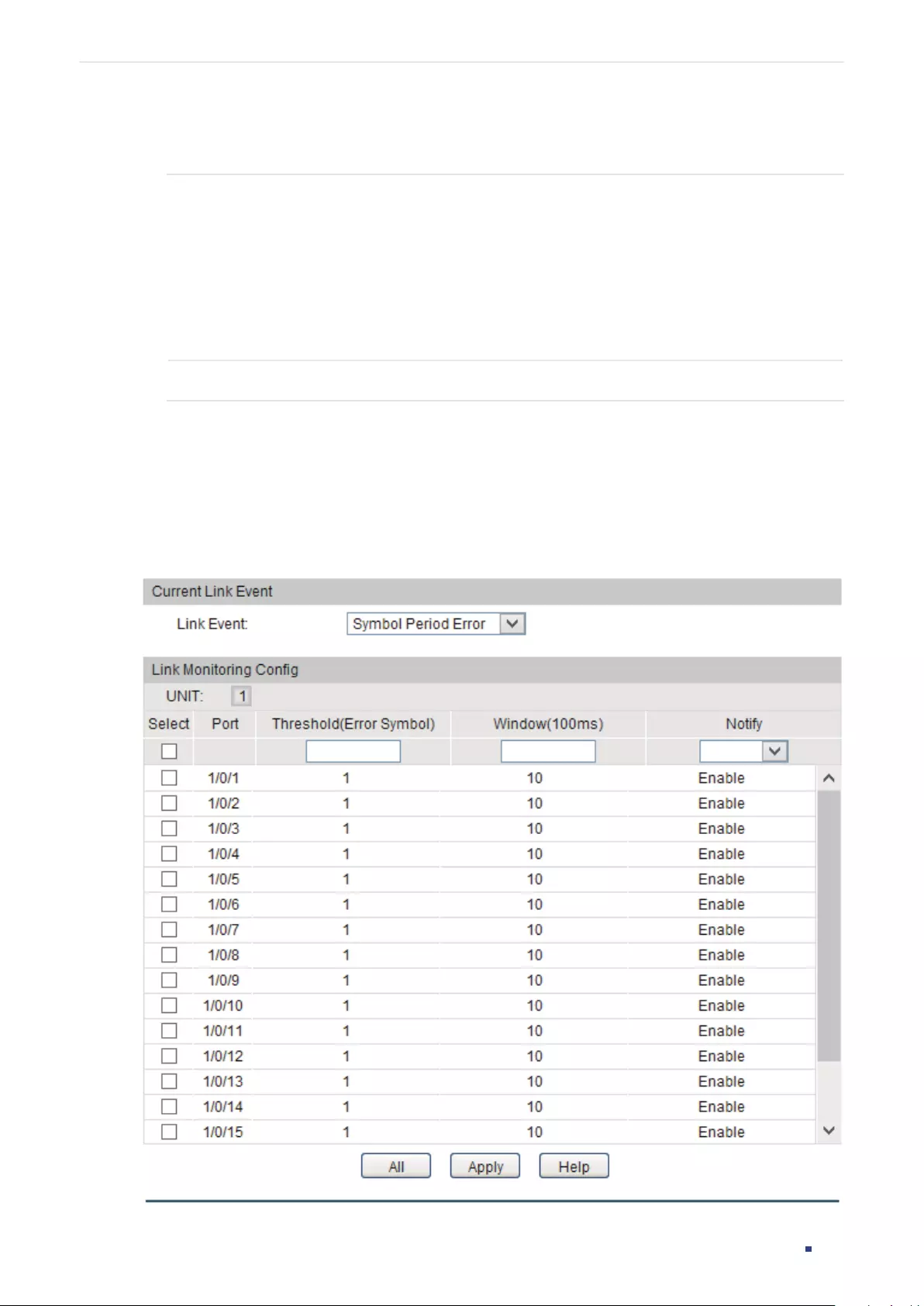
Configuration Guide 362
Configuring OAM Ethernet OAM Configurations
Follow these steps to complete the basic OAM configuration:
1) Select one or more ports, configure the OAM mode and enable OAM.
Mode Select OAM mode for the port.
Active: The port in this mode can initiate OAM connection. It is the default setting.
Passive: The port in this mode cannot initiate OAM connection or send loopback
control OAMPDUs.
Note: OAM connection cannot be established between two ports in passive mode.
Make sure that at least one side is in active mode.
State Enable or disable OAM on the port. By default, it is disabled.
2) Click Apply.
2.1.2 Configuring Link Monitoring
Choose the menu Ethernet OAM > Link Monitoring > Link Monitoring to load the following
page.

Configuration Guide 363
Configuring OAM Ethernet OAM Configurations
Follow these steps to configure Link Monitoring:
1) In the Current Link Event section, select a Link Event type to be configured.
Current Link
Event
Select Link Event type. The following options are provided:
Symbol Period Error: A Symbol Period Error event occurs if the number of symbol
errors exceeds the defined threshold within a specific period of time.
Frame Error: A Frame Error event occurs if the number of frame errors exceeds
the defined threshold within a specific period of time.
Frame Period Error: A Frame Period Error event occurs if the number of frame
errors in specific number of received frames exceeds the defined threshold.
Frame Seconds Error: A Frame Seconds Error event occurs if the number of error
frame seconds exceeds the threshold within a specific period of time. A second is
called an error frame second if error frames occur in the second.
3) In the Link Monitoring Config section, select one or more ports, and configure the
threshold and period for the selected link event.
Threshold Specify the threshold for the selected link event.
Threshold (Error Symbol): If you select Symbol Period Error as the link event
type, specify the threshold of received symbol errors within a specific period of
time. The valid values are from 1 to 4294967295 error frames, and the default
value is 1 error frame.
Threshold (Error Frame): If you select Frame Error or Frame Period Error as
the link event type, specify the threshold of frame errors within a specific period
of time or in specific number of received frames. The valid values are from 1 to
4294967295 error frames, and the default value is 1 error frame.
Threshold (Error Seconds): If you select Frame Seconds Error as the link event
type, specify the threshold of error frame seconds. The valid values are from 1 to
900 error frame seconds, and the default value is 1 error frame second.
Window Specify the period for the selected link event.
Window (100ms): If you select Symbol Period Error, Frame Error or Frame
Seconds Error as the link event type, specify the period time in 100ms, in which
if the received errors exceed the threshold, a link event will be generated. For
Symbol Period Error and Frame Error, the valid values are from 10*100 to
600*100 ms, and the default value is 10*100 ms. For Frame Seconds Error, the
valid values are from 100*100 to 9000*100 ms, and the default value is 600*100
ms.
Window (Frames): If you select Frame Period Error as the link event type,
specify the number of frames, in which if the frame errors exceed the threshold,
a link event will be generated. The valid values are from 148810 to 89286000
frames, and the default value is 1488100 frames.
Notify Enable or disable the port to report the Link Event. By default, all types of the Link
Events can be reported.
4) Click Apply.

Configuration Guide 364
Configuring OAM Ethernet OAM Configurations
2.1.3 Configuring RFI
Choose the menu Ethernet OAM > RFI > Remote Failure Indication Config to load the
following page.
Follow these steps to configure Remote Failure Indication:
1) Select one or more ports and configure the Dying Gasp Notify and Critical Event Notify
features.
Dying Gasp Notify Enable Dying Gasp Notify. If the switch detects an unrecoverable fault on the
network, it will report this condition locally and send Information OAMPDU to
notify the peer.
Critical Event
Notify
Enable Critical Event Notify. If the switch detects an unspecified critical event
occurs, it will report this condition locally and send Information OAMPDU to notify
the peer.
2) Click Apply.

Configuration Guide 365
Configuring OAM Ethernet OAM Configurations
2.1.4 Configuring Remote Loopback
T2600G-18TS does not support this feature.
Choose the menu Ethernet OAM > Remote Loopbak > Remote Loopback to load the following
page.
Follow these steps to configure Remote Loopback:
1) Select one or more ports and configure the relevant options.
Received Remote
Loopback
Choose to ignore or to process the received remote loopback request.
Remote
Loopback
Start or stop the remote loopback process.
Start: Request the remote peer to start the OAM remote loopback mode.
Stop: Request the remote peer to stop the OAM remote loopback mode.
Note: The port to be configured here should be in active mode and has
established OAM connection with the peer.
2) Click Apply.

Configuration Guide 366
Configuring OAM Ethernet OAM Configurations
2.1.5 Viewing OAM Status
Choose the menu Ethernet OAM > Basic Config > Discovery Info to load the following page.
Select a port to view whether the OAM connection is established with the peer. Additionally,
you can view the OAM information of the local and the remote entities.
The OAM information of the local entity is as follows:
OAM Displays whether OAM is enabled.
Mode Displays OAM mode of the local entity.

Configuration Guide 367
Configuring OAM Ethernet OAM Configurations
Max OAMPDU Displays the maximum size of OAMPDU.
Remote
Loopback
Displays whether the local entity supports Remote Loopback.
Unidirection Displays whether the local entity supports Unidirection.
Link Monitoring Displays whether the local entity supports Link Monitoring.
Variable Request Displays whether the local entity supports Variable Request.
PDU Revision Displays the PDU Revision of the local entity.
Operation Status Displays the status of OAM connection:
Disable: OAM is disabled on the port.
LinkFault: The link between the local entity and the remote entity is down.
PassiveWait: The port is in passive mode and is waiting to see if the peer device is
OAM capable.
ActiveSendLocal: The port is in active mode and is sending local information.
SendLocalAndRemote: The local port has discovered the peer but has not yet
accepted or rejected the configuration of the peer.
SendLocalAndRemoteOK: The local device agrees the OAM peer entity.
PeeringLocallyRejected: The local OAM entity rejects the remote peer OAM entity.
PeeringRemotelyRejected: The remote OAM entity rejects the local device.
NonOperHalfDuplex: Ethernet OAM is enabled but the port is in half-duplex
operation. You should configure the port as a full-duplex port.
Operational: OAM connection is established with the peer and OAM works normally.
Loopback Status Displays the loopback status.
No Loopback: Neither the local entity nor the remote entity is in the loopback mode.
Local Loopback: The local entity is in the loopback mode.
Remote Loopback: The remote entity is in the loopback mode.
The OAM information of the remote entity is as follows:
Mode Displays OAM mode of the remote entity.
MAC Address Displays the MAC address of the remote entity.
Vendor (OUI) Displays the Vendor’s OUI of the remote entity.
Max OAMPDU Displays the maximum size of OAMPDU.

Configuration Guide 368
Configuring OAM Ethernet OAM Configurations
Remote
Loopback
Displays whether the remote entity supports Remote Loopback.
Unidirection Displays whether the remote entity supports Unidirection.
Link Monitoring Displays whether the remote entity supports Link Monitoring.
Variable Request Displays whether the remote entity supports Variable Request.
PDU Revision Displays the PDU Revision of the remote entity.
Vendor
Information
Displays the vendor information of the remote entity.
2.2 Using the CLI
2.2.1 Enabling OAM and Configuring OAM Mode
Follow these steps to enable OAM and configure OAM mode on the port:
Step 1 configure
Enter global configuration mode.
Step 2 interface {fastEthernet
port
| range fastEthernet
port-list
| gigabitEthernet
port
| range
gigabitEthernet
port-list
}
Enter interface configuration mode.
Step 3 ethernet-oam
Enable OAM on the port.
Step 4 ethernet-oam mode { passive | active }
Configure the OAM mode of the port.
passive:
Specify the OAM mode as passive. The port in this mode cannot initiate OAM
connection or send Loopback Control OAMPDU.
active:
Specify the OAM mode as active. The port in this mode can initiate OAM connection.
It is the default setting.
Note: OAM connection cannot be established between two ports in passive mode. Make
sure that at least one side is in active mode.
Step 5 show ethernet-oam configuration [ interface fastEthernet {
port
|
port-list
} |
interface
gigabitEthernet {
port
|
port-list
} ]
Verify the OAM configuration.
Step 6 end
Return to privileged EXEC mode.

Configuration Guide 369
Configuring OAM Ethernet OAM Configurations
Step 7 copy running-config startup-config
Save the settings in the configuration file.
The following example shows how to enable OAM and configure the OAM mode as passive
on port 1/0/1.
Switch#configure
Switch(config)#interface gigabitEthernet 1/0/1
Switch(config-if)#ethernet-oam
Switch(config-if)#ethernet-oam mode passive
Switch(config-if)#show ethernet-oam configuration interface gigabitEthernet 1/0/1
Gi1/0/1
-----------------------------------------------------------
OAM: Enabled
Mode: Passive
......
Switch(config-if)#end
Switch#copy running-config startup-config
2.2.2 Configuring Link Monitoring
With Link Monitoring, the following failure conditions can be reported: Symbol Period Error,
Frame Error, Frame Period Error, Frame Seconds Error.
Configuring Symbol Period Error
With Symbol Period Error enabled, a Symbol Period Error event occurs if the number of
symbol errors exceeds the defined threshold within a specific period of time.
Follow these steps to configure Symbol Period Error:
Step 1 configure
Enter global configuration mode.
Step 2 interface {fastEthernet
port
| range fastEthernet
port-list
| gigabitEthernet
port
| range
gigabitEthernet
port-list
}
Enter interface configuration mode.

Configuration Guide 370
Configuring OAM Ethernet OAM Configurations
Step 3 ethernet-oam link-monitor symbol-period [ threshold
threshold
] [ window
window
]
[notify {disable | enable}]
Configure the relevant parameters of Symbol Period Error.
threshold
:
Specify the threshold of received symbol errors within a specic period of time.
The valid values are from 1 to 4294967295, and the default value is 1.
window
:
Specify specify the period time in 100ms, in which if the received errors exceed the
threshold, a link event will be generated. The valid values are from 10*100 to 600*100 ms,
and the default value is 10*100 ms.
disable | enable:
Enable or disable the port to report the failure condition.
Step 4 show ethernet-oam configuration [ interface fastEthernet {
port
|
port-list
} |
interface
gigabitEthernet {
port
|
port-list
} ]
Verify the OAM configuration.
Step 5 end
Return to privileged EXEC mode.
Step 6 copy running-config startup-config
Save the settings in the configuration file.
The following example shows how to enable Frame Error notifying and configure the
threshold as 1 and the window as 1000 ms (10*100 ms) on port 1/0/1:
Switch#configure
Switch(config)#interface gigabitEthernet 1/0/1
Switch(config-if)#ethernet-oam link-monitor symbol-period threshold 1 window 10
notify enable
Switch(config-if)#show ethernet-oam configuration interface gigabitEthernet 1/0/1
Gi1/0/1
-----------------------------------------------------------
......
Symbol Period Error
Notify State : Enabled
Window : 1000 milliseconds
Threshold : 1 Error Symbol
......
Switch(config-if)#end

Configuration Guide 371
Configuring OAM Ethernet OAM Configurations
Switch#copy running-config startup-config
Configuring Frame Error
With Frame Error enabled, a Frame Error event occurs if the number of frame errors
exceeds the defined threshold within a specific period of time.
Follow these steps to configure Frame Error:
Step 1 configure
Enter global configuration mode.
Step 2 interface {fastEthernet
port
| range fastEthernet
port-list
| gigabitEthernet
port
| range
gigabitEthernet
port-list
}
Enter interface configuration mode.
Step 3 ethernet-oam link-monitor frame [ threshold
threshold
] [ window
window
] [ notify {disable
| enable}]
Configure the relevant parameters of Frame Error.
threshold
:
Specify the threshold of received frame errors within a specic period of time.
The valid values are from 1 to 4294967295, and the default value is 1.
window
:
Specify the period time in 100ms, in which if the number of received errors exceeds
the threshold, a link event will be generated. The valid values are from 10*100 to 600*100
ms, and the default value is 10*100 ms.
disable | enable:
Enable or disable the port to report the failure condition.
Step 4 show ethernet-oam configuration [ interface fastEthernet {
port
|
port-list
} |
interface
gigabitEthernet {
port
|
port-list
} ]
Verify the OAM configuration.
Step 5 end
Return to privileged EXEC mode.
Step 6 copy running-config startup-config
Save the settings in the configuration file.
The following example shows how to enable Frame Error notifying and configure the
threshold as 1 and the window as 2000 ms (20*100 ms) on port 1/0/1:
Switch#configure
Switch(config)#interface gigabitEthernet 1/0/1
Switch(config-if)#ethernet-oam link-monitor frame threshold 1 window 20 notify
enable
Switch(config-if)#show ethernet-oam configuration interface gigabitEthernet 1/0/1

Configuration Guide 372
Configuring OAM Ethernet OAM Configurations
Gi1/0/1
-----------------------------------------------------------
......
Frame Error
Notify State : Enabled
Window : 2000 milliseconds
Threshold : 1 Error Frame
......
Switch(config-if)#end
Switch#copy running-config startup-config
Configuring Frame Period Error
With Frame Period Error enabled, a Frame Period Error event occurs if the number of frame
errors in specific number of received frames exceeds the defined threshold.
Follow these steps to configure Frame Period Error:
Step 1 configure
Enter global configuration mode.
Step 2 interface {fastEthernet
port
| range fastEthernet
port-list
| gigabitEthernet
port
| range
gigabitEthernet
port-list
}
Enter interface configuration mode.
Step 3 ethernet-oam link-monitor frame-period [threshold
threshold
] [window
window
] [notify
{disable | enable}]
Configure the relevant parameters of Frame Period Error.
threshold
:
Specify the threshold of received symbol errors in specific number of received
frames. The valid values are from 1 to 4294967295, and the default value is 1.
window
:
Specify the number of frames, in which if the frame errors exceed the threshold, a
link event will be generated. The valid values are from 148810 to 89286000, and the default
value is 1488100.
disable | enable:
Enable or disable the port to report the failure condition.
Step 4 show ethernet-oam configuration [ interface fastEthernet {
port
|
port-list
} |
interface
gigabitEthernet {
port
|
port-list
} ]
Verify the OAM configuration.
Step 5 end
Return to privileged EXEC mode.

Configuration Guide 373
Configuring OAM Ethernet OAM Configurations
Step 6 copy running-config startup-config
Save the settings in the configuration file.
The following example shows how to enable Frame Period Error notifying and configure the
threshold as 1 and the window as 1488100 on port 1/0/1:
Switch#configure
Switch(config)#interface gigabitEthernet 1/0/1
Switch(config-if)#ethernet-oam link-monitor frame-period threshold 1 window
1488100 notify enable
Switch(config-if)#show ethernet-oam configuration interface gigabitEthernet 1/0/1
Gi1/0/1
-----------------------------------------------------------
......
Frame Period Error
Notify State : Enabled
Window : 1488100 Frames
Threshold : 1 Error Frame
......
Switch(config-if)#end
Switch#copy running-config startup-config
Configuring Frame Seconds Error
With Frame Seconds Error enabled, a Frame Seconds Error event occurs if the number of
error frame seconds exceeds the threshold within a specific period of time. A second is
called an error frame second if error frames occur in the second.
Follow these steps to configure Frame Seconds Error:
Step 1 configure
Enter global configuration mode.
Step 2 interface {fastEthernet
port
| range fastEthernet
port-list
| gigabitEthernet
port
| range
gigabitEthernet
port-list
}
Enter interface configuration mode.

Configuration Guide 374
Configuring OAM Ethernet OAM Configurations
Step 3 ethernet-oam link-monitor frame-seconds [ threshold
threshold
] [ window
window
] [
notify {disable | enable}]
Configure the relevant parameters of Frame Period Error.
threshold
:
Specify the threshold of received error frame seconds within a specic period of
time. The valid values are from 1 to 900, and the default value is 1.
window
:
Specify the period time in 100ms, in which if the received errors exceed the
threshold, a link event will be generated. The valid values are from 100*100 to 9000*100 ms,
and the default value is 600*100 ms.
disable | enable :
Enable or disable the port to report the failure condition.
Step 4 show ethernet-oam configuration [ interface fastEthernet {
port
|
port-list
} |
interface
gigabitEthernet {
port
|
port-list
} ]
Verify the OAM configuration.
Step 5 end
Return to privileged EXEC mode.
Step 6 copy running-config startup-config
Save the settings in the configuration file.
The following example shows how to enable Frame Seconds Error notifying and configure
the threshold as 1 and the window as 80000 ms (800*100 ms)on port 1/0/1:
Switch#configure
Switch(config)#interface gigabitEthernet 1/0/1
Switch(config-if)#ethernet-oam link-monitor frame-seconds threshold 1 window 800
notify enable
Switch(config-if)#show ethernet-oam configuration interface gigabitEthernet 1/0/1
Gi1/0/1
-----------------------------------------------------------
......
Frame Seconds Error
Notify State : Enabled
Window : 80000 milliseconds
Threshold : 1 Error Seconds
......
Switch(config-if)#end

Configuration Guide 375
Configuring OAM Ethernet OAM Configurations
Switch#copy running-config startup-config
2.2.3 Configuring Remote Failure Indication
Follow these steps to configure Remote Failure Indication:
Step 1 configure
Enter global configuration mode.
Step 2 interface {fastEthernet
port
| range fastEthernet
port-list
| gigabitEthernet
port
| range
gigabitEthernet
port-list
}
Enter interface configuration mode.
Step 3 ethernet-oam remote-failure { dying-gasp | critical-event } notify { disable | enable }
Configure the Dying Gasp Notify and Critical Event Notify features on the port.
dying-gasp:
Enable Dying Gasp Notify, and if the switch detects an unrecoverable fault on
the network, such as power failure, occurs, it will send Information OAMPDU to notify the
peer.
critical-event:
Enable Critical Event Notify, and if the switch detects an unspecied critical
event occurs, it will send Information OAMPDU to notify the peer.
disable | enable:
Enable or disable the port to report the link events.
Step 4 show ethernet-oam configuration [ interface fastEthernet {
port
|
port-list
} |
interface
gigabitEthernet {
port
|
port-list
} ]
Verify the OAM configuration.
Step 5 end
Return to privileged EXEC mode.
Step 6 copy running-config startup-config
Save the settings in the configuration file.
The following example shows how to enable Dying Gasp and Critical Event on port 1/0/1:
Switch#configure
Switch(config)#interface gigabitEthernet 1/0/1
Switch(config-if)#ethernet-oam dying-gasp notify enable
Switch(config-if)#ethernet-oam remote-failure notify enable
Switch(config-if)#show ethernet-oam configuration interface gigabitEthernet 1/0/1

Configuration Guide 376
Configuring OAM Ethernet OAM Configurations
Gi1/0/1
-----------------------------------------------------------
......
Dying Gasp : Enabled
Critical Event : Enabled
......
Switch(config-if)#end
Switch#copy running-config startup-config
2.2.4 Configuring Remote Loopback
T2600G-18TS does not support this feature.
Follow these steps to configure Remote Loopback:
Step 1 configure
Enter global configuration mode.
Step 2 interface {fastEthernet
port
| range fastEthernet
port-list
| gigabitEthernet
port
| range
gigabitEthernet
port-list
}
Enter interface configuration mode.
Step 3 ethernet-oam remote-loopback received-remote-loopback { process | ignore }
Configure the port to ignore or to process the received remote loopback request.
Step 4 ethernet-oam remote-loopback { start | stop }
Request the remote peer to start or stop the OAM remote loopback mode. The port to be
configured here should be in active mode that has established OAM connection with the
peer.
Step 5 show ethernet-oam configuration [ interface fastEthernet {
port
|
port-list
} |
interface
gigabitEthernet {
port
|
port-list
} ]
Verify the OAM configuration.
Step 6 end
Return to privileged EXEC mode.
Step 7 copy running-config startup-config
Save the settings in the configuration file.
The following example shows how to start the OAM remote loopback mode of the peer on
port 1/0/1:
Switch#configure

Configuration Guide 377
Configuring OAM Ethernet OAM Configurations
Switch(config)#interface gigabitEthernet 1/0/1
Switch(config-if)# ethernet-oam remote-loopback start
2.2.5 Verifying OAM Connection
On privileged EXEC mode or any other configuration mode, you can use the following
command to view whether the OAM connection is established with the peer. Additionally,
you can view the OAM information of the local entity and the remote entity.
show ethernet-oam status [ interface fastEthernet {
port
|
port-list
} |
interface gigabitEthernet {
port
|
port-list
} ]
View the OAM status and the relevant information of the specified port, including the local entity and the
remote entity.
The displayed OAM information of the local entity is as follows:
OAM: Displays whether OAM is enabled.
Mode: Displays OAM mode of the local entity.
Max OAMPDU: Displays the maximum size of OAMPDU.
Remote Loopback: Displays whether the local entity supports Remote Loopback.
Unidirection: Displays whether the local entity supports Unidireciton.
Link Monitoring: Displays whether the local entity supports Link Monitoring.
Variable Request: Displays whether the local entity supports Variable Request.
PDU Revision: Displays the PDU Revision of the local entity.
Operation Status: Displays the status of OAM connection, including:
Disable: OAM is disabled on the port.
LinkFault: The link between the local entity and the remote entity is down.
PassiveWait: The port is in passive mode and is waiting to see if the peer device is OAM capable.
ActiveSendLocal: The port is in active mode and is sending local information.
SendLocalAndRemote: The local port has discovered the peer but has not yet accepted or rejected the
configuration of the peer.
SendLocalAndRemoteOK: The local device agrees the OAM peer entity.
PeeringLocallyRejected: The local OAM entity rejects the remote peer OAM entity.

Configuration Guide 378
Configuring OAM Ethernet OAM Configurations
PeeringRemotelyRejected: The remote OAM entity rejects the local device.
NonOperHalfDuplex: Ethernet OAM is enabled but the port is in half-duplex operation. You should configure
the port as a full-duplex port.
Operational: OAM connection is established with the peer and OAM works normally.
Loopback Status: Displays the loopback status, including:
No Loopback: Neither the local client nor the remote client is in the loopback mode.
Local Loopback: The local client is in the loopback mode.
Remote Loopback: The remote client is in the loopback mode.
The displayed OAM information of the remote entity is as follows:
Mode: Displays OAM mode of the local entity.
MAC Address: Displays the MAC address of the remote entity.
Vendor (OUI): Displays the Vendor’s OUI of the remote entity.
Max OAMPDU: Displays the maximum size of OAMPDU.
Remote Loopback: Displays whether the remote entity supports Remote Loopback.
Unidirection: Displays whether the remote entity supports Unidireciton.
Link Monitoring: Displays whether the remote entity supports Link Monitoring.
Variable Request: Displays whether the remote entity supports Variable Request.
PDU Revision: Displays the PDU Revision of the remote entity.
Vendor Information: Displays the vendor information of the remote entity.
The following example shows how to view the OAM status of port 1/0/1:
Switch(config)#show ethernet-oam status interface gigabitEthernet 1/0/1
Gi1/0/1
Local Client
-----------------------------------------------------------
OAM : Enabled
Mode : Active
Max OAMPDU : 1518 Bytes
Remote Loopback : Supported
Unidirection : Not Supported

Configuration Guide 379
Configuring OAM Ethernet OAM Configurations
Link Monitoring : Supported
Variable Request : Not Supported
PDU Revision : 1
Operation Status : Operational
Loopback Status : No Loopback
Remote Client
-----------------------------------------------------------
Mode : Passive
MAC Address : 18-A6-F7-DB-63-81
Vendor(OUI) : 000aeb
Max OAMPDU : 1518 Bytes
Remote Loopback : Supported
Unidirection : Not Supported
Link Monitoring : Supported
Variable Request : Not Supported
PDU Revision : 1
Loopback Status : No Loopback
Vendor Information : 00000000

Configuration Guide 380
Configuring OAM Viewing OAM Statistics
3 Viewing OAM Statistics
You can view the following OAM statistics:
OAMPDUs
Event Logs
3.1 Using the GUI
3.1.1 Viewing OAMPDUs
Choose the menu Ethernet OAM > Statistics > Statistics to load the following page.
Figure 3-1 OAM Statistics
Select a port and view the number of different OAMPDUs transmitted and received on this
port:

Configuration Guide 381
Configuring OAM Viewing OAM Statistics
Tx Displays the number of OAMPDUs that have been transmitted on the port.
Rx Displays the number of OAMPDUs that have been received on the port.
Information
OAMPDUs
Displays the number of Information OAMPDUs that have been transmitted or
received on the port.
Unique Event
Notification
OAMPDUs
Displays the number of Unique Event Notification OAMPDUs that have been
transmitted or received on the port.
Duplicate Event
Notification
OAMPDUs
Displays the number of Duplicate Event Notification OAMPDUs that have been
transmitted or received on the port.
Variable Request
OAMPDUs
Displays the number of Variable Request OAMPDUs that have been transmitted
or received on the port.
Variable Response
OAMPDUs
Displays the number of Variable Response OAMPDUs that have been transmitted
or received on the port.
Loopback Control
OAMPDUs
Displays the number of Loopback Control OAMPDUs that have been transmitted
or received on the port.
Organization Specific
OAMPDUs
Displays the number of Organization Specific OAMPDUs that have been
transmitted or received on the port.
Unsupported
OAMPDUs
Displays the number of Unsupported OAMPDUs that have been transmitted or
received on the port.
Frames Lost Due To
OAM
Displays the number of frames that are not transmitted successfully on the OAM
sublayer but not due to an internal OAM error.
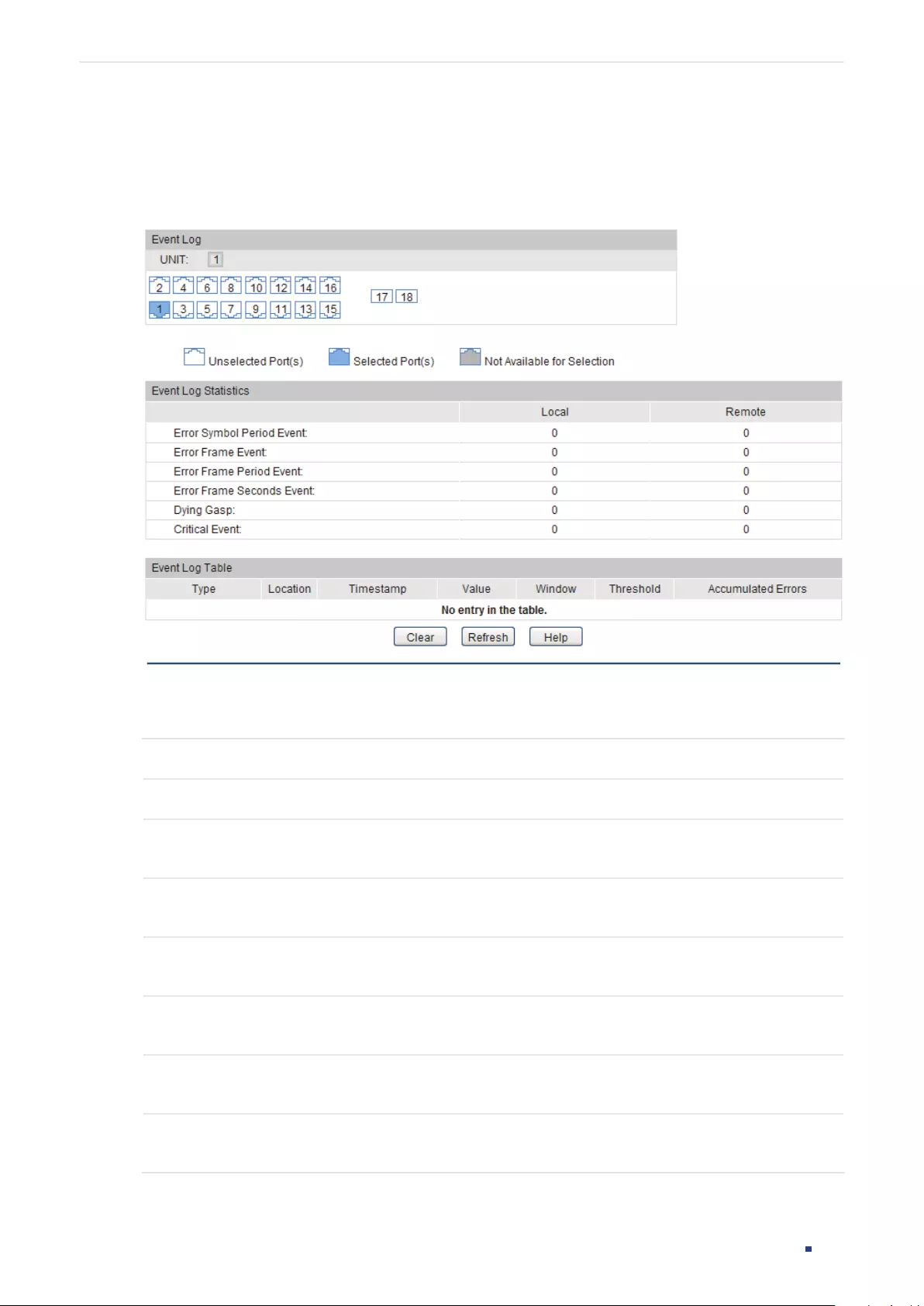
Configuration Guide 382
Configuring OAM Viewing OAM Statistics
3.1.2 Viewing Event Logs
Choose the menu Ethernet OAM > Statistics > Event Log to load the following page.
Figure 3-2 OAM Event Log
Select a port and view the local and remote event logs on this port in the Event Log
Statistics section:
Local Displays the number of link events that have occurred on the local link.
Remote Displays the number of link events that have occurred on the remote link.
Error Symbol
Period Event
Displays the number of error symbol period link events that have occurred on the
local link or remote link.
Error Frame
Event
Displays the number of error frame link events that have occurred on the local link or
remote link.
Error Frame
Period Event
Displays the number of error frame period link events that have occurred on the local
link or remote link.
Error Frame
Seconds Event
Displays the number of error frame seconds link events that have occurred on the
local link or remote link.
Dying Gasp Displays the number of Dying Gasp link events that have occurred on the local link or
remote link.
Critical Event Displays the number of Critical Event link events that have occurred on the local link
or remote link.

Configuration Guide 383
Configuring OAM Viewing OAM Statistics
Additionally, you can view the detailed information of the event logs in the Event Log Table
section.
Type Displays the type of the link event.
Location Displays the location where the link event occurred.
Timestamp Displays the time reference when the link event occurred.
Value Displays the number of symbol errors or frame errors in the period.
Window Displays the period of the link event.
Threshold Displays the threshold of the errors.
Accumulated
Errors
Displays the number of errors that have been detected since the OAM feature is
reset.
3.2 Using the CLI
3.2.1 Viewing OAMPDUs
On privileged EXEC mode or any other configuration mode, you can use the following
command to view the number of OAMPDUs received and sent on the specified port.
show ethernet-oam statistics [ interface fastEthernet {
port
|
port-list
} |
interface gigabitEthernet {
port
|
port-list
} ]
View the number of different OAMPDUs transmitted and received on the specified port, including
Information OAMPDU, Unique Event Notification OAMPDU, Duplicate Event Notification OAMPDU,
Loopback Control OAMPDU, Variable Request OAMPDU, Variable Response OAMPDU, Organization
Specific OAMPDUs, Unsupported OAMPDU, and Frames Lost Due To OAM (frames that are not transmitted
successfully on the OAM sublayer but not due to an internal OAM error).
The following example shows how to view the transmitted and received OAMDPUs on port
1/0/1.
Switch#show ethernet-oam statistics interface gigabitEthernet 1/0/1
Gi1/0/1
---------------------------------------------
Information OAMPDU TX : 28
Information OAMPDU RX : 28
Unique Event Notification OAMPDU TX : 0
Unique Event Notification OAMPDU RX : 0

Configuration Guide 384
Configuring OAM Viewing OAM Statistics
Duplicate Event Notification OAMPDU TX : 0
Duplicate Event Notification OAMPDU RX : 0
Loopback Control OAMPDU TX : 1
Loopback Control OAMPDU RX : 0
Variable Request OAMPDU TX : 0
Variable Request OAMPDU RX : 0
Variable Response OAMPDU TX : 0
Variable Response OAMPDU RX : 0
Organization Specific OAMPDUs TX : 0
Organization Specific OAMPDUs RX : 0
Unsupported OAMPDU TX : 0
Unsupported OAMPDU RX : 0
Frames Lost Due To OAM : 0

Configuration Guide 385
Configuring OAM Viewing OAM Statistics
3.2.2 Viewing Event Logs
On privileged EXEC mode or any other configuration mode, you can use the following command
to view the local and remote event logs on the specified port.
show ethernet-oam event-log [ interface fastEthernet {
port
|
port-list
} |
interface gigabitEthernet {
port
|
port-list
} ]
View the local and remote event logs on the specified port.
An event list will be displayed, including the following information:
Type: Displays the type of the link event.
Location: Displays the location where the link event occurred (local or remote).
Timestamp: Displays the time reference when the link event occurred.
And the number of local and remote event logs will be displayed, including the following events:
Error Symbol Event: Displays the number of error symbol period link events that have occurred on the
local link or remote link.
Error Frame Event: Displays the number of error frame link events that have occurred on the local link or
remote link.
Error Frame Period Event: Displays the number of error frame period link events that have occurred on
the local link or remote link.
Error Frame Seconds Event: Displays the number of error frame seconds link events that have occurred
on the local link or remote link.
Dying Gasp: Displays the number of Dying Gasp link events that have occurred on the local link or remote
link.
Critical Event: Displays the number of Critical Event link events that have occurred on the local link or
remote link.
The following example shows how to view the event logs on port 1/0/1.
Switch#show ethernet-oam event-log interface gigabitEthernet 1/0/1
Gi1/0/1
Event Listing
-----------------------------------------------------------
Type Location Time Stamp
------------------------ ------------- --------------------
Critical Event Remote 2016-01-01 08:08:00
Local Event Statistics

Configuration Guide 386
Configuring OAM Viewing OAM Statistics
Error Symbol Event : 0
Error Frame Event : 0
Error Frame Period Event : 0
Error Frame Seconds Event : 0
Dying Gasp : 0
Critical Event : 0
Remote Event Statistics
Error Symbol Event : 0
Error Frame Event : 0
Error Frame Period Event : 0
Error Frame Seconds Event : 0
Dying Gasp : 0
Critical Event : 1

Configuration Guide 387
Configuring OAM Configuration Example
4 Configuration Example
4.1 Network Requirements
A network administrator wants to manage and troubleshoot the network more effectively,
requiring that the link failure and frame errors on the link between Switch A and Switch B
can be monitored and reported via the Ethernet OAM feature.
Figure 4-1 Network Topology
Switch A Switch B
Gi1/0/1 Gi1/0/1
4.1.1 Configuration Scheme
To meet the requirement, configure OAM on port 1/0/1 of each switch. Two features can
be configured: Link Monitoring and Remote Failure Indication. With Link Monitoring, the
frame errors on the link can be monitored and reported; with Remote Failure Indication, the
link failure can be monitored and reported.
The overview of configuration is as follows:
1) Enable OAM and configure the OAM mode for port 1/0/1 on each switch. Here we
configure OAM mode of the port on Switch A as active, and that on switch B as passive.
2) Configure Link Monitoring for port 1/0/1 on each switch.
3) Configure Remote Failure Indication for port 1/0/1 on each switch.
Demonstrated with T2600G-18TS, the following sections provide configuration procedure
in two ways: using the GUI and using the CLI.
4.1.2 Using the GUI
The configurations for Switch A and Switch B are similar. We take Switch A as an example.
1) Choose the menu Ethernet OAM > Basic Config > Basic Config to load the following
page. Select port 1/0/1, and configure the mode as Active and the state as Enable. Click
Apply.

Configuration Guide 388
Configuring OAM Configuration Example
Figure 4-2 Basic Configuration
2) Choose the menu Ethernet OAM > Link Monitoring > Link Monitoring to load the
following page. Select each Link Event type and configure the relevant parameters
on port 1/0/1. Make sure that Notify is enabled and specify the threshold and window
according to your needs. Here we keep the default parameters. Click Apply.

Configuration Guide 389
Configuring OAM Configuration Example
Figure 4-3 Link Monitoring Configuration
3) Choose the menu Ethernet OAM > RFI > Remote Failure Indication to load the
following page. Select port 1/0/1 and enable Dying Gasp Notify and Critical Event Notify.
Click Apply.

Configuration Guide 390
Configuring OAM Configuration Example
Figure 4-4 Remote Failure Indication Configuration
4) Choose the menu Ethernet OAM > Basic Config > Discovery Info to load the following
page. Select port 1/0/1 to check the OAM status. When the connection status becomes
Operational, it indicates that OAM connection has been established and OAM works
normally.

Configuration Guide 391
Configuring OAM Configuration Example
Figure 4-5 Discovery Infomation
5) Click Save Config to save the settings.
6) Choose the menu Ethernet OAM > Statistics > Event Log to load the following page.
Select port 1/0/1 to view the event logs on the port.
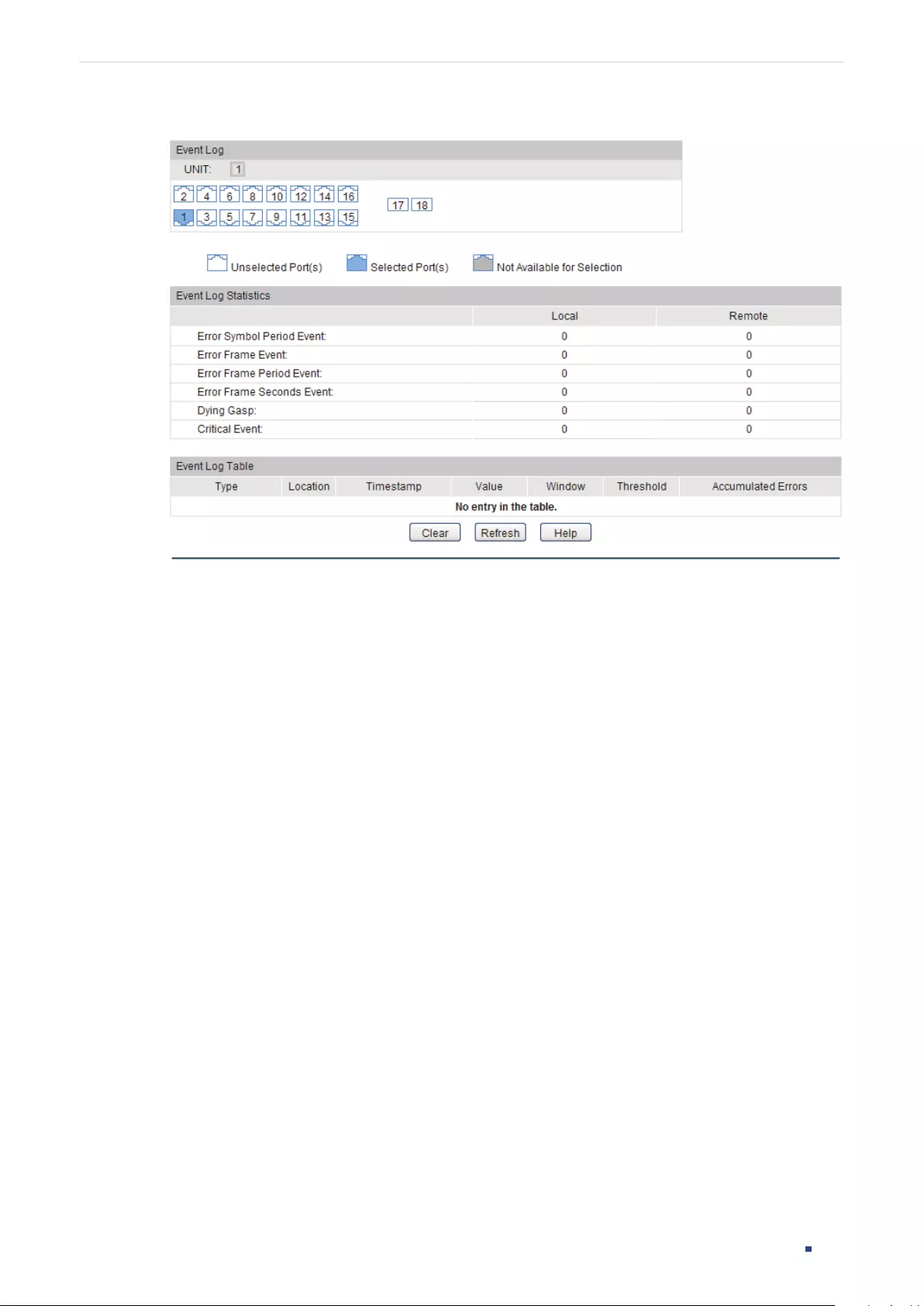
Configuration Guide 392
Configuring OAM Configuration Example
Figure 4-6 OAM Event Logs
4.1.3 Using the CLI
1) Enable OAM and configure OAM mode as active on port 1/0/1.
Switch_A#configure
Switch_A(config)# interface gigabitEthernet 1/0/1
Switch_A(config-if)# ethernet-oam
Switch_A(config-if)# ethernet-oam mode active
2) Configure Link Monitoring on the port. Enable event Notify and keep the threshold and
window as the default.
Switch_A(config-if)#ethernet-oam link-monitor symbol-period notify enable
Switch_A(config-if)#ethernet-oam link-monitor frame-period notify enable
Switch_A(config-if)#ethernet-oam link-monitor frame notify enable
Switch_A(config-if)#ethernet-oam link-monitor frame-seconds notify enable
3) Configure Remote Failure Indication on the port. Enable dying gasp and critical event
Notify.
Switch_A(config-if)#ethernet-oam remote-failure critical-event notify enable
Switch_A(config-if)#ethernet-oam dying-gasp critical-event notify enable
Switch_A(config-if)#ethernet-oam link-monitor frame-period notify enable

Configuration Guide 393
Configuring OAM Configuration Example
Switch_A(config-if)#ethernet-oam link-monitor frame notify enable
Switch_A(config-if)#end
Switch_A#copy running-config startup-config
Verify the Configuration
Verify the configuration of OAM:
Switch_A#show ethernet-oam configuration interface gigabitEthernet 1/0/1
Gi1/0/1
-----------------------------------------------------------
OAM : Enabled
Mode : Active
Dying Gasp : Enabled
Critical Event : Enabled
Remote Loopback OAMPDU : Not Processed
Symbol Period Error
Notify State : Enabled
Window : 1000 milliseconds
Threshold : 1 Error Symbol
Frame Error
Notify State : Enabled
Window : 1000 milliseconds
Threshold : 1 Error Frame
Frame Period Error
Notify State : Enabled
Window : 148810 Frames
Threshold : 1 Error Frame

Configuration Guide 394
Configuring OAM Configuration Example
Frame Seconds Error
Notify State : Enabled
Window : 60000 milliseconds
Threshold : 1 Error Seconds
Verify the OAM connection:
Switch_A#show ethernet-oam status interface gigabitEthernet 1/0/1
Gi1/0/1
Local Client
-----------------------------------------------------------
OAM : Enabled
Mode : Active
Max OAMPDU : 1518 Bytes
Remote Loopback : Supported
Unidirection : Not Supported
Link Monitoring : Supported
Variable Request : Not Supported
PDU Revision : 1
Operation Status : Operational
Loopback Status : No Loopback
Remote Client
-----------------------------------------------------------
Mode : Passive
MAC Address : 18-A6-F7-DB-63-81
Vendor(OUI) : 000aeb
Max OAMPDU : 1518 Bytes
Remote Loopback : Supported

Configuration Guide 395
Configuring OAM Configuration Example
Unidirection : Not Supported
Link Monitoring : Supported
Variable Request : Not Supported
PDU Revision : 1
Loopback Status : No Loopback
Vendor Information : 00000000
View the OAM event logs:
Switch_A#show ethernet-oam event-log interface gigabitEthernet 1/0/1
Gi1/0/1
Event Listing
-----------------------------------------------------------
Type Location Time Stamp
------------------------ ------------- --------------------
Critical Event Remote 2016-01-01 08:08:00
Local Event Statistics
Error Symbol Event : 0
Error Frame Event : 0
Error Frame Period Event : 0
Error Frame Seconds Event : 0
Dying Gasp : 0
Critical Event : 0
Remote Event Statistics
Error Symbol Event : 0
Error Frame Event : 0
Error Frame Period Event : 0
Error Frame Seconds Event : 0
Dying Gasp : 0

Configuration Guide 396
Configuring OAM Configuration Example
Critical Event : 1

Configuration Guide 397
Configuring OAM Appendix: Default Parameters
5 Appendix: Default Parameters
Default settings of Ethernet OAM are listed in the following tables.
Table 5-1 Ethernet OAM
Parameter Default Setting
Basic Config
Mode Active
State Disable
Link Monitoring
Symbol Period Error
Threshold : 1
Window: 10*100 ms
Notify: Enable
Frame Error
Threshold : 1
Window: 10*100 ms
Notify: Enable
Frame Period Error
Threshold : 1
Window: 1488100 frames
Notify: Enable
Frame Seconds Error
Threshold : 1
Window: 600*100 ms
Notify: Enable
Remote Failure Indication
Dying Gasp Notify Enable
Critical Event Notify Enable
Remote Loopback
Receive Remote Loopback Ignore
Remote Loopback None

Configuration Guide 399
Configuring Layer 2 Multicast Layer 2 Multicast
1 Layer 2 Multicast
1.1 Overview
In a point-to-multipoint network, packets can be sent in three ways: unicast, broadcast
and multicast. With unicast, many copies of the same information will be sent to all the
receivers, occupying a large bandwidth.
With broadcast, information will be sent to all users in the network no matter they need it or
not, wasting network resources and impacting information security.
Multicast, however, solves all the problems caused by unicast and broadcast. With
multicast, the source only need to send one piece of information, and all and only the users
who need the information will receive copies of the information. In a point-to-multipoint
network, multicast technology not only transmits data with high efficiency, but also saves a
large bandwidth and reduces network load.
In practical applications, Internet information provider can provide value-added services
such as Online Live, IPTV, Distance Education, Telemedicine, Internet Radio and Real-time
Video Conferences more conveniently using multicast.
Layer 2 Multicast allows Layer 2 switches to listen for IGMP packets between Layer 3
devices and user hosts to establish multicast forwarding table and to manage and control
transmission of packets.
Take IGMP Snooping as an example. When IGMP Snooping is disabled on the Layer 2
device, multicast packets will be broadcast in the Layer 2 network; when IGMP Snooping
is enabled on the Layer 2 device, multicast data from a known multicast group will be
transmitted to the designated receivers instead of being broadcast in the Layer2 network.

Configuring Layer 2 Multicast Layer 2 Multicast
Configuration Guide 400
Demonstrated as below:
Figure 1-1 IGMP Snooping
Source
Multicast router
Layer 2 switch
Host A Host B Host C
Receiver Receiver
Multicast packets transmission with
IGMP Snooping
Source
Multicast router
Layer 2 switch
Host A Host B Host C
Receiver Receiver
Multicast packets transmission
without IGMP Snooping
Multicast packets
1.2 Supported Layer 2 Multicast Protocols
Layer 2 Multicast protocol for IPv4: IGMP Snooping
On the Layer 2 device, IGMP Snooping transmits data on demand on data link layer by
analyzing IGMP packets between Layer 3 devices and users, to build and maintain Layer 2
multicast forwarding table.
Layer 2 Multicast protocol for IPv6: MLD Snooping
On the Layer 2 device, MLD Snooping (Multicast Listener Discovery Snooping) transmits
data on demand on data link layer by analyzing IGMP packets between Layer 3 devices and
users, to build and maintain Layer 2 multicast forwarding table.

Configuration Guide 401
Configuring Layer 2 Multicast IGMP Snooping Configurations
2 IGMP Snooping Configurations
2.1 Using the GUI
2.1.1 Configuring IGMP Snooping Globally
Choose the menu Multicast > IGMP Snooping > Snooping Config to load the following page.
Figure 2-1 IGMP Snooping Global Config
Enabling IGMP Snooping Globally
Before configuring functions related to IGMP Snooping, enable IGMP Snooping globally
first.
1) Select Enable to enable IGMP Snooping globally.
2) Click Apply.
(Optional) Configuring Unknown Multicast
Unknown Multicast decides how to process the multicast data when its destination
multicast address is not in the multicast forwarding table of the switch.

Configuring Layer 2 Multicast IGMP Snooping Configurations
Configuration Guide 402
For switches that support MLD Snooping, IGMP Snooping and MLD Snooping share
the setting of Unknown Multicast, so you have to enable MLD Snooping globally on the
Multicast > MLD Snooping > Snooping Config page at the same time.
Follow these steps to configure unknown multicast.
1) Configure Unknown Multicast as Forward or Discard.
Unknown
Multicast
Configure the way how the switch processes the multicast data sent to unknown
multicast groups as Forward or Discard. Unknown multicast groups are multicast
groups whose destination multicast address is not in the multicast forwarding
table of the switch.
2) Click Apply.
(Optional) Configuring Report Message Suppression
Enabling Report Message Suppression can reduce the number of packets in the network.
Follow these steps to configure report message suppression.
1) Enable or disable Report Message Suppression globally.
Report Message
Suppression
If this function is enabled, the switch will only forward the first IGMP report
message to Layer 3 devices and suppress subsequent IGMP report messages
from the same multicast group during one query interval, which reduces the
number of IGMP packets.
2) Click Apply.
Configuring Router Port Time and Member Port Time
Follow these steps to configure the aging time of the router ports and the member ports:
1) Specify the aging time of the router ports.
Router Port
Time
Router ports are ports connected to Layer 3 devices on the switch. The router
port ages if the switch does not receive IGMP query message from the router port
within the router port time. The switch will no longer consider this port as a router
port and delete it from the router port table. The valid values are from 60 to 600
seconds.
2) Specify the aging time of the member ports.
Member Port
Time
Member ports are ports connected to multicast group members on the switch.
A port is considered to be a member port when it is added to a multicast group.
The member port ages if the switch does not receive IGMP membership report
message from the member port within the member port time. The switch will
no longer consider this port as a member port and delete it from the multicast
forwarding table. The valid values are from 60 to 600 seconds.
3) Click Apply.

Configuration Guide 403
Configuring Layer 2 Multicast IGMP Snooping Configurations
Configuring IGMP Snooping Last Listener Query
Configure the Last Listener Query Interval and Last Listener Query Count when the switch
receives an IGMP leave message. If specified count of Multicast-Address-Specific Queries
(MASQs) are sent and no report message is received, the switch will delete the multicast
address from the multicast forwarding table.
Follow these steps to configure Last Listener Query Interval and Last Listener Query
Count in the Global Config section:
1) Specify the interval between MASQs.
Last Listener
Query Interval
When the switch receives an IGMP leave message, the switch obtains the address
of the multicast group that the host wants to leave from the message. Then the
switch sends out MASQs to this multicast group through the port receiving the
leave message. This parameter determines the interval between MASQs. The
valid values are from 1 to 5 seconds.
2) Specify the number of MASQs to be sent.
Last Listener
Query Count
When the switch receives an IGMP leave message, the switch obtains the address
of the multicast group that the host wants to leave from the message. Then the
switch sends out MASQs to this multicast group through the port receiving the
leave message. This parameter determines the number of MASQs to be sent. The
valid values are from 1 to 5.
3) Click Apply.
Verifying IGMP Snooping Status
IGMP Snooping Status Table displays VLANs and ports with IGMP Snooping enabled.

Configuring Layer 2 Multicast IGMP Snooping Configurations
Configuration Guide 404
2.1.2 Configuring the Port’s Basic IGMP Snooping Features
Choose the menu Multicast > IGMP Snooping > Port Config to load the following page.
Figure 2-2 Enable IGMP Snooping on Port
Enabling IGMP Snooping on the Port
Follow these steps to enable or disable IGMP Snooping on the port.
1) Select the port to be configured and select Enable under the IGMP Snooping column.
2) Click Apply.
(Optional) Configuring Fast Leave
With Fast Leave enabled on a port, the switch will remove this port from the forwarding
list of the corresponding multicast group once the port receives a leave message. Once
deleted, the switch will no longer forward MASQs to this port to verify if there are other
members of this multicast group.
Follow these steps to configure fast leave.
1) Select the port to be configured and select Enable under the Fast Leave column.

Configuring Layer 2 Multicast IGMP Snooping Configurations
Configuration Guide 405
Fast Leave With Fast Leave enabled on a port, the switch will remove this port from the
forwarding list of the corresponding multicast group once the port receives a
leave message. You should only use this function when there is a single receiver
present on the port.
2) Click Apply.
2.1.3 Configuring IGMP Snooping in the VLAN
Choose the menu Multicast > IGMP Snooping > VLAN Config to load the following page.
Figure 2-3 IGMP Snooping in VLAN
Configuring IGMP Snooping Globally in the VLAN
In the VLAN Config section, follow these steps to configure relevant parameters for the
designate VLAN.
1) Set up the VLAN that the router ports and the member ports are in. For details, please
refer to Configuring 802.1Q VLAN.
2) Enable IGMP Snooping in the designate VLAN, and configure the aging time of the
router ports and the member ports.
VLAN ID Specify the VLAN to enable IGMP Snooping.

Configuration Guide 406
Configuring Layer 2 Multicast IGMP Snooping Configurations
Router Port
Time
Specify the aging time of the router ports in the VLAN. If the router port does not
receive any IGMP general query message within the router port time, the switch
will no longer consider this port as a router port and delete it from the router port
list. The valid values are from 60 to 600 seconds. When the router port time is 0,
the VLAN uses the global time.
Member Port
Time
Specify the aging time of the member ports in the VLAN. If the member port does
not receive any IGMP membership report message from the multicast group
within the member port time, the switch will no longer consider this port as a
member port and delete it from the multicast forwarding table. The valid values
are from 60 to 600 seconds. When the member port time is 0, the VLAN uses the
global time.
3) Click Create.
(Optional) Configuring the Static Router Ports in the VLAN
Follow these steps to configure static router ports in the designate VLAN:
1) Configure the router ports in the designate VLAN.
VLAN ID Specify the VLAN to be configured.
Static Router
Ports
Select one or more ports to be the static router ports in the VLAN. All multicast
data in this VLAN will be forwarded through the static router ports.
2) Click Create.
(Optional) Configuring the Forbidden Router Ports in the VLAN
Follow these steps to forbid the selected ports to be the router ports in the designate
VLAN:
1) Configure the forbidden router ports in the designate VLAN.
VLAN ID Specify the VLAN to be configured.
Forbidden
Router Ports
Select the ports to forbid them from being router ports in the VLAN.
2) Click Create.
2.1.4 Configuring the Multicast VLAN
In old multicast transmission mode, when users in different VLANs apply for data from
the same multicast group, the Layer 3 device will duplicate this multicast data and deliver
copies to the Layer 2 devices.
With Multicast VLAN configured, all multicast group members will be added to a VLAN.
Layer 3 device only need to send one piece of multicast data to a Layer 2 device, and the
Layer 2 device will send the data to all member ports of the VLAN. In this way, Multicast
VLAN saves bandwidth and reduces network load of Layer 3 devices.
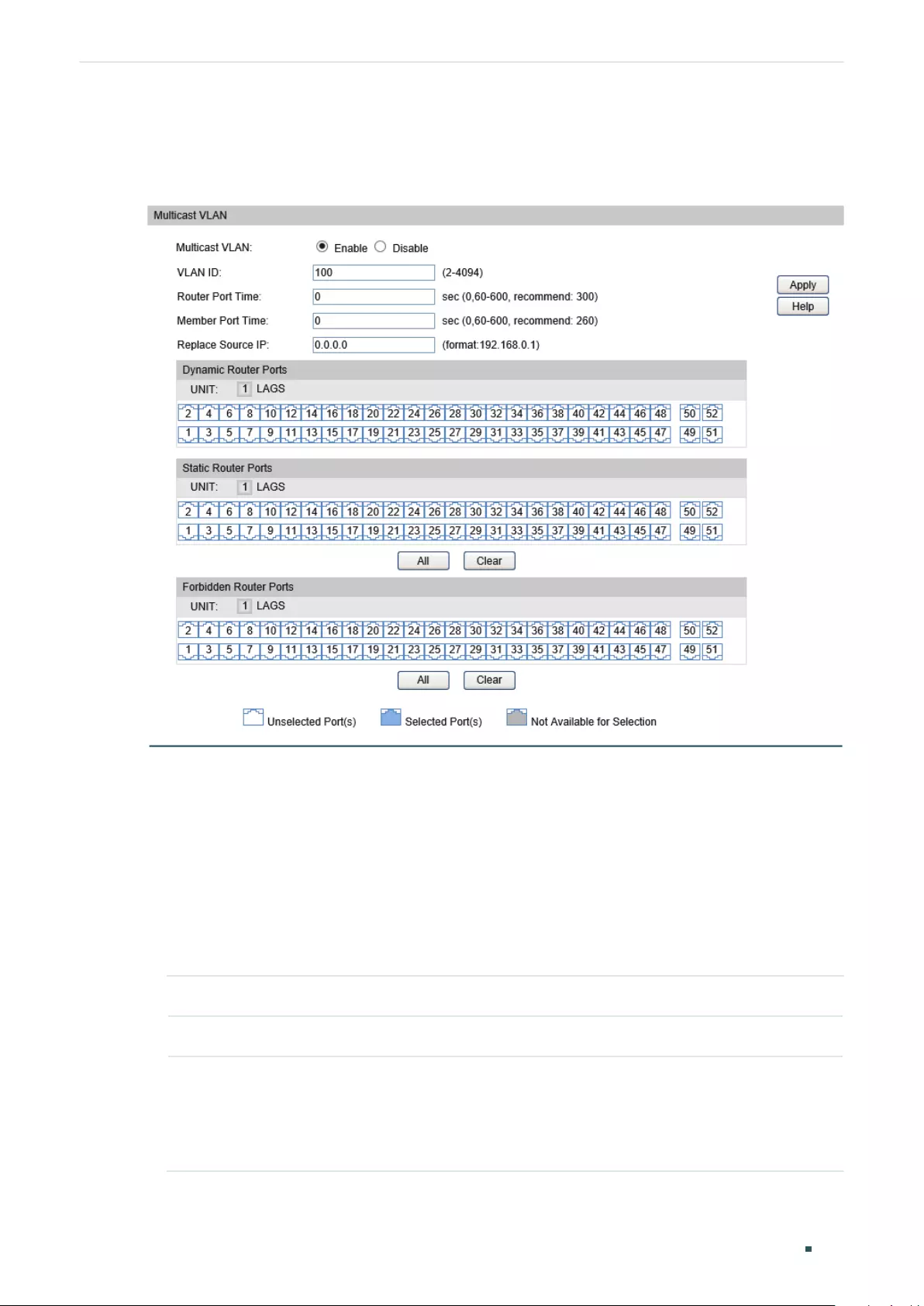
Configuration Guide 407
Configuring Layer 2 Multicast IGMP Snooping Configurations
Choose the menu Multicast > IGMP Snooping > Multicast VLAN to load the following
page.
Figure 2-4 Multicast VLAN Config
Creating Multicast VLAN and Configuring Basic Settings
In the Multicast VLAN section, follow these steps to enable Multicast VLAN and to finish the
basic settings:
1) Set up the VLAN that the router ports and the member ports are in. For details, please
refer to Configuring 802.1Q VLAN.
2) Enable Multicast VLAN, configure the specific VLAN to be the multicast VLAN, and
configure the Router Port Time and Member Port Time.
Multicast VLAN Select Enable to enable multicast VLAN function.
VLAN ID Specify the 802.1Q VLAN to be the multicast VLAN.
Router Port
Time
Specify the aging time of the router ports in the multicast VLAN. If the router port
does not receive any IGMP general query message within the router port time,
the switch will no longer consider this port as a router port and delete it from the
router port table. The valid values are from 60 to 600 seconds. When the router
port time is 0, the VLAN uses the global time.

Configuring Layer 2 Multicast IGMP Snooping Configurations
Configuration Guide 408
Member Port
Time
Specify the aging time of the member ports in the multicast VLAN. If the member
port does not receive any IGMP membership report message from the multicast
group within the member port time, the switch will no longer consider this port as
a member port and delete it from the multicast forwarding table. The valid values
are from 60 to 600 seconds. When the member port time is 0, the VLAN uses the
global time.
3) Click Apply.
(Optional) Creating Replace Source IP
This function allows you to use a new IP instead of the source IP to send data to multicast
group members. In the Multicast VLAN section, follow these steps to configure Replace
Source IP.
1) Configure the new multicast source IP.
Replace Source
IP
Enter the new source IP address. The switch will replace the source IP in the IGMP
multicast data sent by the multicast VLAN with the IP address you enter.
2) Click Apply.
Viewing Dynamic Router Ports in the Multicast VLAN
This table displays all the dynamic router ports in the multicast VLAN.
(Optional) Configuring the Static Router Ports
Follow these steps to configure static router ports in the multicast VLAN:
1) Configure the router ports in the multicast VLAN.
VLAN ID Specify the VLAN to be configured.
Static Router
Ports
Select one or more ports to be the static router ports in the VLAN. All multicast
data in this VLAN will be forwarded through the static router ports.
2) Click Apply.
(Optional) Configuring the Forbidden Router Ports
Follow these steps to forbid the selected ports to be the router ports in the multicast VLAN.
1) Configure the router ports in the designate VLAN.
VLAN ID Specify the VLAN to be configured.
Forbidden
Router Ports
Select the ports to forbid them from being router ports in the VLAN.
2) Click Apply.
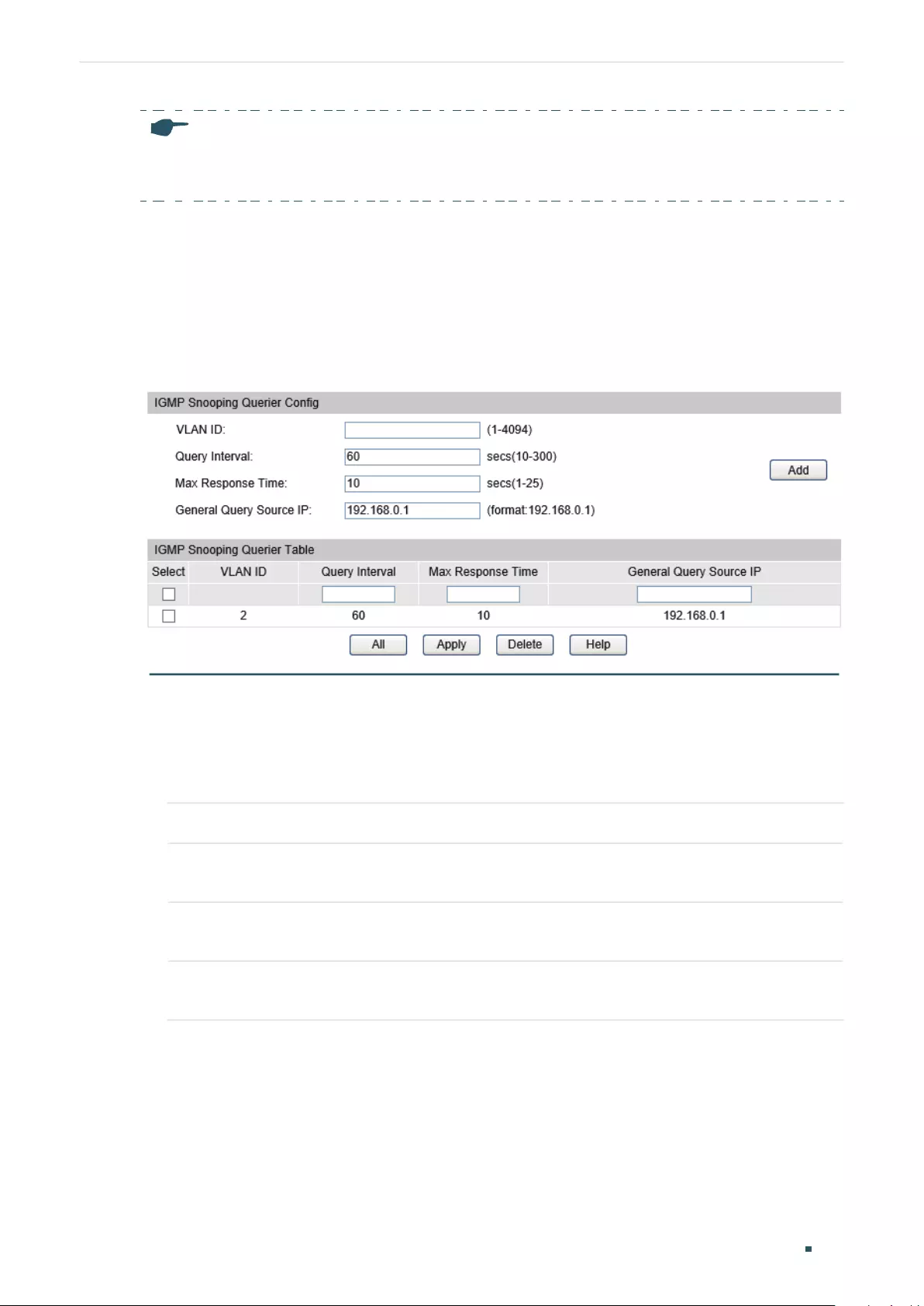
Configuration Guide 409
Configuring Layer 2 Multicast IGMP Snooping Configurations
Note:
When configuration is finished, all multicast data through the ports in the VLAN will be processed in
this multicast VLAN.
2.1.5 (Optional) Configuring the Querier
IGMP Snooping Querier sends general query packets regularly to maintain the multicast
forwarding table. Choose the menu Multicast > IGMP Snooping > Querier Config to load
the following page.
Figure 2-5 Querier Config
Configuring the Querier
Follow these steps to configure the querier.
1) Specify a VLAN and configure the querier on this VLAN.
VLAN ID Specify the VLAN to be configured.
Query Interval Enter the interval between general query messages sent by the querier. The valid
values are from 10 to 300 seconds.
Max Response
Time
Enter the host’s maximum response time to general query messages in a range of
1 to 25 seconds.
General Query
Source IP
Specify the source IP address of the general query messages sent by the querier.
It cannot be a multicast address or a broadcast address.
2) Click Add.
3) You can edit the settings in the IGMP Snooping Querier Table.
Viewing Settings of IGMP Querier
The IGMP Snooping Querier Table displays all the related settings of the IGMP querier.
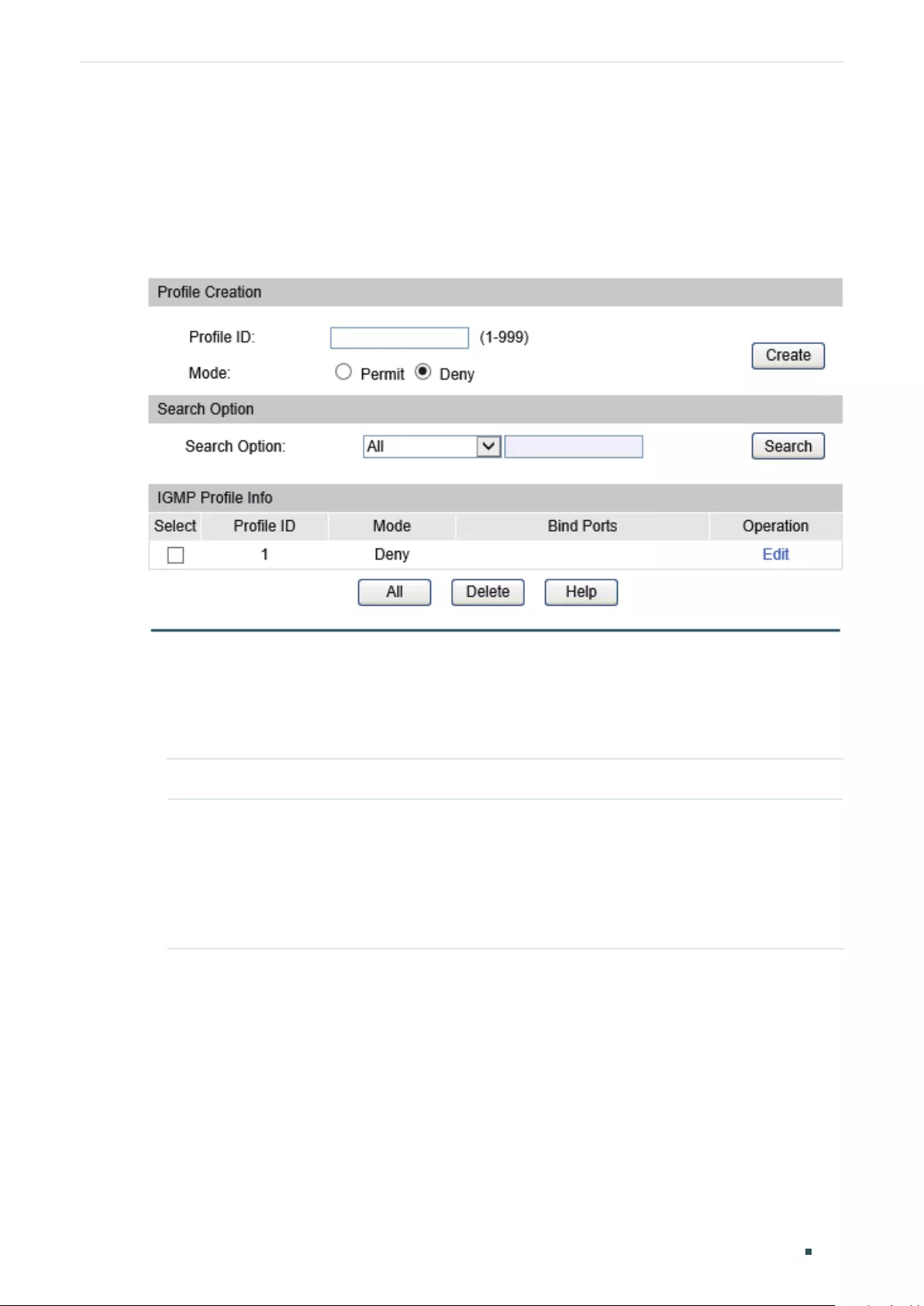
Configuring Layer 2 Multicast IGMP Snooping Configurations
Configuration Guide 410
2.1.6 Configuring IGMP Profile
With IGMP Profile, the switch can define a blacklist or whitelist of multicast addresses so as
to filter multicast sources, Choose the menu Multicast > IGMP Snooping > Profile Config
to load the following page.
Figure 2-6 Profile Create
Creating Profile
Follow these steps to create a profile and configure its filtering mode.
1) Create a profile and configure its filtering mode.
Profile ID Enter a profile ID between 1 and 999.
Mode Select Permit or Deny as the filtering mode.
Permit: similar to a whitelist, means that the switch only allows specified member
ports to join specific multicast groups.
Deny: similar to a blacklist, means that the switch disallows specific member ports
to join specific multicast groups.
2) Click Create.
Searching Profile
Enter the search condition in the Search Option field to search the profile in the IGMP
Profile Info table.

Configuration Guide 411
Configuring Layer 2 Multicast IGMP Snooping Configurations
Editing IP Range of the Profile
Follow these steps to edit profile mode and its IP range:
1) Click Edit in the IGMP Profile Info table. Edit its IP range and click Add to save the
settings.
Figure 2-7 Add IP-range
Profile ID Displays the ID of the profile to be edited.
Mode Select Permit or Deny as the filtering mode.
Permit: similar to a whitelist, means that the switch only allows specified member
ports to join specific multicast groups.
Deny: similar to a blacklist, means that the switch disallows specific member ports
to join specific multicast groups.
Start IP Specify the Start IP of the multicast IP range.
End IP Specify the End IP of the multicast IP range.
2) In the IP-range Table, you can select an IP range and click Delete to delete an IP range.
3) Click Submit to save the settings; click Back to go back to the previous page.
2.1.7 Binding Profile and Member Ports
With this function, you can configure each port’s filtering profile and the number of
multicast groups a port can join. Choose the menu Multicast > IGMP Snooping > Profile
Binding to load the following page.

Configuring Layer 2 Multicast IGMP Snooping Configurations
Configuration Guide 412
Figure 2-8 Profile Binding
Binding Profile and Member Ports
Follow these steps to bind the profile to the port.
1) Select the port to be bound, and enter the Profile ID in the Profile ID column.
Select Select the port to be bound.
Port Displays the port number.
Profile ID Enter the profile ID you create to bind the profile to the port. One port can only be
bound to one profile.
ClearBinding Click to clear the binding between the profile and the port.
2) Click Apply.
Configuring Max Groups a Port Can Join
Follow these steps to configure the maximum groups a port can join and overflow action.
1) Select a port to configure its Max Group and Overflow Action.
Select Select the port to be configured.

Configuring Layer 2 Multicast IGMP Snooping Configurations
Configuration Guide 413
Max Group Enter the number of multicast groups the port can join. The valid values are from
0 to 1000.
Overflow Action Select the action towards the new multicast group when the number of multicast
groups the port joined exceeds max group.
Drop: Drop all subsequent membership report messages, and the port will not join
any new multicast groups.
Replace: Replace the existing multicast group owning the lowest multicast MAC
address with the new multicast group.
2) Click Apply.
2.1.8 Viewing IGMP Statistics on Each Port
Choose the menu Multicast > IGMP Snooping > Packet Statistic to load the following
page.
Figure 2-9 View IGMP Statistics on the Port
Configuring Auto Refresh
Follow these steps to configure auto refresh.
1) Enable or disable Auto Refresh.

Configuration Guide 414
Configuring Layer 2 Multicast IGMP Snooping Configurations
Auto Refresh If Auto Refresh is enabled, statistics of IGMP packets on this page will refresh
automatically.
Refresh Period After Auto Refresh is enabled, enter the interval between each refresh. The valid
values are from 3 to 300 seconds.
2) Click Apply.
Viewing IGMP Statistics
The IGMP Statistics table displays all kinds of IGMP statistics of all the ports.
2.1.9 Enabling IGMP Accounting and Authentication
Choose the menu Multicast > IGMP Snooping > IGMP Authentication to load the following
page.
Figure 2-10 IGMP Accounting and Authentication

Configuring Layer 2 Multicast IGMP Snooping Configurations
Configuration Guide 415
Configuring IGMP Accounting Globally
To use this function, you should also enable Authentication, Authorization and Accounting
(AAA) globally and configure RADIUS server on the switch.
Follow these steps to enable IGMP Accounting globally.
1) Enable IGMP Accounting globally.
Accounting Select Enable to enable IGMP Snooping accounting.
2) Click Apply.
Configuring IGMP Authentication on the Port
To use this function, you should also enable AAA globally and configure RADIUS server on
the switch.
Follow these steps to enable IGMP Authentication on the port.
1) Specify the ports and enable IGMP Authentication.
IGMP
Authentication
Select one or more ports and select Enable in the IGMP Authentication column.
2) Click Apply.
2.1.10 Configuring Static Member Port
This function allows you to specify a port as a static member port in the multicast group.
Choose the menu Multicast > Multicast Table > Static IPv4 Multicast Table to load the
following page.

Configuration Guide 416
Configuring Layer 2 Multicast IGMP Snooping Configurations
Figure 2-11 Static Member Port
Configuring Static Member Port
Follow these steps to configure static member port.
1) Enter the Multicast IP and VLAN ID. Specify the Static Member Port.
Multicast IP Specify the multicast group that the static member is in.
VLAN ID Specify the VLAN that the static member is in.
Forward Port Specify one or more ports to be the static member port in the multicast group.
Without aging, the static member port receives all multicast data sent to this
multicast group.
2) Click Create.
Viewing IGMP Static Multicast Groups
You can search IGMP static multicast entries by using Multicast IP, VLAN ID or Forward
Port as the Search Option.
Static Multicast IP Table displays details of all IGMP static multicast groups.

Configuration Guide 417
Configuring Layer 2 Multicast IGMP Snooping Configurations
2.2 Using the CLI
2.2.1 Enabling IGMP Snooping Globally
Step 1 configure
Enter global configuration mode.
Step 2 ip igmp snooping
Enable IGMP Snooping Globally.
Step 3 end
Return to privileged EXEC mode.
Step 4 show ip igmp snooping
Show the basic IGMP snooping configuration.
Step 5 copy running-config startup-config
Save the settings in the configuration file.
2.2.2 Enabling IGMP Snooping on the Port
Step 1 configure
Enter global configuration mode.
Step 2 interface {fastEthernet
port
| range fastEthernet
port-list
| gigabitEthernet
port
| range
gigabitEthernet
port-list
| port-channel
port-channel-id
| range port-channe
port-channel-list
}
Enter interface configuration mode.
Step 3 ip igmp snooping
Enable IGMP Snooping on the specified port.
Step 4 end
Return to privileged EXEC mode.
Step 5 show ip igmp snooping
Show the basic IGMP snooping configuration.
Step 6 copy running-config startup-config
Save the settings in the configuration file.
The following example shows how to enable IGMP Snooping globally and enable IGMP
Snooping on port 1/0/3:
Switch#configure
Switch(config)#ip igmp snooping

Configuring Layer 2 Multicast IGMP Snooping Configurations
Configuration Guide 418
Switch(config)#interface gigabitEthernet 1/0/3
Switch(config-if)#ip igmp snooping
Switch(config-if)#show ip igmp snooping
IGMP Snooping :Enable
Unknown Multicast :Pass
Last Query Times :2
Last Query Interval :1
Global Member Age Time :260
Global Router Age Time :300
Global Report Suppression :Disable
Global Authentication Accounting:Disable
Enable Port:Gi1/0/3
Enable VLAN:
Switch(config-if)#end
Switch#copy running-config startup-config
2.2.3 Configuring IGMP Snooping Parameters Globally
Configuring Report Message Suppression
Step 1 configure
Enter global configuration mode.
Step 2 ip igmp snooping report-suppression
Enable Report Message Suppression globally. If this function is enabled, the switch will only
forward the first IGMP report message to Layer 3 devices and suppress subsequent IGMP
report messages from the same multicast group during one query interval, which reduces the
number of IGMP packets.
Step 3 end
Return to privileged EXEC mode.
Step 4 show ip igmp snooping
Show the basic IGMP snooping configuration.
Step 5 copy running-config startup-config
Save the settings in the configuration file.

Configuration Guide 419
Configuring Layer 2 Multicast IGMP Snooping Configurations
The following example shows how to enable Report Message Suppression:
Switch#configure
Switch(config)#ip igmp snooping
Switch(config)#ip igmp snooping report-suppression
Switch(config)#show ip igmp snooping
IGMP Snooping :Enable
Unknown Multicast :Pass
Last Query Times :2
Last Query Interval :1
Global Member Age Time :260
Global Router Age Time :300
Global Report Suppression :Enable
Global Authentication Accounting:Disable
Enable Port:
Enable VLAN:
Switch(config-if)#end
Switch#copy running-config startup-config
Configuring Unknown Multicast
Step 1 configure
Enter global configuration mode.
Step 2 ip igmp snooping drop-unknown
Configure the way how the switch processes the multicast data from unknown multicast
groups as Discard. Unknown multicast groups are multicast groups whose destination
multicast address is not in the multicast forwarding table of the switch.
Step 3 end
Return to privileged EXEC mode.
Step 4 show ip igmp snooping
Show the basic IGMP snooping configuration.
Step 5 copy running-config startup-config
Save the settings in the configuration file.

Configuring Layer 2 Multicast IGMP Snooping Configurations
Configuration Guide 420
For switches that support MLD Snooping, IGMP Snooping and MLD Snooping share the
setting of Unknown Multicast, so you have to enable MLD Snooping globally at the same
time.
The following example shows how to configure the switch to discard unknown multicast
data:
Switch#configure
Switch(config)#ip igmp snooping
Switch(config)#ipv6 mld snooping
Switch(config)#ip igmp snooping drop-unknown
Switch(config)#show ip igmp snooping
IGMP Snooping :Enable
Unknown Multicast :Discard
Last Query Times :2
Last Query Interval :1
Global Member Age Time :260
Global Router Age Time :300
Global Report Suppression :Disable
Global Authentication Accounting:Disable
Enable Port:
Enable VLAN:
Switch(config-if)#end
Switch#copy running-config startup-config
2.2.4 Configuring IGMP Snooping Parameters on the Port
Configuring Router Port Time and Member Port Time
Step 1 configure
Enter global configuration mode.
Step 2 ip igmp snooping rtime
rtime
ip igmp snooping mtime
mtime
rtime
is the aging time of router ports, ranging from 60 to 600 seconds.
mtime
is the aging time of member ports, ranging from 60 to 600 seconds.

Configuration Guide 421
Configuring Layer 2 Multicast IGMP Snooping Configurations
Step 3 end
Return to privileged EXEC mode.
Step 4 show ip igmp snooping
Show the basic IGMP snooping configuration.
Step 5 copy running-config startup-config
Save the settings in the configuration file.
The following example shows how to configure the global router port time and member
port time as 200 seconds:
Switch#configure
Switch(config)#ip igmp snooping
Switch(config)#ip igmp snooping rtime 200
Switch(config)#ip igmp snooping mtime 200
Switch(config)#show ip igmp snooping
IGMP Snooping :Enable
Unknown Multicast :Pass
Last Query Times :2
Last Query Interval :1
Global Member Age Time :200
Global Router Age Time :200
Global Report Suppression :Disable
Global Authentication Accounting:Disable
Enable Port:
Enable VLAN:
Switch(config-if)#end
Switch#copy running-config startup-config
Configuring Fast Leave
Step 1 configure
Enter global configuration mode.
Step 2 interface {fastEthernet
port
| range fastEthernet
port-list
| gigabitEthernet
port
| range
gigabitEthernet
port-list
| port-channel
port-channel-id
| range port-channe
port-channel-list
}
Enter interface configuration mode

Configuring Layer 2 Multicast IGMP Snooping Configurations
Configuration Guide 422
Step 3 ip igmp snooping immediate-leave
Enable Fast Leave on the specified port. With Fast Leave enabled on a port, the switch will
delete the port-multicast group entry from the multicast forwarding table once the port
receives a leave message. You should only use this function when there is a single receiver
present on the port.
Step 4 show ip igmp snooping interface [fastEthernet [
port
|
port-list
] |
gigabitEthernet [
port
|
port-
list
]] basic-config
Show the basic IGMP snooping configuration on the specified port(s) or of all the ports.
Step 5 end
Return to privileged EXEC mode.
Step 6 copy running-config startup-config
Save the settings in the configuration file.
The following example shows how to enable Fast Leave on port 1/0/3:
Switch#configure
Switch(config)#ip igmp snooping
Switch(config)#interface gigabitEternet 1/0/3
Switch(config-if)#ip igmp snooping
Switch(config-if)#ip igmp snooping immediate-leave
Switch(config-if)#show ip igmp snooping interface gigabitEthernet 1/0/3 basic-config
Port IGMP-Snooping Fast-Leave
---- ------------- ----------
Gi1/0/3 enable enable
Switch(config-if)#end
Switch#copy running-config startup-config
Configuring Max Group and Overflow Action on the Port
Step 1 configure
Enter global configuration mode.
Step 2 interface {fastEthernet
port
| range fastEthernet
port-list
| gigabitEthernet
port
| range
gigabitEthernet
port-list
| port-channel
port-channel-id
| range port-channe
port-channel-list
}
Enter interface configuration mode
Step 3 ip igmp snooping max-groups
maxgroup
Enter the number of multicast groups the port can join. The range is 0 to 1000.

Configuration Guide 423
Configuring Layer 2 Multicast IGMP Snooping Configurations
Step 4 ip igmp snooping max-groups action {drop | replace}
Specify the action towards the new multicast group when the number of multicast groups the
port joined exceeds max group.
drop: Drop all subsequent membership report messages, and the port join no more new
multicast groups.
replace: Replace the existing multicast group with the lowest multicast MAC address with the
new multicast group.
Step 5 show ip igmp snooping interface [fastEthernet [
port | port-list
]
|
gigabitEthernet [
port |
port-list
]] max-groups
Show the IGMP group limitation on the specified port(s) or of all the ports.
Step 6 end
Return to privileged EXEC mode.
Step 7 copy running-config startup-config
Save the settings in the configuration file.
The following example shows how to configure the Max Group as 500 and the Overflow
Action as Drop on port 1/0/3:
Switch#configure
Switch(config)#ip igmp snooping
Switch(config)#interface gigabitEternet 1/0/3
Switch(config-if)#ip igmp snooping
Switch(config-if)#ip igmp snooping max-groups 500
Switch(config-if)#ip igmp snooping max-groups action drop
Switch(config-if)#show ip igmp snooping interface gigabitEthernet 1/0/3 max-groups
Port Max-Groups Overflow-Action
---- ------------- ----------
Gi1/0/3 500 Drop
Switch(config-if)#end
Switch#copy running-config startup-config
2.2.5 Configuring IGMP Snooping Last Listener Query
Step 1 configure
Enter global configuration mode.

Configuring Layer 2 Multicast IGMP Snooping Configurations
Configuration Guide 424
Step 2 ip igmp snooping last-listener query-inteval
interval
interval
determines the interval between MASQs sent by the switch. The valid values are from
1 to 5 seconds.
Step 3 ip igmp snooping last-listener query-count
num
num
determines the number of MASQs sent by the switch. The valid values are from 1 to 5.
Step 4 show ip igmp snooping
Show the basic IGMP snooping configuration.
Step 5 end
Return to privileged EXEC mode.
Step 6 copy running-config startup-config
Save the settings in the configuration file.
The following example shows how to configure the last listener query count as 5 and the
last listener query interval as 5 seconds:
Switch#configure
Switch(config)#ip igmp snooping
Switch(config)#ip igmp snooping last-listener query-count 5
Switch(config)#ip igmp snooping last-listener query-interval 5
Switch(config)#show ip igmp snooping
IGMP Snooping :Enable
Unknown Multicast :Pass
Last Query Times :5
Last Query Interval :5
Global Member Age Time :260
Global Router Age Time :300
Global Report Suppression :Disable
Global Authentication Accounting:Disable
Enable Port:
Enable VLAN:
Switch(config)#end
Switch#copy running-config startup-config

Configuring Layer 2 Multicast IGMP Snooping Configurations
Configuration Guide 425
2.2.6 Configuring IGMP Snooping Parameters in the VLAN
Configuring Router Port Time and Member Port Time
Step 1 configure
Enter global configuration mode.
Step 2 ip igmp snooping vlan-config
vlan-id-list
[rtime
router-time
| mtime
member-time
]
router-time
is the aging time of the router ports in the specified VLAN, ranging from 60 to 600
seconds.
member-time
is the aging time of the member ports in the specified VLAN, ranging from 60 to
600 seconds.
Step 3 show ip igmp snooping vlan
vlan-id
Show the basic IGMP snooping configuration in the specified VLAN.
Step 4 end
Return to privileged EXEC mode.
Step 5 copy running-config startup-config
Save the settings in the configuration file.
The following example shows how to enable IGMP Snooping in VLAN 2 and VLAN 3,
configure the router port time as 500 seconds and the member port time as 400 seconds:
Switch#configure
Switch(config)#ip igmp snooping
Switch(config)#ip igmp snooping vlan-config 2-3 rtime 500
Switch(config)#ip igmp snooping vlan-config 2-3 mtime 400
Switch(config)#show ip igmp snooping vlan 2
Vlan Id: 2
Router Time:500
Member Time:400
Static Router Port:None
Dynamic Router Port:None
Forbidden Router Port:None
Switch(config)#show ip igmp snooping vlan 3
Vlan Id: 3
Router Time:500

Configuration Guide 426
Configuring Layer 2 Multicast IGMP Snooping Configurations
Member Time:400
Static Router Port:None
Dynamic Router Port:None
Forbidden Router Port:None
Switch(config)#end
Switch#copy running-config startup-config
Configuring Static Router Port
Step 1 configure
Enter global configuration mode.
Step 2 ip igmp snooping vlan-config
vlan-id-list
[rport interface {gigabitEthernet
port-list
| port-
channel
port-channel-id
}]
port-list
and
port-channel-id
are the static router ports in the specified VLAN.
Step 3 show ip igmp snooping vlan
vlan-id
Show the basic IGMP snooping configuration in the specified VLAN.
Step 4 end
Return to privileged EXEC mode.
Step 5 copy running-config startup-config
Save the settings in the configuration file.
The following example shows how to enable IGMP Snooping in VLAN 2 and configure port
1/0/2 as the static router port:
Switch#configure
Switch(config)#ip igmp snooping
Switch(config)#ip igmp snooping vlan-config 2 rport interface gigabitEthernet 1/0/2
Switch(config)#show ip igmp snooping vlan 2
Vlan Id: 2
Router Time:0
Member Time:0
Static Router Port:Gi1/0/2
Dynamic Router Port:None
Forbidden Router Port:None
Switch(config)#end

Configuring Layer 2 Multicast IGMP Snooping Configurations
Configuration Guide 427
Switch#copy running-config startup-config
Configuring Forbidden Router Port
Step 1 configure
Enter global configuration mode.
Step 2 ip igmp snooping vlan-config
vlan-id-list
router-ports-forbidden interface {gigabitEthernet
port-list
| port-channel
port-channel-id
}
port-list
and
port-channel-id
are the ports that cannot become router ports in the specified
VLAN.
Step 3 show ip igmp snooping vlan
vlan-id
Show the basic IGMP snooping configuration in the specified VLAN.
Step 4 end
Return to privileged EXEC mode.
Step 5 copy running-config startup-config
Save the settings in the configuration file.
The following example shows how to enable IGMP Snooping in VLAN 2 and forbid port
1/0/4-6 from becoming router ports (port 1/0/4-6 will drop all multicast data from Layer 3
devices):
Switch#configure
Switch(config)#ip igmp snooping
Switch(config)#ip igmp snooping vlan-config 2 router-ports-forbidden interface
gigabitEthernet 1/0/4-6
Switch(config)#show ip igmp snooping vlan 2
Vlan Id: 2
Router Time:0
Member Time:0
Static Router Port:None
Dynamic Router Port:None
Forbidden Router Port:Gi1/0/4-6
Switch(config)#end
Switch#copy running-config startup-config

Configuration Guide 428
Configuring Layer 2 Multicast IGMP Snooping Configurations
Configuring Static Multicast (Multicast IP and Forward Port)
Step 1 configure
Enter global configuration mode.
Step 2 ip igmp snooping vlan-config
vlan-id-list
static
ip
interface {gigabitEthernet
port-list
| port-
channel
port-channel-id
}
vlan-id-list
specifies the VLAN to be configured.
ip
specifies the static multicast IP address.
port-list
and
port-channel-id
specify the forward ports (member ports) bound to the static
multicast IP address in the specified VLAN.
Step 3 show ip igmp snooping groups static
Show the static IGMP snooping configuration.
Step 4 end
Return to privileged EXEC mode.
Step 5 copy running-config startup-config
Save the settings in the configuration file.
The following example shows how to configure 226.0.0.2 as the static multicast IP and
specify port 1/0/9-10 as the forward ports:
Switch#configure
Switch(config)#ip igmp snooping
Switch(config)#ip igmp snooping vlan-config 2 static 226.0.0.2 interface
gigabitEthernet 1/0/9-10
Switch(config)#show ip igmp snooping groups static
Multicast-ip VLAN-id Addr-type Switch-port
------------ ------- ------------- -------------
226.0.0.2 2 static Gi1/0/9-10
Switch(config)#end
Switch#copy running-config startup-config
2.2.7 Configuring IGMP Snooping Parameters in the Multicast VLAN
Configuring Router Port Time and Member Port Time
Step 1 configure
Enter global configuration mode.

Configuring Layer 2 Multicast IGMP Snooping Configurations
Configuration Guide 429
Step 2 ip igmp snooping multi-vlan-config [
vlan-id
]
[rtime
router-time
| mtime
member-time
]
vlan-id
specifies the VLAN to be created or to be configured.
router-time
is the aging time of the router ports in the multicast VLAN, ranging from 60 to 600
seconds.
member-time
is the aging time of the member ports in the multicast VLAN, ranging from 60 to
600 seconds.
Step 3 show ip igmp snooping multi-vlan
Show the IGMP snooping configuration in the multicast VLAN.
Step 4 end
Return to privileged EXEC mode.
Step 4 copy running-config startup-config
Save the settings in the configuration file.
The following example shows how to configure VLAN 5 as the multicast VLAN, set the
router port time as 500 seconds and the member port time as 400 seconds:
Switch#configure
Switch(config)#ip igmp snooping
Switch(config)#ip igmp snooping multi-vlan-config 5 rtime 500
Switch(config)#ip igmp snooping multi-vlan-config 5 mtime 400
Switch(config)#show ip igmp snooping multi-vlan
Multicast Vlan:Enable
Vlan Id: 5
Router Time:500
Member Time:400
Replace Source IP:0.0.0.0
Static Router Port:None
Dynamic Router Port:None
Forbidden Router Port:None
Switch(config)#end
Switch#copy running-config startup-config
Configuring Static Router Port
Step 1 configure
Enter global configuration mode.

Configuration Guide 430
Configuring Layer 2 Multicast IGMP Snooping Configurations
Step 2 ip igmp snooping multi-vlan-config [
vlan-id
]
[rport interface {gigabitEthernet
port-list
| port-
channel
port-channel-id
}]
vlan-id
specifies the VLAN to be created or to be configured.
port-list
and
port-channel-id
are the static router ports in the multicast VLAN.
Step 3 show ip igmp snooping multi-vlan
Show the IGMP snooping configuration in the multicast VLAN.
Step 4 end
Return to privileged EXEC mode.
Step 5 copy running-config startup-config
Save the settings in the configuration file.
The following example shows how to configure VLAN 5 as the multicast VLAN, and set port
1/0/5 as the static router port:
Switch#configure
Switch(config)#ip igmp snooping
Switch(config)#ip igmp snooping multi-vlan-config 5 rport interface gigabitEthernet
1/0/5
Switch(config)#show ip igmp snooping multi-vlan
Multicast Vlan:Enable
Vlan Id: 5
Router Time:300
Member Time:260
Replace Source IP:0.0.0.0
Static Router Port:Gi1/0/5
Dynamic Router Port:None
Forbidden Router Port:None
Switch(config)#end
Switch#copy running-config startup-config
Configuring Forbidden Router Port
Step 1 configure
Enter global configuration mode.

Configuring Layer 2 Multicast IGMP Snooping Configurations
Configuration Guide 431
Step 2 ip igmp snooping multi-vlan-config [
vlan-id
] router-ports-forbidden interface
{gigabitEthernet
port-list
| port-channel
port-channel-id
}
vlan-id
specifies the multicast VLAN to be configured.
port-list
and
port-channel-id
are the ports that cannot become router ports in the multicast
VLAN.
Step 3 show ip igmp snooping multi-vlan
Show the IGMP snooping configuration in the multicast VLAN.
Step 4 end
Return to privileged EXEC mode.
Step 5 copy running-config startup-config
Save the settings in the configuration file.
The following example shows how to configure VLAN 5 as the multicast VLAN, and set port
1/0/6 as the forbidden router port:
Switch#configure
Switch(config)#ip igmp snooping
Switch(config)#ip igmp snooping multi-vlan-config 5 router-ports-forbidden interface
gigabitEthernet 1/0/6
Switch(config)#show ip igmp snooping multi-vlan
Multicast Vlan:Enable
Vlan Id: 5
Router Time:300
Member Time:260
Replace Source IP:0.0.0.0
Static Router Port:None
Dynamic Router Port:None
Forbidden Router Port:Gi1/0/6
Switch(config)#end
Switch#copy running-config startup-config
Configuring Replace Source IP
Step 1 configure
Enter global configuration mode.

Configuration Guide 432
Configuring Layer 2 Multicast IGMP Snooping Configurations
Step 2 ip igmp snooping multi-vlan-config [
vlan-id
] replace-sourceip
ip
vlan-id
specifies the multicast VLAN to be configured.
ip
specifies the new source IP. The switch will replace the source IP in the IGMP multicast data
sent by the multicast VLAN with the IP address you enter.
Step 3 show ip igmp snooping multi-vlan
Show the IGMP snooping configuration in the multicast VLAN.
Step 4 end
Return to privileged EXEC mode.
Step 5 copy running-config startup-config
Save the settings in the configuration file.
The following example shows how to configure VLAN 5 as the multicast VLAN and replace
the source IP in the IGMP packets sent by the switch with 192.168.0.1:
Switch#configure
Switch(config)#ip igmp snooping
Switch(config)#ip igmp snooping multi-vlan-config 5 replace-sourceip 192.168.0.1
Switch(config)#show ip igmp snooping multi-vlan
Multicast Vlan:Enable
Vlan Id: 5
Router Time:300
Member Time:260
Replace Source IP:192.168.0.1
Static Router Port:None
Dynamic Router Port:None
Forbidden Router Port:None
Switch(config)#end
Switch#copy running-config startup-config
2.2.8 Configuring the Querier
Enabling IGMP Querier
Step 1 configure
Enter global configuration mode.

Configuration Guide 433
Configuring Layer 2 Multicast IGMP Snooping Configurations
Step 2 ip igmp snooping querier vlan
vlan-id
vlan-id
specifies the VLAN to enable IGMP Querier.
Step 3 show ip igmp snooping querier [vlan
vlan-id
]
Show the IGMP querier configuration.
Step 4 end
Return to privileged EXEC mode.
Step 5 copy running-config startup-config
Save the settings in the configuration file.
The following example shows how to enable IGMP Snooping and IGMP Querier in VLAN 4:
Switch#configure
Switch(config)#ip igmp snooping
Switch(config)#ip igmp snooping querier vlan 4
Switch(config)#show ip igmp snooping querier
VLAN 4:
--------------
Maximum Response Time: 10
Query Interval: 60
General Query Source IP: 192.168.0.1
Switch(config)#end
Switch#copy running-config startup-config
Configuring Query Interval, Max Response Time and General Query Source IP
Step 1 configure
Enter global configuration mode.
Step 2 ip igmp snooping querier vlan vlan-id {query-interval
interval
| max-response-time
response-time
| general-query source-ip
ip-addr
}
vlan-id
specifies the VLAN where the querier is.
interval
is the interval between general query messages sent by the querier.
response-time
is the host’s maximum response time to general query messages in a range of 1
to 25 seconds.
ip-addr
is the source IP address of the general query messages sent by the querier. It cannot
be a multicast address or a broadcast address.

Configuring Layer 2 Multicast IGMP Snooping Configurations
Configuration Guide 434
Step 3 show ip igmp snooping querier [vlan
vlan-id
]
Show the detailed IGMP querier configuration.
Step 4 end
Return to privileged EXEC mode.
Step 5 copy running-config startup-config
Save the settings in the configuration file.
The following example shows how to enable IGMP Snooping and IGMP Querier in VLAN
4, set the query interval as 100 seconds, the max response time as 20 seconds, and the
general query source IP as 192.168.0.1:
Switch#configure
Switch(config)#ip igmp snooping
Switch(config)#ip igmp snooping querier vlan 4 query-interval 100
Switch(config)#ip igmp snooping querier vlan 4 max-response-time 20
Switch(config)#ip igmp snooping querier vlan 4 general-query source-ip 192.168.0.1
Switch(config)#show ip igmp snooping querier
VLAN 4:
--------------
Maximum Response Time: 20
Query Interval: 100
General Query Source IP: 192.168.0.1
Switch(config)#end
Switch#copy running-config startup-config
2.2.9 Configuring Multicast Filtering
Creating Profile
Step 1 configure
Enter global configuration mode.
Step 2 ip igmp profile
id
Create a new profile and enter profile configuration mode.

Configuration Guide 435
Configuring Layer 2 Multicast IGMP Snooping Configurations
Step 3 permit
deny
Configure the profile's filtering mode.
permit is similar to a whitelist, indicating that the switch only allow specific member ports to
join specific multicast groups.
deny is similar to a blacklist, indicating that the switch disallow specific member ports to join
specific multicast groups.
Step 4 range
start-ip end-ip
Configure the range of multicast IP to be filtered.
start-ip
,
end-ip
are the start IP and end IP of
the IP range respectively.
Step 5 show ip igmp profile [
id
]
Show the detailed IGMP profile configuration.
Step 6 end
Return to privileged EXEC mode.
Step 7 copy running-config startup-config
Save the settings in the configuration file.
The following example shows how to configure Profile 1 so that the switch filters multicast
data sent to 226.0.0.5-226.0.0.10:
Switch#configure
Switch(config)#ip igmp snooping
Switch(config)#ip igmp profile 1
Switch(config-igmp-profile)#deny
Switch(config-igmp-profile)#range 226.0.0.5 226.0.0.10
Switch(config-igmp-profile)#show ip igmp profile
IGMP Profile 1
deny
range 226.0.0.5 226.0.0.10
Switch(config)#end
Switch#copy running-config startup-config
Binding Profile to the Port
Step 1 configure
Enter global configuration mode.

Configuring Layer 2 Multicast IGMP Snooping Configurations
Configuration Guide 436
Step 2 interface {fastEthernet
port
| range fastEthernet
port-list
| gigabitEthernet
port
| range
gigabitEthernet
port-list
| port-channel
port-channel-id
| range port-channe
port-channel-list
}
Enter interface configuration mode
Step 3 ip igmp filter
profile-id
Bind profile-id to the specified port.
Step 4 show ip igmp profile [
id
]
Show the detailed IGMP profile configuration.
Step 5 end
Return to privileged EXEC mode.
Step 6 copy running-config startup-config
Save the settings in the configuration file.
The following example shows how to bind Profile 1 to port 1/0/2 so that port 1/0/2 filters
multicast data sent to 226.0.0.5-226.0.0.10:
Switch#configure
Switch(config)#ip igmp snooping
Switch(config)#ip igmp profile 1
Switch(config-igmp-profile)#deny
Switch(config-igmp-profile)#range 226.0.0.5 226.0.0.10
Switch(config-igmp-profile)#exit
Switch(config)#interface gigabitEthernet 1/0/2
Switch(config-if)#ip igmp snooping
Switch(config-if)#ip igmp filter 1
Switch(config-if)#show ip igmp profile
IGMP Profile 1
deny
range 226.0.0.5 226.0.0.10
Binding Port(s)
Gi1/0/2
Switch(config)#end
Switch#copy running-config startup-config

Configuration Guide 437
Configuring Layer 2 Multicast IGMP Snooping Configurations
2.2.10 Enabling IGMP Accounting and Authentication
Enabling IGMP Authentication on the Port
Step 1 configure
Enter global configuration mode.
Step 2 interface {fastEthernet
port
| range fastEthernet
port-list
| gigabitEthernet
port
| range
gigabitEthernet
port-list
| port-channel
port-channel-id
| range port-channe
port-channel-list
}
Enter interface configuration mode
Step 3 ip igmp snooping authentication
Enable IGMP Authentication on the specified port.
Step 4 show ip igmp snooping interface [gigabitEthernet
port
] authentication
Show the IGMP authentication status of the specified port or of all the ports.
Step 6 end
Return to privileged EXEC mode.
Step 5 copy running-config startup-config
Save the settings in the configuration file.
The following example shows how to enable IGMP Authentication on port 1/0/2:
Switch#configure
Switch(config)#ip igmp snooping
Switch(config)#interface gigabitEthernet 1/0/2
Switch(config-if)#ip igmp snooping
Switch(config-if)#ip igmp snooping authentication
Switch(config-if)#show ip igmp snooping interface gigabitEthernet 1/0/2 authentication
Port IGMP-Authentication
---- -------------
Gi1/0/2 enable
Switch(config)#end
Switch#copy running-config startup-config
Note:
IGMP Authentication takes effect only after AAA is enabled and RADIUS server is configured.

Configuring Layer 2 Multicast IGMP Snooping Configurations
Configuration Guide 438
Enabling IGMP Accounting Globally
Step 1 configure
Enter global configuration mode.
Step 2 ip igmp snooping accounting
Enable IGMP Accounting globally.
Step 3 show ip igmp snooping
Show the global IGMP snooping configuration.
Step 4 end
Return to privileged EXEC mode.
Step 5 copy running-config startup-config
Save the settings in the configuration file.

Configuration Guide 439
Configuring Layer 2 Multicast Configuring MLD Snooping
3 Configuring MLD Snooping
3.1 Using the GUI
3.1.1 Configuring MLD Snooping Globally
Choose the menu Multicast > MLD Snooping > Snooping Config
Figure 3-1 MLD Snooping Global Config
Enabling MLD Snooping Globally
Before configuring functions related to MLD Snooping, enable MLD Snooping globally first.
1) Select Enable to enable MLD Snooping globally.
2) Click Apply.
(Optional) Configuring Unknown Multicast
Unknown Multicast decides how to process the multicast data when its destination
multicast address is not in the multicast forwarding table of the switch.

Configuring Layer 2 Multicast Configuring MLD Snooping
Configuration Guide 440
IGMP Snooping and MLD Snooping share the setting of Unknown Multicast, so you have
to enable IGMP Snooping globally on the Multicast > IGMP Snooping > Snooping Config
page at the same time.
Follow these steps to configure unknown multicast.
1) Configure Unknown Multicast as Forward or Discard.
Unknown
Multicast
Configure the way how the switch processes the multicast data sent to unknown
multicast groups as Forward or Discard. Unknown multicast groups are multicast
groups whose destination multicast address is not in the multicast forwarding
table of the switch.
2) Click Apply.
(Optional) Configuring Report Message Suppression
Enabling Report Message Suppression can reduce the number of packets in the network.
Follow these steps to configure report message suppression.
1) Enable or disable Report Message Suppression globally.
Report Message
Suppression
If this function is enabled, the switch will only forward the first MLD report
message to Layer 3 devices and suppress subsequent MLD report messages
from the same multicast group during one query interval, which reduces the
number of MLD packets.
2) Click Apply.
Configuring Router Port Time and Member Port Time
Follow these steps to configure the aging time of the router ports and the member ports:
1) Specify the aging time of the router ports.
Router Port
Time
Router ports are ports connected to Layer 3 devices on the switch. The router
port ages if the switch does not receive MLD query message from the router port
within the router port time. The switch will no longer consider this port as a router
port and delete it from the router port table. The valid values are from 60 to 600
seconds.
2) Specify the aging time of the member ports.
Member Port
Time
Member ports are ports connected to multicast group members on the switch.
A port is considered to be a member port when it is added to a multicast group.
The member port ages if the switch does not receive MLD membership report
message from the member port within the member port time. The switch will
no longer consider this port as a member port and delete it from the multicast
forwarding table. The valid values are from 60 to 600 seconds.
3) Click Apply.

Configuration Guide 441
Configuring Layer 2 Multicast Configuring MLD Snooping
Configuring MLD Snooping Last Listener Query
Configure the Last Listener Query Interval and Last Listener Query Count when the switch
receives an MLD leave message. If specified count of Multicast-Address-Specific Queries
(MASQs) are sent and no report message is received, the switch will delete the multicast
address from the multicast forwarding table.
Follow these steps to configure Last Listener Query Interval and Last Listener Query
Count in the Global Config section:
1) Specify the interval between MASQs.
Last Listener
Query Interval
When the switch receives an MLD leave message, the switch obtains the address
of the multicast group that the host wants to leave from the message. Then the
switch sends out MASQs to this multicast group through the port receiving the
leave message. This parameter determines the interval between MASQs. The
valid values are from 1 to 5 seconds.
2) Specify the number of MASQs to be sent.
Last Listener
Query Count
When the switch receives an MLD leave message, the switch obtains the address
of the multicast group that the host wants to leave from the message. Then the
switch sends out MASQs to this multicast group through the port receiving the
leave message. This parameter determines the number of MASQs to be sent. The
valid values are from 1 to 5.
3) Click Apply.
Verifying MLD Snooping Status
MLD Snooping Status Table displays VLANs and ports with MLD Snooping enabled.
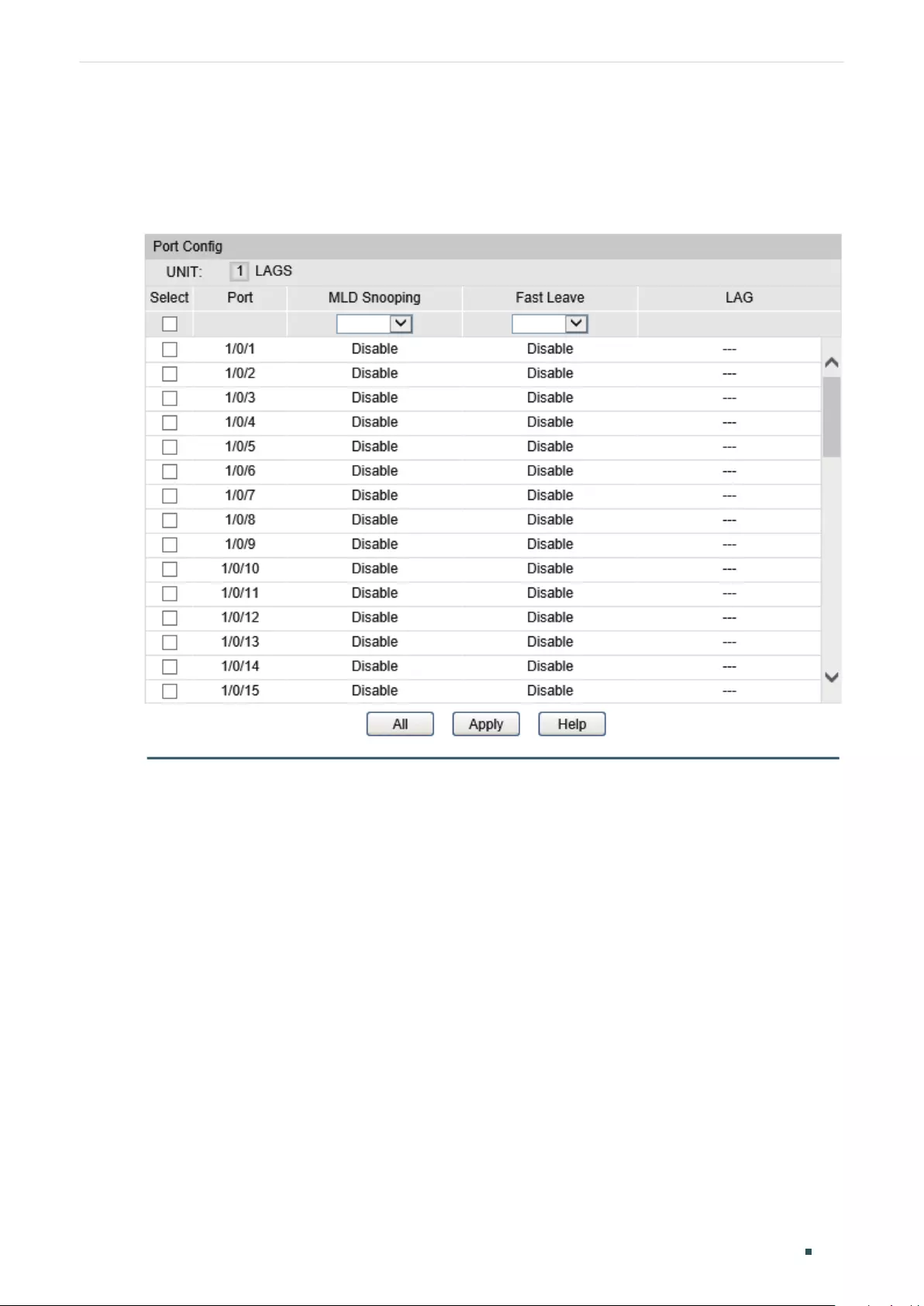
Configuring Layer 2 Multicast Configuring MLD Snooping
Configuration Guide 442
3.1.2 Configuring the Port’s Basic MLD Snooping Features
Choose the menu Multicast > MLD Snooping > Port Config to load the following page.
Figure 3-2 Enable MLD Snooping on Port
Enabling MLD Snooping on the Port
Follow these steps to enable or disable MLD Snooping on the port.
1) Select the port to be configured and select Enable under the MLD Snooping column.
2) Click Apply.
(Optional) Configuring Fast Leave
With Fast Leave enabled on a port, the switch will remove this port from the forwarding
list of the corresponding multicast group once the port receives a leave message. Once
deleted, the switch will no longer send MASQs to this port to verify if there are other
members of this multicast group.
Follow these steps to configure fast leave.
1) Select the port to be configured and select Enable under the Fast Leave column.

Configuring Layer 2 Multicast Configuring MLD Snooping
Configuration Guide 443
Fast Leave With Fast Leave enabled on a port, the switch will remove this port from the
forwarding list of the corresponding multicast group once the port receives a
leave message. You should only use this function when there is a single receiver
present on the port.
2) Click Apply.
3.1.3 Configuring MLD Snooping in the VLAN
Choose the menu Multicast > MLD Snooping > VLAN Config to load the following page.
Figure 3-3 MLD Snooping in VLAN
Configuring MLD Snooping Globally in the VLAN
In the VLAN Config section, follow these steps to configure relevant parameters for the
designate VLAN.
1) Set up the VLAN that the router ports and the member ports are in. For details, please
refer to Configuring 802.1Q VLAN.
2) Enable MLD Snooping in the designate VLAN, and configure the aging time of the router
ports and the member ports.
VLAN ID Specify the VLAN to enable MLD Snooping.

Configuration Guide 444
Configuring Layer 2 Multicast Configuring MLD Snooping
Router Port
Time
Specify the aging time of the router ports in the VLAN. If the router port does not
receive any MLD general query message within the router port time, the switch
will no longer consider this port as a router port and delete it from the router port
list. The valid values are from 60 to 600 seconds. When the router port time is 0,
the VLAN uses the global time.
Member Port
Time
Specify the aging time of the member ports in the VLAN. If the member port does
not receive any MLD membership report message from the multicast group within
the member port time, the switch will no longer consider this port as a member
port and delete it from the multicast forwarding table. The valid values are from 60
to 600 seconds. When the member port time is 0, the VLAN uses the global time.
3) Click Create.
(Optional) Configuring the Static Router Ports in the VLAN
Follow these steps to configure static router ports in the designate VLAN:
1) Configure the router ports in the designate VLAN.
VLAN ID Specify the VLAN to be configured.
Static Router
Ports
Select one or more ports to be the static router ports in the VLAN. All multicast
data in this VLAN will be forwarded through the static router ports.
2) Click Create.
(Optional) Configuring the Forbidden Router Ports in the VLAN
Follow these steps to forbid the selected ports to be the router ports in the designate
VLAN:
1) Configure the forbidden router ports in the designate VLAN.
VLAN ID Specify the VLAN to be configured.
Forbidden
Router Ports
Select the ports to forbid them from being router ports in the VLAN.
2) Click Create.
3.1.4 Configuring the Multicast VLAN
In old multicast transmission mode, when users in different VLANs apply for data from
the same multicast group, the Layer 3 device will duplicate this multicast data and deliver
copies to the Layer 2 devices.
With Multicast VLAN configured, all multicast group members will be added to a VLAN.
Layer 3 device only need to send one piece of multicast data to a Layer 2 device, and the
Layer 2 device will send the data to all member ports of the VLAN. In this way, Multicast
VLAN saves bandwidth and reduces network load of Layer 3 devices.

Configuring Layer 2 Multicast Configuring MLD Snooping
Configuration Guide 445
Choose the menu Multicast > MLD Snooping > Multicast VLAN to load the following page.
Figure 3-4 Multicast VLAN Config
Creating Multicast VLAN and Configuring Basic Settings
In the Multicast VLAN section, follow these steps to enable Multicast VLAN and to finish the
basic settings:
1) Set up the VLAN that the router ports and the member ports are in. For details, please
refer to Configuring 802.1Q VLAN.
2) Enable Multicast VLAN, configure the specific VLAN to be the multicast VLAN, and
configure the Router Port Time and Member Port Time.
Multicast VLAN Select Enable to enable multicast VLAN function.
VLAN ID Specify the 802.1Q VLAN to be the multicast VLAN.
Router Port
Time
Specify the aging time of the router ports in the multicast VLAN. If the router port
does not receive any MLD general query message within the router port time,
the switch will no longer consider this port as a router port and delete it from the
router port table. The valid values are from 60 to 600 seconds. When the router
port time is 0, the VLAN uses the global time.

Configuration Guide 446
Configuring Layer 2 Multicast Configuring MLD Snooping
Member Port
Time
Specify the aging time of the member ports in the multicast VLAN. If the member
port does not receive any MLD membership report message from the multicast
group within the member port time, the switch will no longer consider this port as
a member port and delete it from the multicast forwarding table. The valid values
are from 60 to 600 seconds. When the member port time is 0, the VLAN uses the
global time.
3) Click Apply.
(Optional) Creating Replace Source IP
This function allows you to use a new IP instead of the source IP to send data to multicast
group members. In the Multicast VLAN section, follow these steps to configure Replace
Source IP.
1) Configure the new multicast source IP.
Replace Source
IP
Enter the new source IP address. The switch will replace the source IP in the MLD
multicast data sent by the multicast VLAN with the IP address you enter.
2) Click Apply.
Viewing Dynamic Router Ports in the Multicast VLAN
This table displays all the dynamic router ports in the multicast VLAN.
(Optional) Configuring the Static Router Ports
Follow these steps to configure static router ports in the multicast VLAN:
1) Configure the router ports in the multicast VLAN.
VLAN ID Specify the VLAN to be configured.
Static Router
Ports
Select one or more ports to be the static router ports in the VLAN. All multicast
data in this VLAN will be forwarded through the static router ports.
2) Click Apply.
(Optional) Configuring the Forbidden Router Ports
Follow these steps to forbid the selected ports to be the router ports in the multicast VLAN.
1) Configure the router ports in the designate VLAN.
VLAN ID Specify the VLAN to be configured.
Forbidden
Router Ports
Select the ports to forbid them from being router ports in the VLAN.
2) Click Apply.

Configuring Layer 2 Multicast Configuring MLD Snooping
Configuration Guide 447
Note:
When configuration is finished, all multicast data through the ports in the VLAN will be processed in
this multicast VLAN.
3.1.5 (Optional) Configuring the Querier
MLD Snooping Querier sends general query packets regularly to maintain the multicast
forwarding table. Choose the menu Multicast > MLD Snooping > Querier Config to load
the following page.
Figure 3-5 Querier Config
Configuring the Querier
Follow these steps to configure the querier.
1) Specify a VLAN and configure the querier on this VLAN.
VLAN ID Specify the VLAN to be configured.
Query Interval Enter the interval between general query messages sent by the querier. The valid
values are from 10 to 300 seconds.
Max Response
Time
Enter the host’s maximum response time to general query messages in a range of
1 to 25 seconds.
General Query
Source IP
Specify the source IP address of the general query messages sent by the querier.
It cannot be a multicast address or a broadcast address.
2) Click Add.
3) You can edit the settings in the MLD Snooping Querier Table.
Viewing Settings of MLD Querier
The MLD Snooping Querier Table displays all the related settings of the MLD querier.
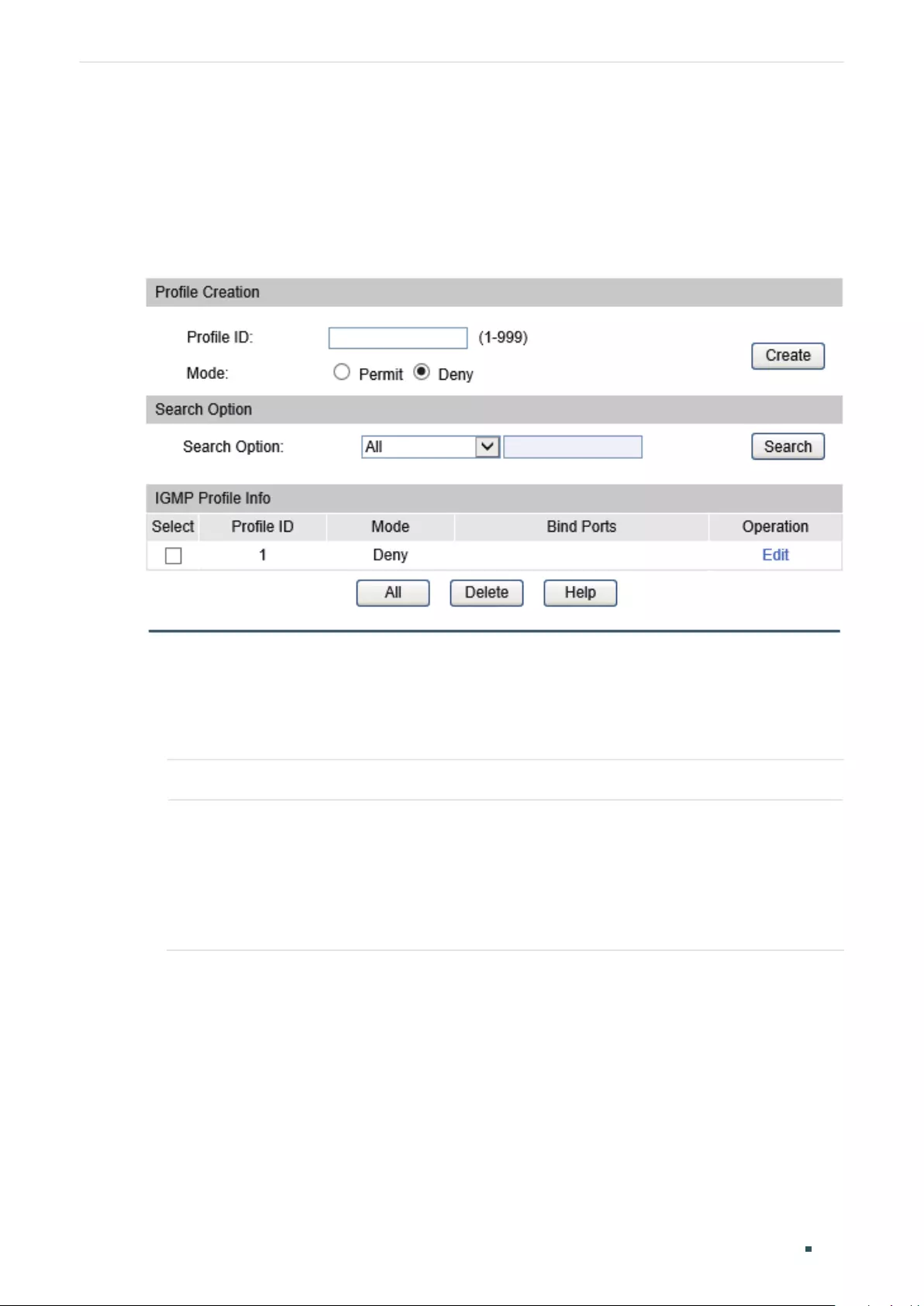
Configuration Guide 448
Configuring Layer 2 Multicast Configuring MLD Snooping
3.1.6 Configuring MLD Profile
With MLD Profile, the switch can define a blacklist or whitelist of multicast addresses so as
to filter multicast sources, Choose the menu Multicast > MLD Snooping > Profile Config
to load the following page.
Figure 3-6 Profile Create
Creating Profile
Follow these steps to create a profile and configure its filtering mode.
1) Create a profile and configure its filtering mode.
Profile ID Enter a profile ID between 1 and 999.
Mode Select Permit or Deny as the filtering mode.
Permit: similar to a whitelist, means that the switch only allows specified member
ports to join specific multicast groups.
Deny: similar to a blacklist, means that the switch disallows specific member ports
to join specific multicast groups.
2) Click Create.
Searching Profile
Enter the search condition in the Search Option field to search the profile in the MLD
Profile Info table.
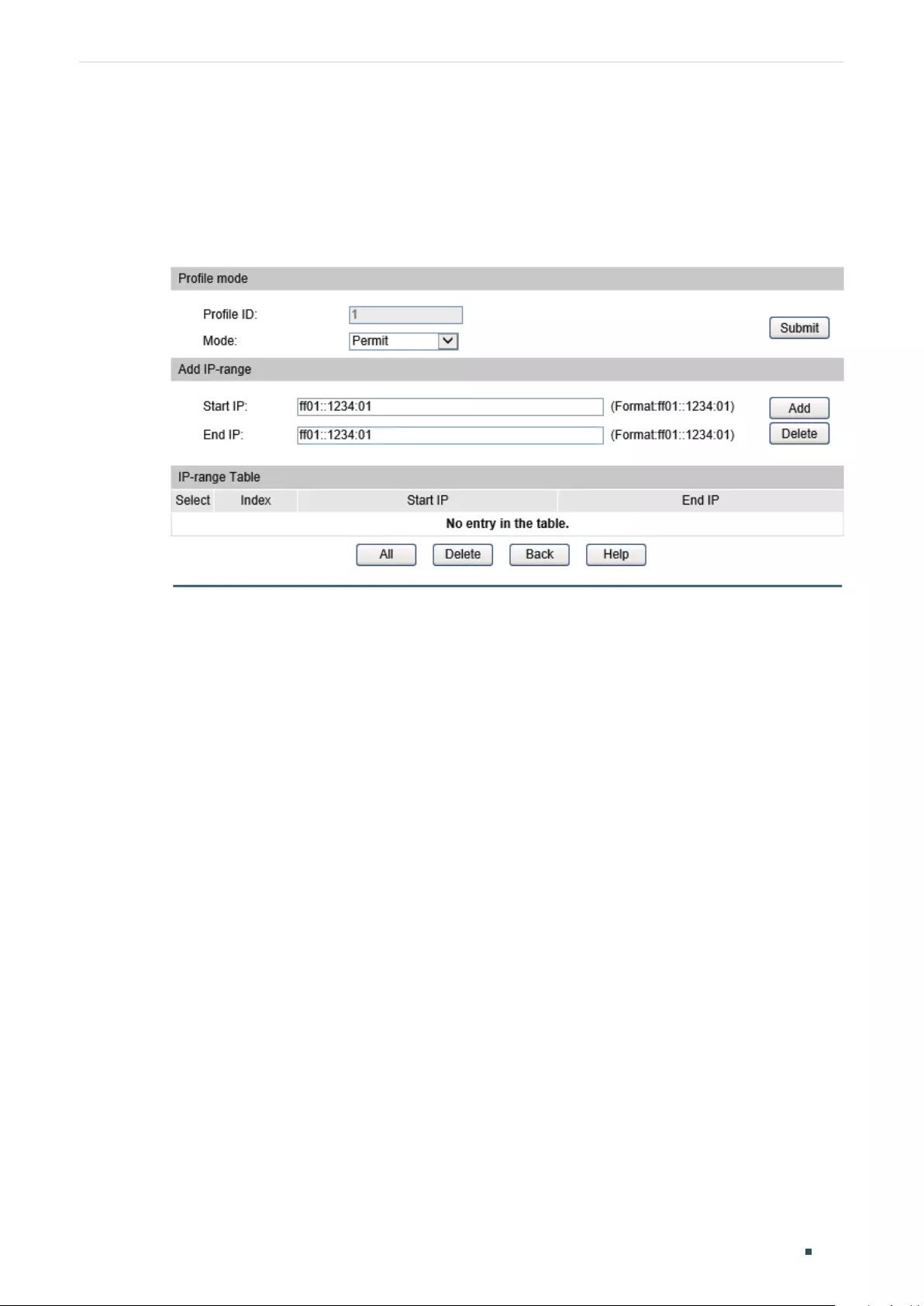
Configuring Layer 2 Multicast Configuring MLD Snooping
Configuration Guide 449
Editing IP Range of the Profile
Follow these steps to edit profile mode and its IP range:
1) Click Edit in the MLD Profile Info table. Edit its IP range and click Add to save the
settings.
Figure 3-7 Add IP-range
2) In the IP-range Table, you can select an IP range and click Delete to delete an IP range.
3) Click Submit to save the settings; click Back to go back to the previous page.
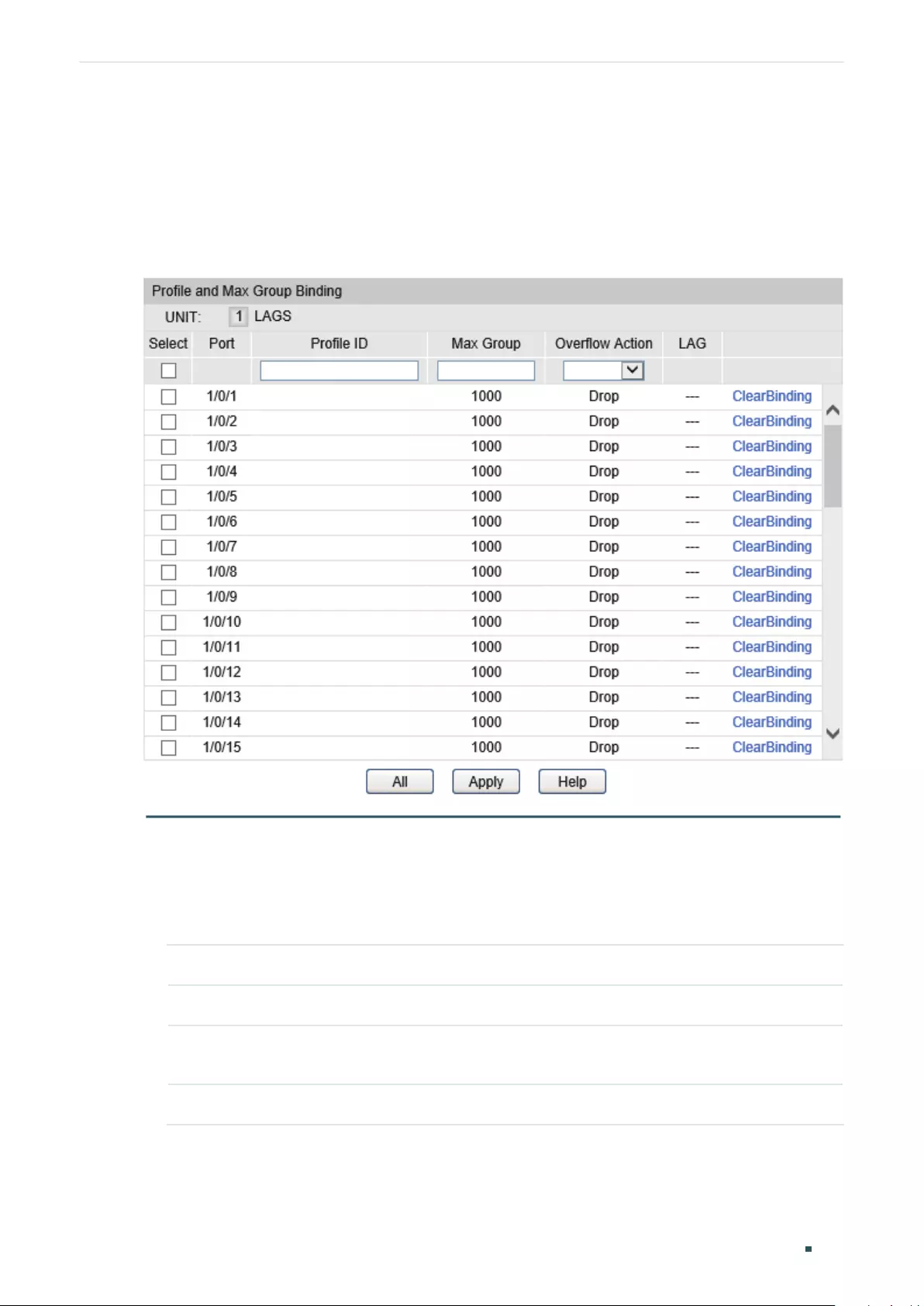
Configuration Guide 450
Configuring Layer 2 Multicast Configuring MLD Snooping
3.1.7 Binding Profile and Member Ports
With this function, you can configure each port’s filtering profile and the number of
multicast groups a port can join. Choose the menu Multicast > MLD Snooping > Profile
Binding to load the following page.
Figure 3-8 Profile Binding
Binding Profile and Member Ports
Follow these steps to bind the profile to the port.
1) Select the port to be bound, and enter the Profile ID in the Profile ID column.
Select Select the port to be bound.
Port Displays the port number.
Profile ID Enter the profile ID you create to bind the profile to the port. One port can only be
bound to one profile.
ClearBinding Click to clear the binding between the profile and the port.
2) Click Apply.

Configuring Layer 2 Multicast Configuring MLD Snooping
Configuration Guide 451
Configuring Max Groups a Port Can Join
Follow these steps to configure the maximum groups a port can join and overflow action.
1) Select a port to configure its Max Group and Overflow Action.
Select Select the port to be configured.
Max Group Enter the number of multicast groups the port can join. The valid values are from
0 to 1000.
Overflow Action Select the action towards the new multicast group when the number of multicast
groups the port joined exceeds max group.
Drop: Drop all subsequent membership report messages, and the port will not join
any new multicast groups.
Replace: Replace the existing multicast group owning the lowest multicast MAC
address with the new multicast group.
2) Click Apply.
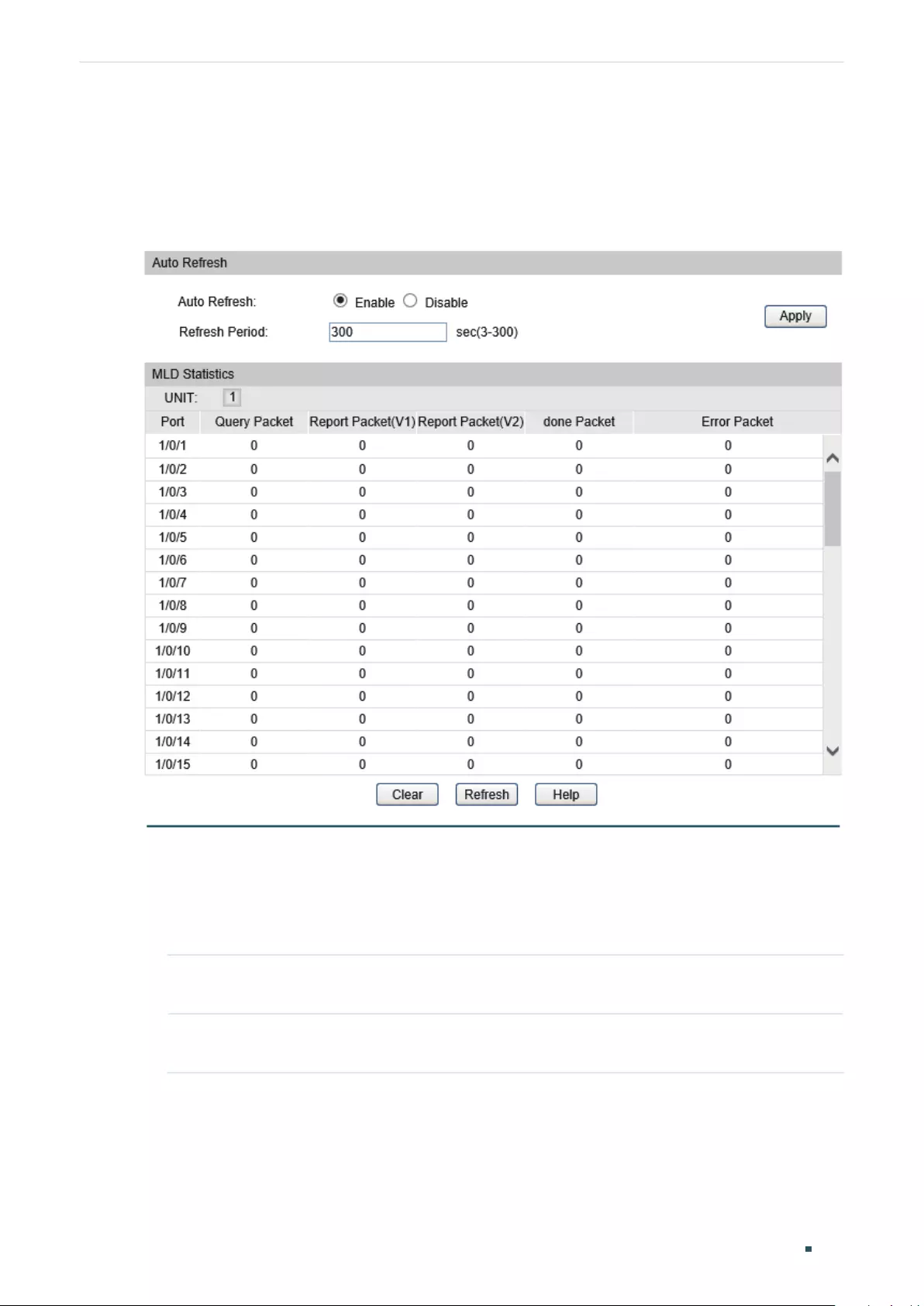
Configuration Guide 452
Configuring Layer 2 Multicast Configuring MLD Snooping
3.1.8 Viewing MLD Statistics on Each Port
Choose the menu Multicast > MLD Snooping > Packet Statistic to load the following
page.
Figure 3-9 View MLD Statistics on the Port
Configuring Auto Refresh
Follow these steps to configure auto refresh.
1) Enable or disable Auto Refresh.
Auto Refresh If Auto Refresh is enabled, statistics of MLD packets on this page will refresh
automatically.
Refresh Period After Auto Refresh is enabled, enter the interval between each refresh. The valid
values are from 3 to 300 seconds.
2) Click Apply.
Viewing MLD Statistics
The MLD Statistics table displays all kinds of MLD statistics of all the ports.
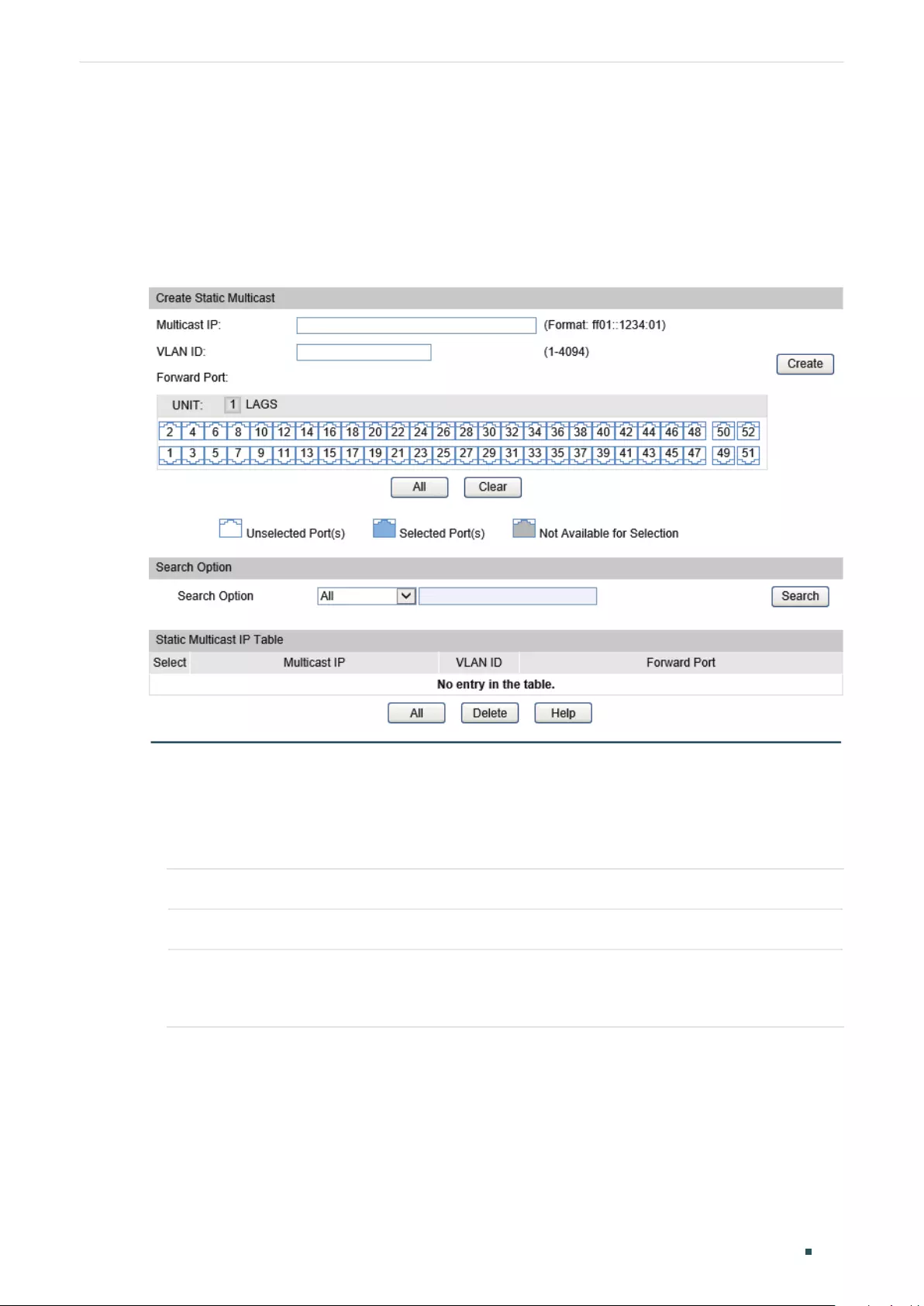
Configuring Layer 2 Multicast Configuring MLD Snooping
Configuration Guide 453
3.1.9 Configuring Static Member Port
This function allows you to specify a port as a static member port in the multicast group.
Choose the menu Multicast > Multicast Table > Static IPv4 Multicast Table to load the
following page.
Figure 3-10 Static Member Port
Configuring Static Member Port
Follow these steps to configure static member port.
1) Enter the Multicast IP and VLAN ID. Specify the Static Member Port.
Multicast IP Specify the multicast group that the static member is in.
VLAN ID Specify the VLAN that the static member is in.
Forward Port Specify one or more ports to be the static member port in the multicast group.
Without aging, the static member port receives all multicast data sent to this
multicast group.
2) Click Create.
Viewing MLD Static Multicast Groups
You can search MLD static multicast entries by using Multicast IP, VLAN ID or Forward Port
as the Search Option.
Static Multicast IP Table displays details of all MLD static multicast groups.

Configuration Guide 454
Configuring Layer 2 Multicast Configuring MLD Snooping
3.2 Using the CLI
3.2.1 Enabling MLD Snooping Globally
Step 1 configure
Enter global configuration mode.
Step 2 ipv6 mld snooping
Enable MLD Snooping Globally.
Step 3 show ipv6 mld snooping
Show the basic MLD snooping configuration.
Step 4 end
Return to privileged EXEC mode.
Step 5 copy running-config startup-config
Save the settings in the configuration file.
3.2.2 Enabling MLD Snooping on the Port
Step 1 configure
Enter global configuration mode.
Step 2 interface {fastEthernet
port
| range fastEthernet
port-list
| gigabitEthernet
port
| range
gigabitEthernet
port-list
| port-channel
port-channel-id
| range port-channe
port-channel-list
}
Enter interface configuration mode.
Step 3 ipv6 mld snooping
Enable MLD Snooping on the specified port.
Step 4 show ipv6 mld snooping
Show the basic MLD snooping configuration.
Step 5 end
Return to privileged EXEC mode.
Step 6 copy running-config startup-config
Save the settings in the configuration file.
The following example shows how to enable MLD Snooping globally and enable MLD
Snooping Switch#configure
Switch(config)#ipv6 mld snooping
Switch(config)#interface gigabitEthernet 1/0/3

Configuring Layer 2 Multicast Configuring MLD Snooping
Configuration Guide 455
Switch(config-if)#ipv6 mld snooping
Switch(config-if)#show ipv6 mld snooping
MLD Snooping :Enable
Unknown Multicast :Pass
Last Query Times :2
Last Query Interval :1
Global Member Age Time :260
Global Router Age Time :300
Global Report Suppression :Disable
Enable Port:Gi1/0/3
Enable VLAN:
Switch(config-if)#end
Switch#copy running-config startup-config
3.2.3 Configuring MLD Snooping Parameters Globally
Configuring Report Message Suppression
Step 1 configure
Enter global configuration mode.
Step 2 ipv6 mld snooping report-suppression
Enable Report Message Suppression globally. If this function is enabled, the switch will only
forward the first MLD report message to Layer 3 devices and suppress subsequent MLD
report messages from the same multicast group during one query interval, which reduces the
number of MLD packets.
Step 3 show ipv6 mld snooping
Show the basic MLD snooping configuration.
Step 4 end
Return to privileged EXEC mode.
Step 5 copy running-config startup-config
Save the settings in the configuration file.
The following example shows how to enable Report Message Suppression:
Switch#configure
Switch(config)#ipv6 mld snooping

Configuration Guide 456
Configuring Layer 2 Multicast Configuring MLD Snooping
Switch(config)#ipv6 mld snooping report-suppression
Switch(config)#show ipv6 mld snooping
MLD Snooping :Enable
Unknown Multicast :Pass
Last Query Times :2
Last Query Interval :1
Global Member Age Time :260
Global Router Age Time :300
Global Report Suppression :Enable
Enable Port:
Enable VLAN:
Switch(config)#end
Switch#copy running-config startup-config
Configuring Unknown Multicast
Step 1 configure
Enter global configuration mode.
Step 2 ipv6 mld snooping drop-unknown
Configure the way how the switch processes the multicast data from unknown multicast
groups as Discard. Unknown multicast groups are multicast groups whose destination
multicast address is not in the multicast forwarding table of the switch.
Step 3 show ipv6 mld snooping
Show the basic MLD snooping configuration.
Step 4 end
Return to privileged EXEC mode.
Step 5 copy running-config startup-config
Save the settings in the configuration file.
IGMP Snooping and MLD Snooping share the setting of Unknown Multicast, so you have to
enable IGMP Snooping globally at the same time.
The following example shows how to configure the switch to discard unknown multicast
data:
Switch#configure
Switch(config)#ipv6 mld snooping

Configuring Layer 2 Multicast Configuring MLD Snooping
Configuration Guide 457
Switch(config)#ip igmp snooping
Switch(config)#ipv6 mld snooping drop-unknown
Switch(config)#show ipv6 mld snooping
MLD Snooping :Enable
Unknown Multicast :Discard
Last Query Times :2
Last Query Interval :1
Global Member Age Time :260
Global Router Age Time :300
Global Report Suppression :Disable
Enable Port:
Enable VLAN:
Switch(config)#end
Switch#copy running-config startup-config
3.2.4 Configuring MLD Snooping Parameters on the Port
Configuring Router Port Time and Member Port Time
Step 1 configure
Enter global configuration mode.
Step 2 ipv6 mld snooping rtime
rtime
ipv6 mld snooping mtime
mtime
rtime
is the aging time of router ports, ranging from 60 to 600 seconds.
mtime
is the aging time of member ports, ranging from 60 to 600 seconds.
Step 3 show ipv6 mld snooping
Show the basic MLD snooping configuration.
Step 4 end
Return to privileged EXEC mode.
Step 5 copy running-config startup-config
Save the settings in the configuration file.
The following example shows how to configure the global router port time and member
port time as 200 seconds:
Switch#configure

Configuration Guide 458
Configuring Layer 2 Multicast Configuring MLD Snooping
Switch(config)#ipv6 mld snooping
Switch(config)#ipv6 mld snooping rtime 200
Switch(config)#ipv6 mld snooping mtime 200
Switch(config)#show ipv6 mld snooping
MLD Snooping :Enable
Unknown Multicast :Pass
Last Query Times :2
Last Query Interval :1
Global Member Age Time :200
Global Router Age Time :200
Global Report Suppression :Disable
Enable Port:
Enable VLAN:
Switch(config)#end
Switch#copy running-config startup-config
Configuring Fast Leave
Step 1 configure
Enter global configuration mode.
Step 2 interface {fastEthernet
port
| range fastEthernet
port-list
| gigabitEthernet
port
| range
gigabitEthernet
port-list
| port-channel
port-channel-id
| range port-channe
port-channel-list
}
Enter interface configuration mode
Step 3 ipv6 mld snooping immediate-leave
Enable Fast Leave on the specified port. With Fast Leave enabled on a port, the switch will
delete the port-multicast group entry from the multicast forwarding table once the port
receives a leave message. You should only use this function when there is a single receiver
present on the port.
Step 4 show ipv6 mld snooping interface [fastEthernet [
port
|
port-list
] |
gigabitEthernet [
port |
port-list
]] basic-config
Show the basic MLD snooping configuration on the specified port(s) or of all the ports.
Step 5 end
Return to privileged EXEC mode.
Step 6 copy running-config startup-config
Save the settings in the configuration file.

Configuring Layer 2 Multicast Configuring MLD Snooping
Configuration Guide 459
The following example shows how to enable Fast Leave on port 1/0/3:
Switch#configure
Switch(config)#ipv6 mld snooping
Switch(config)#interface gigabitEternet 1/0/3
Switch(config-if)#ipv6 mld snooping
Switch(config-if)#ipv6 mld snooping immediate-leave
Switch(config-if)#show ipv6 mld snooping interface gigabitEthernet 1/0/3 basic-config
Port MLD-Snooping Fast-Leave
---- ------------- ----------
Gi1/0/3 enable enable
Switch(config-if)#end
Switch#copy running-config startup-config
Configuring Max Group and Overflow Action on the Port
Step 1 configure
Enter global configuration mode.
Step 2 interface {fastEthernet
port
| range fastEthernet
port-list
| gigabitEthernet
port
| range
gigabitEthernet
port-list
| port-channel
port-channel-id
| range port-channe
port-channel-list
}
Enter interface configuration mode
Step 3 ipv6 mld snooping max-groups
maxgroup
Enter the number of multicast groups the port can join. The range is 0 to 1000.
Step 4 ipv6 mld snooping max-groups action {drop | replace}
Specify the action towards the new multicast group when the number of multicast groups the
port joined exceeds max group.
drop: Drop all subsequent membership report messages, and the port join no more new
multicast groups.
replace: Replace the existing multicast group with the lowest multicast MAC address with the
new multicast group.
Step 5 show ipv6 mld snooping interface [fastEthernet [
port
|
port-list
]
| gigabitEthernet [
port
|
port-list
]] max-groups
Show the IGMP group limitation on the specified port(s) or of all the ports.
Step 6 end
Return to privileged EXEC mode.

Configuration Guide 460
Configuring Layer 2 Multicast Configuring MLD Snooping
Step 7 copy running-config startup-config
Save the settings in the configuration file.
The following example shows how to configure the Max Group as 500 and the Overflow
Action as Drop on port 1/0/3:
Switch#configure
Switch(config)#ipv6 mld snooping
Switch(config)#interface gigabitEternet 1/0/3
Switch(config-if)#ipv6 mld snooping
Switch(config-if)#ipv6 mld snooping max-groups 500
Switch(config-if)#ipv6 mld snooping max-groups action drop
Switch(config-if)#show ipv6 mld snooping interface gigabitEthernet 1/0/3 max-groups
Port Max-Groups Overflow-Action
---- ------------- ----------
Gi1/0/3 500 Drop
Switch(config-if)#end
Switch#copy running-config startup-config
3.2.5 Configuring MLD Snooping Last Listener Query
Step 1 configure
Enter global configuration mode.
Step 2 ipv6 mld snooping last-listener query-inteval
interval
interval
determines the interval between MASQs sent by the switch. The valid values are from
1 to 5 seconds.
Step 3 ipv6 mld snooping last-listener query-count
num
num
determines the number of MASQs sent by the switch. The valid values are from 1 to 5.
Step 4 show ipv6 mld snooping
Show the basic MLD snooping configuration.
Step 5 end
Return to privileged EXEC mode.
Step 6 copy running-config startup-config
Save the settings in the configuration file.

Configuring Layer 2 Multicast Configuring MLD Snooping
Configuration Guide 461
The following example shows how to configure the last listener query count as 5 and the
last listener query interval as 5 seconds:
Switch#configure
Switch(config)#ipv6 mld snooping
Switch(config)#ipv6 mld snooping last-listener query-count 5
Switch(config)#ipv6 mld snooping last-listener query-interval 5
Switch(config)#show ipv6 mld snooping
MLD Snooping :Enable
Unknown Multicast :Pass
Last Query Times :5
Last Query Interval :5
Global Member Age Time :260
Global Router Age Time :300
Global Report Suppression :Disable
Enable Port:
Enable VLAN:
Switch(config)#end
Switch#copy running-config startup-config
3.2.6 Configuring MLD Snooping Parameters in the VLAN
Configuring Router Port Time and Member Port Time
Step 1 configure
Enter global configuration mode.
Step 2 ipv6 mld snooping vlan-config
vlan-id-list
[rtime
router-time
| mtime
member-time
]
router-time
is the aging time of the router ports in the specified VLAN, ranging from 60 to 600
seconds.
member-time
is the aging time of the member ports in the specified VLAN, ranging from 60 to
600 seconds.
Step 3 show ipv6 mld snooping vlan
vlan-id
Show the basic MLD snooping configuration in the specified VLAN.
Step 4 end
Return to privileged EXEC mode.

Configuration Guide 462
Configuring Layer 2 Multicast Configuring MLD Snooping
Step 5 copy running-config startup-config
Save the settings in the configuration file.
The following example shows how to enable MLD Snooping in VLAN 2 and VLAN 3,
configure the router port time as 500 seconds and the member port time as 400 seconds:
Switch#configure
Switch(config)#ipv6 mld snooping
Switch(config)#ipv6 mld snooping vlan-config 2-3 rtime 500
Switch(config)#ipv6 mld snooping vlan-config 2-3 mtime 400
Switch(config)#show ipv6 mld snooping vlan 2
Vlan Id: 2
Router Time:500
Member Time:400
Static Router Port:None
Dynamic Router Port:None
Forbidden Router Port:None
Switch(config)#show ipv6 mld snooping vlan 3
Vlan Id: 3
Router Time:500
Member Time:400
Static Router Port:None
Dynamic Router Port:None
Forbidden Router Port:None
Switch(config)#end
Switch#copy running-config startup-config
Configuring Static Router Port
Step 1 configure
Enter global configuration mode.
Step 2 ipv6 mld snooping vlan-config
vlan-id-list
[rport interface {gigabitEthernet
port-list
| port-
channel
port-channel-id
}]
port-list
and
port-channel-id
are the static router ports in the specified VLAN.

Configuring Layer 2 Multicast Configuring MLD Snooping
Configuration Guide 463
Step 3 show ipv6 mld snooping vlan
vlan-id
Show the basic MLD snooping configuration in the specified VLAN.
Step 4 end
Return to privileged EXEC mode.
Step 5 copy running-config startup-config
Save the settings in the configuration file.
The following example shows how to enable MLD Snooping in VLAN 2 and configure port
1/0/2 as the static router port:
Switch#configure
Switch(config)#ipv6 mld snooping
Switch(config)#ipv6 mld snooping vlan-config 2 rport interface gigabitEthernet 1/0/2
Switch(config)#show ipv6 mld snooping vlan 2
Vlan Id: 2
Router Time:0
Member Time:0
Static Router Port:Gi1/0/2
Dynamic Router Port:None
Forbidden Router Port:None
Switch(config)#end
Switch#copy running-config startup-config
Configuring Forbidden Router Port
Step 1 configure
Enter global configuration mode.
Step 2 ipv6 mld snooping vlan-config
vlan-id-list
router-ports-forbidden interface {gigabitEthernet
port-list
| port-channel
port-channel-id
}
port-list
and
port-channel-id
are the ports that cannot become router ports in the specified
VLAN.
Step 3 show ipv6 mld snooping vlan
vlan-id
Show the basic MLD snooping configuration in the specified VLAN.
Step 4 end
Return to privileged EXEC mode.

Configuration Guide 464
Configuring Layer 2 Multicast Configuring MLD Snooping
Step 5 copy running-config startup-config
Save the settings in the configuration file.
The following example shows how to enable MLD Snooping in VLAN 2 and forbid port
1/0/4-6 from becoming router ports (port 1/0/4-6 will drop all multicast data from Layer 3
devices):
Switch#config
Switch(config)#ipv6 mld snooping
Switch(config)#ipv6 mld snooping vlan-config 2 router-ports-forbidden interface
gigabitEthernet 1/0/4-6
Switch(config)#show ipv6 mld snooping vlan 2
Vlan Id: 2
Router Time:0
Member Time:0
Static Router Port:None
Dynamic Router Port:None
Forbidden Router Port:Gi1/0/4-6
Switch(config)#end
Switch#copy running-config startup-config
Configuring Static Multicast (Multicast IP and Forward Port)
Step 1 configure
Enter global configuration mode.
Step 2 ipv6 mld snooping vlan-config
vlan-id-list
static
ip
interface {gigabitEthernet
port-list
| port-
channel
port-channel-id
}
vlan-id-list
specifies the VLAN to be configured.
ip
specifies the static multicast IP address.
port-list
and
port-channel-id
specify the forward ports (member ports) bound to the static
multicast IP address in the specified VLAN.
Step 3 show ipv6 mld snooping groups static
Show the static MLD snooping configuration.
Step 4 end
Return to privileged EXEC mode.

Configuration Guide 465
Configuring Layer 2 Multicast Configuring MLD Snooping
Step 5 copy running-config startup-config
Save the settings in the configuration file.
The following example shows how to configure ff01::1234:02 as the static multicast IP and
specify port 1/0/9-10 as the forward ports:
Switch#configure
Switch(config)#ipv6 mld snooping
Switch(config)#ipv6 mld snooping vlan-config 2 static ff01::1234:02 interface
gigabitEthernet 1/0/9-10
Switch(config)#show ipv6 mld snooping groups static
Multicast-ip VLAN-id Addr-type Switch-port
------------ ------- --------- -----------
ff01::1234:02 2 static Gi1/0/9-10
Switch(config)#end
Switch#copy running-config startup-config
3.2.7 Configuring MLD Snooping Parameters in the Multicast VLAN
Configuring Router Port Time and Member Port Time
Step 1 configure
Enter global configuration mode.
Step 2 ipv6 mld snooping multi-vlan-config [
vlan-id
]
[rtime
router-time
| mtime
member-time
]
vlan-id
specifies the VLAN to be created or to be configured.
router-time
is the aging time of the router ports in the multicast VLAN, ranging from 60 to 600
seconds.
member-time
is the aging time of the member ports in the multicast VLAN, ranging from 60 to
600 seconds.
Step 3 show ipv6 mld snooping multi-vlan
Show the MLD snooping configuration in the multicast VLAN.
Step 4 end
Return to privileged EXEC mode.
Step 5 copy running-config startup-config
Save the settings in the configuration file.

Configuring Layer 2 Multicast Configuring MLD Snooping
Configuration Guide 466
The following example shows how to configure VLAN 5 as the multicast VLAN, set the
router port time as 500 seconds and the member port time as 400 seconds:
Switch#configure
Switch(config)#ipv6 mld snooping
Switch(config)#ipv6 mld snooping multi-vlan-config 5 rtime 500
Switch(config)#ipv6 mld snooping multi-vlan-config 5 mtime 400
Switch(config)#show ipv6 mld snooping multi-vlan
Multicast Vlan:Enable
Vlan Id: 5
Router Time:500
Member Time:400
Replace Source IP:::
Static Router Port:None
Dynamic Router Port:None
Forbidden Router Port:None
Switch(config)#end
Switch#copy running-config startup-config
Configuring Static Router Port
Step 1 configure
Enter global configuration mode.
Step 2 ipv6 mld snooping multi-vlan-config [
vlan-id
]
[rport interface {gigabitEthernet
port-list
|
port-channel
port-channel-id
}]
vlan-id
specifies the VLAN to be created or to be configured.
port-list
and
port-channel-id
are the static router ports in the multicast VLAN.
Step 3 show ipv6 mld snooping multi-vlan
Show the MLD snooping configuration in the multicast VLAN.
Step 4 end
Return to privileged EXEC mode.
Step 5 copy running-config startup-config
Save the settings in the configuration file.

Configuration Guide 467
Configuring Layer 2 Multicast Configuring MLD Snooping
The following example shows how to configure VLAN 5 as the multicast VLAN, and set port
1/0/5 as the static router port:
Switch#configure
Switch(config)#ipv6 mld snooping
Switch(config)#ipv6 mld snooping multi-vlan-config 5 rport interface gigabitEthernet
1/0/5
Switch(config)#show ipv6 mld snooping multi-vlan
Multicast Vlan:Enable
Vlan Id: 5
Router Time:300
Member Time:260
Replace Source IP:::
Static Router Port:Gi1/0/5
Dynamic Router Port:None
Forbidden Router Port:None
Switch(config)#end
Switch#copy running-config startup-config
Configuring Forbidden Router Port
Step 1 configure
Enter global configuration mode.
Step 2 ipv6 mld snooping multi-vlan-config [
vlan-id
] router-ports-forbidden interface
{gigabitEthernet
port-list
| port-channel
port-channel-id
}
vlan-id
specifies the multicast VLAN to be configured.
port-list
and
port-channel-id
are the ports that cannot become router ports in the multicast
VLAN.
Step 3 show ipv6 mld snooping multi-vlan
Show the MLD snooping configuration in the multicast VLAN.
Step 4 end
Return to privileged EXEC mode.
Step 5 copy running-config startup-config
Save the settings in the configuration file.

Configuring Layer 2 Multicast Configuring MLD Snooping
Configuration Guide 468
The following example shows how to configure VLAN 5 as the multicast VLAN, and set port
1/0/6 as the forbidden router port:
Switch#configure
Switch(config)#ipv6 mld snooping
Switch(config)#ipv6 mld snooping multi-vlan-config 5 router-ports-forbidden interface
gigabitEthernet 1/0/6
Switch(config)#show ipv6 mld snooping multi-vlan
Multicast Vlan:Enable
Vlan Id: 5
Router Time:300
Member Time:260
Replace Source IP:::
Static Router Port:None
Dynamic Router Port:None
Forbidden Router Port:Gi1/0/6
Switch(config)#end
Switch#copy running-config startup-config
Configuring Replace Source IP
Step 1 configure
Enter global configuration mode.
Step 2 ipv6 mld snooping multi-vlan-config [
vlan-id
] replace-sourceip
ip
vlan-id
specifies the multicast VLAN to be configured.
ip
specifies the new source IP. The switch will replace the source IP in the MLD multicast data
sent by the multicast VLAN with the IP address you enter.
Step 3 show ipv6 mld snooping multi-vlan
Show the MLD snooping configuration in the multicast VLAN.
Step 4 end
Return to privileged EXEC mode.
Step 5 copy running-config startup-config
Save the settings in the configuration file.

Configuration Guide 469
Configuring Layer 2 Multicast Configuring MLD Snooping
The following example shows how to configure VLAN 5 as the multicast VLAN and replace
the source IP in the MLD packets sent by the switch with FE80::02FF:FFFF:FE00:0001:
Switch#configure
Switch(config)#ipv6 mld snooping
Switch(config)#ipv6 mld snooping multi-vlan-config 5 replace-sourceip
fe80::02ff:ffff:fe00:0001
Switch(config)#show ipv6 mld snooping multi-vlan
Multicast Vlan:Enable
Vlan Id: 5
Router Time:300
Member Time:260
Replace Source IP:fe80::2ff:ffff:fe00:1
Static Router Port:None
Dynamic Router Port:None
Forbidden Router Port:None
Switch(config)#end
Switch#copy running-config startup-config
3.2.8 Configuring the Querier
Enabling MLD Querier
Step 1 configure
Enter global configuration mode.
Step 2 ipv6 mld snooping querier vlan
vlan-id
vlan-id
specifies the VLAN to enable MLD Querier.
Step 3 show ipv6 mld snooping querier [vlan
vlan-id
]
Show the MLD querier configuration.
Step 4 end
Return to privileged EXEC mode.
Step 5 copy running-config startup-config
Save the settings in the configuration file.

Configuring Layer 2 Multicast Configuring MLD Snooping
Configuration Guide 470
The following example shows how to enable MLD Snooping and MLD Querier in VLAN 4:
Switch#configure
Switch(config)#ipv6 mld snooping
Switch(config)#ipv6 mld snooping querier vlan 4
Switch(config)#show ipv6 mld snooping querier
VLAN 4:
--------------
Maximum Response Time: 10
Query Interval: 60
General Query Source IP: fe80::2ff:ffff:fe00:1
Switch(config)#end
Switch#copy running-config startup-config
Configuring Query Interval, Max Response Time and General Query Source IP
Step 1 configure
Enter global configuration mode.
Step 2 ipv6 mld snooping querier vlan vlan-id {query-interval
interval
| max-response-time
response-time
| general-query source-ip
ip-addr
}
vlan-id
specifies the VLAN where the querier is.
interval
is the interval between general query messages sent by the querier.
response-time
is the host’s maximum response time to general query messages in a range of 1
to 25 seconds.
ip-addr
is the source IP address of the general query messages sent by the querier. It cannot
be a multicast address or a broadcast address.
Step 3 show ipv6 mld snooping querier [vlan
vlan-id
]
Show the detailed MLD querier configuration.
Step 4 end
Return to privileged EXEC mode.
Step 5 copy running-config startup-config
Save the settings in the configuration file.
The following example shows how to enable MLD Snooping and MLD Querier in VLAN 4, set
the query interval as 100 seconds, the max response time as 20 seconds, and the general
query source IP as fe80::2ff:ffff:fe00:1:
Switch#configure

Configuration Guide 471
Configuring Layer 2 Multicast Configuring MLD Snooping
Switch(config)#ipv6 mld snooping
Switch(config)#ipv6 mld snooping querier vlan 4 query-interval 100
Switch(config)#ipv6 mld snooping querier vlan 4 max-response-time 20
Switch(config)#ipv6 mld snooping querier vlan 4 general-query source-ip
fe80::2ff:ffff:fe00:1
Switch(config)#show ipv6 mld snooping querier
VLAN 4:
--------------
Maximum Response Time: 20
Query Interval: 100
General Query Source IP: fe80::2ff:ffff:fe00:1
Switch(config)#end
Switch#copy running-config startup-config
3.2.9 Configuring Multicast Filtering
Creating Profile
Step 1 configure
Enter global configuration mode.
Step 2 ipv6 mld profile
id
Create a new profile and enter profile configuration mode.
Step 3 deny
permit
Configure the profile’s filtering mode.
permit is similar to a whitelist, indicating that the switch only allow specific member ports to
join specific multicast groups.
deny is similar to a blacklist, indicating that the switch disallow specific member ports to join
specific multicast groups.
Step 4 range
start-ip end-ip
Configure the range of multicast IP to be filtered.
start-ip
,
end-ip
are the start IP and end IP of
the IP range respectively.
Step 5 end
Return to privileged EXEC mode.

Configuring Layer 2 Multicast Configuring MLD Snooping
Configuration Guide 472
Step 6 show ipv6 mld profile [
id
]
Show the detailed MLD profile configuration.
Step 7 copy running-config startup-config
Save the settings in the configuration file.
The following example shows how to configure Profile 1 so that the switch filters multicast
data sent to ff01::1234:5-ff01::1234:8:
Switch#configure
Switch(config)#ipv6 mld snooping
Switch(config)#ipv6 mld profile 1
Switch(config-mld-profile)#deny
Switch(config-mld-profile)#range ff01::1234:5 ff01::1234:8
Switch(config-mld-profile)#show ipv6 mld profile
MLD Profile 1
deny
range ff01::1234:5 ff01::1234:8
Switch(config)#end
Switch#copy running-config startup-config
Binding Profile to the Port
Step 1 configure
Enter global configuration mode.
Step 2 interface {fastEthernet
port
| range fastEthernet
port-list
| gigabitEthernet
port
| range
gigabitEthernet
port-list
| port-channel
port-channel-id
| range port-channe
port-channel-list
}
Enter interface configuration mode
Step 3 ipv6 mld filter
profile-id
Bind
profile-id
to the specified port.
Step 4 show ipv6 MLD profile [
id
]
Show the detailed MLD profile configuration.
Step 5 end
Return to privileged EXEC mode.
Step 6 copy running-config startup-config
Save the settings in the configuration file.

Configuring Layer 2 Multicast Configuring MLD Snooping
Configuration Guide 473
The following example shows how to bind Profile 1 to port 1/0/2 so that port 1/0/2 filters
multicast data sent to ff01::1234:5-ff01::1234:8:
Switch#configure
Switch(config)#ipv6 mld snooping
Switch(config)#ipv6 mld profile 1
Switch(config-mld-profile)#deny
Switch(config-mld-profile)#range ff01::1234:5 ff01::1234:8
Switch(config-mld-profile)#exit
Switch(config)#interface gigabitEthernet 1/0/2
Switch(config-if)#ipv6 mld snooping
Switch(config-if)#ipv6 mld filter 1
Switch(config-if)#show ipv6 mld profile
MLD Profile 1
deny
range ff01::1234:5 ff01::1234:8
Binding Port(s)
Gi1/0/2
Switch(config)#end
Switch#copy running-config startup-config

Configuration Guide 474
Configuring Layer 2 Multicast Viewing Multicast Snooping Configurations
4 Viewing Multicast Snooping Configurations
4.1 Using the GUI
4.1.1 Viewing IPv4 Multicast Snooping Configurations
Choose the menu Multicast > Multicast Table > IPv4 Multicast Table to view all valid
Multicast IP-VLAN-Port entries.
Figure 4-1 IPv4 Multicast Table
Search Option
Search Option Search for specific multicast entries by using Multicast IP, VLAN ID and Forward Port.
Multicast IP Table
Multicast IP Multicast source IP.
VLAN ID ID of the VLAN that the multicast group is in.
Forward Port All ports in the multicast group, including router ports and member ports.
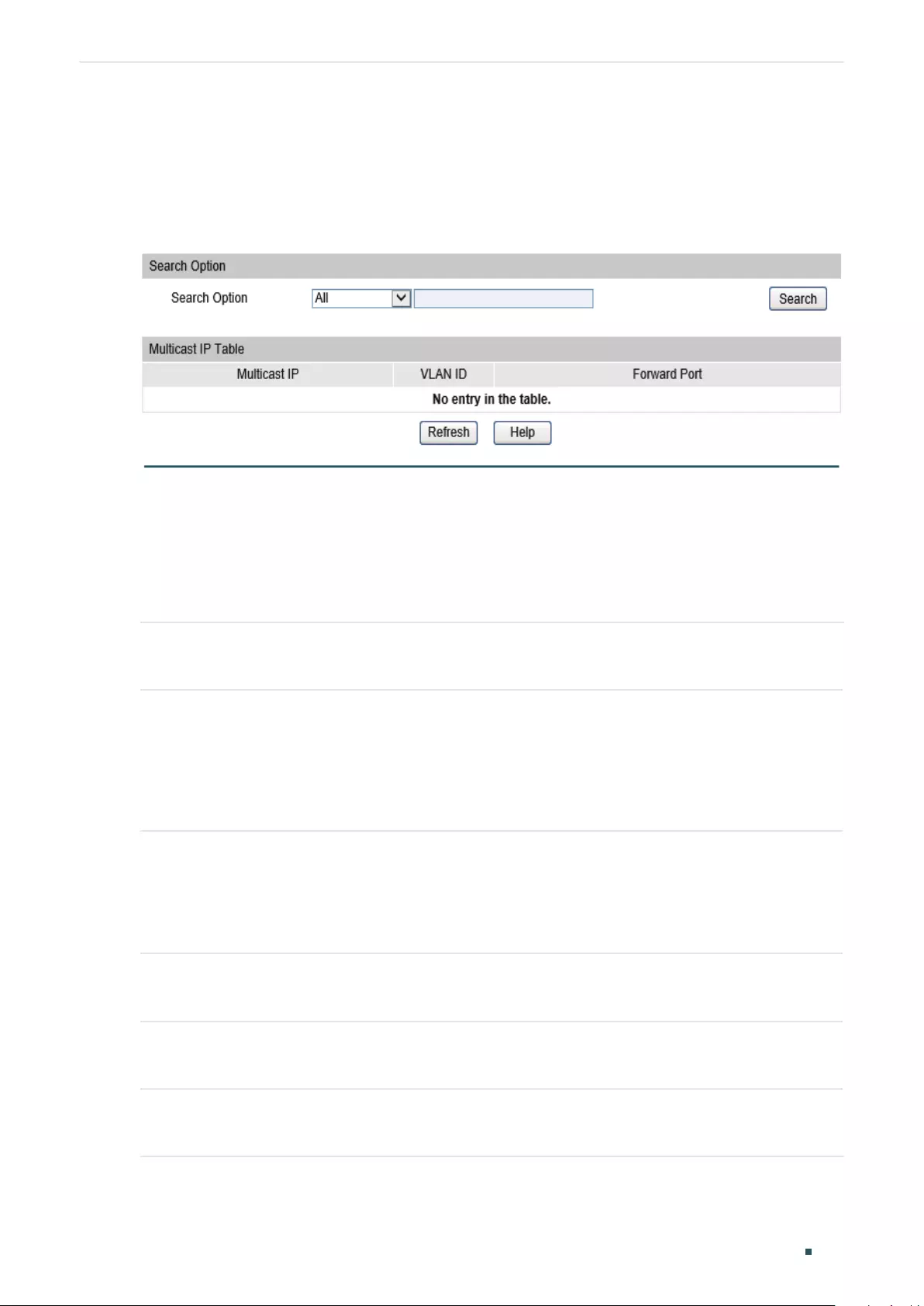
Configuring Layer 2 Multicast Viewing Multicast Snooping Configurations
Configuration Guide 475
4.1.1 Viewing IPv6 Multicast Snooping Configurations
Choose the menu Multicast > Multicast Table > IPv6 Multicast Table to view all valid
Multicast IP-VLAN-Port entries.
Figure 4-2 IPv6 Multicast Table
4.2 Using the CLI
4.2.1 Viewing IPv4 Multicast Snooping Configurations
show ip igmp snooping
Displays global settings of IGMP Snooping.
show ip igmp snooping interface [ fastEthernet [
port
|
port-list
] | gigabitEthernet [
port
|
port-list
] ] {basic-
config | max-groups | packet-stat}
Displays settings of IGMP Snooping on the port(s).
port
|
port-list
specifies the port(s) to display.
basic-config | max-groups | packet-stat
displays the related IGMP configuration information.
show ip igmp snooping interface [port-channel [
lagid
] ] {basic-config | max-groups}
Displays settings of IGMP Snooping on the port-channel.
lagid
specifies the LAG(s) to display.
basic-config | max-groups
displays the related IGMP configuration information.
show ip igmp snooping vlan [
vlan-id
]
Displays settings of IGMP Snooping in specific VLAN or all the VLANs.
show ip igmp snooping multi-vlan
Displays settings of IGMP Snooping in the multicast VLAN.
show ip igmp snooping groups vlan
vlan-id multicast_addr
Displays information of specific multicast group in the specific VLAN.

Configuration Guide 476
Configuring Layer 2 Multicast Viewing Multicast Snooping Configurations
show ip igmp snooping groups [ vlan
vlan-id
] [count | dynamic | dynamic count | static | static count ]
Displays information of specific multicast group in all VLANs or in the specific VLAN.
count: displays the number of multicast groups.
dynamic: displays information of all dynamic multicast groups.
dynamic count: displays the number of dynamic mu lticast groups.
static: displays information of all static multicast groups.
static count: displays the number of static multicast groups.
show ip igmp snooping querier [vlan
vlan-id
]
Displays information of IGMP Querier in all VLANs or in the specific VLAN.
show ip igmp profile [
id
]
Displays settings in all profiles or in the specific profile.
clear ip igmp snooping statistics
Clear all statistics of all IGMP packets.
4.2.2 Viewing IPv6 Multicast Snooping Configurations
show ipv6 mld snooping
Displays global settings of MLD Snooping.
show ipv6 mld snooping interface [ fastEthernet [
port
|
port-list
] | gigabitEthernet [
port
|
port-list
] ] {basic-
config | max-groups | packet-stat}
Displays settings of MLD Snooping on the port.
port
|
port-list:
specifies the port(s) to display.
basic-config | max-groups | packet-stat
displays the related MLD configuration information.
show ipv6 mld snooping interface [port-channel [
lagid
] ] {basic-config | max-groups}
Displays settings of MLD Snooping on the port-channel.
lagid:
specifies the LAG(s) to display.
basic-config | max-groups:
displays the related MLD configuration information.
show ipv6 mld snooping vlan [
vlan-id
]
Displays settings of MLD Snooping in specific VLAN or all the VLANs.
show ipv6 mld snooping multi-vlan
Displays settings of MLD Snooping in the multicast VLAN.
show ipv6 mld snooping groups vlan
vlan-id multicast_addr
Displays information of specific multicast group in the specific VLAN.

Configuring Layer 2 Multicast Viewing Multicast Snooping Configurations
Configuration Guide 477
show ipv6 mld snooping groups [vlan
vlan-id
] [count | dynamic | dynamic count | static | static count ]
Displays information of specific multicast group in all VLANs or in the specific VLAN.
count displays the number of multicast groups.
dynamic displays information of all dynamic multicast groups.
dynamic count displays the number of dynamic multicast groups.
static displays information of all static multicast groups.
static count displays the number of static multicast groups.
show ipv6 mld snooping querier [vlan
vlan-id
]
Displays information of MLD Querier in all VLANs or in the specific VLAN.
show ipv6 mld profile [
id
]
Displays settings in all profiles or in the specific profile.
clear ipv6 mld snooping statistics
Clear all statistics of all MLD packets.
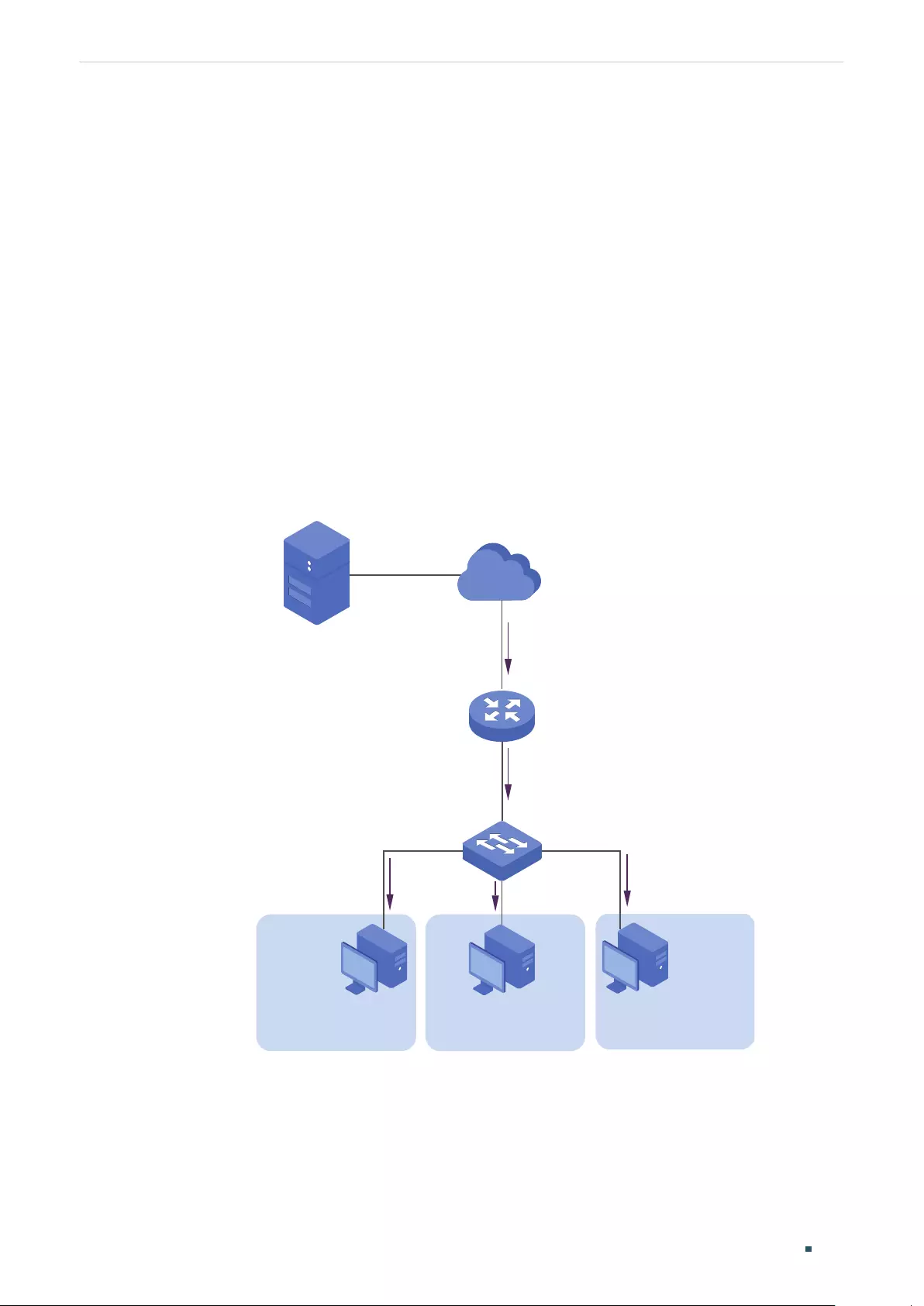
Configuration Guide 478
Configuring Layer 2 Multicast Configuration Examples
5 Configuration Examples
5.1 Example for Configuring Basic IGMP Snooping
5.1.1 Network Requirements
Host B, Host C and Host D are in the same VLAN of the switch. All of them want to receive
multicast data sent to multicast group 225.1.1.1.
As shown in the following topology, Host B, Host C and Host D are connected to port
1/0/1, port 1/0/2 and port 1/0/3 respectively. Port 1/0/4 is the router port connected to the
multicast querier.
Figure 5-1 Network Topology for Basic IGMP Snooping
Internet
Host B
Receiver
Host C
Receiver
Host D
Receiver
VLAN 10 VLAN 10 VLAN 10
Querier
Source
Gi1/0/4
Gi1/0/2
Gi1/0/3
Gi1/0/1
5.1.2 Configuration Scheme
Enable IGMP Snooping globally and on the port.
Add the three member ports and the router port to a VLAN and configure their PVIDs.
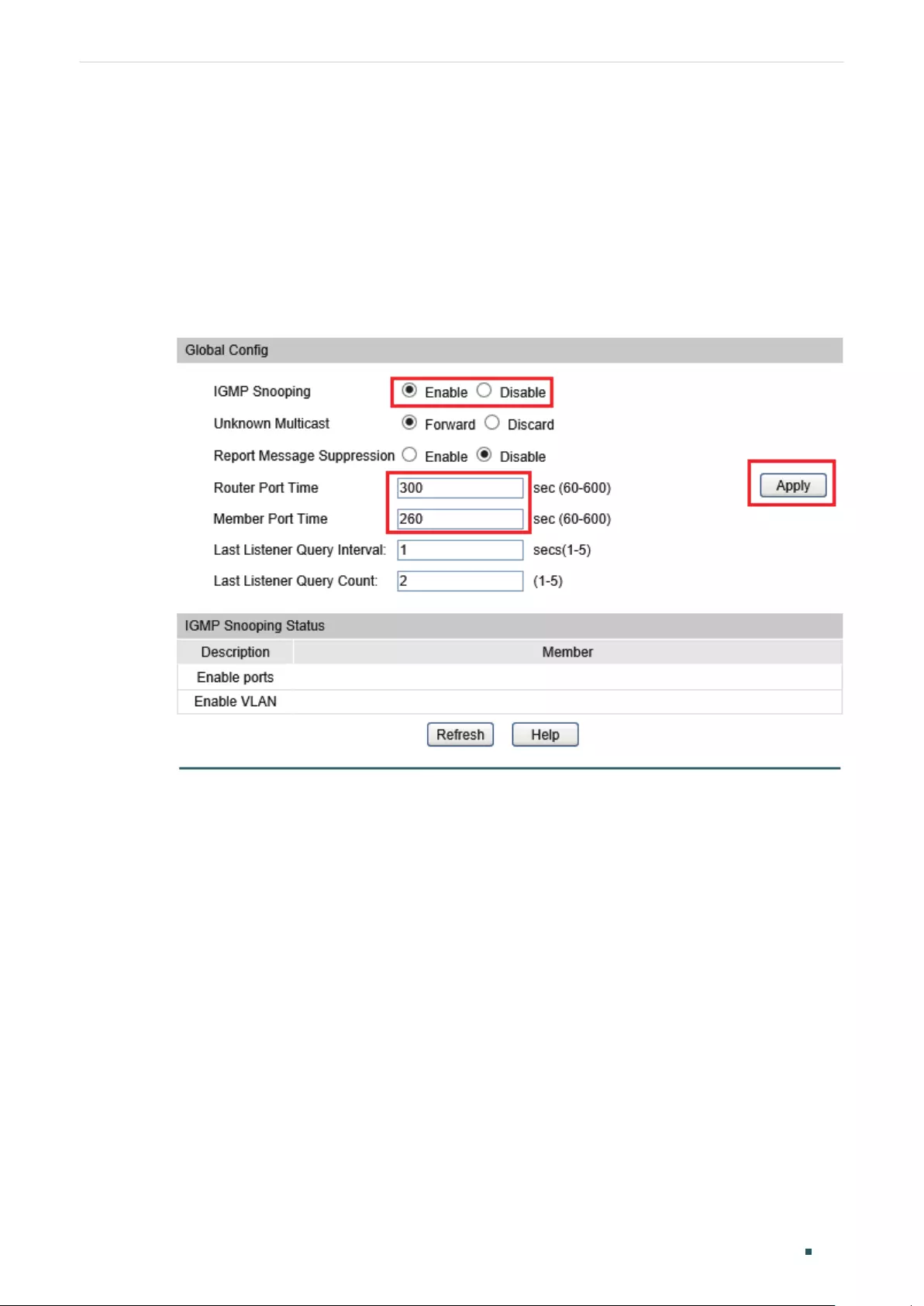
Configuring Layer 2 Multicast Configuration Examples
Configuration Guide 479
Enable IGMP Snooping in the VLAN. Demonstrated with T2600G-52TS, this section
provides configuration procedures in two ways: using the GUI and using the CLI.
5.1.3 Using the GUI
1) Choose the menu Multicast > IGMP Snooping > Snooping Config to load the following
page. Enable IGMP Snooping globally, and keep the default values in the Router Port
Time and Member Port Time fields.
Figure 5-2 Configure IGMP Snooping Globally
2) Choose the menu Multicast > IGMP Snooping > Snooping Config to load the following
page. Enable IGMP Snooping on port 1/0/1-4.
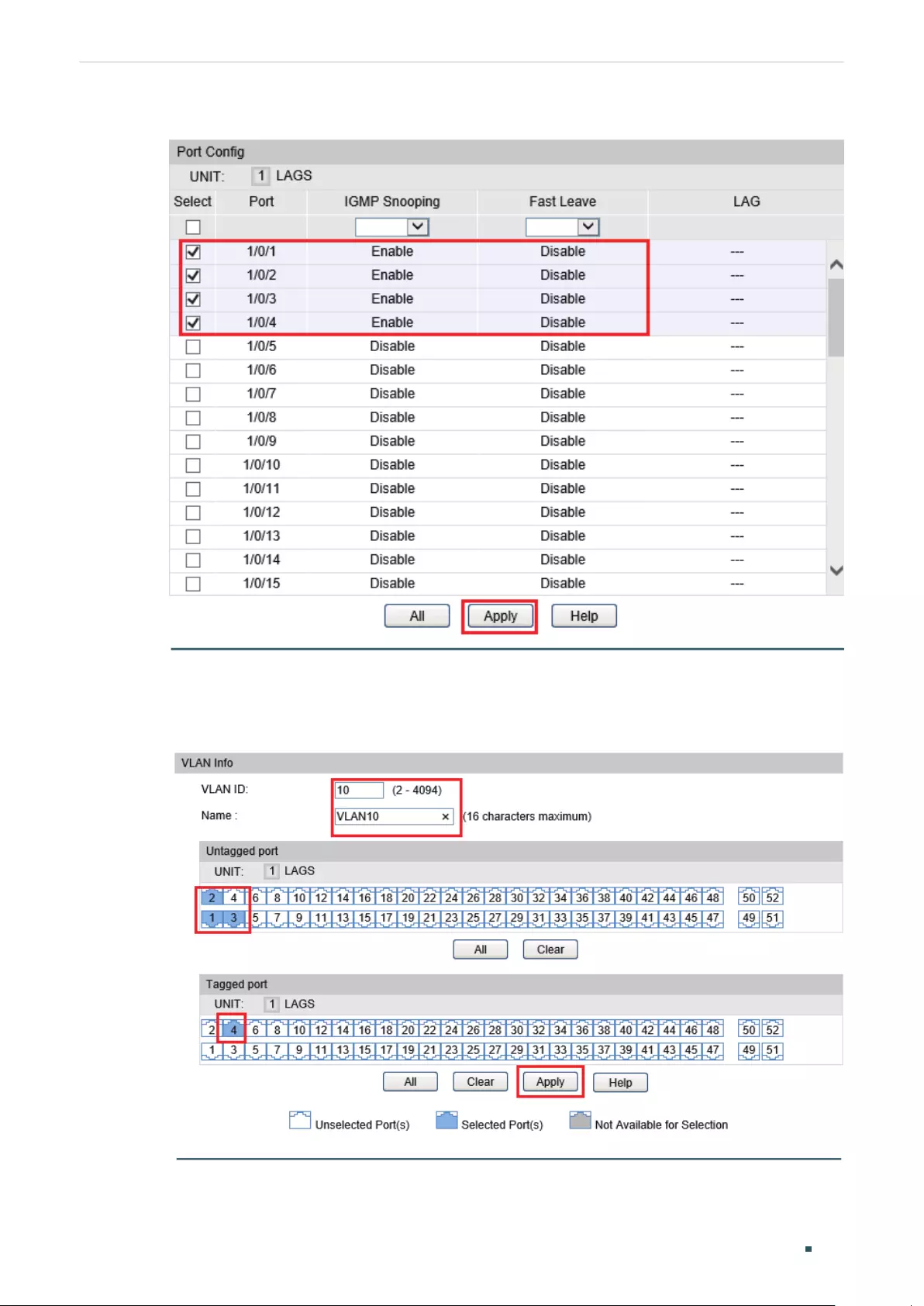
Configuration Guide 480
Configuring Layer 2 Multicast Configuration Examples
Figure 5-3 Enable IGMP Snooping on the Ports
3) Choose the menu VLAN > 802.1Q VLAN > VLAN Config to load the following page.
Create VLAN 10 and add Untagged port 1/0/1-3 and Tagged port 1/0/4 to VLAN 10.
Figure 5-4 Configure Link Type
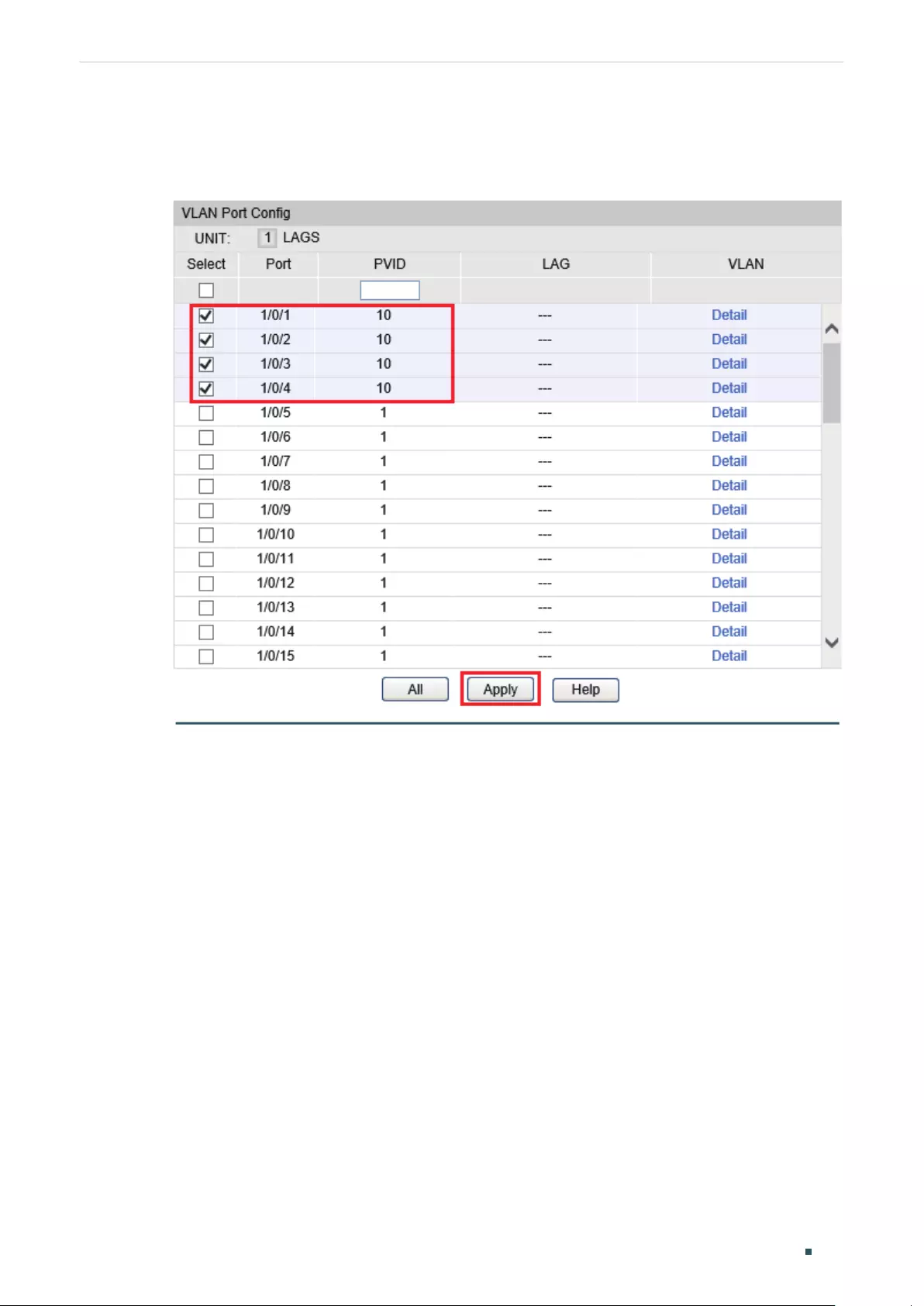
Configuring Layer 2 Multicast Configuration Examples
Configuration Guide 481
4) Choose the menu VLAN > 802.1Q VLAN > Port Config to load the following page.
Configure the PVID of port 1/0/1-4 as 10.
Figure 5-5 Create VLAN and Add Member Ports
5) Choose the menu Multicast > IGMP Snooping > VLAN Config to load the following
page. Enable IGMP Snooping in VLAN 10. Keep 0 as the Router Port Time and Member
Port Time, which means the global settings will be used.

Configuration Guide 482
Configuring Layer 2 Multicast Configuration Examples
Figure 5-6 Enable IGMP Snooping in the VLAN
6) Click Save Config to save the settings.
5.1.4 Using the CLI
1) Enable IGMP Snooping globally.
Switch#configure
Switch(config)#ip igmp snooping
2) Enable IGMP Snooping on port 1/0/1-4.
Switch(config)#interface range gigabitEthernet 1/0/1-4
Switch(config-if-range)#ip igmp snooping
Switch(config-if-range)#exit
3) Create VLAN 10.
Switch(config)#vlan 10
Switch(config-vlan)#name vlan10
Switch(config-vlan)#exit
4) Add port 1/0/1-3 to VLAN 10 and set the link type as untagged. Add port 1/0/4 to VLAN
10 and set the link type as tagged.
Switch(config)#interface range gigabitEthernet 1/0/1-3
Switch(config-if-range)#switchport general allowed vlan 10 untagged

Configuring Layer 2 Multicast Configuration Examples
Configuration Guide 483
Switch(config-if-range)#exit
Switch(config)#interface gigabitEthernet 1/0/4
Switch(config-if)#switchport general allowed vlan 10 tagged
Switch(config-if)#exit
5) Set the PVID of port 1/0/1-4 as 10.
Switch(config)#interface range gigabitEthernet 1/0/1-4
Switch(config-if-range)#switchport pvid 10
Switch(config-if-range)#exit
6) Enable IGMP Snooping in VLAN 10.
Switch(config)#ip igmp snooping vlan-config 10
7) Save the settings.
Switch(config)#end
Switch#copy running-config startup-config
Verify the Configurations
Show members in the VLAN:
Switch(config)#show vlan brief
VLAN Name Status Ports
----- -------------------- --------- ----------------------------------------
1 System-VLAN active Gi1/0/1, Gi1/0/2, Gi1/0/3, Gi1/0/4,
Gi1/0/5, Gi1/0/6, Gi1/0/7, Gi1/0/8,
...
10 vlan10 active Gi1/0/1, Gi1/0/2, Gi1/0/3, Gi1/0/4
Show status of IGMP Snooping globally, on the ports and in the VLAN:
Switch(config)#show ip igmp snooping
IGMP Snooping :Enable
Unknown Multicast :Pass
Last Query Times :2
Last Query Interval :1
Global Member Age Time :260
Global Router Age Time :300

Configuration Guide 484
Configuring Layer 2 Multicast Configuration Examples
Global Report Suppression :Disable
Global Authentication Accounting:Disable
Enable Port:Gi1/0/1-4
Enable VLAN:10
5.2 Example for Configuring Multicast VLAN
5.2.1 Network Requirements
Host B, Host C and Host D are in three different VLANs of the switch. All of them want to
receive multicast data sent to multicast group 225.1.1.1.
5.2.2 Configuration Scheme
Create a multicast VLAN and add the router port and ports connected to multicast
members to the multicast VLAN. In this case, all multicast data will only be processed in the
multicast VLAN.
5.2.3 Network Topology
As shown in the following network topology, Host B, Host C and Host D are connected to
port 1/0/1, port 1/0/2 and port 1/0/3 respectively. Port 1/0/1, port 1/0/2 and port 1/0/3
belong to VLAN 10, VLAN 20 and VLAN 30 respectively. Port 1/0/4 is connected to the
multicast network in the upper layer network. These 4 ports are all Untagged ports.
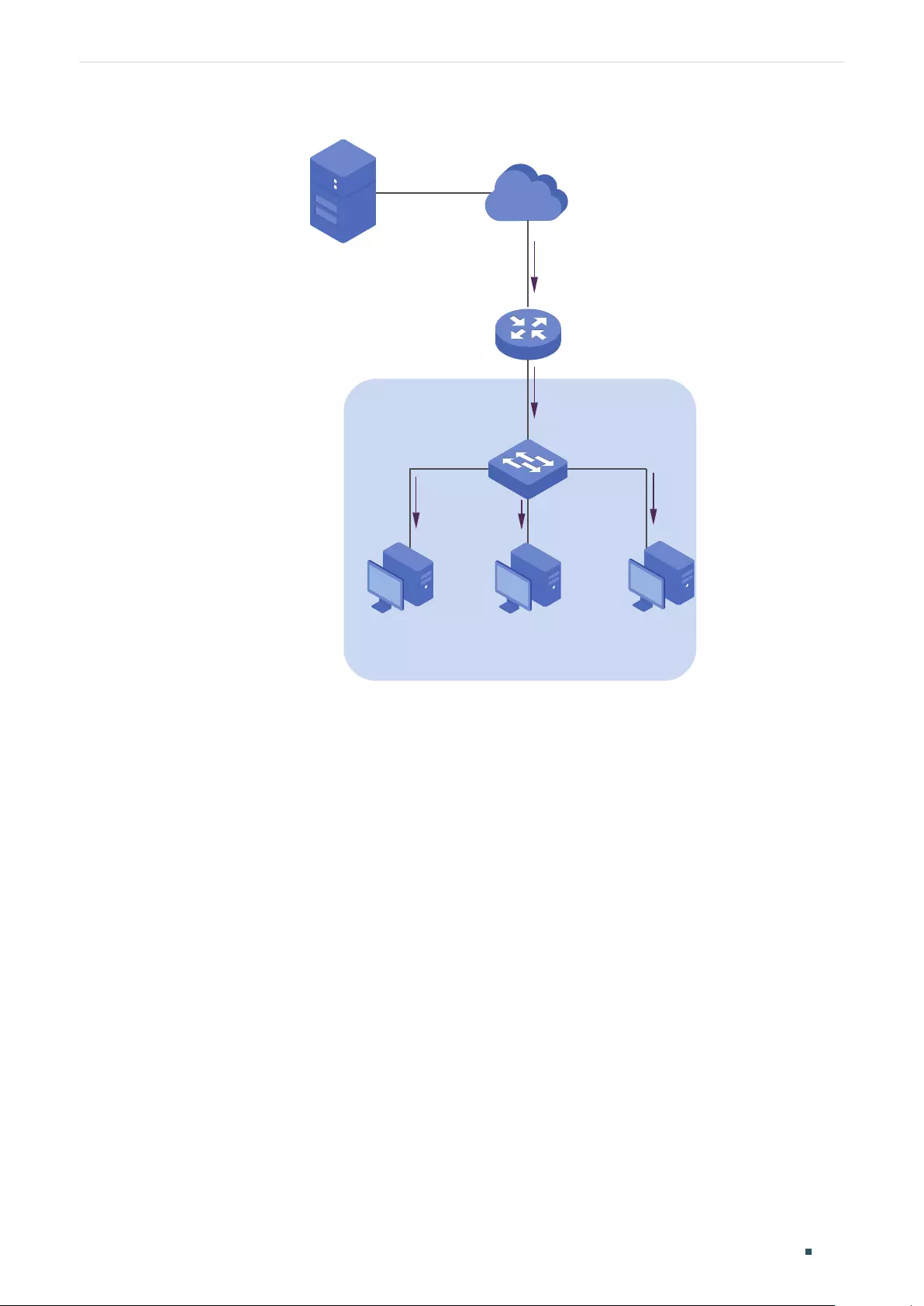
Configuring Layer 2 Multicast Configuration Examples
Configuration Guide 485
Figure 5-7 Network Topoloy for Multicast VLAN
Internet
Host B
Receiver
Host C
Receiver
Host D
Receiver
VLAN 40
Querier
Source
Gi1/0/4
Gi1/0/2
Gi1/0/3
Gi1/0/1
Demonstrated with T2600G-52TS, this section provides configuration procedures in two
ways: using the GUI and using the CLI.
5.2.4 Using the GUI
1) Choose the menu Multicast > IGMP Snooping > Snooping Config to load the following
page. Enable IGMP Snooping globally, and keep the default values in the Router Port
Time and Member Port Time fields.
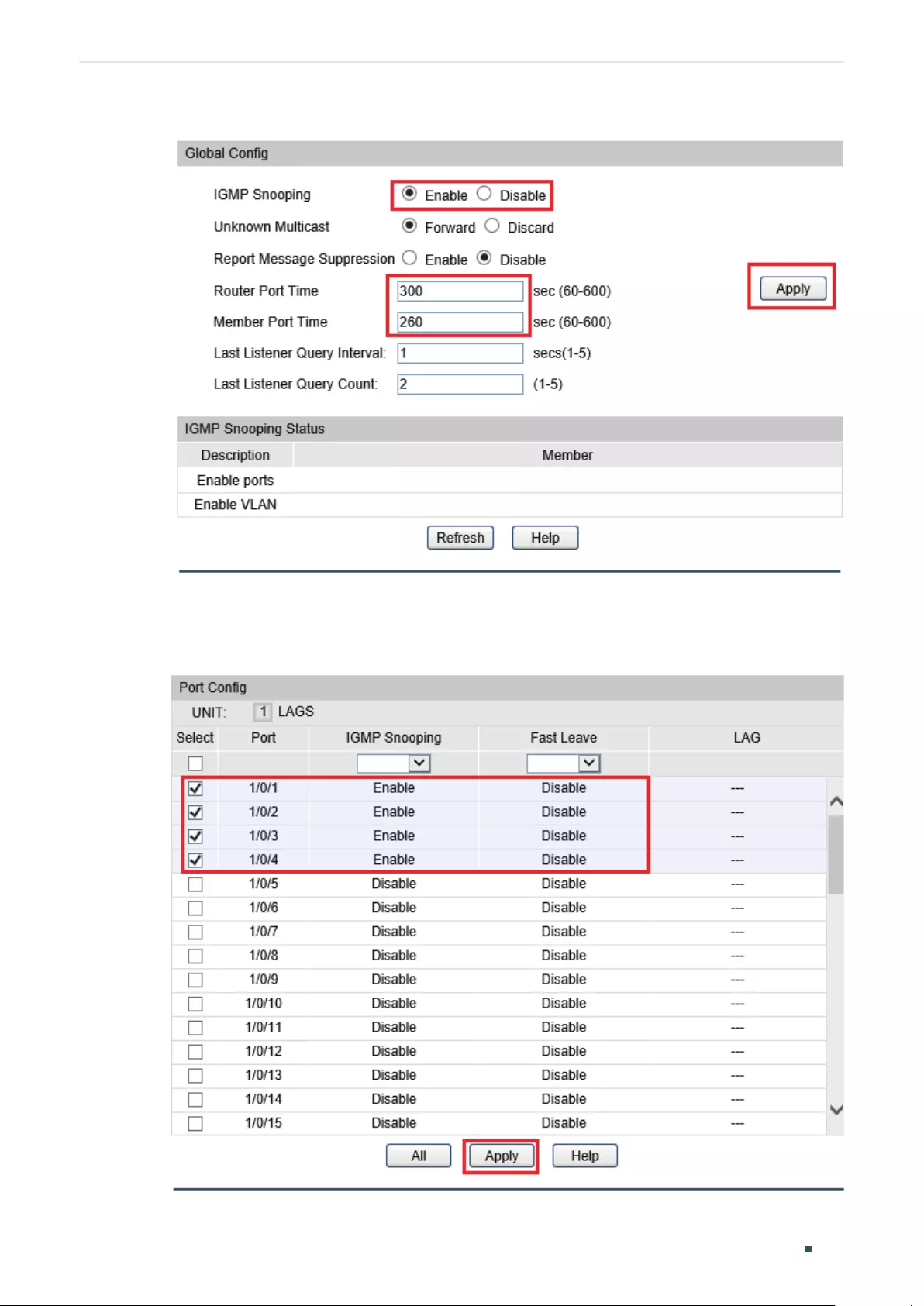
Configuration Guide 486
Configuring Layer 2 Multicast Configuration Examples
Figure 5-8 Configure IGMP Snooping Globally
2) Choose the menu Multicast > IGMP Snooping > Snooping Config to load the following
page. Enable IGMP Snooping on port 1/0/1-4.
Figure 5-9 Configure IGMP Snooping Globally
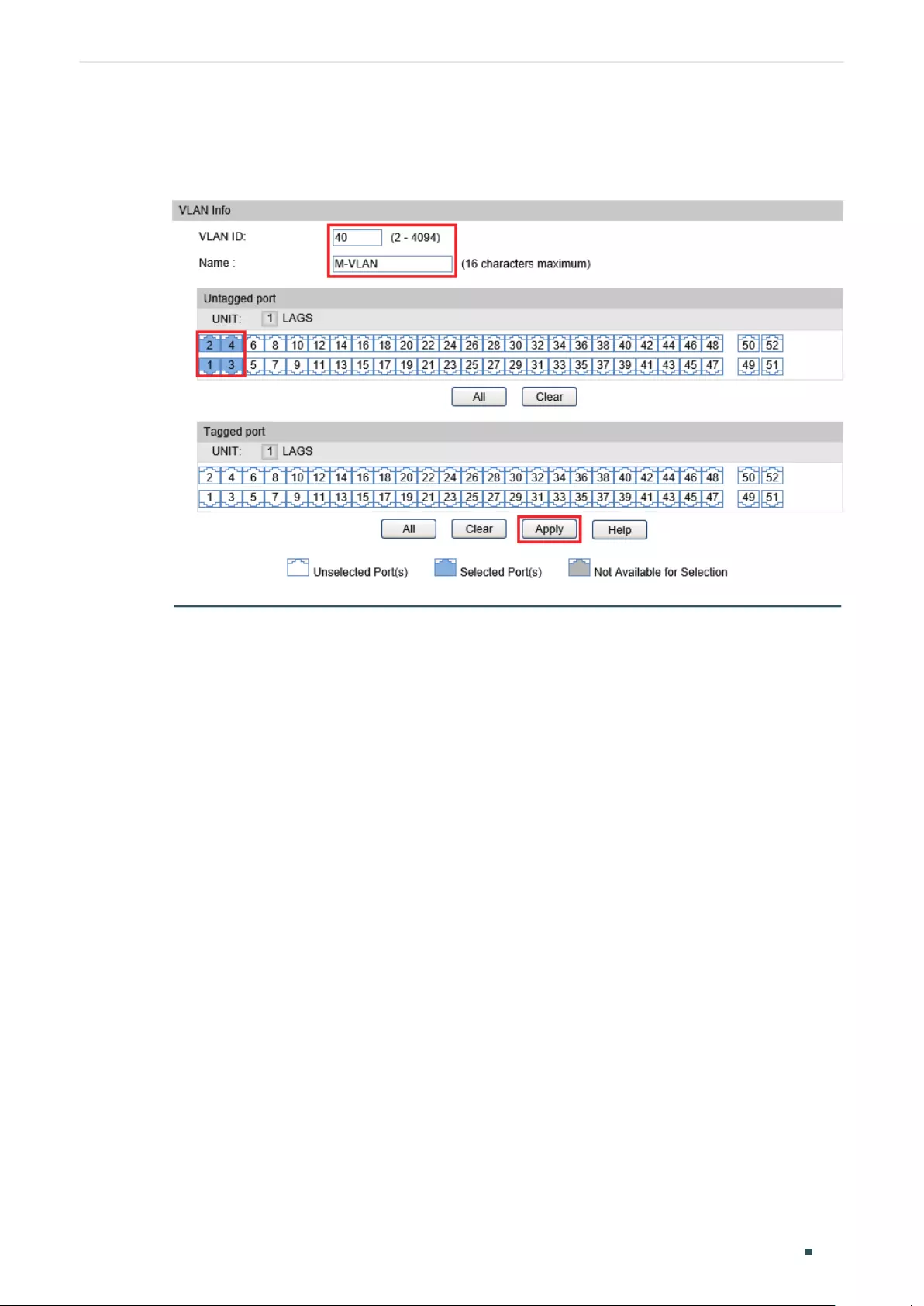
Configuring Layer 2 Multicast Configuration Examples
Configuration Guide 487
3) Choose the menu VLAN > 802.1Q VLAN > VLAN Config to load the following page.
Create VLAN 40 and add Untagged port 1/0/1-4 to VLAN 40.
Figure 5-10 Configure Link Type
4) Choose the menu VLAN > 802.1Q VLAN > Port Config to load the following page.
Configure the PVID of port 1/0/1 as 10, port 1/0/2 as 20, port 1/0/3 as 30 and port 1/0/4
as 40.
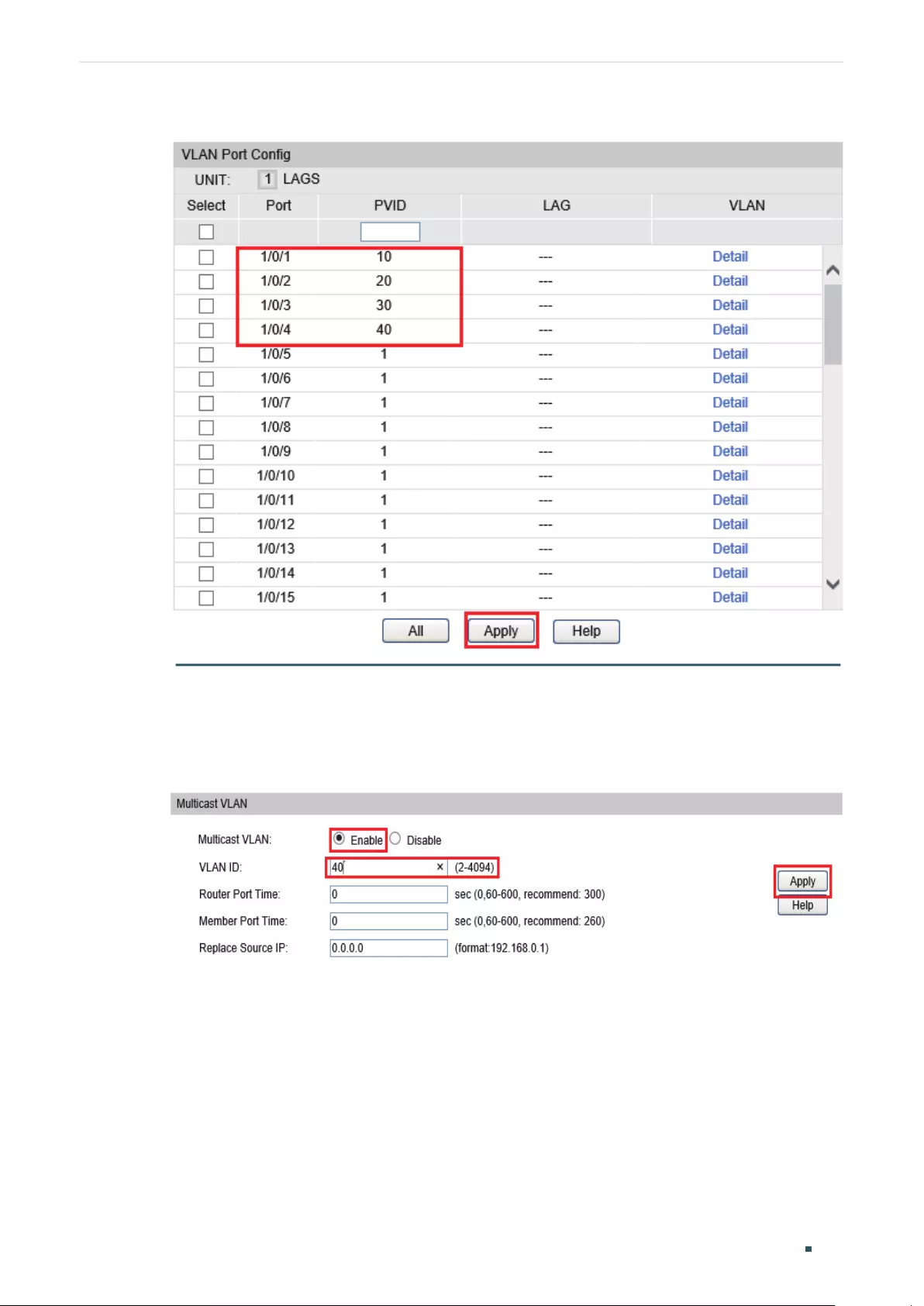
Configuration Guide 488
Configuring Layer 2 Multicast Configuration Examples
Figure 5-11 Create VLAN and Add Member Ports
5) Choose the menu Multicast > IGMP Snooping > Multicast VLAN to load the following
page. Enable Multicast VLAN and configure VLAN 40 as the multicast VLAN. Keep
Router Port Time and Member Port Time as 0.
Figure 5-12 Create Multicast VLAN
6) Click Save Config to save the settings.
5.2.5 Using the CLI
1) Enable IGMP Snooping Globally.
Switch#configure
Switch(config)#ip igmp snooping
2) Enable IGMP Snooping on port 1/0/1-4.

Configuring Layer 2 Multicast Configuration Examples
Configuration Guide 489
Switch(config)#interface range gigabitEthernet 1/0/1-4
Switch(config-if-range)#ip igmp snooping
Switch(config-if-range)#exit
3) Create VLAN 10.
Switch(config)#vlan 10
Switch(config-vlan)#name vlan10
Switch(config-vlan)#exit
4) Add port 1/0/1-3 to VLAN 10 and set the link type as untagged. Add port 1/0/4 to VLAN
10 and set the link type as tagged.
Switch(config)#interface range gigabitEthernet 1/0/1-3
Switch(config-if-range)#switchport general allowed vlan 10 untagged
Switch(config-if-range)#exit
Switch(config)#interface gigabitEthernet 1/0/4
Switch(config-if)#switchport general allowed vlan 10 tagged
Switch(config-if)#exit
5) Set the PVID of port 1/0/1-4 as 10.
Switch(config)#interface range gigabitEthernet 1/0/1-4
Switch(config-if-range)#switchport pvid 10
Switch(config-if-range)#exit
6) Enable Multicast VLAN and configure VLAN 10 as the multicast VLAN.
Switch(config)#ip igmp snooping multi-vlan-config 10
7) Save the settings.
Switch(config)#end
Switch#copy running-config startup-config
Verify the Configurations
Switch(config)#show vlan brief
VLAN Name Status Ports
----- ---------------- --------- ----------------------------------------
1 System-VLAN active Gi1/0/1, Gi1/0/2, Gi1/0/3, Gi1/0/4,
Gi1/0/5, Gi1/0/6, Gi1/0/7, Gi1/0/8,
......

Configuration Guide 490
Configuring Layer 2 Multicast Configuration Examples
10 vlan10 active Gi1/0/1, Gi1/0/2, Gi1/0/3, Gi1/0/4
Show status of IGMP Snooping globally, on the ports and in the multicast VLAN:
Switch(config)#show ip igmp snooping
IGMP Snooping :Enable
Unknown Multicast :Pass
Last Query Times :2
Last Query Interval :1
Global Member Age Time :260
Global Router Age Time :300
Global Report Suppression :Disable
Global Authentication Accounting:Disable
Enable Port:Gi1/0/1-4
Enable VLAN:Multicast VLAN 10
5.3 Example for Configuring Unknown Multicast and Fast Leave
5.3.1 Network Requirement
A user experiences lag when he is changing channel on his IPTV. He wants solutions to
this problem. As shown in the following network topology, port 1/0/4 on the switch is
connected to the upper layer network, and port 1/0/2 is connected to Host B.
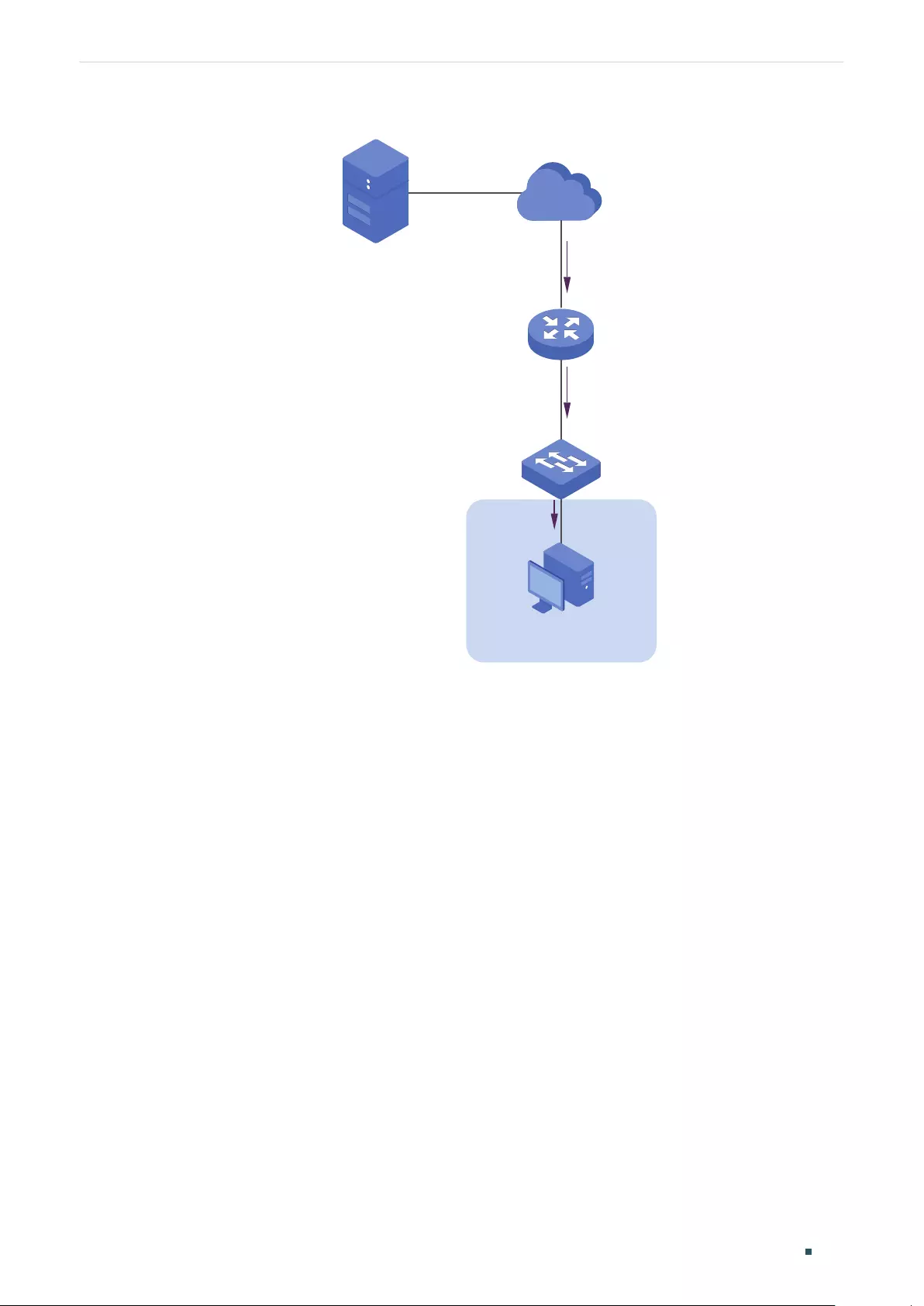
Configuring Layer 2 Multicast Configuration Examples
Configuration Guide 491
Figure 5-13 Network Topology for Unknow Multicast and Fast Leave
Internet
Host B
Receiver
VLAN 10
Querier
Source
Gi1/0/4
Gi1/0/2
5.3.2 Configuration Scheme
After the channel is changed, the client (Host B) still receives irrelevant multicast data,
the data from the previous channel and possibly other unknown multicast data, which
increases the network load and results in network congestion. The solution to this problem
is using Unknown Multicast and Fast Leave.
To avoid Host B from receiving irrelevant multicast data, the user can enable Fast Leave
on port 1/0/2 and enable Unknown Multicast globally. To change channel, Host B sends a
leave message about leaving the previous channel. The switch will then drop multicast data
from the previous channel and all unknown multicast data, which ensures that Host B only
receives multicast data from the new channel and that the multicast network is unimpeded.
Demonstrated with T2600G-52TS, this section provides configuration procedures in two
ways: using the GUI and using the CLI.
5.3.3 Using the GUI
1) Choose the menu Multicast > IGMP Snooping > Snooping Config to load the following
page. Enable IGMP Snooping globally and configure Unknown Multicast as Discard.
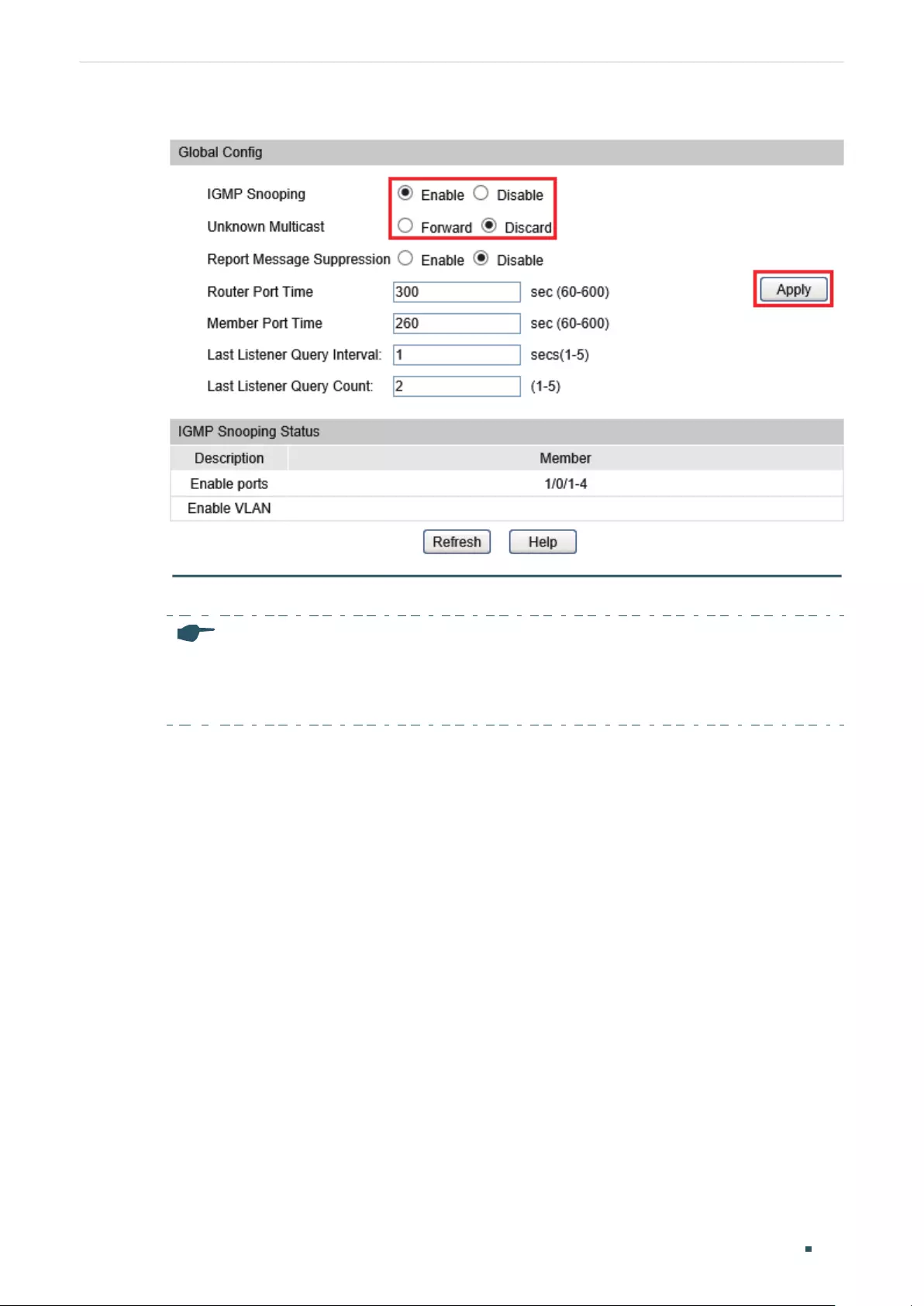
Configuration Guide 492
Configuring Layer 2 Multicast Configuration Examples
Figure 5-14 Configure IGMP Snooping Globally
Note:
IGMP Snooping and MLD Snooping share the setting of Unknown Multicast, so you have to
enable MLD Snooping globally on the Multicast > MLD Snooping > Snooping Config page at
the same time.
2) Choose the menu Multicast > IGMP Snooping > Port Config to load the following page.
Enable IGMP Snooping on port 1/0/2 and port 1/0/4 and enable Fast Leave on port
1/0/2.

Configuring Layer 2 Multicast Configuration Examples
Configuration Guide 493
Figure 5-15 Configure IGMP Snooping Globally
3) Choose the menu Multicast > IGMP Snooping > VLAN Config to load the following
page. Enable IGMP Snooping in VLAN 10.
Figure 5-16 Enable IGMP Snooping in the VLAN

Configuration Guide 494
Configuring Layer 2 Multicast Configuration Examples
4) Click Save Config to save the settings.
5.3.4 Using the CLI
1) Enable IGMP Snooping Globally.
Switch#configure
Switch(config)#ip igmp snooping
2) Configure Unknown Multicast as Discard globally.
Switch(config)#ip igmp snooping drop unknown
3) Enable IGMP Snooping on port 1/0/2 and enable Fast Leave. On port 1/0/4, enable IGMP
Snooping.
Switch(config)#interface gigabitEthernet 1/0/2
Switch(config-if)#ip igmp snooping
Switch(config-if)#ip igmp snooping immediate-leave
Switch(config-if)#exit
Switch(config)#interface gigabitEthernet 1/0/4
Switch(config-if)#ip igmp snooping
Switch(config-if)#exit
4) Enable IGMP Snooping in VLAN 10.
Switch(config)#ip igmp snooping vlan-config 10
5) Save the settings.
Switch(config)#end
Switch#copy running-config startup-config
Verify the Configurations
Show global settings of IGMP Snooping:
Switch(config)#show ip igmp snooping
IGMP Snooping :Enable
Unknown Multicast :Discard
Last Query Times :2
Last Query Interval :1
Global Member Age Time :260
Global Router Age Time :300

Configuring Layer 2 Multicast Configuration Examples
Configuration Guide 495
Global Report Suppression :Disable
Global Authentication Accounting:Disable
Enable Port:Gi1/0/2,1/0/4
Enable VLAN:10
Show settings of IGMP Snooping on port 1/0/2:
Switch(config)#show ip igmp snooping interface gigabitEthernet 1/0/2 basic-config
Port IGMP-Snooping Fast-Leave
---- ------------- ----------
Gi1/0/2 enable enable
5.4 Example for Configuring Multicast Filtering
5.4.1 Network Requirements
Host B, Host C and Host D are in the same subnet. Host C and Host D only receive multicast
data sent to 225.0.0.1, while Host B receives all multicast data except the one sent from
225.0.0.2.
5.4.2 Configuration Scheme
With the functions for managing multicast groups, whitelist and blacklist mechanism (profile
binding), the switch can only allow specific member ports to join specific multicast groups
or disallow specific member ports to join specific multicast groups. You can achieve this
filtering function by creating a profile and binding it to the corresponding member port.
5.4.3 Network Topology
As shown in the following network topology, Host B is connected to port 1/0/1, Host C is
connected to port 1/0/2 and Host D is connected to port 1/0/3. They are all in VLAN 10.

Configuration Guide 496
Configuring Layer 2 Multicast Configuration Examples
Figure 5-17 Network Topology for Multicast Filtering
Internet
Host B
Receiver
Host C
Receiver
Host D
Receiver
VLAN 10
Querier
Source
Gi1/0/4
Gi1/0/2
Gi1/0/3
Gi1/0/1
Demonstrated with T2600G-52TS, this section provides configuration procedures in two
ways: using the GUI and using the CLI.
5.4.4 Using the GUI
1) Choose the menu Multicast > IGMP Snooping > Snooping Config to load the following
page. Enable IGMP Snooping globally, and keep the default values in the Router Port
Time and Member Port Time fields.
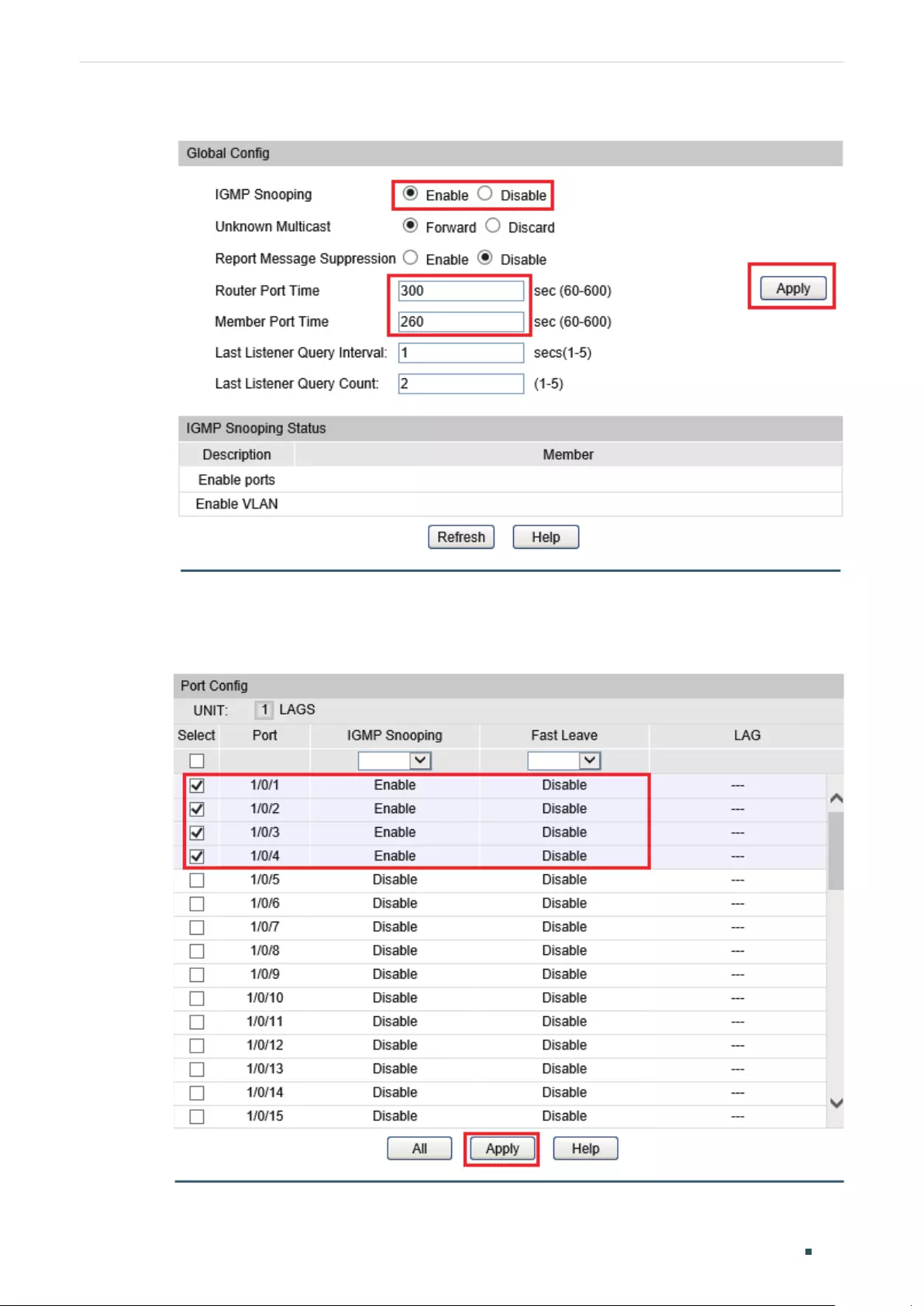
Configuring Layer 2 Multicast Configuration Examples
Configuration Guide 497
Figure 5-18 Configure IGMP Snooping Globally
2) Choose the menu Multicast > IGMP Snooping > Snooping Config to load the following
page.
Figure 5-19 Enable IGMP Snooping on the Port
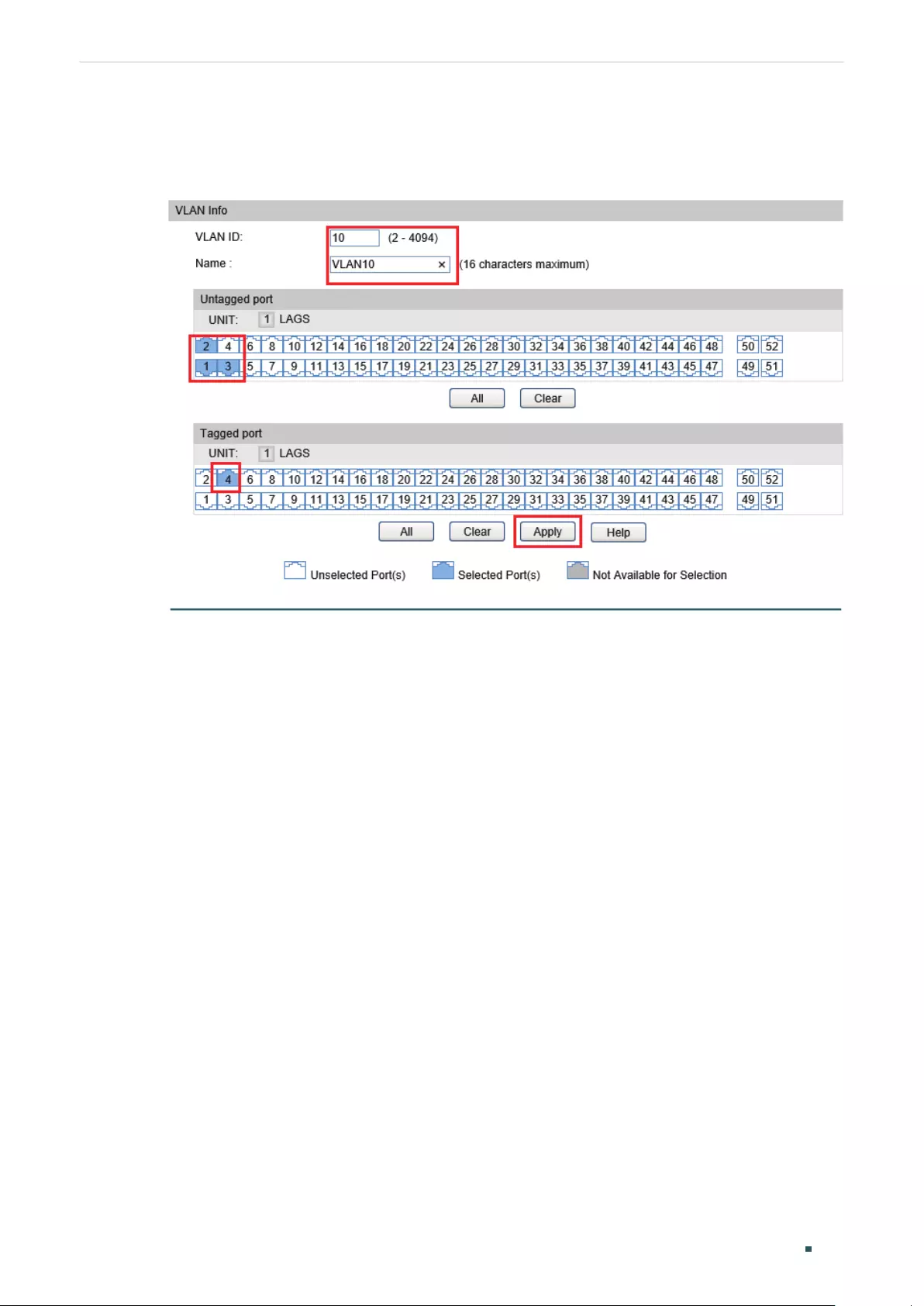
Configuration Guide 498
Configuring Layer 2 Multicast Configuration Examples
3) Choose the menu VLAN > 802.1Q VLAN > VLAN Config to load the following page.
Create VLAN 10 and add Untagged port 1/0/1-3 and Tagged port 1/0/4 to VLAN 10.
Figure 5-20 Configure Link Type
4) Choose the menu VLAN > 802.1Q VLAN > Port Config to load the following page.
Configure the PVID of port 1/0/1-4 as 10.
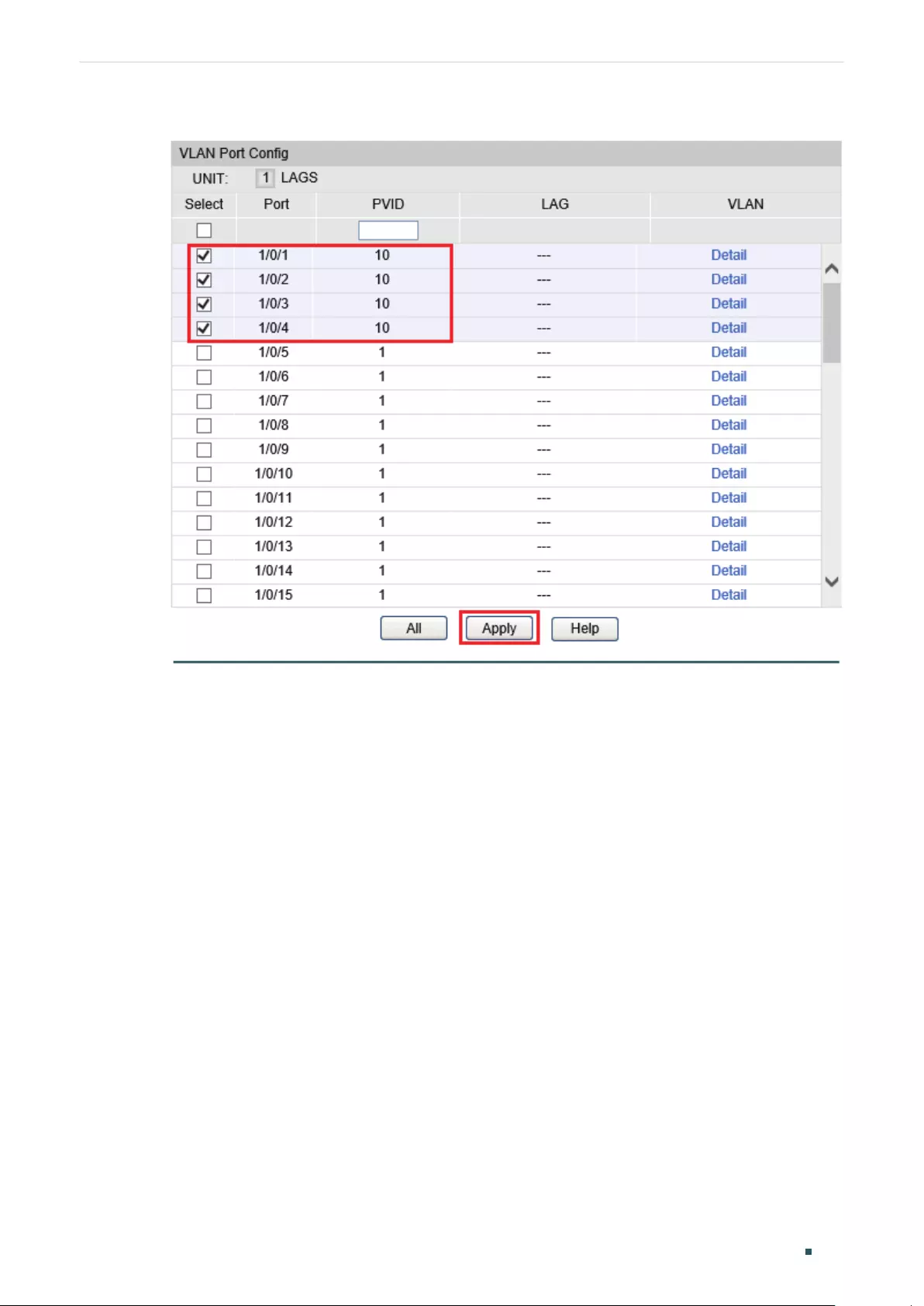
Configuring Layer 2 Multicast Configuration Examples
Configuration Guide 499
Figure 5-21 Create VLAN and Add Member Ports
5) Choose the menu Multicast > IGMP Snooping > VLAN Config to load the following
page. Enable IGMP Snooping in VLAN 10. Keep 0 as the Router Port Time and Member
Port Time, which means the global settings will be used.

Configuration Guide 500
Configuring Layer 2 Multicast Configuration Examples
Figure 5-22 Enable IGMP Snooping in the VLAN
6) Specify the multicast data that Host C and Host D can receive.
a. Choose the menu Multicast > IGMP Snooping > Profile Config to load the following
page. Create Profile 1, select Permit as the Mode and click Create.
Figure 5-23 Create Profile 1
b. Choose the menu Multicast > IGMP Snooping > Profile Config to load the following
page.
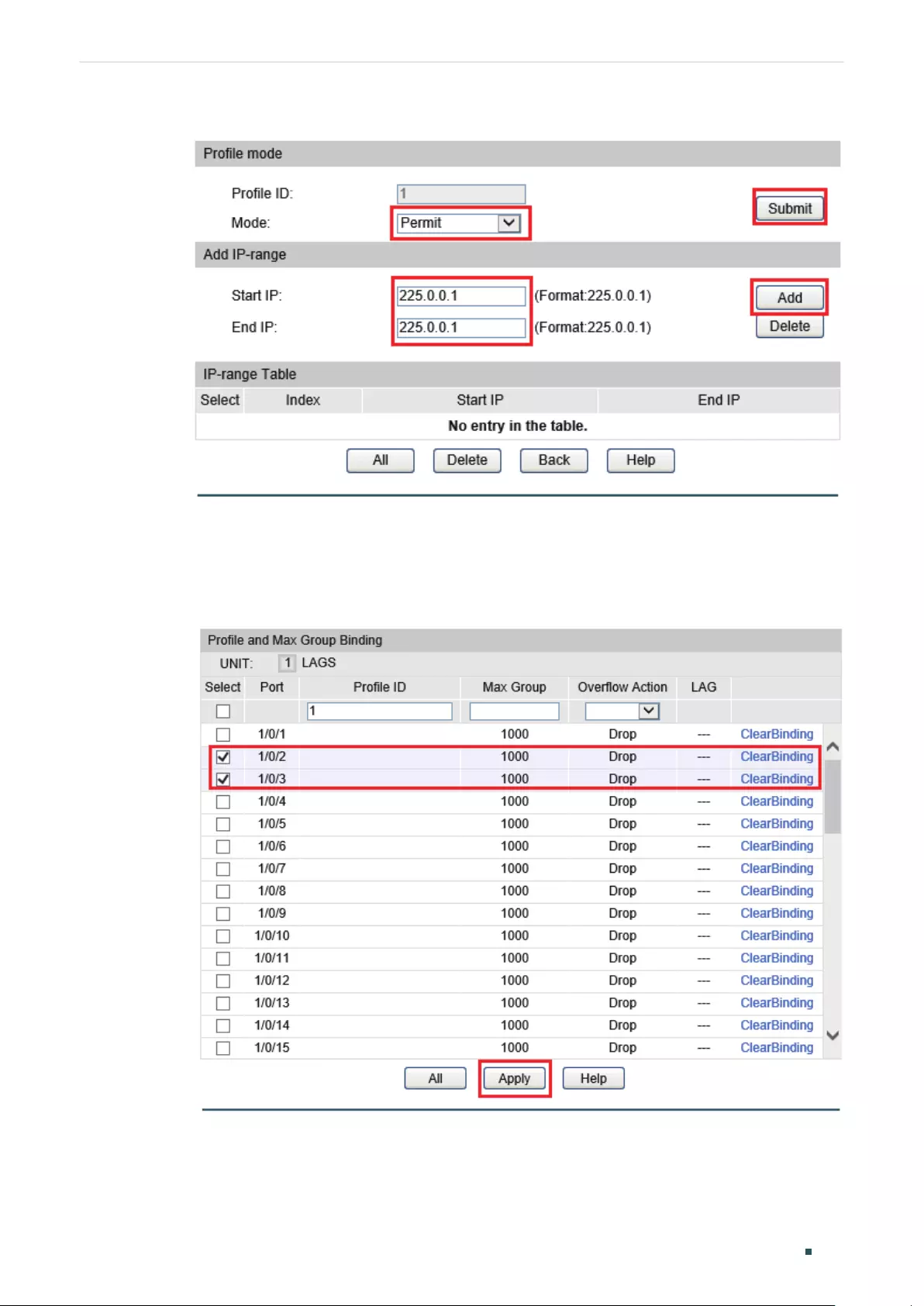
Configuring Layer 2 Multicast Configuration Examples
Configuration Guide 501
Figure 5-24 Edit Add IP-range in Profile 1
c. Choose the menu Multicast > IGMP Snooping > Profile Binding to load the
following page. Select port 1/0/2 and port 1/0/3, enter 1 in the Profile ID field and
click Apply to bind Profile 1 to these ports.
Figure 5-25 Bind Profile 1 to Port 1/0/2 and Port 1/0/3
7) Specify the multicast data that Host B can receive
a. Choose the menu Multicast > IGMP Snooping > Profile Config to load the following
page. Create Profile 2, select Deny as the Mode and click Create.

Configuration Guide 502
Configuring Layer 2 Multicast Configuration Examples
Figure 5-26 Profile 2
b. Choose the menu Multicast > IGMP Snooping > Profile Config to load the following
page. In the IGMP Profile Info table, click Edit in the Profile 2 entry, enter 225.0.0.2 in
both Start IP and End IP fields, and click Add.
Figure 5-27 Edit Add IP-range in Profile 2
c. Choose the menu Multicast > IGMP Snooping > Profile Binding to load the
following page. Select port 1/0/1, enter 2 in the Profile ID field and click Apply to bind
Profile 2 to this port.

Configuring Layer 2 Multicast Configuration Examples
Configuration Guide 503
Figure 5-28 Bind Profile 2 to Port 1/0/1
8) Click Save Config to save the settings.
5.4.5 Using the CLI
1) Enable IGMP Snooping Globally.
Switch#configure
Switch(config)#ip igmp snooping
2) Enable IGMP Snooping on port 1/0/1-4.
Switch(config)#interface range gigabitEthernet 1/0/1-4
Switch(config-if-range)#ip igmp snooping
Switch(config-if-range)#exit
3) Create VLAN 10.
Switch(config)#vlan 10
Switch(config-vlan)#name vlan10
Switch(config-vlan)#exit
4) Add port 1/0/1-3 to VLAN 10 and set the link type as untagged. Add port 1/0/4 to VLAN
10 and set the link type as tagged.
Switch(config)#interface range gigabitEthernet 1/0/1-3

Configuration Guide 504
Configuring Layer 2 Multicast Configuration Examples
Switch(config-if-range)#switchport general allowed vlan 10 untagged
Switch(config-if-range)#exit
Switch(config)#interface gigabitEthernet 1/0/4
Switch(config-if)#switchport general allowed vlan 10 tagged
Switch(config-if)#exit
5) Set the PVID of port 1/0/1-4 as 10.
Switch(config)#interface range gigabitEthernet 1/0/1-4
Switch(config-if-range)#switchport pvid 10
Switch(config-if-range)#exit
6) Enable IGMP Snooping in VLAN 10.
Switch(config)#ip igmp snooping vlan-config 10
Switch(config-if)#exit
7) Create Profile 1, configure the mode as permit, and add an IP range with both start IP
and end IP being 225.0.0.1.
Switch(config)#ip igmp profile 1
Switch(config-igmp-profile)#permit
Switch(config-igmp-profile)#range 225.0.0.1 225.0.0.1
Switch(config-igmp-profile)#exit
8) Bind Profile 1 to Port 1/0/2 and Port 1/10/3.
Switch(config)#interface range gigabitEthernet 1/0/2-3
Switch(config-if-range)#ip igmp filter 1
Switch(config-if-range)#exit
9) Create Profile 2, configure the mode as deny, and add an IP range with both start IP and
end IP being 225.0.0.2.
Switch(config)#ip igmp profile 2
Switch(config-igmp-profile)#deny
Switch(config-igmp-profile)#range 225.0.0.2 225.0.0.2
Switch(config-igmp-profile)#exit
10) Bind Profile 2 to Port 1/0/1.
Switch(config)#interface gigabitEthernet 1/0/1
Switch(config-if)#ip igmp filter 2
Switch(config-if)#exit

Configuration Guide 505
Configuring Layer 2 Multicast Configuration Examples
11) Save the settings.
Switch(config)#end
Switch#copy running-config startup-config
Verify the Configurations
Show global settings of IGMP Snooping:
Switch(config)#show ip igmp snooping
IGMP Snooping :Enable
Unknown Multicast :Pass
Last Query Times :2
Last Query Interval :1
Global Member Age Time :260
Global Router Age Time :300
Global Report Suppression :Disable
Global Authentication Accounting:Disable
Enable Port:Gi1/0/1-4
Enable VLAN:10
Show all profile bindings:
Switch(config)#show ip igmp profile
IGMP Profile 1
permit
range 225.0.0.1 225.0.0.1
Binding Port(s)
Gi1/0/2-3
IGMP Profile 2
deny
range 225.0.0.2 225.0.0.2
Binding Port(s)
Gi1/0/1

Configuring Layer 2 Multicast Appendix: Default Parameters
Configuration Guide 506
6 Appendix: Default Parameters
6.1 Default Parameters for IGMP Snooping
Table 6-1 Default Parameters of IGMP Snooping
Function Parameter Default Setting
Global Settings of IGMP
Snooping
IGMP Snooping Disabled
Unknown Multicast Forward
Report Message Suppression Disabled
Router Port Time 300 seconds
Member Port Time 260 seconds
Last Listener Query Interval 1 second
Last Listener Query Count 2
IGMP Snooping Settings on
the Port
IGMP Snooping Disabled
Fast Leave Disabled
IGMP Snooping Settings in the
VLAN
Enable or Not Disabled
Router Port Time 0, use global settings.
Member Port Time 0, use global settings.
Multicast VLAN
Multicast VLAN None
Router Port Time 0, use global settings.
Member Port Time 0, use global settings.
Replace Source IP 0.0.0.0, indicating no
replacement.
IGMP Snooping Querier
Enable or Not Disabled
Query Interval 60 seconds
Max Response Time 10 seconds
General Query Source IP 192.168.0.1

Configuring Layer 2 Multicast Appendix: Default Parameters
Configuration Guide 507
Function Parameter Default Setting
IGMP Accounting and
Authentication
Global Settings of IGMP Accounting Disabled
IGMP Authentication Disabled
6.2 Default Parameters for MLD Snooping
Table 6-2 Default Parameters of MLD Snooping
Function Parameter Default Setting
Global Settings of IGMP
Snooping
MLD Snooping Disabled
Unknown Multicast Forward
Report Message Suppression Disabled
Router Port Time 300 seconds
Member Port Time 260 seconds
Last Listener Query Interval 1 second
Last Listener Query Count 2
MLD Snooping on the Port
MLD Snooping Disabled
Fast Leave Disabled
MLD Snooping in the VLAN
Enable or Not Disabled
Router Port Time 0, use global settings.
Member Port Time 0, use global settings.
Multicast VLAN
Multicast VLAN None
Router Port Time 0, use global settings.
Member Port Time 0, use global settings.
Replace Source IP ::, indicating no replacement.

Configuration Guide 508
Configuring Layer 2 Multicast Appendix: Default Parameters
Function Parameter Default Setting
IGMP Snooping Querier
Enable or Not Disabled
Query Interval 60 seconds
Max Response Time 10 seconds
General Query Source IP FE80::02FF:FFFF:FE00:0001

Configuration Guide 510
Configuring Logical Interfaces Overview
1 Overview
Interfaces of a device are used to exchange data and interact with interfaces of other
network devices. Interfaces are classified into physical interfaces and logical interfaces.
Physical interfaces are the ports on the front panel or rear panel of the switch.
Logical interfaces are manually configured and do not physically exist, such as
loopback interfaces and routing interfaces.
This chapter introduces the configurations for logical interfaces. The supported types of
logical interfaces are shown as below:
Table 1-1 Supported Types of Logical Interfaces
Type Description
VLAN Interface A Layer 3 interface with which different VLANs can communicate with each
other.
Loopback Interface An interface of which the status is always up.
Routed Port A physical port configured as a Layer 3 port.
Port-channel Interface Several Ethernet ports bound together and configured as a Layer 3
interface.
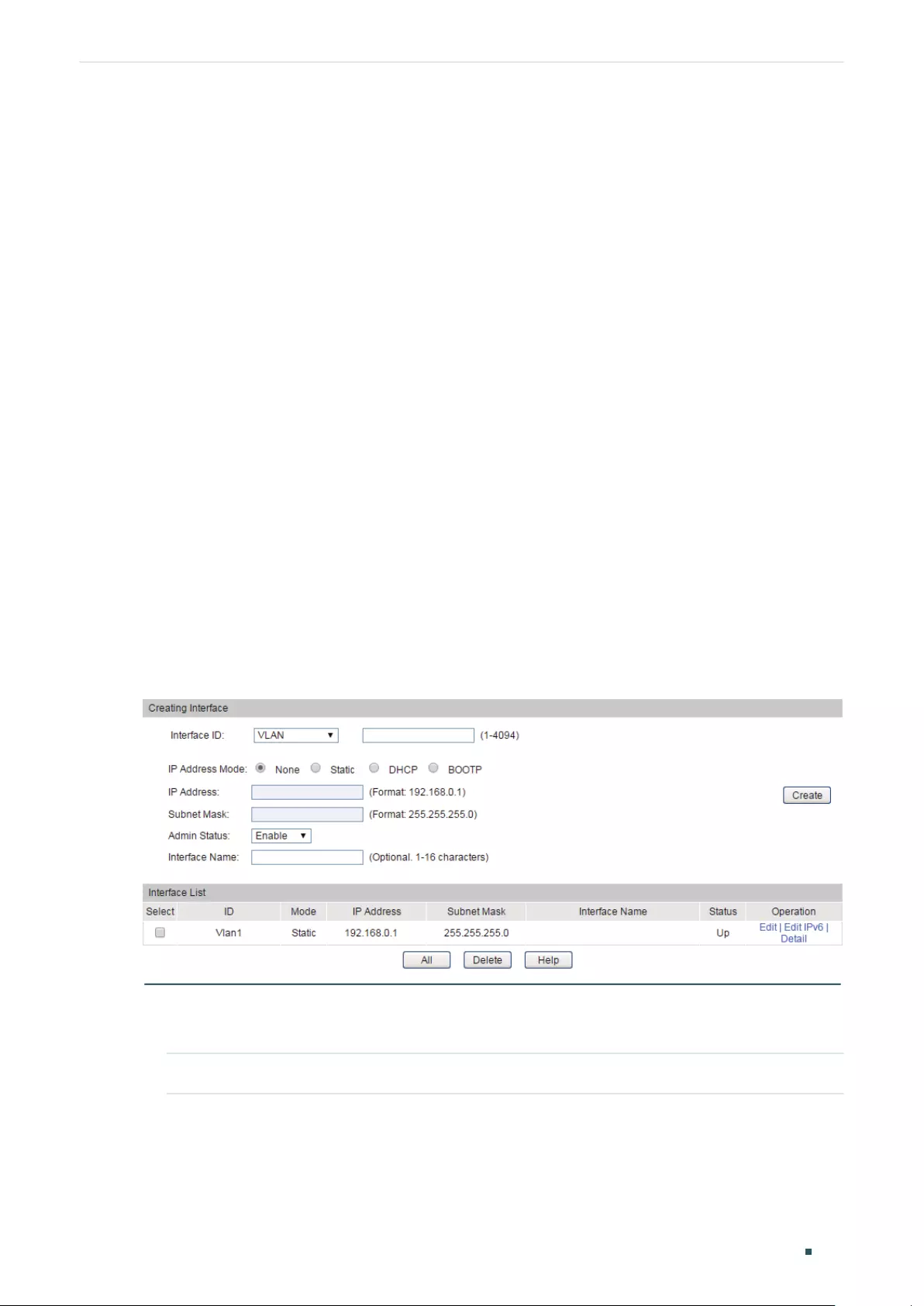
Configuring Logical Interfaces Logical Interfaces Configurations
Configuration Guide 511
2 Logical Interfaces Configurations
To complete IPv4 interface configuration, follow these steps:
1) Create a Layer 3 interface
2) Configure IPv4 parameters of the created interface
3) View detailed information of the created interface
To complete IPv6 interface configuration, follow these steps:
1) Create a Layer 3 interface
2) Configure IPv6 parameters of the created interface
3) View detailed information of the created interface
2.1 Using the GUI
2.1.1 Creating a Layer 3 Interface
Choose the menu Routing> Interface > Interface Config to load the following page.
Figure 2-1 Creating a Layer 3 Interface
1) In the Creating Interface section, specify an interface ID and configure relevant
parameters for the interface according to your needs. Then click Create.
Interface ID Select an interface type and enter the ID of the interface.
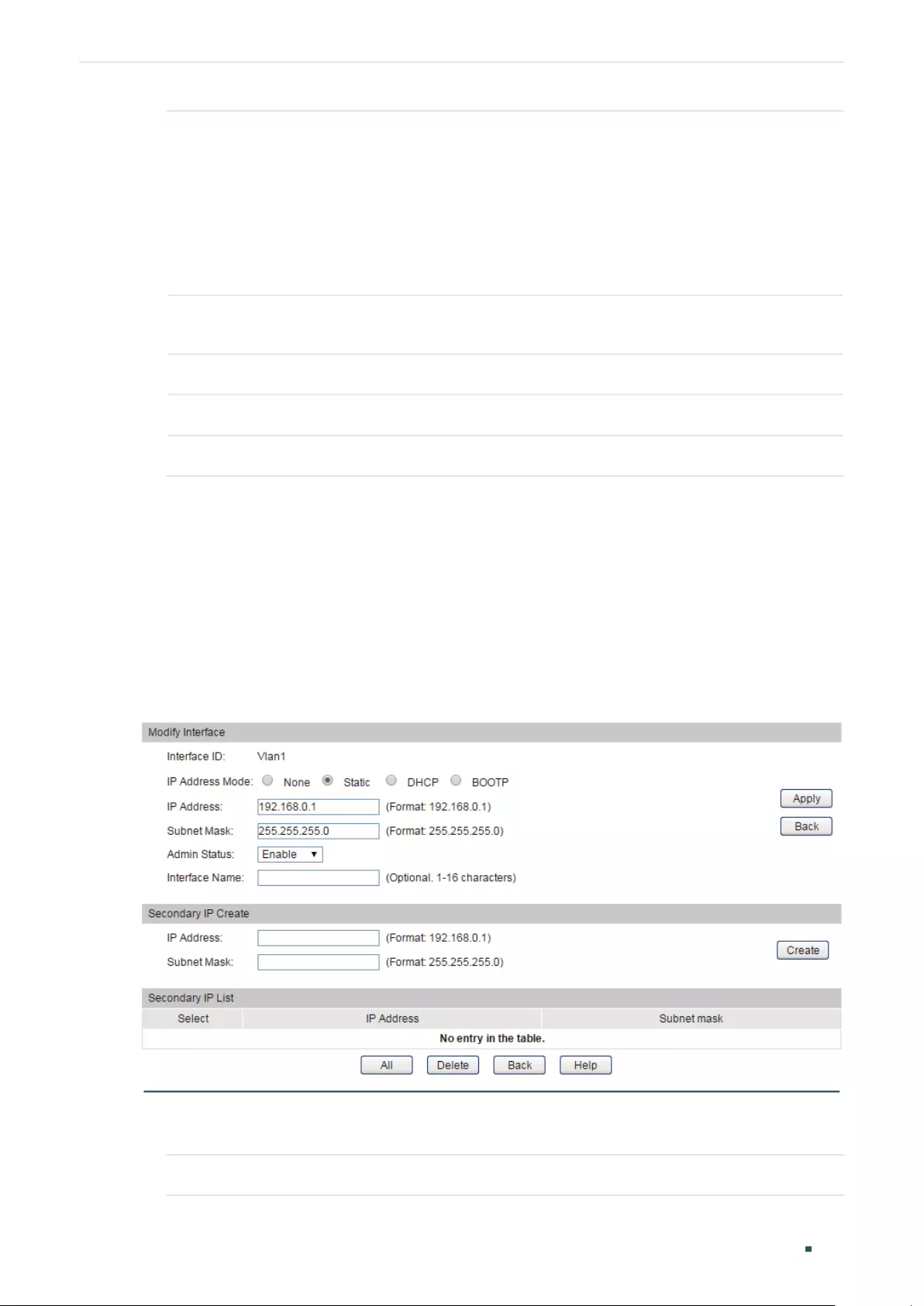
Configuration Guide 512
Configuring Logical Interfaces Logical Interfaces Configurations
IP Address Mode Specify the IP address assignment mode of the interface.
None: No IP address will be assigned.
Static: Assign an IP address manually.
DHCP: Assign an IP address through DHCP .
BOOTP: Assign an IP address through BOOTP.
IP Address Specify the IP address of the interface if you choose “Static” as the IP address
assignment mode.
Subnet Mask Specify the subnet mask of the interface’s IP address.
Admin Status Enable or disable the interface’s Layer 3 capabilities.
Interface Name (Optional) Enter the name of the interface.
2) In the Interface List section, you can view the corresponding interface entry you
create.
2.1.2 Configuring IPv4 Parameters of the Interface
In Figure 2-1 you can view the corresponding interface entry you create in the Interface
List section. On the corresponding interface entry, click Edit to load the following page and
configure the IPv4 parameters of the interface.
Figure 2-2 Configuring the IPv4 Parameters
1) In the Modify Interface section, specify an interface ID and configure relevant
parameters for the interface according to your actual needs. Then click Apply.
Interface ID Select an interface type and enter the ID of the interface.

Configuring Logical Interfaces Logical Interfaces Configurations
Configuration Guide 513
IP Address Mode Specify the IP address assignment mode of the interface.
None: No IP address will be assigned.
Static: Assign an IP address manually.
DHCP: Assign an IP address through DHCP .
BOOTP: Assign an IP address through BOOTP.
IP Address Specify the IP address of the interface if you choose “Static” as the IP address
assignment mode.
Subnet Mask Specify the subnet mask of the interface’s IP address.
Admin Status Enable or disable the interface’s Layer 3 capabilities.
Interface Name (Optional) Enter the name of the interface.
2) In the Secondary IP Create section, configure the secondary IP for the specified
interface which allows you to have two logical subnets using one physical subnet. Then
click Create.
3) In the Secondary IP List section, you can view the corresponding secondary IP entry
you create.
2.1.3 Configuring IPv6 Parameters of the Interface
In Figure 2-1, you can view the corresponding interface entry you create in the Interface
List section. On the corresponding interface entry, click Edit IPv6 to load the following
page and configure the IPv6 parameters of the interface.
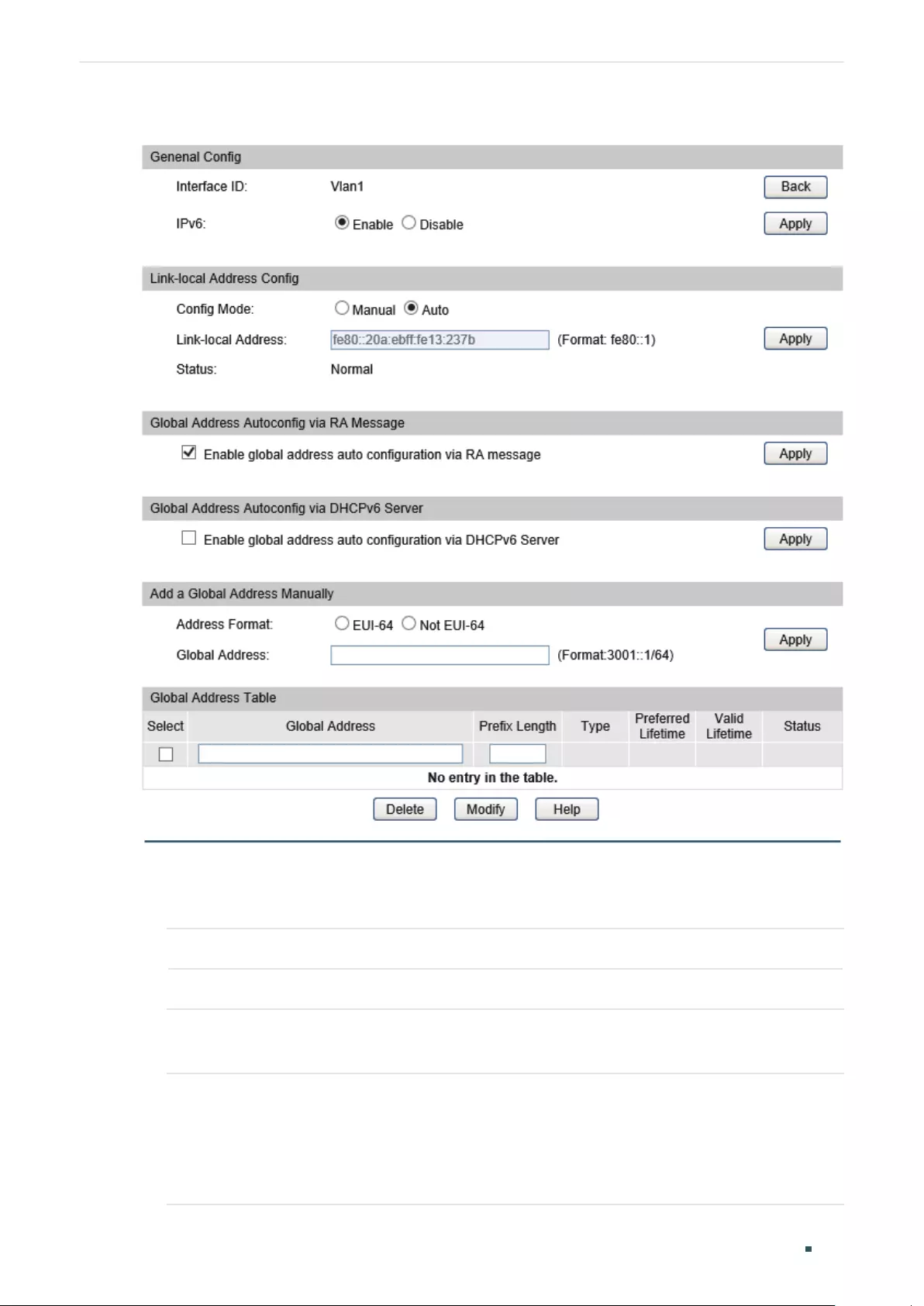
Configuration Guide 514
Configuring Logical Interfaces Logical Interfaces Configurations
Figure 2-3 Configuring the IPv6 Parameters
1) Enable IPv6 function on the interface of switch in the General Config section. Then
click Apply.
Interface ID Displays the interface ID.
IPv6 Enable or disable IPv6 function on the interface of switch.
2) Configure the IPv6 link-local address of the interface manually or automatically in the
Link-local Address Config section. Then click Apply.
Config Mode Select the link-local address configuration mode.
Manual: With this option selected, you can assign a link-local address manually.
Auto: With this option selected, the switch will generate a link-local address
automatically.

Configuring Logical Interfaces Logical Interfaces Configurations
Configuration Guide 515
Link-local
Address
Enter a link-local address if you choose “Manual” as the link-local address
configuration mode.
Status Displays the status of the link-local address.
Normal: Indicates that the link-local address is normal.
Try: Indicates that the link-local address may be newly configured.
Repeat: Indicates that the link-local address is duplicate. It is illegal to access the
switch using the IPv6 address (including link-local and global address).
3) Configure one or more IPv6 global addresses of the interface via following three ways:
Via RA Message:
Enable global
address auto
configuration via
RA message
With this option enabled, the switch automatically configures a global address
and other information according to the address prefix and other configuration
parameters from the received RA (Router Advertisement) message.
Via DHCPv6 Server:
Enable global
address auto
configuration via
DHCPv6 Server
With this option enabled, the switch will try to obtain the global address from the
DHCPv6 Server.
Manually:
Address Format Select the global address format according to your needs.
EUI-64: Indicates that you only need to specify an address prefix, then the
system will create a global address automatically.
Not EUI-64: Indicates that you have to specify an intact global address.
Global Address When EUI-64 is selected, please input the address prefix here, otherwise, please
input an intact IPv6 address here.
4) View the global address entry in the Global Address Table.
Global Address View and modify the global address.
Prefix Length View and modify the prefix length of the global address.
Type Displays the configuration mode of the global address.
Manual: Indicates that the corresponding address is configured manually.
Auto: Indicates that the corresponding address is created automatically using
the RA message or obtained from the DHCPv6 Server.
Preferred
Lifetime
Displays the preferred lifetime of the global address.

Configuration Guide 516
Configuring Logical Interfaces Logical Interfaces Configurations
Valid Lifetime Displays the valid lifetime of the global address.
Status Displays the status of the global address.
Normal: Indicates that the global address is normal.
Try: Indicates that the global address may be newly configured.
Repeat: Indicates that the global address is duplicate. It is illegal to access the
switch using this global address.
2.1.4 Viewing Detail Information of the Interface
In Figure 2-1 you can view the corresponding interface entry you create in the Interface
List section. On the corresponding interface entry, click Detail to load the following page
and view the detail information of the interface.
Figure 2-4 Viewing the detail information of the interface
2.2 Using the CLI
2.2.1 Creating a Layer 3 Interface
Follow these steps to create a Layer 3 interface. You can create a VLAN interface, a
loopback interface, a routed port or a port-channel interface according to your needs.
Step 1 configure
Enter global configuration mode.

Configuring Logical Interfaces Logical Interfaces Configurations
Configuration Guide 517
Step 2 Create a VLAN interface:
interface vlan
vlan-id
vlan-id
: Specify an IEEE 802.1Q VLAN ID that already exists, ranging from 1 to 4094.
Create a loopback interface:
interface loopback {
id
}
id:
Specify the ID of the loopback interface, ranging from 1 to 64.
Create a routed port:
interface {
fastEthernet
port
| range fastEthernet
port-list
| gigabitEthernet
port
| range gigabitEthernet
port-list
| ten-gigabitEthernet
port
| range ten-
gigabitEthernet
port-list
}
Enter interface configuration mode.
port
: Specify the Ethernet port number, for example 1/0/1.
port-list:
Specify the list of Ethernet ports, for example 1/0/1-3, 1/0/5.
no switchport
Switch the Layer 2 port into the Layer 3 routed port.
Create a port-channel interface:
interface range port-channel
port-channel-list
port-channel-list:
The list of the port-channel interface, for example 1-3, 5.
Step 3 description
string
Specify a description to the Layer 3 interface, including VLAN interface, loopback
interface, routed port and port-channel interface.
string:
The description of the Layer 3 interface, ranging from 1 to 32 characters.
Step 4 end
Return to privileged EXEC mode.
Step 5 copy running-config startup-config
Save the settings in the configuration file.
The following example shows how to create a VLAN interface with a description of VLAN-2.
Switch#configure
Switch(config)#interface vlan 2
Switch(config-if)#description VLAN-2
Switch(config-if)#end
Switch#copy running-config startup-config

Configuration Guide 518
Configuring Logical Interfaces Logical Interfaces Configurations
2.2.2 Configuring IPv4 Parameters of the Interface
Follow these steps to configure the IPv4 parameters of the interface.
Step 1 configure
Enter global configuration mode.
Step 2 interface {
interface-type
} {
interface-number
}
Enter layer 3 interface configuration mode.
interface-type
: Type of the layer 3 interface, including fastEthernet, gigabitEthernet,
ten-gigabitEthernet, loopback and VLAN.
interface-number:
Number of the interface.
Step 3 Automatically assign an IP Address for the interface via DHCP or BOOTP:
ip address-alloc { dhcp | bootp }
Specify the IP Address assignment mode of the interface.
dhcp: Specify the Layer 3 interface to obtain an IPv4 address from the DHCP Server.
bootp: Specify the Layer 3 interface to obtain an IPv4 address from the BOOTP Server.
Manually assign an IP Address for the interface:
ip address {
ip-addr
} {
mask
} [ secondary ]
Configure the IP address and subnet mask for the specified interface manually.
ip-addr
: Specify thse IP address of the Layer 3 interface.
mask
: Specify the subnet mask of the Layer 3 interface.
secondary: Specify the interface’s secondary IP address which allows you to have two
logical subnets using one physical subnet. If this parameter is omitted here, the configured
IP address is the interface’s primary address.
Step 4 show ip interface brief
Verify the summary information of the Layer 3 interfaces.
Step 5 end
Return to privileged EXEC mode.
Step 6 copy running-config startup-config
Save the settings in the configuration file.
The following example shows how to configure the IPv4 parameters of a routed port,
including setting a static IP address for the port and enabling the Layer 3 capabilities:
Switch#configure
Switch(config)#interface gigabitEthernet 1/0/1
Switch(config-if)#no switchport
Switch(config-if)#ip address 192.168.0.100 255.255.255.0
Switch(config-if)#show ip interface brief

Configuring Logical Interfaces Logical Interfaces Configurations
Configuration Guide 519
Interface IP-Address Method Status Protocol Shutdown
--------- ---------- ------ ------ -------- --------
Gi1/0/1 192.168.0.100/24 Static Up Up no
Switch(config-if)#end
Switch#copy running-config startup-config
2.2.3 Configuring IPv6 Parameters of the Interface
Follow these steps to configure the IPv6 parameters of the interface.
Step 1 configure
Enter global configuration mode.
Step 2 interface {
interface-type
} {
interface-number
}
Enter layer 3 interface configuration mode.
interface-type
: Type of the layer 3 interface, including fastEthernet, gigabitEthernet,
ten-gigabitEthernet, loopback and VLAN.
interface-number:
Number of the interface.
Step 3 ipv6 enable
Enable the IPv6 function on the speicified Layer 3 interface. By default, it is enabled on
VLAN interface 1. IPv6 function can only be enabled on one Layer 3 interface at a time.
Step 4 Configure the IPv6 link-local address for the specified interface:
Manually configure the ipv6 link-local address for the specified interface:
ipv6 address
ipv6-addr
link-local
ipv6-addr
: Specify the link-local address of the interface. It should be a standardized IPv6
address with the prefix fe80::/10, otherwise this command will be invalid.
Automatically configure the ipv6 link-local address for the specified interface:
ipv6 address autoconfig

Configuration Guide 520
Configuring Logical Interfaces Logical Interfaces Configurations
Step 5 Configure the IPv6 global address for the specified interface:
Automatically configure the interface’s global IPv6 address via RA message:
ipv6 address ra
Configure the interface’s global IPv6 address according to the address prefix and other
configuration parameters from its received RA (Router Advertisement) message.
Automatically configure the interface’s global IPv6 address via DHCPv6 server:
ipv6 address dhcp
Enable the DHCPv6 Client function. When this function is enabled, the Layer 3 interface will
try to obtain the IPv6 address from DHCPv6 server.
Manually configure the interface’s global IPv6 address:
ipv6 address
ipv6-addr
ipv6-addr:
The Global IPv6 address with network prefix, for example 3ffe::1/64.
ipv6 address
ipv6-addr
eui-64
Specify a global IPv6 address with an extended unique identifier (EUI) in the low-order 64
bits of the IPv6 address. Specify only the network prefix; the last 64 bits are automatically
computed from the switch MAC address. This enables IPv6 processing on the interface.
Step 6 show ipv6 interface
Verify the configured ipv6 information of the interface.
Step 7 end
Return to privileged EXEC mode.
Step 8 copy running-config startup-config
Save the settings in the configuration file.
The following example shows how to enable the IPv6 function and configure the IPv6
parameters of a vlan interface:
Switch#configure
Switch(config)#interface vlan 2
Switch(config-if)#ipv6 enable
Switch(config-if)#ipv6 address autoconfig
Switch(config-if)#ipv6 address dhcp
Switch(config-if)#show ipv6 interface
Vlan2 is up, line protocol is up
IPv6 is enable, Link-Local Address: fe80::20a:ebff:fe13:237b[NOR]
Global Address RA: Disable
Global Address DHCPv6: Enable
Global unicast address(es): ff02::1:ff13:237b
Joined group address(es): ff02::1

Configuring Logical Interfaces Logical Interfaces Configurations
Configuration Guide 521
ICMP error messages limited to one every 1000 milliseconds
ICMP redirects are enable
MTU is 1500 bytes
ND DAD is enable, number of DAD attempts: 1
ND retrans timer is 1000 milliseconds
ND reachable time is 30000 milliseconds
Switch(config-if)#end
Switch#copy running-config startup-config

Configuration Guide 522
Configuring Logical Interfaces Appendix: Default Parameters
3 Appendix: Default Parameters
Default settings of interface are listed in the following tables.
Table 3-1 Configuring the IPv4 Parameters of the Interface
Parameter Default Setting
Interface ID VLAN
IP Address Mode None
Admin Status Enable
Recovery mode Auto
Table 3-2 Configuring the IPv6 Parameters of the Interface
Parameter Default Setting
IPv6
Disable
On VLAN interface 1, it is enabled by default.
Config Mode Auto
Enable global address auto
configuration via RA message
Enable
Enable global address auto
configuration via DHCPv6
Server
Disable

Configuration Guide 524
Configuring Static Routing Overview
1 Overview
Static routing is a form of routing that is configured manually by adding non-aging entries
into a routing table. The manually-configured routing information guides the router in
forwarding data packets to the specific destination. On a simple network with a small
number of devices, you only need to configure static routes to ensure that the devices
from different subnets can communicate with each other. On a complex large-scale
network, static routes ensure stable connectivity for important applications because the
static routes remain unchanged even when the topology changes.
The switch supports IPv4 static routing and IPv6 static routing.
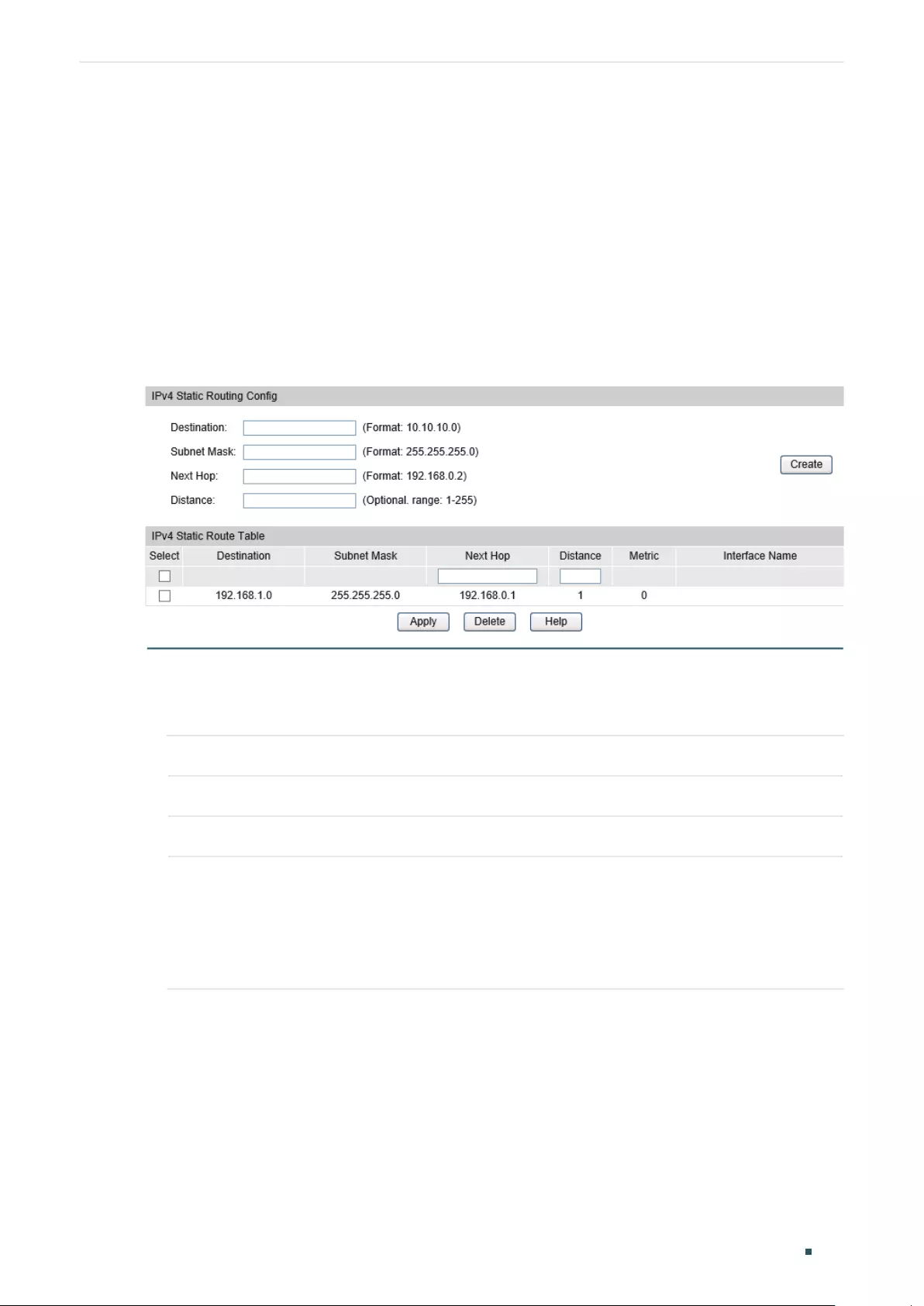
Configuring Static Routing IPv4 Static Routing Configuration
Configuration Guide 525
2 IPv4 Static Routing Configuration
2.1 Using the GUI
Choose the menu Routing> Static Routing > IPv4 Static Routing Config to load the
following page.
Figure 2-1 Configuring the IPv4 Static Routing
1) In the IPv4 Static Routing Config section, configure the corresponding parameters to
add an IPv4 static route. Then click Create.
Destination Specify the destination IPv4 address of the packets.
Subnet Mask Specify the subnet mask of the destination IPv4 address.
Next Hop Specify the IPv4 gateway address to which the packet should be sent next.
Distance Specify the administrative distance, which is a rating of the trustworthiness of the
routing information. A higher value means a lower trust rating. When more than
one routing protocols have routes to the same destination, only the route that
has the shortest distance will be recorded in the IP routing table.
The valid values are from 1 to 255 and the default value is 1.
2) In the IPv4 Static Route Table section, you can view and modify the IPv4 static routing
entries.

Configuration Guide 526
Configuring Static Routing IPv4 Static Routing Configuration
2.2 Using the CLI
Follow these steps to create an IPv4 static route.
Step 1 configure
Enter global configuration mode.
Step 2 ip route {
dest-address
} {
mask
} {
next-hop-address
} [
distance
]
Add an IPv4 static route.
dest-address:
Specify the destination IPv4 address of the packets.
mask:
Specify the subnet mask of the destination IPv4 address.
next-hop-address:
Specify the IPv4 gateway address to which the packet should be sent
next.
distance:
Specify the administrative distance, which is a rating of the trustworthiness of the
routing information. A higher value means a lower trust rating. When more than one routing
protocols have routes to the same destination, only the route that has the shortest distance
will be recorded in the IP routing table. The valid values are from 1 to 255 and the default
value is 1.
Step 3 show ip route [ static | connected ]
Verify the IPv4 route entries of the specified type.
Step 4 end
Return to privileged EXEC mode.
Step 5 copy running-config startup-config
Save the settings in the configuration file.
The following example shows how to create an IPv4 static route with the destination IP
address as 192.168.2.0, the subnet mask as 255.255.255.0 and the next-hop address as
192.168.0.2:
Switch#configure
Switch(config)#ip route 192.168.2.0 255.255.255.0 192.168.0.2
Switch(config)#show ip route
Codes: C - connected, S - static
* - candidate default
C 192.168.0.0/24 is directly connected, Vlan1
S 192.168.2.0/24 [1/0] via 192.168.0.2, Vlan1
Switch(config)#end
Switch#copy running-config startup-config

Configuring Static Routing IPv6 Static Routing Configuration
Configuration Guide 527
3 IPv6 Static Routing Configuration
Note:
For T2600G-18TS, to configure static IPv6 routing, please select the SDM Template as enterpriseV6 in
SDM Template Configuration in Managing System.
3.1 Using the GUI
Choose the menu Routing> Static Routing > IPv6 Static Routing Config to load the
following page.
Figure 3-1 Configuring the IPv6 Static Routing
1) In the IPv6 Routing section, enable IPv6 routing function and click Apply.
2) In the IPv6 Static Routing Config section, configure corresponding parameters to add
an IPv6 static route. Then click Create.
IPv6 Address Specify the destination IPv6 address of the packets.
Prefix Length Specify the prefix length of the IPv6 address.
Next Hop Specify the IPv6 gateway address to which the packet should be sent next.
Distance Specify the administrative distance, which is a rating of the trustworthiness of the
routing information. A higher value means a lower trust rating. When more than
one routing protocols have routes to the same destination, only the route that
has the shortest distance will be recorded in the IP routing table.
The valid values are from 1 to 255 and the default value is 1.

Configuration Guide 528
Configuring Static Routing IPv6 Static Routing Configuration
3) In the IPv6 Static Route Table section, you can view and modify the IPv6 static routing
entries.
3.2 Using the CLI
Follow these steps to enable IPv6 routing function and create an IPv6 static route.
Step 1 configure
Enter global configuration mode.
Step 2 ipv6 routing
Enable the IPv6 routing function on the specified layer 3 interface.
Step 3 ipv6 route {
ipv6-dest-address
} {
next-hop-address
} [
distance
]
Add an IPv6 static route.
ipv6-dest-address:
Specify the destination IPv6 address of the packets, in the format of
X:X:X:X::X/<0-128>.
next-hop-address:
Specify the IPv6 gateway address to which the packet should be sent
next.
distance:
Specify the administrative distance, which is a rating of the trustworthiness of the
routing information. A higher value means a lower trust rating. When more than one routing
protocols have routes to the same destination, only the route that has the shortest distance
will be recorded in the IP routing table. The valid values are from 1 to 255 and the default
value is 1.
Step 4 show ipv6 route [ static | connected ]
Verify the IPv6 route entries of the specified type.
Step 5 end
Return to privileged EXEC mode.
Step 6 copy running-config startup-config
Save the settings in the configuration file.
The following example shows how to create an IPv6 static route with the destination IP
address as 3200::/64 and the next-hop address as 3100::1234:
Switch#configure
Switch(config)#ipv6 route 3200::/64 3100::1234
Switch(config)#show ipv6 route static
Codes: C - connected, S - static
* - candidate default
C 3000::/64 is directly connected, Vlan1
S 3200::/64 [1/0] via 3100::1234, Vlan2

Configuring Static Routing IPv6 Static Routing Configuration
Configuration Guide 529
Switch(config)#end
Switch#copy running-config startup-config
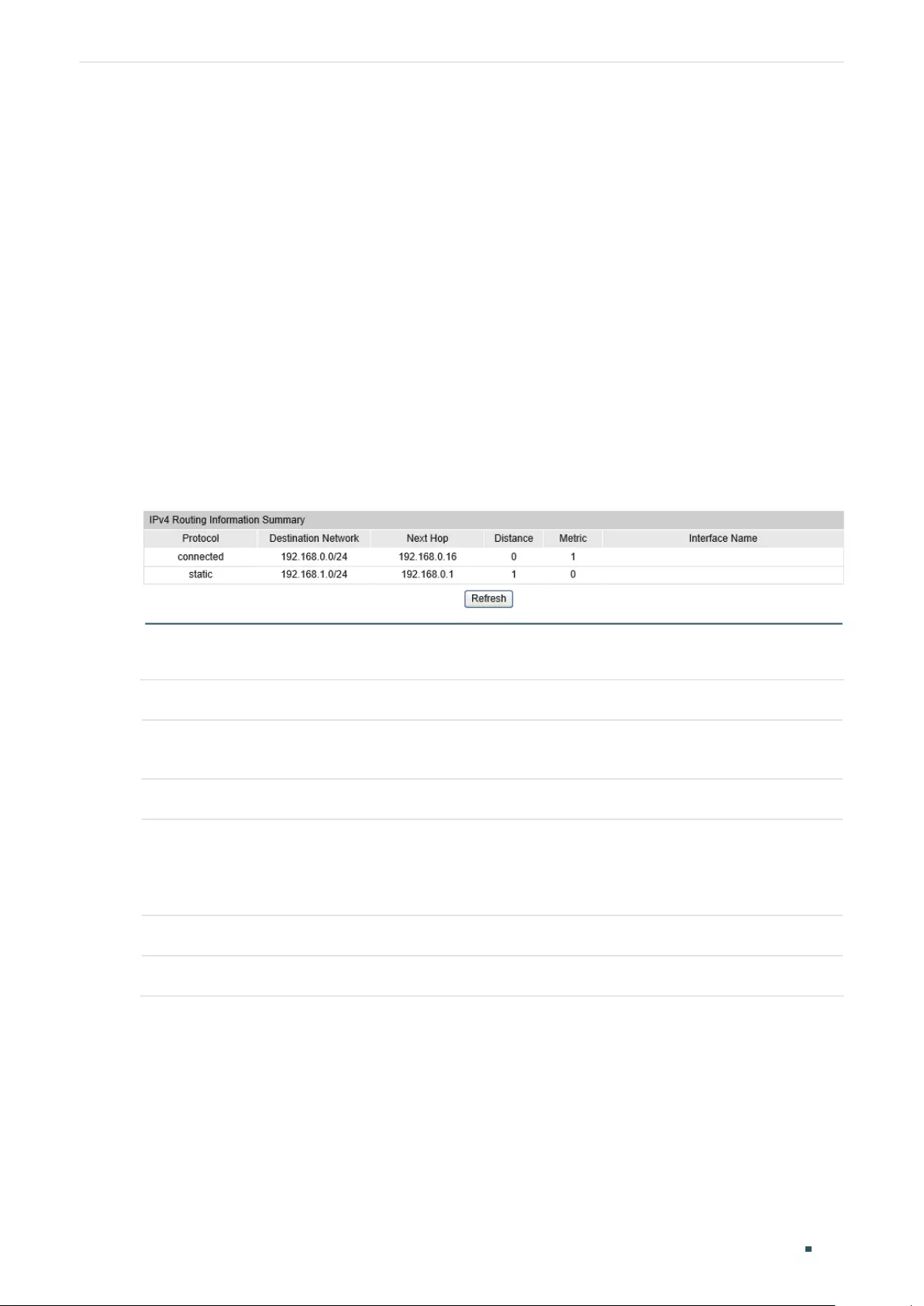
Configuration Guide 530
Configuring Static Routing Viewing Routing Table
4 Viewing Routing Table
You can view routing tables to learn about the network topology. The switch supports IPv4
routing table and IPv6 routing table.
4.1 Using the GUI
4.1.1 Viewing IPv4 Routing Table
Choose the menu Routing> Routing Table > IPv4 Routing Table to load the following
page.
Figure 4-1 Viewing IPv4 Routing Table
View the IPv4 routes in the IPv4 Routing Information Summary section.
Protocol Displays the type of the route entry.
Destination
Network
Displays the destination IP address and subnet mask.
Next Hop Displays the IPv4 gateway address to which the packet should be sent next.
Distance Displays the administrative distance which is a rating of the trustworthiness of a
routing information. A higher value means a lower trust rating. When more than one
routing protocols have routes to the same destination, only the route which has the
smallest distance will be recorded in the IP routing table.
Metric Displays the metric to reach the destination IP address.
Interface Name Displays the gateway interface name.

Configuring Static Routing Viewing Routing Table
Configuration Guide 531
4.1.2 Viewing IPv6 Routing Table
Choose the menu Routing> Routing Table > IPv6 Routing Table to load the following
page.
Figure 4-2 Viewing IPv6 Routing Table
View the IPv6 routes in the IPv6 Routing Information Summary section.
Protocol Displays the type of the route entry.
Destination
Network
Displays the destination IP address and subnet mask.
Next Hop Displays the IPv6 gateway address to which the packet should be sent next.
Distance Displays the administrative distance which is a rating of the trustworthiness of a
routing information. A higher value means a lower trust rating. When more than one
routing protocols have routes to the same destination, only the route which has the
smallest distance will be recorded in the IP routing table.
Metric Displays the metric to reach the destination IP address.
Interface Name Displays the gateway interface name.
4.2 Using the CLI
4.2.1 Viewing IPv4 Routing Table
On privileged EXEC mode or any other configuration mode, you can use the following
command to view IPv4 routing table:
show ip route [ static | connected ]
View the IPv4 route entries of the specified type. If not specified, all types of route entries will be displayed.
static: View the static routes.
connected: View the connected routes.

Configuration Guide 532
Configuring Static Routing Viewing Routing Table
4.2.2 Viewing IPv6 Routing Table
On privileged EXEC mode or any other configuration mode, you can use the following
command to view IPv6 routing table:
show ipv6 route [ static | connected ]
View the IPv6 route entries of the specified type. If not specified, all types of route entries will be
displayed.
static: View the static IPv6 routes.
connected: View the connected IPv6 routes.
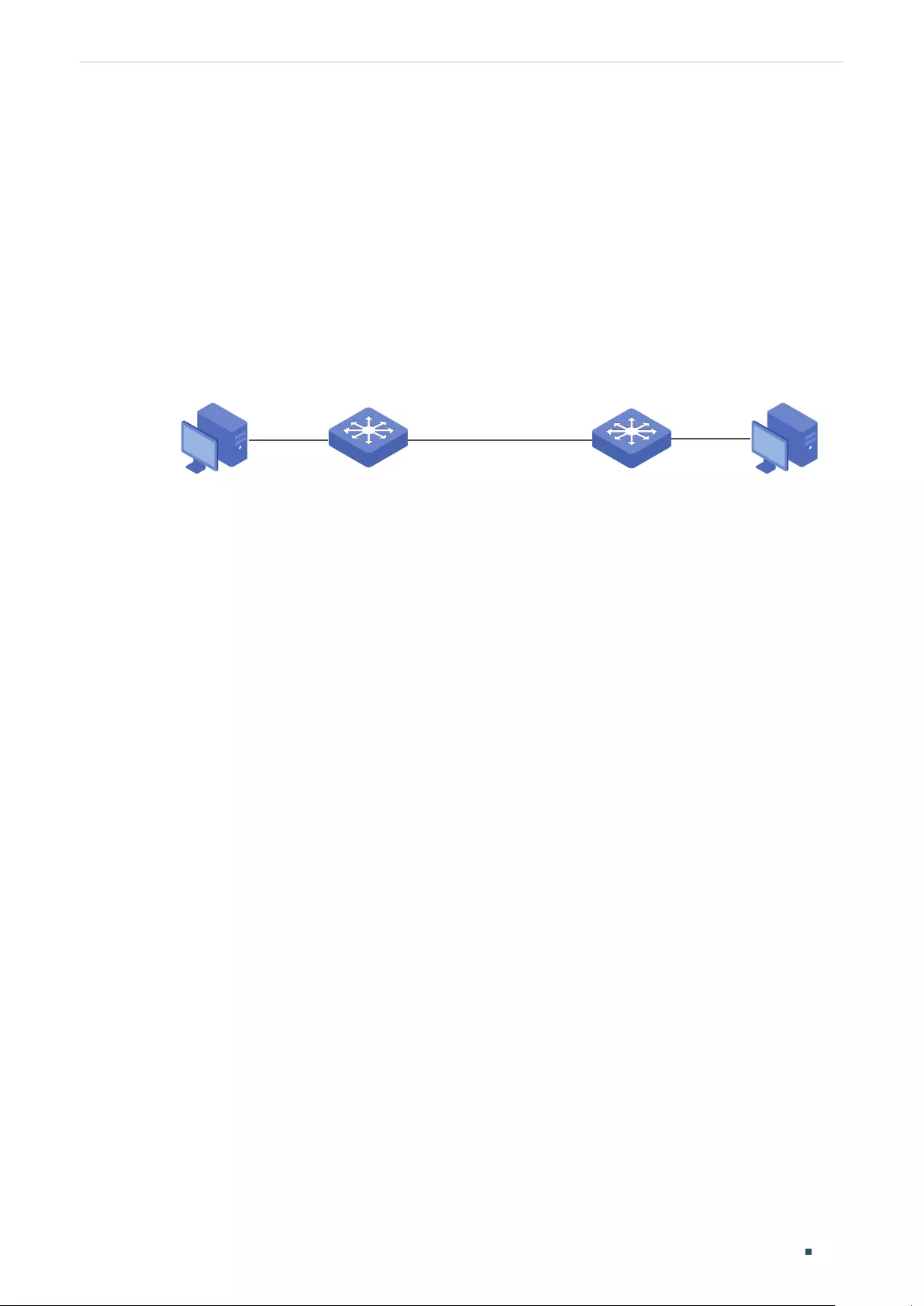
Configuring Static Routing Example for Static Routing
Configuration Guide 533
5 Example for Static Routing
5.1 Network Requirements
As shown below, Host A and Host B are on different network segments. To meet business
needs, Host A and Host B need establish a connection without using dynamic routing
protocols to ensure stable connectivity.
Figure 5-1 Network Topology
Host A
10.1.1.100/24
Host B
10.1.2.100/24
Gi1/0/1 Gi1/0/2 Gi1/0/1 Gi1/0/2
10.1.1.1/24 10.1.10.1/24 10.1.10.2/24 10.1.2.1/24
Switch A Switch B
5.2 Configuration Scheme
To implement this requirement, you can configure the default gateway of host A as
10.1.1.1/24, the default gateway of host B as 10.1.2.1/24, and configure IPv4 static routes
on Switch A and Switch B so that hosts on different network segments can communicate
with each other.
Demonstrated with T2600G-28TS, the following sections provide configuration procedure
in two ways: using the GUI and using the CLI.
5.3 Using the GUI
The configurations of Switch A and Switch B are similar. The following introductions take
Switch A as an example.
1) Choose the menu Routing> Interface > Interface Config to load the following page.
Create a routed port Gi1/0/1 with the mode as static, the IP address as 10.1.1.1, the
mask as 255.255.255.0 and the admin status as Enable. Create a routed port Gi1/0/2
with the mode as static, the IP address as 10.1.10.1, the mask as 255.255.255.0 and the
admin status as Enable.

Configuration Guide 534
Configuring Static Routing Example for Static Routing
Figure 5-2 Create a Routed Port Gi1/0/1 for Switch A
Figure 5-3 Create a Routed Port Gi1/0/2 for Switch A
2) Choose the menu Routing> Static Routing > IPv4 Static Routing Config to load the
following page. Add a static route entry with the destination as 10.1.2.0, the subnet
mask as 255.255.255.0 and the next hop as 10.1.10.2. For switch B, add a static route
entry with the destination as 10.1.1.0, the subnet mask as 255.255.255.0 and the next
hop as 10.1.10.1.
Figure 5-4 Add a Static Route for Switch A
5.4 Using the CLI
The configurations of Switch A and Switch B are similar. The following introductions take
Switch A as an example.
1) Create a routed port Gi1/0/1 with the mode as static, the IP address as 10.1.1.1, the
mask as 255.255.255.0 and the admin status as Enable. Create a routed port Gi1/0/2

Configuring Static Routing Example for Static Routing
Configuration Guide 535
with the mode as static, the IP address as 10.1.10.1, the mask as 255.255.255.0 and the
admin status as Enable.
Switch_A#configure
Switch_A(config)#interface gigabitEthernet 1/0/1
Switch_A(config-if)#no switchport
Switch_A(config-if)#ip address 10.1.1.1 255.255.255.0
Switch_A(config-if)#exit
Switch_A(config)#interface gigabitEthernet 1/0/2
Switch_A(config-if)#no switchport
Switch_A(config-if)#ip address 10.1.10.1 255.255.255.0
2) Add a static route entry with the destination as 10.1.2.0, the subnet mask as
255.255.255.0 and the next hop as 10.1.10.2. For switch B, add a static route entry with
the destination as 10.1.1.0, the subnet mask as 255.255.255.0 and the next hop as
10.1.10.1.
Switch_A#configure
Switch_A(config)#ip route 10.1.2.0 255.255.255.0 10.1.10.2
Switch_A(config)#end
Switch_A#copy running-config startup-config
Verify the Configurations
Switch A
Verify the static routing configuration:
Switch_A#show ip route
Codes: C - connected, S - static
* - candidate default
C 10.1.1.0/24 is directly connected, Vlan10
C 10.1.10.0/24 is directly connected, Vlan20
S 10.1.2.0/24 [1/0] via 10.1.10.2, Vlan20
Switch B
Verify the static routing configuration:
Switch_B#show ip route
Codes: C - connected, S - static

Configuration Guide 536
Configuring Static Routing Example for Static Routing
* - candidate default
C 10.1.2.0/24 is directly connected, Vlan30
C 10.1.10.0/24 is directly connected, Vlan20
S 10.1.1.0/24 [1/0] via 10.1.10.1, Vlan20
Connectivity Between Switch A and Switch B
Run the ping command on switch A to verify the connectivity:
Switch_A#ping 10.1.2.1
Pinging 10.1.2.1 with 64 bytes of data :
Reply from 10.1.2.1 : bytes=64 time<16ms TTL=64
Reply from 10.1.2.1 : bytes=64 time<16ms TTL=64
Reply from 10.1.2.1 : bytes=64 time<16ms TTL=64
Reply from 10.1.2.1 : bytes=64 time<16ms TTL=64
Ping statistics for 10.1.2.1:
Packets: Sent = 4 , Received = 4 , Lost = 0 (0% loss)
Approximate round trip times in milli-seconds:
Minimum = 1ms , Maximum = 3ms , Average = 1ms

Configuring Static Routing Appendix: Default Parameter
Configuration Guide 537
6 Appendix: Default Parameter
Default setting of static routing is listed in the following table.
Table 6-1 Configuring Static Routing
Parameter Default Setting
IPv6 Routing Disable
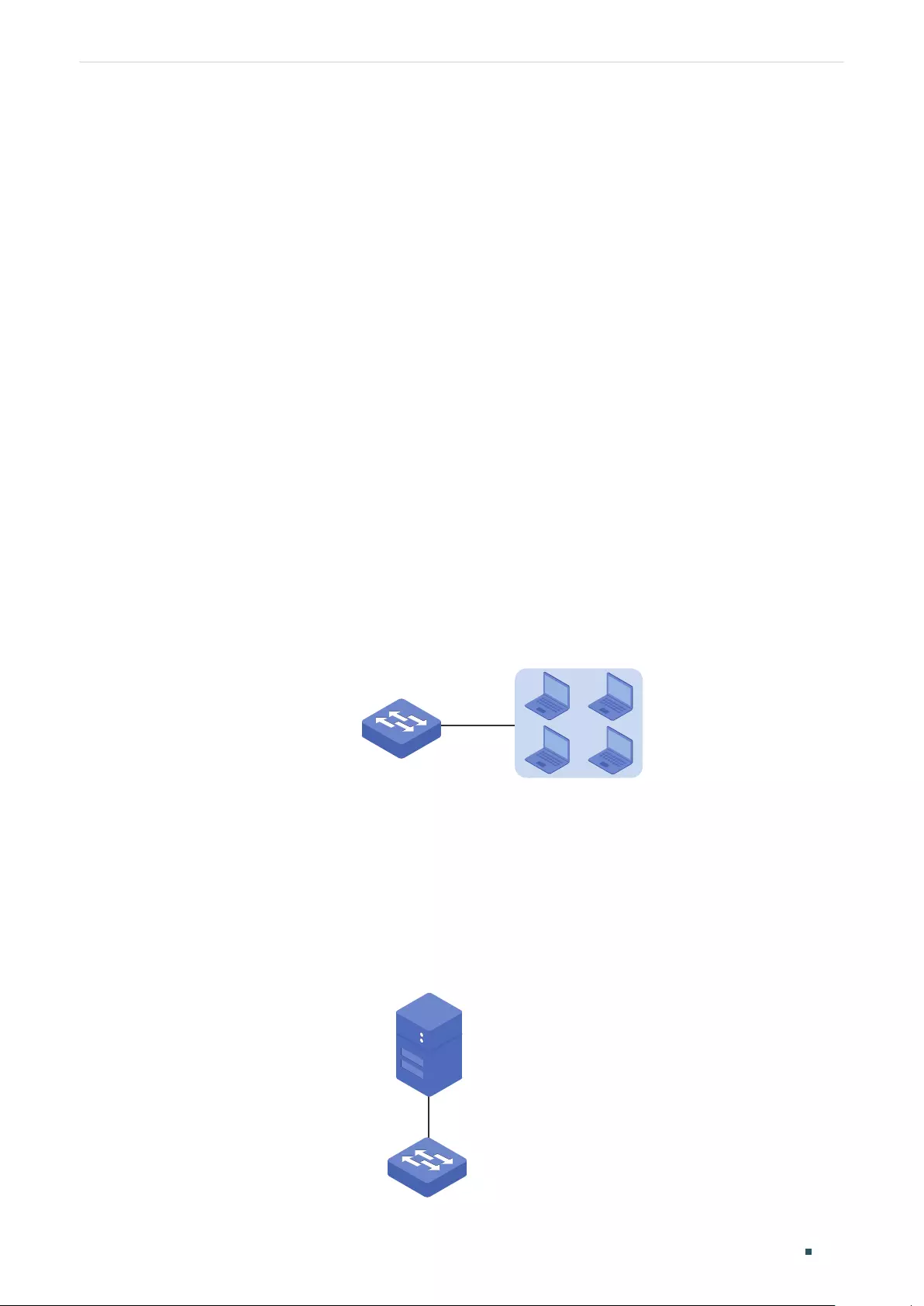
Configuring DHCP DHCP
Configuration Guide 539
1 DHCP
1.1 Overview
DHCP (Dynamic Host Configuration Protocol) is widely used in local area networks (LANs)
to dynamically assign IP addresses and other network configuration parameters to network
devices, which enhances the utilization of IP address.
1.2 Supported Features
The supported DHCP features of the switch include DHCP Server, DHCP Relay and DHCP
Client.
DHCP Server
DHCP Server is used to dynamically assign IP addresses, and other parameters if needed,
to clients in the local area network. As the following figure shows, the switch acts as a
DHCP server and assigns IP addresses to the hosts.
Figure 1-1 Application Scenario of DHCP Server
DHCP Clients
Switch
DHCP Server
DHCP Client
A Layer 3 interface can be configured as a DHCP client. After configured, the Layer 3
interface can dynamically obtain IP address and other parameters from a DHCP server,
which eases the network configuration and management. As the following figure shows,
the switch acts as a DHCP client and dynamically obtain IP address from the DHCP server.
Figure 1-2 Application Scenario of DHCP Client
Switch
DHCP Client
DHCP Server

Configuration Guide 540
Configuring DHCP DHCP
DHCP Relay
DHCP Relay is used to process and forward DHCP packets between different subnets or
VLANs.
Since the client requests a dynamic IP address via broadcast, the basic network model
of DHCP requires that the client and the server should be on the same LAN (on the same
subnet and VLAN). Therefore, each LAN should be equipped with a DHCP server, thus
increasing the costs of network construction.
DHCP Relay solves this problem. The DHCP Relay device acts as a relay agent and
forwards DHCP packets between DHCP clients and DHCP servers on different LANs, so
that DHCP clients on different LANs can share one DHCP server.
The switch supports two kinds of DHCP Relay: DHCP Interface Relay and DHCP VLAN
Relay.
DHCP Interface Relay
DHCP Interface Relay is used to process and forward DHCP packets between different
subnets.
Before DHCP Interface Relay configurations, you should configure IP addresses for the
layer 3 interfaces connected to the clients. The layer 3 interface can be configured as
either VLAN interface, routed port, or port channel interface according to your network
scheme. When receiving DHCP packets from clients, the switch will fill the corresponding
interface’s IP address in the relay agent IP address field of the DHCP packets, and forwards
the packets to the DHCP server. The DHCP server assigns IP addresses to the clients base
on the relay agent IP address field.
As the following figure shows, the IP address for VLAN20 is 192.168.2.1/24 and for the
routed port Gi1/0/1 is 192.168.3.1/24. With DHCP Interface VLAN configured, the switch
uses IP address of VLAN 20 (192.168.2.1/24) when applying for IP addresses for clients in
VLAN 20, and uses IP address of Gi1/0/1 (192.168.3.1/24) when applying for IP address for
PC 1. As a result, the DHCP server will assign IP addresses in Pool A (the same subnet with
the IP address of VLAN20) to clients in VLAN 20, and assign IP address in Pool B (the same
subnet with the Gi1/0/1) to PC 1.
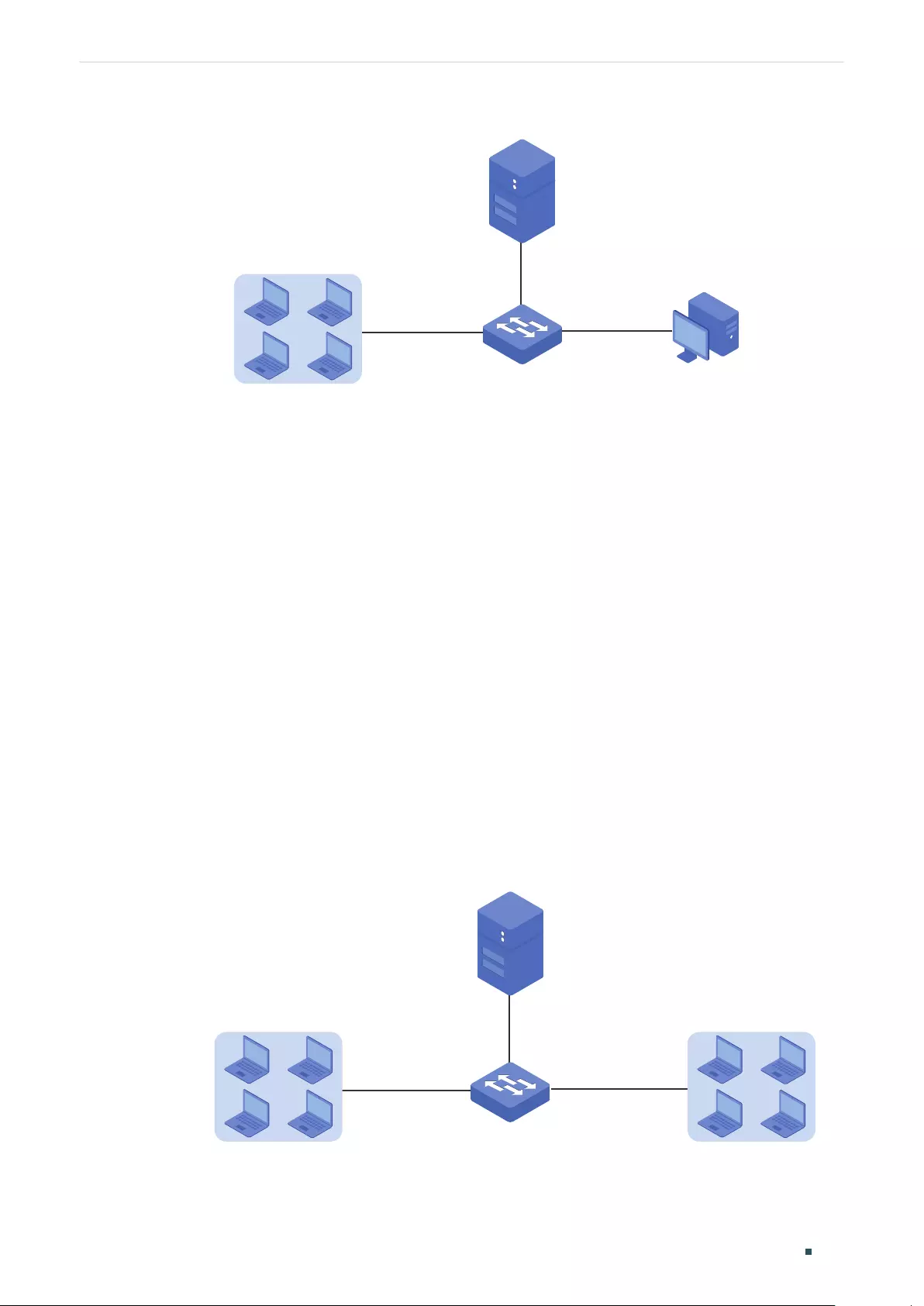
Configuring DHCP DHCP
Configuration Guide 541
Figure 1-3 Application Scenario of DHCP Interface Relay
VLAN 20
192.168.2.1/24
Gi1/0/1
Routed Port
192.168.3.1/24
DHCP Server
Pool A:192.168.2.0/24
Pool B:192.168.3.0/24
DHCP Clients
VLAN 20
192.168.2.0/24
PC 1
DHCP Client
192.168.3.2/24
Switch
DHCP Relay
DHCP VLAN Relay
DHCP VLAN Relay allows clients in different VLANs to obtain IP addresses from the DHCP
server using a single agent interface IP address.
In DHCP Interface Relay, to assign IP addresses to clients in different VLANs, you need to
create a layer 3 interface for each VLAN to ensure the reachability.
In DHCP VLAN Relay, you can simply specify a layer 3 interface as default agent interface
for all VLANs. The swith will fill this default agent interface’s IP address in the relay agent IP
address field of the DHCP packets from all VLANs.
As the following figure shows, no IP addresses are assigned to VLAN 10 and VLAN 20, but
a default relay agent interface is configured with the IP address 192.168.2.1/24. The switch
uses IP address of the default agent interface (192.168.2.1/24) to apply for IP addresses for
clients in both VLAN 10 and VLAN 20. As a result, the DHCP server will assign IP addresses
on 192.168.2.0/24 (the same subnet with the IP address of the default agent interface) to
clients in both VLAN 10 and VLAN 20.
Figure 1-4 Application Scenario of DHCP VLAN Relay
DHCP Server
DHCP Clients
VLAN 10
192.168.2.0/24
DHCP Clients
VLAN 20
192.168.2.0/24
DHCP Relay
Default Agent Interface:
192.168.2.1/24

Configuration Guide 542
Configuring DHCP DHCP
Note:
• If the VLAN already has an IP address, the switch will use the IP address of the VLAN as the
relay agent IP address. The default relay agent IP address will not take effect.
• A routed port or port channel interface is not associated with a particular VLAN. DHCP VLAN
relay will not work on routed ports or port channel interfaces.
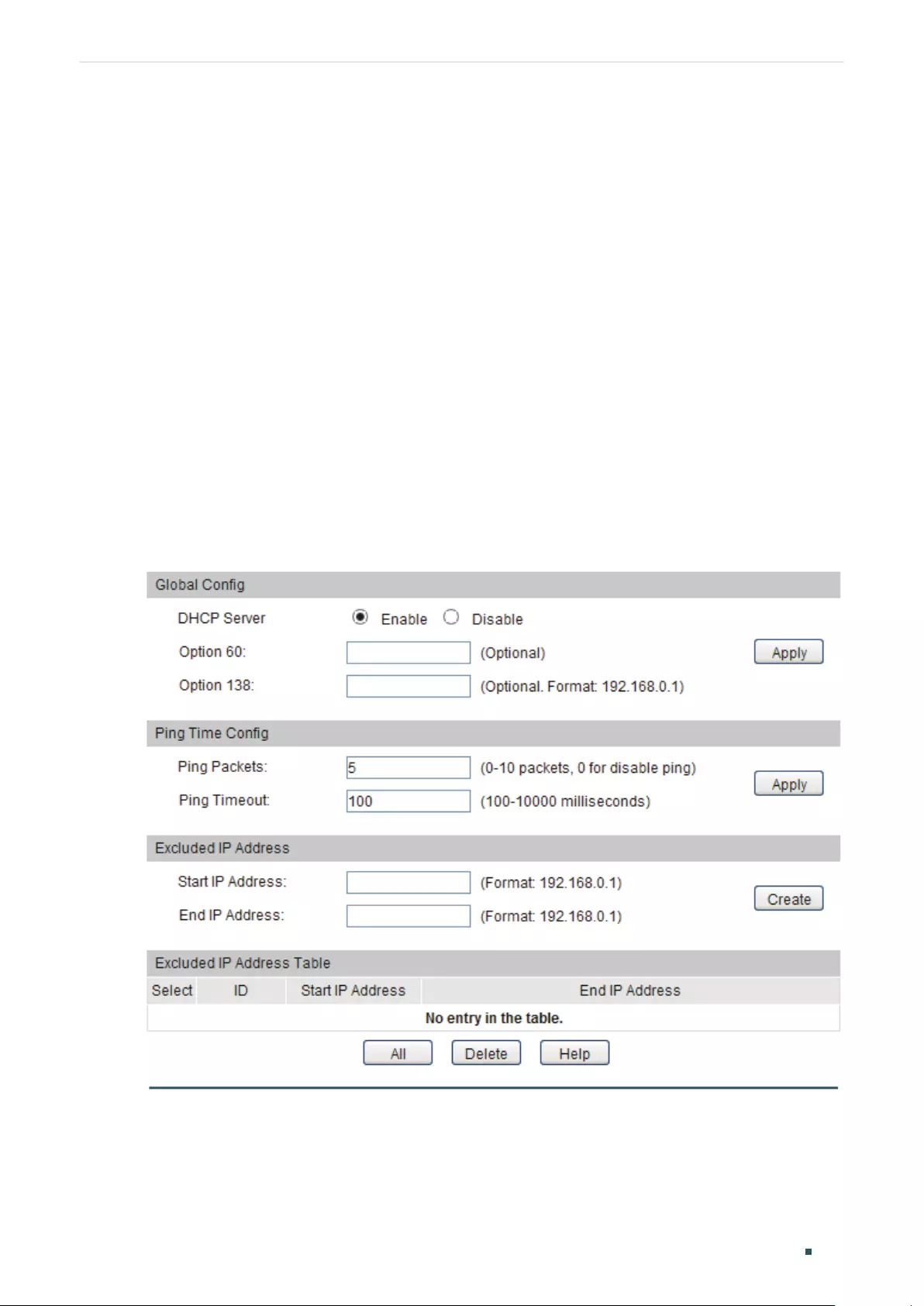
Configuring DHCP DHCP Server Configuration
Configuration Guide 543
2 DHCP Server Configuration
To complete DHCP server configuration, follow these steps:
1) Enable the DHCP Server feature on the switch.
2) Configure the DHCP Server Pool.
3) For hosts that need static IP addresses, WWW server for example, bind the MAC
address or client ID of the host to an IP address.
2.1 Using the GUI
2.1.1 Enabling DHCP Server
Choose the menu Routing > DHCP Server > DHCP Server to load the following page.
Figure 2-1 DHCP Server
Follow these steps to configure DHCP Server:
1) In the Global Config section, enable DHCP Server. Click Apply.

Configuration Guide 544
Configuring DHCP DHCP Server Configuration
DHCP Server Enable or disable DHCP Server. By default, it is disabled.
Option 60 (Optional) Specify the option 60 for device identification. Mostly it is used under
the scenario where the APs (Access Points) apply for different IP addresses from
different servers according to the needs.
If an AP requests option 60, the server will respond a packet containing the option
60 configured here. And then the AP will compare the received option 60 with
its own. If they are the same, the AP will accept the IP address assigned by the
server, otherwise the assigned IP address will not be accepted.
Option 138 (Optional) Specify the option 138, which can be configured as the management IP
address of an AC (Access Control) device. If the APs in the local network request
this option, the server will respond a packet containing this option to inform the
APs of the AC’s IP address.
2) In the Ping Time Config section, configure Ping Packets and Ping Timeout for ping
tests. Click Apply.
Ping Packets Enter the number of ping packets the server can broadcast to test whether the IP
address is occupied. The valid values are from 1 to 10, and the default is 1.
When the switch is configured as a DHCP server to dynamically assign IP
addresses to clients, the switch will deploy ping test to avoid IP address conflict
resulted from assigning IP addresses repeatedly.
Ping Timeout Specify the ping timeout period in milliseconds. It ranges from 100 to 10000 ms
and the default is 100 ms.
The DHCP server broadcasts an ICMP Echo Request (ping packet) to test whether
an IP address is occupied or not. If there is no response within the ping timeout
period, the server will broadcast the ping packet again. If the number of ping
packets reaches the specified number and there is still no response, the server
will assign the IP address. Otherwise, the server will record the IP address as a
conflicted IP address and assign another IP address to the client.
3) In the Excluded IP Address section, enter the Start IP Address and End IP Address to
specify the range of reserved IP addresses. Click Create.
Start IP Address/
End IP Address
Specify the start IP address and end IP address of the excluded IP address
range. If the start IP address and the end IP address are the same, the server
excludes only one IP address.
When configuring DHCP Server, you need to reserve certain IP addresses for
each subnet, such as default gateway address, broadcast address and DNS
server address.

Configuring DHCP DHCP Server Configuration
Configuration Guide 545
2.1.2 Configuring DHCP Server Pool
Choose the menu Routing > DHCP Server > Pool Setting to load the following page.
Figure 2-2 Pool Setting
Follow these steps to configure DHCP Server Pool:
1) In the DHCP Server Pool section, configure the relevant parameters.
Pool Name Specify a pool name for identification.
Network Address /
Subnet Mask
Configure the network address and subnet mask of the DHCP server pool.
The network address and subnet mask decide the range of the DHCP server
pool. On the same subnet, all addresses can be assigned except the excluded
addresses and addresses for special uses.
Lease Time Specify how long the client can use the IP address assigned from this address
pool. It ranges from 1 to 2880 minutes and the default is 120 minutes.
Default Gateway (Optional) Configure the default gateway of the DHCP server pool. You can
create up to 8 default gateways for each DHCP server pool.
In general, you can configure the IP address of the VLAN interface as the
default gateway address.

Configuration Guide 546
Configuring DHCP DHCP Server Configuration
DNS Server (Optional) Specify the DNS server of the DHCP server pool. You can specify up
to 8 DNS servers for each DHCP server pool.
In general, you can configure the IP address of the VLAN interface as the DNS
server address.
Netbios Server (Optional) Specify the NetBIOS name server. You can specify up to 8 NetBIOS
servers for each DHCP server pool.
When a DHCP client uses the Network NetBIOS (Basic Input Output System)
protocol for communication, the host name must be mapped to IP address.
NetBIOS name server can resolve host names to IP addresses.
Netbios Node
Type
(Optional) Specify the Netbios type for the clients, which is the way of inquiring
IP address resolution. The following options are provided:
b-node Broadcast: The client sends query message via broadcast.
p-node Peer-to-Peer: The client sends query message via unicast.
m-node Mixed: The client sends query message via broadcast first. If it fails,
the client will try again via unicast.
h-node Hybrid: The client sends query message via unicast first. If it fails, the
client will try again via broadcast.
Next Server
Address
(Optional) Specify the IP address of a TFTP server for the clients. If needed, the
clients can get the configuration file from the TFTP server for auto installation.
Domain Name (Optional) Specify the domain name that the clients should use when resolving
host names via DNS.
Bootfile (Optional) Specify the name of the bootfile. If needed, the clients can get the
bootfile from the TFTP server for auto installation.
2) Click Create.
2.1.3 Configuring Manual Binding
Some hosts, WWW server for example, requires a static IP address. To satisfy this
requirement, you can manually bind the MAC address or client ID of the host to an IP
address, and the DHCP server will reserve the bound IP address to this host at all times.

Configuring DHCP DHCP Server Configuration
Configuration Guide 547
Choose the menu Routing > DHCP Server > Manual Binding to load the following page.
Figure 2-3 Manual Binding
Follow these steps to configure Manual Binding:
1) In the Manual Binding section, select a pool name and enter the IP address to be
bound. Select a binding mode and finish the configuration accordingly.
Pool Name Select a DHCP server pool from the drop-down list.
IP Address Enter the IP address to be bound to the host.
Binding Mode Select a binding mode:
Client Id: Bind the IP address to the client ID.
Client Id in ASCii: Bind the IP address to the client ID in ASCII format.
Hardware Address: Bind the IP address to the MAC address of the client.
Client Id If you select Client ID as the binding mode, enter the client ID in this field.
Hardware
Address
If you select Hardware Address as the binding mode, enter the MAC address in
this field.
Hardware Type If you select Hardware Address as the binding mode, select a hardware type. The
hardware type includes Ethernet and IEEE802.
2) Click Create.

Configuration Guide 548
Configuring DHCP DHCP Server Configuration
2.2 Using the CLI
2.2.1 Enabling DHCP Server
Follow these steps to enable DHCP Server and to configure ping packets and ping timeout.
Step 1 configure
Enter global configuration mode.
Step 2 service dhcp server
Enable DHCP Server.
Step 3 ip dhcp server extend-option vendor-class-id
class-id
(Optional) Specify the option 60 for server identification. If a client requests option 60,
the server will respond a packet containing the option 60 configured here. And then the
client will compare the received option 60 with its own. If they are the same, the client will
accept the IP address assigned by the server, otherwise the assigned IP address will not be
accepted.
class-id
: Specify the option 60.
Step 4 ip dhcp server extend-option capwap-ac-ip
ip-address
(Optional) Specify the option 138, which can be configured as the management IP address
of an AC (Access Control) device. If the APs (Access Points) in the local network request
this option, the server will respond a packet containing this option to inform the APs of the
AC’s IP address.
ip-address
: Specify the option 138.
Step 5 ip dhcp server ping timeout
value
Specify the ping timeout period. The DHCP server broadcasts an ICMP Echo Request (ping
packet) to test whether an IP address is occupied or not. If there is no response within the
ping timeout period, the server will broadcast the ping packet again. If the number of ping
packets reaches the specified number and there is still no response, the server will assign
the IP address. Otherwise, the server will record the IP address as a conflicted IP address
and assign another IP address to the client.
value
: Specify the ping timeout period in milliseconds. It ranges from 100 to 10000 ms and
the default is 100 ms.
Step 6 ip dhcp server ping packets
num
Specify the number of ping packets the server can broadcast to test whether the IP
address is occupied. When the switch is configured as a DHCP server to dynamically assign
IP addresses to clients, the switch will deploy ping test to avoid IP address conflict resulted
from assigning IP addresses repeatedly.
num
: Enter the number of ping packets. The valid values are from 1 to 10, and the default is 1.

Configuring DHCP DHCP Server Configuration
Configuration Guide 549
Step 7 ip dhcp server exclude-address
start-ip-address end-ip-address
Specify the start IP address and end IP address of the excluded IP address range. If the
start IP address and the end IP address are the same, the server excludes only one IP
address.
When configuring DHCP Server, you need to reserve certain IP addresses for each subnet,
such as default gateway address, broadcast address and DNS server address.
start-ip-address/end-ip-address
: Specify the start IP address and end IP address.
Step 8 show ip dhcp server status
Verify the DHCP status, including whether it is enabled and the configuration of ping packet
number and ping packet timeout.
Step 9 show ip dhcp server extend-option
Verify the configuration of the extend options.
Step 10 show ip dhcp server excluded-address
Verify the configuration of the excluded IP address.
Step 11 end
Return to Privileged EXEC Mode.
Step 12 copy running-config startup-config
Save the settings in the configuration file.
The following example shows how to enable DHCP Server globally on Switch, configure the
number of ping packets as 2 and configure the ping timeout period as 200 ms:
Switch#configure
Switch(config)#service dhcp server
Switch(config)#ip dhcp server ping packets 2
Switch(config)#ip dhcp server ping timeout 200
Switch(config)#show ip dhcp server status
DHCP server is enable.
Ping packet number: 2.
Ping packet timeout: 200 milliseconds.
Switch(config)#end
Switch#copy running-config startup-config

Configuration Guide 550
Configuring DHCP DHCP Server Configuration
The following example shows how to configure the option 60 as abc and option 138 as
192.168.0.155:
Switch#configure
Switch(config)#ip dhcp server extend-option vendor-class-id abc
Switch(config)#ip dhcp server extend-option capwap-ac-ip 192.168.0.155
Switch(config)#show ip dhcp server extend-option
Option 60: abc
Option 138: 192.168.0.155
Switch(config)#end
Switch#copy running-config startup-config
The following example shows how to configure the 192.168.1.1 as the default gateway
address and excluded IP address:
Switch#configure
Switch(config)#ip dhcp server excluded-address 192.168.1.1 192.168.1.1
Switch(config)#show ip dhcp server excluded-address
No. Start IP Address End IP Address
--- ------------- --------------
1 192.168.1.1 192.168.1.1
Switch(config)#end
Switch#copy running-config startup-config
2.2.2 Configuring DHCP Server Pool
Follow these steps to configure DHCP server pool:
Step 1 configure
Enter global configuration mode.
Step 2 ip dhcp server pool
pool-name
Configure a name for the DHCP server pool for identification.
pool-name
: Specify a pool name with 1 to 8 characters.

Configuring DHCP DHCP Server Configuration
Configuration Guide 551
Step 3 network
network-address subnet-mask
Configure the network address and subnet mask of the DHCP server pool.
The network address and subnet mask decide the range of the DHCP server pool. On the
same subnet, all addresses can be assigned except the excluded addresses and addresses
for special uses.
network-address
: Configure the network address of the DHCP server pool.
subnet-mask
: Configure the subnet mask of the DHCP server pool.
Step 4 lease
lease-time
Specify how long the client can use the IP address assigned from this address pool.
lease-time
: Enter the value of lease-time. It ranges from 1 to 2880 minutes and the default is
120 minutes.
Step 5 default-gateway
gateway-list
(Optional) Configure the default gateway of the DHCP server pool. In general, you can
configure the IP address of the VLAN interface as the default gateway address.
gateway-list
: Specify the IP address of the default gateway. You can create up to 8 default
gateways for each DHCP server pool.
Step 6 dns-server
dns-server-list
(Optional) Specify the DNS server of the DHCP server pool. In general, you can configure
the IP address of the VLAN interface as the DNS server address.
dns-server-list
: Specify the IP address of the DNS server. You can specify up to 8 DNS
servers for each DHCP server pool.
Step 7 netbios-name-server
NBNS-list
(Optional) Specify the NetBIOS name server. You can specify up to 8 NetBIOS servers for
each DHCP server pool.
When a DHCP client uses the Network NetBIOS (Basic Input Output System) protocol for
communication, the host name must be mapped to IP address. NetBIOS name server can
resolve host names to IP addresses.
NBNS-list
: Specify the IP address of the NetBIOS server. You can specify up to 8 NetBIOS
servers for each DHCP server pool.
Step 8 netbios-node-type
type
(Optional) Specify the Netbios type for the clients, which is the way of inquiring IP address
resolution.
type
: Specify the Netbios type. The following options are provided:
b-node Broadcast: The client sends query message via broadcast.
p-node Peer-to-Peer: The client sends query message via unicast.
m-node Mixed: The client sends query message via broadcast first. If it fails, the client will
try again via unicast.
h-node Hybrid: The client sends query message via unicast first. If it fails, the client will try
again via broadcast.

Configuration Guide 552
Configuring DHCP DHCP Server Configuration
Step 9 next-server
ip-address
(Optional) Specify the IP address of a TFTP server for the clients. If needed, the clients can
get the configuration file from the TFTP server for auto installation.
ip-address
: Specify the IP address of theTFTP server.
Step 10 domain-name
domainname
(Optional) Specify the domain name that the clients should use when resolving host names
via DNS.
domainname
: Specify the domain name.
Step 11 bootfile
file-name
(Optional) Specify the name of the bootfile. If needed, the clients can get the bootfile from
the TFTP server for auto installation.
file-name
: Specify the bootfile name.
Step 12 show ip dhcp server pool
Verify the configuration of the DHCP server pool.
Step 13 end
Return to Privileged EXEC Mode.
Step 14 copy running-config startup-config
Save the settings in the configuration file.
The following example shows how to create a DHCP server pool and name it as pool1 and
configure its network address as 192.168.1.0, subnet mask as 255.255.255.0, lease time
as 180 minute, default gateway as 192.168.1.1, DNS server as 192.168.1.4, Netbios server
as 192.168.1.19, Netbios type as broadcast, TFTP server as 192.168.1.30, domain name as
com, and bootfile name as bootfile:
Switch#configure
Switch(config)#ip dhcp server pool pool1
Switch(dhcp-config)#network 192.168.1.0 255.255.255.0
Switch(dhcp-config)#lease 180
Switch(dhcp-config)#default-gateway 192.168.1.1
Switch(dhcp-config)#dns-server 192.168.1.4
Switch(dhcp-config)#netbios-name-server 192.168.1.19
Switch(dhcp-config)#netbios-node-type b-node
Switch(dhcp-config)#next server 192.168.1.30
Switch(dhcp-config)#domain-name com
Switch(dhcp-config)#bootfile bootfile

Configuring DHCP DHCP Server Configuration
Configuration Guide 553
Switch(dhcp-config)#show ip dhcp server pool
Pool Name: pool1
Network Address: 192.168.1.0
Subenet Mask: 255.255.255.0
Lease Time: 180
Default Gateway: 192.168.1.1
DNS Server: 192.168.1.4
Netbios Server: 192.168.1.19
Netbios Node Type: b-node
Next Server Address: 192.168.1.30
Domain Name: com
Bootfile Name: bootfile
Switch(dhcp-config)#end
Switch#copy running-config startup-config
2.2.3 Configuring Manual Binding
Some hosts, WWW server for example, requires a static IP address. To satisfy this
requirement, you can manually bind the MAC address or client ID of the host to an IP
address, and the DHCP server will reserve the bound IP address to this host at all times.
Follow these steps to configure Manual Binding:
Step 1 configure
Enter global configuration mode.
Step 2 ip dhcp server pool
name
Create a DHCP server pool and enter DHCP configuration mode.

Configuration Guide 554
Configuring DHCP DHCP Server Configuration
Step 3 Bind an IP address to a client:
address
ip-address
client-identifier
client-id
Bind the specified IP address to the client with a specific hexadecimal client ID.
ip-address:
Specify the IP address to be bound.
client-id:
Specify the client ID in hexadecimal format.
address
ip-address
client-identifier
client-id
ascii
Bind the specified IP address to the client with a specific ASCII client ID.
ip-address:
Specify the IP address to be bound.
client-id:
Specify the client ID with ASCII characters.
address
ip-address
hardware-address
hardware-address
hardware-type { ethernet |
ieee802 }
Bind the specified IP address to the client with a specific MAC address.
ip-address:
Specify the IP address to be bound.
hardware-address:
Enter the MAC address of the client.
ethernet | ieee802
:
Specify a hardware type for the client, either Ethernet or IEEE802.
Step 4 show ip dhcp server manual-binding
Verify the manual binding configuration.
Step 5 end
Return to Privileged EXEC Mode.
Step 6 copy running-config startup-config
Save the settings in the configuration file.
The following example shows how to bind the IP address 192.168.1.33 in pool1 (on the
subnet of 192.168.1.0) to the host with the MAC address 74:D4:68:22:3F:34:
Switch#config
Switch(config)#ip dhcp server pool pool1
Switch(dhcp-config)#address 192.168.1.33 hardware-address 74:d4:68:22:3f:34
hardware-type ethernet
Switch(dhcp-config)#show ip dhcp server manual-binding
Pool Name Client Id/Hardware Address IP Address Hardware Type Bind Mode
------- ------------------- --------- ----------- --------
pool1 74:d4:68:22:3f:34 192.168.1.33 Ethernet MAC Address
Switch(dhcp-config)#end
Switch#copy running-config startup-config
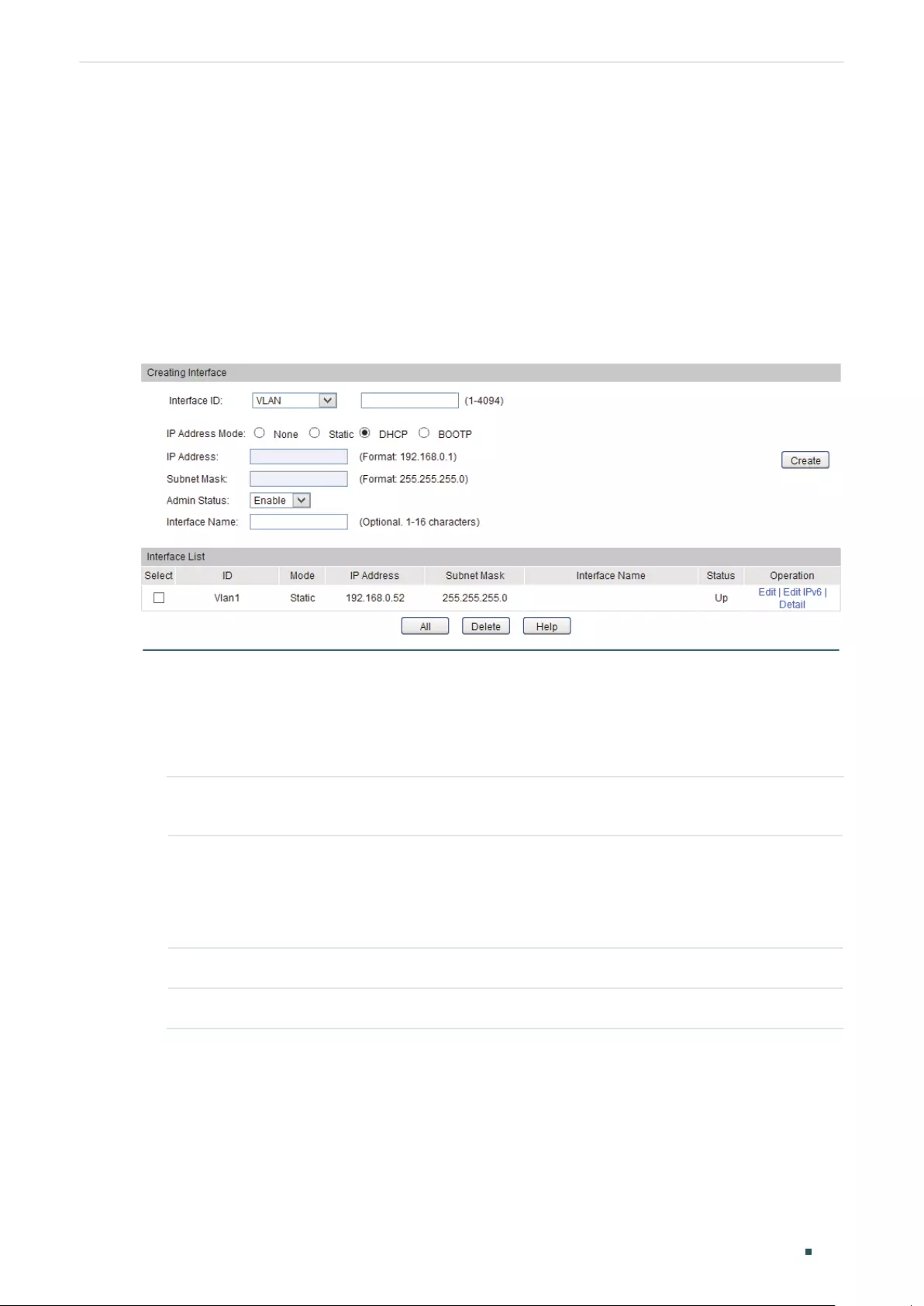
Configuring DHCP DHCP Client Configuration
Configuration Guide 555
3 DHCP Client Configuration
3.1 Using the GUI
Choose the menu Routing > Interface > Interface Config to load the following page.
Figure 3-1 DHCP Client Configuration
Follow these steps to configure DHCP client:
1) In the Creating Interface section, select Interface VLAN or Routed Port as the interface
type and enter the interface ID. Select DHCP or BOOTP as the IP Address Mode. Set the
Admin Status as Enable, and enter the Interface Name (optional).
Interface ID Select an interface type and enter the ID of the interface. If you select VLAN, enter
a VLAN ID. If you select Routed port, enter a port number.
IP Address
Mode
Select DHCP or BOOTP as the IP address assignment mode.
DHCP: Assign an ip address for the interface through DHCP.
BOOTP: Assign an ip address for the interface through BOOTP.
Admin Status Enable or disable the interface’s Layer 3 capabilities.
Interface Name (Optional) Specify a name for the interface.
2) Click Create.

Configuration Guide 556
Configuring DHCP DHCP Client Configuration
3.2 Using the CLI
Follow these steps to configure DHCP client.
Step 1 configure
Enter global configuration mode.
Step 2 Enter interface configuration mode.
interface vlan
vid
Enter VLAN interface configuration mode.
vid:
Specify the VLAN ID.
interface gigabitEthernet
port
no switchport
Enter interface configuration mode and configure the port as a layer-3 routed port.
port:
Specify the port number.
interface port-channel
pid
no switchport
Enter port-channel configuration mode and configure the port-channel as a layer-3 port-
channel.
pid:
Specify the ID of the port-channel.
Step 3 ip address-alloc { dhcp | bootp }
Enable DHCP or BOOTP IP address mode.
dhcp: The specified Layer 3 interface can request the DHCP server to dynamically assign IP
address and other network configuration parameters through DHCP mode.
bootp: The specified Layer 3 interface can request the DHCP server to dynamically assign
IP address and other network configuration parameters through BOOTP mode.
Step 4 show ip interface brief
Verify the DHCP client configuration.
Step 5 end
Return to Privileged EXEC Mode.
Step 6 copy running-config startup-config
Save the settings in the configuration file.
The following example shows how to configure port 1/0/5 as an Layer 3 interface, and to
configure its IP address mode as DHCP:
Switch#configure

Configuring DHCP DHCP Client Configuration
Configuration Guide 557
Switch(config)#interface gigabitEthernet 1/0/5
Switch(config-if)#no switchport
Switch(config-if)#ip address-alloc dhcp
Switch(config-if)#show ip interface brief
Interface IP-Address Method Status Protocol Shutdown
--------- ---------- ------ ------ -------- --------
Gi1/0/5 192.168.0.100/24 DHCP up up no
Switch(config-if)#end
Switch#copy running-config startup-config

Configuration Guide 558
Configuring DHCP DHCP Relay Configuration
4 DHCP Relay Configuration
To complete DHCP Relay configuration, follow these steps:
1) Enable DHCP Relay. Configure Option 82 if needed.
2) Specify DHCP server for the Interface or VLAN.
4.1 Using the GUI
4.1.1 Enabling DHCP Relay and Configuring Option 82
Choose the menu Routing > DHCP Relay > Global Config to load the following page.
Figure 4-1 Enable DHCP Relay and Configure Option 82
Follow these steps to enable DHCP Relay and configure Option 82:
1) In the Global Config section, enable DHCP Relay.
2) (Optional) In the Option 82 Configuration section, configure Option 82.
DHCP Relay Enable or disable DHCP Relay.
Option 82
Support
Select whether to enable Option 82 or not. By default, it is disabled. Option 82 is
used to record the locations of the DHCP client, its Ethernet port and the VLAN,
etc. If you need to record the accurate location of a client, you can enable Option
82 on the relay device closest to the client.

Configuring DHCP DHCP Relay Configuration
Configuration Guide 559
Existed Option
82 field
Select the operation for the Option 82 field of the DHCP request packets.
Keep: Indicates keeping the Option 82 field of the packets.
Replace: Indicates replacing the Option 82 field of the packets with the switch
defined one. By default, the Circuit ID is defined to be the VLAN and the number of
the port which receives the DHCP Request packets. The Remote ID is defined to
be the MAC address of the DHCP Relay device which receives the DHCP Request
packets.
Drop: Indicates discarding the packets that include the Option 82 field.
Option 82
Format
Select the format of option 82 sub-option value field.
Normal: Indicates that the format of sub-option value field is TLV (type-length-
value).
Private: Indicates that the format of sub-option value field is just value.
Customization Select whether to enable Customization of Option 82 or not. When enabled,
configure Option 82 information manually.
Circuit ID Enter the customized circuit ID, which contains up to 64 characters. The circuit ID
configurations of the switch and the DHCP server should be compatible with each
other.
Remote ID Enter the customized remote ID, which contains up to 64 characters. The remote
ID configurations of the switch and the DHCP server should be compatible with
each other.
3) Click Apply.
4.1.2 Specifying DHCP Server for the Interface or VLAN
You can specify DHCP server for an layer-3 interface or for a VLAN. The following
respectively introduces how to configure DHCP Interface Relay and DHCP VLAN Relay.
DHCP Interface Relay
For T2600G-28MPS, choose the menu Routing > DHCP Relay > DHCP Server to load the
following page.
For other T2600G series products, choose the menu Routing > DHCP Relay > DHCP
Interface Relay to load the following page.
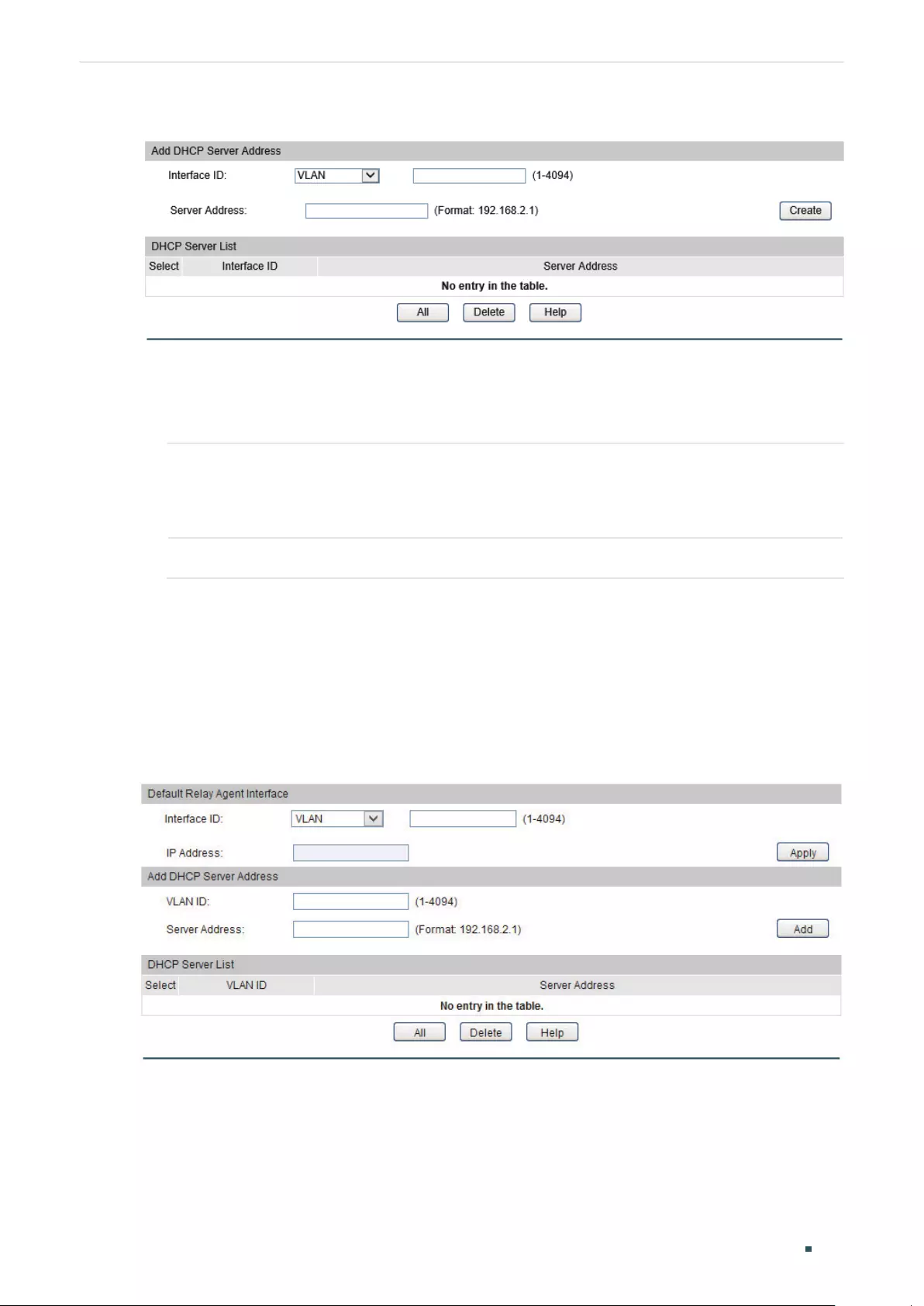
Configuration Guide 560
Configuring DHCP DHCP Relay Configuration
Figure 4-2 Specify DHCP Server for Layer-3 Interface
Follow these steps to specify DHCP Server for the interface:
1) In the Add DHCP Server Address section, select the interface type and enter the
interface ID, and then enter the server address of the interface.
Interface ID Specify the type and ID of the interface that is facing to the DHCP CLIENTS.
The interface should be an existing layer 3 interface. For how to create a layer 3
interface, refer to Configuring Logical Interfaces.
Server Address Enter the IP address of the DHCP server.
2) Click Create to specify the DHCP server for the interface.
DHCP VLAN Relay
T2600G-28MPS does not support this feature.
Choose the menu Routing > DHCP Relay > DHCP VLAN Relay to load the following page.
Figure 4-3 Specify DHCP Server for VLAN
Follow these steps to specify DHCP Server for the specific VLAN:
1) In the Default Relay Agent Interface section, specify the type and ID of the interface
that needs to be configured as the default relay agent interface. Then click Apply.

Configuring DHCP DHCP Relay Configuration
Configuration Guide 561
Interface ID Specify the type and ID of the interface that needs to be configured as the default
relay agent interface.
You can configure any existing layer 3 interface as the default relay agent
interface. The DHCP server will assign IP addresses in the same subnet with this
relay agent interface to the clients who use this relay agent interface to apply
for IP addresses. For how to create layer 3 interface, refer to Configuring Logical
Interfaces.
IP Address Displays the IP address of this interface.
Note:
• If the VLAN already has an IP address, the switch will use the IP address of the VLAN as the
relay agent IP address. The default relay agent IP address will not take effect.
• A routed port or port channel interface is not associated with a particular VLAN. DHCP
VLAN relay will not work on routed ports or port channel interfaces.
2) In the Add DHCP Server Address section, specify the VLAN in which the clients needs
IP addresses and the server address. Click Add.
VLAN ID Specify the VLAN, in which the clients can get IP addresses from the DHCP
server.
Server Address Enter the IP address of the DHCP server.
4.2 Using the CLI
4.2.1 Enabling DHCP Relay
Follow these steps to enable DHCP Relay:
Step 1 configure
Enter global configuration mode.
Step 2 service dhcp relay
Enable DHCP Relay.
Step 3 show ip dhcp relay
Verify the configuration of DHCP Relay.
Step 4 end
Return to Privileged EXEC Mode.
Step 5 copy running-config startup-config
Save the settings in the configuration file.
The following example shows how to enable DHCP Relay:

Configuration Guide 562
Configuring DHCP DHCP Relay Configuration
Switch#configure
Switch(config)#service dhcp relay
Switch(config)#show ip dhcp relay
DHCP relay is enabled.
......
Switch(config)#end
Switch#copy running-config startup-config
4.2.2 (Optional) Configuring Option 82
Follow these steps to configure Option 82:
Step 1 configure
Enter global configuration mode.
Step 2 ip dhcp relay information
Enable the Option 82 feature.
Step 3 ip dhcp relay information policy { keep | replace | drop }
Configure how to process Option 82 information.
keep: The switch will keep the Option 82 information in the packet.
replace: The switch will replace the Option 82 information with the customized
configurations on the switch.
drop: The switch will drop the packets carrying Option 82 information
Step 4 ip dhcp relay information format { normal | private }
Specify the format of option 82 sub-option value field.
normal: Indicates that the format of sub-option value field is TLV (type-length-value).
private: Indicates that the format of sub-option value field is just value.
Step 5 ip dhcp relay information custom
Enable the Customization feature of Option 82.
Step 6 ip dhcp relay information circuit-id
circuit-id
If the Customization feature is enabled, specify the circuit ID.
circuit-id:
Specify the circuit ID with 1 to 63 characters including digits, English letters and
underlines.
Step 7 ip dhcp relay information remote-id
remote-id
If the Customization feature is enabled, specify the remote ID.
remote-id:
Specify the remote ID with 1 to 32 characters including digits, English letters and
underlines.

Configuring DHCP DHCP Relay Configuration
Configuration Guide 563
Step 8 show ip dhcp relay
Verify the configuration of DHCP Relay.
Step 9 end
Return to Privileged EXEC Mode.
Step 10 copy running-config startup-config
Save the settings in the configuration file.
The following example shows how to enable Option 82 and configure the process of Option
82 information as keep:
Switch#configure
Switch(config)#ip dhcp relay information
Switch(config)#ip dhcp relay information policy keep
Switch(config)#show ip dhcp relay
......
DHCP relay option 82 is enabled.
Existed option 82 field operation: keep.
......
Switch(config)#end
Switch#copy running-config startup-config
4.2.3 Specifying DHCP Server for Interface or VLAN
You can specify DHCP server for an layer-3 interface or for a VLAN. The following
respectively introduces how to configure DHCP Interface Relay and DHCP VLAN Relay.
DHCP Interface Relay
Follow these steps to DHCP Interface Relay:
Step 1 configure
Enter global configuration mode.

Configuration Guide 564
Configuring DHCP DHCP Relay Configuration
Step 2 Enter Layer 3 interface configuration mode:
interface vlan
vid
Enter VLAN interface configuration mode.
vid
:Specify the ID of the VLAN that will be configured as a DHCP relay agent. The valid
values are from 1 to 4094.
interface {
fastEthernet
port
| gigabitEthernet
port
}
no switchport
Enter Routed Port interface configuration mode.
port:
Specify the ID of the routed port that will be configured as a DHCP relay agent.
interface port-channel
lagid
Enter Port-channel configuration mode.
lagid:
Specify the ID of the LAG.
Step 3 ip helper-address
ip-addr
Specify DHCP server for the Layer 3 interface.
ip-addr:
Enter the IP address of the DHCP server.
Step 4 show ip dhcp relay
Verify the configuration of DHCP Relay.
Step 5 end
Return to Privileged EXEC Mode.
Step 6 copy running-config startup-config
Save the settings in the configuration file.
The following example shows how to configure the DHCP server address as 192.168.1.7
on VLAN interface 66:
Switch#configure
Switch(config)#interface vlan 66
Switch(config-if)#ip helper-address 192.168.1.7

Configuring DHCP DHCP Relay Configuration
Configuration Guide 565
Switch(config-if)#show ip dhcp relay
......
DHCP relay helper address is configured on the following interfaces:
Interface Helper address
---------- --------------
VLAN 66 192.168.1.7
Switch(config-if)#end
Switch#copy running-config startup-config
DHCP VLAN Relay
T2600G-28MPS does not support this feature.
Follow these steps to configure DHCP VLAN Relay:
Step 1 configure
Enter global configuration mode.
Step 2 Enter Layer 3 interface configuration mode:
interface vlan
vid
Enter VLAN interface configuration mode.
vid
: Specify the ID of the VLAN that will be configured as the default relay agent interface.
The valid values are from 1 to 4094.
interface loopback
lid
Enter loopback configuration mode.
lid
: Specify the ID of the loopback interface that will be configured as the default relay agent
interface. The valid values are from 1 to 64.
interface {
fastEthernet
port
| gigabitEthernet
port
}
no switchport
Enter Routed Port interface configuration mode.
port:
Specify the ID of the routed port that will be configured as the default relay agent
interface.
interface port-channel
lagid
Enter Port-channel configuration mode.
lagid:
Specify the ID of the LAG that will be configured as the default relay agent interface.

Configuration Guide 566
Configuring DHCP DHCP Relay Configuration
Step 3 ip dhcp relay default-interface
Set the interface as the default relay agent interface. If the VLAN that the clients belong to
does not have an IP address, the switch will use the IP address of this interface to fill in the
relay agent IP address field of DHCP packets from the DHCP clients.
Step 4 exit
Return to global configuration mode.
Step 5 ip dhcp relay vlan
vid
helper-address
ip-address
Specify the VLAN ID and the DHCP server.
vid:
Enter the ID of the VLAN, in which the hosts can dynamically get the IP addresses from
the DHCP server.
ip-address:
Enter the IP address of the DHCP server.
Step 6 show ip dhcp relay
Verify the configuration of DHCP Relay.
Step 7 end
Return to Privileged EXEC Mode.
Step 8 copy running-config startup-config
Save the settings in the configuration file.
The following example shows how to set the routed port 1/0/2 as the default relay agent
interface and configure the DHCP server address as 192.168.1.8 on VLAN 10:
Switch#configure
Switch(config)#interface gigabitEthernet 1/0/2
Switch(config-if)# ip dhcp relay default-interface
Switch(config-if)#exit
Switch(config)#ip dhcp relay vlan 10 helper-address 192.168.1.8
Switch(config)#show ip dhcp relay
......
DHCP VLAN relay helper address is configured on the following vlan:
vlan Helper address
---------- --------------
VLAN 10 192.168.1.8
Switch(config)#end
Switch#copy running-config startup-config

Configuring DHCP Configuration Examples
Configuration Guide 567
5 Configuration Examples
5.1 Example for DHCP Server
5.1.1 Network Requirements
Now the switch in the office building needs to assign IP addresses to all connected
devices. The connected devices include FTP servers which need static IP addresses, and
office computers that can dynamically obtain IP addresses from the switch.
5.1.2 Configuration Scheme
To simplify the network topology, this chapter takes an FTP server and an office computer
as an example. The FTP server and the office computer are connected to the switch. The
switch acts as a DHCP server, assigning static IP address to the FTP server and dynamic IP
address to the office computer.
As the following network topology shows, the IP address of the switch is 192.168.0.28, and
both its gateway address and DNS server address are 192.168.0.1. Port 1/0/2 is connected
to the FTP server and port 1/0/6 is connected to the office computer.
Figure 5-1 Network Topology for DHCP Server
DHCP Server
192.168.0.28
Office Computer
FTP Server Switch
Gi1/0/6
Gi1/0/2
Demonstrated with T2600G-52TS, this chapter provides configuration procedures in two
ways: using the GUI and using the CLI.
5.1.3 Using the GUI
1) Choose the menu Routing > DHCP Server > DHCP Server to load the following page.
In the Global Config section, enable DHCP Server. Because both the gateway address
and DNS server address are 192.168.0.1, 192.168.0.1 should be configured as an
excluded IP address in the Excluded IP Address section.

Configuration Guide 568
Configuring DHCP Configuration Examples
Figure 5-2 Configuring DHCP Server
2) Choose the menu Routing > DHCP Server > Pool Setting to load the following page.
Specify the Pool Name, Network Address, Subnet Mask, Lease Time, Default Gateway
and DNS Server as shown below. Click Create.

Configuring DHCP Configuration Examples
Configuration Guide 569
Figure 5-3 Configuring DHCP Server Pool
3) Choose the menu Routing > DHCP Server > Manual Binding to load the following
page. Select the DHCP server pool you just created, and enter the IP address of the FTP
server in the IP Address field. Select Hardware Address as the binding mode, and enter
the MAC address of the FTP server in the Hardware Address field. Select Ethernet as
the Hardware Type. Click Create.

Configuration Guide 570
Configuring DHCP Configuration Examples
Figure 5-4 Configuring Manual Binding
5.1.4 Using the CLI
1) Enable DHCP Server.
Switch#configure
Switch(config)#service dhcp server
2) Specify the Pool Name, Network Address, Subnet Mask, Lease Time, Default Gateway,
DNS Server and Exclude IP Address range.
Switch(config)#ip dhcp server pool pool
Switch(dhcp-config)#network 192.168.0.0 255.255.255.0
Switch(dhcp-config)#lease 120
Switch(dhcp-config)#default-gateway 192.168.0.1
Switch(dhcp-config)#dns-server 192.168.0.1
Switch(dhcp-config)#exit
Switch(config)#ip dhcp server excluded-address 192.168.0.1 192.168.0.1
3) Bind the specified IP address to the MAC address of the FTP server.
Switch(config)# ip dhcp server pool pool
Switch(dhcp-config)# address 192.168.0.8 hardware-address FC-AA-14-59-E9-4A
hardware-type ethernet
Switch(dhcp-config)#end
Switch#copy running-config startup-config
Verify the Configuration
Switch#show ip dhcp server binding

Configuring DHCP Configuration Examples
Configuration Guide 571
IP Address Client id/Hardware Address Type Lease Time Left
---------- -------------------------- --------- ---------------
192.168.0.2 01-d43d-7ebf-615f Automatic 01:57:27
192.168.0.8 01-fcaa-1459-e94a Manual Infinite
5.2 Example for DHCP Interface Relay
5.2.1 Network Requirements
A company wants to assign IP addresses to all computers in two departments, and there
is only one DHCP server available. It is required that computers in the same department
should be on the same subnet, while computers in different departments should be on
different subnets.
5.2.2 Configuration Scheme
In the given situation, the DHCP relay feature can satisfy the requirement because DHCP
relay enables DHCP clients from different subnets to share one DHCP server. Make sure
your DHCP server supports more than one DHCP address pool.
The network topology is as the following figure shows. Computers in the marketing
department belong to VLAN 10 which is connected to the switch via port 1/0/8. The
interface address of VLAN 10 is 192.168.2.1/24. Computers in the R&D department belong
to VLAN 20 which is connected to the switch via port 1/0/16. The interface address of
VLAN 20 is 192.168.3.1/24. The DHCP server is connected to the DHCP Relay switch via
port 1/0/5, and its IP address is 192.168.0.59/24.
Figure 5-1 Network Topology for DHCP Relay
DHCP Server
192.168.0.59/24
VLAN 20
192.168.3.1/24
VLAN 10
192.168.2.1/24
Marketing Dept.
192.168.2.0/24
R&D Dept.
192.168.3.0/24
Switch
DHCP Relay
Gi1/0/5
The overview of the configurations are as follows:
1) Before DHCP Relay configurations, create two DHCP address pools on the DHCP
server, one is on 192.168.2.0/24 and the other is on 192.168.3.0/24. Then create static
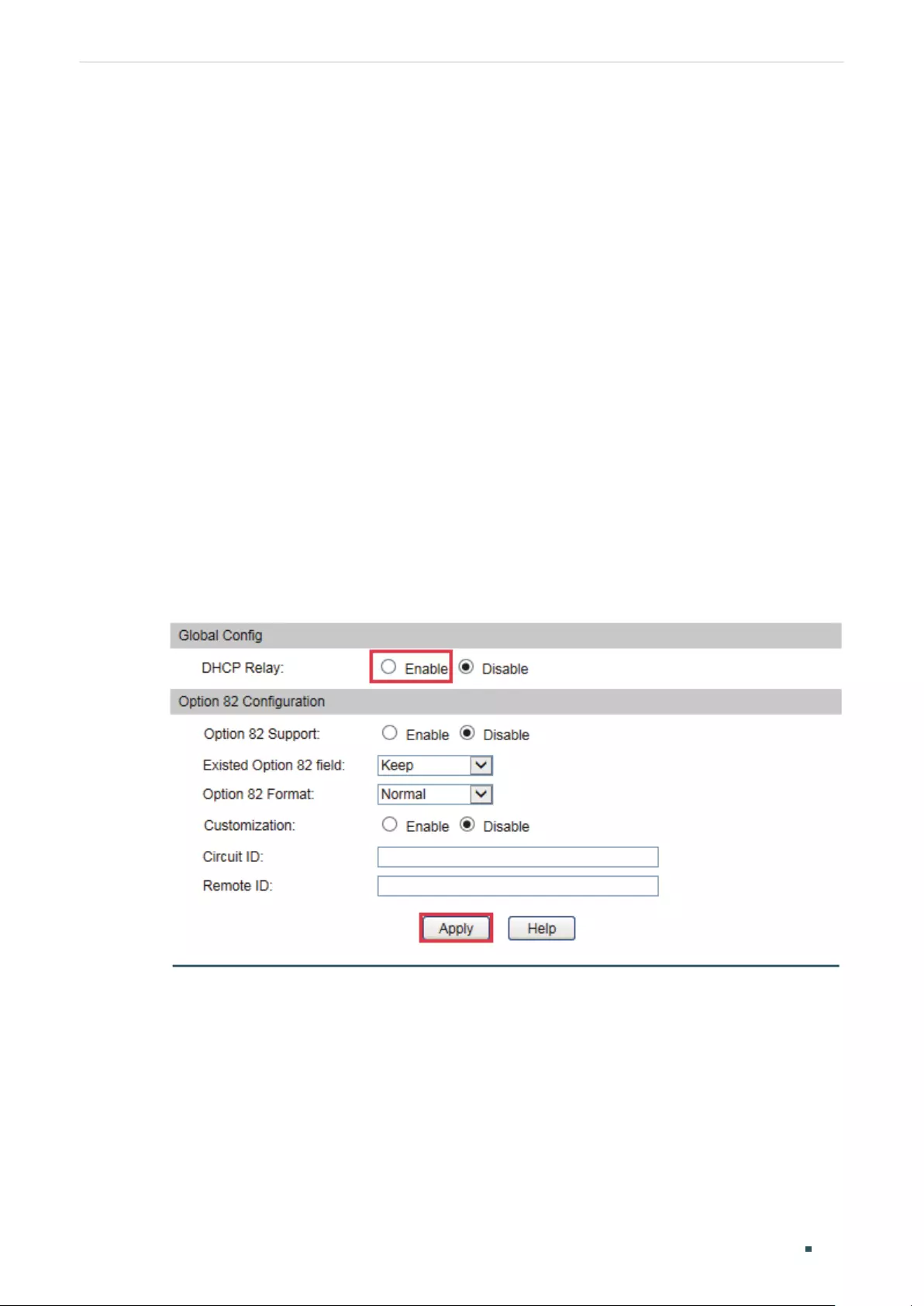
Configuration Guide 572
Configuring DHCP Configuration Examples
routes or enable dynamic routing protocol like RIP on the DHCP server to make sure the
DHCP server can reach these two networks.
2) Configure 802.1Q VLAN. Add all computers in the marketing department to VLAN
10, and add all computers in the R&D department to VLAN 20. For details, refer to
Configuring 802.1Q VLAN.
3) Configure the interface address of the VLANs. For details, refer to Configuring Logical
Interfaces.
4) Configure DHCP Relay on the switch. Enable DHCP Relay, and add DHCP server address
to each VLAN. When these configurations are finished, the DHCP server can assign IP
addresses to computers in the two departments, with each department on one subnet.
Demonstrated with T2600G-28TS, this chapter provides configuration procedures in two
ways: using the GUI and using the CLI.
5.2.3 Using the GUI
Follow these steps to configure DHCP Relay:
1) Choose the menu Routing > DHCP Relay > Global Config to load the following page. In
the Global Config section, enable DHCP Relay, and click Apply.
Figure 5-1 Enable DHCP Relay
2) Choose the menu Routing > DHCP Relay > DHCP Interface Relay to load the following
page. In the Add DHCP Server Address section, add the DHCP server address to VLAN
10 and VLAN 20.

Configuring DHCP Configuration Examples
Configuration Guide 573
Figure 5-2 Specify DHCP Server for Interface VLAN 10
Figure 5-3 Specify DHCP Server for Interface VLAN 20
3) Click Save Config to save the settings.
5.2.4 Using the CLI
Follow these steps to configure DHCP Interface Relay:
1) Enable DHCP Relay.
Switch#configure
Switch(config)#service dhcp relay
2) Specify the DHCP server for the interface VLAN 10.
Switch(config)#interface vlan 10
Switch(config-if)#ip helper-address 192.168.0.59
Switch(config-if)#exit
3) Specify the DHCP server for interface VLAN 20
Switch(config)#interface vlan 20
Switch(config-if)#ip helper-address 192.168.0.59
Switch(config-if)#end
Switch#copy running-config startup-config
Verify the Configurations
Switch#show ip dhcp relay

Configuration Guide 574
Configuring DHCP Configuration Examples
DHCP relay is enabled
...
DHCP relay helper address is configured on the following interfaces:
Interface Helper address
VLAN10 192.168.0.59
VLAN20 192.168.0.59
...

Configuring DHCP Appendix: Default Parameters
Configuration Guide 575
6 Appendix: Default Parameters
Default settings of DHCP Server are listed in the following table.
Table 6-1 Default Settings of DHCP Server
Parameter Default Setting
Global Config
DHCP Server Disable
Option 60 None
Option 138 None
Ping Time Config
Ping Packets 1
Ping Timeout 100 ms
Excluded IP Address
Start IP Address None
End IP Address None
Pool Setting
Pool Name None
Network Address None
Subnet Mask None
Lease Time 120 min
Default Gateway None
DNS Server None
Netbios Server None
Netbios Node Type None
Next Server Address None
Domain Name None
Bootfile None

Configuration Guide 576
Configuring DHCP Appendix: Default Parameters
Parameter Default Setting
Manual Binding
Pool Name None
IP Address None
Binding Mode Client Id
Client Id None
Hardware Address None
Hardware Type Ethernet
Default settings of DHCP Relay are listed in the following table.
Table 6-2 Default Settings of DHCP Relay
Parameter Default Setting
DHCP Relay
DHCP Relay Disable
Option 82 Support Disable
Existed Option 82 field Keep
Option 82 Format Normal
Customization Disable
Circuit ID None
Remote ID None
DHCP Interface Relay
Interface ID None
Server Address None
DHCP VLAN Relay
Interface ID None
VLAN ID None
Server Address None

Configuring DHCP Appendix: Default Parameters
Configuration Guide 577
Default setting of DHCP Client is listed in the following table.
Table 6-3 Default Setting of DHCP Client
Parameter Default Setting
DHCP Client Disable

Configuration Guide 578
Configuring DHCP

Configuration Guide 580
Configuring ARP Overview
1 Overview
ARP (Address Resolution Protocol) is used to map IP addresses to MAC addresses. Taking
an IP address as input, ARP learns the associated MAC address, and stores the IP-MAC
address association in an ARP entry for rapid retrieval.

Configuring ARP ARP Configurations
Configuration Guide 581
2 ARP Configurations
With ARP configurations, you can:
View dynamic and static ARP entries.
Add or delete static ARP entries.
2.1 Using the GUI
2.1.1 Viewing the ARP Entries
The ARP table consists of two kinds of ARP entries: dynamic and static.
Dynamic Entry: Automatically learned and will be deleted after aging time.
Static Entry: Added manually and will be remained unless modified or deleted manually.
Choose the menu Routing > ARP > ARP Table to load the following page.
Figure 2-1 Viewing the ARP Entries
Interface Displays the network interface of an ARP entry.
IP Address Displays the IP address of an ARP entry.
MAC Address Displays the MAC address of an ARP entry.
Type Displays the type of an ARP entry.
STATIC: A static ARP entry that will always be remained.
DYNAMIC: A dynamic ARP entry that will be deleted after aging time.

Configuration Guide 582
Configuring ARP ARP Configurations
2.1.2 Adding Static ARP Entries Manually
You can add desired static ARP entries by mannually specifying the IP addresses and MAC
addresses.
Choose the menu Routing > ARP > Static ARP to load the following page.
Figure 2-2 Adding Static ARP Entries
Follow these steps to add static ARP Entries:
In the ARP Config section, enter the IP address and MAC address and click Create.
IP address Specify the IP address.
MAC address Specify the MAC address.
2.2 Using the CLI
2.2.1 Configuring ARP Function
Adding Static ARP Entries
Follow these steps to add ARP entries:
Step 1 configure
Enter global configuration mode.
Step 2 arp
ip mac type
Add a static ARP entry.
ip
: Enter the IP address of the static ARP entry.
mac:
Enter the MAC address of the static ARP entry.
type:
Enter the ARP type. Configure it as 'arpa'.

Configuring ARP ARP Configurations
Configuration Guide 583
Step 3 show arp [
ip
] [
mac
]
or
show ip arp [
ip
] [
mac
]
Verify the ARP entries.
ip
: Specify the IP address of your desired ARP entry.
mac:
Specify the MAC address of your desired ARP entry.
Step 4 end
Return to privileged EXEC mode.
Step 5 copy running-config startup-config
Save the settings in the configuration file.
This example shows how to create a static ARP entry with the IP as 192.168.0.1 and the
MAC as 00:11:22:33:44:55:
Switch#configure
Switch(config)#arp 192.168.0.1 00:11:22:33:44:55 arpa
Switch(config)#show arp 192.168.0.1
Interface Address Hardware Addr Type
Vlan1 192.168.0.1 00:11:22:33:44:55 STATIC
Switch(config)#end
Switch#copy running-config startup-config
Configuring the aging time of dynamic ARP entries
Follow these steps to configure the aging time of dynamic ARP entries:
Step 1 configure
Enter global configuration mode.
Step 2 interface {fastEthernet
port
| range fastEthernet
port-list
| gigabitEthernet
port
| range
gigabitEthernet
port-list
]
Enter interface configuration mode.
port| port-list
: The number or the list of the Ethernet port that you want to configure.
interface vlan
vlan-id
Enter interafce VLAN mode.
vlan-id:
Specify a vlan interface ID.

Configuration Guide 584
Configuring ARP ARP Configurations
Step 3 arp timeout
timeout
Configure the ARP aging time of the VLAN interface or routed port .
timeout:
Specify the value of aging time, which ranges from 1 to 3000 in seconds. The default value is
600 seconds.
Step 4 end
Return to privileged EXEC mode.
Step 5 copy running-config startup-config
Save the settings in the configuration file.
This example shows how to configure the aging time of dynamic ARP entries as 1000
seconds for VLAN interface 2 :
Switch#configure
Switch(config)#interface vlan 2
Switch(config-if)#arp timeout 1000
Switch(config-if)#end
Switch#copy running-config startup-config
Clearing dynamic entries
Step 1 end
Return to privileged EXEC mode.
Step 2 clear arp-cache
Clear all the dynamic ARP entries.
Step 3 copy running-config startup-config
Save the settings in the configuration file.
Viewing ARP Entries
On privileged EXEC mode or any other configuration mode, you can use the following
command to view ARP entries:
show arp [
ip
] [
mac
]
or
show ip arp [
ip
] [
mac
]
Verify the active ARP entries.
ip:
Specify the IP address of your desired ARP entry.
mac:
Specify the MAC address of your desired ARP entry.

Configuring ARP ARP Configurations
Configuration Guide 585
show ip arp { gigabitEthernet
port
| port-channel
lagid
| vlan
id
}
Verify the active ARP entries associated with a Layer 3 interface.
port:
Specify the number of the routed port.
lagid:
Specify the ID of the LAG.
id:
Specify the VLAN interface ID.

Configuring QoS QoS
Configuration Guide 587
1 QoS
1.1 Overview
With network scale expanding and applications developing, Internet traffic is dramatically
increased, thus resulting in network congestion, packet drops and long transmission
delay. Typically, networks treat all traffic equally on FIFO (First In First Out) delivery basis,
but nowadays many special applications like VoD, video conferences, etc. require more
bandwidth or shorter transmission delay to guarantee the performance.
With QoS (Quality of Service) technology, you can classify and prioritize network traffic to
provide DiffServ (Differentiated Services) to certain types of traffic.
1.2 Supported Features
You can configure the DiffServ and bandwidth control features on the switch to maximize
the network performance and bandwidth utilization.
DiffServ
The switch classifies the ingress packets, maps the packets to different priority queues
and then forwards the packets according to specified scheduling algorithms to implement
QoS function.
Priority Mode: Three modes are supported, Port Priority, 802.1P Priority and DSCP
Priority.
Schedule Mode: Four schedule modes are supported, SP, WRR, SP+WRR and Equ.
Bandwidth Control
Bandwidth Control functions to control the traffic rate and broadcast flow on each port to
ensure network performance.
Rate limit functions to limit the ingress/egress traffic rate on each port. In this way, the
network bandwidth can be reasonably distributed and utilized.
Storm Control function allows the switch to filter broadcast packets, multicast packets
and UL-frames (Unknown unicast frames) in the network. If the transmission rate of
the packets exceeds the set rate, the packets will be automatically discarded to avoid
network broadcast storm.

Configuration Guide 588
Configuring QoS DiffServ Configuration
2 DiffServ Configuration
To complete differentiated services configuration, follow these steps:
1) Configure the priority mode to classify packets with different priorities.
2) Configure the schedule mode to control the forwarding sequence of packets.
Configuration Guidelines
Deploy the priority mode appropriate to your network requirements.
Three modes are supported on the switch, 802.1P Priority, DSCP Priority and Port
Priority.
»802.1P Priority
802.1P defines the first three bits in 802.1Q Tag as PRI field. The PRI values are from 0
to 7. 802.1P priority determines the priority of packets based on the PRI value.
In this mode, the switch only prioritizes packets with VLAN tag, regardless of the IP
header of the packets.
» DSCP Priority
DSCP priority determines the priority of packets based on the ToS (Type of Service)
field in their IP header. RFC2474 re-defines the ToS field in the IP packet header as DS
field. The first six bits (bit 0-bit 5) of the DS field is used to represent DSCP priority. The
DSCP values are from 0 to 63.
In this mode, the switch only prioritizes IP packets.
» Port Priority
In this mode, the switch prioritizes packets according to their ingress ports, regardless
of the packet field or type.
The switch implements the priority mode in the following sequence when two or more
modes are enabled.
Implementing sequence: DSCP Priority > 802.1P Priority > Port Priority
If all the three priority modes are enabled, the switch will distinguish the received
packets and map the packets to different priority queues. IP packets are mapped based
on DSCP priority mode, non-IP packets with 802.1Q tag are mapped based on 802.1P
priority mode, and the untagged non-IP packets are mapped based on port priority
mode.
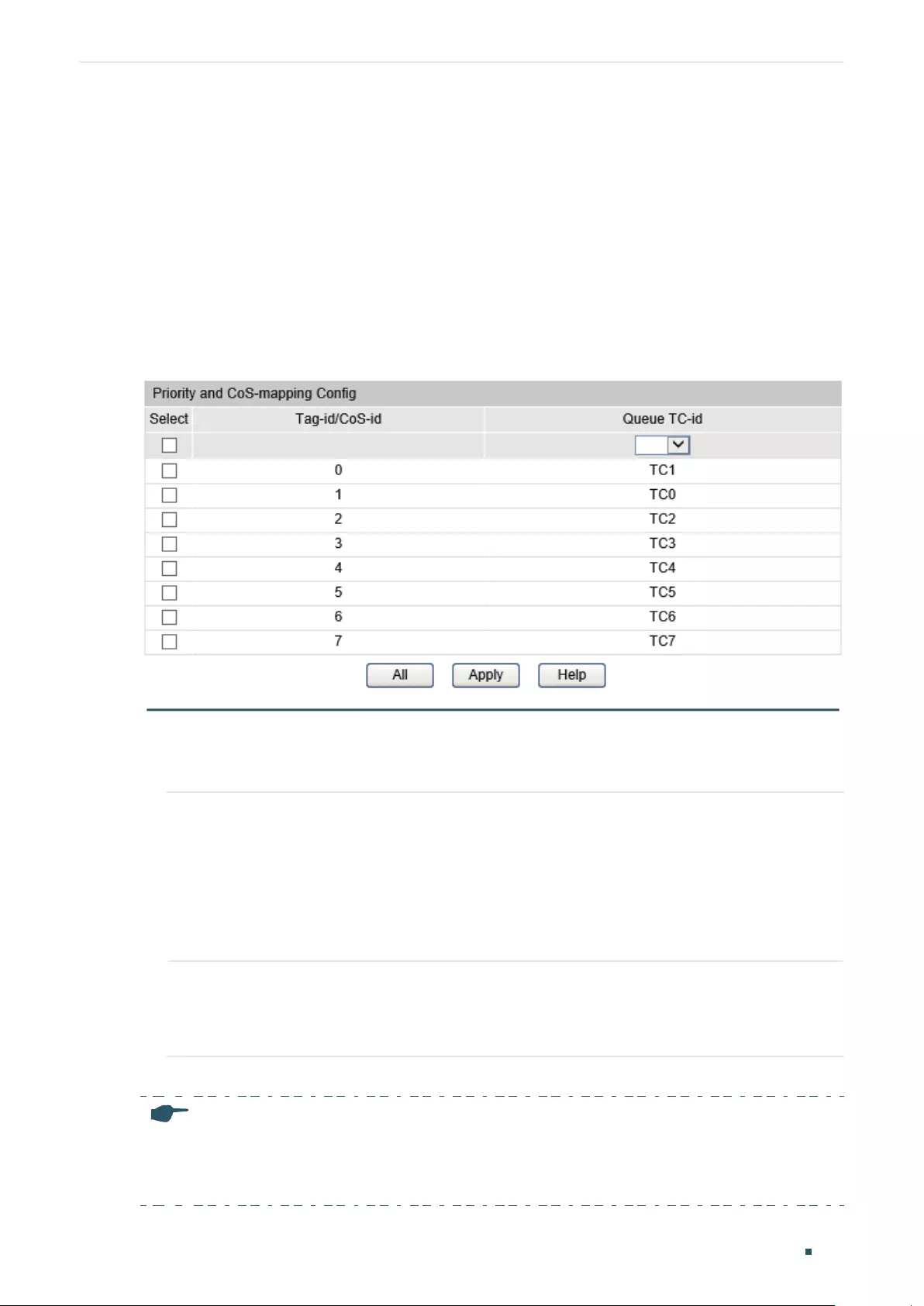
Configuring QoS DiffServ Configuration
Configuration Guide 589
2.1 Using the GUI
2.1.1 Configuring Priority Mode
The instructions of the three priority modes are described respectively in this section.
Configuring 802.1P Priority
Choose the menu QoS > DiffServ > 802.1P Priority to load the following page.
Figure 2-1 802.1P/CoS Mapping
Follow these steps to configure the 802.1P Priority:
1) Configure the Tag-id/CoS-id-TC mapping relations.
Tag-id/CoS-id Select the desired Tag-id/CoS-id to configure.
Tag-id indicates the PRI field in 802.1Q tag. It comprises 3 bits and the valid values
are from 0 to 7.
CoS-id is a value for the switch to establish mapping relations between the
priorities and TC queues. The valid values are from 0 to 7 and correspond to the
802.1P priority levels.
TC-id Select a TC queue that you want the Tag-id or CoS-id to be mapped to.
The switch supports 8 TC queues, from TC0 for the lowest priority to TC 7 for the
highest priority.
2) Click Apply.
Note:
For T2600G-18TS, the 802.1P priority feature is disabled by default. You can manually enable it.
For other T2600G series switches, the 802.1P priority feature is enabled by default and cannot be
disabled.

Configuration Guide 590
Configuring QoS DiffServ Configuration
Configuring DSCP Priority
Note:
In DSCP priority mode, the packets are firstly mapped to CoS, then to TC queues according to the
CoS-id-TC mapping relations. Go to QoS > DiffServ > 802.1P Priority and check the CoS-id-TC
mapping relations before configuring DSCP priority.
For T2600G-18TS, the packets are directly mapped to TC queues in DSCP priority mode.
Choose the menu QoS > DiffServ > DSCP Priority to load the following page.
Figure 2-2 DSCP Mapping
Follow these steps to configure the DSCP priority:
1) Enable DSCP Priority and click Apply. DSCP Priority is disabled by default.
2) Configure the DSCP-TC mapping relations.
DSCP Select the desired DSCP priority.
DSCP priority represents the DSCP field in the IP packet header. It comprises 6
bits and the valid values are from 0 to 63.
Note:
The DSCP priority displayed on this page may indicate the DSCP value included in
the packets or the redefined DSCP value by the ACL Remark feature.
Priority Select a CoS that the DSCP priority will be mapped to.
The packets are firstly mapped to CoS, then to TC queues according to the CoS-
id-TC mapping relations.
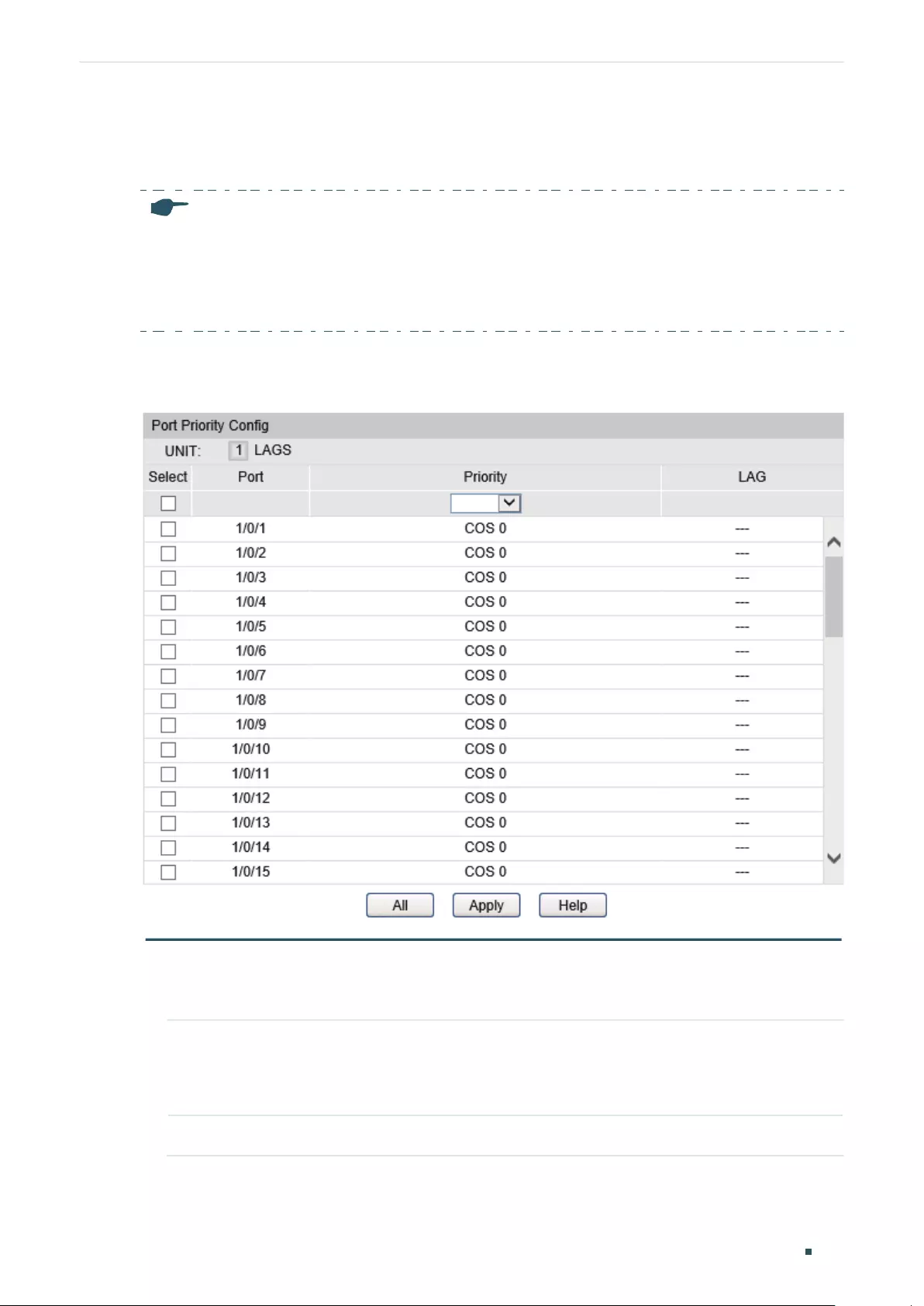
Configuring QoS DiffServ Configuration
Configuration Guide 591
3) Click Apply.
Configuring Port Priority
Note:
In port priority mode, the packets are firstly mapped to CoS, then to TC queues according to the
CoS-id-TC mapping relations. Go to QoS > DiffServ > 802.1P Priority and check the CoS-id-TC
mapping relations before configuring port priority.
For T2600G-18TS, the packets are directly mapped to TC queues in port priority mode.
Choose the menu QoS > DiffServ > Port Priority to load the following page.
Figure 2-3 Port Priority
Follow these steps to configure the port priority:
1) Select the desired port or LAG to set its priority.
Priority Specify the CoS that the port will be mapped to.
The packets are firstly mapped to CoS, then to TC queues according to the CoS-
id-TC mapping relations.
LAG Displays the aggregation group which the port is in.
2) Click Apply.

Configuration Guide 592
Configuring QoS DiffServ Configuration
Note:
All the ports in the same LAG should be assigned with the same port priority.
2.1.2 Configuring Schedule Mode
Configure the schedule mode to control the forwarding sequence of different TC queues
when congestion occurs.
Choose the menu QoS > DiffServ > Schedule Mode to load the following page.
Figure 2-4 Schedule Mode
Follow these steps to configure the schedule mode:
1) Select a schedule mode.
SP-Mode Strict-Priority Mode. In this mode, the queue with higher priority will occupy the
whole bandwidth. Packets in the queue with lower priority are sent only when the
queue with higher priority is empty.
WRR-Mode Weight Round Robin Mode. In this mode, packets in all the queues are sent in
order based on the weight value for each queue. By default, the weight value ratio
of TC0 to TC7 is 1:2:4: ... :127.
SP+WRR-Mode Strict-Priority + Weight Round Robin Mode. In this mode, the switch provides two
scheduling groups, SP group and WRR group.
When scheduling queues, the switch allows the queues in the SP group to occupy
the whole bandwidth following the SP mode. When the SP group is empty, the
queues in the WRR group will take up the bandwidth according to their weight
value ratio. By default, queue TC7 is in SP group and TC0, TC1...TC6 are in WRR
group.
Equ-Mode Equal-Mode. In this mode, all the queues occupy the bandwidth equally. The
weight value ratio of all the queues is 1:1:1:1. Equ-Mode is selected by default.

Configuring QoS DiffServ Configuration
Configuration Guide 593
2) (Optional) Configure the weight value of the each TC queue if the schedule mode is
WRR of SP+WRR.
Queue Weight Configure the weight value of the each TC queue.
In WRR mode, the 8 queues will take up the bandwidth according to their ratio.
The default values of TC0, TC1, TC2, TC3, TC4, TC5,TC6 and TC7 are 1, 2, 4, 8, 16,
32, 64 and 127 respectively.
In SP+WRR mode, TC7 and the queue with its weight value set as 0 are in the
SP group; other queues, with none-zero weight value, belong to the WRR group.
In this SP+WRR scheduling mode, the queues in the SP group is scheduled
preferentially (TC7>TC6>TC5>TC4>TC3>TC2>TC1>TC0 in strict priority). When
there is no packets to be sent in the SP group, the queues in the WRR group will
be scheduled according to the weight value of each queue. The default weight
values of TC0, TC1, TC2, TC3, TC4, TC5 and TC6 are 1, 2, 4, 8, 16, 32 and 64
respectively, while the value of TC7 is 0 and non-configurable.
3) Click Apply.
Note:
With ACL Redirect feature, the switch maps all the packets that meet the configured ACL rules to
the new TC queue, regardless of the mapping relations configured in this section.
2.2 Using CLI
2.2.1 Configuring Priority Mode
The instructions of the three priority modes are described respectively in this section.
Configuring 802.1 Priority
Note:
The 802.1P priority feature is disabled on T2600G-18TS by default. You can manually enable it. On
other T2600G series switches, this feature is enabled by default and cannot be disabled.
Step 1 configure
Enter global configuration mode
Step 2 qos cos
Enable the 802.1P priority. The 802.1P priority feature is disabled on T2600G-18TS by default.
You can manually enable it with this command. On the other T2600G series switches, this
feature is enabled by default and cannot be disabled.

Configuration Guide 594
Configuring QoS DiffServ Configuration
Step 3 qos queue cos-map {
tag-id
/
cos-id
} {
tc-id
}
Configure the Tag-id-TC queues mapping relations or the CoS-id-TC mapping relations.
tag-id:
Specify the Tag-ID. The valid values are from 0 to 7.
cos-id
: Specify the CoS-ID. The valid values are from 0 to 7.
tc-id
: Specify the TC-ID. The valid values are from 0 to 7.
Step 4 show qos status
Verify that 802.1P priority is enabled.
show qos cos-map
Verify the mapping relations between the Tag-id / CoS-id and TC queues.
Step 5 end
Return to privileged EXEC mode.
Step 6 copy running-config startup-config
Save the settings in the configuration file.
The following example shows how to map CoS2 to TC0, and keep other CoS-id-TC as
default:
Switch#configure
Switch(config)#qos queue cos-map 2 0
Switch(config)#show qos status
802.1p priority is enabled.
DSCP priority is disabled.
Switch(config)#show qos cos-map
-----+-----+-----+-----+-----+-----+-----+----+----
Tag |0 |1 |2 |3 |4 |5 |6 |7
-----+-----+-----+-----+-----+-----+-----+----+----
TC |TC1 |TC0 |TC0 |TC3 |TC4 |TC5 |TC6 |TC7
-----+-----+-----+-----+-----+-----+-----+----+----
Switch(config)#end
Switch#copy running-config startup-config

Configuring QoS DiffServ Configuration
Configuration Guide 595
Configuring DSCP Priority
Step 1 configure
Enter global configuration mode.
Step 2 qos dscp
Enable DSCP Priority.
Step 3 show qos cos-map
Check the CoS-id-TC mapping relations.
Step 4 For T2600G-18TS:
qos queue dscp-map {
dscp-list
} {
tc-id
}
Configure the mapping relations between the DSCP values in the IP header and the TC queues.
dscp-list:
Enter one or more DSCP values which range from 0 to 63. Enter the multiple values in
the format of “1-3,5,7”.
tc-id:
Specify the TC-ID. The valid values are from 0 to 7.
For other switches:
qos queue dscp-map {
dscp-list
} {
cos-id
}
Configure the mapping relations between the DSCP values in the IP header and the CoS
values. The packets are firstly mapped to CoS, then to TC queues according to the CoS-id-TC
mapping relations.
dscp-list:
Enter one or more DSCP values which range from 0 to 63. Enter the multiple values in
the format of "1-3,5,7".
cos-id:
Specify the CoS-id. The valid values are from 0 to 7.
Step 5 show qos status
Verify that DSCP priority is enabled.
show qos dscp-map
Verify the DSCP-TC mapping relations.
Step 6 end
Return to privileged EXEC mode.
Step 7 copy running-config startup-config
Save the settings in the configuration file.
The following example shows how to map DSCP values 10-14 to TC1, and keep other
mapping relations as default:
Switch#configure

Configuration Guide 596
Configuring QoS DiffServ Configuration
Switch(config)#show qos cos-map
-----+-----+-----+-----+-----+-----+-----+----+----
Tag |0 |1 |2 |3 |4 |5 |6 |7
-----+-----+-----+-----+-----+-----+-----+----+----
TC |TC1 |TC0 |TC0 |TC3 |TC4 |TC5 |TC6 |TC7
-----+-----+-----+-----+-----+-----+-----+----+----
Switch(config)#qos queue dscp-map 10-14 0
Switch(config)#show qos status
802.1p priority is disabled.
DSCP priority is enabled.
Switch(config)#show qos dscp-map
...
----------------------------------------------------------------------------------
DSCP 8 9 10 11 12 13 14 15
CoS CoS1 CoS1 CoS0 CoS0 CoS0 CoS0 CoS0 CoS1
----------------------------------------------------------------------------------
...
Switch(config)#end
Switch#copy running-config startup-config
Configuring Port Priority
Select the desired port to set the priority. Packets from this ingress port are mapped to the
TC queue based on port priority.
Step 1 configure
Enter global configuration mode.
Step 2 interface {fastEthernet
port
| range fastEthernet
port-list
| gigabitEthernet
port
| range
gigabitEthernet
port-list
| port-channel
lagid
| range port-channel
laglist
}
Enter interface configuration mode.
Step 3 show qos cos-map
Check the CoS-id-TC mapping relations.

Configuring QoS DiffServ Configuration
Configuration Guide 597
Step 4 For T2600G-18TS:
qos
tc-id
Configure the TC queue of the port.
tc-id:
Specify the TC-ID. The valid values are from 0 to 7.
For other switches:
qos
cos-id
Configure the CoS value of the port. The packets are firstly mapped to CoS, then to TC queues
according to the CoS-id-TC mapping relations.
cos-id:
Configure the CoS-id value. The valid values are from 0 to 7.
Step 5 show qos interface [fastEthernet
port-list
|
gigabitEthernet
port-list
] [port-channel
lagid-list
]
Verify the CoS value of the port. If no port is specified, it displays the CoS values of all ports.
port-list:
The list of Ethernet ports.
lagid-list:
The list of LAGs.
Step 6 end
Return to privileged EXEC mode.
Step 7 copy running-config startup-config
Save the settings in the configuration file.
Note:
All the ports in the same LAG should be assigned with the same port priority.
The following example shows how to map port 1-3 to TC1, and keep other mapping
relations as default:
Switch#configure
Switch(config)#show qos cos-map
-----+-----+-----+----+-----+-----+-----+----+----
Tag |0 |1 |2 |3 |4 |5 |6 |7
-----+-----+-----+----+-----+-----+-----+----+----
TC |TC1 |TC0 |TC2 |TC3 |TC4 |TC5 |TC6 |TC7
-----+-----+-----+----+-----+-----+-----+----+----

Configuration Guide 598
Configuring QoS DiffServ Configuration
Switch(config)#interface range gigabitEthernet 1/0/1-3
Switch(config-if-range)#qos 0
Switch(config-if-range)#show qos interface gigabitEthernet 1/0/1-3
Port CoS Value LAG
---------- --------------- ------------
Gi1/0/1 CoS 0 N/A
Gi1/0/2 CoS 0 N/A
Gi1/0/3 CoS 0 N/A
Switch(config-if-range)#end
Switch#copy running-config startup-config
2.2.2 Configuring Schedule Mode
Follow these steps to configure the schedule mode to control the forwarding sequence of
different TC queues when congestion occurs.
Step 1 configure
Enter global configuration mode.
Step 2 qos queue mode {sp | wrr | spwrr | equ}
Configure the schedule mode of TC queues.
sp: The Strick Priority mode. In SP mode, the queue with higher priority will occupy the whole
bandwidth. Packets in the queue with lower priority are sent only when the queue with higher
priority is empty.
wrr: In WRR mode, packets in all the queues are sent in order based on the weight value for
each queue. By default, the weight value ratio of TC0 to TC7 is 1:2:4:...:127.
spwrr: In SP+WRR mode, this switch provides two scheduling groups, SP group and WRR
group. When scheduling queues, the switch allows the queues in the SP group to occupy the
whole bandwidth following the SP mode. When the SP group is empty, the queues in the WRR
group will take up the bandwidth according to their weight value ratio. By default, queue TC7 is
in SP and TC0, TC1...TC6 are in WRR group.
equ: In Equ mode, all the queues occupy the bandwidth equally. The weight value ratio of all the
queues is 1:1:1:1. It is the default schedule mode.

Configuring QoS DiffServ Configuration
Configuration Guide 599
Step 3 qos queue weight { tc-id } { weight-value }
(Optional) Configure the weight value of each queue after the Schedule Mode is specified as
WRR or SP+WRR.
tc-id:
Specify the TC-ID. The valid values are from 0 to 7.
weight-value:
Configure the weight value of the specified TC queue.
When the schedule mode is specified as WRR, the valid weight value are from 1 to 127. The 8
queues will take up the bandwidth according to their ratio. The default values of TC0, TC1, TC2,
TC3, TC4, TC5,TC6 and TC7 are 1, 2, 4, 8, 16, 32, 64 and 127 respectively.
When the schedule mode is specified as SP+WRR, The valid weight values are from 0 to 127.
TC7 and the queue with its weight value set as 0 are in the SP group; other queues, with none-
zero weight value, belong to the WRR group. In this SP+WRR scheduling mode, the queues in
the SP group is scheduled preferentially (TC6>TC5>TC4>TC3>TC2>TC1>TC0 in strict priority).
When there is no packets to be sent in the SP group, the queues in the WRR group will be
scheduled according to the weight value of each queue. The default weight values of TC0, TC1,
TC2, TC3, TC4, TC5 and TC6 are 1, 2, 4, 8, 16, 32 and 64 respectively, while the value of TC7 is
0 and non-configurable.
Step 4 show qos queue mode
Verify the schedule mode configurations.
Step 5 end
Return to privileged EXEC mode.
Step 6 copy running-config startup-config
Save the settings in the configuration file.
Note:
With ACL Redirect feature, the switch maps all the packets that meet the configured ACL rules to
the new TC queue, regardless of the mapping relations configured in this section.
The following example shows how to configure the schedule mode as WRR, with the weight
values of TC0 to TC7 as 4, 7, 10, 13,16,19,22,25:
Switch#configure
Switch(config)#qos queue mode wrr
Switch(config)#qos queue weight 0 4
Switch(config)#qos queue weight 1 7
Switch(config)#qos queue weight 2 10
Switch(config)#qos queue weight 3 13
Switch(config)#qos queue weight 4 16
Switch(config)#qos queue weight 5 19
Switch(config)#qos queue weight 6 22

Configuration Guide 600
Configuring QoS DiffServ Configuration
Switch(config)#qos queue weight 7 25
Switch(config)#show qos queue mode
---------------------+--------------------------------------------------------------------------
Schedule Mode: WRR | Weight: TC0=4 TC1=7 TC2=10 TC3=13 TC4=16 TC5=19
TC6=22 TC7=25
---------------------+--------------------------------------------------------------------------
Switch(config)#end
Switch#copy running-config startup-config

Configuring QoS Bandwidth Control Configuration
Configuration Guide 601
3 Bandwidth Control Configuration
To implement bandwidth control, you can:
Limit the ingress/egress traffic rate on each port by configuring the Rate Limit function;
Limit the broadcast, multicast and UL frame forwarding rate on each port to avoid
network broadcast storm by configuring the Storm Control function.
3.1 Using the GUI
3.1.1 Configuring Rate Limit
Choose the menu QoS > Bandwidth Control > Rate Limit to load the following page.
Figure 3-1 Rate Limit
Follow these steps to configure the Rate Limit function:
1) Configure the upper rate limit for the port to receive and send packets.
Ingress Rate (1-
1000000Kbps)
Configure the upper rate limit for receiving packets on the port. The valid values
are from 1 to 1000000 Kbps.
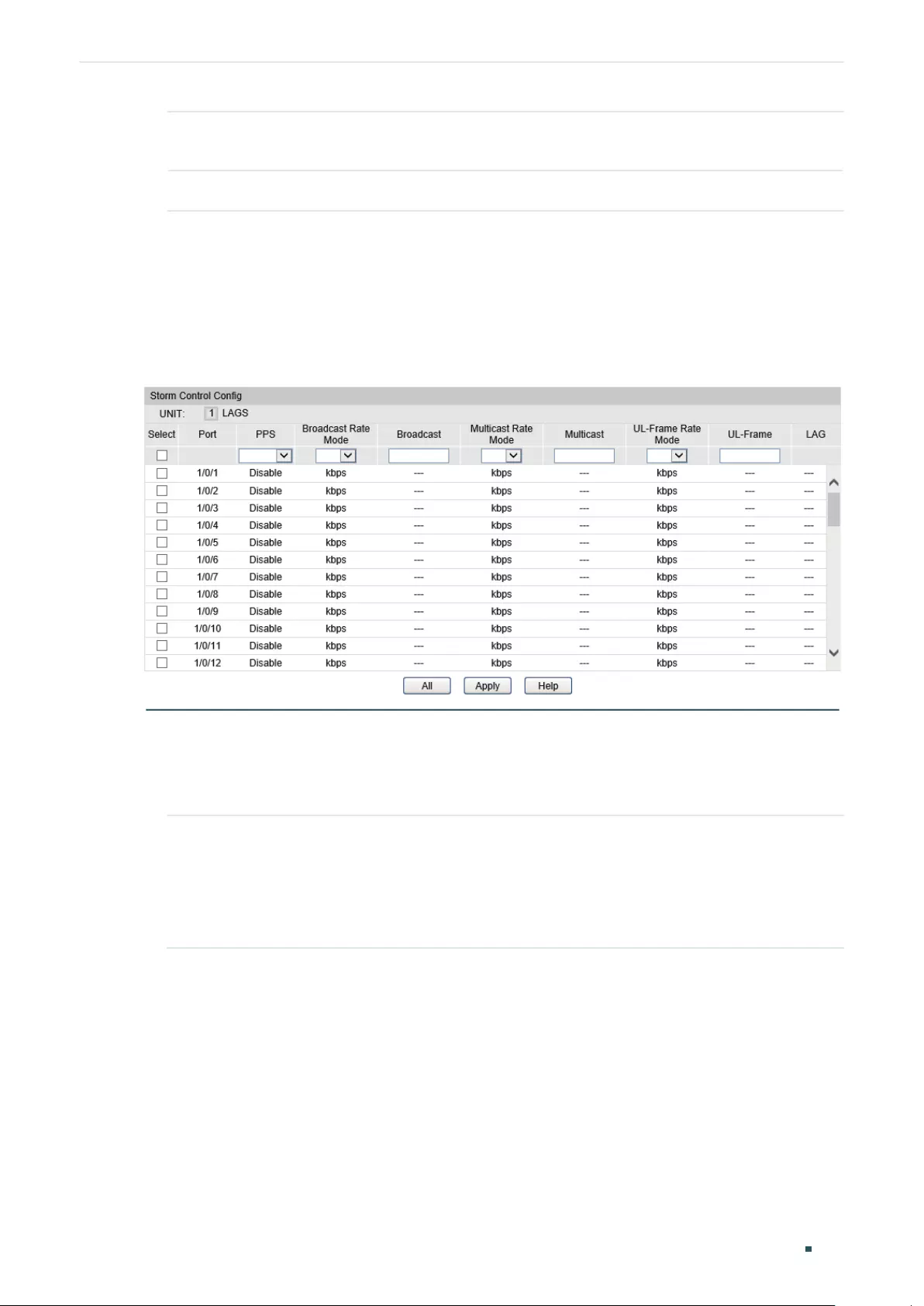
Configuration Guide 602
Configuring QoS Bandwidth Control Configuration
Egress Rate (1-
1000000Kbps)
Configure the bandwidth for sending packets on the port. The valid values are
from 1 to 1000000 Kbps.
LAG Displays the aggregation group which the port is in.
2) Click Apply.
3.1.2 Configuring Storm Control
Choose the menu QoS > Bandwidth Control > Storm Control to load the following page.
Figure 3-2 Storm Control
Follow these steps to configure the Storm Control function:
1) Select the port(s) and configure the upper rate limit for forwarding broadcast packets,
multicast packets and UL frames.
PPS Enable or disable the PPS (Packets Per Second) mode on the port.
With PPS enabled, the upper rate limit of the broadcast, multicast and UL-frame
can only be specified in packets per second. With PPS disabled, the upper rate
limit of the broadcast, multicast and UL-frame cannot be specified in packets per
second.

Configuring QoS Bandwidth Control Configuration
Configuration Guide 603
Broadcast
Rate Mode /
Broadcast
To enable the broadcast rate control, select a broadcast rate mode and specify
the upper rate limit for receiving broadcast packets in the Broadcast field. The
packet traffic exceeding the rate will be discarded.
The switch supports the following three rate modes:
kbps: Specify the upper rate limit in kilo-bits per second, which ranges from 1 to
1000000 kbps. This mode is invalid if PPS is enabled.
ratio: Specify the upper rate limit as a percentage of the bandwidth, which ranges
from 1 to 100 percent. This mode is invalid if PPS is enabled.
pps: Specify the upper rate limit in packets per second, which ranges from 1 to
1488000 packets per second. This mode is invalid if PPS is disabled.
To disable the broadcast rate control, select Disable in the Broadcast field.
Multicast Rate
Mode / Multicast
To enable the multicast rate control, select a multicast rate mode and specify the
upper rate limit for receiving broadcast packets in the Multicast field. The packet
traffic exceeding the rate will be discarded.
The switch supports the following three rate modes:
kbps: Specify the upper rate limit in kilo-bits per second, which ranges from 1 to
1000000 kbps. This mode is invalid if PPS is enabled.
ratio: Specify the upper rate limit as a percentage of the bandwidth, which ranges
from 1 to 100 percent. This mode is invalid if PPS is enabled.
pps: Specify the upper rate limit in packets per second, which ranges from 1 to
1488000 packets per second. This mode is invalid if PPS is disabled.
To disable the multicast rate control, select Disable in the Multicast field.
UL-Frame Rate
Mode / UL-
Frame
To enable the UL-Frame (Unknown unicast frame) rate control, select a UL-Frame
rate mode and specify the upper rate limit for receiving UL-Frames in the UL-
Frame field. The packet traffic exceeding the rate will be discarded. The switch
supports the following three rate modes:
kbps: Specify the upper rate limit in kilo-bits per second, which ranges from 1 to
1000000 kbps. This mode is invalid if PPS is enabled.
ratio: Specify the upper rate limit as a percentage of the bandwidth, which ranges
from 1 to 100 percent. This mode is invalid if PPS is enabled.
pps: Specify the upper rate limit in packets per second, which ranges from 1 to
1488000 packets per second. This mode is invalid if PPS is disabled.
To disable the UL-Frame rate control, select Disable in the UL-Frame field.
LAG Displays the aggregation group which the port is in.
2) Click Apply.

Configuration Guide 604
Configuring QoS Bandwidth Control Configuration
Note:
• T2600G-18TS does not support the PPS related features.
• For ports in the same LAG, rate limit / storm control should be set to the same value to ensure
a successful port aggregation.
• For one port, you cannot enable the Storm Control and the Rate limit at the same time.
3.2 Using the CLI
3.2.1 Configuring Rate Limit on Port
Configure the upper rate limit for the port to receive and send packets.
Step 1 configure
Enter global configuration mode.
Step 2 interface {
fastEthernet
port
| range fastEthernet
port-list
| gigabitEthernet
port
| range
gigabitEthernet
port-list
| port-channel
lag-id
| range port-channel
lag-list
}
Enter interface configuration mode.
port |port-list
: The number or the list of the Ethernet port that you want to configure.
lag-id |lag-list:
The ID or the list of the LAG that you want to configure.
Step 3 bandwidth {[ingress
ingress-rate
] [egress
egress-rate
]}
Configure the upper rate limit for the port to receive and send packets.
ingress-rate:
Configure the upper rate limit for receiving packets on the port. The valid values
are from 1 to 1000000 Kbps.
egress-rate:
Configure the upper rate limit for sending packets on the port. The valid values are
from 1 to 1000000 Kbps.
Step 4 show bandwidth {interface [fastEthernet
port
| range fastEthernet
port-list
| gigabitEthernet
port
| range gigabitEthernet
port-list
| port-channel
lag-id
| range port-channel
lag-list
]}
Verify the ingress/egress rate limit for forwarding packets on the port or LAG. If no port or LAG
is specified, it displays the upper ingress/egress rate limit for all ports or LAGs.
Step 5 end
Return to privileged EXEC mode.
Step 6 copy running-config startup-config
Save the settings in the configuration file.
The following example shows how to configure the ingress-rate as 5120 Kbps and egress-
rate as 1024 Kbps for port 1/0/5:
Switch#configure
Switch(config)#interface gigabitEthernet 1/0/5

Configuring QoS Bandwidth Control Configuration
Configuration Guide 605
Switch(config-if)#bandwidth ingress 5120 egress 1024
Switch(config-if)#show bandwidth interface gigabitEthernet 1/0/5
Port IngressRate(Kbps) EgressRate(Kbps) LAG
--------- ---------------------- ---------------------- ------------
Gi1/0/5 5120 1024 N/A
Switch(config-if)#end
Switch#copy running-config startup-config
3.2.2 Configuring Storm Control
Configure the upper rate limit on the port for forwarding broadcast packets, multicast
packets and unknown unicast frames.
Step 1 configure
Enter global configuration mode
Step 2 interface {
fastEthernet
port
| range fastEthernet
port-list
| gigabitEthernet
port
| range
gigabitEthernet
port-list
| port-channel
lag-id
| range port-channel
lag-list
}
Enter interface configuration mode.
port |port-list
: The number or the list of the Ethernet port that you want to configure.
lag-id |lag-list:
The ID or the list of the LAG that you want to configure.

Configuration Guide 606
Configuring QoS Bandwidth Control Configuration
Step 3 Use the following commands to specify the upper rate limit of the broadcast packets, multicast
packets and unknown unicast frames in pps:
storm-control pps
Configure the storm control mode as pps (packets per second) on the port. In PPS mode, the
upper rate limit of the broadcast packets, multicast packets and unknown unicast frames can
only be specified in packets per second.
storm-control {broadcast | multicast | unicast} pps
rate
broadcast | multicast | unicast: Enable broadcast rate limit, multicast rate limit or unknown
unicast rate limit on the port.
rate:
Specify the upper rate limit for receiving broadcast packets, multicast packets and
unknown unicast frames on the port. The packet traffic exceeding the rate will be discarded.
The valid rate values are from 1 to 1488000 packets per second.
Use the following commands to specify the upper rate limit of the broadcast packets, multicast
packets and unknown unicast frames in kbps or ratio:
no storm-control pps
Ensure the pps mode is disabled on the port.
storm-control {broadcast | multicast | unicast} {kbps | ratio}
rate
broadcast | multicast | unicast: Enable broadcast packets rate limit, multicast packets rate limit
or unknown unicast frames rate limit on the port.
kbps: Configure the storm control mode as kbps. In this mode, the upper rate limit is specified
in kilo-bits per second.
ratio: Configure the storm control mode as ratio. In this mode, the upper rate limit is specified
as a percentage of the bandwidth.
rate:
Specify the upper rate limit for receiving broadcast packets, multicast packets and
unknown unicast frames on the port. The packet traffic exceeding the rate will be discarded.
For kbps, the valid rate values are from 1 to 1000000 kbps; for ratio, the valid rate values are
from 1 to 100 percent.
Step 4 show storm-control {interface [fastEthernet
port
| range fastEthernet
port-list
|
gigabitEthernet
port
| range gigabitEthernet
port-list
| port-channel
lag-id
| range port-
channel
lag-list
]}
Verify the storm control configurations of the port or LAG. If no port or LAG is specified, it
displays the storm control configuration for all ports or LAGs.
Step 5 end
Return to privileged EXEC mode.
Step 6 copy running-config startup-config
Save the settings in the configuration file.

Configuring QoS Bandwidth Control Configuration
Configuration Guide 607
Note:
• T2600G-18TS does not support the PPS related features.
The following example shows how to configure the upper rate limit of broadcast packets as
148800 pps on port 1/0/5:
Switch#configure
Switch(config)#interface gigabitEthernet 1/0/5
Switch(config-if)#storm-control pps
Switch(config-if)#storm-control broadcast pps 148800
Switch(config-if)#show storm-control interface gigabitEthernet 1/0/5
Port BcRate Mcate UlRate LAG
--------- ---------------- -------------- -------------- -------------
Gi1/0/5 pps 148800 pps 0 pps 0 N/A
Switch(config-if)#end
Switch#copy running-config startup-config
The following example shows how to configure the upper rate limit of broadcast packets as
10240 kbps on port 1/0/5:
Switch#configure
Switch(config)#interface gigabitEthernet 1/0/5
Switch(config-if)#no storm-control pps
Switch(config-if)#storm-control broadcast kbps 10240
Switch(config-if)#show storm-control interface gigabitEthernet 1/0/5
Port BcRate Mcate UlRate LAG
--------- ---------------- -------------- -------------- -------------
Gi1/0/5 kbps 10240 kbps 0 kbps 0 N/A
Switch(config-if)#end
Switch#copy running-config startup-config
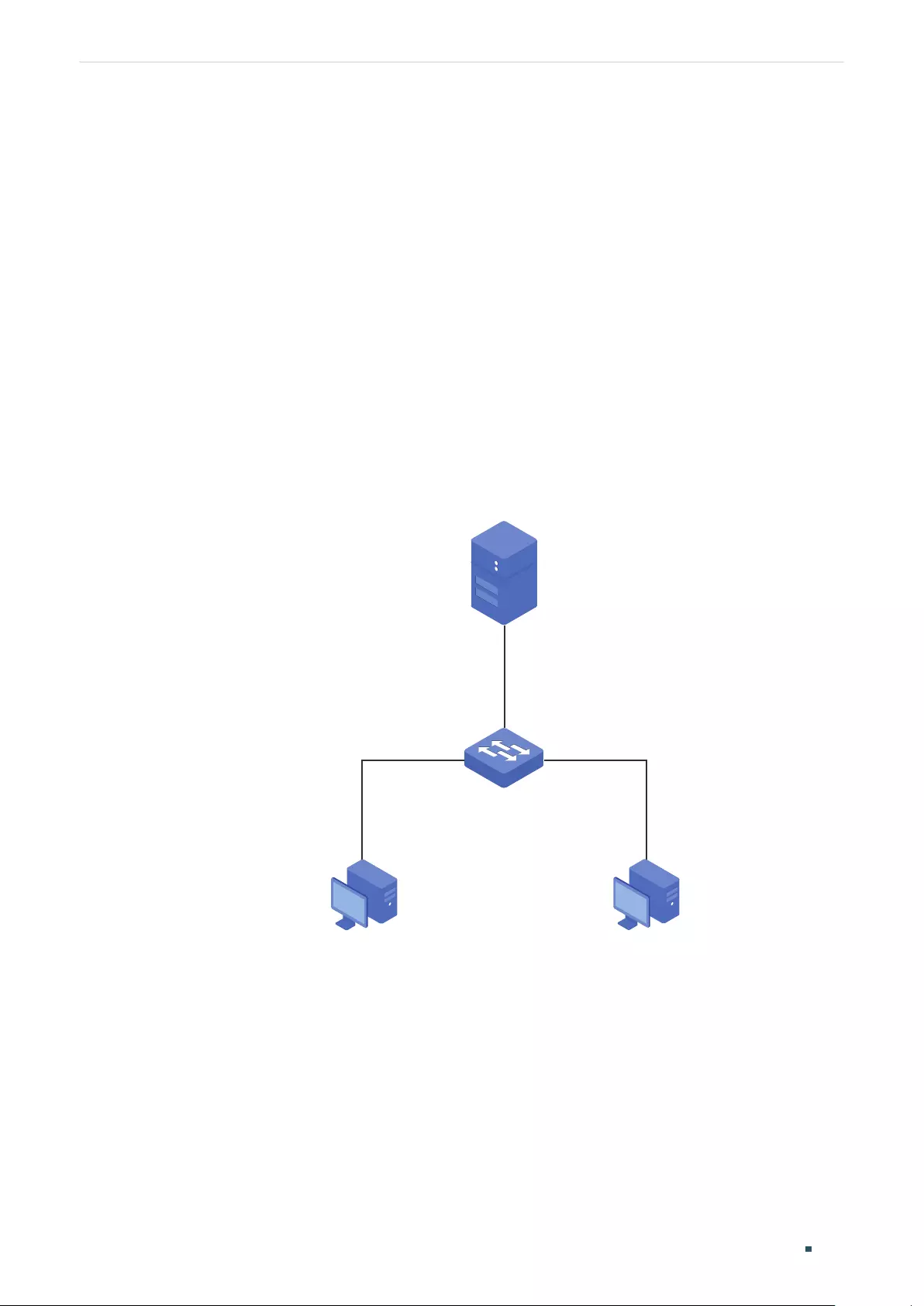
Configuration Guide 608
Configuring QoS Configuration Examples
4 Configuration Examples
4.1 Example for Configuring SP Mode
4.1.1 Network Requirements
Two hosts, Admin and Host A, can access the local network server through the switch.
Configure the switch to ensure the traffic from the Admin can be treated preferentially
when congestion occurs. Only when the traffic from the Admin is completely forwarded will
the traffic from Host A be forwarded.
The figure below shows the network topology.
Figure 4-1 QoS Application Topology
Server
Gi1/0/3
Gi1/0/1 Gi1/0/2
Switch
Admin Host A
4.1.2 Configuration Scheme
The overview of the configuration is as follows:
1) Configure the Port Priority for the two ports. Set Port 1/0/1 with higher priority.
2) Select SP schedule mode.
Demonstrated with T2600G-52TS, this chapter provides configuration procedures in two
ways: using the GUI and using the CLI.
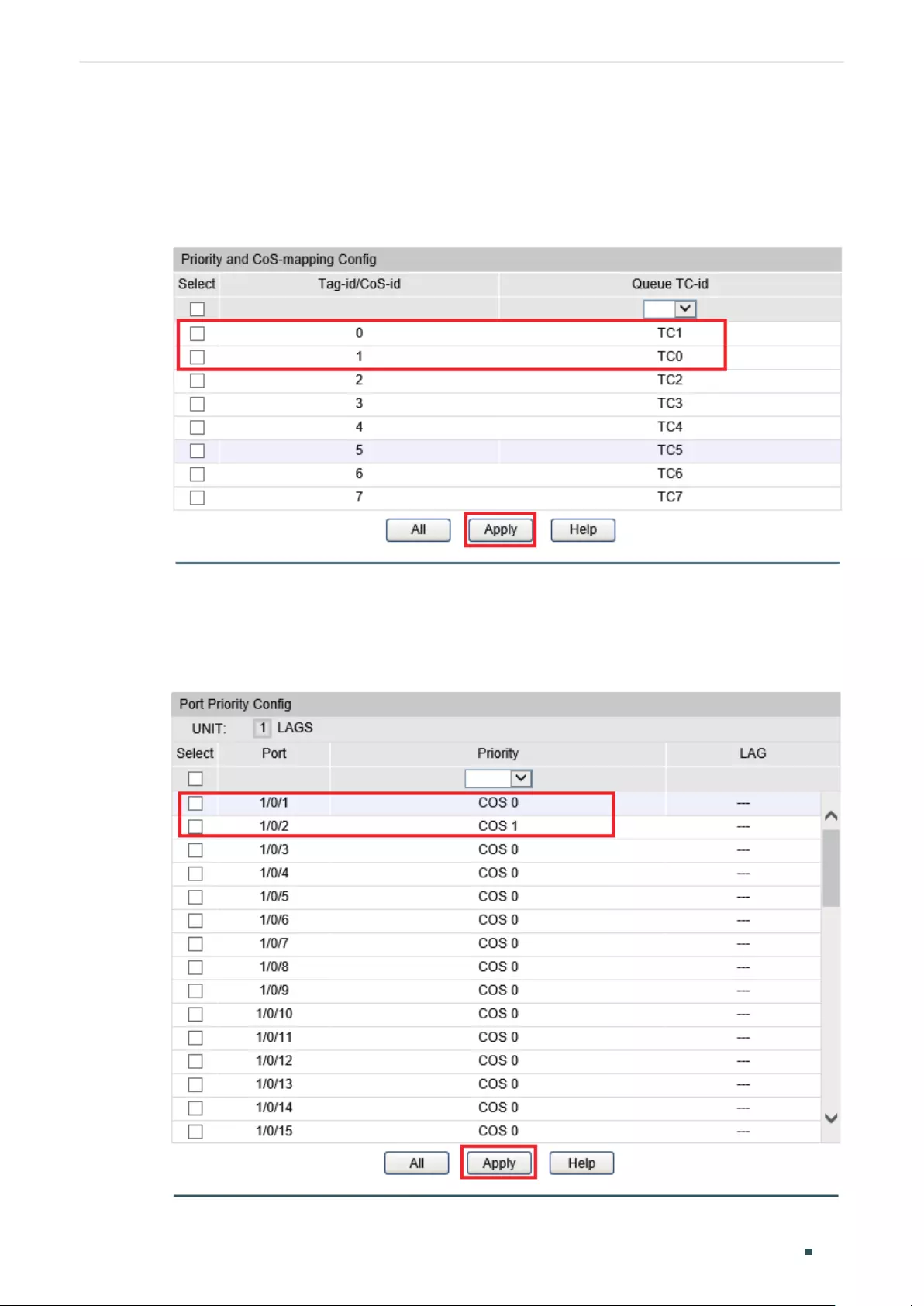
Configuring QoS Configuration Examples
Configuration Guide 609
4.1.3 Using the GUI
1) Choose QoS > DiffServ > 802.1P Priority to load the following page, and check the
corresponding CoS-id of TC0 and TC1.
Figure 4-2 CoS-TC Mapping relations
2) Choose QoS > DiffServ > Port Priority to load the following page, and set the priority
for port 1/0/1 to CoS 0 (mapping to TC1) and priority for port 1/0/2 to CoS 1 (mapping
to TC0).
Figure 4-3 Configure Port Priority
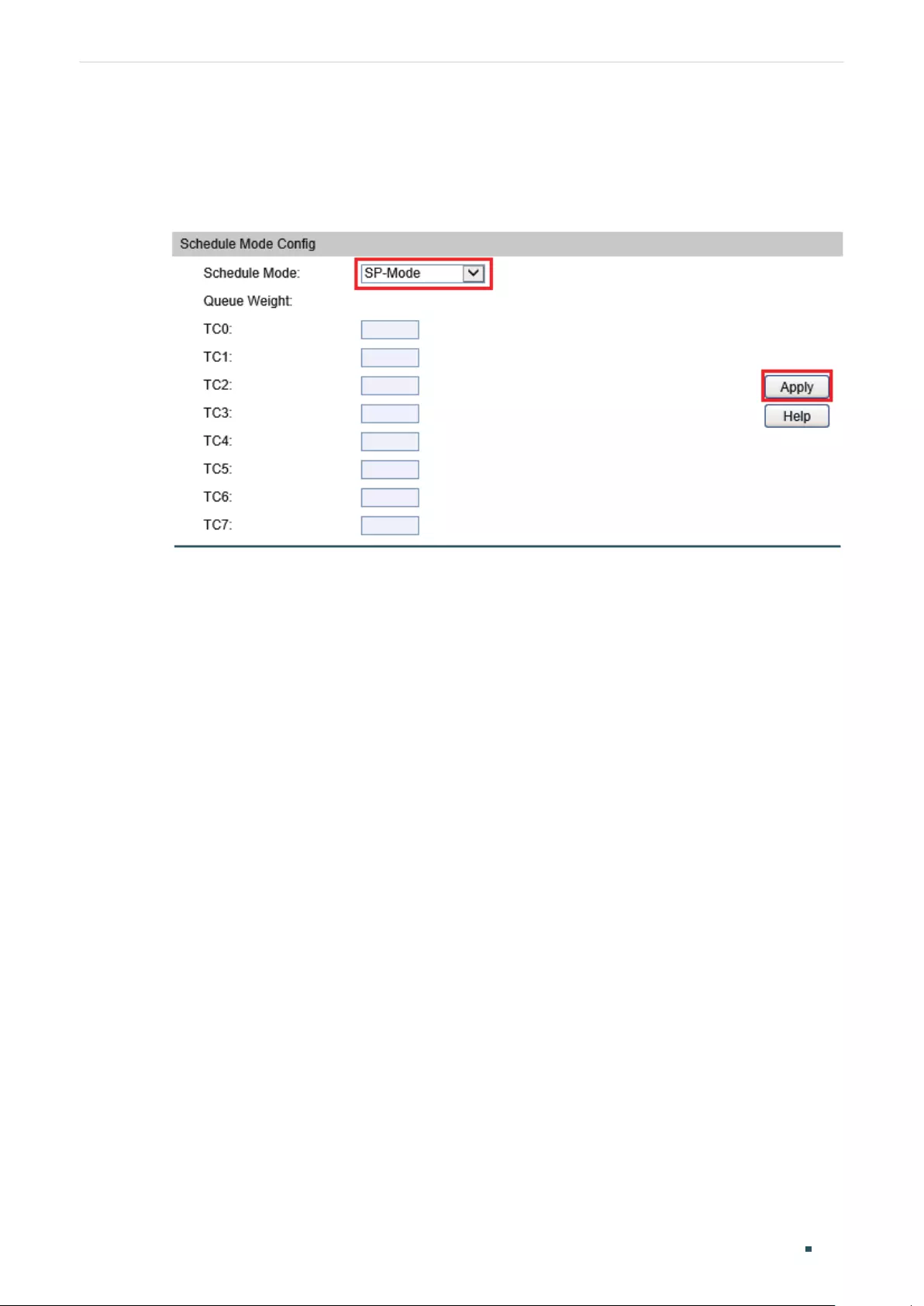
Configuration Guide 610
Configuring QoS Configuration Examples
3) Choose QoS > DiffServ > Schedule Mode to load the following page, and select SP-
Mode as the schedule mode. Click Apply.
Figure 4-4 Configure Schedule Mode
4) Click Save Config to save the settings.
4.1.4 Using the CLI
1) Check the corresponding CoS-id of TC0 and TC1.
Switch#show qos cos-map
-----+-----+-----+----+-----+-----+-----+----+----
Tag |0 |1 |2 |3 |4 |5 |6 |7
-----+-----+-----+----+-----+-----+-----+----+----
TC |TC1 |TC0 |TC2 |TC3 |TC4 |TC5 |TC6 |TC7
-----+-----+-----+----+-----+-----+-----+----+----
2) Set the priority for port 1/0/1 to CoS 0(mapping to TC1) and priority for port 1/0/2 to
CoS 1(mapping to TC0).
Switch#configure
Switch(config)#interface gigabitEthernet 1/0/1
Switch(config-if)#qos 0
Switch(config-if)#exit
Switch(config)#interface gigabitEthernet 1/0/2
Switch(config-if)#qos 1
Switch(config-if)#exit

Configuring QoS Configuration Examples
Configuration Guide 611
3) Select SP-Mode as the schedule mode and save the settings.
Switch(config)#qos queue mode sp
Switch(config)#exit
Switch#copy running-config startup-config
Verify the configuration
Verify the port-CoS mapping:
Switch(config)#show qos interface
Port CoS Value LAG
--------- ------------ ------------
Gi1/0/1 0 N/A
Gi1/0/2 1 N/A
...
Verify the schedule mode.
Switch(config)#show qos queue mode
-----------------+-----------
Scheduler Mode: SP | Weight: Unusable in sp mode.
------------------+-----------
4.2 Example for Configuring WRR Mode
4.2.1 Network Requirements
Both RD department and Marketing department can access the local network server.
Configure the switches to ensure the traffic from the two departments are forwarded
based on the weight value ratio of 2:1 when congestion occurs.
The network topology is shown as the following figure. Switch A is an access layer switch,
and Switch B is a layer 3 switch with ACL Redirect feature. RD department is connected to
port 1/0/1 of Switch A. Marketing Department is connected to port 1/0/2 of Switch A, the
server is connected to port 1/0/2 of Switch B and port 1/0/3 of Switch A is connected to
port 1/0/1 of Switch B.

Configuration Guide 612
Configuring QoS Configuration Examples
Figure 4-5 QoS Application Topology
Server
10.10.88.5/24
RD Dept.
10.10.10.0/24
Marketing Dept.
10.10.20.0/24
Router
Gi1/0/3
Gi1/0/1
Gi1/0/1
VLAN 10 VLAN 20
Gi1/0/2
Gi1/0/2
Switch B
Switch A
4.2.2 Configuration Scheme
Configure Switch A to add different VLAN tags to the packets from the two departments
respectively.
Configure Switch B to classify the incoming packets from the two departments
according to the VLAN tags, and to map them into different TC queues. Configure the
schedule mode as WRR-Mode to implement the QoS feature.
This chapter provides configuration procedures in two ways: using the GUI and using the
CLI.
4.2.3 Using the GUI
Note:
Before configuration, ensure network segments are reachable to each other.
Configurations for Switch A (Demonstrated with T1600G-52TS)
1) Choose VLAN > 802.1Q VLAN> VLAN Config, and click Create to load the following
page. Create VLAN 10 with the description of RD. Add port 1/0/1 as an untagged port
and port 1/0/3 as a tagged port to VLAN 10. Then click Apply.
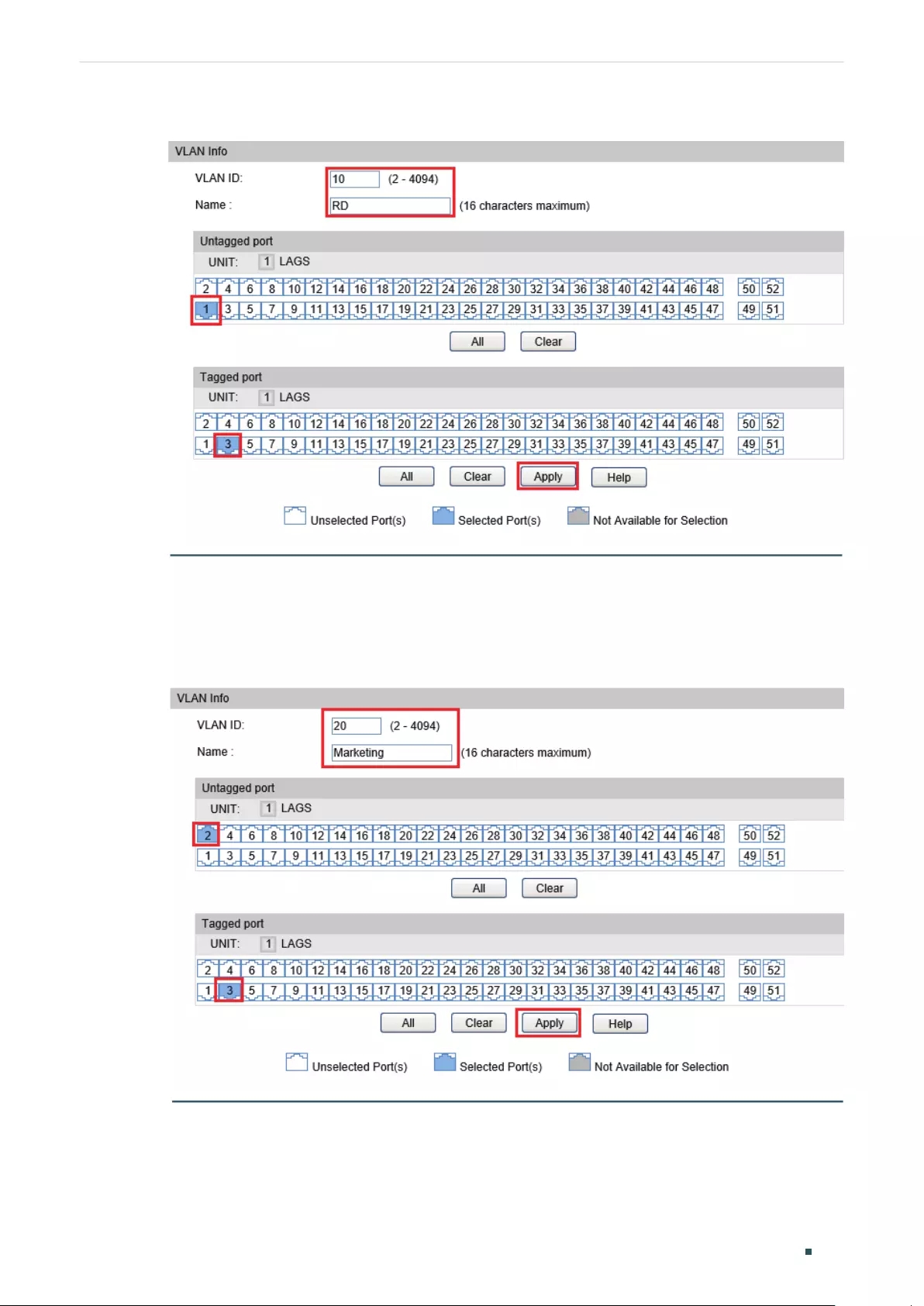
Configuring QoS Configuration Examples
Configuration Guide 613
Figure 4-6 Configure VLAN 10
2) Click Create again to load the following page. Create VLAN 20 with the description of
Marketing. Add port 1/0/2 as an untagged port and port 1/0/3 as a tagged port to VLAN
20. Then click Apply.
Figure 4-7 Configure VLAN 20
3) Click save config to save the settings.
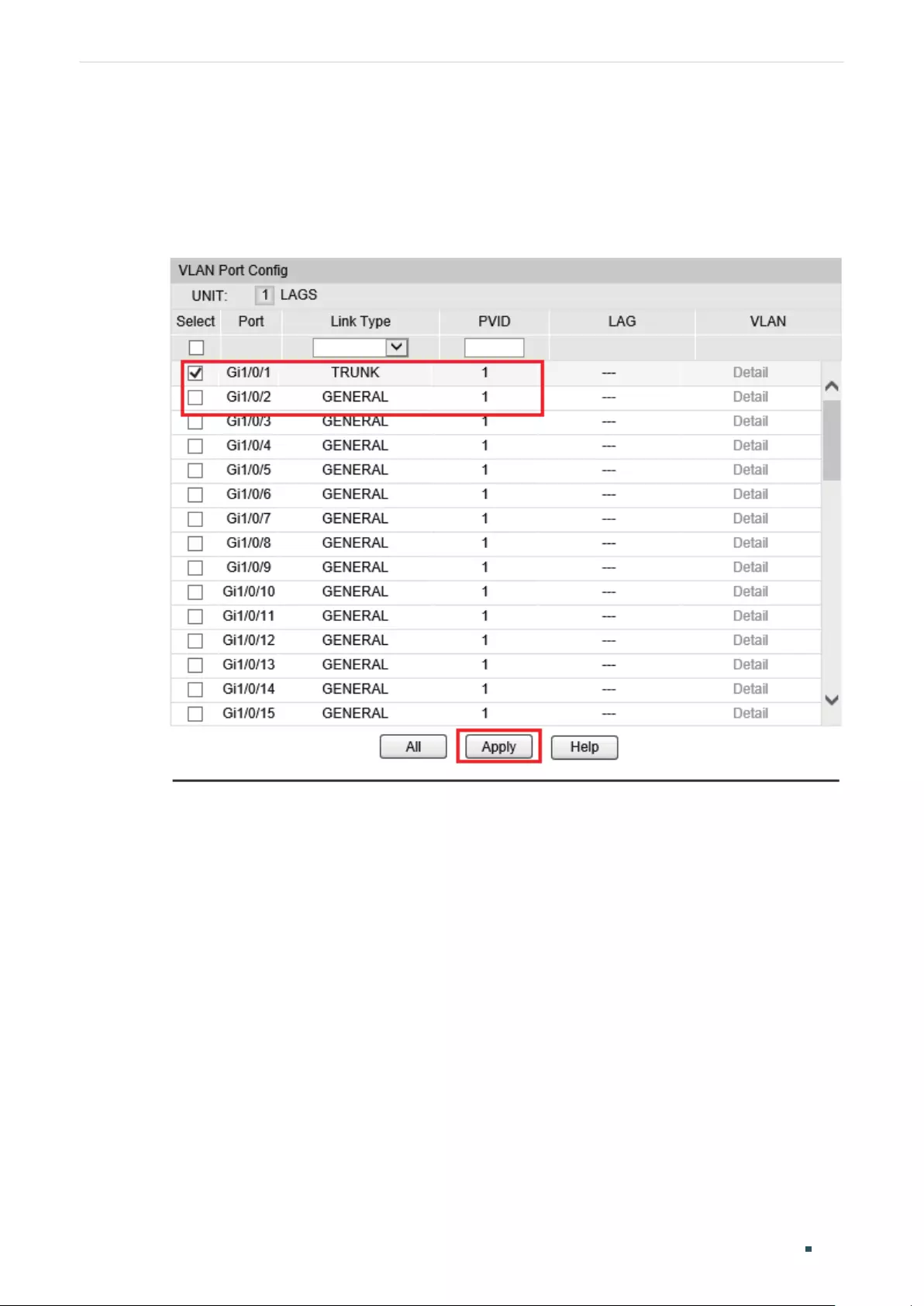
Configuration Guide 614
Configuring QoS Configuration Examples
Configurations for Switch B (Demonstrated with T2600G-28TS)
1) Choose VLAN > 802.1Q VLAN > Port Config to load the following page. For port 1/0/1,
set the Link Type as TRUNK, and for port 1/0/2, set the Link Type as ACCESS. Click
Apply.
Figure 4-8 Configure the Port
2) Choose VLAN > 802.1Q VLAN > VLAN Config and click Create to load the following
page. Create VLAN 10 and VLAN 20, and add port 1/0/1 to the two VLANs; create VLAN
30, and add port 1/0/2 to VLAN 30.

Configuring QoS Configuration Examples
Configuration Guide 615
Figure 4-9 Configure VLAN 10
Figure 4-10 Configure VLAN 20

Configuration Guide 616
Configuring QoS Configuration Examples
Figure 4-11 Configure VLAN30
3) Create MAC ACL 10 with its Rule ID as 1 and Operation as Permit.
Choose ACL> ACL Config > ACL Create to load the following page. Create ACL 10, and
click Apply.
Figure 4-12 Create MAC ACL 10
Choose ACL> ACL Config > MAC ACL to load the following page. Select ACL 10,
specify the Rule ID as 1 and the Operation as Permit. Click Apply.

Configuring QoS Configuration Examples
Configuration Guide 617
Figure 4-13 Create Rule 1
4) Create Policy RD and bind it to ACL 10, select QoS Remark and set Local Priority to
TC1.
Choose ACL > Policy Config > Policy Create to load the following page. Create a policy
with the Policy Name RD and click Apply.
Figure 4-14 Create Policy RD
Choose ACL > Policy Config > Action Create to load the following page. Select Policy
RD, and ACL 10, click QoS Remark and set the Local Priority to TC 1. Click Apply.
Figure 4-15 Action Create
5) Create Policy Marketing and bind it to ACL 10, select QoS Remark and set Local Priority
to TC0.
Choose ACL > Policy Config > Policy Create to load the following page. Create a policy
with the Policy Name Marketing and click Apply.
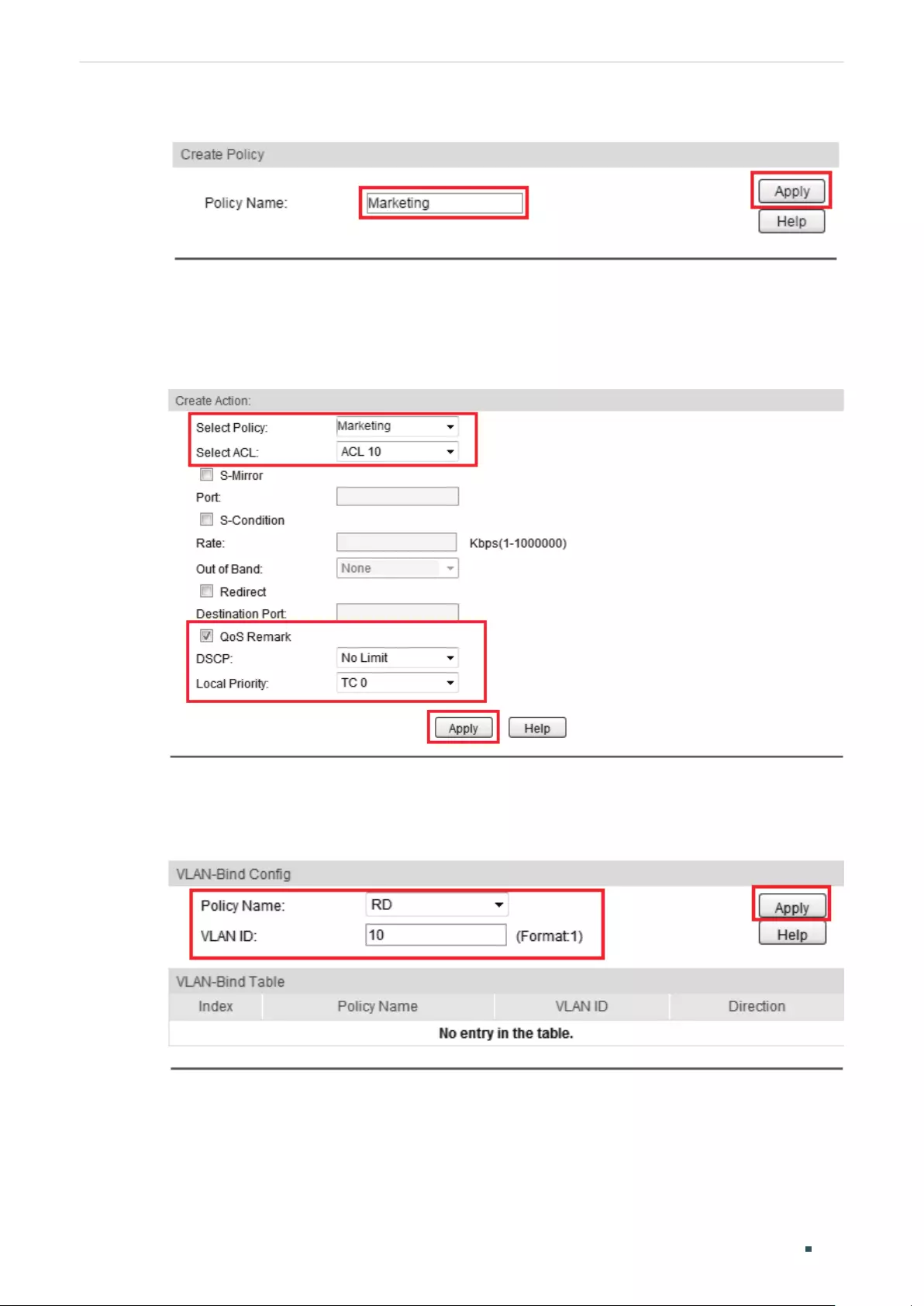
Configuration Guide 618
Configuring QoS Configuration Examples
Figure 4-16 Create Policy Marketing
Choose ACL > Policy Config > Action Create to load the following page. Select Policy
Marketing, and ACL 10, click QoS Remark and set the Local Priority to TC 0. Click
Apply.
Figure 4-17 Action Create
6) Choose ACL > Policy Binding > VLAN Binding. Bind Policy RD and Policy Marketing to
VLAN10 and VLAN 20 respectively.
Figure 4-18 Bind Policy RD to VLAN 10

Configuring QoS Configuration Examples
Configuration Guide 619
Figure 4-19 Bind Policy Marketing to VLAN 20
7) Choose QoS > DiffServ > Schedule Mode. Select WRR-Mode as the schedule mode,
and click Apply. No configuration is required here because queues based on ACL rules
have higher priority.
Figure 4-20 Configure Schedule Mode
8) Click Save Config to save the settings.
4.2.4 Using the CLI
Note:
Before configuration, ensure network segments are reachable to each other.
Configurations for Switch A (Demonstrated with T1600G-52TS)
1) Create VLAN 10 with the name RD and VLAN 20 with the name Marketing.
Switch_A#configure
Switch_A(config)#vlan 10
Switch_A(config-vlan)#name RD
Switch_A(config-vlan)#exit
Switch_A(config)#vlan 20
Switch_A(config-vlan)#name Marketing
Switch_A(config-vlan)#exit

Configuration Guide 620
Configuring QoS Configuration Examples
2) Set the port mode of port 1/0/1 and 1/0/2 as Untagged, and add them to VLAN 10 and
VLAN 20 respectively. Set the port mode of port 1/0/3 and add it to both VLAN 10 and
VLAN 20.
Switch_A(config)#interface gigabitEthernet 1/0/1
Switch_A(config-if)#switchport general allowed vlan 10 untagged
Switch_A(config-vlan)#exit
Switch_A(config)#interface gigabitEthernet 1/0/2
Switch_A(config-if)#switchport general allowed vlan 20 untagged
Switch_A(config-vlan)#exit
Switch_A(config)#interface gigabitEthernet 1/0/3
Switch_A(config-if)#switchport general allowed vlan 10,20 tagged
Switch_A(config-if)#end
Switch_A#copy running-config startup-config
Configurations for For Switch B (Demonstrated with T2600G-28TS)
1) Create VLAN 10 and VLAN 20. Configure the Link Type of port 1/0/1 as Trunk, and add
it to the two VLANs.
Switch_B#configure
Switch_B(config)#vlan 10
Switch_B(config-vlan)#name RD
Switch_B(config-vlan)exit
Switch_B(config)#vlan 20
Switch_B(config-vlan)#name Marketing
Switch_B(config-vlan)exit
Switch_B(config)#interface gigabitEthernet 1/0/1
Switch_B(config-if)#switchport mode trunk
Switch_B(config-if)#switchport trunk allowed vlan 10,20
Switch_B(config-if)#exit
2) Create VLAN 30. Configure the Link Type of port 1/0/2 as Access, and add it to VLAN
30.
Switch_B(config)#vlan 30
Switch_B(config-vlan)#name Server
Switch_B(config-vlan)exit

Configuring QoS Configuration Examples
Configuration Guide 621
Switch_B(config)#interface gigabitEthernet 1/0/2
Switch_B(config-if)#switchport mode access
Switch_B(config-if)#switchport access vlan 30
Switch_B(config-if)#exit
3) Create MAC ACL 10 with its Rule ID as 1 and Operation as Permit.
Switch_B(config)#mac access-list 10
Switch_B(config-mac-acl)#rule 1 permit
Switch_B(config-mac-acl)#exit
4) Create Policy RD and bind it to ACL 10, enable QoS Remark and set Local Priority to
TC1.
Switch_B(config)#access-list policy name RD
Switch_B(config)#access-list policy action RD 10
Switch_B(config-action)#qos-remark priority 1
Switch_B(config-action)#exit
5) Create Policy Marketing and bind it to ACL 10, enable QoS Remark and set Local
Priority to TC0.
Switch_B(config)#access-list policy name Marketing
Switch_B(config)#access-list policy action Marketing 10
Switch_B(config-action)#qos-remark priority 0
Switch_B(config-action)#exit
6) Bind Policy RD and Policy Market to VLAN10 and VLAN 20 respectively.
Switch_B(config)#interface vlan 10
Switch_B(config-if)#access-list bind RD
Switch_B(config-if)#exit
Switch_B(config)#interface vlan 20
Switch_B(config-if)#access-list bind Marketing
Switch_B(config-if)#exit
7) Select WRR-Mode as the schedule mode and save the settings.
Switch_B(config)#qos queue mode wrr
Switch_B(config)#exit
Switch_B#copy running-config startup-config

Configuration Guide 622
Configuring QoS Configuration Examples
Verify the configuration
Switch A:
Verify the VLAN members.
Switch_B#show vlan
VLAN Name Status Ports
------ ---------------- ------- -------------------------------------
1 System-VLAN active Gi1/0/3, Gi1/0/4, Gi1/0/5, Gi1/0/6,
Gi1/0/7, Gi1/0/8, Gi1/0/9, Gi1/0/10,
...
Gi1/0/49, Gi1/0/50, Gi1/0/51, Gi1/0/52
10 RD active Gi1/0/1, Gi1/0/3
20 Marketing active Gi1/0/2, Gi1/0/3
Switch B:
Verify ACL configuration:
Switch_B#show access-list
Mac access list 10
1 permit
Verify Policy and Action configuration:
Switch_B(config)#show access-list policy
Policy name : RD
access-list 10 priority 1
Policy name : Marketing
access-list 10 priority 0
Verify Policy binding:
Switch_B#show access-list bind
Index Policy Name Interface/VID Direction Type
------- -------------- ---------------- ----------- -----------------
1 RD 10 Ingress Vlan
2 Marketing 20 Ingress Vlan

Configuring QoS Configuration Examples
Configuration Guide 623
Verify the schedule mode.
Switch_B#show qos queue mode
----------------------+----------
Scheduler Mode | WRR
----------------------+----------

Configuration Guide 624
Configuring QoS Appendix: Default Parameters
5 Appendix: Default Parameters
DiffServ
Table 5-1 DiffServ
Parameter Default Setting
Port Priority Enabled. Packets from all ports are mapped to the same TC queue.
802.1P Priority For T2600G-18TS, it is disabled. You can manually enable it. See Table 5-2
for Tag-id/CoS-id-TC mapping relations.
For other switches, it is enabled. See Table 5-2 for Tag-id/CoS-id-TC
mapping relations.
DSCP Priority Disabled.
For T2600G-18TS, see Table 5-4 for DSCP-TC mapping relations.
For other switches, see Table 5-3 for DSCP-CoS Mapping relations.
Schedule Mode Equ-Mode.
Table 5-2 Tag-id/CoS-id-TC Mapping
Tag-id/CoS-id TC Queues (8)
0 TC1
1 TC0
2 TC2
3 TC3
4 TC4
5 TC5
6 TC6
7 TC7
Table 5-3 DSCP-CoS Mapping
DSCP CoS-id
0~7 CoS 0
8~15 CoS 1
16~23 CoS 2
24~31 CoS 3
32~39 CoS 4
40~47 CoS 5
48~55 CoS 6

Configuring QoS Appendix: Default Parameters
Configuration Guide 625
DSCP CoS-id
56~63 CoS 7
Table 5-4 DSCP-TC Mapping
DSCP TC Queues (8)
0~7 TC0
8~15 TC1
16~23 TC2
24~31 TC3
32~39 TC4
40~47 TC5
48~55 TC6
56~63 TC7
Bandwidth Control
Table 5-5 Bandwidth Control
Parameter Default Setting
Rate Limit Disabled
Storm Control Disabled

Configuring Voice VLAN Overview
Configuration Guide 627
1 Overview
The voice VLAN feature is used to prioritize the transmission of voice traffic. Voice traffic
is typically more time-sensitive than data traffic, and the voice quality can deteriorate a lot
because of packet loss and delay. To ensure the high voice quality, you can configure the
voice VLAN and set priority for voice traffic.
Voice VLAN Modes on Ports
A voice VLAN can operate in two modes: manual mode and automatic mode.
Manual mode: This mode is applicable when the switch port forwards voice traffic only.
You manually add ports connecting IP phones to the voice VLAN; then the switch will apply
priority rules to ensure the high priority of voice traffic.
Figure 1-1 Only Voice Traffic on One Port
Internet
IP Phone IP Phone
Switch
Automatic mode: This mode is applicable when voice traffic and data traffic are transmitted
on the same switch port. When a port receives a voice packet, the switch automatically
adds the port to the voice VLAN and applies priority rules. The switch forwards voice traffic
in the voice VLAN and data traffic in other VLANs.
Figure 1-2 Voice Traffic and Data Traffic on the Same Port
Internet
IP PhonePC Switch

Configuration Guide 628
Configuring Voice VLAN Overview
OUI Address (Organizationally Unique Identifier Address)
The OUI address is used by the switch to determine whether a packet is a voice packet.
An OUI address is the first 24 bits of a MAC address, and is assigned as a unique identifier
by IEEE (Institute of Electrical and Electronics Engineers) to a device vendor. If the source
MAC address of a packet complies with the OUI addresses in the switch, the switch
identifies the packet as a voice packet and prioritizes it in transmission.

Configuring Voice VLAN Voice VLAN Configuration
Configuration Guide 629
2 Voice VLAN Configuration
To complete the Voice VLAN configuration, follow these steps:
1) Create a VLAN.
2) Configure OUI addresses.
3) Configure Voice VLAN globally.
4) Configure Voice VLAN mode on ports.
Configuration Guidelines
Before configuring voice VLAN, you need to create a VLAN for voice traffic. For details
about VLAN Configuration, please refer to Configuring 802.1Q VLAN.
VLAN 1 is a default VLAN and cannot be configured as the voice VLAN.
Only one VLAN can be set as the voice VLAN on the switch.
To apply the voice VLAN configuration, you may need to further configure PVID
(Port VLAN ID) and the link type of the port which is connected to voice devices. We
recommend that you choose the mode according to your needs and configure the port
as the following table shows.
Table 2-1 Voice VLAN mode and Link Type of the Port
Traffic on One
Port Voice Traffic Type Suggested
Mode Suggested Link Type and PVID
Voice traffic
and data traffic
Tagged voice traffic
Automatic
PVID cannot be the voice VLAN ID.
Untagged voice traffic Not supported.
Voice traffic
only
Tagged voice traffic
Manual
Tagged; PVID configuration is not
required.
Untagged voice traffic Untagged; PVID should be the voice
VLAN ID.
Because the voice VLAN in automatic mode supports only tagged voice traffic, you
need to make sure traffic from the voice device is tagged. To do so, there are mainly
two ways:
»You can configure the voice device to forward traffic with a voice VLAN tag.
»If your switch provides the LLDP-MED feature, you can also configure it to
instruct the voice device to send tagged voice traffic. For details about LLDP-
MED, please refer to Configuring LLDP.
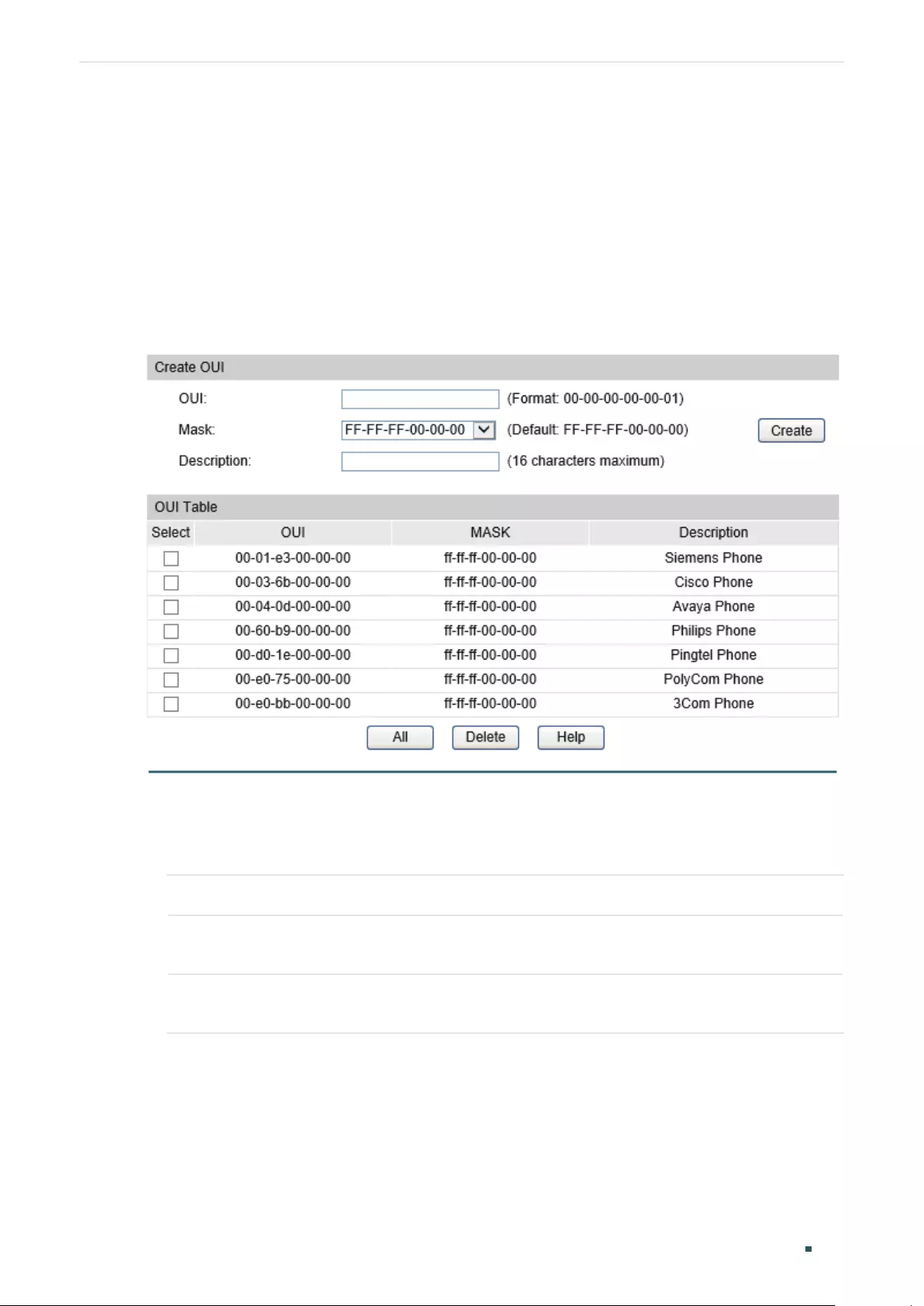
Configuration Guide 630
Configuring Voice VLAN Voice VLAN Configuration
2.1 Using the GUI
2.1.1 Configuring OUI Addresses
If the OUI address of your voice device is not in the OUI table, you need to add the OUI
address to the table.
Choose the menu QoS > Voice VLAN > OUI Config to load the following page.
Figure 2-1 Configuring OUI Addresses
Follow these steps to add OUI addresses:
1) Enter an OUI address and the corresponding mask, and give a description about the
OUI address.
OUI Enter the OUI address of your device.
Mask Specify a mask to determine the depth of the OUI that the switch uses to check
source addresses of received packets.
Description Give an OUI address description for identification. The length is no more than 16
characters.
2) Click Create to add an OUI address to the table.

Configuring Voice VLAN Voice VLAN Configuration
Configuration Guide 631
2.1.2 Configuring Voice VLAN Globally
Choose the menu QoS > Voice VLAN > Global Config to load the following page.
Figure 2-2 Configuring Voice VLAN Globally
Follow these steps to configure the voice VLAN globally:
1) Enable the voice VLAN feature, and enter a VLAN ID.
VLAN ID Specify an existing VLAN as the voice VLAN.
2) Set the aging time for the voice VLAN.
Aging Time Specify the length of time that a port remains in the voice VLAN after the port
receives a voice packet. Aging time works only for ports in automatic voice VLAN
mode. The range is 1 to 43200 minutes; the default is 1440 minutes.
3) Specify a priority for the voice VLAN.
Priority Specify the priority that will be assigned to voice packets. A bigger value means a
higher priority. The range is 0 to 7; the default is 6.
This is an IEEE 802.1p priority, and you can further configure its schedule mode if
needed. For details about schedule mode, please refer to Configuring QoS.
4) Click Apply.
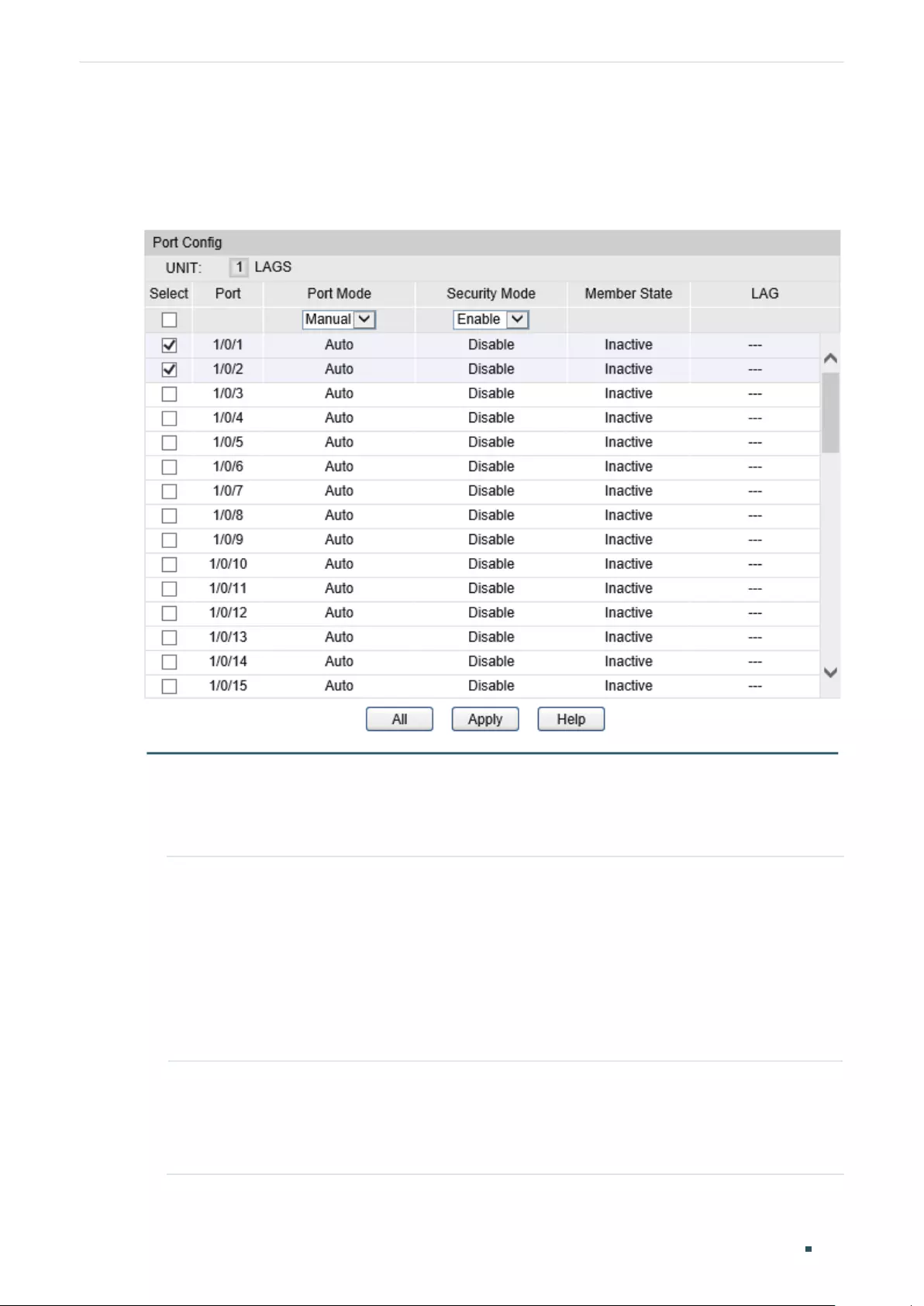
Configuration Guide 632
Configuring Voice VLAN Voice VLAN Configuration
2.1.3 Configuring Voice VLAN Mode on Ports
Choose the menu QoS > Voice VLAN > Port Config to load the following page.
Figure 2-3 Configuring Voice VLAN Mode on Ports
Follow these steps to configure voice VLAN mode on ports:
1) Select your desired ports and choose the port mode.
Port Mode Choose the way of adding the selected ports to the voice VLAN.
Auto: When a port receives a voice packet whose resource MAC address
matches an OUI address, the switch automatically adds the port to the voice
VLAN.
If you choose the Auto mode for the selected ports, make sure traffic from your
voice device is tagged.
Manual: You manually add the ports connecting voice devices to the voice VLAN.
Member State Displays the current state of the ports that are connected to voice devices.
Active: The corresponding port is in the voice VLAN.
Inactive: The corresponding port is not in the voice VLAN.
2) Set the security mode for selected ports.

Configuring Voice VLAN Voice VLAN Configuration
Configuration Guide 633
Security Mode For packets that will be forwarded in the voice VLAN, you can configure the
security mode to prevent malicious traffic with faked voice VLAN tag.
For packets to other VLANs, how the switch processes the packets is determined
by whether the selected ports permit the VLAN or not, independent of voice VLAN
security mode.
Disable: For packets to the voice VLAN, the switch does not check the source
MAC address and the selected ports forward all these packets in the voice VLAN.
The security mode is disabled by default.
Enable: For packets to the voice VLAN, the selected ports forward only voice
packets whose source MAC addresses match OUI addresses to the voice VLAN,
and discard others.
We recommend that you do not mix voice traffic with data traffic in the voice
VLAN. If necessary, make sure the security mode is disabled.
3) Click Apply.
2.2 Using the CLI
Follow these steps to configure the voice VLAN:
Step 1 configure
Enter global configuration mode.
Step 2 show voice vlan oui
Check whether the OUI address of your voice device is in the OUI table.
Step 3 voice vlan mac-address
mac-addr
mask
mask
[ description
descript
]
If the OUI address of your voice device is not in the OUI table, add the OUI address to the table.
mac-addr
: Enter the OUI address of your device.
mask
: Specify a mask to determine the depth of the OUI that the switch uses to check source
addresses of received packets.
descript:
Give an OUI address description for identification.
Step 4 voice vlan priority
pri
Set the priority for voice packets.
pri:
Specify the priority that will be tagged on voice packets. A bigger value means a higher
priority. The range is 0 to 7; the default is 6. This is an IEEE 802.1p priority, and you can further
configure its schedule mode if needed. For details about schedule mode, please refer to
Configuring QoS.

Configuration Guide 634
Configuring Voice VLAN Voice VLAN Configuration
Step 5 voice vlan aging
time
Set the aging time for ports in automatic voice VLAN mode.
time:
Specify the length of time that a port remains in the voice VLAN after the port receives a
voice packet. Aging time works only for ports in automatic voice VLAN mode. The range is 1 to
43200 minutes; the default is 1440 minutes.
Step 6 voice vlan
vid
Specify an existing VLAN as the voice VLAN.
vid :
Enter the VLAN ID that you have created for the voice VLAN.
Step 7 interface {
fastEthernet
port
| range fastEthernet
port-list
| gigabitEthernet
port
| range
gigabitEthernet
port-list
| port-channel
lag-id
| range port-channel
lag-list
}
Enter interface configuration mode.
port |port-list
: The number or the list of the Ethernet port that you want to configure.
lag-id |lag-list:
The ID or the list of the LAG that you want to configure.
Step 8 switchport voice vlan mode
{ auto | manual }
Choose the way of adding the specified ports to the voice VLAN.
auto: The switch automatically adds the specified ports to the voice VLAN when the ports
receive voice packets. If you choose the auto mode for the specified ports, make sure traffic
from your voice device is tagged.
manual: You need to manually add the specified ports to the voice VLAN.
Step 9 switchport voice vlan security
Enable the security feature.
For packets to the voice VLAN, the selected ports forward only voice packets whose source
MAC addresses match OUI addresses to the voice VLAN, and discard others. For packets to
other VLANs, how the switch processes the packets is determined by whether the selected
ports permit the VLAN or not, independent of voice VLAN security mode.
We recommend that you do not mix voice traffic with data traffic in the voice VLAN. If
necessary, make sure the security mode is disabled.
Step 10 switchport general allowed vlan
vid
{ tagged | untagged }
(For ports in manual voice VLAN mode) Add the specified ports to the voice VLAN.
vid:
Enter the voice VLAN ID to add the specified ports to the voice VLAN.
tagged | untagged: Set the egress rule as tagged or untagged for the specified ports.
Step 11 show voice vlan
Verify the global configuration of voice VLAN.
Step 12 show voice vlan switchport
Verify the voice VLAN configuration of the ports.

Configuring Voice VLAN Voice VLAN Configuration
Configuration Guide 635
Step 13 end
Return to privileged EXEC mode.
Step 14 copy running-config startup-config
Save the settings in the configuration file.
The following example shows how to set port 1/0/1 in manual voice VLAN mode. Configure
the switch to forward voice traffic with an IEEE 802.1p priority of 5 and to transmit only
voice traffic whose resource MAC address matches an OUI address in the voice VLAN :
Switch#configure
Switch(config)#vlan 10
Switch(config-vlan)#name VoiceVLAN
Switch(config-vlan)#exit
Switch(config)#voice vlan priority 5
Switch(config)#voice vlan 10
Switch(config)#interface gigabitEthernet 1/0/1
Switch(config-if)#switchport voice vlan mode manual
Switch(config-if)#switchport voice vlan security
Switch(config-if)#switchport general allowed vlan 10 untagged
Switch(config-if)#show voice vlan
Voice VLAN status: Enabled
VLAN ID: 10
Aging Time: 1440
Voice Priority: 5
Switch(config-if)#show voice vlan switchport
Port Auto-mode Security State LAG
------ ------------ ------------ ------------ ------
Gi1/0/1 Manual Enabled Active N/A
Gi1/0/2 Auto Disabled Inactive N/A
Gi1/0/3 Auto Disabled Inactive N/A
......
Switch(config-if)#end
Switch#copy running-config startup-config

Configuration Guide 636
Configuring Voice VLAN Configuration Example
3 Configuration Example
3.1 Network Requirements
The company plans to install IP phones in the office area and the meeting room, and has
requirements as follows:
In the office area
»IP phones share switch ports used by computers, because no more ports are
available for IP phones.
»Transmit voice traffic in an exclusive path with high quality.
»Avoid attacks from malicious data flows.
In the meeting room
»Transmit voice traffic in an exclusive path with high quality.
»Avoid attacks from malicious data flows.
3.2 Configuration Scheme
In the office area, IP phones share the same ports of the switch with computers and
therefore occupy no more ports. To separate voice traffic from data traffic, configure
LLDP-MED to instruct IP Phones to send traffic with the voice VLAN tag. Voice traffic is
transmitted in the voice VLAN, and data traffic is transmitted in the default VLAN. Set ports
that are connected to IP phones in automatic voice VLAN mode. Meanwhile, configure the
voice VLAN to work in security mode and to forward only legal voice packets.
In the meeting room, the switch provides dedicated connections to IP phones. In this
situation, IP phones do not need to send traffic with the voice VLAN tag. Set ports that are
connected to IP phones in manual voice VLAN mode. Meanwhile, configure the voice VLAN
to work in security mode and to forward only legal voice packets.
To ensure the high quality of voice traffic, configure all devices along the path to keep the
priority of voice traffic and to coordinate with the voice VLAN configuration.
3.3 Network Topology
In the office area, IP phones are added to ports that are connected to computers on Switch
A. These ports use the voice VLAN for voice traffic, and the default VLAN for data traffic.

Configuring Voice VLAN Configuration Example
Configuration Guide 637
In the meeting room, computers and IP phones are connected to different ports of Switch B.
Ports connected to IP phones use the voice VLAN for voice traffic, and ports connected to
computers use the default VLAN for data traffic.
Voice traffics from Switch A and Switch B are forwarded to voice gateway and Internet
through Switch C.
Figure 3-1 Network Topology
Internet
IP Phone 20 IP Phone 30
Switch B
Gi1/0/2
Gi1/0/1
Gi1/0/1
Switch C
Switch A
Gi1/0/2 Gi1/0/3
Gi1/0/4
PC 20
Meeting Room
Gi1/0/1 Gi1/0/2
Gi1/0/3
IP Phone 10
PC 10
......
Office Area
Demonstrated with T2600G-28TS, this chapter provides configuration procedures in two
ways: using the GUI and using the CLI.
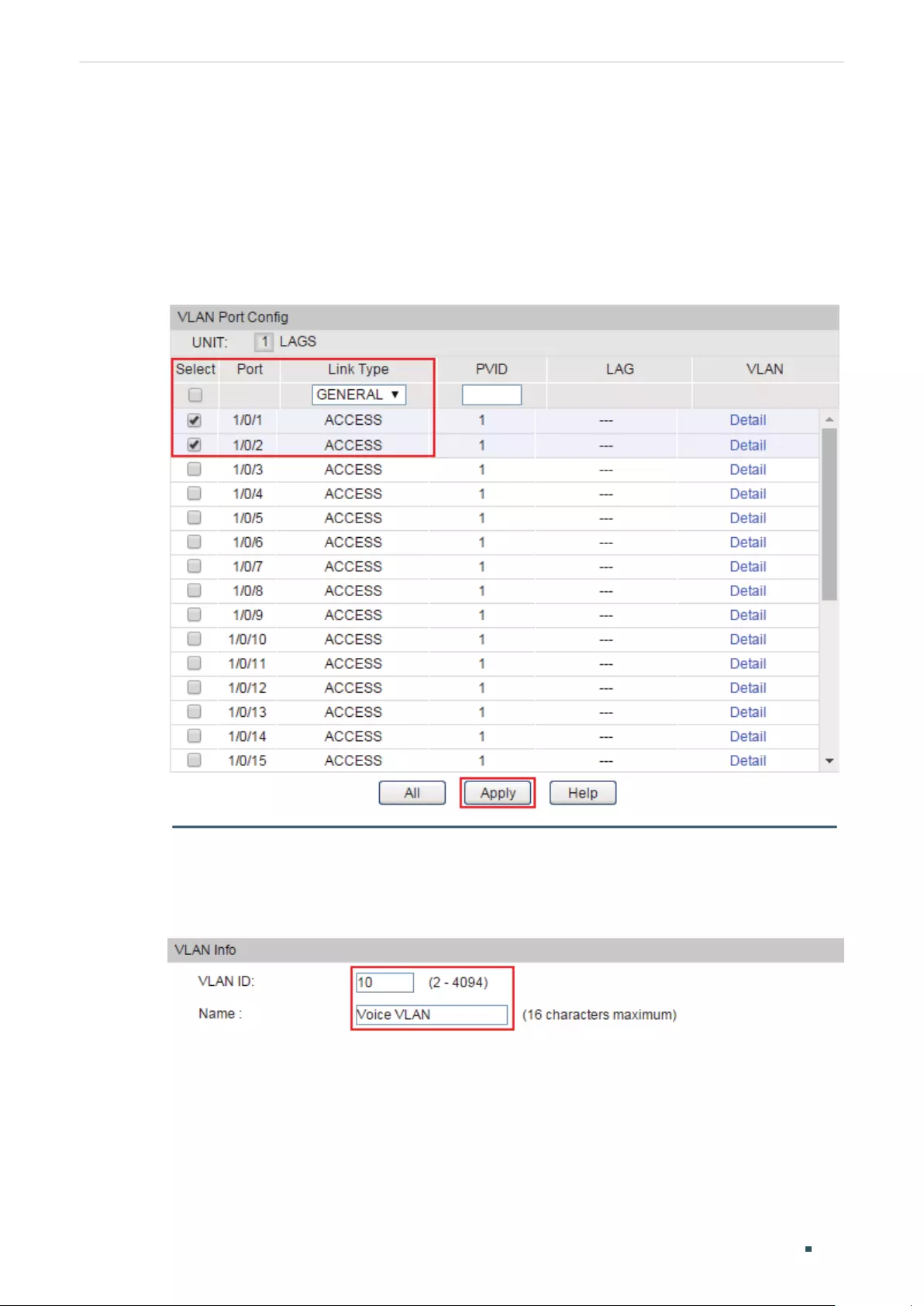
Configuration Guide 638
Configuring Voice VLAN Configuration Example
3.4 Using the GUI
Configurations for Switch A
1) Choose the menu VLAN > 802.1Q VLAN > Port Config to load the following page. Set
the link type of port1/0/1-2 as General, and click Apply.
Figure 3-2 Configuring the Link Type of port 1/0/1-2
2) Choose the menu VLAN > 802.1Q VLAN > VLAN Config and click Create to load the
following page. Create VLAN 10, and click Apply.
Figure 3-3 Creating a VLAN
3) Choose the menu QoS > Voice VLAN > Global Config to load the following page.
Enable voice VLAN, enter 10 in the VLAN ID field and set aging time as 1440 minutes
and priority as 6. Then click Apply.
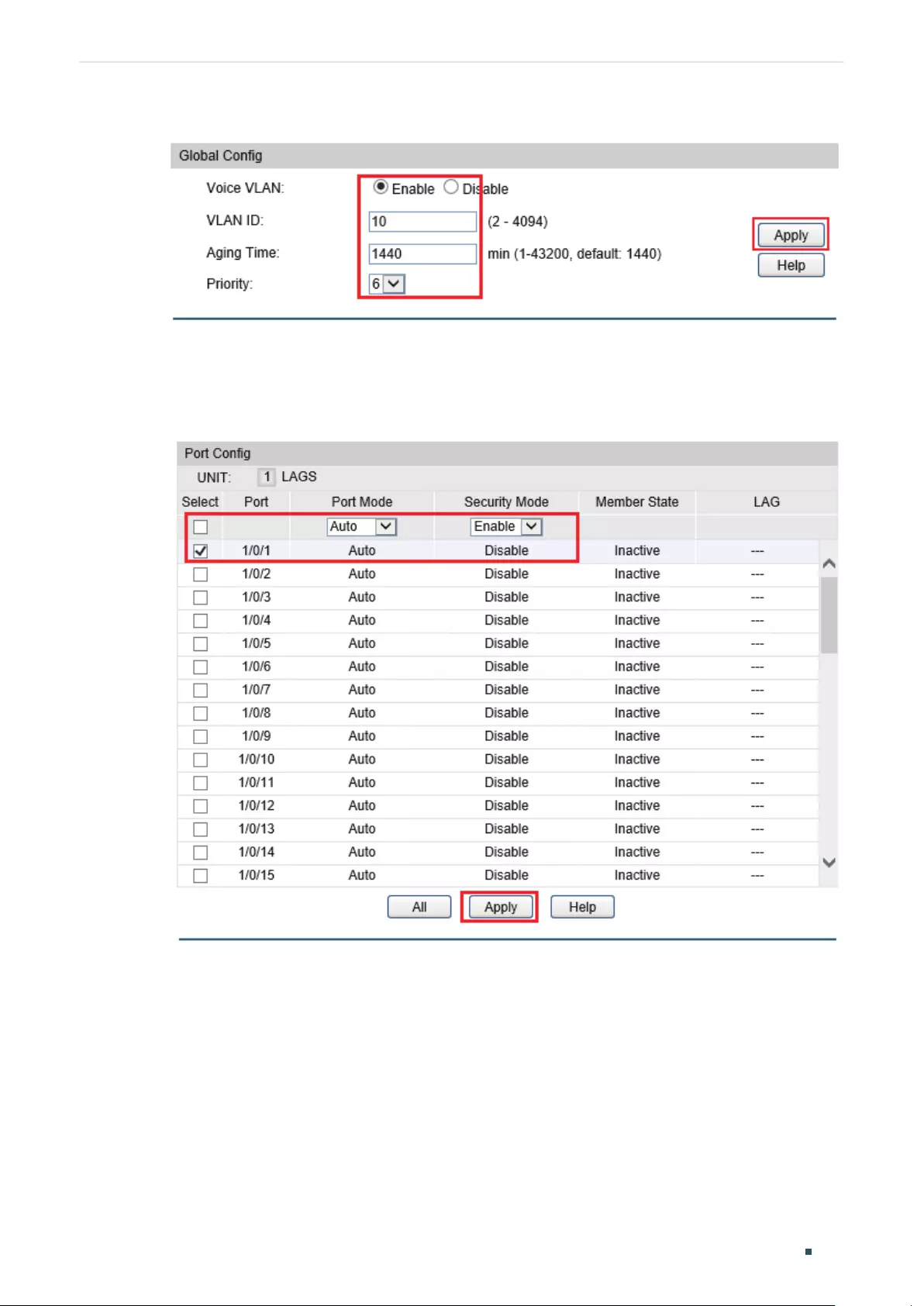
Configuring Voice VLAN Configuration Example
Configuration Guide 639
Figure 3-4 Configuring Voice VLAN Globally
4) Choose the menu QoS > Voice VLAN > Port Config to load the following page. Select
port 1/0/1, choose auto mode and enable security mode. Select port 1/0/2 and choose
manual mode. Click Apply.
Figure 3-5 Configuring Voice VLAN Mode on Port 1/0/1
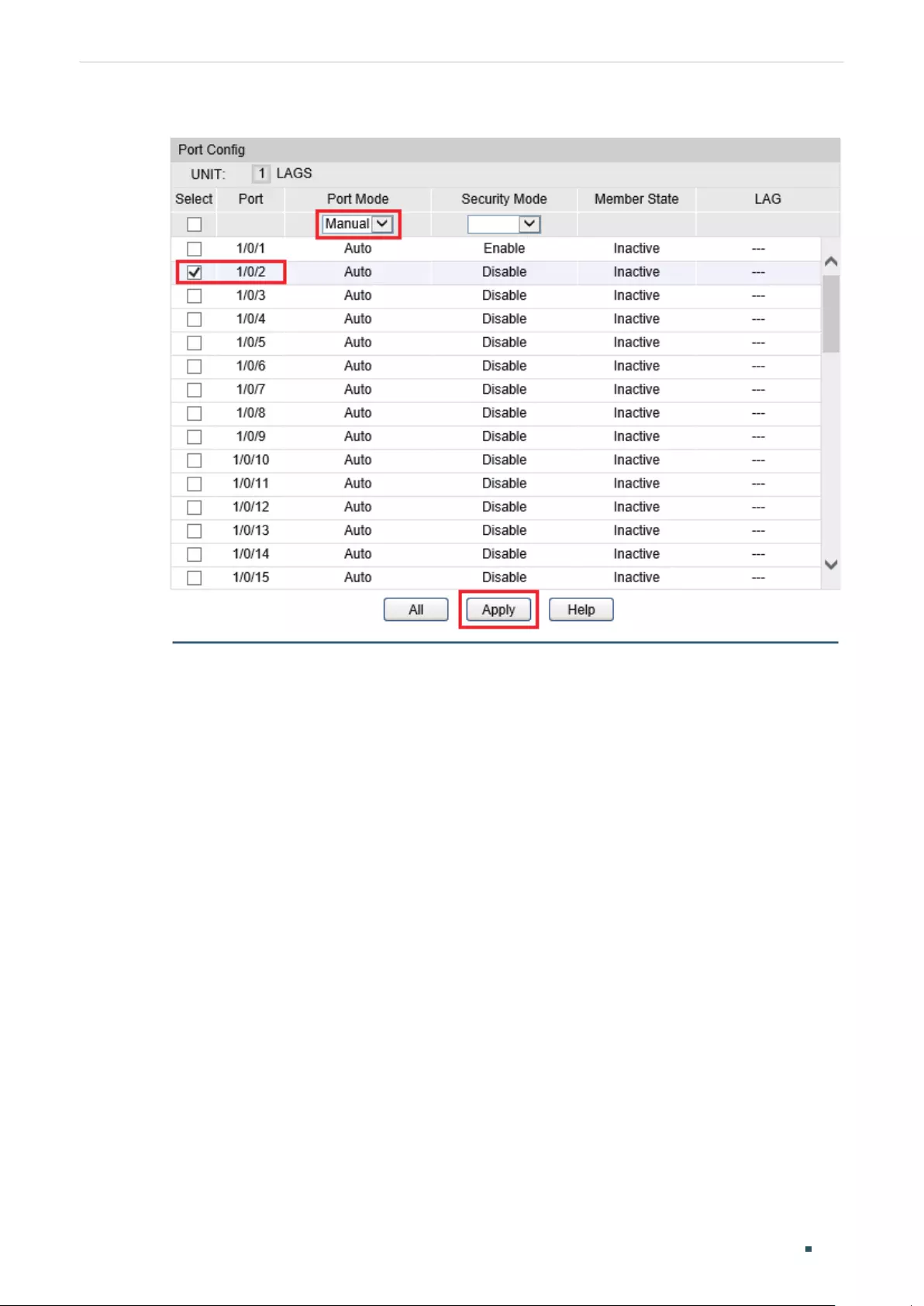
Configuration Guide 640
Configuring Voice VLAN Configuration Example
Figure 3-6 Configuring Voice VLAN Mode on Port 1/0/2
5) Choose the menu VLAN > 802.1Q VLAN > VLAN Config and edit VLAN 10 to load the
following page. Add port 1/0/2 to the voice VLAN.

Configuring Voice VLAN Configuration Example
Configuration Guide 641
Figure 3-7 Adding Port 1/0/2 to the Voice VLAN
6) Choose the menu LLDP > Basic Config> Global Config to load the following page.
Enable LLDP globally.
Figure 3-8 Enabling LLDP Globally
7) Choose the menu LLDP > LLDP-MED> Global Config to load the following page. Set
fast start count as 4.
Figure 3-9 Configuring LLDP-MED Globally

Configuration Guide 642
Configuring Voice VLAN Configuration Example
8) Choose the menu LLDP > LLDP-MED> Port Config to load the following page. Enable
LLDP-MED on port 1/0/1.
Figure 3-10 Configuring LLDP-MED on Ports
Click Detail of port1/0/1 to load the following page. Configure the TLV information
which will be carried in LLDP-MED frames and sent out by port 1/0/1. Select all TLVs,
and configure location identification parameters.
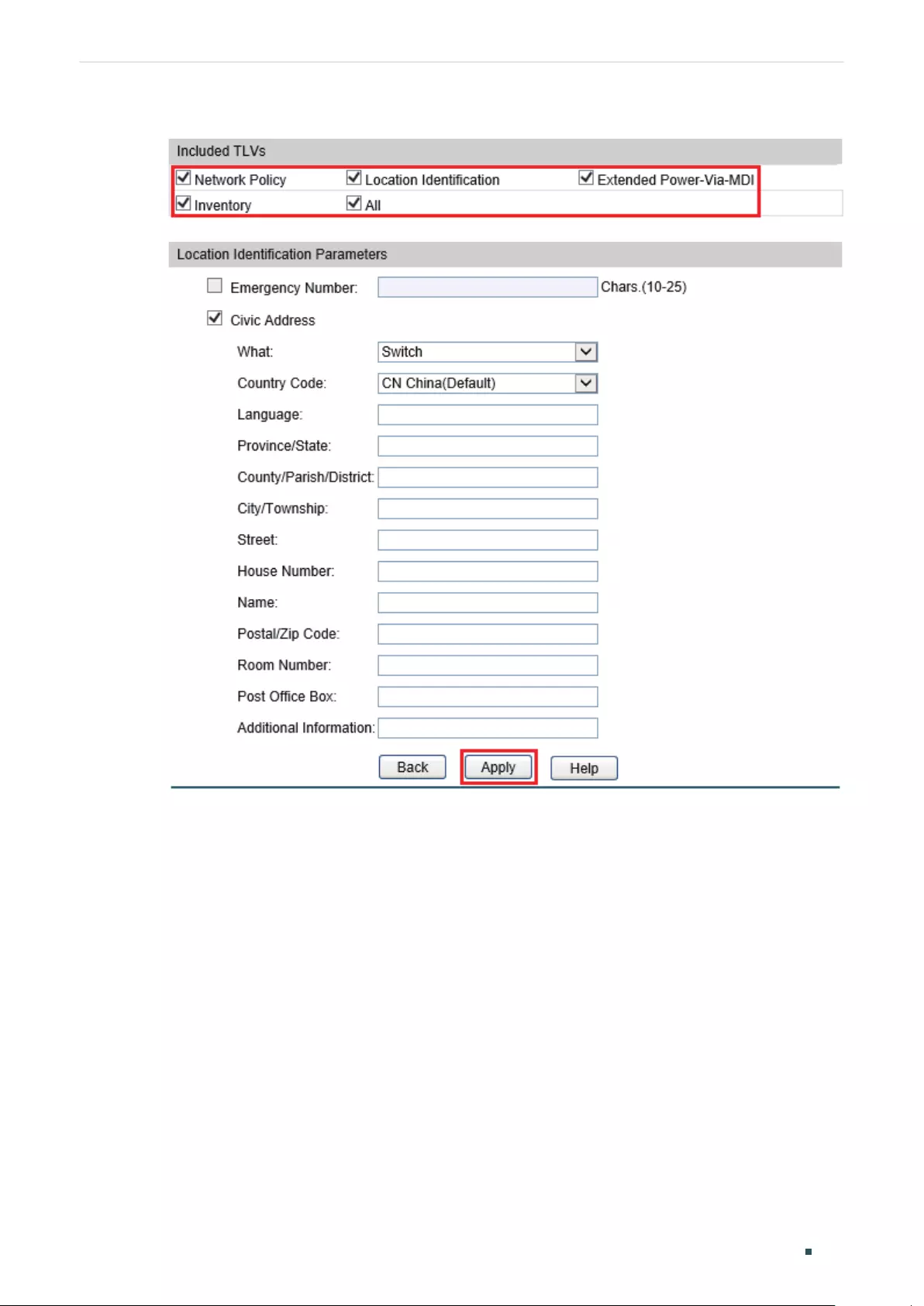
Configuring Voice VLAN Configuration Example
Configuration Guide 643
Figure 3-11 Configuring TLVs
For details about LLDP-MED, please refer to Configuring LLDP.
9) Click Save Config to save the settings.
Configurations for Switch B
1) Choose the menu VLAN > 802.1Q VLAN > Port Config to load the following page.
Configure the link type of ports 1/0/1-3 as General.
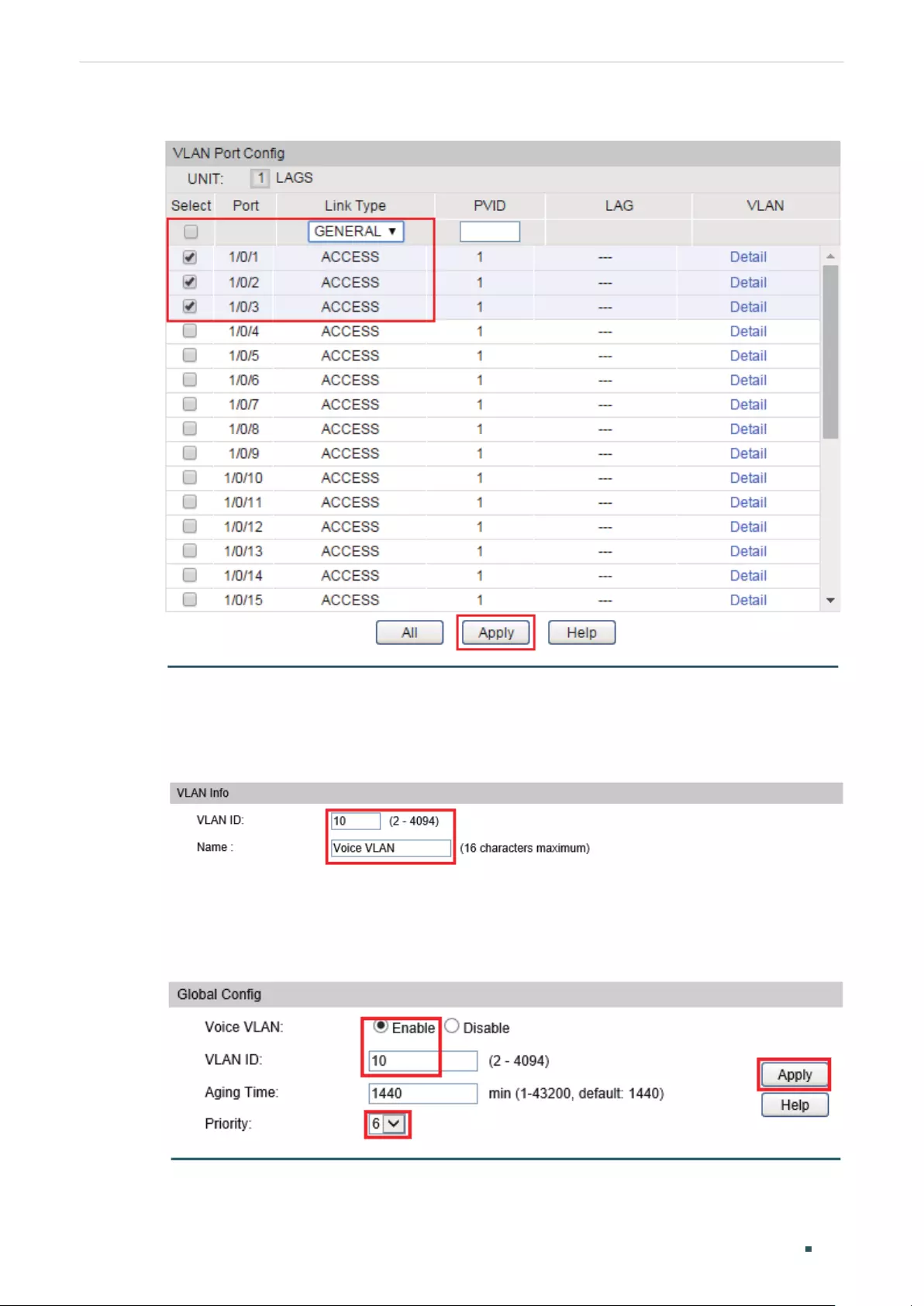
Configuration Guide 644
Configuring Voice VLAN Configuration Example
Figure 3-12 Configuring the Link Type of port 1/0/1-3
2) Choose the menu VLAN > 802.1Q VLAN > VLAN Config and click Create to load the
following page. Create VLAN 10.
Figure 3-13 Creating a VLAN
3) Choose the menu QoS > Voice VLAN > Global Config to load the following page.
Enable voice VLAN, enter 10 in the VLAN ID field and set priority as 6.
Figure 3-14 Configuring Voice VLAN Globally
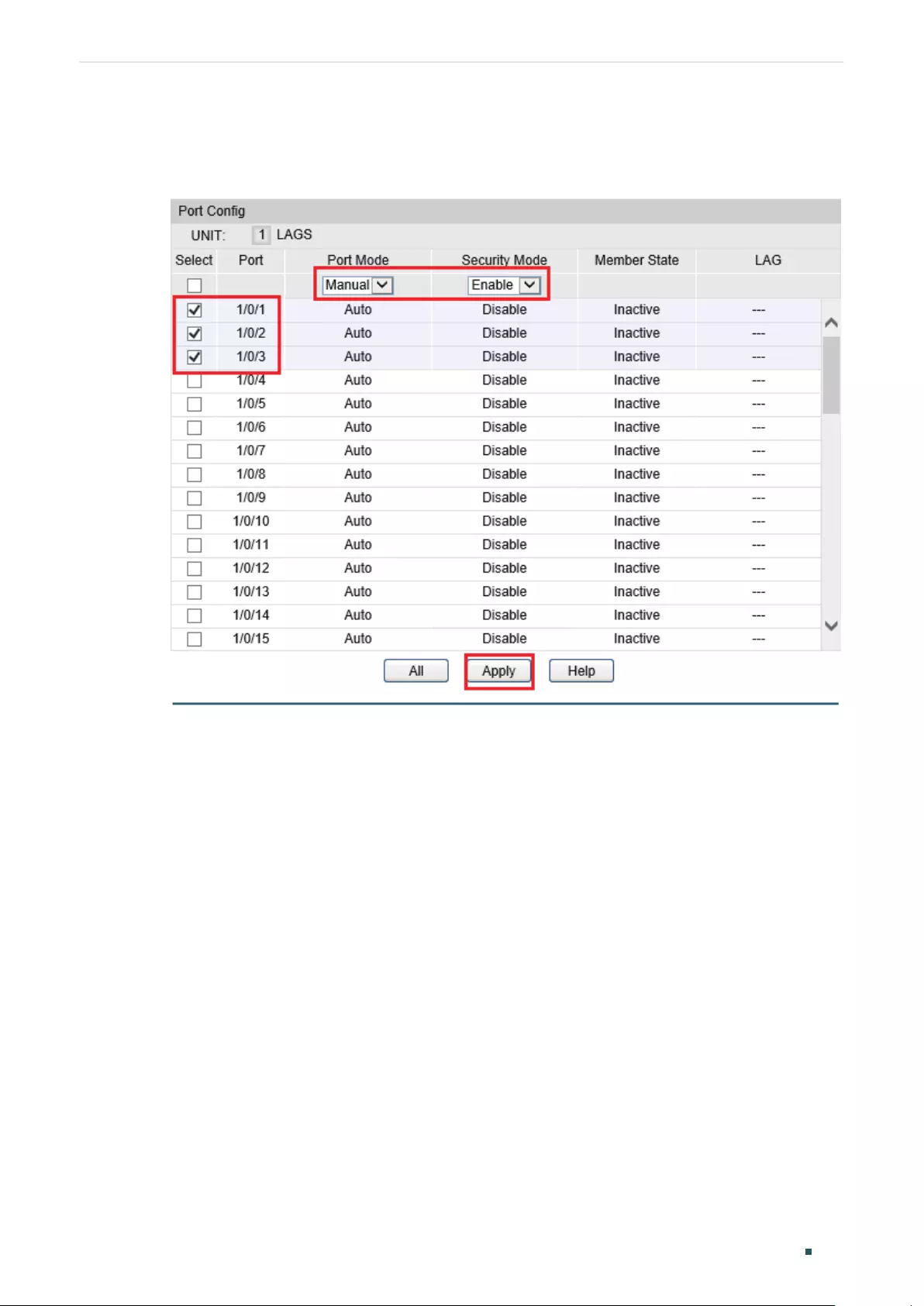
Configuring Voice VLAN Configuration Example
Configuration Guide 645
4) Choose the menu QoS > Voice VLAN > Port Config to load the following page. Select
ports 1/0/1-3, choose manual mode and enable security mode. Click Apply.
Figure 3-15 Configuring Voice VLAN Mode on Ports
5) Choose the menu VLAN > 802.1Q VLAN > VLAN Config and edit VLAN 10 to load the
following page. Add ports 1/0/1-3 to the voice VLAN. Click Apply.
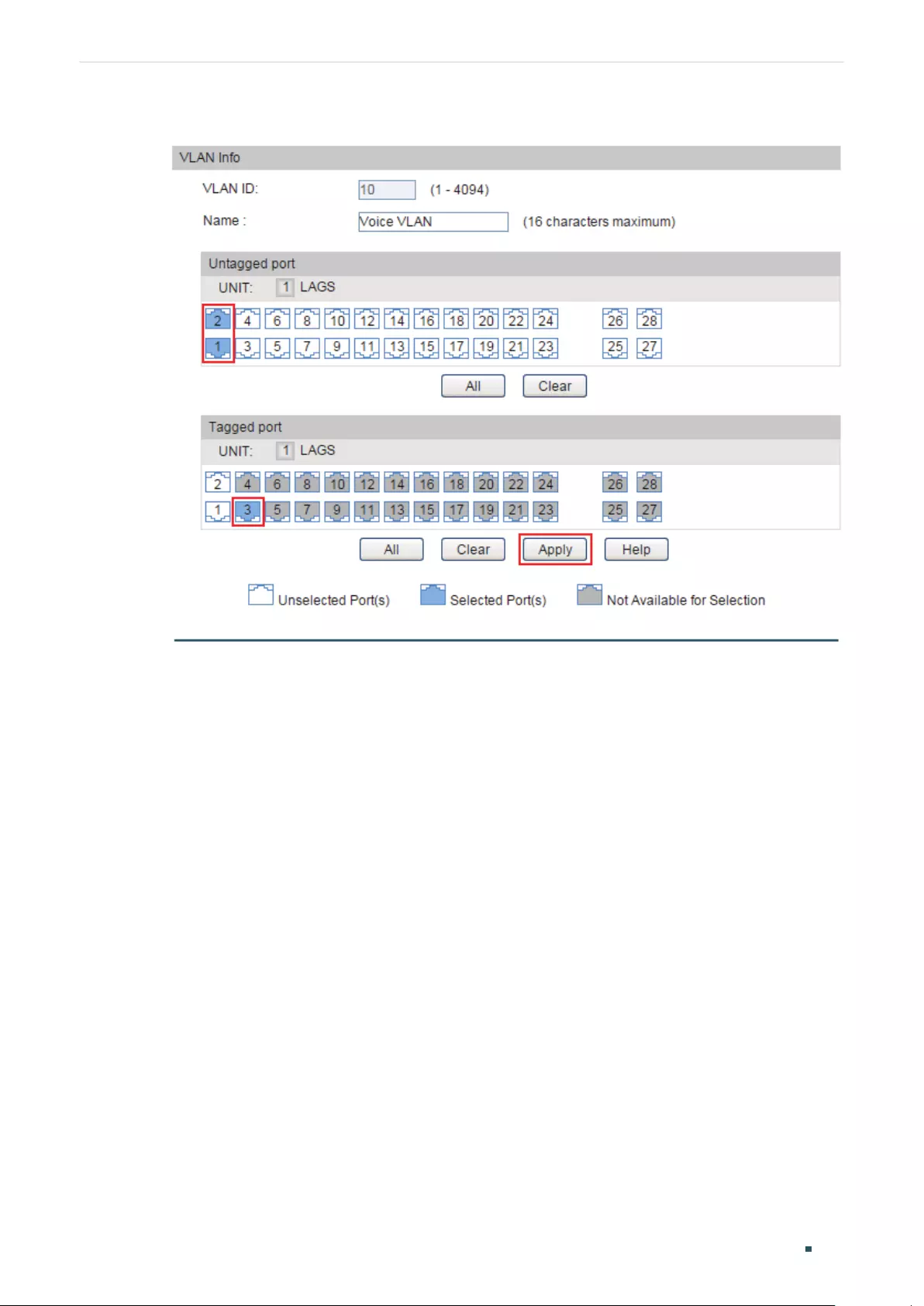
Configuration Guide 646
Configuring Voice VLAN Configuration Example
Figure 3-16 Adding Ports to the Voice VLAN
6) Click Save Config to save the settings.
Configurations for Switch C
1) Choose the menu VLAN > 802.1Q VLAN > Port Config to load the following page.
Configure the link type of ports 1/0/1-3 as General. Click Apply.
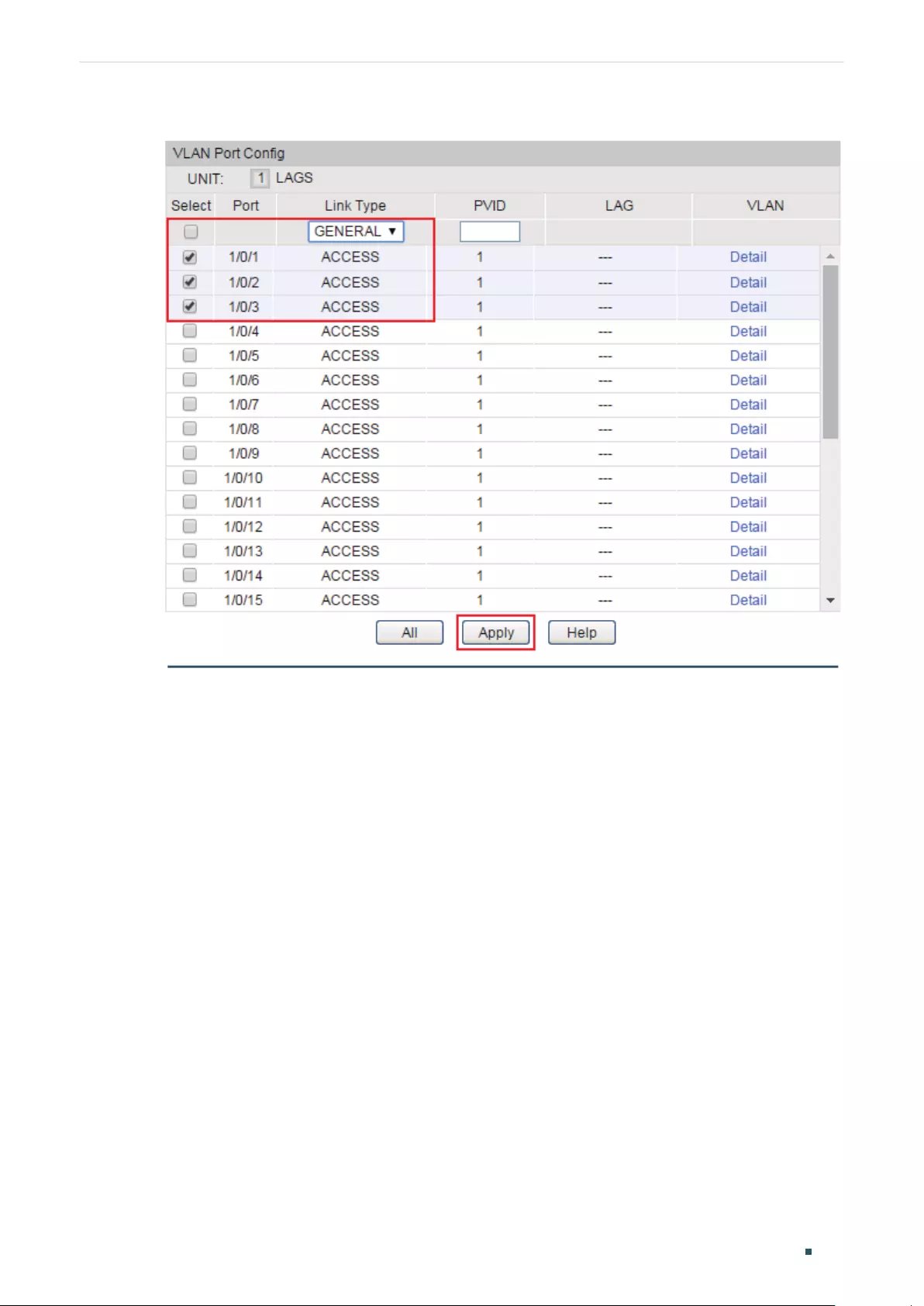
Configuring Voice VLAN Configuration Example
Configuration Guide 647
Figure 3-17 Configuring the Link Type of port 1/0/1-3
2) Choose the menu VLAN > 802.1Q VLAN > VLAN Config and click Create to load the
following page. Create VLAN 10 and add ports 1/0/1-3 as tagged ports to the VLAN.
Click Apply.

Configuration Guide 648
Configuring Voice VLAN Configuration Example
Figure 3-18 Creating a VLAN and Adding Ports to the VLAN
3) Click Save Config to save the settings.
3.5 Using the CLI
Configurations for Switch A
1) Configure the link type of ports 1/0/1-2 as General.
Switch_A#configure
Switch_A(config)#interface range gigabitEthernet 1/0/1-2
Switch_A(config-if-range)#switchport mode general
Switch_A(config-if-range)#exit
2) Create VLAN 10.
Switch_A(config)#vlan 10
Switch_A(config-vlan)#name VoiceVLAN
Switch_A(config-vlan)#exit
3) Configure the aging time as 1440 minutes for port in automatic voice VLAN mode, and
set the 802.1p priority of voice packets as 6. Set VLAN 10 as the voice VLAN.
Switch_A(config)#voice vlan aging 1440

Configuring Voice VLAN Configuration Example
Configuration Guide 649
Switch_A(config)#voice vlan priority 6
Switch_A(config)#voice vlan 10
4) Configure port 1/0/1 to automatic voice VLAN mode and enable security mode.
Switch_A(config)#interface gigabitEthernet 1/0/1
Switch_A(config-if)#switchport voice vlan mode auto
Switch_A(config-if)#switchport voice vlan security
Switch_A(config-if)#exit
5) Configure port 1/0/2 to manual voice VLAN mode, and add it to the voice VLAN as a
tagged port.
Switch_A(config)#interface gigabitEthernet 1/0/2
Switch_A(config-if)#switchport voice vlan mode manual
Switch_A(config-if)#switchport general allowed vlan 10 tagged
Switch_A(config-if)#exit
6) Enable LLDP globally and set the fast start count of LLDP-MED frame as 4.
Switch_A(config)#lldp
Switch_A(config)# lldp med-fast-count 4
7) Enable the LLDP-MED feature on port 1/0/1.
Switch_A(config)#interface gigabitEthernet 1/0/1
Switch_A(config-if)#lldp med-status
8) Select all MED TLVs to be carried in LLDP frames and sent out by port 1/0/1.
Switch_A(config-if)#lldp med-tlv-select all
9) Configure the location identification parameters for the IP phone on port 1/0/1. For
details about LLDP-MED, please refer to Configuring LLDP.
Switch(config-if)#lldp med-location civic-address language English lci-city Vancouver
street X _east_hastings_street postal-zipcode V6A1P9
Switch_A(config-if)#end
Switch_A#copy running-config startup-config
Configurations for Switch B
1) Create VLAN 10.
Switch_B#configure
Switch_B(config)#vlan 10
Switch_B(config-vlan)#name VoiceVLAN

Configuration Guide 650
Configuring Voice VLAN Configuration Example
Switch_B(config-vlan)#exit
2) Set the 802.1p priority of voice packets as 6 and VLAN 10 as the voice VLAN.
Switch_B(config)#voice vlan priority 6
Switch_B(config)#voice vlan 10
3) Configure ports 1/0/1-3 to manual voice VLAN mode and enable security mode.
Switch_B(config)#interface range gigabitEthernet 1/0/1-3
Switch_B(config-if-range)#switchport voice vlan mode manual
Switch_B(config-if-range)#switchport voice vlan security
Switch_B(config-if-range)#exit
4) For ports 1/0/1-2, set the link type as General and the egress rule as Untagged, and add
them to the Voice VLAN.
Switch_B(config)#interface range gigabitEthernet 1/0/1-2
Switch_B(config-if-range)#switchport mode general
Switch_B(config-if-range)#switchport general vlan 10 untagged
Switch_B(config-if-range)#exit
5) For ports 1/0/3, set the link type as General and the egress rule as Tagged, and add
them to the Voice VLAN.
Switch_B(config)#interface gigabitEthernet 1/0/3
Switch_B(config-if)#switchport mode general
Switch_B(config-if)#switchport general allowed vlan 10 tagged
Switch_B(config-if)#end
Switch_B#copy running-config startup-config
Configurations for Switch C
1) Create VLAN 10.
Switch_C#configure
Switch_C(config)#vlan 10
Switch_C(config-vlan)#name VoiceVLAN
Switch_C(config-vlan)#exit
2) For ports 1/0/1-3, set the link type as General and the egress rule as Tagged, and add
them to the Voice VLAN.
Switch_C(config)#interface range gigabitEthernet 1/0/1-3
Switch_C(config-if-range)#switchport mode general

Configuring Voice VLAN Configuration Example
Configuration Guide 651
Switch_C(config-if-range)#switchport general allowed vlan 10 tagged
Switch_C(config-if-range)#end
Switch_C#copy running-config startup-config
Verify the Configurations
Switch A
Verify the global configuration of voice VLAN:
Switch_A#show voice vlan
Voice VLAN status: Enabled
VLAN ID: 10
Aging Time: 1440
Voice Priority: 6
Verify the voice VLAN configuration on the ports:
Switch_A#show voice vlan switchport
Port Auto-mode Security State LAG
------ ------------ ---------- ---------- ------
Gi1/0/1 Auto Enabled Inactive N/A
Gi1/0/2 Manual Disabled Active N/A
Gi1/0/3 Auto Disabled Inactive N/A
......
Switch B
Verify the global configuration of voice VLAN:
Switch_B#show voice vlan
Voice VLAN status: Enabled
VLAN ID: 10
Aging Time: 1440
Voice Priority: 6
Verify the voice VLAN configuration on the ports:
Switch_B#show voice vlan switchport

Configuration Guide 652
Configuring Voice VLAN Configuration Example
Port Auto-mode Security State LAG
------ ---------- ------------ --------- ------
Gi1/0/1 Manual Enabled Active N/A
Gi1/0/2 Manual Enabled Active N/A
Gi1/0/3 Manual Enabled Active N/A
......
Switch C
Verify the voice VLAN configuration for VLAN 10:
Switch_C#show vlan id 10
VLAN Name Status Ports
----- ---------------- --------- ---------------------------------
10 VoiceVlan active Gi1/0/1, Gi1/0/2, Gi1/0/3

Configuring Voice VLAN Appendix: Default Parameters
Configuration Guide 653
4 Appendix: Default Parameters
Default settings of voice VLAN are listed in the following tables.
Table 4-1 Default Settings of Global Configuration
Parameter Default Setting
Voice VLAN Disable
VLAN ID None
Aging Time 1440 minutes
Priority 6
Table 4-2 Default Settings of Port Configuration
Parameter Default Setting
Port Mode Auto
Security Mode Disable
Member State Inactive
Table 4-3 Entries in the OUI Table
OUI MASK Description
00-01-e3-00-00-00 ff-ff-ff-00-00-00 Siemens Phone
00-03-6b-00-00-00 ff-ff-ff-00-00-00 Cisco Phone
00-04-0d-00-00-00 ff-ff-ff-00-00-00 Avaya Phone
00-60-b9-00-00-00 ff-ff-ff-00-00-00 Philips Phone
00-d0-1e-00-00-00 ff-ff-ff-00-00-00 Pingtel Phone
00-e0-75-00-00-00 ff-ff-ff-00-00-00 PolyCom Phone
00-e0-bb-00-00-00 ff-ff-ff-00-00-00 3Com Phone

Configuring PoE PoE
Configuration Guide 655
Note:
Only T2600G-28MPS supports PoE feature.
1 PoE
1.1 Overview
Power over Ethernet (PoE) is a remote power supply function. With this function, the switch
can supply power to the connected devices over twisted-pair cable.
Some devices such as IP phones, access points (APs) and cameras may be located far
away from the AC power source in actual use. PoE can provide power for these devices
without requiring to deploy power cables. This allows a single cable to provide both data
connection and electric power to devices.
IEEE 802.3af and 802.3at are both PoE standards. The standard process of PoE power
supply contains powered-device discovery, power administration, disconnect detection
and optional power-device power classification.
PSE
Power sourcing equipment (PSE) is a device that provides power for PDs on the Ethernet,
for example, the PoE switch. PSE can detect the PDs and determine the device power
requirements.
PD
Powered device (PD) is a device receiving power from the PSE, for example, IP phones and
access points. According to whether PDs comply with IEEE standard, they can be classified
into standard PDs and non-standard PDs. Only standard PDs can be powered via TP-Link
PoE switches.
1.2 Supported Features
PoE Power Management
PoE Power Management is used for users to manage the power the PoE switch supplied.
The PoE switch allocates the power to the PDs according to your configurations.
Time-Range Function
The time-range function is used to set the power-on and power-off time range to save
energy according to your actual use.
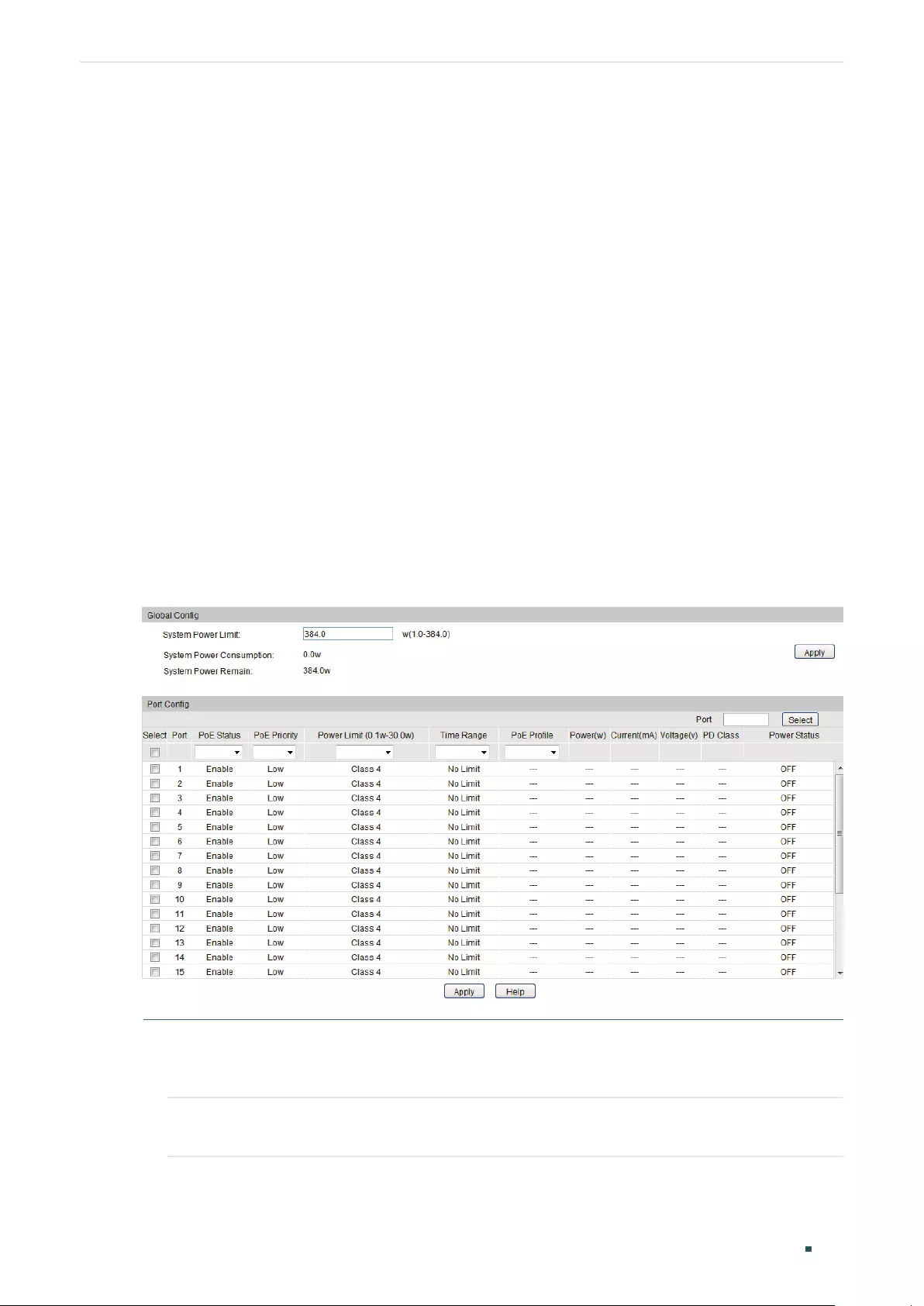
Configuration Guide 656
Configuring PoE PoE Power Management Configurations
2 PoE Power Management Configurations
With PoE Power Management, you can:
Configure the PoE parameters manually
Configure the PoE parameters using the profile
You can configure the PoE parameters one by one via configuring the PoE parameters
manually. You can also set a profile with the desired parameters and bind the profile to the
corresponding ports to quickly configure the PoE parameters.
2.1 Using the GUI
2.1.1 Configuring the PoE Parameters Manually
Choose the menu PoE > PoE Config > PoE Config to load the following page.
Figure 2-1 Configuring PoE Parameters Manually
Follow these steps to configure the basic PoE parameters:
1) In the Global Config section, specify the System Power Limit and click Apply.
System Power
Limit
Specify the maximum power the PoE switch can supply.

Configuring PoE PoE Power Management Configurations
Configuration Guide 657
System Power
Consumption
Displays the real-time system power consumption of the PoE switch.
System Power
Remain
Displays the real-time system remaining power of the PoE switch.
2) In the Port Config section, select the port you want to configure and specify the
parameters. Click Apply.
PoE Status Enable or disable the PoE function for on corresponding port. The port can supply
power to the PD when its status is enable.
PoE Priority Select the priority level for the corresponding port. When the supply power
exceeds the system power limit, the switch will power off PDs on low-priority
ports to ensure stable running of other PDs.
Power Limit
(0.1w-30.0w)
Specify the maximum power the corresponding port can supply. The following
options are provided:
Auto: The switch will allocate a value as the maximum power that the port can
supply automatically.
Class1: The maximum power that the port can supply is 4W.
Class2: The maximum power that the port can supply is 7W.
Class3: The maximum power that the port can supply is 15.4W.
Class4: The maximum power that the port can supply is 30W.
Manual: Enter a value manually.
Time Range
Select a time range, then the port will supply power only during the time range. For
how to create a time range, refer to Time Range Function Configurations.
PoE Profile
A quick configuration method for the corresponding ports. If one profile is
selected, you will not be able to modify PoE status, PoE priority or power limit
manually. For how to create a profile, refer to Configuring the PoE Parameters
Using the Profile.
Power(w)
Displays the port’s real-time power supply.
Current(mA)
Displays the port’s real-time current.
Voltage(v)
Displays the port’s real-time voltage.
PD Class
Displays the class the linked PD belongs to.
Power Status
Displays the port’s real-time power status.

Configuration Guide 658
Configuring PoE PoE Power Management Configurations
2.1.2 Configuring the PoE Parameters Using the Profile
Creating a PoE Profile
Choose the menu PoE > PoE Config > PoE Profile to load the following page.
Figure 2-2 Create a PoE Profile
Follow these steps to create a PoE profile:
1) In the Create PoE Profile section, specify the desired configurations of the profile.
Profile Name Specify a name for the PoE profile.
PoE Status Specify the PoE status for the PoE profile.
PoE Priority Specify the priority level for the PoE profile. The following options are provided:
High, Middle and Low. When the supply power exceeds the system power limit,
the switch will power off PDs on low-priority ports to ensure stable running of
other PDs.
Power Limit Specify the maximum power the port can supply for the PoE profile. The following
options are provided:
Auto: The switch will allocate a value as the maximum power that the port can
supply automatically.
Class1: The maximum power that the port can supply is 4W.
Class2: The maximum power that the port can supply is 7W.
Class3: The maximum power that the port can supply is 15.4W.
Class4: The maximum power that the port can supply is 30W.
Manual: Enter a value manually.
2) Click Apply.
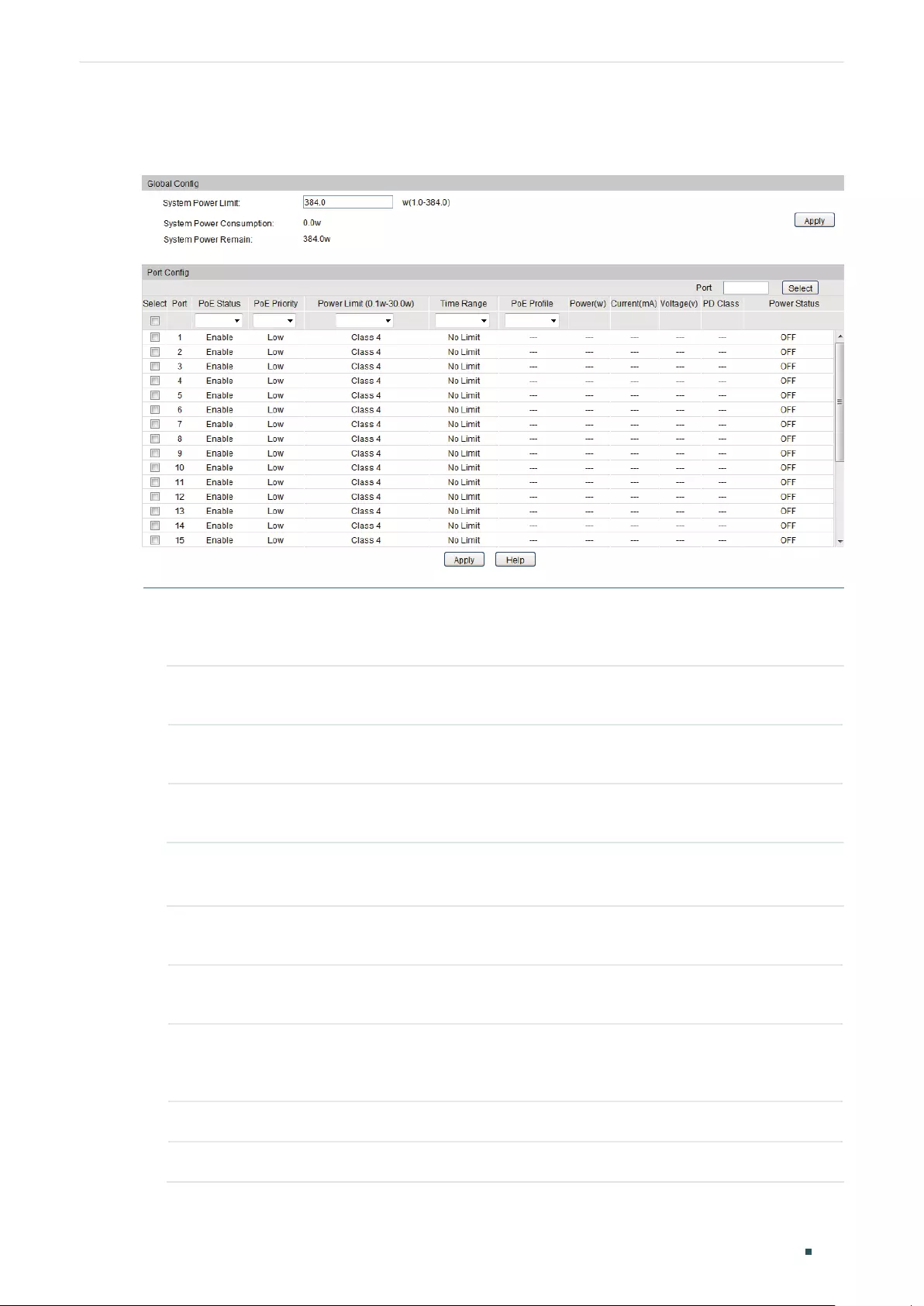
Configuring PoE PoE Power Management Configurations
Configuration Guide 659
Binding the Profile to the Corresponding Ports
Figure 2-3 Bind the Profile to the Corresponding Ports
Follow these steps to bind the profile to the corresponding ports:
1) In the Global Config section, specify the System Power Limit and click Apply.
System Power
Limit
Specify the maximum power the PoE switch can supply.
System Power
Consumption
Displays the real-time system power consumption of the PoE switch.
System Power
Remain
Displays the real-time system remaining power of the PoE switch.
2) In the Port Config section, select a profile and bind it to the corresponding ports. Click
Apply.
Port Select Specify the port number and click Select to quick-select the corresponding entry.
Only one port can be selected at a time.
Time Range
Select a time range, then the port will supply power only during the time range. For
how to create a time range, refer to Time Range Function Configurations.
PoE Profile
Select the PoE profile set in the PoE Profile section for the desired port. If one
profile is selected, you will not be able to modify PoE status, PoE priority or power
limit manually.
Power(w)
Displays the port’s real-time power supply.
Current(mA)
Displays the port’s real-time current.

Configuration Guide 660
Configuring PoE PoE Power Management Configurations
Voltage(v)
Displays the port’s real-time voltage.
PD Class
Displays the class the linked PD belongs to.
Power Status
Displays the port’s real-time power status.
2.2 Using the CLI
2.2.1 Configuring the PoE Parameters Manually
Follow these steps to configure the basic PoE parameters:
Step 1 configure
Enter global configuration mode.
Step 2 power inline consumption
power-limit
Specify the the maximum power the PoE switch can supply globally.
power-limit
: Specify the maximum power the PoE switch can supply. It ranges from 1.0 to
384.0W, and the default value is 384.0W.
Step 3 interface {
fastEthernet
port
| range fastEthernet
port-list
| gigabitEthernet
port
| range
gigabitEthernet
port-list
}
Enter Interface Configuration mode.
port
: Specify the Ethernet port number, for example 1/0/1.
port-list:
Specify the list of Ethernet ports, for example 1/0/1-3, 1/0/5.
Step 4 power inline supply { enable | disable }
Specify the PoE status for the corresponding port.
enable | disable: Enable or disable the PoE function. By default, it is enable.
Step 5 power inline priority { low | middle | high }
Specify the PoE priority for the corresponding port.
low | middle | high: Select the priority level for the corresponding port. When the supply power
exceeds the system power limit, the switch will power off PDs on low-priority ports to ensure
stable running of other PDs. The default setting is low.
Step 6 power inline consumption {
power-limit
| auto | class1 | class2 | class3 | class4 }
Specify the maximum power the corresponding port can supply.
power-limit
| auto | class1 | class2 | class3 | class4: Select or enter the maximum power the
corresponding port can supply. The following options are provided: Auto represents that
the switch will allocate the maximum power that the port can supply automatically. Class1
represents 4W, Class2 represents 7W, Class3 represents 15.4W and Class4 represents 30W,
or you can enter a value manually. The value ranges from 1 to 300. It is in the unit of 0.1 watt.
For instance, if you want to configure the maximum power as 5W, you should enter 50. By
default, it is Class4.

Configuring PoE PoE Power Management Configurations
Configuration Guide 661
Step 7 show power inline
Verify the global PoE information of the system.
Step 8 show power inline configuration interface [ fastEthernet {
port
|
port-list
} | gigabitEthernet {
port
|
port-list
}]
Verify the PoE configuration of the corresponding port.
port
: Specify the Ethernet port number, for example 1/0/1.
port-list
: Specify the list of Ethernet ports, in the format of 1/0/1-3, 1/0/5.
Step 9 show power inline information interface [ fastEthernet {
port
|
port-list
} | gigabitEthernet {
port
|
port-list
}]
Verify the real-time PoE status of the corresponding port.
port
: Specify the Ethernet port number, for example 1/0/1.
port-list
: Specify the list of Ethernet ports, in the format of 1/0/1-3, 1/0/5.
Step 10 end
Return to privileged EXEC mode.
Step 11 copy running-config startup-config
Save the settings in the configuration file.
The following example shows how to set the system power limit as 160W. Set the priority
as middle and set the power limit as class3 in the port 1/0/5.
Switch#configure
Switch(config)#power inline consumption 160
Switch(config)#interface gigabitEthernet 1/0/5
Switch(config-if)#power inline supply enable
Switch(config-if)#power inline priority middle
Switch(config-if)#power inline consumption class3
Switch(config-if)#show power inline
System Power Limit: 160.0w
System Power Consumption: 0.0w
System Power Remain: 160.0w
Switch(config-if)#show power inline configuration interface gigabitEthernet 1/0/5
Interface PoE-Status PoE-Prio Power-Limit(w) Time-Range PoE-Profile
---------- ---------- ---------- ------------ ------------- ----------------
Gi1/0/5 Enable Middle Class3 No Limit None

Configuration Guide 662
Configuring PoE PoE Power Management Configurations
Switch(config-if)#show power inline information interface gigabitEthernet 1/0/5
Interface Power(w) Current(mA) Voltage(v) PD-Class Power-Status
---------- -------- ----------- ---------- ----------- ----------------
Gi1/0/5 1.3 26 53.5 Class 2 ON
Switch(config)#end
Switch#copy running-config startup-config
2.2.2 Configuring the PoE Parameters Using the Profile
Follow these steps to configure the PoE profile:
Step 1 configure
Enter global configuration mode.
Step 2 power profile
name
[ supply { enable | disable } [ priority { low | middle | high } [ consumption {
power-limit
| auto | class1 | class2 | class3 | class4 } ] ] ]
Create a PoE profile for the switch. In a profile, the PoE status, PoE priority and power limit
are configured. You can bind a profile to the corresponding port to quickly configure the PoE
function.
name
: Specify a name for the PoE profile. It ranges from 1 to 16 characters. If the name
contains spaces, enclose the name in double quotes.
enable | disable: Specify the PoE status for the profile. By default, it is enable.
low | middle | high: Select the priority level for the profile. When the supply power exceeds the
system power limit, the switch will power off PDs on low-priority ports to ensure stable running
of other PDs.
power-limit | auto | class1 | class2 | class3 | class4: Select or enter the maximum power the
corresponding port can supply. The following options are provided: Auto represents that the
switch will assign a value of maximum power automatically. Class1 represents 4W, Class2
represents 7W, Class3 represents 15.4W and Class4 represents 30W or you can enter a value
manually. The value ranges from 1 to 300. It is in the unit of 0.1 watt. For instance, if you want to
configure the maximum power as 5W, you should enter 50.
Step 3 interface {
fastEthernet
port
| range fastEthernet
port-list
| gigabitEthernet
port
| range
gigabitEthernet
port-list
}
Enter Interface Configuration mode.
port
: Specify the Ethernet port number, for example 1/0/1.
port-list:
Specify the list of Ethernet ports, for example 1/0/1-3, 1/0/5.
Step 4 power inline profile
name
Bind a PoE profile to the desired port. If one profile is selected, you will not be able to modify
PoE status, PoE priority or power limit manually.
name
: Specify the name of the PoE profile. If the name contains spaces, enclose the name in
double quotes.

Configuring PoE PoE Power Management Configurations
Configuration Guide 663
Step 5 show power profile
Verify the defined PoE profile.
Step 6 end
Return to privileged EXEC mode.
Step 7 copy running-config startup-config
Save the settings in the configuration file.
The following example shows how to create a profile named profile1and bind the profile to
the port 1/0/6.
Switch#configure
Switch(config)#power profile profile1 supply enable priority middle consumption class2
Switch(config)#show power profile
Index Name Status Priority Power-Limit(w)
----- ------------ ---------- --------- --------------
1 profile1 Enable Middle Class2
Switch(config)#interface gigabitEthernet 1/0/6
Switch(config-if)#power inline profile profile1
Switch(config-if)#show power inline configuration interface gigabitEthernet 1/0/6
Interface PoE-Status PoE-Prio Power-Limit(w) Time-Range PoE-Profile
---------- ---------- ---------- ------------ ------------- ----------------
Gi1/0/6 Enable Middle Class2 No Limit profile1
Switch(config-if)#end
Switch#copy running-config startup-config

Configuration Guide 664
Configuring PoE Time-Range Function Configurations
3 Time-Range Function Configurations
With Time-Range configurations, you can:
Create a time-range
Configure the holiday parameters
View the time-range table
The time range here relies on the switch system clock; therefore, you need a reliable clock
source. We recommend that you use Network Time Protocol (NTP) to synchronize the
switch clock. For details, refer to System Info Configurations in Managing System.
3.1 Using the GUI
3.1.1 Creating a Time-Range
Choose the menu PoE > Time-Range > Time-Range Create to load the following page.
Figure 3-1 Creating a Time-Range
Follow these steps to create a time-range:
1) In the Time Range Config section, enter a name for the time-range and select to
include or exclude the holiday in the time-range.
Name Specify a name for the time-range.
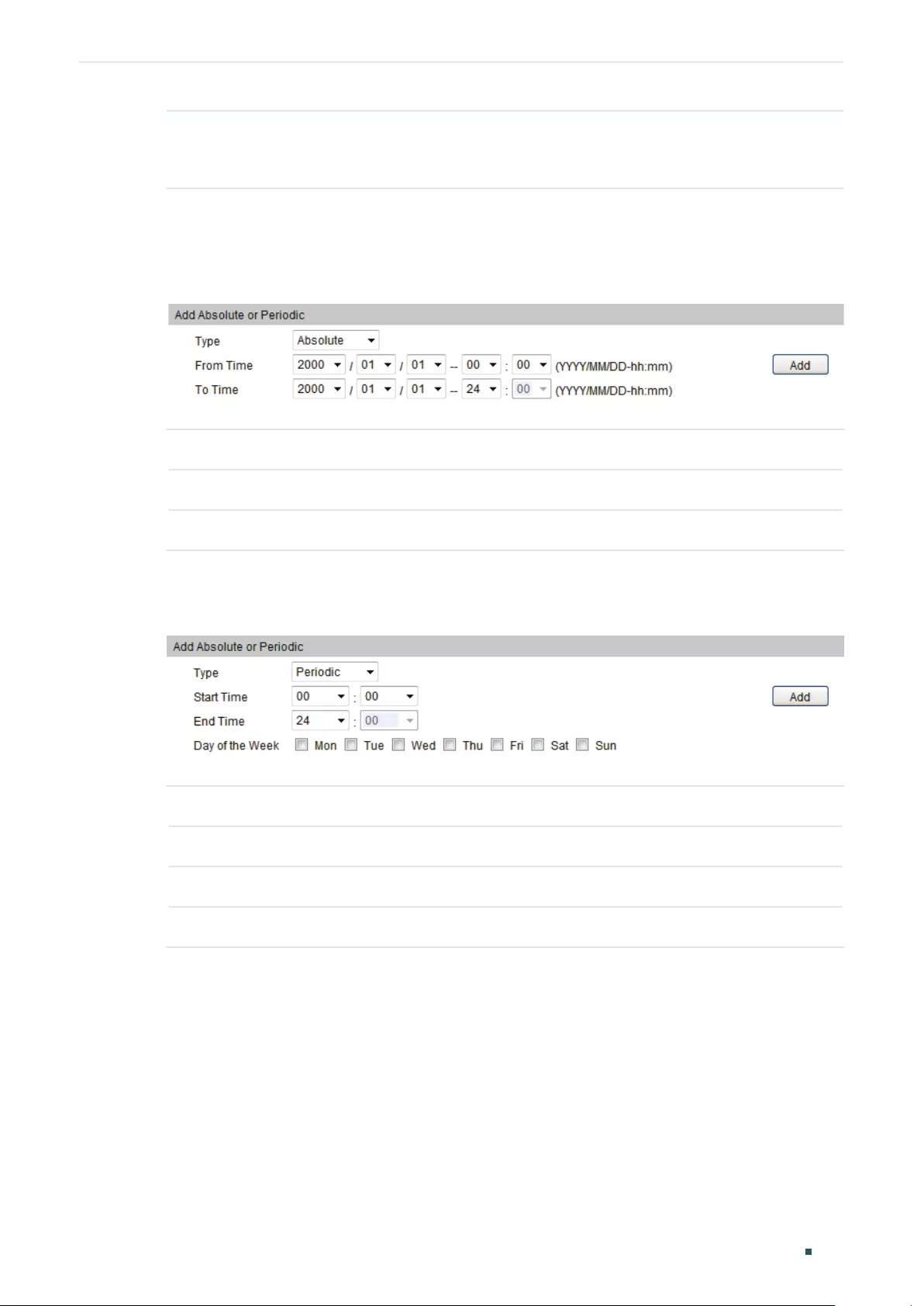
Configuring PoE Time-Range Function Configurations
Configuration Guide 665
Holiday Select to Include or Exclude the holiday in a time-range. If Exclude is selected,
the time-range will not take effect on holiday and the PoE Status is disabled.
Otherwise, the time-range will not be affected by holiday.
2) In the Add Absolute or Periodic section, specify the parameters and click Add.
When the Absolute mode is selected, the following section will be shown.
Figure 3-2 Absolute Mode
Type Select Absolute time to configure.
From Time Specify the starting time of the absolute mode.
To Time Specify the ending time of the absolute mode.
When the Periodic mode is selected, the following section will be shown.
Figure 3-3 Periodic Mode
Type Select Periodic time to configure.
Start Time Specify the start time of the periodic mode.
End Time Specify the end time of the periodic mode.
Day of the Week Select day of the week for the periodic mode.
3) Click Apply.
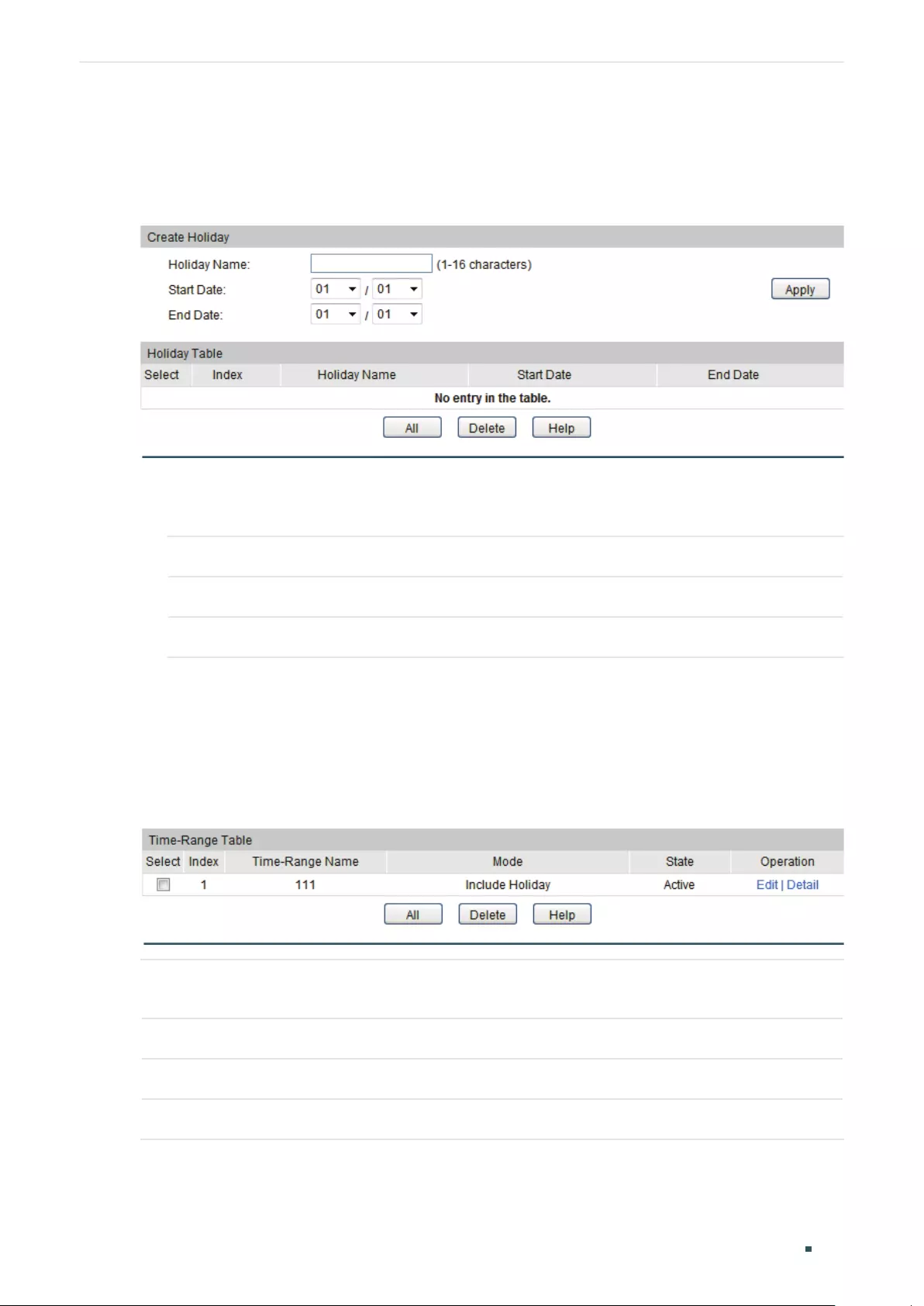
Configuration Guide 666
Configuring PoE Time-Range Function Configurations
3.1.2 Configuring the Holiday Parameters
Choose the menu PoE > Time-Range > Holiday Config to load the following page.
Figure 3-4 Configuring the Holiday Parameters
Follow these steps to configure the holiday parameters:
1) In the Create Holiday section, enter a name of the holiday and specify the time.
Holiday Name Specify a name for the holiday time.
Start Date Specify the starting time of the holiday.
End Date Specify the ending time of the holiday.
2) Click Apply.
3.1.3 Viewing the Time-Range Table
Choose the menu PoE > Time-Range > Time-Range Summary to load the following page.
Figure 3-5 Viewing the Time-Range Table
Time-Range
Name
Displays the name of the PoE time-range.
Mode Displays the work mode of the time-range function.
State Displays the state of the time-range function.
Operation View or edit the configuration of the time-range function.

Configuring PoE Time-Range Function Configurations
Configuration Guide 667
3.2 Using the CLI
3.2.1 Configuring a Time-Range
Follow these steps to create a time-range:
Step 1 configure
Enter global configuration mode.
Step 2 power time-range
name
Create a time-range for the switch and enter Power Time-range Configuration Mode.
name
: Specify a name for the PoE time-range. It ranges from 1 to 16 characters. If the name
contains spaces, enclose the name in double quotes.
Step 3 holiday { exclude | include }
Specify the time-range including or excluding the holiday.
exclude | include: Select to Include or Exclude the holiday in a time-range. If Exclude is
selected, the time-range will not take effect on holiday and the PoE Status is disabled.
Otherwise, the time-range will not be affected by holiday. By default, it is include.
Step 4 Use the following command to create a absolute time-range:
absolute from
start-date
to
end-date
Specify the time range in absolute mode.
start-date
: Specify the starting time of the time-range in absolute mode. It is in the format of
MM/DD/YYYY-HH:MM. By default, it is 2000/01/01-00:00.
end-date
: Specify the ending time of the time-range in absolute mode. It is in the format of MM/
DD/YYYY-HH:MM. By default, it is 2099/12/31-24:00.
Use the following command to create a periodic time-range:
periodic start
start-time
end
end-time
day-of-the-week
day-of-the-week
Specify the time range in periodic mode.
start-time
: Specify the starting time in periodic mode. It is in the format of HH:MM. By default, it
is 00:00.
end-time
: Specify the ending time in periodic mode. It is in the format of HH:MM. By default, it is
24:00.
day-of-the-week
: Specify the day in the week in periodic mode, ranging from 1 to 7. It is in the
format of 1,3-4. By default, it is 1-7.
Step 5 exit
Exit Power Time-range Configuration Mode.

Configuration Guide 668
Configuring PoE Time-Range Function Configurations
Step 6 interface {
fastEthernet
port
| range fastEthernet
port-list
| gigabitEthernet
port
| range
gigabitEthernet
port-list
}
Enter Interface Configuration mode.
port
: Specify the Ethernet port number, for example 1/0/1.
port-list:
Specify the list of Ethernet ports, for example 1/0/1-3, 1/0/5.
Step 7 power inline time-range
name
Bind a time-range to the desired port.
name
: Specify the name of the PoE time-range.
Step 8 show power time-range
[
name
]
Verify the configuration of the time-range.
name
: Specify the name of the desired holiday. It ranges from 1 to 16 characters. If the name
contains spaces, enclose the name in double quotes. All PoE time-range configurations will be
displayed if the name is not specified.
Step 9 end
Return to privileged EXEC mode.
Step 10 copy running-config startup-config
Save the settings in the configuration file.
The following example shows how to create a time-range named time-range1. Select
include to make the settings take affected on holiday. Set absolute mode from 2016/09/08-
00:00 to 2016/09/10-24:00. Set the periodic mode from 01:00 to 23:00 in Friday. Bind the
time-range to the port 1/0/7.
Switch#configure
Switch(config)#power time-range time-range1
Switch(config-time-range)#holiday include
Switch(config-time-range)#absolute from 09/08/2016-00:00 to 09/10/2016-24:00
Switch(config-time-range)#periodic start 01:00 end 23:00 day-of-the-week 5
Switch(config-time-range)#exit
Switch(config)#show power time-range time-range1
Time-range entry: time-range1 (Active)
holiday: include
number of absolute time: 1
1 - 09/08/2016-00:00 to 09/10/2016-24:00
number of periodic time: 1
1 - 01:00 to 23:00 on 5

Configuring PoE Time-Range Function Configurations
Configuration Guide 669
Switch(config)#interface gigabitEthernet 1/0/7
Switch(config-if)#power inline time-range time-range1
Switch(config-if)#end
Switch#copy running-config startup-config
3.2.2 Configuring the Holiday Parameters
Follow these steps to configure the holiday parameters:
Step 1 configure
Enter global configuration mode.
Step 2 power holiday
name
start-date
start-date
end-date
end-date
Create a time range for the holiday.
name
: Specify a name for the holiday. It ranges from 1 to 16 characters. If the name contains
spaces, enclose the name in double quotes.
start-date
: Specify the starting time of the holiday in the format of MM/DD.
end-date
: Specify the ending time of the holiday in the format of MM/DD.
Step 3 show power holiday
Verify the defined PoE holiday.
Step 4 end
Return to privileged EXEC mode.
Step 5 copy running-config startup-config
Save the settings in the configuration file.
The following example shows how to create a holiday named holiday1. Set the starting date
as 08/16, set the ending date as 08/20.
Switch#configure
Switch(config)#power holiday holiday1 start-date 08/16 end-date 08/20
Switch(config)#show power holiday
Index Holiday Name Start-End
----- ------------ ---------------
1 holiday1 08.16-08.20
Switch(config)#end
Switch#copy running-config startup-config

Configuration Guide 670
Configuring PoE Time-Range Function Configurations
3.2.3 Viewing the Time-Range Table
On privileged EXEC mode or any other configuration mode, you can use the following
command to view the time-range table:
show power time-range
[
name
]
Verify the defined PoE time-range.
name
: Specify the name of the time-range desired. It ranges from 1 to 16 characters. If the name contains
spaces, enclose the name in double quotes. All PoE time-range configurations will be displayed if the name
is not specified.
The following example shows how to view the time-range table.
Switch#show power time-range
Time-range entry: office time (Active)
holiday: include
number of absolute time: 0
(01/01/2000-00:00 to 12/31/2099-24:00 by default)
number of periodic time: 1
1 - 08:30 to 18:00 on 1,2,3,4,5
Switch#end
Switch#copy running-config startup-config

Configuring PoE Example for PoE Configurations
Configuration Guide 671
4 Example for PoE Configurations
4.1 Network Requirements
The network topology of a company is shown below. Camera1 and Camera2 work for the
security of the company and cannot be power off all the time. AP1 and AP2 provide Internet
service and only work in the daytime.
Figure 4-1 Network Topology
Gi1/0/1
Gi1/0/2 Gi1/0/3
Gi1/0/4
Camera1 Camera2 AP1 AP2
Switch A
4.2 Configuring Scheme
To implement this requirement, you can set a PoE time-range as the office time for
example from 08:30 to 18:00. You can also set a holiday and make the time-range settings
not be affected on holiday. Then apply the settings to port 1/0/3 and 1/0/4. Port 1/0/1 and
1/0/2 need to supply power all the time, so the time range configurations can be left at the
default settings here.
4.3 Using the GUI
The configurations of Port1/0/4 is similar with the configuration of port 1/0/3. Here we take
port 1/0/3 for example.
1) Choose the menu PoE > Time-Range > Time-Range Create to load the following page.
Specify a name for the time-range and select Exclude to make the time-range settings
not be affected on holiday. Set the time-range as periodic mode and add a time range
that is from 08:30 to 18:00. Click Apply.
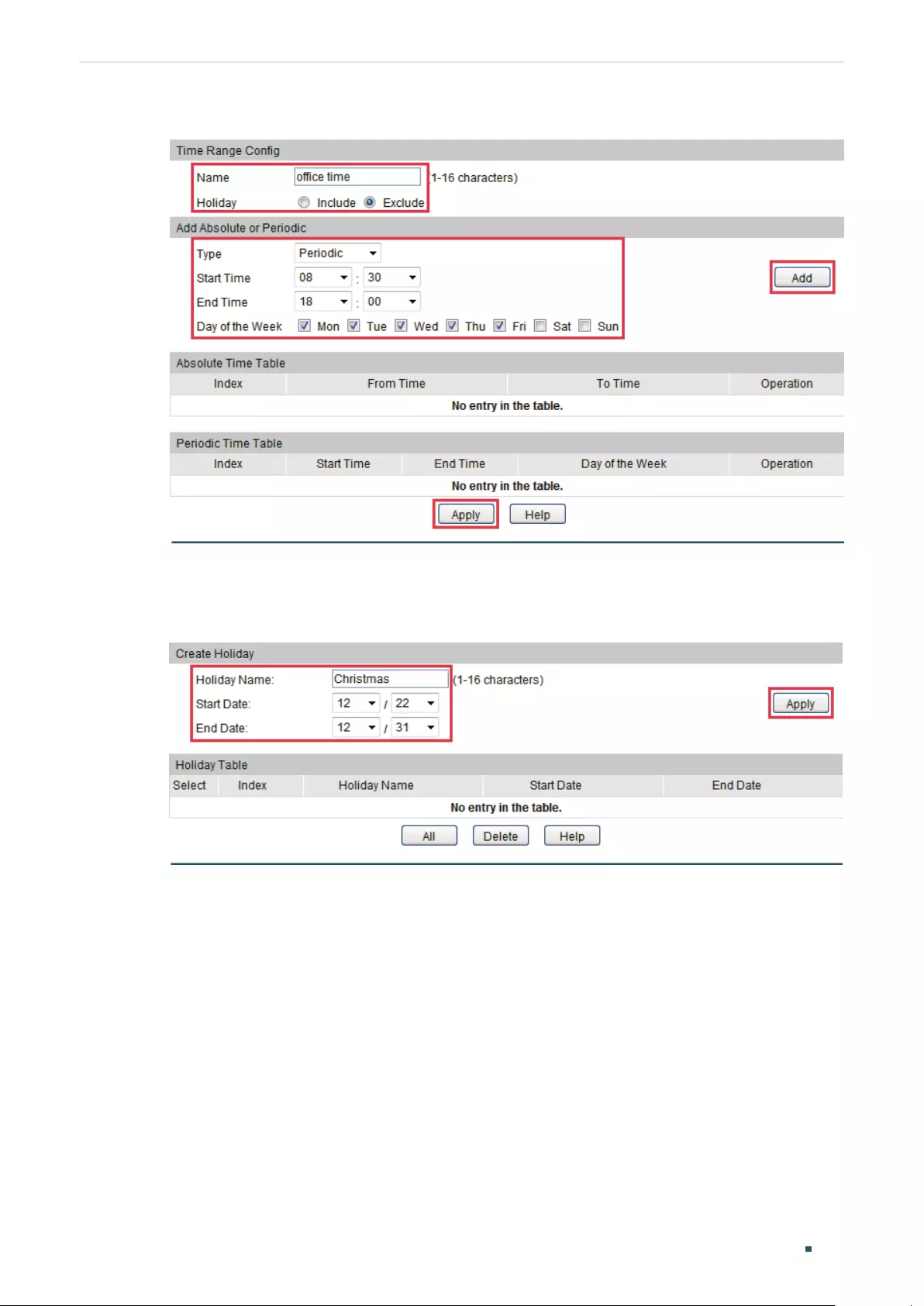
Configuration Guide 672
Configuring PoE Example for PoE Configurations
Figure 4-2 Create a Time-Range
2) Choose the menu PoE > Time-Range > Holiday Config to load the following page.
Specify a name for the holiday and set the starting date and ending date.
Figure 4-3 Configure the Holiday
3) Choose the menu PoE > PoE Config > PoE Config to load the following page. Select
port 1/0/3 and enable the PoE function. Set the Time Range as office time. Click Apply.
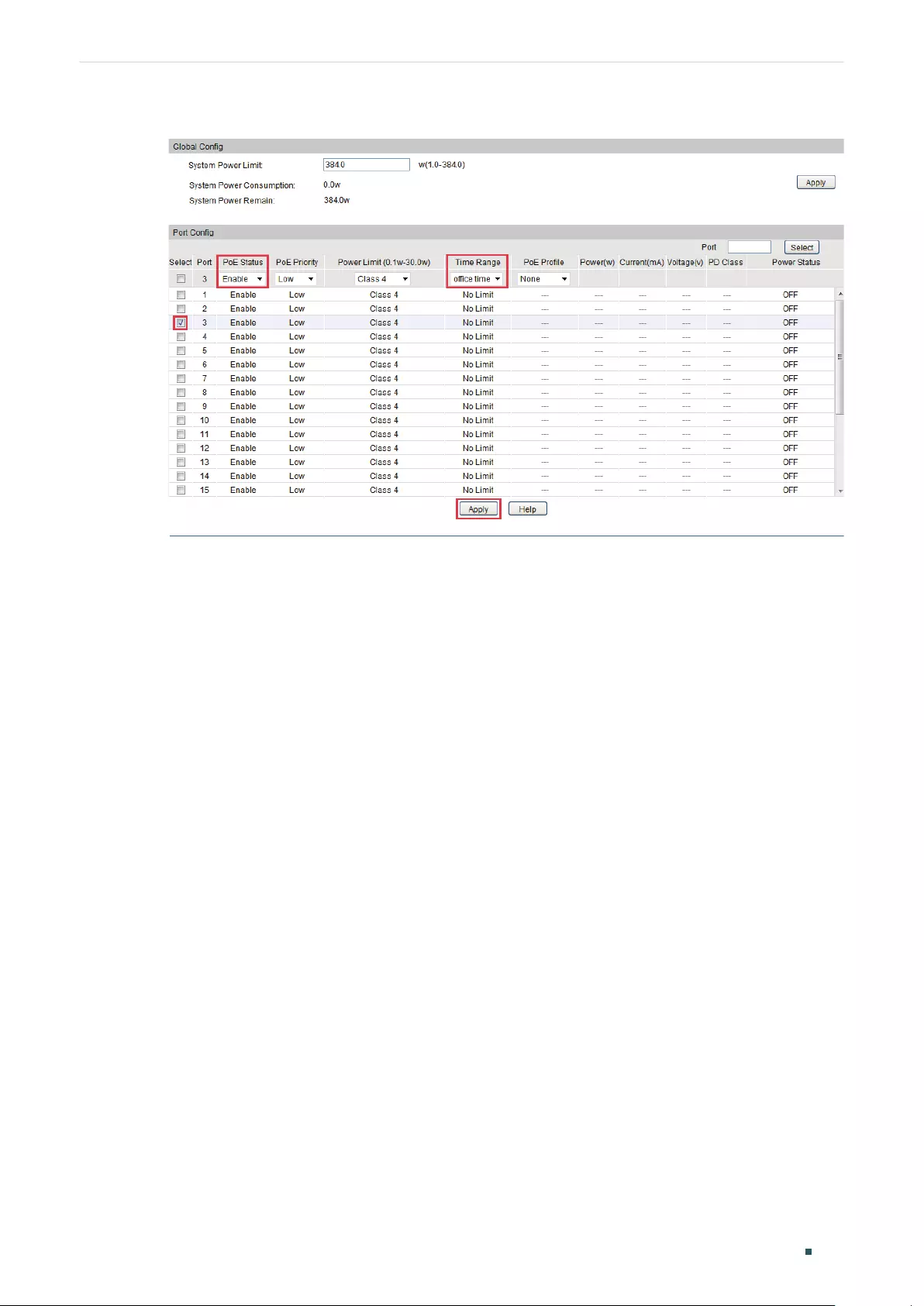
Configuring PoE Example for PoE Configurations
Configuration Guide 673
Figure 4-4 Configure the Port
4.4 Using the CLI
The configurations of Port1/0/4 is similar with the configuration of port 1/0/3. Here we take
port 1/0/3 for example.
1) Create a time-range.
Switch_A#config
Switch_A(config)#power time-range “office time”
Switch_A(config-time-range)#holiday exclude
Switch_A(config-time-range)#periodic start 08:30 end 23:00 day-of-the-week 1-5
Switch_A(config-time-range)#exit
2) Create a holiday.
Switch_A(config)#power holiday Christmas start-date 12/22 end-date 12/31
3) Enable the PoE function on the port 1/0/3. Specify the basic parameters for the port
1/0/3 and bind the time-range “office time” to the port.
Switch_A(config)#interface gigabitEthernet 1/0/3
Switch_A(config-if)#power inline supply enable
Switch_A(config-if)#power inline time-range “office time”
Switch_A(config-if)#exit
Switch_A(config-if)#end

Configuration Guide 674
Configuring PoE Example for PoE Configurations
Switch_A#copy running-config startup-config
Verify the Configuration
Verify the configuration of the holiday:
Switch_A(config)#show power holiday
Index Holiday Name Start-End
----- ------------ ---------
1 Christmas 12.22-12.31
Verify the configuration of the time-range:
Switch_A(config)#show power time-range
Time-range entry: office time (Active)
holiday: exclude
number of absolute time: 0
(01/01/2000-00:00 to 12/31/2099-24:00 by default)
number of periodic time: 1
1 - 08:30 to 23:00 on 1,2,3,4,5
Verify the configuration of the PoE basic parameters:
Switch_A(config)#show power inline configuration interface gigabitEthernet 1/0/3
Interface PoE-Status PoE-Prio Power-Limit(w) Time-Range PoE-Profile
---------- ---------- -------- -------------- ------------- ----------------
Gi1/0/3 Enable Low Class4 office time None

Configuring PoE Appendix: Default Parameters
Configuration Guide 675
5 Appendix: Default Parameters
Table 5-1 Default Settings of PoE Configuration
Parameter Default Setting
System Power Limit 384.0W
PoE Status Enable
PoE Priority Low
Power Limit (0.1w-30.0w) Class 4
Time Range No Limit
PoE Profile None
Table 5-2 Default Settings of PoE Profile
Parameter Default Setting
Profile Name None
PoE Status Enable
PoE Priority High
Power Limit Auto
Table 5-3 Default Settings of Time-Range Create
Parameter Default Setting
Name None
Holiday Include
Type Absolute
From Time 01/01/2000-00:00
To Time 01/01/2000-24:00
Table 5-4 Default Settings of Holiday Config
Parameter Default Setting
Holiday Name None
Start Date 01/01
End Date 01/01

Configuring ACL Overview
Configuration Guide 677
1 Overview
1.1 Introduction
The rapid growth of network size and traffic brings challenges to network security and
bandwidth allocation. Packet filtering can help prevent unauthorized access behaviors, limit
network traffic and improve bandwidth use.
ACL (Access Control List) filters traffic as it passes through a switch, and permits or denies
packets crossing specified interfaces or VLANs. It accurately identifies and processes
the packets based on the ACL rules. In this way, ACL helps to limit network traffic, manage
network access behaviors, forward packets to specified ports and more.
It is usually applied in the following situations:
To prevent various network attacks, such as attacks on IP (Internet Protocol), TCP
(Transmission Control Protocol), and ICMP (Internet Control Message Protocol) packets.
To manage network access behaviors, such as controlling access to a network or to
specific resources on your network.
To limit network traffic and improve network performance by, for example, controlling
the uploading and downloading bandwidth.
1.2 Supported Features
»ACL Binding
To“permit” or “deny” received packets, bind the ACL to a port or a VLAN so that the ACL
takes effect on the port or VLAN. The packets that match a permit rule or deny rule will be
forwarded or dropped.
»Policy Binding
Configure Policy if you need to further process the matched packets, through operations
such as mirroring, rate-limiting, redirecting, or changing priority. The Policy takes effect
after it is bound to a port or a VLAN.

Configuration Guide 678
Configuring ACL ACL Configuration
2 ACL Configuration
To configure ACL Binding, follow these steps:
1) Configure a time-range during which the ACL is in effect.
2) Create a Policy and configure the policy action for packets that match the ACL rule.
3) Bind the ACL to a port or VLAN to make it effective.
To configure Policy Binding, follow these steps:
1) Configure a time-range during which the ACL takes effect.
2) Create an ACL and configure the rules to filter different packets.
3) Create a Policy and configure the policy action for packets that match the ACL rule.
4) Bind the Policy to a port or VLAN to make it effective.
Configuration Guidelines
A packet “matches” an ACL rule when it meets the rule’s matching criteria. The resulting
action will be either to “permit” or “deny”the packet that matches the rule.
If no ACL rule is configured or no matching rule is found, the packets will be forwarded
without being processed by the ACL.
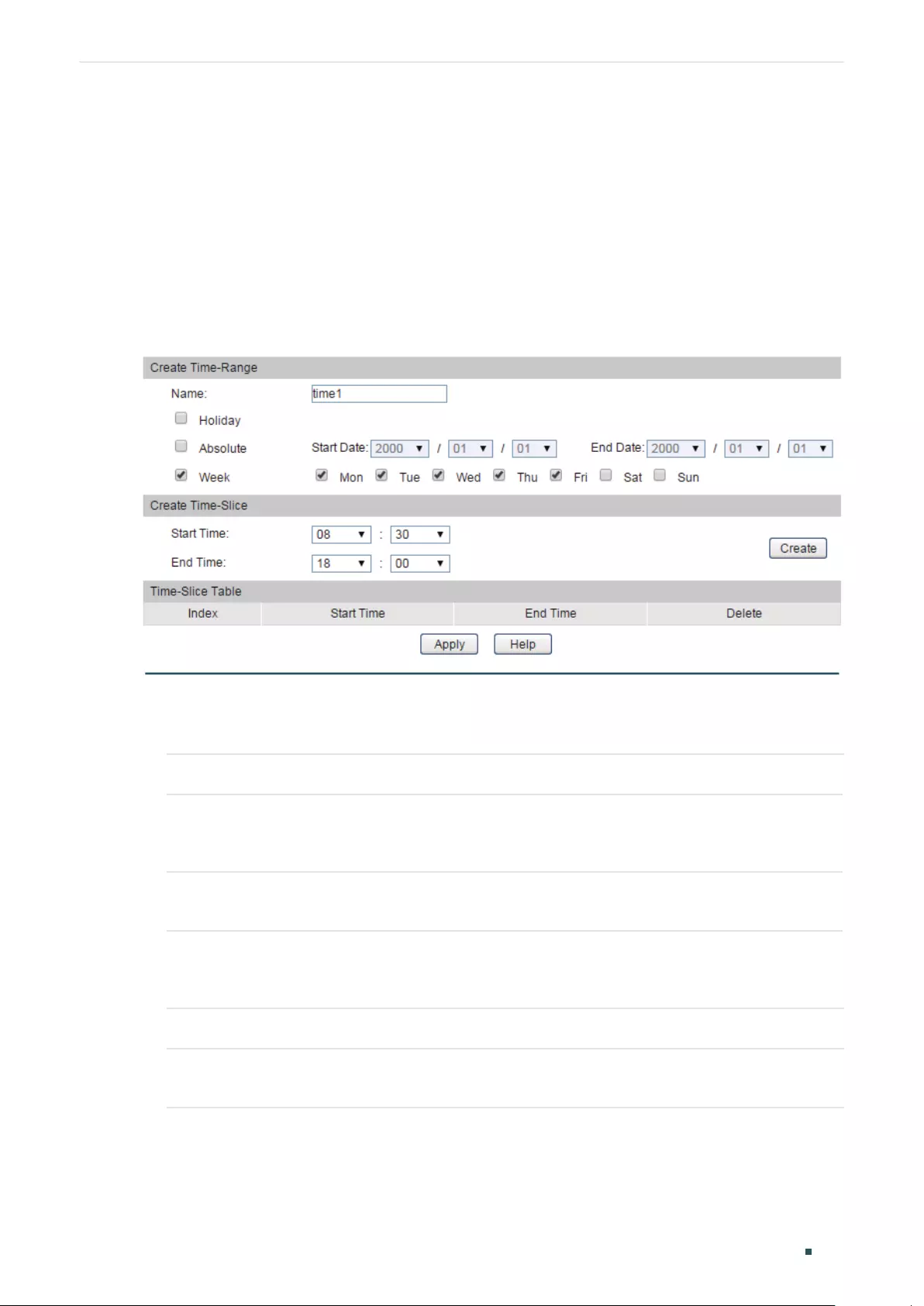
Configuring ACL ACL Configuration
Configuration Guide 679
2.1 Using the GUI
2.1.1 Configuring Time-Range
Some ACL-based services or features may need to be limited to take effect only during a
specified time period. In this case, you can configure time-range for the ACL.
Choose the menu ACL > Time-Range > Time-Range Create to load the following page.
Figure 2-1 Creating the Time-Range
Follow these steps to create the time-range:
1) In the Create Time-Range section, assign a name to the time-range, and then select a mode.
Name Specify the name of the time-range.
Holiday Configure time-range in Holiday mode. In this mode, the corresponding ACL
rule takes effect only when the system date falls within the specified holiday
time. For details, refer to Configuring Holiday
Absolute Configure time-range in Absolute mode. In this mode, you can configure an
absolute date range during which the corresponding ACL rule will take effect.
Week Configure time-range in Week mode. In this mode, you can configure a cycle
time range so the corresponding ACL rule will take effect on certain days
each week.
2) In the Create Time-Slice section, configure the start and end time, then click Create.
Start Time / End
Time
Enter the start and end time of a time-slice so that this ACL rule will take
effect during specified time periods in the day.
3) Click Apply to make the settings effective.

Configuration Guide 680
Configuring ACL ACL Configuration
2.1.2 (Optional) Configuring Holiday
In Holiday mode, you need to configure specific dates for the holidays.
Choose the menu ACL > Time-Range > Holiday Create to load the following page.
Figure 2-2 Configuring the Holiday
Follow these steps to configure the holiday:
1) In the Create Holiday section, configure the start and end date, and assign a name to
the holiday.
Start Date / End Date Specify the start and end date of the holiday
2) Click Apply to make the settings effective.
2.1.3 Creating an ACL
You can create different types of ACL and define the rules based on source MAC or IP
address, destination MAC or IP address, protocol type, port number and so on.
MAC ACL: MAC ACL uses source and destination MAC address for matching operations.
Standard-IP ACL: Standard-IP ACL uses source and destination IP address for matching
operations.
Extended-IP ACL: Extended-IP ACL uses source and destination IP address, IP protocols
and so on for matching operations.
Combined ACL: Combined ACL uses source and destination MAC address, and source
and destination IP address for matching operations.
IPv6 ACL: IPv6 ACL uses source and destination IPv6 address for matching operations.
Packet Content ACL: Packet Content ACL analyzes and processes data packets based on
4 chunk match conditions, each chunk can specify a user-defined 4-byte segment carried
in the packet’s first 128 bytes.
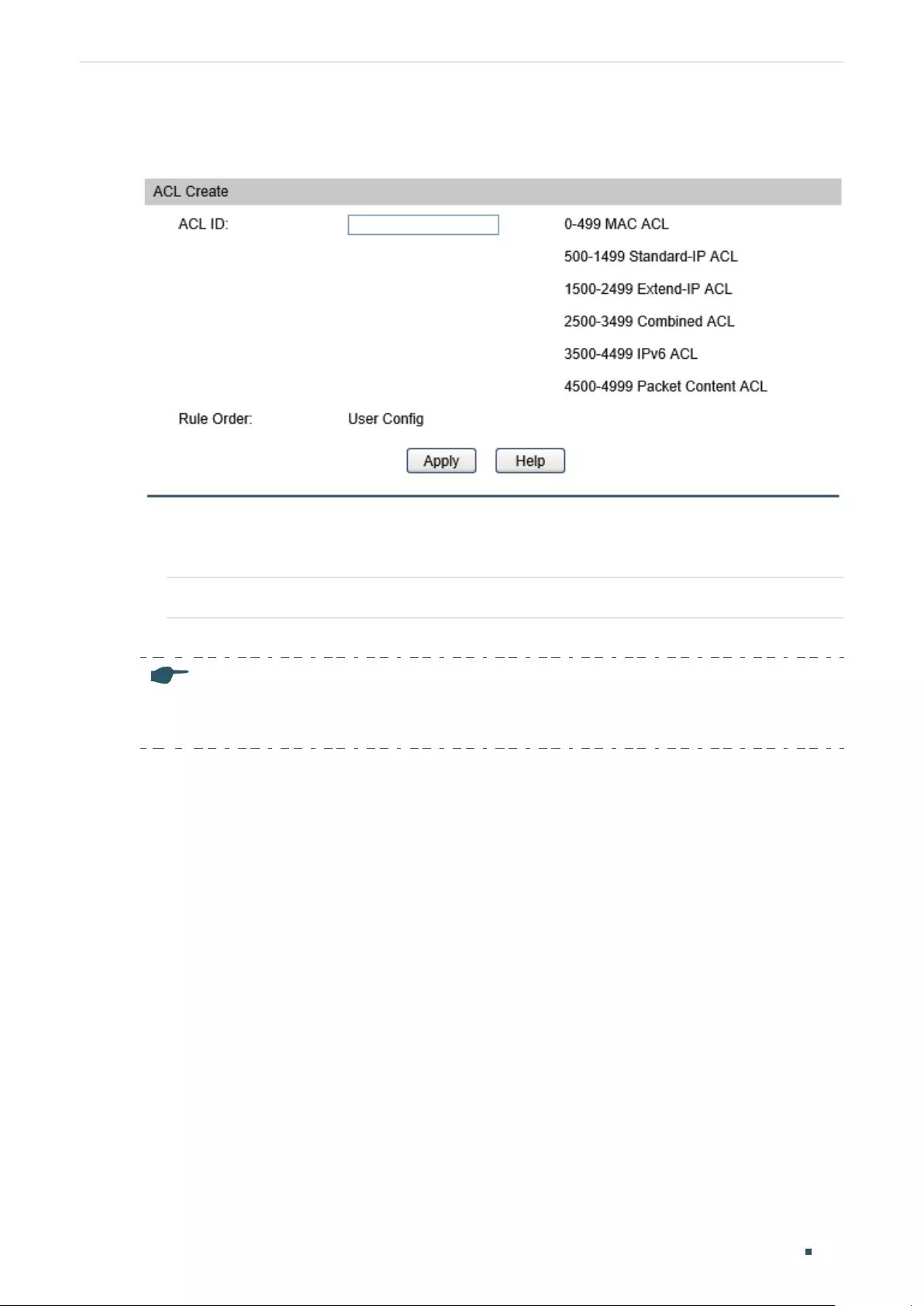
Configuring ACL ACL Configuration
Configuration Guide 681
Choose the menu ACL > ACL Config > ACL Create to load the following page.
Figure 2-3 Creating an ACL
Follow these steps to create an ACL:
1) In the ACL Create section, assign a name to the ACL.
ACL ID Enter a number to identify the ACL
2) Click Apply to make the settings effective.
Note:
The supported ACL type and ID range varies on different switch models. Please refer to the on-
screen information.

Configuration Guide 682
Configuring ACL ACL Configuration
2.1.4 Configuring ACL Rules
Add rules to the ACL. For details, refer to MAC ACL Rule, Standard-IP ACL Rule, Extend-IP
ACL Rule Combined ACL Rule, IPv6 ACL Rule and Packet Content ACL Rule.
Configuring the MAC ACL Rule
Choose the menu ACL > ACL Config > MAC ACL to load the following page.
Figure 2-4 Creating the MAC ACL
Follow these steps to create the MAC ACL:
1) Select an MAC ACL ID from the drop-down list, enter a Rule ID, then specify the operation for the
matched packets.
ACL ID Select an MAC ACL from the drop-down list.
Rule ID Enter an ID number to identify the rule.
It should not be the same as any existing MAC ACL Rule IDs.
Operation Select an action to be taken when a packet matches the rule.
Permit: To forward the matched packets.
Deny: To discard the matched packets.
2) Define the rule’s packet-matching criteria.
S-MAC/Mask Enter the source MAC address with a mask. A value of 1 in the mask indicates
that the corresponding bit in the address will be matched.
D-MAC/Mask Enter the destination IP address with a mask. A value of 1 in the mask
indicates that the corresponding bit in the address will be matched.
VLAN ID Enter the ID number of the VLAN to which the ACL will apply.
EtherType Specify the EtherType to be matched using 4 hexadecimal numbers.
User Priority Specify the User Priority to be matched..
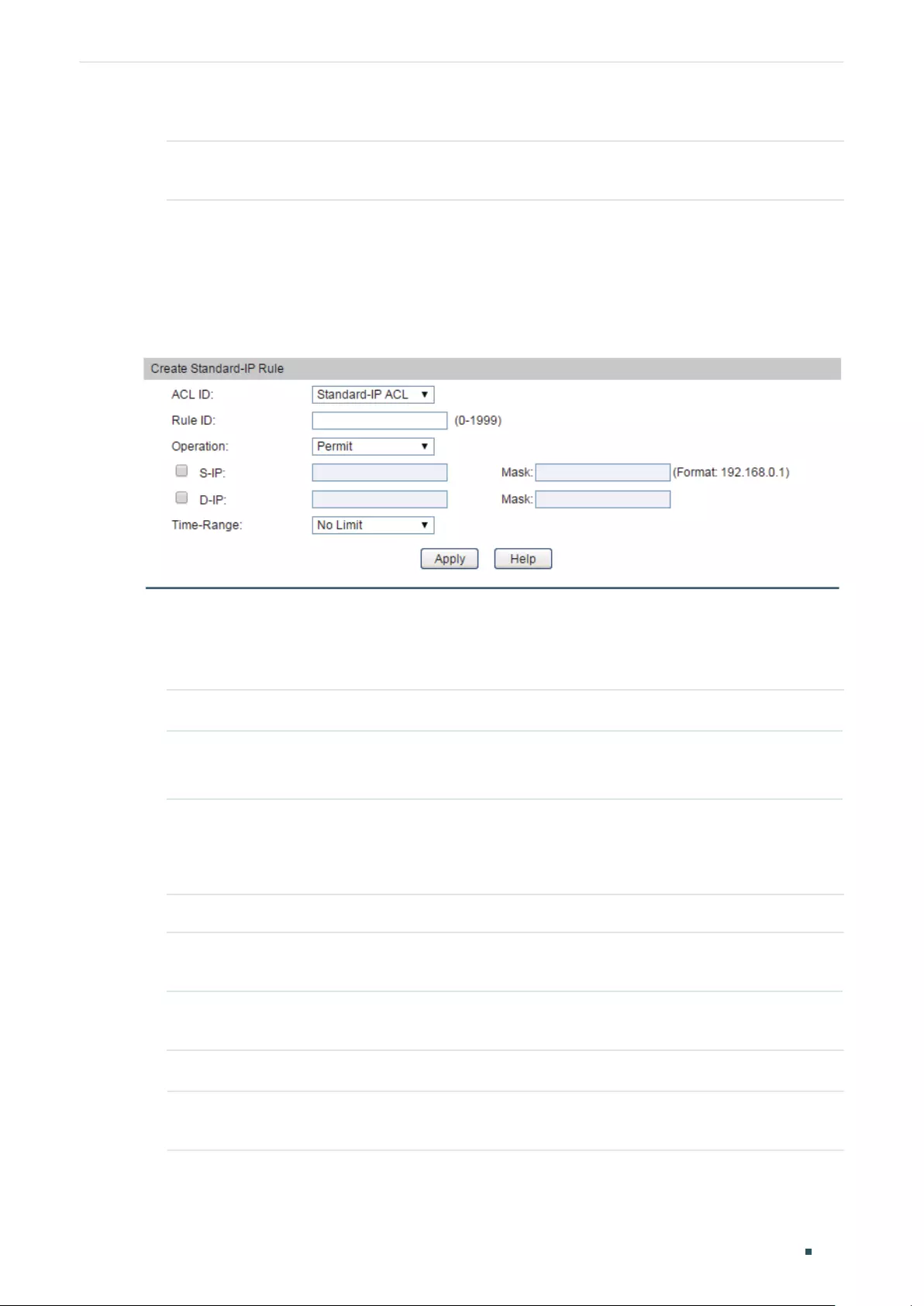
Configuring ACL ACL Configuration
Configuration Guide 683
3) (Optional)Select a time-range from the drop-down list.
Time-Range Select a time-range during which the rule will take effect. The default value is
No Limit, which means the rule is always in effect..
4) Click Apply to make the settings effective.
Configuring the Standard-IP ACL Rule
Choose the menu ACL > ACL Config > Standard-IP ACL to load the following page.
Figure 2-5 Creating the Standard-IP ACL Rule
Follow these steps to create the Standard-IP ACL:
1) Select a Standard-IP ACL ID from the drop-down list, enter a Rule ID, then specify the operation for
the matched packets.
ACL ID Select a Standard-IP ACL from the drop-down list.
Rule ID Enter an ID number to identify the rule.
It should not be the same as any existing Standard-IP ACL Rule IDs.
Operation Select an action to be taken when a packet matches the rule.
Permit: To forward the matched packets.
Deny: To discard the matched packets.
2) Define the rule’s packet-matching criteria.
S-IP/Mask Specify the source IP address with a mask. A value of 1 in the mask indicates
that the corresponding bit in the address will be matched.
D-IP/Mask Specify the destination IP address with a mask. A value of 1 in the mask
indicates that the corresponding bit in the address will be matched.
3) (Optional) Select a time-range from the drop-down list.
Time-Range Select a time-range during which the rule will take effect. The default value is
No Limit, which means the rule is always in effect.
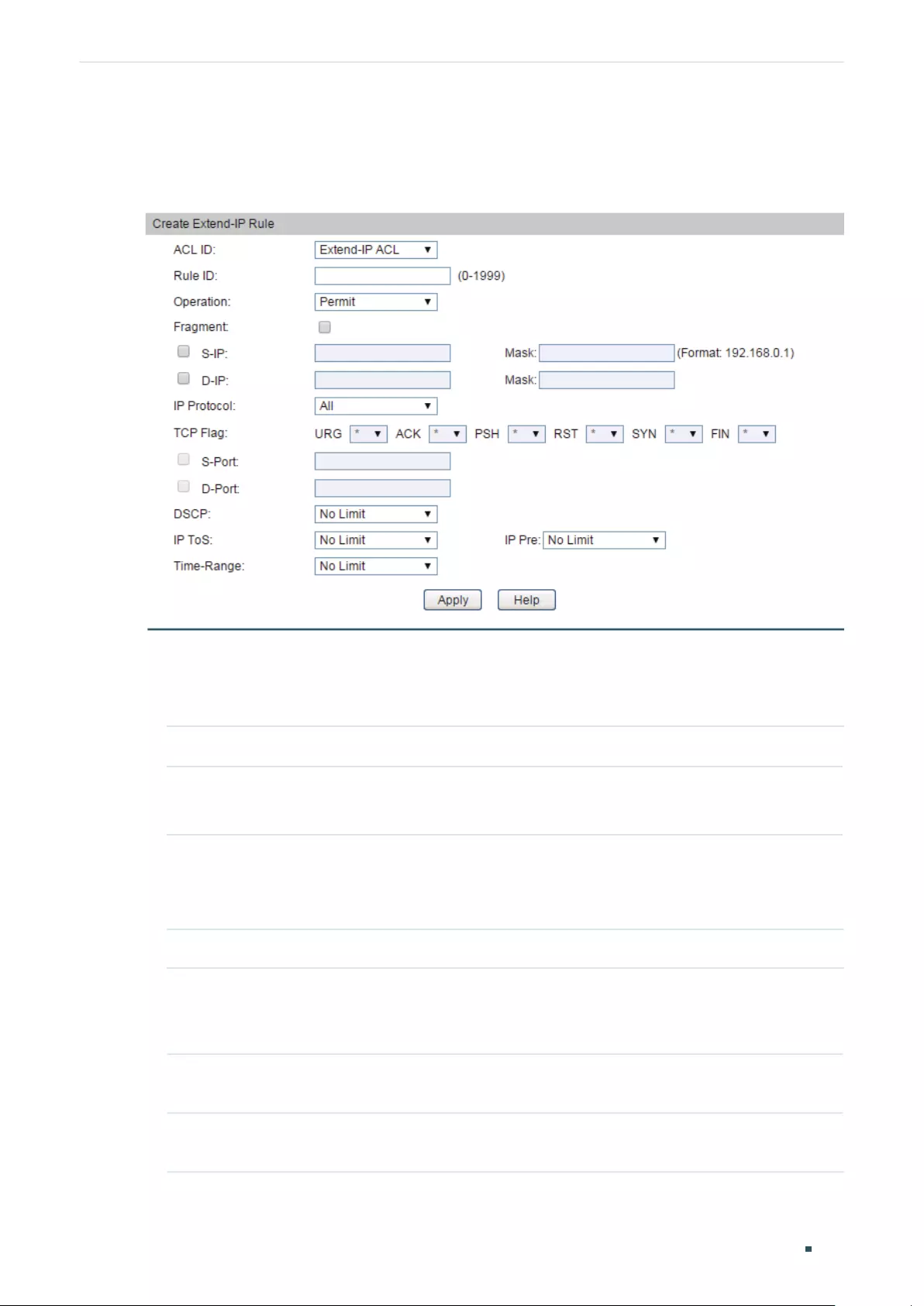
Configuration Guide 684
Configuring ACL ACL Configuration
Configuring the Extend-IP ACL Rule
Choose the menu ACL > ACL Config > Extend-IP ACL to load the following page.
Figure 2-6 Creating the Extend-IP ACL Rule
Follow these steps to create the Extend-IP ACL:
1) Select an Extend-IP ACL ID from the drop-down list, enter a Rule ID, then specify the operation for the
matched packets.
ACL ID Select a Extend-IP ACL from the drop-down list.
Rule ID Enter an ID number to identify the rule.
It should not be the same as any existing Extend-IP ACL Rule IDs.
Operation Select an action to be taken when a packet matches the rule.
Permit: To forward the matched packets.
Deny: To discard the matched packets.
2) Define the rule’s packet-matching criteria.
Fragment Select the checkbox to make the rule valid for fragmented packets.
When selected, the rule will apply to all fragmented packets and always
permit to forward the last fragment of a packet.
S-IP/Mask Specify the source IP address with a mask. A value of 1 in the mask indicates
that the corresponding bit in the address will be matched.
D-IP/Mask Specify the destination IP address with a mask. A value of 1 in the mask
indicates that the corresponding bit in the address will be matched.

Configuring ACL ACL Configuration
Configuration Guide 685
IP Protocol Select a protocol type from the drop-down list. The default is All, which
indicates that packets of all protocols will be matched.
TCP Flag If TCP protocol is selected, you can configure the TCP Flag to be used for the
rule’s matching operations. There are six flags and each has three options,
which are *, 0 and 1. The default is *, which indicates that the flag is not used
for matching operations.
URG: Urgent flag.
ACK: Acknowledge flag
PSH: Push flag.
RST: Reset flag.
SYN: Synchronize flag.
FIN: Finish flag
S-Port / D-Port Enter the TCP/UDP source and destination port if TCP/UDP protocol is
selected. The port number ranges from 0 to 65535.
DSCP Specify a DSCP value to be matched between 0 and 63. The default is No
Limit.
IP ToS Specify an IP ToS value to be matched between 0 and 15. The default is No
Limit.
IP Pre Specify an IP Precedence value to be matched to be matched between 0 and
7. The default is No Limit.
3) (Optional) Select a time-range from the drop-down list.
Time-Range Select a time-range during which the rule will take effect. The default value is
No Limit, which means the rule is always in effect.

Configuration Guide 686
Configuring ACL ACL Configuration
Configuring the Combined ACL Rule
Choose the menu ACL > ACL Config > Combined ACL to load the following page.
Figure 2-7 Creating the Combined ACL Rule
Follow these steps to create the Combined ACL:
1) Select a Combined ACL ID from the drop-down list, enter a Rule ID, then specify the
operation for the matched packets.
ACL ID Select a Combined ACL from the drop-down list.
Rule ID Enter an ID number to identify the rule.
It should not be the same as any existing Combined ACL Rule IDs.
Operation Select an action to be taken when a packet matches the rule.
Permit: To forward the matched packets.
Deny: To discard the matched packets.
2) Define the rule’s packet-matching criteria.
S-MAC/Mask Enter the source MAC address with a mask. A value of 1 in the mask indicates
that the corresponding bit in the address will be matched.
D-MAC/Mask Enter the destination IP address with a mask. A value of 1 in the mask
indicates that the corresponding bit in the address will be matched.
VLAN ID Enter the ID number of the VLAN to which the ACL will apply.
EtherType Specify the EtherType to be matched using 4 hexadecimal numbers.
User Priority Specify the User Priority to be matched.
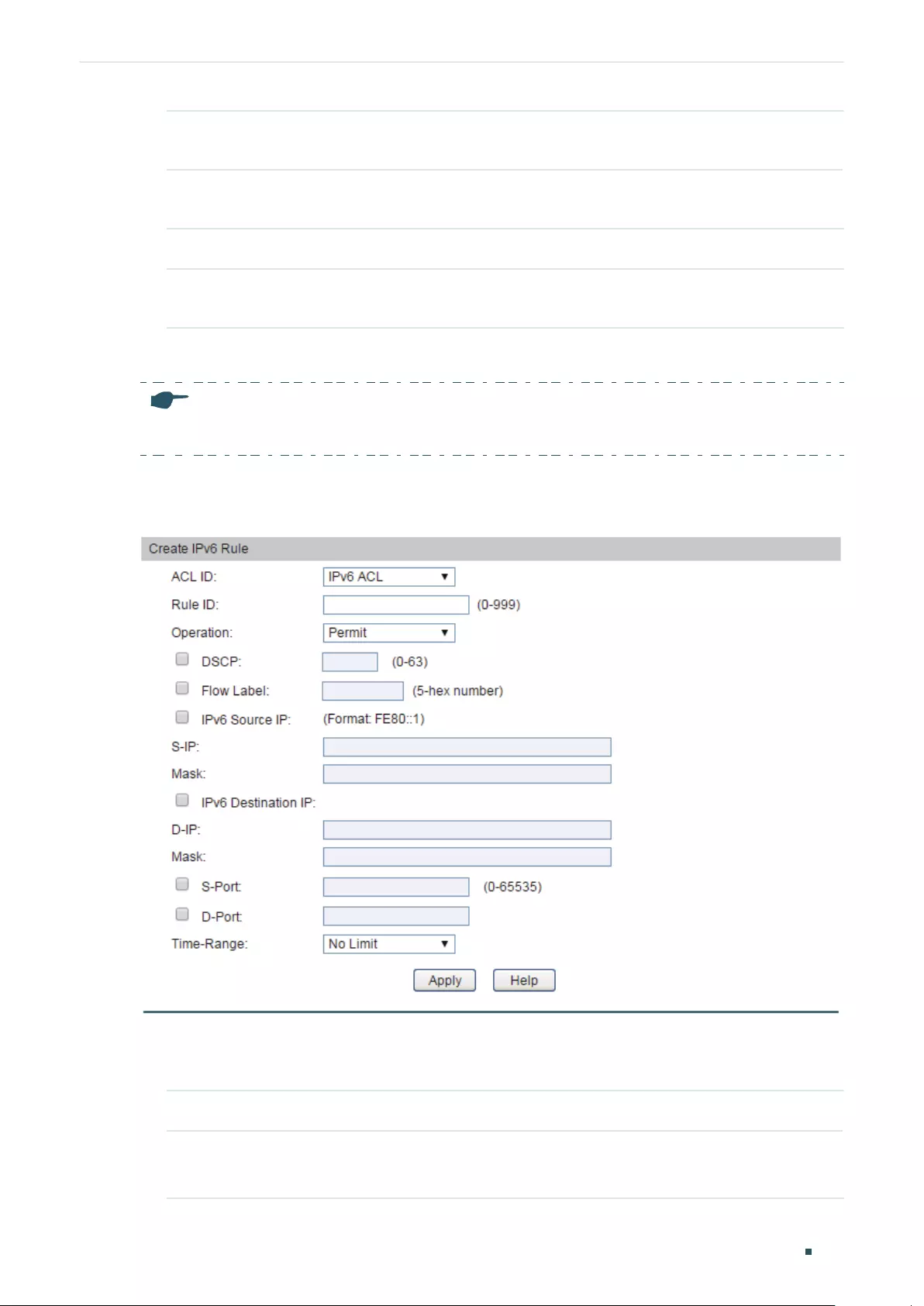
Configuring ACL ACL Configuration
Configuration Guide 687
S-IP/Mask Specify the source IP address with a mask. A value of 1 in the mask indicates
that the corresponding bit in the address will be matched.
D-IP/Mask Specify the destination IP address with a mask. A value of 1 in the mask
indicates that the corresponding bit in the address will be matched.
3) (Optional) Select a time-range from the drop-down list.
Time-Range Select a time-range during which the rule will take effect. The default value is
No Limit, which means the rule is always in effect.
Configuring the IPv6 ACL Rule
Note:
For T2600G-28TS, S-Port / D-Port cannot be configured.
Choose the menu ACL > ACL Config > IPv6 ACL to load the following page.
Figure 2-8 Creating the IPv6 ACL Rule
Follow these steps to create the IPv6 ACL:
1) Select an IPv6 ACL ID from the drop-down list, enter a Rule ID, then specify the operation for the rule.
ACL ID Select an IPv6 ACL from the drop-down list.
Rule ID Enter an ID number to identify the rule.
It should not be the same as any existing IPv6 ACL Rule IDs.

Configuration Guide 688
Configuring ACL ACL Configuration
Operation Select an action to be taken when a packet matches the rule.
Permit: To forward the matched packets.
Deny: To discard the matched packets.
2) Define the rule’s packet-matching criteria.
DSCP Specify a DSCP value to be matched.
Flow Label Specify a Flow Label value to be matched.
IPv6 Source IP When selected, enter the source IP address with a mask.
S-IP Enter the source IPv6 address to be matched. All types of IPv6 address will
be checked. You may enter a complete 128-bit IPv6 address but only the
first 64 bits will be valid.
Mask The mask is required if the source IPv6 address is entered. Enter the mask in
complete format (for example, ffff:ffff:0000:ffff).
The IP address mask specifies which bits in the source IPv6 address to
match the rule. A value of 1 in the mask indicates that the corresponding bit
in the address will be matched.
IPv6 Destination IP When selected, enter the destination IPv6 address with a mask.
D-IP Enter the destination IPv6 address to be matched. All types of IPv6 address
will be checked. You may enter a complete 128-bit IPv6 address but only the
first 64 bits will be valid.
Mask The mask is required if the destination IPv6 address is entered. Enter the
complete mask (for example, ffff:ffff:0000:ffff).
The IP address mask specifies which bits in the source IP address to match
the rule. A value of 1 in the mask indicates that the corresponding bit in the
address will be matched.
S-Port / D-Port Enter the TCP/UDP source and destination port.
3) (Optional) Select a time-range from the drop-down list.
Time-Range Select a time-range during which the rule will take effect. The default value is
No Limit, which means the rule is always in effect.
Configuring the Packet Content ACL Rule
Note:
Only T2600G-28TS supports Packet Content ACL.

Configuring ACL ACL Configuration
Configuration Guide 689
Choose the menu ACL > ACL Config > Packet Content ACL to load the following page.
Figure 2-9 Creating the Packet Content ACL Rule
Follow these steps to create the Packet Content ACL:
1) In Packet Content Offset Profile section, enter the offset of a chunk, all the 4 chunks must
be set at the same time.
Chunk Offset Enter the offset of a chunk, all the 4 chunks must be set at the same time.
Offset 31 matches the 1, 2, 127, 128 bytes of the packet, offset 0 matches
the 3,4,5,6 bytes of the packet, and so on, for the rest of the offset value.
2) In Create Packet Content section, select a Packet Content ACL from the drop-down list, enter a
Rule ID, specify the operation for the rule, and define the rule’s packet-matching criteria.
ACL ID Select a Packet Content ACL from the drop-down list.
Rule ID Enter an ID number to identify the rule.
It should not be the same as any existing Packet Content ACL Rule IDs.
Operation Select an action to be taken when a packet matches the rule.
Permit: To forward the matched packets.
Deny: To discard the matched packets.
Chunk0-Chunk3 Specify the EtherType to be matched using 4 hexadecimal numbers.

Configuration Guide 690
Configuring ACL ACL Configuration
Chunk Value Enter the 4-byte value in hexadecimal for the desired chunk, like ‘0000ffff’.
The Packet Content ACL will check this chunk of packets to examine if the
packets match the rule or not.
Chunk mask Enter the 4-byte mask in hexadecimal for the desired chunk. The mask must
be written completely in 4-byte hex mode, like ‘0000ffff’. The mask specifies
which bits to match the rule.
3) (Optional) Select a time-range from the drop-down list.
Time-Range Select a time-range during which the rule will take effect. The default value is
No Limit, which means the rule is always in effect.
View the Rule Table
The rules in an ACL are listed in ascending order of configuration time, regardless of their
rule IDs. By default, a rule configured earlier is listed before a rule configured later.
The switch matches a received packet with the rules in order. When a packet matches a
rule, the device stops the match process and performs the action defined in the rule.
In the ACL rule table, you can view all the ACLs and their rules.
You can also delete an ACL or an ACL rule, or change the matching order if needed.
Choose the menu ACL > ACL Config > ACL Summary to load the following page.
Figure 2-10 ACL Information
2.1.5 Configuring Policy
Policy allows you to further process the matched packets through operations such as
mirroring, rate-limiting, redirecting, or changing priority.
To configure the policy, follow these steps:
1) Create a policy.
2) Configure the action of the policy

Configuring ACL ACL Configuration
Configuration Guide 691
Creating a Policy
Choose th menu ACL > Policy Config > Policy Create to load the following page.
Figure 2-11 Creating a Policy
Follow these steps to create a policy:
Enter a policy name, then click Apply.
Policy Name Enter a Policy Name between 1 and 16 characters.
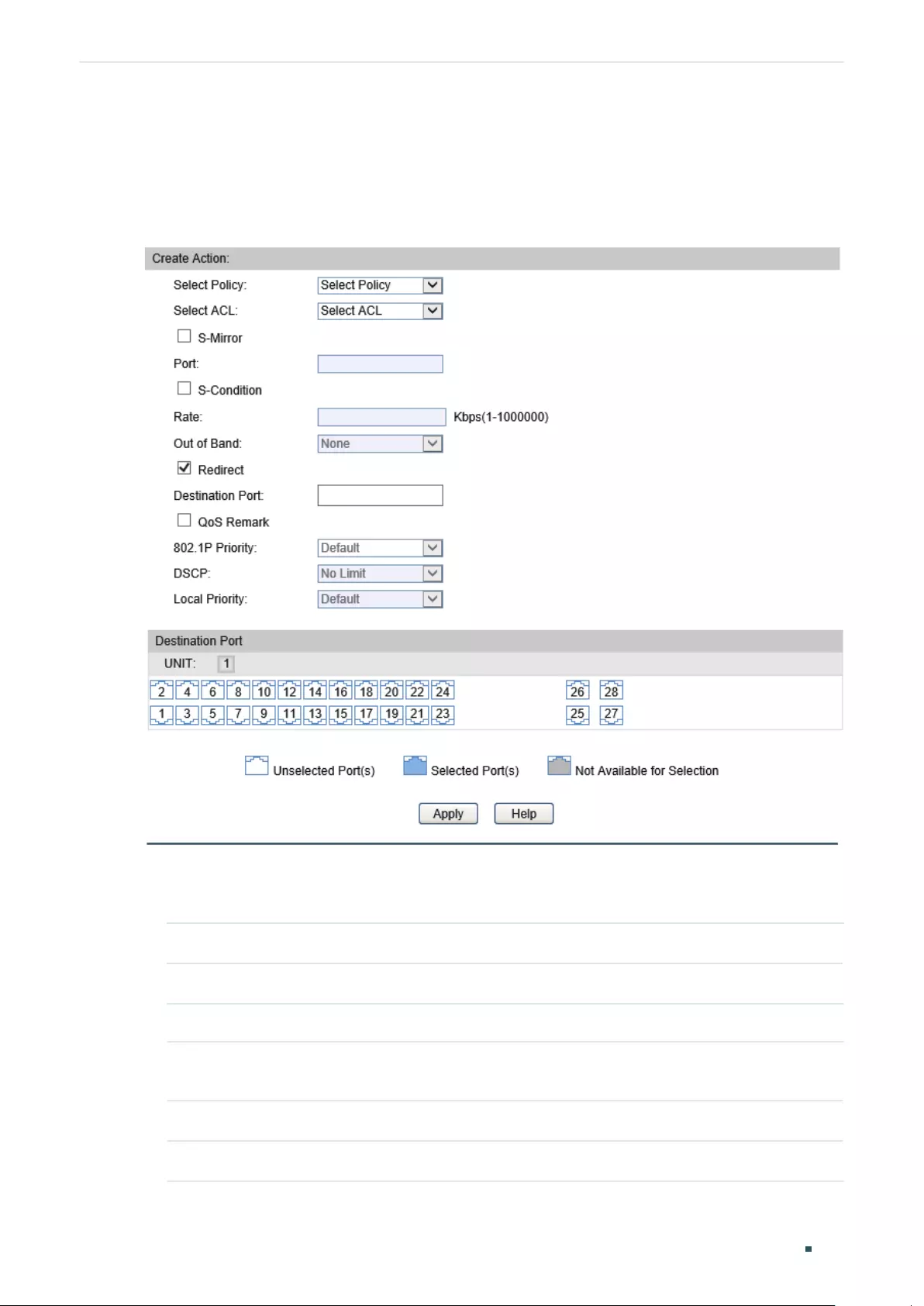
Configuration Guide 692
Configuring ACL ACL Configuration
Configuring the Action of the Policy
Apply an ACL to the policy and specify the action to be taken for the matched packets.
Choose the menu ACL > Policy Config > Action Create to load the following page.
Figure 2-12 Configuring the Action of the Policy
Follow these steps to configure the action of the policy:
1) Select your preferred policy and ACL.
Select Policy Select a policy from the drop-down list.
Select ACL Select an ACL to be applied to the policy.
2) Configure the actions to be taken for the matched packets.
S-Mirror Configure port mirroring for the matched packets. Enter a destination port to
which the packets will be mirrored.
Port Enter a destination port.
S-Condition Configure rate limiting for the matched packets.

Configuring ACL ACL Configuration
Configuration Guide 693
Rate Specify the transmission rate for the matched packets.
Out of Band Select either “none” or “discard” as the action to be taken for packets whose
rate is beyond the specified rate.
Redirect Configure the redirect action for the matched packets.
Destination Port Select a destination port to which the packets will be redirected.
QoS Remark Configure QoS action for the matched packets.
802.1P Priority Specify the 802.1p priority for the matched packets.
DSCP Specify the DSCP region for the matched packets.
Local Priority Specify the local priority for thematched packets.
3) Click Apply to make the settings effective.
2.1.6 Configuring the ACL Binding and Policy Binding
You can select ACL binding or Policy binding according to your needs.
An ACL or policy takes effect only after it is bound to a port or VLAN.
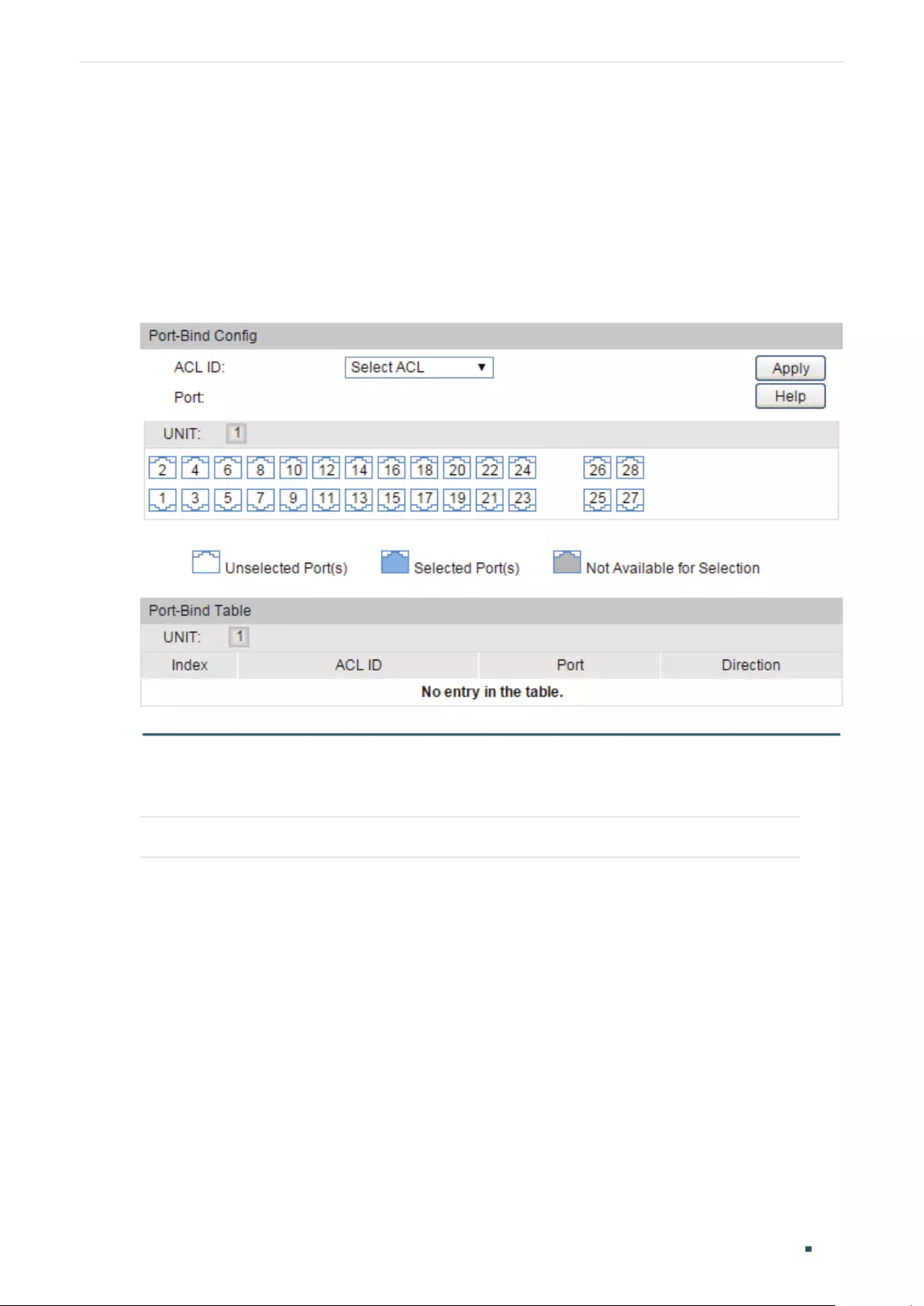
Configuration Guide 694
Configuring ACL ACL Configuration
Configuring the ACL Binding
You can bind the ACL to a port or a VLAN. The received packets will then be matched and
processed according to the ACL rules.
Binding the ACL to a Port
Choose the menu ACL > ACL Binding > Port Binding to load the following page.
Figure 2-13 Binding the ACL to a Port
Follow these steps to bind the ACL to a Port:
Select the ACL and the port, and click Apply.
ACL ID Select an ACL from the drop-down list.

Configuring ACL ACL Configuration
Configuration Guide 695
Binding the ACL to a VLAN
Choose the menu ACL > ACL Binding > VLAN Binding to load the following page.
Figure 2-14 Binding the ACL to a VLAN
Follow these steps to bind the ACL to a VLAN:
Select the ACL and enter the VLAN ID, and click Apply.
ACL ID Select an ACL from the drop-down list.
Note: Packet Content ACLs cannot be bound to any VLANs.
VLAN ID Enter the VLAN ID.

Configuration Guide 696
Configuring ACL ACL Configuration
Configuring the Policy Binding
You can bind the policy to a port or a VLAN. The received packets will then be matched and
processed according to this policy.
Binding the Policy to a Port
Figure 2-15 Binding the policy to a Port
Follow these steps to bind the policy to a Port:
Select the policy and the port to be bound, and click Apply.
Policy Name Select a Policy from the drop-down list.
Binding the Policy to a VLAN
Choose the menu ACL > Policy Binding > VLAN Binding to load the following page.
Figure 2-16 Binding the Policy to a VLAN

Configuring ACL ACL Configuration
Configuration Guide 697
Follow these steps to bind the policy to a VLAN:
Select the ACL and enter the VLAN ID, and click Apply.
ACL ID Select an ACL from the drop-down list.
Note: Packet Content ACLs cannot be bound to any VLANs.
VLAN ID Enter the VLAN ID.
Verifying the Binding Configuration
Verifying the ACL Binding
You can view both port binding and VLAN binding entries in the table. You can also delete
existing entries if needed.
Choose the menu ACL > ACL Binding > Binding Table to load the following page.
Figure 2-17 Verifying the ACL Binding
Verifying the Policy Binding
You can view both port binding and VLAN binding entries in the table. You can also delete
existing entries if needed.
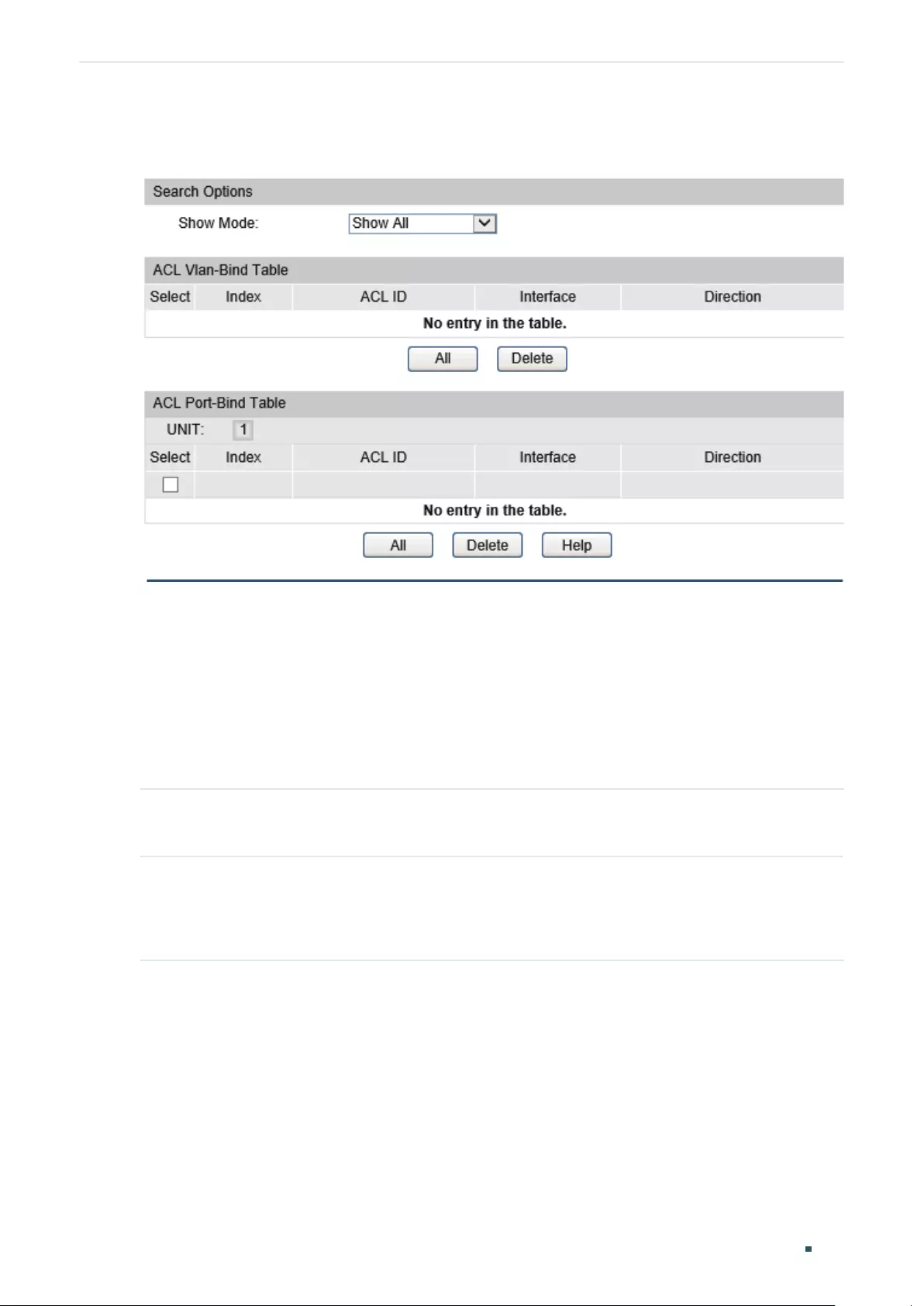
Configuration Guide 698
Configuring ACL ACL Configuration
Choose the menu ACL > Policy Binding > Binding Table to load the following page.
Figure 2-18 Verifying the Policy Binding
2.2 Using the CLI
2.2.1 Configuring Time Range
Some services or features that use ACL need to be limited to a specified time period. In this
case, you can configure time-range for the ACL.
Step 1 configure
Enter global configuration mode.
Step 2 time-range
name
Add a time-range to make a rule effective only during a specified time period.
name
:Assign a name to the time-range using 1-16 characters.

Configuring ACL ACL Configuration
Configuration Guide 699
Step 3 absolute start
start-date
end
end-date
(Optional) Configure time-range in Absolute mode. In this mode, the rule takes effect only
during a specified period of time.
start-date:
Specify the start date in MM/DD/YYYY format. The default is 01/01/2000.
end-date:
Specify the start date in MM/DD/YYYY format. The default is 01/01/2000
periodic [week-date
week-day
] [time-slice1
time-slice
] [time-slice2
time-slice
]
[time-slice3
time-slice
] [time-slice4
time-slice
]
(Optional) Configure time-range in Week mode. In this mode, the rule takes effect only on
certain days each week.
week-day:
Specify the cycle time range. You can enter 1-3,6 or descriptions such as daily,
off-day or working-day. 1-3, 6 indicates Monday, Tuesday,Wednesday and Saturday; daily
indicates every day; off-day indicates Saturday and Sunday, and working-day indicates
Monday to Friday.
By default, Week mode is disabled.
time-slice:
Add a time-slice in HH:MM-HH:MM format. You can add a maximum of four time-
slices to each time-range.
holiday
(Optional) Configure time-range in Holiday mode. In this mode, the ACL rule is effective only
during specified holiday times.
Step 4 exit
Return to global configuration mode.
Step 5 holiday
name
start-date
start-date
end-date
end-date
In Holiday mode, specify the start and end date of the holiday time.
name:
Assign a name to the holiday using 1-16 characters.
start-date:
Specify the start date in MM/DD format, for example 05/01.
end-date:
Specify the end date in MM/DD format, for example 05/03
Step 6 show time-range
(Optional) Display all time-range configurations.
show holiday
(Optional) Display all defined holiday times.
Step 7 end
Return to privileged EXEC mode.
Step 8 copy running-config startup-config
Save the settings in the configuration file.

Configuration Guide 700
Configuring ACL ACL Configuration
The following example shows how to configure time-range in Week mode. The ACL only
takes effect at 08:30 am to 18:00 pm on Monday to Friday:
Switch#configure
Switch(config)#time-range work_time
Switch(config-time-range)#periodic week-date 1-5 time-slice1 08:30-18:00
Switch(config-time-range)#exit
Switch(config)#show time-range
Time-range entry: work_time(inactive)
periodic time-slice 08:30-18:00
periodic week-day 1,2,3,4,5
Switch(config)#end
Switch#copy running-config startup-config
2.2.2 Configuring ACL
Follow the steps to create different types of ACL and configure the ACL rules.
You can define the rules based on source or destination IP address, source or destination
MAC address, protocol type, port number and others.
MAC ACL
Step 1 configure
Enter global configuration mode.
Step 2 mac access-list
access-list-num
Input a MAC ACL ID to enter MAC Access-list mode. If it is a new ID , the ACL will be created
before entering MAC Access-list mode.
access-list-num:
Enter an ACL ID between 0 and 499.

Configuring ACL ACL Configuration
Configuration Guide 701
Step 3 rule
rule-id
{deny | permit} [ [smac
source-mac
] smask
source-mac-mask
] [ [dmac
destination-
mac
] dmask
destination-mac-mask
] [ vid
vlan-id
] [ type ethernet-type ] [ pri
user-pri
] [ tseg
time-segment
]
Add a MAC ACL Rule.
rule-id
: Assign an ID to the rule.
deny | permit: Specify the action to be taken with the packets that match the rule. By default, it
is set to permit. The packets will be discarded if “deny” is selected and forwarded if “permit” is
selected.
source-mac
: Enter the source MAC address. The format is FF:FF:FF:FF:FF:FF.
source-mac-mask
: Enter the mask of the source MAC address. This is required if a source MAC
address is entered. The format is FF:FF:FF:FF:FF:FF.
destination-mac
: Enter the destination MAC address. The format is FF:FF:FF:FF:FF:FF.
destination-mac-mask
: Enter the mask of the destination MAC address. This is required if a
destination MAC address is entered. The format is FF:FF:FF:FF:FF:FF.
vlan-id
: The VLAN ID ranges from 1 to 4094.
ethernet-type: Specify an Ethernet-type with 4 hexadecimal numbers.
user-pri
: The user priority ranges from 0 to 7. The default is No Limit.
time-segment
: The name of the time-range. The default is No Limit.
Step 4 exit
Return to global configuration mode.
Step 5 show access-list [
access-list-num
]
Display the current ACL configuration.
access-list-num
: The ID number of the ACL.
Step 6 end
Return to privileged EXEC mode.
Step 7 copy running-config startup-config
Save the settings in the configuration file.
The following example shows how to create MAC ACL 50 and configure Rule 5 to permit
packets with source MAC address 00:34:a2:d4:34:b5:
Switch#configure
Switch(config)#mac access-list 50
Switch(config-mac-acl)#rule 5 permit smac 00:34:a2:d4:34:b5 smask ff:ff:ff:ff:ff:ff
Switch(config-mac-acl)#exit
Switch(config)#show access-list 50

Configuration Guide 702
Configuring ACL ACL Configuration
mac access list 50
rule 5 permit smac 00:34:a2:d4:34:b5 smask ff:ff:ff:ff:ff:ff
Switch(config)#end
Switch#copy running-config startup-config
Standard-IP ACL
Step 1 configure
Enter global configuration mode.
Step 2 access-list create
access-list-num
Create an Standard-IP ACL.
access-list-num:
Enter an ACL ID. The ID ranges from 500 to 1499.
Step 3 access-list standard
acl-id
rule
rule-id
{ deny | permit } [[ sip
source-ip
] smask
source-
ip-mask
] [[ dip
destination-ip
] dmask
destination-ip-mask
] [ tseg
time-segment
]
Add rules to the ACL.
acl-id:
The ID number of the ACL you have created.
rule-id:
Assign an ID to the rule. It cannot be the same as the existing Standard-IP Rule
IDs.
deny | permit: Specify the action to be taken with the packets that match the rule. Deny
means to discard; permit means to forward. By default, it is set to permit.
source-ip:
Enter the source IP address.
source-ip-mask:
Enter the mask of the source IP address. This is required if a source IP
address is entered.
destination-ip:
Enter the destination IP address.
destination-ip-mask:
Enter the mask of the destination IP address. This is required if a
destination IP address is entered.
time-segment:
The name of the time-range. The default is No Limit.
frag: Enable or disable matching of fragmented packets. The default is disable. When
enabled, the rule will apply to all fragmented packets and always permit to forward the
last fragment of a packet.
Step 4 end
Return to privileged EXEC mode.
Step 5 copy running-config startup-config
Save the settings in the configuration file.
The following example shows how to create Standard-IP ACL 600, and configure Rule 1 to
permit packets with source IP address 192.168.1.100:
Switch#configure

Configuring ACL ACL Configuration
Configuration Guide 703
Switch(config)#access-list create 600
Switch(config)#access-list standard 600 rule 1 permit sip 192.168.1.100 smask
255.255.255.255
Switch(config)#show access-list 600
Standard IP access list 600
rule 1 permit sip 192.168.1.100 smask 255.255.255.255
Switch(config)#end
Switch#copy running-config startup-config
Extend-IP ACL
Step 1 configure
Enter global configuration mode.
Step 2 access-list create
access-list-num
Create an Extend-IP ACL
access-list-num:
Enter an ACL ID. The ID ranges from 1500 to 2499.

Configuration Guide 704
Configuring ACL ACL Configuration
Step 3 access-list extended
acl-id
rule
rule-id
{deny | permit} [ [sip source-ip] smask
source-ip-
mask
] [ [dip
destination-ip
] dmask
destination-ip-mask
] [tseg
time-segment
] [frag {disable
| enable}] [dscp
dscp
] [s-port
s-port
] [d-port
d-port
] [tcpflag
tcpflag
] [protocol
protocol
]
[tos
tos
] [pre
pr
e]
Add a rule for the ACL.
acl-id:
The ID number of the ACL you have created.
rule-id:
Assign an ID to the rule. It cannot be the same as the existing Extend-IP ACL
Rule IDs.
deny | permit
:
Specify the action to be taken with the packets that match the rule. Deny
means to discard; permit means to forward. By default, it is set to permit.
source-ip:
Enter the source IP address.
source-ip-mask:
Enter the mask of the source IP address. This is required if a source IP
address is entered.
destination-ip:
Enter the destination IP address.
destination-ip-mask:
Enter the mask of the destination IP address. This is required if a
destination IP address is entered.
time-segment:
The name of the time-range. The default is No Limit.
frag
:
Enable or disable matching of fragmented packets. The default is disable. When
enabled, the rule will apply to all fragmented packets and always permit to forward the
last fragment of a packet.
dscp:
Specify the DSCP value between 0 and 63.
s-port:
Enter the TCP/UDP source port if TCP/UDP protocol is selected.
d-port:
Enter the TCP/UDP destination port if TCP/UDP protocol is selected.
tcpflag:
For TCP protocol, specify the flag value using either binary numbers or * (for
example, 01*010*). The default is *, which indicates that the flag will not be matched.
The flags are URG (Urgent flag), ACK (acknowledge flag), PSH(push flag), RST(reset flag),
SYN(synchronize flag), and FIN(finish flag)
protocol:
Specify a protocol type.
tos:
Specify the IP ToS to be matched.
pre:
Specify the IP Precedence to be matched.
Step 4 end
Return to privileged EXEC mode.
Step 5 copy running-config startup-config
Save the settings in the configuration file.
The following example shows how to create Extend-IP ACL 1700 and configure Rule 7 to
deny Telnet packets with source IP192.168.2.100:
Switch#configure
Switch(config)#access-list create 1700
Switch(config)#access-list extended 1700 rule 7 deny sip 192.168.2.100 smask
255.255.255.255 protocol 6 d-port 23
Switch(config)#show access-list 1700

Configuring ACL ACL Configuration
Configuration Guide 705
Extended IP access list 1700
rule 7 deny sip 192.168.2.100 smask 255.255.255.255 protocol 6 d-port 23
Switch(config)#end
Switch#copy running-config startup-config
Combined ACL
Step 1 configure
Enter global configuration mode
Step 2 access-list create
access-list-num
Create a Combined ACL.
access-list-num:
Enter an ACL ID. The ID ranges from 2500 to 3499.
Step 3 access-list combined
acl-id
rule
rule-id
[permit|deny] [[smac
source-mac-address
]
[smask
source-mac-mask
]] [[dmac
dest-mac-address
] [dmask
dest-mac-mask
]] [vid
vlan-
id
] [type
ether-type
] [pri
priority
] [[sip
source-ip-address
] [sip-mask
source-ip-mask
]] [[dip
dest-ip-address
] [dip-mask
dest-ip-mask
]] [frag {disable | enable}] [tseg
time-segment
]
Add rules to the ACL.
acl-id
: The ID number of the ACL you have created.
rule-id
: Assign an ID to the rule. It should not be the same as any existing Combined ACL
Rule IDs.
permit|deny: Specify the action to be taken with the packets that match the rule. Deny
means to discard; permit means to forward. By default, it is set to permit.
source-mac-address: Enter the source MAC address.
source-mac-mask: Enter the source MAC address mask.
dest-mac-address: Enter the destination MAC address.
dest-mac-mask: Enter the destination MAC address mask. This is required if a
destination MAC address is entered.
vlan-id: The VLAN ID ranges from 1 to 4094.
ethertype: Specify the Ethernet-type with 4 hexadecimal numbers.
priority: The user priority ranges from 0 to 7. The default is No Limit.
source-ip
: Enter the source IP address.
source-ip-mask
: Enter the mask of the source IP address. It is required if source IP
address is entered.
destination-ip
: This is required if a source IP address is entered.
destination-ip-mask
: Enter the destination IP address mask. This is required if a
destination IP address is entered.
frag: Enable or disable matching of fragmented packets. The default is disable. When
enabled, the rule will apply to all fragmented packets and always permit to forward the
last fragment of a packet .
time-segment
: The name of the time-range. The default is No Limit.

Configuration Guide 706
Configuring ACL ACL Configuration
Step 4 end
Return to privileged EXEC mode.
Step 5 copy running-config startup-config
Save the settings in the configuration file.
The following example shows how to create Combined ACL 2600 and configure Rule 1 to
deny packets with source IP address 192.168.3.100 in VLAN 2:
Switch#configure
Switch(config)#access-list create 2600
Switch(config)#access-list combined 2600 rule 1 permit vid 2 sip 192.168.3.100
sip-mask 255.255.255.255
Switch(config)#show access-list 2600
Combined access list 2600
rule 1 permit vid 2 sip 192.168.3.100 sip-mask 255.255.255.255
Switch(config)#end
Switch#copy running-config startup-config
IPv6 ACL
Step 1 configure
Enter global configuration mode
Step 2 access-list ipv6
access-list-num
Create an IPv6 ACL.
access-list-num:
Enter an ACL ID. The ID ranges from 3500 to 4499.

Configuring ACL ACL Configuration
Configuration Guide 707
Step 3 access-list ipv6
acl-id
rule
rule-id
{permit | deny}[dscp
dscp-value
] [flow-label
flow-
label-value
] [sip
source-ip-address
sip-mask
source-ip-mask
] [dip
destination-ip-address
dip-mask
destination-ip-mask
] [s-port
source-port-number
] [d-port
destination-port-
number
] [tseg
time-segment-name
]
Add rules to the ACL.
acl-id:
The ID number of the ACL you have created.
rule-id:
Assign an ID to the rule. It should not be the same as any existing IPv6 Rule IDs.
permit | deny: Specify the action to be taken with the packets that match the rule. Deny
means to discard; permit means to forward. By default, it is set to permit.
dscp-value
: Specify a DSCP value to be matched.
flow-label-value
: Specify a Flow Label value to be matched.
source-ip-address:
Enter the source IP address. Enter the destination IPv6 address to
be matched. All types of IPv6 address will be checked. You may enter a complete 128-
bit IPv6 address but only the first 64 bits will be valid.
source-ip-mask:
Enter the source IP address mask. The mask is required if the
source IPv6 address is entered. Enter the mask in complete format (for example,
ffff:ffff:0000:ffff). The mask specifies which bits in the source IPv6 address to match the
rule.
destination-ip-address
: Enter the destination IPv6 address to be matched. All types of
IPv6 address will be checked. You may enter a complete 128-bit IPv6 addresses but
only the first 64 bits will be valid.
destination-ip-mask:
Enter the source IP address mask. The mask is required if the
source IPv6 address is entered. Enter the mask in complete format (for example,
ffff:ffff:0000:ffff). The mask specifies which bits in the source IPv6 address to match the
rule.
source-port-number
: Enter the TCP/UDP source port if TCP/UDP protocol is selected.
destination-port-number
: Enter the TCP/UDP destination port if TCP/UDP protocol is
selected.
time-segment-name
: The name of the time-range. The default is No Limit.
Step 4 end
Return to privileged EXEC mode.
Step 5 copy running-config startup-config
Save the settings in the configuration file.
The following example shows how to create IPv6 ACL 3600 and configure Rule 1 to deny
packets with source IPv6 address CDCD:910A:2222:5498:8475:1111:3900:2020:
Switch#configure
Switch(config)#access-list create 3600
Switch(config)#access-list ipv6 3600 rule 1 deny sip
CDCD:910A:2222:5498:8475:1111:3900:2020 sip-mask ffff:ffff:ffff:ffff
Switch(config)#show access-list 3600

Configuration Guide 708
Configuring ACL ACL Configuration
IPv6 access list 3600
rule 1 deny sip cdcd:910a:2222:5498:8475:1111:3900:2020 sip-mask ffff:ff
ff:ffff:ffff
Switch(config)#end
Switch#copy running-config startup-config
Packet Content ACL
Note:
Only T2600G-28TS supports Packet Content ACL.
Step 1 configure
Enter global configuration mode
Step 2 access-list create
access-list-num
Create a Packet Content ACL.
access-list-num:
Enter an ACL ID. The ID ranges from 4500 to 4999.
Step 3 access-list packet-content profile chunk-offset0
offset0
chunk-offset1
offset1
chunk-offset2
offset2
chunk-offset3
offset3
Specify the offset of each chunk, all the 4 chunks must be set at the same time.
offset0
-
offset3
: Specify the offset of each chunk, the value ranges from 0 to 31. When
the offset is set as 31, it matches the first 1, 2,127,128 bytes of the packet; when the
offset is set as 0, it matches the 3, 4, 5, 6 bytes, and so on, for the rest of the offset
value.
Step 4 access-list packet-content config
acl-id
rule
rule-id
{deny | permit} [chunk0
value
mask0
mask
] [chunk1
value
mask1
mask
] [chunk2
value
mask2
mask
] [chunk3
value
mask3
mask
] [tseg
tseg-name
]
Add rules to the ACL.
acl-id:
The ID number of the ACL you have created.
rule-id:
Assign an ID to the rule. It should not be the same as any existing Packet
Content Rule IDs.
permit | deny: Specify the action to be taken with the packets that match the rule. Deny
means to discard; permit means to forward. By default, it is set to permit.
value
: Enter the 4-byte value in hexadecimal for the desired chunk, like ‘0000ffff’. The
Packet Content ACL will check this chunk of packets to examine if the packets match
the rule or not.
mask:
Enter the 4-byte mask in hexadecimal for the desired chunk. The mask must be
written completely in 4-byte hex mode, like ‘0000ffff’. The mask specifies which bits to
match the rule.
time-segment-name
: The name of the time-range. The default is No Limit.

Configuring ACL ACL Configuration
Configuration Guide 709
Step 5 end
Return to privileged EXEC mode.
Step 6 copy running-config startup-config
Save the settings in the configuration file.
The following example shows how to create Packet Content ACL 4500, and deny the
packets with the value of its chunk1 0x58:
Switch#configure
Switch(config)#access-list create 4500
Switch(config)#access-list packet-content profile chunk-offset0 offset0 chunk-offset1
offset1 chunk-offset2 offset2 chunk-offset3 offset3
Switch(config)#packet-content config 4500 rule 10 deny chunk1 58 mask1 ffffffff
Switch(config)#show access-list 4500
Packet content access list 4500
rule 10 deny chunk1 value 0x58 mask 0xffffffff
Switch(config)#end
Switch#copy running-config startup-config
2.2.3 Configuring Policy
Policy allows you to further process the matched packets through operations such as
mirroring, rate-limiting, redirecting, or changing priority.
Follow the steps below to create a policy and configure the policy actions.
Step 1 configure
Enter global configuration mode
Step 2 access-list policy name
name
Create a policy and assign it a name.
name
: Assign the policy a name with 1 to 16 characters.
Step 3 access-list policy action
policy-name acl-id
Apply an ACL to the policy.
policy-name
: The name of the policy.
acl-id
: The ID number of the ACL to be applied.

Configuration Guide 710
Configuring ACL ACL Configuration
Step 4
redirect interface { fastEthernet
port
| gigabitEthernet
port
| ten-gigabitEthernet
port
}
(Optional) Define the policy to redirect the matched packets to the desired port.
port
: The destination port to which the packets will be redirected. The default is All.
s-mirror interface
{ fastEthernet
port
| gigabitEthernet
port
| ten-gigabitEthernet
port
}
(Optional) Define the policy to mirror the matched packets to the desired port.
port
: The destination port to which the packets will be mirrored
s-condition rate
rate
osd { none | discard }
(Optional) Define the policy to monitor the rate of the matched packets
rate
: Specify a rate from 1 to 1000000 kbps.
osd: Select either “none” or “discard” as the action action to be taken for the packets
whose rate is beyond the specified rate. The default is None.
qos-remark dscp
dscp
priority
pri
dot1p
pri
(Optional) Define the policy to remark priority for the matched packets.
dscp
: Specify the DSCP region for the data packets. The value ranges from 0 to 63.
priority
pri
: Specify the local priority for the data packets. The value ranges from 0 to 7.
dot1p
pri:
Specify the 802.1p priority for the data packets. The value ranges from 0 to 7.
Step 5 end
Return to privileged EXEC mode.
Step 6 copy running-config startup-config
Save the settings in the configuration file.
Create policy RD, apply ACL 600 to policy RD, and redirect the matched packets to port
1/0/4:
Switch#configure
Switch(config)#access-list policy name RD
Switch(config)#access-list policy action RD 600
Switch(config-action)#redirect interface gigabitEthernet 1/0/4
Switch(config-action)#exit
Switch(config)#show access-list policy RD
Policy name : RD
access-list 600 redirect-port Gi1/0/4

Configuring ACL ACL Configuration
Configuration Guide 711
Switch(config)#end
Switch#copy running-config startup-config
2.2.4 ACL Binding and Policy Binding
You can select ACL binding or Policy binding according to your needs. An ACL Rule and
policy takes effect only after they are bound to a port or VLAN.
Policy Binding
You can bind the policy to a port or a VLAN, then the received packets will be matched and
operated based on the policy.
Step 1 configure
Enter global configuration mode
Step 2 interface { fastEthernet
port
| range fastEthernet
port-list
| gigabitEthernet
port
|
range gigabitEthernet
port-list
| ten-gigabitEthernet
port
| range ten-gigabitEthernet
port-list
}
access-list bind
policy-name
(Optional) Enter layer 2 interface configuration mode and bind the policy to the port.
port
: The port to which the policy will bind.
policy-name
: The name of the policy.
interface vlan
vlan-id
access-list bind
policy-name
(Optional) Enter layer 3 interface configuration mode and bind the policy to the VLAN.
Note: Packet Content ACLs cannot be bound to any VLANs.
vlan-id
: The VLAN to which the policy will bind.
policy-name
: The name of the policy.
Step 3 end
Return to privileged EXEC mode.
Step 4 copy running-config startup-config
Save the settings in the configuration file.
The following example shows how to bind policy 1 to port 2 and policy 2 to VLAN 2:
Switch#configure
Switch(config)#interface gigabitEthernet 1/0/2
Switch(config-if)#access-list bind 1
Switch(config-if)#exit

Configuration Guide 712
Configuring ACL ACL Configuration
Switch(config)#interface vlan 2
Switch(config-if)#access-list bind 2
Switch(config-if)#exit
Switch(config)#show access-list bind
Index Policy Name Interface/VID Direction Type
----- ----------- ------------- -------- ----
1 1 Gi1/0/2 Ingress Port
2 2 2 Ingress Vlan
Index ACL ID Interface/VID Direction Type
----- ----------- ------------- -------- ----
Switch(config)#end
Switch#copy running-config startup-config
ACL Binding
You can bind the ACL to a port or a VLAN. The received packets will then be matched and
processed according to the ACL rules.
Step 1 configure
Enter global configuration mode
Step 2
interface { fastEthernet
port
| gigabitEthernet
port
| ten-gigabitEthernet
port
}
access-list bind
acl
acl-id
(Optional) Enter layer 2 interface configuration mode and bind the ACL to the port.
port
: The port to which the ACL will bind.
acl-id
: The ID number of the ACL.
interface vlan
vlan-id
access-list bind acl
acl-id
(Optional) Enter layer 3 interface configuration mode and bind the ACL to the VLAN.
Note: Packet Content ACLs cannot be bound to any VLANs.
vlan-id
: The VLAN to which the ACL will bind.
acl-id
: The ID number of the ACL.
Step 3 end
Return to privileged EXEC mode.

Configuring ACL ACL Configuration
Configuration Guide 713
Step 4 copy running-config startup-config
Save the settings in the configuration file.
The following example shows how to bind ACL 1 to port 3 and ACL 2 to VLAN 4:
Switch#configure
Switch(config)#interface gigabitEthernet 1/0/3
Switch(config-if)#access-list bind acl 1
Switch(config-if)#exit
Switch(config)#interface vlan 4
Switch(config-if)#access-list bind acl 2
Switch(config-if)#exit
Switch(config)#show access-list bind
Index Policy Name Interface/VID Direction Type
----- ----------- ------------- -------- ----
Index ACL ID Interface/VID Direction Type
----- ---------- ------------- ------- ----
1 1 Gi1/0/3 Ingress Port
2 2 4 Ingress Vlan
Switch(config)#end
Switch#copy running-config startup-config
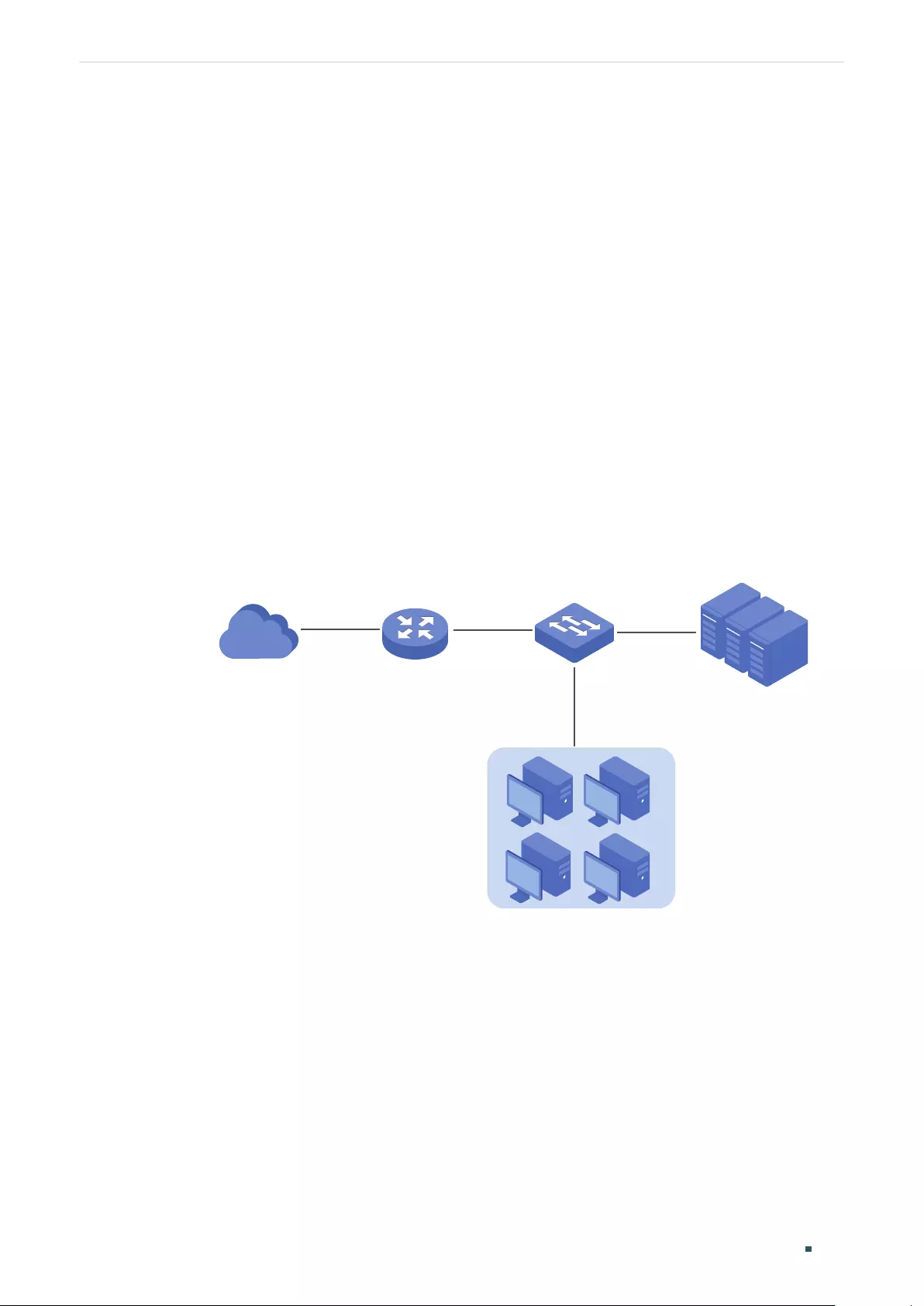
Configuration Guide 714
Configuring ACL Configuration Example for ACL
3 Configuration Example for ACL
3.1 Network Requirements
A company’s internal server group can provide different types of services. It is required
that:
the Marketing department can only access internal server group in the intranet.
the Marketing department can only visit http and https websites on the internet.
3.2 Network Topology
As is shown below, computers in the Marketing department are connected to the switch
via port 1/0/1 , and the internal server group is connected to the switch via port 1/0/2.
Figure 3-1 Network Topology
Internet
Gi1/0/1
Marketing
IP: 10.10.70.0/24
Server Group
IP: 10.10.80.0/24
Gi1/0/2
3.3 Configuration Scheme
To meet the requirements above, you can set up packet filtering by creating an Extend-IP
ACL and configuring rules for it.
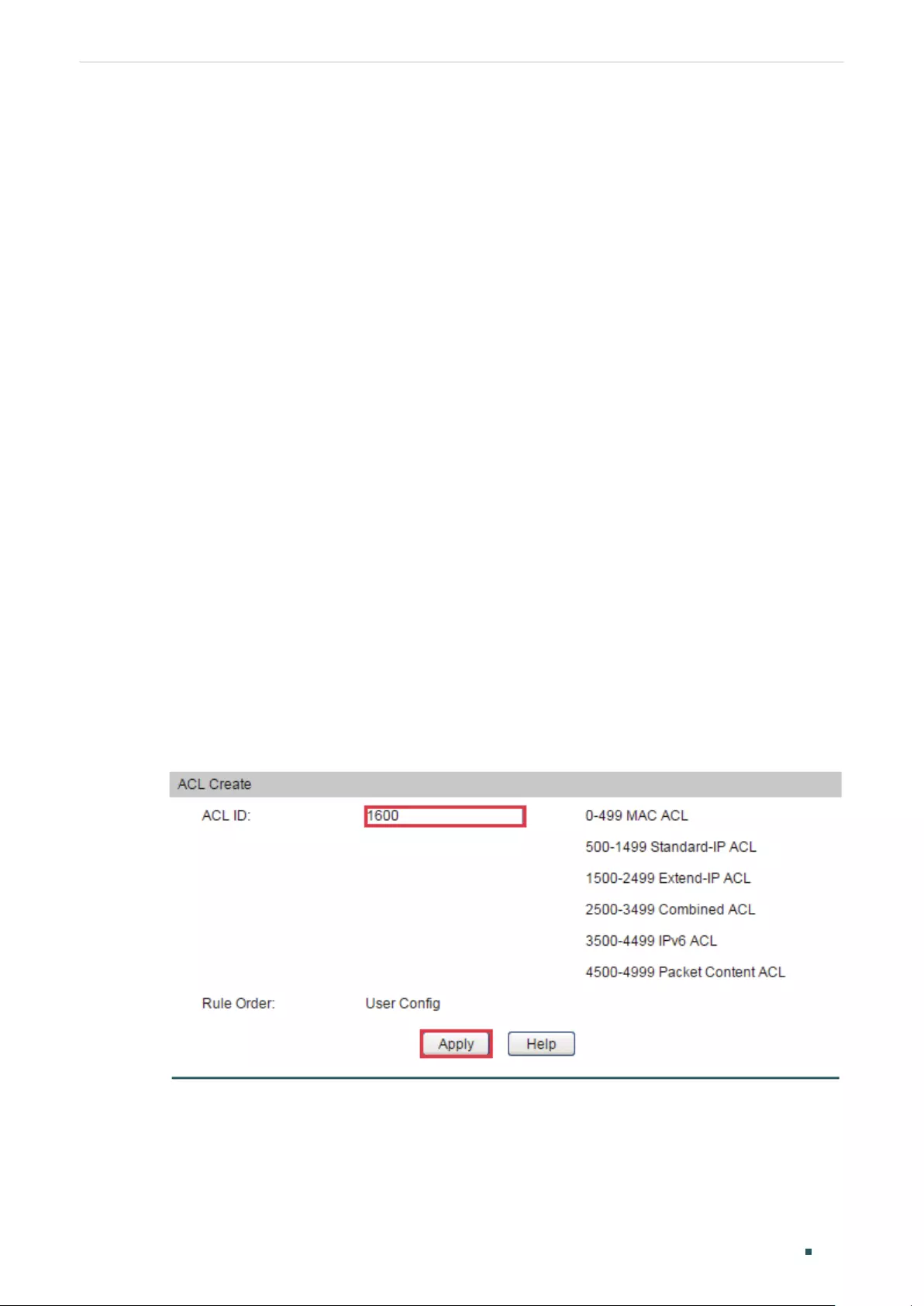
Configuring ACL Configuration Example for ACL
Configuration Guide 715
Configuring ACL
1) Configure a permit rule to match packets with source IP address 10.10.70.0/24, and
destination IP address 10.10.80.0/24. This rule allows the Marketing department to
access internal network servers from intranet.
2) Configure permit rules to match the packets with source IP address 10.10.70.0/24,
and destination ports TCP 80, TCP 443 and TCP/UDP 53. These allow the Marketing
department to visit http and https websites on the internet.
3) Configure a deny rule to match the packets with source IP address 10.10.70.0. This rule
blocks other network services.
The switch matches the packets with the rules in order, starting with Rule 1. If a packet
matches a rule, the switch stops the matching process and initiates the action defined in
the rule.
Binding Configuration
Apply the Extend-IP ACL to a Policy and bind the Policy to port 1/0/1 so that the ACL rules
will apply to the Marketing department only.
Demonstrated with T2600G-28TS, the following sections explain the configuration
procedure in two ways: using the GUI and using the CLI.
3.4 Using the GUI
1) Choose the menu ACL > ACL Config > ACL Create to load the following page. Then
create Extend- IP ACL 1600.
Figure 3-2 Creating an Extend-IP ACL
2) Choose the menu ACL > ACL Config > Extend-IP ACL to load the the following page.
Configure Rule 1 to match packets with the source IP address 10.10.70.0/24 and
destination IP address 10.10.80.0/24.
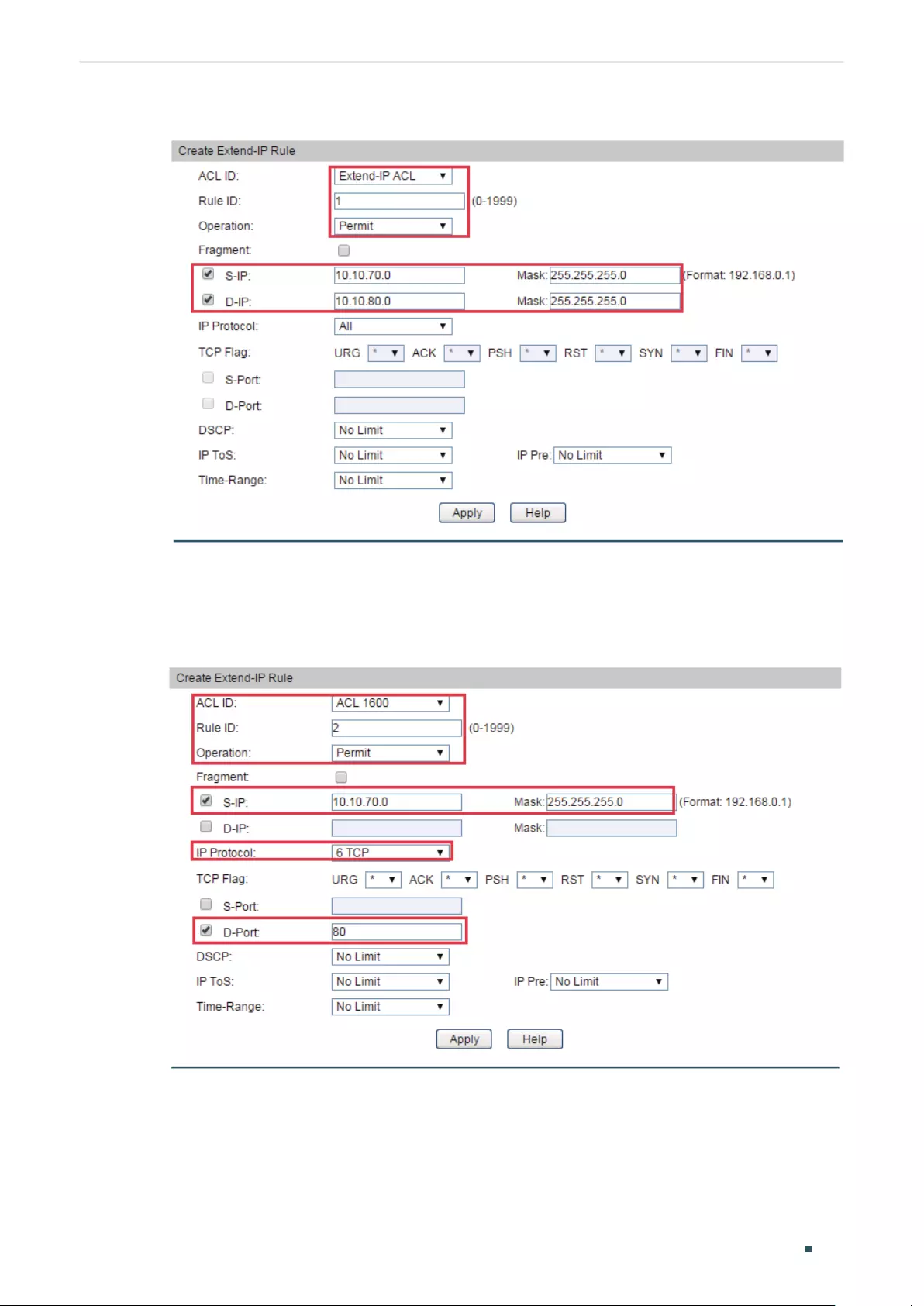
Configuration Guide 716
Configuring ACL Configuration Example for ACL
Figure 3-3 Configuring Rule 1
3) Choose the menu ACL > ACL Config > Extend-IP ACL to load the the following page.
Configure rule 2 and rule 3 to permit packets with source IP 10.10.70.0 and destination
port TCP 80 (http service port) and UDP 443 (https service port).
Figure 3-4 Configuring Rule 2

Configuring ACL Configuration Example for ACL
Configuration Guide 717
Figure 3-5 Configuring Rule 3
4) Choose the menu ACL > ACL Config > Extend-IP ACL to load the following page.
Configure Rule 4 and Rule 5 to permit packets with source IP 10.10.70.0 and with
destination port TCP 53 or UDP 53 (DNS service port).
Figure 3-6 Configuring Rule 4

Configuration Guide 718
Configuring ACL Configuration Example for ACL
Figure 3-7 Configuring Rule 5
5) Choose the menu ACL > ACL Config > Extend-IP ACL to load the following page.
Configure Rule 6 to deny packets with source IP 10.10.70.0.
Figure 3-8 Configuring Rule 6
6) Choose the menu ACL > Policy Config > Policy Create to load the the following page.
Then create Policy Market.
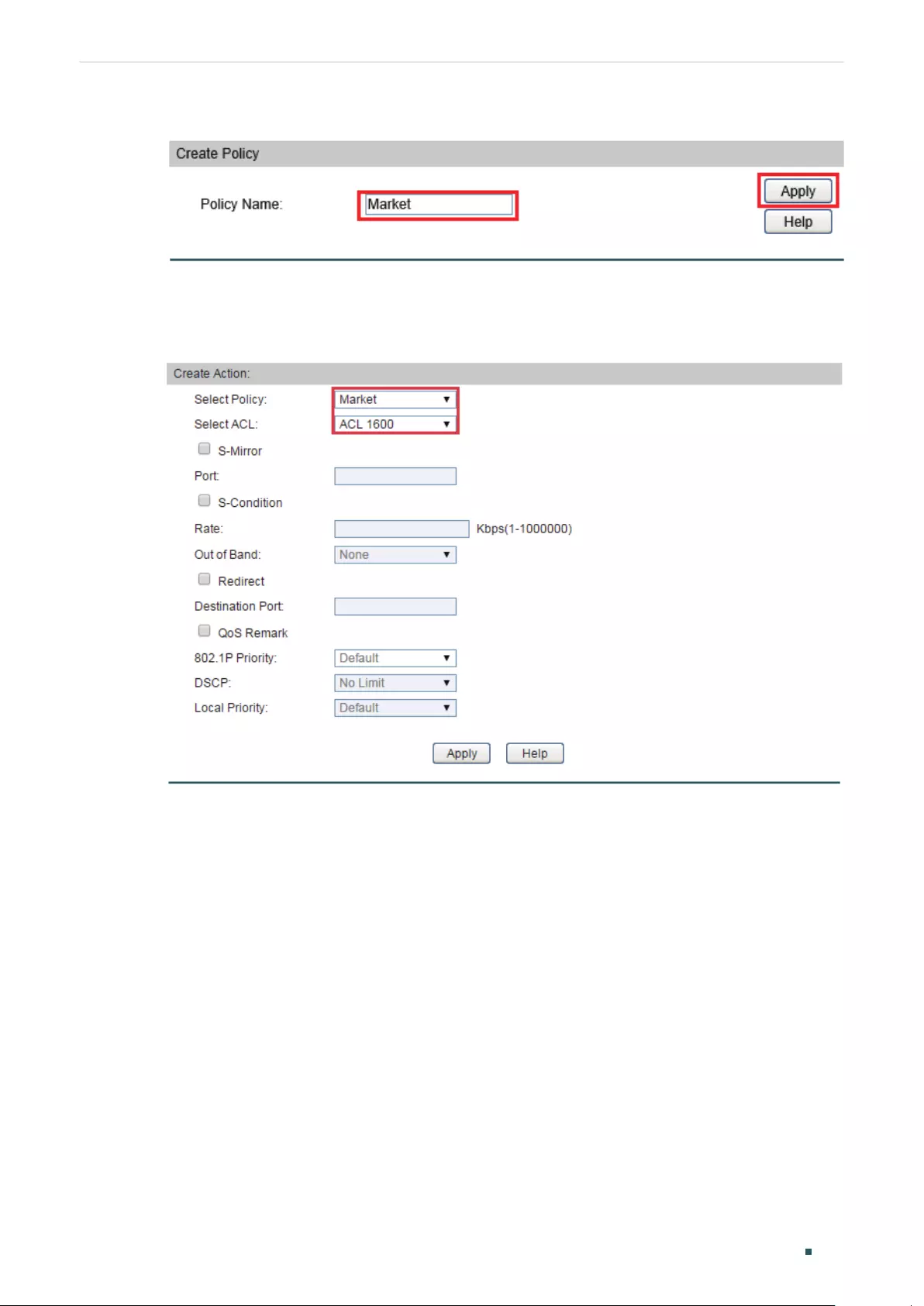
Configuring ACL Configuration Example for ACL
Configuration Guide 719
Figure 3-9 Creating the Policy
7) Choose the menu ACL > Policy Config > Action Create to load the the following page.
Then apply ACL 1600 to Policy Market.
Figure 3-10 Applying the ACL to the Policy
8) Choose the menu ACL > Policy Binding > Port Binding to load the the following page.
Bind Policy Market to port 1/0/1 to make it take effect.

Configuration Guide 720
Configuring ACL Configuration Example for ACL
Figure 3-11 Binding the Policy to Port 1/0/1
9) Click Save Config to save the settings.
3.5 Using the CLI
1) Create Extended-IP ACL 1600.
Switch#configure
Switch(config)#access-list create 1600
2) Configure rule 1 to permit packets with source IP 10.10.70.0 and destination IP
10.10.80.0.
Switch(config)#access-list extended 1600 rule 1 permit sip 10.10.70.0 smask
255.255.255.0 dip 10.10.80.0 dmask 255.255.255.0
3) Configure Rule 2 and Rule 3 to permit packets with source IP 10.10.70.0, and destination
port TCP 80 (http service port) or TCP 443 (https service port).
Switch(config)#access-list extended 1600 rule 2 permit sip 10.10.70.0 smask
255.255.255.0 protocol 6 d-port 80
Switch(config)#access-list extended 1600 rule 3 permit sip 10.10.70.0 smask
255.255.255.0 protocol 6 d-port 443
4) Configure Rule 4 and Rule 5 to permit packets with source IP 10.10.70.0, and destination
port TCP53 or UDP 53.
Switch(config)#access-list extended 1600 rule 4 permit sip 10.10.70.0 smask
255.255.255.0 protocol 6 d-port 53

Configuring ACL Configuration Example for ACL
Configuration Guide 721
Switch(config)#access-list extended 1600 rule 5 permit sip 10.10.70.0 smask
255.255.255.0 protocol 17 d-port 53
5) Configure Rule 6 to deny packets with source IP 10.10.70.0.
Switch(config)#access-list extended 1600 rule 6 deny sip 10.10.70.0 smask
255.255.255.0
6) Create Policy Market, and then apply ACL 1600 to it.
Switch(config)#access-list policy name Market
Switch(config)#access-list policy action Market 1600
Switch(config-action)#exit
7) Bind Policy Market to Port 1.
Switch(config)#interface gigabitEthernet 1/0/1
Switch(config-if)#access-list bind Market
Switch(config-if)#exit
Switch(config)#end
Switch#copy running-config startup-config
Verify the Configurations
Verify the
Extended IP access list 1600
rule 1 permit sip 10.10.70.0 smask 255.255.255.0 dip 10.10.80.0 dmask
255.255.255.0
rule 2 permit sip 10.10.70.0 smask 255.255.255.0 protocol 6 d-port 80
rule 3 permit sip 10.10.70.0 smask 255.255.255.0 protocol 6 d-port 443
rule 4 permit sip 10.10.70.0 smask 255.255.255.0 protocol 6 d-port 53
rule 5 permit sip 10.10.70.0 smask 255.255.255.0 protocol 17 d-port 53
rule 6 deny sip 10.10.70.0 smask 255.255.255.0
Switch(config)#show access-list bind
Index Policy Name Interface/VID Direction Type
----- ----------- ------------- -------- ----
1 Market Gi1/0/1 Ingress Port
Index ACL ID Interface/VID Direction Type
----- ----------- ------------- -------- ----

Configuration Guide 722
Configuring ACL Appendix: Default Parameters
4 Appendix: Default Parameters
For MAC ACL:
Parameter Default Setting
Operation Permit
User Priority No Limit
Time-Range No Limit
For Standard-IP ACL:
Parameter Default Setting
Operation Permit
Time-Range No Limit
For Extend-IP ACL:
Parameter Default Setting
Operation Permit
IP Protocol All
DSCP No Limit
IP ToS No Limit
IP Pre No Limit
Time-Range No Limit
For IPv6 ACL:
Parameter Default Setting
Operation Permit
Time-Range No Limit

Configuring ACL Appendix: Default Parameters
Configuration Guide 723
For Combined ACL:
Parameter Default Setting
Operation Permit
Time-Range No Limit
For Packet Content ACL:
Parameter Default Setting
Operation Permit
Time-Range No Limit

Part 27
Configuring
Network Security
CHAPTERS
1 . Network Security 8 . IP Source Guard
2 . IP-MAC Binding 9 . DoS Defend
3 . IPv6-MAC Binding 10 . 802.1X
4 . DHCP Snooping 11 . PPPoE ID-Insertion
5 . DHCPv6 Snooping 12 . AAA
6 . ARP Inspection 13 . Configuration Examples
7 . ND Detection 14 . Appendix: Default Parameters

Configuration Guide 725
Configuring Network Security Network Security
1 Network Security
1.1 Overview
Network Security provides multiple protection measures for the network. Users can configure
the security functions according to their needs.
1.2 Supported Features
The switch supports multiple network security features, for example, IP-MAC Binding, DHCP
Snooping, ARP Inspection and so on.
IP-MAC Binding
IP-MAC Binding is used to bind the IP address, MAC address, VLAN ID and the connected
port number of the specified host. Basing on the IP-MAC binding table, the switch can
prevent the ARP cheating attacks with the ARP Detection feature and filter the packets that
don’t match the binding entries with the IP Source Guard feature.
The binding entries can be manually configured, or learned by ARP scanning or DHCP
snooping.
IPv6-MAC Binding
IPv6-MAC Binding is used to bind the IPv6 address, MAC address, VLAN ID and the
connected port number of the specified host. Basing on the IPv6-MAC binding table, the
switch can prevent the ND attacks with the ND Detection feature and filter the IPv6 packets
that don’t match the binding entries with the IP Source Guard feature.
The binding entries can be manually configured, or learned by ND Snooping or DHCPv6
snooping.
DHCP Snooping
DHCP Snooping supports the basic DHCP security feature and the Option 82 feature.
Basic DHCP Security
During the working process of DHCP, generally there is no authentication mechanism
between the DHCP server and the clients. If there are several DHCP servers on the
network, security problems and network interference will happen. DHCP Snooping resolves
this problem.

Configuration Guide 726
Configuring Network Security Network Security
As the following figure shows, the port connected to the legal DHCP server should be
configured as a trusted port, and other ports should be configured as untrusted ports.
When receiving the DHCP discover or DHCP request packets, the switch forwards them to
the legal DHCP server only through the trusted port. When receiving the respond packets,
the switch will determine whether to send or not depending on the type of receiving port:
packets received from the trusted port will be forwarded, otherwise they will be discarded.
DHCP Snooping ensures that users get IP addresses only from the legal DHCP server,
enhancing the network security.
Figure 1-1 Network Topology of Basic DHCP Security
Switch
Trusted Port
Untrusted Port
Untrusted Port
Illegal DHCP ServerClients
Legal DHCP Server
Additionally, with DHCP Snooping, the switch can monitor the IP address obtaining process
of each client host and record the IP address, MAC address, VLAN ID and the connected
port number of the host for automatic binding.
Option 82
Option 82 records the location of the DHCP client. The switch can add option 82 to the
DHCP request packet and then transmit the packet to the DHCP server. Administrators can
check the location of the DHCP client via option 82. The DHCP server supporting option 82
can also set the distribution policy of IP addresses and the other parameters, providing a
more flexible address distribution way.
DHCPv6 Snooping
DHCPv6 Snooping is similar with DHCP Snooping introduced above. It ensures that users
get IPv6 addresses from the legal DHCPv6 server and enhances the network security.
Besides, with DHCPv6 Snooping, the switch can monitor the IPv6 address obtaining
process of each client host and record the IPv6 address, MAC address, VLAN ID and the
connected port number of the host for automatic binding.

Configuration Guide 727
Configuring Network Security Network Security
ARP Inspection
In an actual complex network, there are high security risks during ARP implementation
procedure. The cheating attacks against ARP, such as imitating gateway, cheating gateway,
cheating terminal hosts and ARP flooding attack, frequently occur to the network. ARP
Inspection can prevent the network from these ARP attacks.
Prevent ARP Cheating Attacks
Based on the predefined IP-MAC Binding entries, the ARP Inspection can be configured to
detect the ARP packets and filter the illegal ones so as to prevent the network from ARP
cheating attacks.
Prevent ARP Flooding Attack
With the ARP Defend feature the switch can terminate receiving the ARP packets for 300
seconds when the transmission speed of the legal ARP packet on the port exceeds the
defined value so as to avoid ARP flooding attack.
ND Detection
Because of the absence of security mechanism, IPv6 ND (Neighbor Discovery) protocol is
easy to be exploited by attackers. ND detection feature uses the entries in the IPv6-MAC
binding table to filter the forged ND packets and prevent the ND attacks.
The application topology of ND Detection is as the following figure shows. the port that is
connected to the gateway should be configured as trusted port, and other ports should be
configured as untrusted ports. The forwarding principles of ND packets are as follows:
All ND packets received on the trusted port will be forwarded without checked.
RS (Router Solicitation) and NS (Neighbor Solicitation) packets with their source IPv6
addresses unspecified, such as the RS packet for IPv6 address request and the NS
packet for duplicate address detection, will not be checked on both kinds of ports.
RA (Router Advertisement) and RR (Router Redirect) packets received on the untrusted
port will be discarded directly, and other ND packets will be checked: The switch will
use the IPv6-MAC binding table to compare the IPv6 address, MAC address, VLAN ID
and receiving port between the entry and the ND packet. If a match is found, the ND
packet is considered legal and will be forwarded; if no match is found, the ND packet is
considered illegal and will be discarded.

Configuration Guide 728
Configuring Network Security Network Security
Figure 1-2 Network Topology of ND Detection
Trusted
Port
Switch
Untrusted Port
Untrusted Port
Attacker
User A
Gateway
Internet
IP Source Guard
IP Source Guard is to filter the IP packets and IPv6 packets based on the IP-MAC Binding
table and IPv6 MAC-Binding table. Only the packets that match the binding rules are
permitted, which enhances the network security.
DoS Defend
The DoS (Denial of Service) defend feature provides protection against DoS attacks. DoS
attacks occupy the network bandwidth maliciously by sending numerous service requests
to the hosts. It results in an abnormal service or breakdown of the network.
With DoS Defend feature, the switch can analyze the specific fields of the IP packets,
distinguish the malicious DoS attack packets and discard them directly. Also, DoS Defend
feature can limit the transmission rate of legal packets. When the number of legal packets
exceeds the threshold value and may incur a breakdown of the network, the switch will
discard the packets.
802.1X
802.1X protocol is a protocol for port-based Network Access Control. It is used to
authenticate and control access from devices connected to the ports. If the device
connected to the port is authenticated by the authentication server successfully, its
request to access the LAN will be accepted; if not, its request will be denied.
802.1X authentication uses the typical client-server model which contains three device
roles: client/supplicant, authenticator and authentication server. This is described in the
figure below:

Configuration Guide 729
Configuring Network Security Network Security
Figure 1-3 802.1X Authentication Model
Authentication Server
Clients
Switch
Authenticator
Client
A client, usually a computer, is connected to the authenticator via a physical port. We
recommend that you install TP-Link 802.1X authentication client software on the client
hosts, enabling them to request 802.1X authentication to access the LAN.
Authenticator
An authenticator is usually a network device that supports 802.1X protocol. As the above
figure shows, the switch is an authenticator.
The authenticator acts as an intermediate proxy between the client and the authentication
server. The authenticator requests user information from the client and sends it to the
authentication server; also, the authenticator obtains responses from the authentication
server and send them to the client. The authenticator allows authenticated clients to
access the LAN through the connected ports but denies the unauthenticated clients.
Authentication Server
The authentication server is usually the host running the RADIUS server program. It stores
information of clients, confirms whether a client is legal and informs the authenticator
whether a client is authenticated.
PPPoE ID-Insertion
In common PPPoE dialup mode, when users dial up through PPPoE, they can access the
network as long as their accounts are authenticated successfully on the RADIUS server. As
a result, the illegal users can embezzle the accounts to access the Internet.
PPPoE ID-Insertion provides a way to resolve this problem. With this feature enabled, the
switch attaches a tag to the PPPoE Active Discovery packets received from the client,
and sends it to the BRAS (Broadband Remote Access Server). The tag records the client
information, such as the connected port number and the MAC address of the client. The

Configuration Guide 730
Configuring Network Security Network Security
BRAS uses the tag as a NAS-Port-ID attribute in the RADIUS packet and send it to the
RADIUS server for PPP (Point-to-Point Protocol) authentication. If the tag information is
different from the configured one, the authentication will fail. In this way, the illegal users
cannot embezzle the accounts of legal users to access the Internet.
Additionally, after receiving the PPPoE Active Discovery Offer packet or Session-
confirmation packet from the BRAS, the switch will remove the tag in the packet and send it
to the client.
Figure 1-4 Network Topology of PPPoE ID-Insertion
Switch RADIUS Server
Client BRAS
PPPoE Server
AAA
AAA stands for authentication, authorization and accounting. On TP-Link switches,
this feature is mainly used to authenticate the users trying to log in to the switch or get
administrative privileges. The administrator can create guest accounts and an Enable
password for other users. The guests do not have administrative privileges without the
Enable password provided.
AAA provides a safe and efficient authentication method. The authentication can be
processed locally on the switch or centrally on the RADIUS/TACACS+ server(s). As the
following figure shows, the network administrator can centrally configure the management
accounts of the switches on the RADIUS server and use this server to authenticate the
users trying to access the switch or get administrative privileges.
Figure 1-5 Network Topology of AAA
RADIUS Server
Users Switches

Configuration Guide 731
Configuring Network Security IP-MAC Binding Configurations
2 IP-MAC Binding Configurations
You can complete IP-MAC binding in two ways:
Manual Binding
Dynamical Binding (including ARP Scanning and DHCP Snooping)
Additionally, you can search the specified entries in the Binding Table.
2.1 Using the GUI
2.1.1 Binding Entries Manually
You can manually bind the IP address, MAC address, VLAN ID and the Port number
together on the condition that you have got the related information of the hosts on the
network.
Choose the menu Network Security > IP-MAC Binding > Manual Binding to load the
following page.
Figure 2-1 Manual Binding
In the Manual Binding Option section, follow these steps to configure IP-MAC Binding:
1) Enter the following information to specify a host.

Configuration Guide 732
Configuring Network Security IP-MAC Binding Configurations
Host Name Enter the host name for identification.
IP Address Enter the IP address.
MAC Address Enter the MAC address.
VLAN ID Enter the VLAN ID.
2) Select protect type for the entry.
Protect Type Select the protect type for the entry:
None: This entry will not be applied to any feature.
ARP Detection: This entry will be applied to the ARP Detection feature.
IP Source Guard: This entry will be applied to the IP Source Guard feature.
All: This entry will be applied to both the features.
3) Select the port that is connected to this host.
4) Click Bind.
2.1.2 Binding Entries Dynamically
The binding entries can be dynamically learned from ARP Scanning and DHCP Snooping.
ARP Scanning
With ARP Scanning, the switch sends the ARP request packets of the specified IP field to
the hosts. Upon receiving the ARP reply packet, the switch can get the IP address, MAC
address, VLAN ID and the connected port number of the host. You can bind these entries
conveniently.

Configuration Guide 733
Configuring Network Security IP-MAC Binding Configurations
Choose the menu Network Security > IP-MAC Binding > ARP Scanning to load the
following page.
Figure 2-2 ARP Scanning
Follow these steps to configure IP-MAC Binding via ARP scanning:
1) In the Scanning Option section, specify an IP address range and a VLAN ID. Then click
Scan to scan the entries in the specified IP address range and VLAN.
Start IP Address/
End IP Address
Specify an IP range by entering a start and end IP address.
VLAN ID Specify a VLAN ID.
2) In the Scanning Result section, select one or more entries and configure the relevant
parameters. Then click Apply.
Host Name Enter a host name for identification.
IP Address Displays the IP address.
MAC Address Displays the MAC address.
VLAN ID Displays the VLAN ID.
Port Displays the port number.

Configuration Guide 734
Configuring Network Security IP-MAC Binding Configurations
Protect Type Select the protect type for the entry:
None: This entry will not be applied to any feature.
ARP Detection: This entry will be applied to the ARP Detection feature.
IP Source Guard: This entry will be applied to the IP Source Guard feature.
All: This entry will be applied to both the features.
Source Displays the source of the entry.
Collision Displays the collision status of the entry.
Warning: The collision entries have the same IP address and MAC address, and
all the collision entries are valid. This kind of collision may be caused by the MSTP
function.
Critical: The collision entries have the same IP address but different MAC
addresses. For the collision entries learned from the same source, only the newly
added entry will be valid. For the collision entries learned from different sources,
only the entry with the highest priority will be valid. The priority of different entry
types, from high to low, is Manually, ARP Scanning and DHCP Snooping.
DHCP Snooping
With DHCP Snooping enabled, the switch can monitor the IP address obtaining process
of the host, and record the IP address, MAC address, VLAN ID and the connected port
number of the host.
For instructions on how to configure DHCP Snooping, refer to DHCP Snooping
Configurations.
2.1.3 Viewing the Binding Entries
With the Binding Table, you can view and search the specified binding entries.
Choose the menu Network Security > IP-MAC Binding > Binding Table to load the
following page.
Figure 2-3 Binding Table
In the Search section, specify the search criteria to search your desired entries.

Configuration Guide 735
Configuring Network Security IP-MAC Binding Configurations
Source Select the source of the entry and click Search.
All: Displays the entries from all sources.
Manual: Displays the manually bound entries.
Scanning: Displays the binding entries learned from ARP Scanning.
Snooping: Displays the binding entries learned from DHCP Snooping.
IP: Enter an IP address and click Search to search the specific entry.
In the Binding Table section, you can view the searched entries. Additionally, you can
configure the host name and protect type for one or more entries, and click Apply.
Host Name Enter a host name for identification.
IP Address Displays the IP address.
MAC Address Displays the MAC address.
VLAN ID Displays the VLAN ID.
Port Displays the port number.
Protect Type Select the protect type for the entry:
None: This entry will not be applied to any feature.
ARP Detection: This entry will be applied to the ARP Detection feature.
IP Source Guard: This entry will be applied to the IP Source Guard feature.
All: This entry will be applied to both the features.
Source Displays the source of the entry.
Collision Displays the collision status of the entry.
Warning: The collision entries have the same IP address and MAC address, and all the
collision entries are valid. This kind of collision may be caused by the MSTP function.
Critical: The collision entries have the same IP address but different MAC addresses.
For the collision entries learned from the same source, only the newly added entry will
be valid. For the collision entries learned form different sources, only the entry with
the highest priority will be valid. The priority of different entry types, from high to low,
is Manually, ARP Scanning and DHCP Snooping.
2.2 Using the CLI
Binding entries via ARP scanning is not supported by the CLI; Binding entries via DHCP
Snooping is introduced in DHCP Snooping Configurations. The following sections introduce
how to bind entries manually and view the binding entries.

Configuration Guide 736
Configuring Network Security IP-MAC Binding Configurations
2.2.1 Binding Entries Manually
You can manually bind the IP address, MAC address, VLAN ID and the Port number
together on the condition that you have got the related information of the hosts.
Follow these steps to manually bind entries:
Step 1 configure
Enter global configuration mode.
Step 2 ip source binding
hostname
ip-addr mac-addr
vlan
vlan-id
interface gigabitEthernet
port
{ none | arp-detection | ip-verify-source | both } [ forced-source {arp-scanning |
dhcp-snooping} ]
Manually bind the host name, IP address, MAC address, VLAN ID and port number of
the host, and configure the protect type for the host. In addition, you can change the
source of the entry as ARP Scanning or DHCP Snooping.
hostname
:
Specify a name for the host. It contains 20 characters at most.
ip-addr
:
Enter the IP address of the host.
mac-addr
:
Enter the MAC address of the host, in the format of xx:xx:xx:xx:xx:xx.
vlan-id
:
Enter the VLAN ID of the host.
port
:
Enter the number of the port on which the host is connected.
none | arp-detection | ip-verify-source | both:
Specify the protect type for the
entry. None indicates this entry will not be applied to ARP Detection; arp-detection
indicates this entry will be applied to ARP Detection.
arp-scanning | dhcp-snooping:
Change the source of the entry to ARP Scanning or
DHCP Snooping.
Step 3 show ip source binding
Verify the binding entry.
Step 4 end
Return to privileged EXEC mode.
Step 5 copy running-config startup-config
Save the settings in the configuration file.
The following example shows how to bind an entry with the hostname host1, IP address
192.168.0.55, MAC address AA-BB-CC-DD-EE-FF, VLAN ID 10, port number 1/0/5, and
enable this entry for the ARP detection feature.
Switch#configure
Switch(config)#ip source binding host1 192.168.0.55 aa:bb:cc:dd:ee:ff vlan 10 interface
gigabitEthernet 1/0/5 arp-detection

Configuration Guide 737
Configuring Network Security IP-MAC Binding Configurations
Switch(config)#show ip source binding
U No. Host IP-Addr MAC-Addr VID Port ACL Col.
-- --- ------- -------- -------- ------ ----- ------ -----
1 1 host1 192.168.0.55 aa:bb:cc:dd:ee:ff 10 Gi1/0/5 ARP-D
Switch(config)#end
Switch#copy running-config startup-config
2.2.2 Viewing Binding Entries
On privileged EXEC mode or any other configuration mode, you can use the following
command to view binding entries:
show ip source binding
View the information of binding entries, including the host name, IP address, MAC address, VLAN ID, port
number, protect type and collision status.
There are two types of collision status: Warning and Critical.
Warning: The collision entries have the same IP address and MAC address, and all the collision entries are
valid. This kind of collision may be caused by the MSTP function.
Critical: The collision entries have the same IP address but different MAC addresses. For the collision
entries learned from the same source, only the newly added entry will be valid. For the collision entries
learned different sources, only the entry with the highest priority will be valid. The priority of different entry
types, from high to low, is Manually, ARP Scanning and DHCP Snooping.
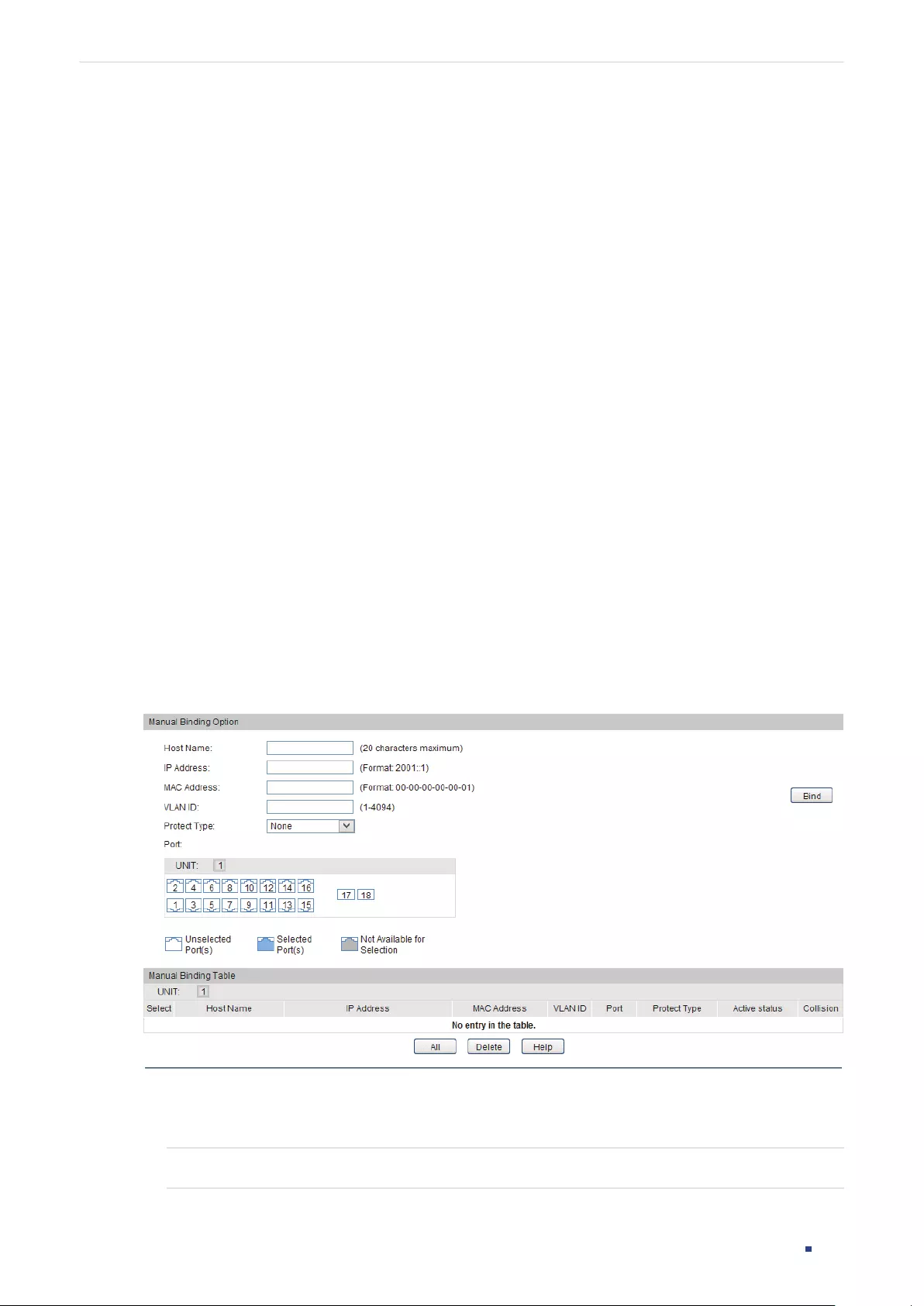
Configuration Guide 738
Configuring Network Security IPv6-MAC Binding Configurations
3 IPv6-MAC Binding Configurations
You can complete IPv6-MAC binding in two ways:
Manual Binding
Dynamical Binding (including ND Snooping and DHCPv6 Snooping)
Additionally, you can search the specified entries in the Binding Table.
3.1 Using the GUI
3.1.1 Binding Entries Manually
You can manually bind the IPv6 address, MAC address, VLAN ID and the Port number
together on the condition that you have got the related information of the hosts on the
network.
Choose the menu Network Security > IPv6-MAC Binding > Manual Binding to load the
following page.
Figure 3-1 Manual Binding
In the Manual Binding Option section, follow these steps to configure IPv6-MAC Binding:
1) Enter the following information to specify a host.
Host Name Enter the host name for identification.

Configuration Guide 739
Configuring Network Security IPv6-MAC Binding Configurations
IP Address Enter the IP address.
MAC Address Enter the MAC address.
VLAN ID Enter the VLAN ID.
2) Select protect type for the entry.
Protect Type Select the protect type for the entry:
None: This entry will not be applied to any feature.
ND Detection: This entry will be applied to the ND Detection feature.
IP Source Guard: This entry will be applied to the IP Source Guard feature.
All: This entry will be applied to both ND Detection and IP Source Guard.
3) Select the port that is connected to this host.
4) Click Bind.
3.1.2 Binding Entries Dynamically
The binding entries can be dynamically learned from ND Snooping and DHCPv6 Snooping.
ND Snooping
With ND Snooping, the switch monitors the ND packets, and records the IPv6 addresses,
MAC addresses, VLAN IDs and the connected port numbers of the IPv6 hosts. You can
bind these entries conveniently.

Configuration Guide 740
Configuring Network Security IPv6-MAC Binding Configurations
Choose the menu Network Security > IPV6-MAC Binding > ND Snooping to load the
following page.
Figure 3-2 ND Snooping
Follow these steps to configure IPv6-MAC Binding via ND Snooping:
1) In the ND Snooping section, enable ND Snooping globally and on the specified VLAN(s).
Then click Apply.
ND Snooping Enable ND Snooping Globally.
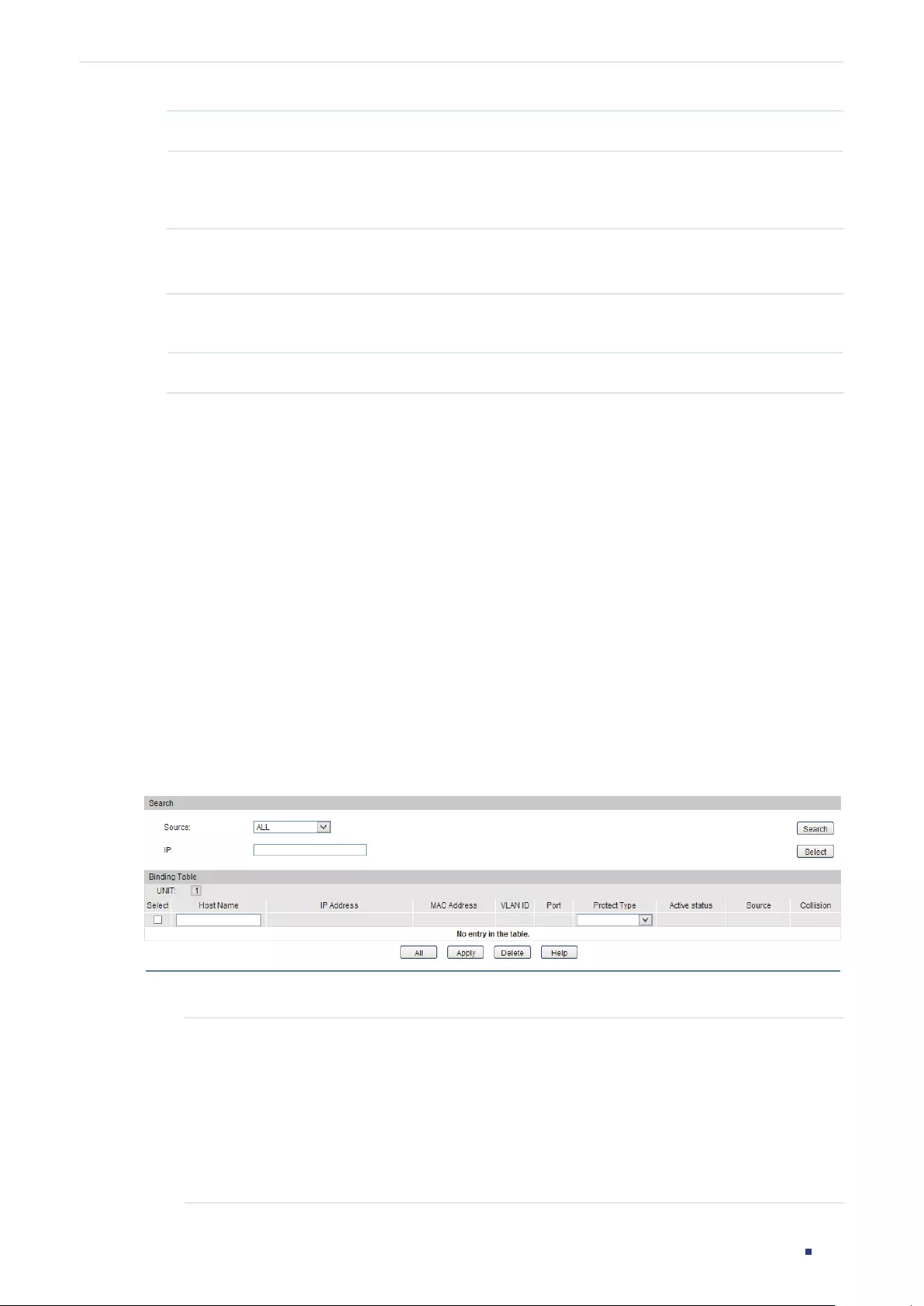
Configuration Guide 741
Configuring Network Security IPv6-MAC Binding Configurations
VLAN ID Specify one or more VLAN IDs to enable ND Snooping on the VLAN(s).
VLAN
Configuration
Display
Displays the VLANs that have been enabled with ND Snooping.
2) In the Port Configure section, select one or more ports and configure the maximum
number of entries that can be learned on this port via ND Snooping. Then click Apply.
Maximum Entry
(0~1024)
Configure the maximum number of ND binding entries a port can learn via ND
snooping. The valid values are from 0 to 1024, and the default is 1024.
LAG Displays the LAG that the port is in.
DHCPv6 Snooping
With DHCPv6 Snooping enabled, the switch can monitor the IPv6 address obtaining
process of the host, and record the IPv6 address, MAC address, VLAN ID and the
connected port number of the host.
For instructions on how to configure DHCPv6 Snooping, refer to
DHCPv6 Snooping
Configuration
.
3.1.3 Viewing the Binding Entries
With the Binding Table, you can view and search the specified binding entries.
Choose the menu Network Security > IPv6-MAC Binding > Binding Table to load the
following page.
Figure 3-3 Binding Table
In the Search section, specify the search criteria to search your desired entries.
Source Select the source of the entry and click Search.
All: Displays the entries from all sources.
Manual: Displays the manually bound entries.
ND Snooping: Displays the binding entries learned from ND Snooping.
DHCP Snooping: Displays the binding entries learned from DHCP Snooping.

Configuration Guide 742
Configuring Network Security IPv6-MAC Binding Configurations
IP Enter an IP address and click Search to search the specific entry.
In the Binding Table section, you can view the search results. Additionally, you can
configure the host name and protect type for one or more entries, and click Apply.
Host Name Enter a host name for identification.
IP Address Displays the IPv6 address.
MAC Address Displays the MAC address.
VLAN ID Displays the VLAN ID.
Port Displays the port number.
Protect Type Select the protect type for the entry:
None: This entry will not be applied to any feature.
ND Detection: This entry will be applied to the ND Detection feature.
IP Source Guard: This entry will be applied to the IP Source Guard feature.
All: This entry will be applied to both ND Detection and IP Source Guard.
Active Status Displays whether the binding entries are valid for each feature.
ND Detection: The entries are valid for ND Detection.
IP Source Guard: The entries are valid for IP Source Guard.
All: The entries are valid for both ND Detection and IP Source Guard.
None: The entries are valid for no feature.
Source Displays the source of the entry.
Collision Displays the collision status of the entry.
Warning: The collision entries have the same IPv6 address and MAC address,
and all the collision entries are valid. This kind of collision may be caused by
the MSTP function.
Critical: The collision entries have the same IPv6 address but different MAC
addresses. For the collision entries learned from the same source, only the
newly added entry will be valid. For the collision entries learned form different
sources, only the entry with the highest priority will be valid. The priority of
different entry types, from high to low, is Manually, DHCP Snooping and ND
Snooping.

Configuration Guide 743
Configuring Network Security IPv6-MAC Binding Configurations
3.2 Using the CLI
Binding entries via DHCPv6 Snooping is introduced in
DHCPv6 Snooping Configuration
. The
following sections introduce how to bind entries manually and via ND Snooping, and how to
view the binding entries.
3.2.1 Binding Entries Manually
You can manually bind the IPv6 address, MAC address, VLAN ID and the Port number
together on the condition that you have got the related information of the hosts.
Follow these steps to manually bind entries:
Step 1 configure
Enter global configuration mode.
Step 2 ipv6 source binding
hostname
ipv6-addr mac-addr
vlan
vlan-id
interface{
fastEthernet
port
| gigabitEthernet
port
} { none | nd-detection | ipv6-verify-source | both }
Manually bind the host name, IPv6 address, MAC address, VLAN ID and port number of the
host, and configure the protect type for the host.
hostname
:
Specify a name for the host. It contains 20 characters at most.
ipv6-addr
:
Enter the IPv6 address of the host, in the format of X:X:X:X::X.
mac-addr
:
Enter the MAC address of the host, in the format of xx:xx:xx:xx:xx:xx.
vlan-id
:
Enter the VLAN ID of the host.
port
:
Enter the number of the port on which the host is connected.
none | nd-detection | ipv6-verify-source | both:
Specify the protect type for the entry. None
indicates this entry will not be applied to any feature; nd-detection indicates this entry will
be applied to ND Detection; ipv6-verify-source indicates this entry will be applied to IP
Source Guard; both indicates this entry will be applied to both ND Detection and IP Source
Guard.
Step 3 show ipv6 source binding
Verify the binding entry.
Step 4 end
Return to privileged EXEC mode.
Step 5 copy running-config startup-config
Save the settings in the configuration file.
The following example shows how to bind an entry with the hostname host1, IPv6 address
2001:0:9d38:90d5::34, MAC address AA-BB-CC-DD-EE-FF, VLAN ID 10, port number 1/0/5,
and enable this entry for ND Detection.

Configuration Guide 744
Configuring Network Security IPv6-MAC Binding Configurations
Switch#configure
Switch(config)#ipv6 source binding host1 2001:0:9d38:90d5::34 aa:bb:cc:dd:ee:ff vlan 10
interface gigabitEthernet 1/0/5 nd-detection
Switch(config)#show ipv6 source binding
U No. Host IP-Addr MAC-Addr VID Port ACL Active Source Col.
- --- ---- ------- -------- --- ---- --- ----- ------ ----
1 1 host1 2001:0:9d38:90d5::34 aa:bb:cc:dd:ee:ff 10 Gi1/0/5 ND-D ND-D Manual
Switch(config)#end
Switch#copy running-config startup-config
3.2.2 Binding Entries via ND Snooping
Follow these steps to bind entries via ND Snooping:
Step 1 configure
Enter global configuration mode.
Step 2 ipv6 nd snooping
Globally enable ND Snooping.
Step 3 ipv6 nd snooping vlan
vlan-range
Enable ND Snooping on the specified VLAN.
vlan-range:
Enter the vlan range in the format of 1-3, 5.
Step 4 interface {
fastEthernet
port
| range fastEthernet
port-list
| gigabitEthernet
port
|
range
gigabitEthernet
port-list
}
Enter interface configuration mode.
Step 5 ipv6 nd snooping max-entries
value
Configure the maximum number of ND binding entries a port can learn via ND
snooping.
value:
Enter the maximum number of ND binding entries a port can learn via ND
snooping. The valid values are from 0 to 1024, and the default is 1024.
Step 6 show ipv6 nd snooping
Verify the global configuration of IPv6 ND Snooping
Step 7 show ipv6 nd snooping interface {
fastEthernet
port
| gigabitEthernet
port
}
Verify the IPv6 ND Snooping configuration of the specific port.

Configuration Guide 745
Configuring Network Security IPv6-MAC Binding Configurations
Step 8 end
Return to privileged EXEC mode.
Step 9 copy running-config startup-config
Save the settings in the configuration file.
The following example shows how to enable ND Snooping globally and on VLAN 1.
Switch#configure
Switch(config)#ipv6 nd snooping
Switch(config)#ipv6 nd snooping vlan 1
Switch(config)#show ipv6 nd snooping
Global Status: Enable
VLAN ID: 1
Switch(config)#end
Switch#copy running-config startup-config
The following example shows how to configure the maximum number of entries that can be
learned on port 1/0/1:
Switch#configure
Switch(config)#interface gigabitEthernet 1/0/1
Switch(config-if)#ipv6 nd snooping max-entries 1000
Switch(config-if)#show ipv6 nd snooping interface gigabitEthernet 1/0/1
Interface max-entries LAG
--------- ----------- -----
Gi1/0/1 1000 N/A
Switch(config-if)#end
Switch#copy running-config startup-config
3.2.3 Viewing Binding Entries
On privileged EXEC mode or any other configuration mode, you can use the following
command to view binding entries:

Configuration Guide 746
Configuring Network Security IPv6-MAC Binding Configurations
show ipv6 source binding
View the information of binding entries, including the host name, IPv6 address, MAC address, VLAN ID, port
number, protect type, source and collision status.
There are two types of collision status: Warning and Critical.
Warning: The collision entries have the same IPv6 address and MAC address, and all the collision entries
are valid. This kind of collision may be caused by the MSTP function.
Critical: The collision entries have the same IPv6 address but different MAC addresses. For the collision
entries learned from the same source, only the newly added entry will be valid. For the collision entries
learned different sources, only the entry with the highest priority will be valid. The priority of different entry
types, from high to low, is Manually, DHCPv6 Snooping and ND Snooping.
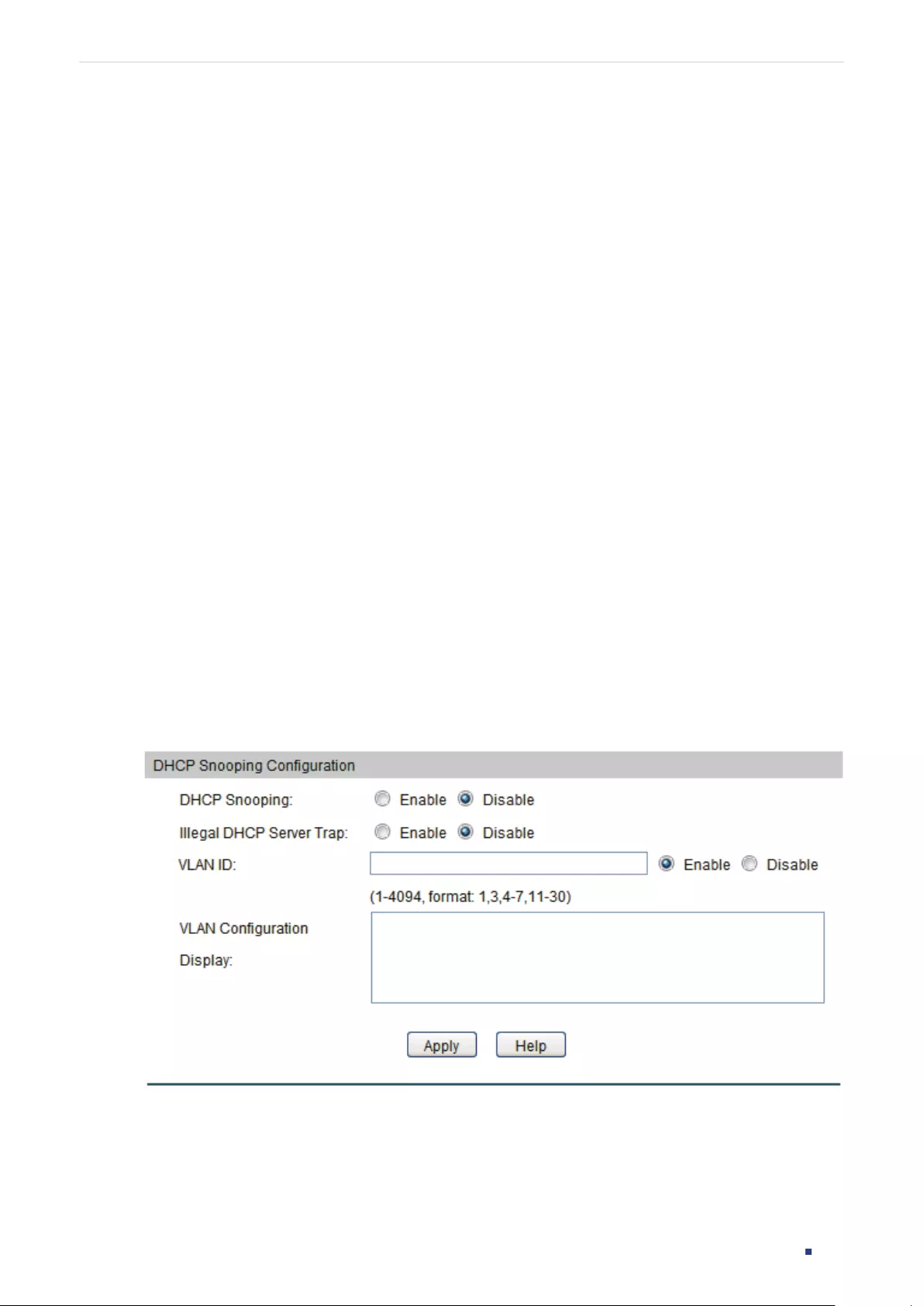
Configuration Guide 747
Configuring Network Security DHCP Snooping Configuration
4 DHCP Snooping Configuration
To complete DHCP Snooping configuration, follow these steps:
1) Enable DHCP Snooping on VLAN.
2) Configure DHCP Snooping on the specified port.
3) (Optional) Configure Option 82 on the specified port.
Tips:
The switch can dynamically bind the entries via DHCP Snooping after step 1 and step
2 are completed. By default, the binding entries are applied to ARP Detection.
Configuration Guidelines
DHCP Snooping and DHCP Relay cannot be used at the same time on the switch. When
both of these features are enabled, only DHCP Relay will work.
4.1 Using the GUI
4.1.1 Enabling DHCP Snooping on VLAN
Choose the menu Network Security > DHCP Snooping > Global Config to load the
following page.
Figure 4-1 Global Config
Follow these steps to enable DHCP Snooping:
1) Globally enable DHCP Snooping.
2) Configure the Illegal DHCP Server Trap feature.
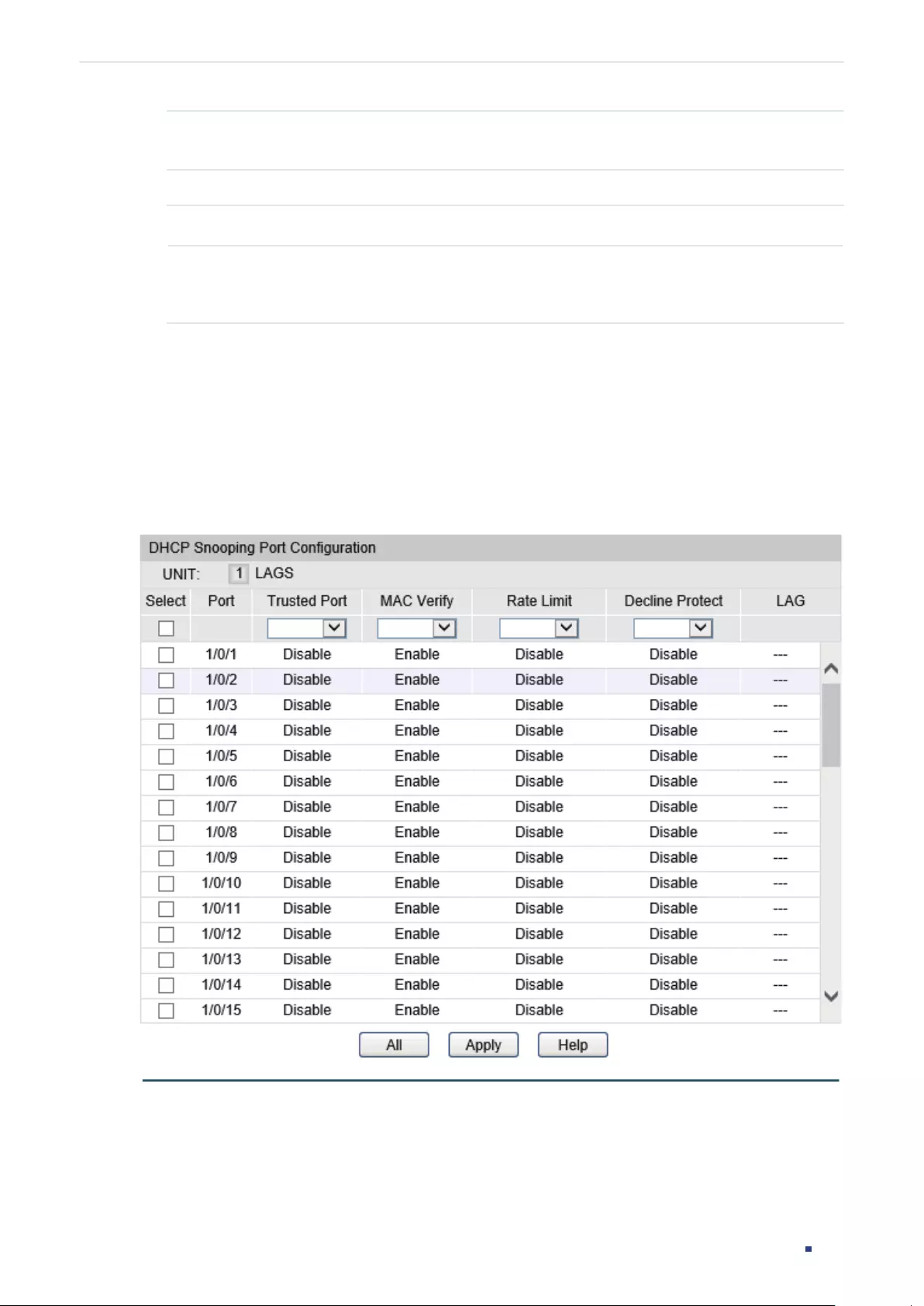
Configuration Guide 748
Configuring Network Security DHCP Snooping Configuration
Illegal DHCP Server
Trap
Enable Illegal DHCP Server Trap feature to send snmp trap message when
untrusted port has received DHCP Server packets.
4) Enable DHCP Snooping on a VLAN or range of VLANs.
VLAN ID Specify the VLAN ID in the format shown on the page.
VLAN
Configuration
Display
Displays the VLANs that have been enabled with DHCP Snooping.
5) Click Apply.
4.1.2 Configuring DHCP Snooping on Ports
Choose the menu Network Security > DHCP Snooping > Port Config to load the following
page.
Figure 4-2 Port Config
Follow these steps to configure DHCP Snooping on the specified port:
1) Select one or more ports and configure the parameters.

Configuration Guide 749
Configuring Network Security DHCP Snooping Configuration
Trusted Port Select Enable to set the port that is connected to the DHCP server as a trusted
port. Select Disable to set the other ports as untrusted ports.
MAC Verify Enable or disable the MAC Verify feature. There are two fields in the DHCP packet
that contain the MAC address of the host. The MAC Verify feature compares the
two fields of a DHCP packet and discards the packet if the two fields are different.
This prevents the IP address resource on the DHCP server from being exhausted
by forged MAC addresses.
Rate Limit Select to enable the rate limit feature and specify the maximum number of DHCP
packets that can be forwarded on the port per second. The excessive DHCP
packets will be discarded.
Decline Protect Select to enable the decline protect feature and specify the maximum number
of DHCP Decline packets that can be forwarded on the port per second. The
excessive DHCP Decline packets will be discarded.
LAG Displays the LAG that the port is in.
2) Click Apply.
4.1.3 (Optional) Configuring Option 82
Option 82 records the location of the DHCP client. The switch can add option 82 to the
DHCP request packet and then transmit the packet to the DHCP server. Administrators can
check the location of the DHCP client via option 82. The DHCP server supporting Option 82
can also set the distribution policy of IP addresses and other parameters, providing a more
flexible address distribution way.
Choose the menu Network Security > DHCP Snooping > Option 82 Config to load the
following page.
Figure 4-3 Option 82 Config
Follow these steps to configure Option 82:
1) Select one or more ports and configure the parameters.

Configuration Guide 750
Configuring Network Security DHCP Snooping Configuration
Option 82
Support
Enable the Option 82 feature.
Operation
Strategy
Select the operation for the Option 82 field of the DHCP request packets.
Keep: Indicates keeping the Option 82 field of the packets.
Replace: Indicates replacing the Option 82 field of the packets with one defined
by the switch. By default, the Circuit ID is defined to be the VLAN and the number
of the port which receives the DHCP Request packets. The Remote ID is defined
as the MAC address of the DHCP Snooping device which receives the DHCP
Request packets.
Drop: Indicates discarding the packets that include the Option 82 field.
Format Select the format of option 82 sub-option value field.
Normal: Indicates that the format of sub-option value field is TLV (type-length-
value).
Private: Indicates that the format of sub-option value field is the value you
configure for the related sub-option.
Circuit ID
Customization
Select Enable to manually define the circuit ID field, which is a sub-option of
Option 82. The circuit ID configurations of the switch and the DHCP server should
be compatible with each other.
Circuit ID Enter the customized circuit ID, which contains up to 64 characters.
Remote ID
Customization
Select Enable to manually define the remote ID field, which is a sub-option of
Option 82. The remote ID configurations of the switch and the DHCP server
should be compatible with each other.
Remote ID Enter the customized remote ID, which contains up to 64 characters.
LAG Displays the LAG that the port is in.
2) Click Apply.
4.2 Using the CLI
4.2.1 Enabling DHCP Snooping on VLAN
Follow these steps to globally configure DHCP Snooping:
Step 1 configure
Enter global configuration mode.
Step 2 ip dhcp snooping
Globally enable DHCP Snooping.

Configuration Guide 751
Configuring Network Security DHCP Snooping Configuration
Step 3 snmp-server traps security dhcp-snoop
Enable Illegal DHCP Server Trap feature to send snmp trap message when untrusted port
has received DHCP Server packets.
Step 4 ip dhcp snooping vlan
vlan-range
Enable DHCP Snooping on the specified VLAN.
vlan-range:
Enter the vlan range in the format of 1-3, 5.
Step 5 show ip dhcp snooping
Verify global configuration of DHCP Snooping.
Step 6 end
Return to privileged EXEC mode.
Step 7 copy running-config startup-config
Save the settings in the configuration file.
The following example shows how to enable DHCP Snooping globally and on VLAN 5:
Switch#configure
Switch(config)#ip dhcp snooping
Switch(config)#ip dhcp snooping vlan 5
Switch(config)#show ip dhcp snooping
Global Status: Enable
VLAN ID: 5
Switch(config-if)#end
Switch#copy running-config startup-config
4.2.2 Configuring DHCP Snooping on Ports
Follow these steps to configure DHCP Snooping on the specified ports.
Step 1 configure
Enter global configuration mode.
Step 2 interface {
fastEthernet
port
|
range fastEthernet
port-list
| gigabitEthernet
port
| range
gigabitEthernet
port-list
| interface port-channel
port-channel-id
| interface range
port-
channel
port-channel-id-list
}
Enter interface configuration mode.

Configuration Guide 752
Configuring Network Security DHCP Snooping Configuration
Step 3 ip dhcp snooping trust
Set the port that is connected to the DHCP server as a trusted port. The switch can forward
the DHCP packets on the trusted port and discard the DHCP response packets on the
distrusted port, so as to ensure that users get proper IP addresses from the legal DHCP
server.
Step 4 ip dhcp snooping mac-verify
Enable the MAC Verify feature. There are two fields in the DHCP packet that contain the
MAC address of the host. The MAC Verify feature compares the two fields of a DHCP
packet and discards the packet if the two fields are different. This prevents the IP address
resource on the DHCP server from being exhausted by forged MAC addresses.
Step 5 ip dhcp snooping limit rate
value
Enable the limit rate feature and specify the maximum number of DHCP messages that can
be forwarded on the port per second. The excessive DHCP packets will be discarded.
value:
Specify the limit rate value. The following options are provided: 0, 5,10,15,20,25 and
30 (packets/second). The default value is 0, which indicates disabling limit rate.
Step 6 ip dhcp snooping decline rate
value
Enable the decline protect feature and specify the maximum number of Decline packets
can be forwarded per second on the port. The excessive DHCP Decline packets will be
discarded.
value:
Specify the limit rate value of Decline packets. The following options are provided: 0,
5,10,15,20,25 and 30 (packets/second). The default value is 0, which indicates disabling this
feature.
Step 7 show ip dhcp snooping interface [ gigabitEthernet
port
| port-channel
port-channel-id
]
Verify the DHCP Snooping configuration of the port.
Step 8 end
Return to privileged EXEC mode.
Step 9 copy running-config startup-config
Save the settings in the configuration file.
The following example shows how to configure port 1/0/1 as a trusted port, enable the
MAC verify feature, and set the limit rate as 10 pps and decline rate as 20 pps on this port:
Switch#configure
Switch(config)#interface gigabitEthernet 1/0/1
Switch(config-if)#ip dhcp snooping trust
Switch(config-if)#ip dhcp snooping mac-verify
Switch(config-if)#ip dhcp snooping limit rate 10
Switch(config-if)#ip dhcp snooping decline rate 20

Configuration Guide 753
Configuring Network Security DHCP Snooping Configuration
Switch(config-if)#show ip dhcp snooping interface gigabitEthernet 1/0/1
Interface Trusted MAC-Verify Limit-Rate Dec-rate LAG
--------- ------- ---------- ---------- -------- ---
Gi1/0/1 Enable Enable 10 20 N/A
Switch(config-if)#end
Switch#copy running-config startup-config
4.2.3 (Optional) Configuring Option 82
Option 82 records the location of the DHCP client. The switch can add the Option 82 to the
DHCP request packet and then transmit the packet to the DHCP server. Administrators can
check the location of the DHCP client via option 82. The DHCP server supporting Option 82
can also set the distribution policy of IP addresses and other parameters, providing more
flexible address distribution way.
Follow these steps to configure Option 82:
Step 1 configure
Enter global configuration mode.
Step 2 interface {
fastEthernet
port
| range fastEthernet
port-list
| gigabitEthernet
port |
range
gigabitEthernet
port-list
| interface port-channel
port-channel-id
| interface range
port-
channel
port-channel-id-list
}
Enter interface configuration mode.
Step 3 ip dhcp snooping information option
Enable the Option 82 feature on the port.
Step 4 ip dhcp snooping information strategy { keep | replace | drop }
Specify the operation for the Option 82 field of the DHCP request packets from the Host.
The following options are provided:
keep: Indicates keeping the Option 82 field of the packets.
replace: Indicates replacing the Option 82 field of the packets with one defined by switch.
By default, the Circuit ID is defined to be the VLAN and the number of the port which
receives the DHCP Request packets. The Remote ID is defined to be the MAC address of
the DHCP Snooping device which receives the DHCP Request packets.
drop: Indicates discarding the packets that include the Option 82 field.

Configuration Guide 754
Configuring Network Security DHCP Snooping Configuration
Step 5 ip dhcp snooping information format { normal | private }
Specify the format of option 82 sub-option value field.
normal: Indicates that the format of sub-option value field is TLV (type-length-value).
private: Indicates that the format of sub-option value field is the value you configure for the
related sub-option.
Step 6 ip dhcp snooping information circuit-id
string
Configure the circuit ID. The circuit ID configurations of the switch and the DHCP server
should be compatible with each other.
string:
Enter the circuit ID, which contains up to 64 characters.
Step 7 ip dhcp snooping information remote-id
string
Configure the remote ID. The remote ID configurations of the switch and the DHCP server
should be compatible with each other.
string:
Enter the remote ID, which contains up to 64 characters.
Step 8 show ip dhcp snooping information interface { fastEthernet
port
| gigabitEthernet
port
|
port-channel
port-channel-id
}
Verify the Option 82 configuration of the port.
Step 9 end
Return to privileged EXEC mode.
Step 10 copy running-config startup-config
Save the settings in the configuration file.
The following example shows how to enable Option 82 on port 1/0/7 and configure the
strategy as replace, the format as normal, the circuit-id as VLAN20 and the remote-id as
Host1:
Switch#configure
Switch(config)#interface gigabitEthernet 1/0/7
Switch(config-if)#ip dhcp snooping information option
Switch(config-if)#ip dhcp snooping information strategy replace
Switch(config-if)#ip dhcp snooping information format normal
Switch(config-if)#ip dhcp snooping information circut-id VLAN20
Switch(config-if)#ip dhcp snooping information remote-id Host1
Switch(config-if)#show ip dhcp snooping information interface gigabitEthernet 1/0/7

Configuration Guide 755
Configuring Network Security DHCP Snooping Configuration
Interface Option 82 Status Operation Strategy Format Circuit ID Remote ID LAG
--------- ---------------- ------------------ ------- --------- -------- -----
Gi1/0/7 Enable Replace Normal VLAN20 Host1 N/A
Switch(config-if)#end
Switch#copy running-config startup-config
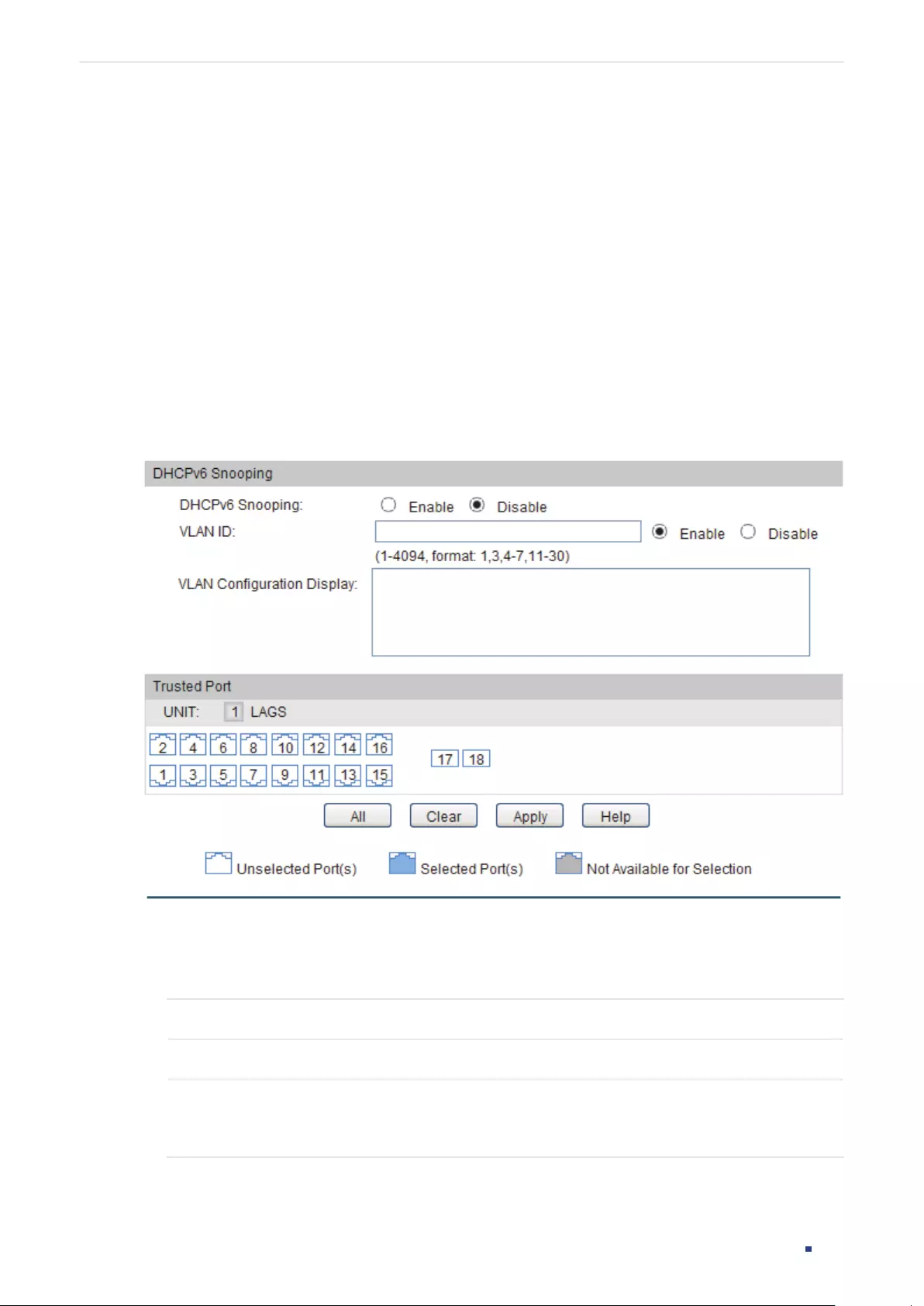
Configuration Guide 756
Configuring Network Security DHCPv6 Snooping Configuration
5 DHCPv6 Snooping Configuration
Tips:
The switch can dynamically bind the entries via DHCPv6 Snooping after DHCPv6
Snooping is configured. By default, the binding entries are applied to both IP Source Guard
and ND Detection.
5.1 Using the GUI
Choose the menu Network Security > DHCPv6 Snooping > DHCPv6 Snooping to load the
following page.
Figure 5-1 DHCPv6 Snooping
Follow these steps to configure DHCPv6 Snooping:
1) In the DHCPv6 Snooping section, enable DHCPv6 Snooping globally and specify one
or more VLAN IDs to enable DHCPv6 Snooping on the VLAN(s).
DHCPv6 Snooping Globally enable DHCPv6 Snooping.
VLAN ID Specify the VLAN ID(s) in the format shown on the page.
VLAN
Configuration
Display
Displays the VLANs that have been enabled with DHCPv6 Snooping.

Configuration Guide 757
Configuring Network Security DHCPv6 Snooping Configuration
2) In the Trusted Port section, select the port that is connected to the DHCPv6 server as a trusted
port, and the other unselected ports are the untrusted by default.
3) Click Apply.
5.2 Using the CLI
Follow these steps to configure DHCPv6 Snooping:
Step 1 configure
Enter global configuration mode.
Step 2 ipv6 dhcp snooping
Globally enable DHCPv6 Snooping.
Step 3 ipv6 dhcp snooping vlan
vlan-range
Enable DHCPv6 Snooping on the specified VLAN.
vlan-range:
Enter the vlan range in the format of 1-3, 5.
Step 4 interface {
fastEthernet
port
|
range fastEthernet
port-list
|
gigabitEthernet
port
| range
gigabitEthernet
port-list
| interface port-channel
port-channel-id
| interface range
port-
channel
port-channel-id-list
}
Enter interface configuration mode.
Step 5 ipv6 dhcp snooping trust
Configure the port(s) as trusted port(s). Generally, the port that is connected to the DHCPv6
server is configured as a trusted port.
Step 6 show ipv6 dhcp snooping
Verify the global DHCPv6 DHCP Snooping configuration.
Step 7 show ipv6 dhcp snooping interface { fastEthernet
port
| gigabitEthernet
port
| port-
channel
port-channel-id
}
Verify the DHCPv6 Snooping configuration of the port.
Step 8 end
Return to privileged EXEC mode.
Step 9 copy running-config startup-config
Save the settings in the configuration file.
The following example shows how to enable DHCP Snooping globally and on VLAN 5, and
configure port 1/0/1 as a trusted port:
Switch#configure
Switch(config)#ipv6 dhcp snooping

Configuration Guide 758
Configuring Network Security DHCPv6 Snooping Configuration
Switch(config)#ipv6 dhcp snooping vlan 5
Switch(config)#interface gigabitEthernet 1/0/1
Switch(config-if)#ipv6 dhcp snooping trust
Switch(config-if)#show ipv6 dhcp snooping
Global Status: Enable
VLAN ID: 5
Switch(config-if)#show ipv6 dhcp snooping interface gigabitEthernet 1/0/1
Interface Trusted LAG
--------- ------- ---
Gi1/0/1 Enable N/A
Switch(config-if)#end
Switch#copy running-config startup-config
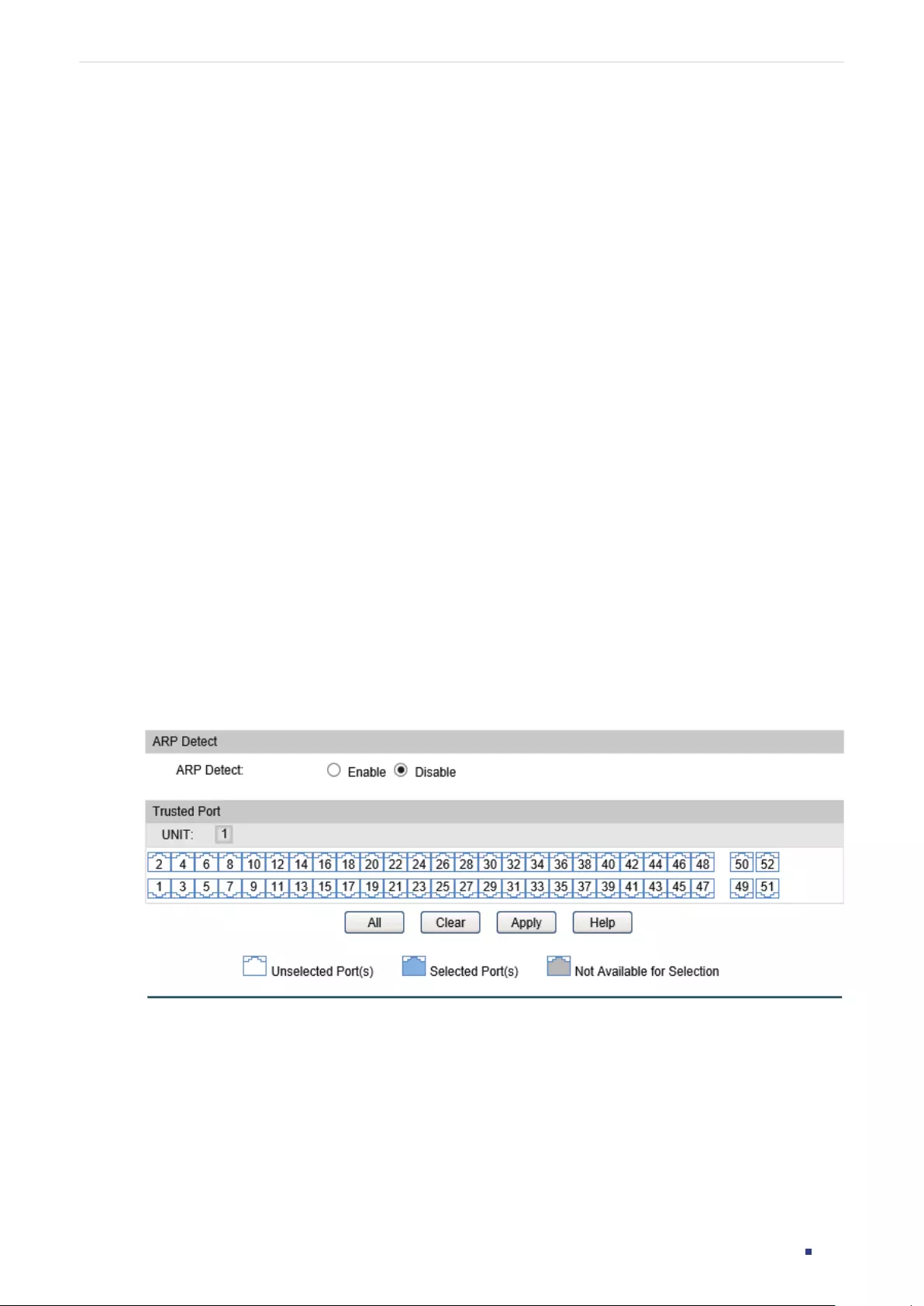
Configuration Guide 759
Configuring Network Security ARP Inspection Configurations
6 ARP Inspection Configurations
With ARP Inspection configurations, you can:
Configure ARP Detection
Configure ARP Defend
View ARP Statistics
6.1 Using the GUI
6.1.1 Configuring ARP Detection
The ARP Detection feature allows the switch to detect the ARP packets based on the
binding entries in the IP-MAC Binding Table and filter out the illegal ARP packets. Before
configuring ARP Detection, complete IP-MAC Binding configuration. For details, refer to IP-
MAC Binding Configurations.
Choose the menu Network Security > ARP Inspection > ARP Detect to load the following
page.
Figure 6-1 ARP Detect
Follow these steps to configure ARP Detection:
1) In the ARP Detect section, enable the ARP Detection feature.
2) In the Trusted Port section, select one or more ports to be configured as the trusted
port(s), on which the ARP Detection function will be inactive. The specific ports, such as
up-link ports and routing ports are suggested to be set as trusted.
3) Click Apply.

Configuration Guide 760
Configuring Network Security ARP Inspection Configurations
6.1.2 Configuring ARP Defend
With ARP Defend enabled, the switch can terminate receiving the ARP packets for 300
seconds when the transmission speed of the legal ARP packet on the port exceeds the
defined value so as to avoid ARP Attack flood.
Choose the menu Network Security > ARP Inspection > ARP Defend to load the following
page.
Figure 6-2 ARP Defend
Follow these steps to configure ARP Defend:
1) Select one or more ports and configure the parameters.
Defend Enable the ARP Defend feature.
Speed (10-100)
pps
Specify the maximum number of the ARP packets that can be received on the
port per second. The valid values are from 10 to 100 pps (packet/second), and
the default value is 15.
Current Speed
(pps)
Displays the current speed of receiving the ARP packets on the port.
Status Displays the status of the ARP attack:
Normal: The forwarding of ARP packets on the port is normal.
Drop ARP300sec: The speed of receiving the ARP packets has exceeded the
specified value, and the port will drop the received ARP packets in the next 300
seconds.

Configuration Guide 761
Configuring Network Security ARP Inspection Configurations
LAG Displays the LAG that the port is in.
Operation Click the Recover button to restore the port to the normal status. The ARP
Defend for this port will be re-enabled.
2) Click Apply.
6.1.3 Viewing ARP Statistics
You can view the number of the illegal ARP packets received on each port, which facilitates
you to locate the network malfunction and take the related protection measures.
Choose the menu Network Security > ARP Inspection > ARP Statistics to load the following
page.
Figure 6-3 ARP Statistics
In the Auto Refresh section, you can enable the auto refresh feature and specify the
refresh interval, and thus the web page will be automatically refreshed.

Configuration Guide 762
Configuring Network Security ARP Inspection Configurations
In the Illegal ARP Packet section, you can view the number of illegal ARP packets on each
port.
Trusted Port Indicates whether the port is an ARP trusted port or not.
Illegal ARP
Packet
Displays the number of the received illegal ARP packets.
6.2 Using the CLI
6.2.1 Configuring ARP Detection
The ARP Detection feature allows the switch to detect the ARP packets basing on the
binding entries in the IP-MAC Binding Table and filter the illegal ARP packets. Before
configuring ARP Detection, complete IP-MAC Binding configuration. For details, refer to IP-
MAC Binding Configurations.
Follow these steps to configure ARP Detection:
Step 1 configure
Enter global configuration mode.
Step 2 ip arp inspection
Globally enable the ARP Detection feature.
Step 3 interface { fastEthernet
port
| range fastEthernet
port-list
|
gigabitEthernet
port
| range
gigabitEthernet
port-list
}
Enter interface configuration mode.
Step 4 ip arp inspection trust
Configure the port as a trusted port, on which the ARP Detection function will not take
effect. The specific ports, such as up-linked ports and routing ports are suggested to be set
as trusted ports.
Step 5 show ip arp inspection
Verify the ARP Inspection configuration.
Step 6 end
Return to privileged EXEC mode.
Step 7 copy running-config startup-config
Save the settings in the configuration file.
The following example shows how to globally enable ARP Detection and configure port
1/0/1 as a trusted port.
Switch#configure

Configuration Guide 763
Configuring Network Security ARP Inspection Configurations
Switch(config)#ip arp inspection
Switch(config)#interface gigabitEthernet 1/0/1
Switch(config-if)#ip arp inspection trust
Switch(config-if)#show ip arp inspection
ARP detection global status: Enabled
Port Trusted
Gi1/0/1 YES
Gi1/0/2 NO
......
Switch(config-if)#end
Switch#copy running-config startup-config
6.2.2 Configuring ARP Defend
With ARP Defend enabled, the switch can terminate receiving the ARP packets for 300
seconds when the transmission speed of the legal ARP packet on the port exceeds the
defined value so as to avoid ARP Attack flood.
Follow these steps to configure ARP Defend:
Step 1 configure
Enter global configuration mode.
Step 2 interface { fastEthernet
port |
range fastEthernet
port-list
|
gigabitEthernet
port
| range
gigabitEthernet
port-list
}
Enter interface configuration mode.
Step 3 ip arp inspection
Enable the ARP defend feature on the port.
Step 4 ip arp inspection limit-rate
value
Specify the maximum number of the ARP packets can be received on the port per second.
value:
Specify the limit rate value. The valid values are from 10 to 100 pps (packets/second),
and the default value is 15.
Step 5 show ip arp inspection interface
(Optional) View the configurations and status of the ports.

Configuration Guide 764
Configuring Network Security ARP Inspection Configurations
Step 6 ip arp inspection recover
(Optional) For ports which the speed of receiving ARP packets has exceeded the limit, use
this command to restore the port from Discard status to Normal status.
Step 7 end
Return to privileged EXEC mode.
Step 8 copy running-config startup-config
Save the settings in the configuration file.
The following example shows how to enable ARP Defend and configure the ARP inspection
limit-rate as 20 pps on port 1/0/2:
Switch#configure
Switch(config)#interface gigabitEthernet 1/0/2
Switch(config-if)#ip arp inspection
Switch(config-if)#ip arp inspection limit-rate 20
Switch(config-if)#show ip arp inspection interface gigabitEthernet 1/0/2
Port OverSpeed Rate Current Status LAG
Gi1/0/2 Enabled 20 N/A Normal N/A
Switch(config-if)#end
Switch#copy running-config startup-config
The following example shows how to restore the port 1/0/1 that is in Discard status to
Normal status:
Switch#configure
Switch(config)#show ip arp inspection interface
Port OverSpeed Rate Current Status LAG
Gi1/0/1 Enabled 15 N/A Discard,290s N/A
Gi1/0/2 Enabled 15 N/A Normal N/A
......
Switch(config)#interface gigabitEthernet 1/0/1
Switch(config-if)#ip arp recover
Switch(config-if)#show ip arp inspection interface gigabitEthernet 1/0/1

Configuration Guide 765
Configuring Network Security ARP Inspection Configurations
Port OverSpeed Rate Current Status LAG
Gi1/0/1 Disabled 15 N/A Normal N/A
Switch(config-if)#end
Switch#copy running-config startup-config
6.2.3 Viewing ARP Statistics
On privileged EXEC mode or any other configuration mode, you can use the following
command to view ARP statistics:
show ip arp inspection statistics
View the ARP statistics on each port, including whether the port is trusted port and the number of received
ARP packets on the port.

Configuration Guide 766
Configuring Network Security ND Detection Configuration
7 ND Detection Configuration
7.1 Using the GUI
The ND Detection feature allows the switch to detect the ND packets based on the
binding entries in the IPv6-MAC Binding Table and filter out the illegal ND packets. Before
configuring ND Detection, complete IPv6-MAC Binding configuration. For details, refer to
IPv6-MAC Binding Configurations
.
Choose the menu Network Security > ND Detection > ND Detection to load the following
page.
Figure 7-1 ND Detection
Follow these steps to configure ND Detection:
1) In the ND Detection section, enable ND Detection globally and specify one or more
VLAN IDs to enable DHCPv6 Snooping on the VLAN(s).
ND Detection Globally enable ND Detection.
VLAN ID Specify the VLAN ID(s) in the format shown on the page.
VLAN
Configuration
Display
Displays the VLANs that have been enabled with ND Detection.

Configuration Guide 767
Configuring Network Security ND Detection Configuration
2) In the Trusted Port section, select one or more ports to be configured as the trusted
port(s), on which the ND packets will not be checked. The specific ports, such as up-link
ports and routing ports are suggested to be set as trusted.
3) Click Apply.
7.2 Using the CLI
The ND Detection feature allows the switch to detect the ND packets based on the
binding entries in the IPv6-MAC Binding Table and filter out the illegal ND packets. Before
configuring ND Detection, complete IPv6-MAC Binding configuration. For details, refer to
IPv6-MAC Binding Configurations
.
Follow these steps to configure ND Detection:
Step 1 configure
Enter global configuration mode.
Step 2 ipv6 nd detection
Globally enable the ND Detection feature.
Step 3 ipv6 nd detection vlan
vlan-range
Enable ND Detection on the specified VLAN.
vlan-range:
Enter the vlan range in the format of 1-3, 5.
Step 4 interface { fastEthernet
port
| range fastEthernet
port-list
| gigabitEthernet
port
| range
gigabitEthernet
port-list
| port-channel
port-channel-id
| range port-channel
port-channel-
id-list
}
Enter interface configuration mode.
Step 5 ipv6 nd detection trust
Configure the port as a trusted port, on which the ND packets will not be checked. The
specific ports, such as up-linked ports and routing ports are suggested to be set as trusted
ports.
Step 6 show ipv6 nd detection
Verify the global ND Detection configuration.
Step 7 show ipv6 nd detection interface { fastEthernet
port
|
gigabitEthernet
port
| port-channel
port-channel-id
}
Verify the global ND Detection configuration of the port.
Step 8 end
Return to privileged EXEC mode.
Step 9 copy running-config startup-config
Save the settings in the configuration file.

Configuration Guide 768
Configuring Network Security ND Detection Configuration
The following example shows how to enable ND Detection globally and on VLAN 1, and
configure port 1/0/1 as trusted port:
Switch#configure
Switch(config)#ipv6 nd detection
Switch(config)#ipv6 nd detection vlan 1
Switch(config)#interface gigabitEthernet 1/0/1
Switch(config-if)#ipv6 nd detection trust
Switch(config-if)#show ipv6 nd detection
Global Status: Enable
VLAN ID: 1
Switch(config-if)#show ipv6 nd detection interface gigabitEthernet 1/0/1
Interface Trusted LAG
--------- ------- ---
Gi1/0/1 Enable N/A
Switch(config-if)#end
Switch#copy running-config startup-config
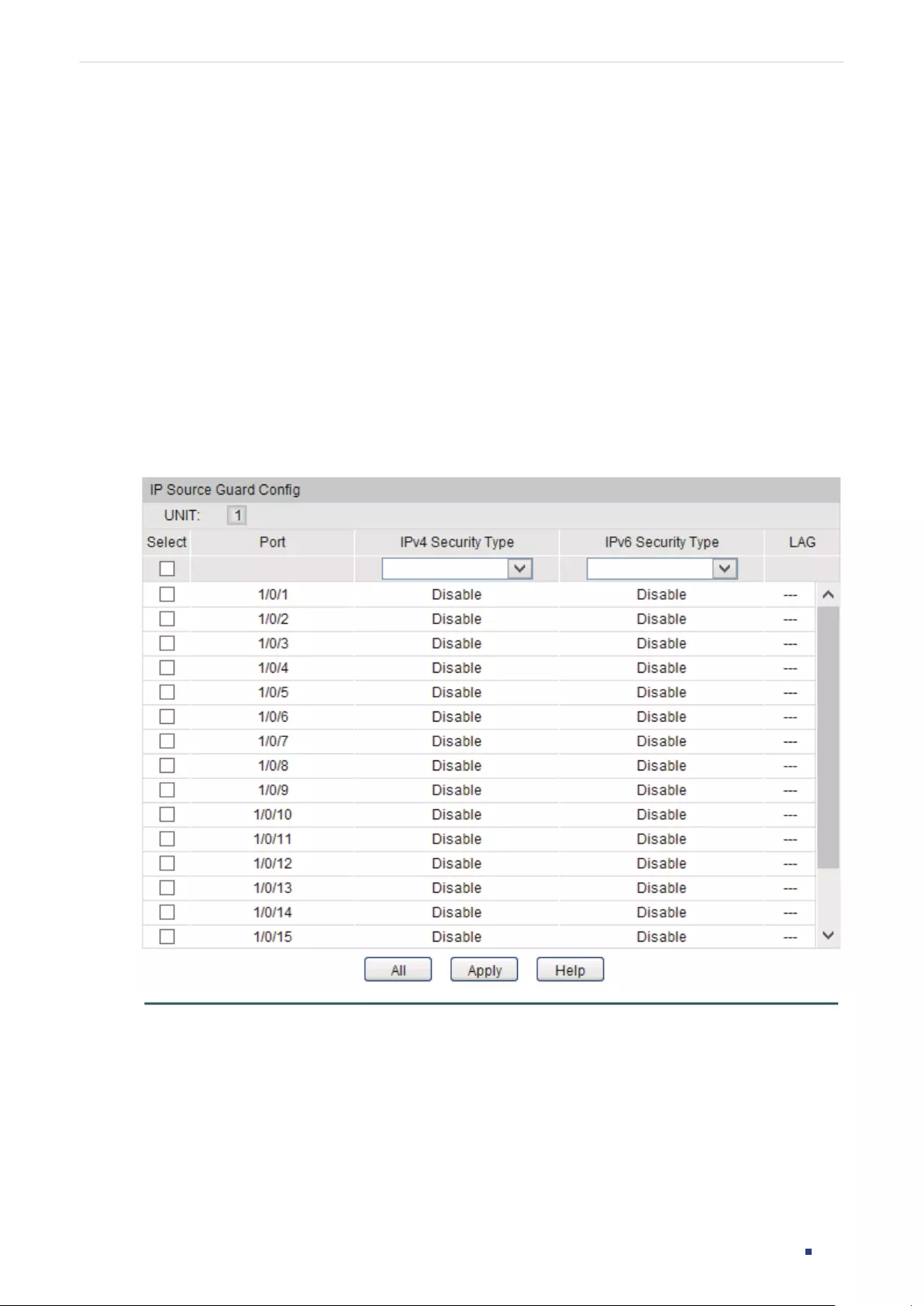
Configuration Guide 769
Configuring Network Security IP Source Guard Configuration
8 IP Source Guard Configuration
8.1 Using the GUI
The IP Source Guard feature allows the switch to filter the packets that do not match the
rules of IP-MAC Binding Table or IPv6-MAC Binding Table. Before configuring IP Source
Guard, complete IP-MAC Binding or IPv6-MAC Binding configuration. For details, refer to
IP-MAC Binding Configurations and
IPv6-MAC Binding Configurations
.
Choose the menu Network Security > IP Source Guard > IP Source Guard to load the
following page.
Figure 8-1 IP Source Guard
Follow these steps to configure IP Source Guard:
1) Select one or more ports and configure IP Source Guard on the port(s).

Configuration Guide 770
Configuring Network Security IP Source Guard Configuration
IPv4 Security Type Select Security Type on the port for IPv4 packets. The following options are
provided:
Disable: The IP Source Guard feature is disabled on the port.
SIP+MAC: Only the packet with its source IP address, source MAC address and
port number matching the IP-MAC binding rules can be processed, otherwise
the packet will be discarded.
IPv6 Security Type Select the Security Type on the port for IPv6 packets. The following options are
provided:
Disable: The IP Source Guard feature is disabled on the port.
SIPv6+MAC: Only the packet with its source IPv6 address, source MAC address
and port number matching the IPv6-MAC binding rules can be processed,
otherwise the packet will be discarded.
LAG Displays the LAG that the port is in.
2) Click Apply.
8.2 Using the CLI
The IP Source Guard feature allows the switch to filter the packets that do not match the
rules of IP-MAC Binding Table or IPv6-MAC Binding Table. Before configuring IP Source
Guard, complete IP-MAC Binding or IPv6-MAC Binding configurations. For details, refer to
IP-MAC Binding Configurations and
IPv6-MAC Binding Configurations
.
Follow these steps to configure IP Source Guard:
Step 1 configure
Enter global configuration mode.
Step 2 interface { fastEthernet
port
|
range fastEthernet
port-list
| gigabitEthernet
port
| range
gigabitEthernet
port-list
}
Enter interface configuration mode.
Step 3 Enable IP Source Guard on the port for IPv4 packets, IPv6 packets or both.
ip verify source { sip+mac }
Enable IP Source Guard for IPv4 packets.
sip+mac
:
Only the packet with its source IP address, source MAC address and port
number matching the IP-MAC binding rules can be processed, otherwise the packet will be
discarded.
ipv6 verify source { sipv6+mac }
Enable IP Source Guard for IPv6 packets.
sipv6+mac
:
Only the packet with its source IPv6 address, source MAC address and port
number matching the IPv6-MAC binding rules can be processed, otherwise the packet will
be discarded.

Configuration Guide 771
Configuring Network Security IP Source Guard Configuration
Step 4 Verify the IP Source Guard configuration on the specified port.
show ip verify source interface gigabitEthernet
port
Verify the IP Source Guard configuration for IPv4 packets.
show ipv6 verify source interface gigabitEthernet
port
Verify the IP Source Guard configuration for IPv6 packets.
Step 5 end
Return to privileged EXEC mode.
Step 6 copy running-config startup-config
Save the settings in the configuration file.
The following example shows how to enable IP Source Guard on port 1/0/1 for IPv6
packets:
Switch#configure
Switch(config)#interface gigabitEthernet 1/0/1
Switch(config-if)#ipv6 verify source sipv6+mac
Switch(config-if)#show ipv6 verify source interface gigabitEthernet 1/0/1
Port Security-Type LAG
---- ------------- ----
Gi1/0/1 SIPv6+MAC N/A
Switch(config-if)#end
Switch#copy running-config startup-config

Configuration Guide 772
Configuring Network Security DoS Defend Configuration
9 DoS Defend Configuration
9.1 Using the GUI
Choose the menu Network Security > DoS Defend > DoS Defend to load the following page.
Figure 9-1 Dos Defend
Follow these steps to configure DoS Defend:
1) In the Configure section, enable DoS Protection.
2) In the Defend Table section, select one or more defend types according to your needs.
The following table introduces each type of DoS attack.
Land Attack The attacker sends a specific fake SYN (synchronous) packet to the destination
host. Because both of the source IP address and the destination IP address of
the SYN packet are set to be the IP address of the host, the host will be trapped
in an endless circle of building the initial connection.
Scan SYNFIN The attacker sends the packet with its SYN field and the FIN field set to 1. The
SYN field is used to request initial connection whereas the FIN field is used to
request disconnection. Therefore, the packet of this type is illegal.
Xmascan The attacker sends the illegal packet with its TCP index, FIN, URG and PSH field
set to 1.
NULL Scan The attacker sends the illegal packet with its TCP index and all the control fields
set to 0. During the TCP connection and data transmission, the packets with all
control fields set to 0 are considered illegal.

Configuration Guide 773
Configuring Network Security DoS Defend Configuration
SYN sPort less
1024
The attacker sends the illegal packet with its TCP SYN field set to 1 and source
port smaller than 1024.
Blat Attack The attacker sends the illegal packet with the same source port and destination
port on Layer 4 and with its URG field set to 1. Similar to the Land Attack, the
system performance of the attacked host is reduced because the Host circularly
attempts to build a connection with the attacker.
Ping Flooding The attacker floods the destination system with Ping packets, creating a
broadcast storm that makes it impossible for the system to respond to legal
communication.
SYN/SYN-ACK
Flooding
The attacker uses a fake IP address to send TCP request packets to the server.
Upon receiving the request packets, the server responds with SYN-ACK packets.
Since the IP address is fake, no response will be returned. The server will keep
on sending SYN-ACK packets. If the attacker sends overflowing fake request
packets, the network resource will be occupied maliciously and the requests of
the legal clients will be denied.
WinNuke Attack Because the Operation System with bugs cannot correctly process the URG
(Urgent Pointer) of TCP packets, the attacker sends this type of packets to the
TCP port139 (NetBIOS) of the host with the Operation System bugs, which will
cause the host with a blue screen.
3) Click Apply.
9.2 Using the CLI
Follow these steps to configure DoS Defend:
Step 1 configure
Enter global configuration mode.
Step 2 ip dos-prevent
Globally enable the DoS defend feature.

Configuration Guide 774
Configuring Network Security DoS Defend Configuration
Step 3 ip dos-prevent type { land | scan-synfin | xma-scan | null-scan | port-less-1024 | blat | ping-
flood | syn-flood | win-nuke }
Configure one or more defend types according to your needs. The types of DoS attack are
introduced as follows.
land:
The attacker sends a specic fake SYN (synchronous) packet to the destination host.
Because both the source IP address and the destination IP address of the SYN packet are
set to be the IP address of the host, the host will be trapped in an endless circle of building
the initial connection.
scan-synfin:
The attacker sends the packet with its SYN field and the FIN field set to 1.
The SYN eld is used to request initial connection whereas the FIN eld is used to request
disconnection. Therefore, a packet of this type is illegal.
xma-scan:
The attacker sends the illegal packet with its TCP index, FIN, URG and PSH eld
set to 1.
null-scan:
The attacker sends the illegal packet with its TCP index and all the control elds
set to 0. During the TCP connection and data transmission, the packets with all the control
elds set to 0 are considered as the illegal packets.
port-less-1024:
The attacker sends the illegal packet with its TCP SYN field set to 1 and
source port smaller than 1024.
blat:
The attacker sends the illegal packet with the same source port and destination port on
Layer 4 and with its URG eld set to 1. Similar to the Land Attack, the system performance
of the attacked host is reduced because the Host circularly attempts to build a connection
with the attacker.
ping-flood:
The attacker floods the destination system with Ping packets, creating a
broadcast storm that makes it impossible for system to respond to legal communication.
syn-flood:
The attacker uses a fake IP address to send TCP request packets to the server.
Upon receiving the request packets, the server responds with SYN-ACK packets. Since the
IP address is fake, no response will be returned. The server will keep on sending SYN-ACK
packets. If the attacker sends overowing fake request packets, the network resource will
be occupied maliciously and the requests of the legal clients will be denied.
win-nuke:
An Operation System with bugs cannot process the URG (Urgent Pointer) of TCP
packets. If the attacker sends TCP packets to port139 (NetBIOS) of the host with Operation
System bugs, it will cause blue screen.
Step 4 show ip dos-prevent
Verify the Dos Defend configuration.
Step 5 end
Return to privileged EXEC mode.
Step 6 copy running-config startup-config
Save the settings in the configuration file.
The following example shows how to enable the DoS Defend type named land:
Switch#configure

Configuration Guide 775
Configuring Network Security DoS Defend Configuration
Switch(config)#ip dos-prevent
Switch(config)#ip dos-prevent type land
Switch(config)#show ip dos-prevent
Type Status
--------- ------
Land Attack Enabled
Scan SYNFIN Disabled
Xmascan Disabled
......
Switch(config)#end
Switch#copy running-config startup-config

Configuration Guide 776
Configuring Network Security 802.1X Configuration
10 802.1X Configuration
To complete the 802.1X configuration, follow these steps:
1) Configure the RADIUS server.
2) Configure 802.1X globally.
3) Configure 802.1X on ports.
Configuration Guidelines
802.1X authentication and Port Security cannot be enabled at the same time. Before
enabling 802.1X authentication, make sure that Port Security is disabled.
10.1 Using the GUI
10.1.1 Configuring the RADIUS Server
Enable AAA function on the switch, configure the parameters of RADIUS sever and
configure the RADIUS server group.
Enabling AAA function
Choose the menu Network Security > AAA > Global Config to load the following page.
Figure 10-1 Enable AAA Function
In the Global Config section, enable AAA function on the switch and click Apply.
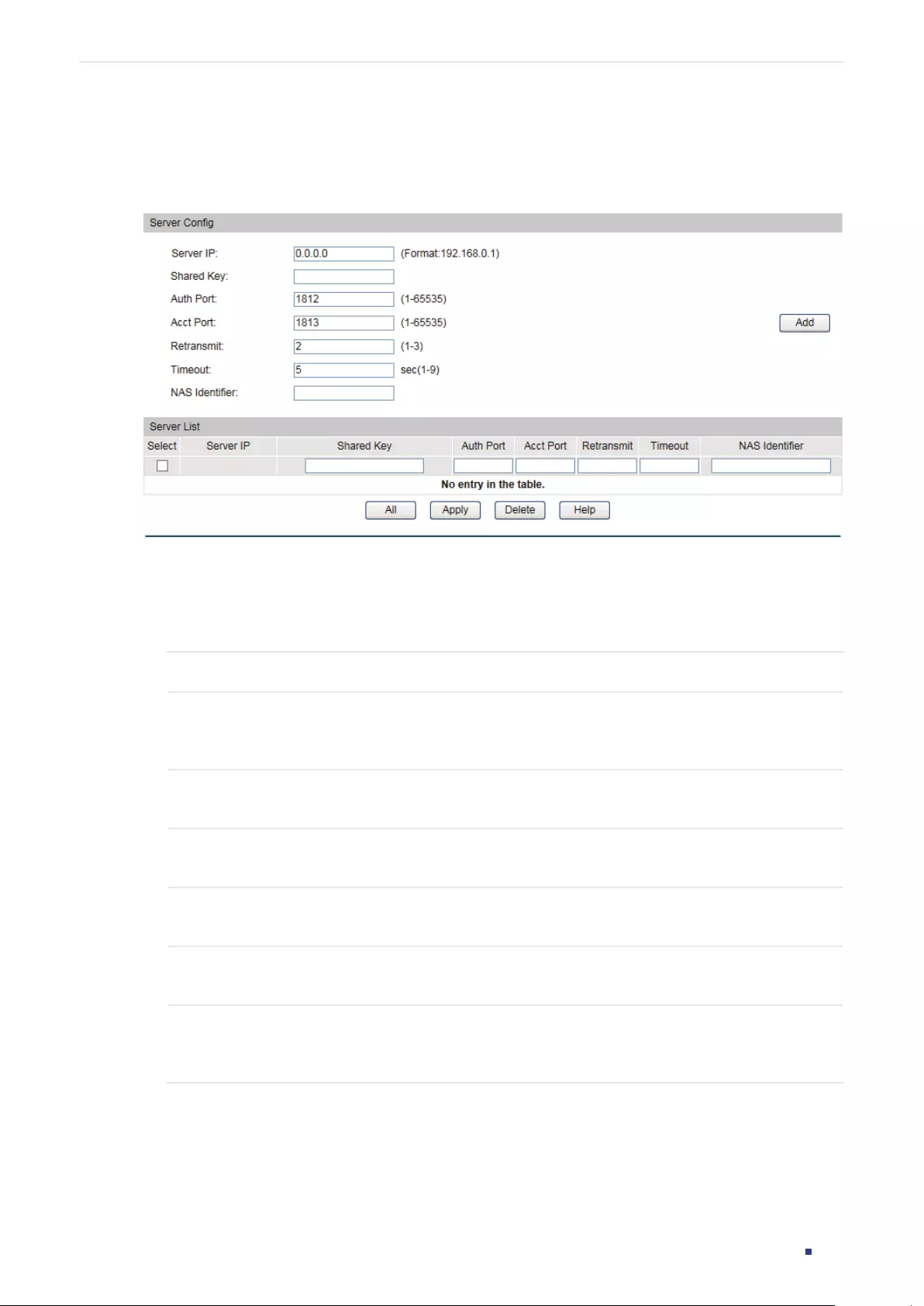
Configuration Guide 777
Configuring Network Security 802.1X Configuration
Adding the RADIUS Server
Choose the menu Network Security > AAA > RADIUS Config to load the following page.
Figure 10-2 RADIUS Config
Follow these steps to create a protocol template:
1) In the Server Config section, configure the parameters of RADIUS server.
2) Click Apply.
Server IP Enter the IP address of the server running the RADIUS secure protocol.
Shared Key Enter the shared key between the RADIUS server and the switch. The RADIUS
server and the switch use the key string to encrypt passwords and exchange
responses.
Auth Port Specify the UDP destination port on the RADIUS server for authentication
requests. The default setting is 1812.
Acct Port Specify the UDP destination port on the RADIUS server for accounting requests.
The default setting is 1813.
Retransmit Specify the number of times a request is resent to the server if the server does not
respond. The default setting is 2.
Timeout Specify the time interval that the switch waits for the server to reply before
resending. The default setting is 5 seconds.
NAS Identifier Specify the name of the NAS (Network Access Server) to be contained in RADIUS
packets for identification. It ranges from 1 to 31 characters. The default value is the
MAC address of the switch. Generally, the NAS indicates the switch itself.

Configuration Guide 778
Configuring Network Security 802.1X Configuration
Configuring the RADIUS Server Group
You can configure the radius servers for authentication and accounting. If multiple
radius servers are available, you are suggested to add them to different server groups
respectively for authentication and accounting.
Choose the menu Network Security > AAA > Server Group to load the following page.
Figure 10-3 Adding a Server Group
Follow these steps to create a protocol template:
1) In the Add New Server Group section, specify the name and server type for the new
server group, and click Add.
Server Group: Specify the name of the new server group.
Server Type: Select the type of the server group as RADIUS.
2) Select the newly added group, and click edit in the Operation column.
Figure 10-4 Edit the Group
3) Select the server to be added to the group from the Server IP drop-down list . Then
click Add to add this server to the server group.
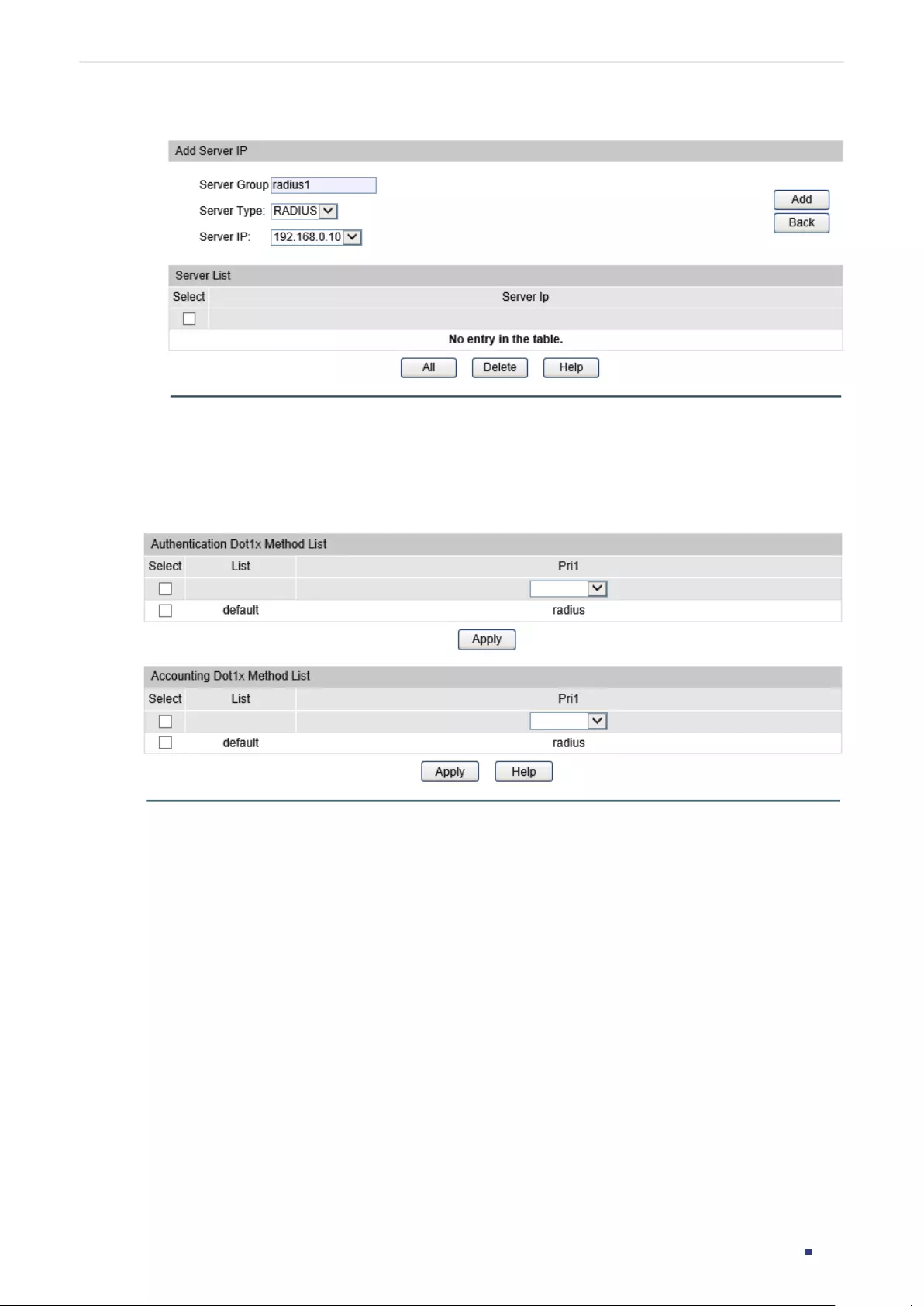
Configuration Guide 779
Configuring Network Security 802.1X Configuration
Figure 10-5 Add Server to Group
Configuring the Dot1x List
Choose the menu Network Security > AAA > Dot1x List to load the following page.
Figure 10-6 Configuring the Dot1x List
Follow these steps to configure RADIUS server groups for 802.1X authentication and
accounting:
1) In the Authentication Dot1x Method List section, select an existing RADIUS server
group for authentication from the Pri1 drop-down list and click Apply.
2) In the Accounting Dot1x Method List section, select an existing RADIUS server group
for accounting from the Pri1 drop-down list and click Apply.
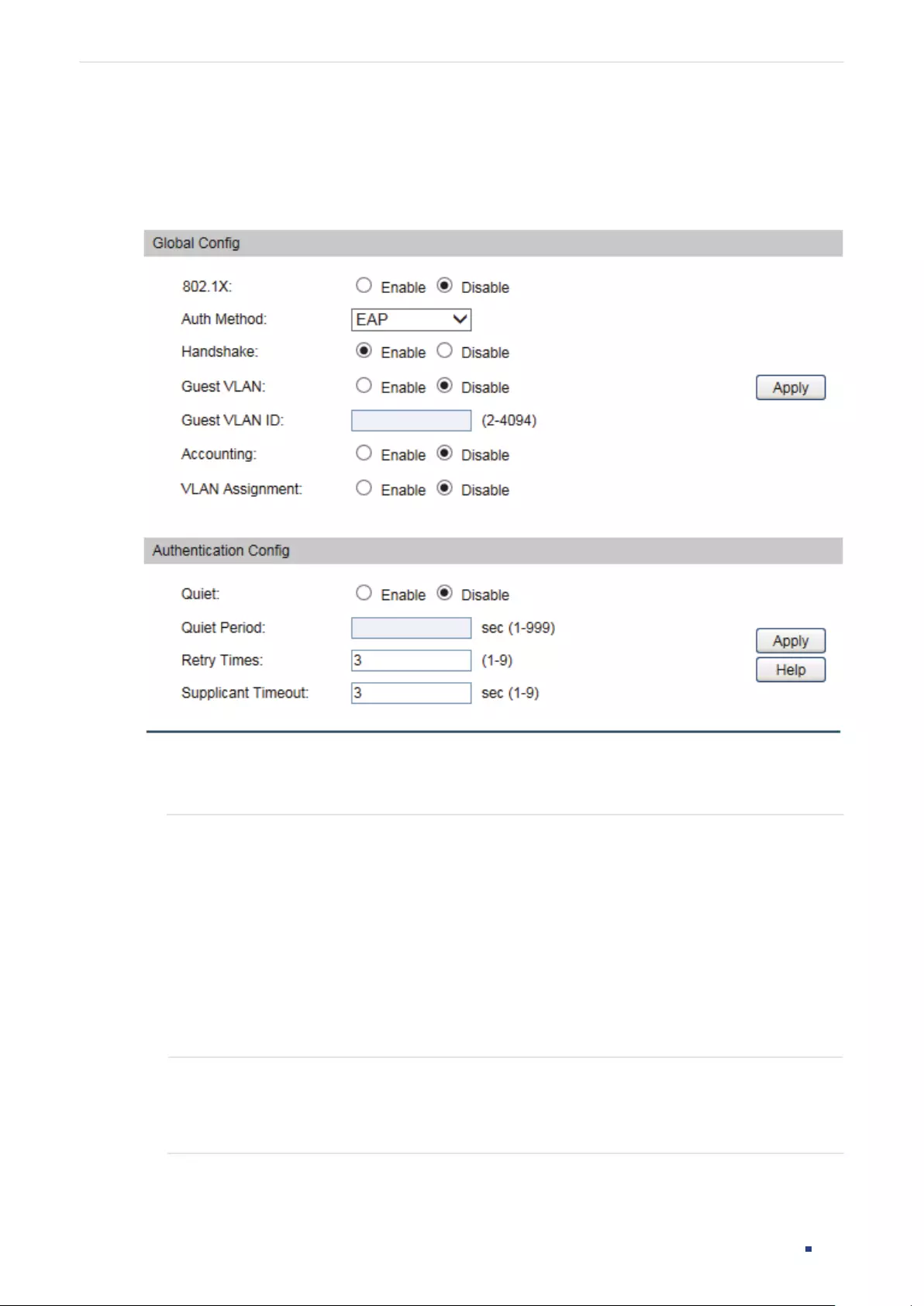
Configuration Guide 780
Configuring Network Security 802.1X Configuration
10.1.2 Configuring 802.1X Globally
Choose the menu Network Security > 802.1X > Global Config to load the following page.
Figure 10-7 Global Config
Follow these steps to configure 802.1X global parameters:
1) In the Global Config section, enable 802.1X globally and click Apply.
Auth Method Select the 802.1X authentication method.
PAP: The 802.1X authentication system uses EAP packets to exchange
information between the switch and the client. The transmission of EAP (Extensible
Authentication Protocol) packets is terminated at the switch and the EAP packets
are converted to other protocol (such as RADIUS) packets, and transmitted to the
authentication server.
EAP: The 802.1X authentication system uses EAP packets to exchange information
between the switch and the client. The EAP packets with authentication data are
encapsulated in the advanced protocol (such as RADIUS) packets, and transmitted
to the authentication server.
Handshake Enable or disable the Handshake feature. The Handshake feature is used to detect
the connection status between the TP-Link 802.1X Client and the switch. Please
disable Handshake feature if you are using other client softwares instead of TP-
Link 802.1X Client.

Configuration Guide 781
Configuring Network Security 802.1X Configuration
Guest VLAN Select whether to enable Guest VLAN. By default, it is disabled.
If the Guest VLAN is enabled, a port can access resources in the guest VLAN even
though the port is not yet authenticated; if guest VLAN is disabled and the port is
not authenticated, the port cannot visit any resource in the LAN.
Guest VLAN ID Enter the guest VLAN's ID. It must be an existing VLAN with the ID ranging from 2
to 4094.
Accounting Enable or disable 802.1X accounting feature.
VLAN
Assignment
Enable or disable the 802.1X VLAN assignment feature. 802.1x VLAN assignment
is a technology allowing the RADIUS server to send the VLAN assignment to the
port when the port is authenticated.
If the assigned VLAN does not exist on the switch, the switch will create the related
VLAN automatically, add the authenticated port to the VLAN and change the PVID
based on the assigned VLAN.
If the assigned VLAN exists on the switch, the switch will directly add the
authenticated port to the related VLAN and change the PVID instead of creating a
new VLAN.
If no VLAN is supplied by the RADIUS server or if 802.1x authentication is disabled,
the port will be in its original VLAN after successful authentication.
2) In the Authentication Config section, enable Quiet, configure the Quiet timer, and click
Apply.
Quiet Enable or disable the Quiet timer.
Quiet Period Specify the Quiet Period. It ranges from 1 to 999 seconds and the default time is
10 seconds.
The quiet period starts after the authentication fails. During the quiet period, the
switch does not process authentication requests from the same client.
Retry Times Specify the maximum number of attempts to send the authentication packet. It
ranges from 1 to 9 times and the default is 3 times.
Supplicant
Timeout
Specify the maximum time which the switch waits for a response from the client. It
ranges from 1 to 9 seconds and the default time is 3 seconds.
If the switch does not receive any reply from the client within the specified time, it
will resend the request.

Configuration Guide 782
Configuring Network Security 802.1X Configuration
10.1.3 Configuring 802.1X on Ports
Choose the menu Network Security > 802.1X > Port Config to load the following page.
Figure 10-8 Port Config
Configure 802.1X authentication on the desired port and click Apply.
Status Enable 802.1X authentication on the port.
Guest VLAN Select whether to enable Guest VLAN on the port.
MAB Select whether to enable the MAB (MAC-Based Authentication Bypass) feature for the
port.
With MAB feature enabled, the switch automatically sends the authentication server
a RADIUS access request frame with the client’s MAC address as the username
and password. It is also necessary to configure the RADIUS server with the client’s
information for authentication. You can enable this feature on IEEE 802.1x ports
connected to devices without 802.1X capability. For example, most printers, IP phones
and fax machines do not have 802.1X capability.
Control Mode Select the Control Mode for the port. By default, it is Auto.
Auto: If this option is selected, the port can access the network only when it is
authenticated.
Force-Authorized: If this option is selected, the port can access the network without
authentication.
Force-Unauthorized: If this option is selected, the port can never be authenticated.
Control Type Select the Control Type for the port. By default, it is MAC Based.
MAC Based: All clients connected to the port need to be authenticated.
Port Based: If a client connected to the port is authenticated, other clients can access
the LAN without authentication.

Configuration Guide 783
Configuring Network Security 802.1X Configuration
Authorized Displays whether the port is authorized or not.
LAG Displays the LAG the port belongs to.
Note:
If a port is in an LAG, its 802.1X authentication function cannot be enabled. Also, a port with 802.1X
authentication enabled cannot be added to any LAG.
10.2 Using the CLI
10.2.1 Configuring the RADIUS Server
Follow these steps to configure RADIUS:
Step 1 configure
Enter global configuration mode.
Step 2 aaa enable
Enable the AAA function globally.
Step 3 radius-server host
ip-address
[ auth-port
port-id
] [ acct-port
port-id
] [ timeout
time
] [
retransmit
number
] [ nas-id
nas-id
] [ key { [ 0 ]
string
| 7
encrypted-string
} ]
Add the RADIUS server and configure the related parameters as needed.
host
ip-address
:
Enter the IP address of the server running the RADIUS protocol.
auth-port
port-id
:
Specify the UDP destination port on the RADIUS server for authentication
requests. The default setting is 1812.
acct-port
port-id:
Specify the UDP destination port on the RADIUS server for accounting
requests. The default setting is 1813. Generally, the accounting feature is not used in the
authentication account management.
timeout
time
:
Specify the time interval that the switch waits for the server to reply before
resending. The valid values are from 1 to 9 seconds and the default setting is 5 seconds.
retransmit
number
:
Specify the number of times a request is resent to the server if the
server does not respond. The valid values are from 1 to 3 and the default setting is 2.
nas-id
nas-id:
Specify the name of the NAS (Network Access Server) to be contained in
RADIUS packets for identification. It ranges from 1 to 31 characters. The default value is the
MAC address of the switch. Generally, the NAS indicates the switch itself.
key { [ 0 ]
string
| 7
encrypted-string
}: Specify the shared key. 0 and 7 prevent the encryption
type. 0 indicates that an unencrypted key will follow. 7 indicates that a symmetric encrypted
key with a xed length will follow. By default, the encryption type is 0.
string
is the shared
key for the switch and the server, which contains 31 characters at most.
encrypted-string
is
a symmetric encrypted key with a xed length, which you can copy from the conguration
le of another switch. The key or encrypted-key you congured here will be displayed in the
encrypted form.

Configuration Guide 784
Configuring Network Security 802.1X Configuration
Step 4 aaa group radius
group-name
Create a radius server group.
radius:
Specify the group type as radius.
group-name
:
Specify a name for the group.
Step 5 server
ip-address
Add the existing servers to the server group.
ip-address
:
Specify IP address of the server to be added to the group.
Step 6 exit
Return to global configuration mode.
Step 7 aaa authentication dot1x default {
method
}
Select the radius group for 802.1X authentication.
method:
Specify the radius group for 802.1X authentication.
aaa accounting dot1x default {
method
}
Select the radius group for 802.1X accounting.
method:
Specify the radius group for 802.1X accounting.
Note: If multiple radius servers are available, you are suggested to add them to different
server groups respectively for authentication and accounting.
Step 8 show aaa global
(Optional) Verify the global configuration of AAA.
Step 9 show radius-server
(Optional) Verify the configuration of RADIUS server.
Step 10 show aaa group [
group-name
]
(Optional) Verify the configuration of server group.
Step 11 show aaa authentication dot1x
(Optional) Verify the authentication method list.
Step 12 show aaa accounting dot1x
(Optional) Verify the accounting method list.
Step 13 end
Return to privileged EXEC mode.
Step 14 copy running-config startup-config
Save the settings in the configuration file.
The following example shows how to enable AAA, add a RADIUS server to the server group
named radius1, and apply this server group to the 802.1X authentication. The IP address of

Configuration Guide 785
Configuring Network Security 802.1X Configuration
the RADIUS server is 192.168.0.100; the shared key is 123456; the authentication port is
1812; the accounting port is 1813.
Switch#configure
Switch(config)#aaa enable
Switch(config)#radius-server host 192.168.0.100 key 123456 auth-port 1812 acct-port
1813
Switch(config)#aaa group radius radius1
Switch(aaa-group)#server 192.168.0.100
Switch(aaa-group)#exit
Switch(config)#aaa authentication dot1x default radius1
Switch(config)#aaa accounting dot1x default radius1
Switch(config)#show radius-server
Server Ip Auth Port Acct Port Timeout Retransmit NAS Identifier Shared key
192.168.0.100 1812 1813 5 2 000AEB132397 123456
Switch(config)#show aaa group radius1
192.168.0.100
Switch(config)#show aaa authentication dot1x
Methodlist pri1 pri2 pri3 pri4
default radius1 -- -- --
Switch(config)#show aaa accounting dot1x
Methodlist pri1 pri2 pri3 pri4
default radius1 -- -- --
Switch(config)#show aaa global
AAA global status: Enable
Switch(config)#end
Switch#copy running-config startup-config
10.2.2 Configuring 802.1X Globally
Follow these steps to configure 802.1X globally:

Configuration Guide 786
Configuring Network Security 802.1X Configuration
Step 1 configure
Enter global configuration mode.
Step 2 dot1x system-auth-control
Enable 802.1X authentication globally.
Step 3 dot1x auth-method { pap | eap }
Configure the 802.1X authentication method.
pap: Specify the authentication method as PAP. If this option is selected, the 802.1X
authentication system uses EAP (Extensible Authentication Protocol) packets to
exchange information between the switch and the client. The transmission of EAP
packets is terminated at the switch and the EAP packets are converted to other
protocol (such as RADIUS) packets, and transmitted to the authentication server.
eap: Specify the authentication method as EAP. If this option is selected, the 802.1X
authentication system uses EAP packets to exchange information between the
switch and the client. The EAP packets with authentication data are encapsulated
in the advanced protocol (such as RADIUS) packets, and transmitted to the
authentication server.
Step 4 dot1x guest-vlan
vid
(Optional) Enable guest VLAN globally.
vid
: Specify the ID of the VLAN to be configured as the guest VLAN. It must be an
existing VLAN with the ID ranging from 2 to 4094. Clients in the guest VLAN can only
access resources from specific VLANs.
Step 5 dot1x quiet-period [time]
(Optional) Enable the quiet feature for 802.1X authentication and configure the quiet
period.
time: Set a value between 1 and 999 seconds for the quiet period. It is 10 seconds by
default. The quiet period starts after the authentication fails. During the quiet period,
the switch does not process authentication requests from the same client.
Step 6 dot1x vlan-assignment
(Optional) Enable or disable the 802.1X VLAN assignment feature. 802.1x VLAN
assignment is a technology allowing the RADIUS server to send the VLAN
assignment to the port when the port is authenticated.
If the assigned VLAN does not exist on the switch, the switch will create the related
VLAN automatically, add the authenticated port to the VLAN and change the PVID
based on the assigned VLAN.
If the assigned VLAN exists on the switch, the switch will directly add the
authenticated port to the related VLAN and change the PVID instead of creating a
new VLAN.
If no VLAN is supplied by the RADIUS server or if 802.1x authentication is disabled,
the port will be in its original VLAN after successful authentication.

Configuration Guide 787
Configuring Network Security 802.1X Configuration
Step 7 dot1x timeout supplicant-timeout
time
Configure the supplicant timeout period.
time:
Specify the maximum time for which the switch waits for response from the
client. It ranges from 1 to 9 seconds and the default time is 3 seconds. If the switch
does not receive any reply from the client within the specified time, it will resend the
request.
Step 8 dot1x max-reauth-req
times
Specify the maximum number of attempts to send the authentication packet for the
client.
times:
The maximum attempts for the client to send the authentication packet. It
ranges from 1 to 9 and the default is 3.
Step 9 show dot1x global
(Optional) Verify global configurations of 802.1X.
Step 10 end
Return to privileged EXEC mode.
Step 11 copy running-config startup-config
Save the settings in the configuration file.
The following example shows how to enable 802.1X authentication, configure PAP as the
authentication method and keep other parameters as default:
Switch#configure
Switch(config)#dot1x system-auth-control
Switch(config)#dot1x auth-method pap
Switch(config)#show dot1x global
802.1X State: Enabled
Authentication Method: PAP
Handshake State: Enabled
Guest VLAN State: Disabled
Guest VLAN ID: N/A
802.1X Accounting State: Disabled
802.1X VLAN Assignment State: Disabled
Quiet-period State: Disable
Quiet-period Timer: 10 sec.

Configuration Guide 788
Configuring Network Security 802.1X Configuration
Max Retry-times For RADIUS Packet: 3
Supplicant Timeout: 3 sec.
Switch(config)#end
Switch#copy running-config startup-config
10.2.3 Configuring 802.1X on Ports
Follow these steps to configure the port:
Step 1 configure
Enter global configuration mode.
Step 2 interface {fastEthernet
port
| range fastEthernet
port-list
| gigabitEthernet
port
|
range gigabitEthernet
port-list
}
Enter interface configuration mode.
port:
Enter the ID of the port to be configured.
Step 3 dot1x
Enable 802.1X authentication for the port.
Step 4 dot1x mab
Enable the MAB (MAC-Based Authentication Bypass) feature for the port.
With MAB feature enabled, the switch automatically sends the authentication server
a RADIUS access request frame with the client’s MAC address as the username
and password. It is also necessary to configure the RADIUS server with the client’s
information for authentication. You can enable this feature on IEEE 802.1x ports
connected to devices without 802.1X capability. For example, most printers, IP
phones and fax machines do not have 802.1X capability.
Step 5 dot1x port-method { mac-based | port-based }
Configure the control type for the port. By default, it is mac-based.
mac-based: All clients connected to the port need to be authenticated.
port-based: If a client connected to the port is authenticated, other clients can
access the LAN without authentication.
Step 6 dot1x guest-vlan
(Optional) Enable guest VLAN on the port.
Note: Before enabling guest VLAN, the control type of the port should be configured
as port-based.

Configuration Guide 789
Configuring Network Security 802.1X Configuration
Step 7 dot1x port-control { auto | authorized-force | unauthorized-force }
Configure the control mode for the port. By default, it is auto.
auto: If this option is selected, the port can access the network only when it is
authenticated.
authorized-force: If this option is selected, the port can access the network without
authentication.
unauthorized-force: If this option is selected, the port can never be authenticated.
Step 8 show dot1x interface [fastEthernet
port
|gigabitEthernet
port
| ten-gigabitEthernet
port
]
(Optional) Verify the configurations of 802.1X authentication on the port.
port:
Enter the ID of the port to be configured. If no specific port is entered, the
switch will show configurations of all ports.
Step 9 end
Return to privileged EXEC mode.
Step 10 copy running-config startup-config
Save the settings in the configuration file.
The following example shows how to enable 802.1X authentication on port 1/0/2, configure
the control type as port-based, and configure the control mode as auto:
Switch#configure
Switch(config)#interface gigabitEthernet 1/0/2
Switch(config-if)#dot1x
Switch(config-if)#dot1x port-method port-based
Switch(config-if)#dot1x port-control auto
Switch(config-if)#show dot1x interface gigabitEthernet 1/0/2
Port State MAB State GuestVLAN PortControl PortMethod Authorized LAG
---- --------- --------- --------- -------- -------- -------------- ---
Gi1/0/2 enabled disabled disabled auto port-based unauthorized N/A
Switch(config-if)#end
Switch#copy running-config startup-config
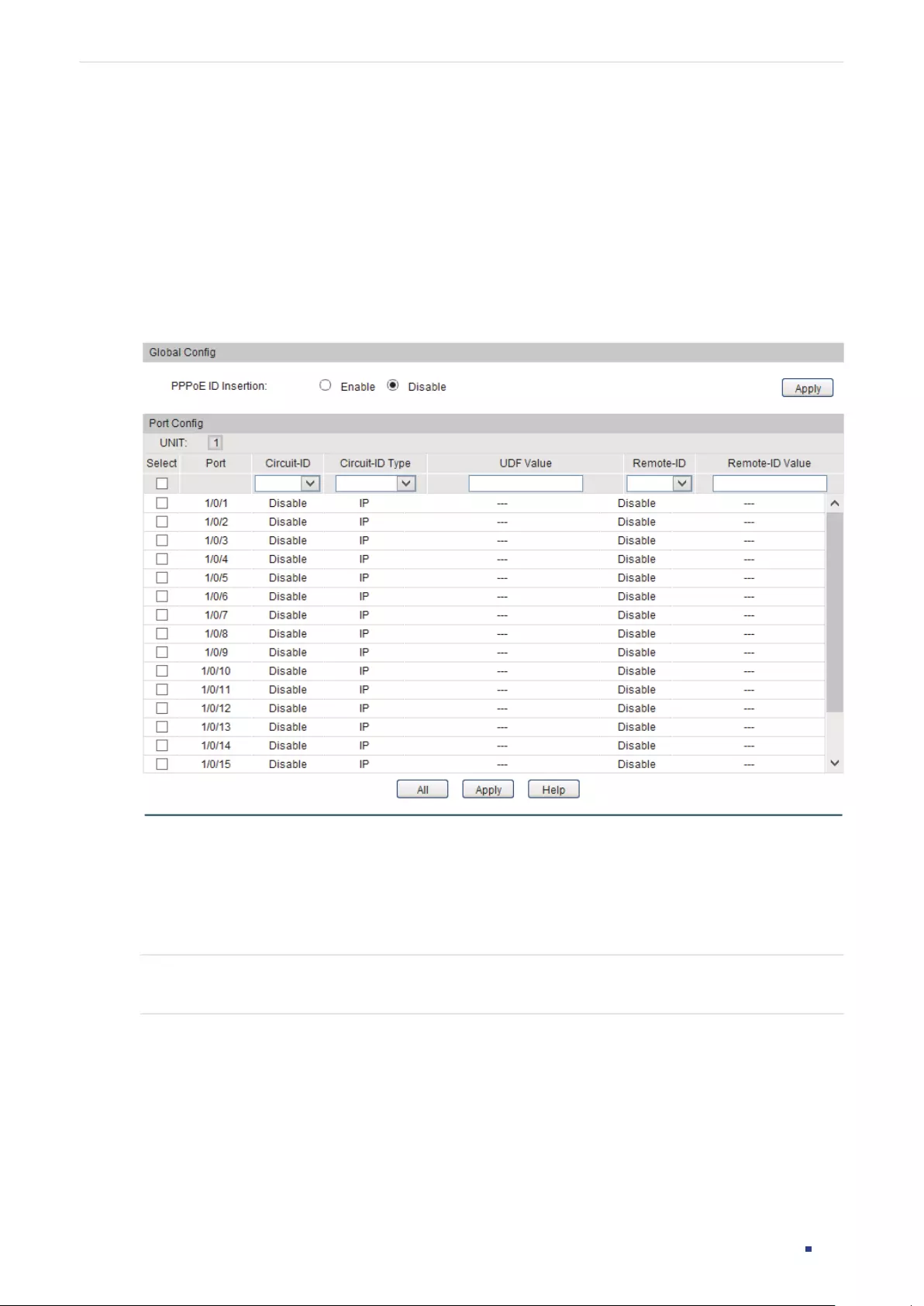
Configuration Guide 790
Configuring Network Security PPPoE ID-Insertion Configuration
11 PPPoE ID-Insertion Configuration
11.1 Using the GUI
Choose the menu Network Security > PPPoE > PPPoE ID Insertion to load the following page.
Figure 11-1 PPPoE ID Insertion
Follow these steps to configure PPPoE ID-Insertion:
1) In the Global Config section, enable PPPoE ID Insertion and click Apply.
2) In the Port Config section, select one or more ports, and configure the relevant
parameters. Then click Apply.
Circuit-ID Enable or disable the Circuit-ID Insertion feature. With this option enabled, the switch
will insert a Circuit ID to the received PPPoE Discovery packet on this port.

Configuration Guide 791
Configuring Network Security PPPoE ID-Insertion Configuration
Circuit-ID Type Select the type of the Circuit ID. The following options are provided:
IP: The circuit ID includes the following three parts: the source MAC address of the
received packet, the IP address of the switch and the port number. This is the default
value.
MAC: The circuit ID includes the following three parts: the source MAC address of the
packet, the MAC address of the switch and the port number.
UDF: The circuit ID includes the following three parts: the source MAC address of the
packet, the user-specified string and the port number.
UDF ONLY: Only the user specified string will be used to encode the Circuit-ID option.
UDF Value If UDF or UDF ONLY is selected, specify a string with at most 40 characters to encode
the Circuit-id option.
Remote-ID Enable or disable the Remote-ID Insertion feature. With this option enabled, the
switch will insert a Remote ID to the received PPPoE Discovery packet on this port.
Remote-ID Value Specify a string with at most 40 characters to encode the Remote-id option.
11.2 Using the CLI
Follow these steps to configure PPPoE ID-Insertion:
Step 1 configure
Enter global configuration mode.
Step 2 pppoe id-insertion
Globally enable the PPPoE ID-Insertion feature.
Step 3 interface { fastEthernet
port
| range fastEthernet
port-list
| gigabitEthernet
port
| range
gigabitEthernet
port-list
}
Enter interface configuration mode.
Step 4 pppoe circuit-id
Enable Circuit-ID Insertion feature, and the switch will insert a Circuit ID to the received
PPPoE Discovery packet on this port.

Configuration Guide 792
Configuring Network Security PPPoE ID-Insertion Configuration
Step 5 pppoe circuit-id type { mac | ip | udf [
Value
] | udf-only [
Value
] }
Specify the type of the Circuit ID. The following options are provided:
mac:
The source MAC address of the packet, the MAC address of the switch and the port
number will be used to encode the Circuit-ID option.
ip:
The circuit ID includes the following three parts: the source MAC address of the received
packet, the IP address of the switch and the port number. This is the default value.
udf [
Value
]: Specify a string with at most 40 characters. The circuit ID includes the following
three parts: the source MAC address of the packet, the user-specified string and the port
number.
udf-only [
Value
]: Specify a string with at most of 40 characters. Only the specified string will
be used to encode the Circuit-ID option.
Step 6 pppoe remote-id [
Value
]
Enable Remote-ID Insertion feature and specify the Remote ID.
Value
:
Specify a string with at most 40 characters. The source MAC address of the packet
and the specified string will be used to encode the Remote-ID option.
Step 7 show pppoe id-insertion global
Verify the global configuration of PPPoE ID-Insertion.
Step 8 show pppoe id-insertion interface { fastEthernet
port
| gigabitEthernet
port
}
Verify the configuration of PPPoE ID-Insertion for the specific port.
Step 9 end
Return to privileged EXEC mode.
Step 10 copy running-config startup-config
Save the settings in the configuration file.
The following example shows how to enable PPPoE ID-Insertion globally and on port 1/0/1,
and configure the Circuit-ID as 123 without other information and Remote-ID as host1.
Switch#configure
Switch(config)#pppoe id-insertion
Switch(config-if)#interface gigabitEthernet 1/0/1
Switch(config-if)#pppoe circuit-id
Switch(config-if)#pppoe circuit-id type udf-only 123
Switch(config-if)#pppoe remote-id host1
Switch(config-if)#show pppoe id-insertion global
PPPoE ID Insertion State: Enabled

Configuration Guide 793
Configuring Network Security PPPoE ID-Insertion Configuration
Switch(config-if)#show pppoe id-insertion interface gigabitEthernet 1/0/1
Port Circuit-ID C-ID Type C-ID Value(UDF) Remote-ID R-ID Value
------- ----------- ----------- ---------------------- ----------- ---------------
Gi1/0/1 Enabled UDF-ONLY 123 Enabled host1
Switch(config-if)#end
Switch#copy running-config startup-config

Configuration Guide 794
Configuring Network Security AAA Configuration
12 AAA Configuration
In the AAA feature, the authentication can be processed locally on the switch or centrally
on the RADIUS/TACACS+ server(s). To ensure the stability of the authentication system,
you can configure multiple servers and authentication methods at the same time. This
chapter introduces how to configure this kind of comprehensive authentication in AAA.
To complete the configuration, follow these steps:
1) Globally enable AAA.
2) Add the servers.
3) Configure the server groups.
4) Configure the method list.
5) Configure the AAA application list.
6) Configure the login account and the Enable password.
Configuration Guidelines
The basic concepts and working mechanism of AAA are as follows:
Server Group
Multiple servers running the same protocol can be added to a server group, and the servers
in the group will authenticate the users in the order they are added. The server that is first
added to the group has the highest priority, and is responsible for authentication under
normal circumstances. If the first one breaks down or doesn’t respond to the authentication
request for some reason, the second sever will start working for authentication, and so on.
Method List
A server group is regarded as a method, and the local authentication is another method.
Several methods can be configured to form a method list. The switch uses the first
method in the method list to authenticate the user, and if that method fails to respond, the
switch selects the next method. This process continues until the user has a successful
communication with a method or until all defined methods are exhausted. If the
authentication succeeds or the secure server or the local switch denies the user’s access,
the authentication process stops and no other methods are attempted.
Two types of method list are provided: Login method list for users of all types to access the
switch, and Enable method list for guests to get administrative privileges.
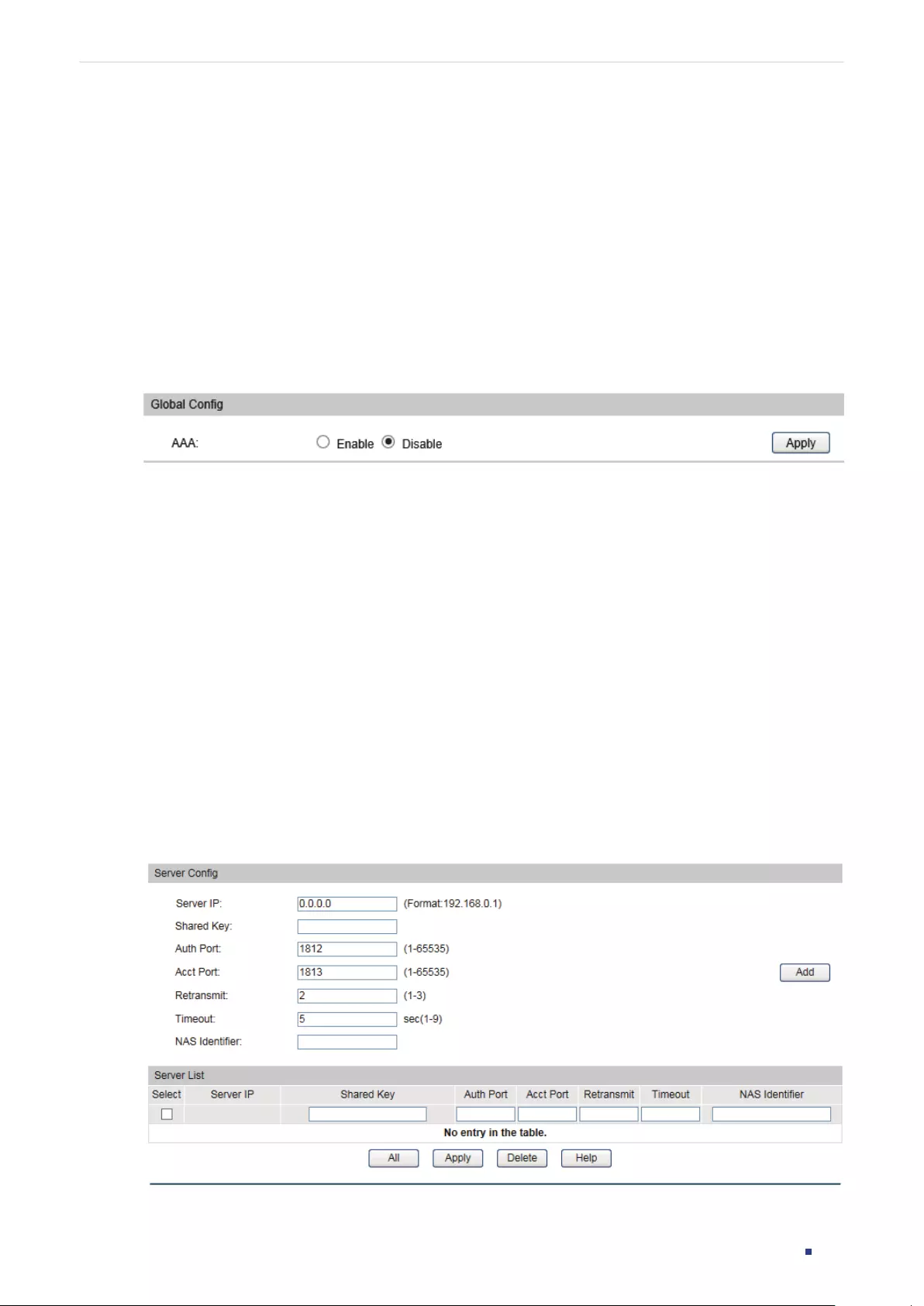
Configuration Guide 795
Configuring Network Security AAA Configuration
AAA Application List
The switch supports the following access applications: Console, Telnet, SSH and HTTP.
You can select the configured authentication method lists for each application.
12.1 Using the GUI
12.1.1 Globally Enabling AAA
Choose the menu Network Security > AAA > Global Conifg to load the following page.
Figure 12-1 Global Configuration
Follow these steps to globally enable AAA:
1) In the Global Config section, enable AAA.
2) Click Apply.
12.1.2 Adding Servers
You can add one or more RADIUS/TACACS+ servers on the switch for authentication.
If multiple servers are added, the server that is first added to the group has the highest
priority and authenticates the users trying to access the switch. The others act as backup
servers in case the first one breaks down.
Adding RADIUS Server
Choose the menu Network Security > AAA > RADIUS Conifg to load the following page.
Figure 12-2 RADIUS Server Configuration

Configuration Guide 796
Configuring Network Security AAA Configuration
Follow these steps to add a RADIUS server:
1) In the Server Config section, configure the following parameters.
Server IP Enter the IP address of the server running the RADIUS secure protocol.
Shared Key Enter the shared key between the RADIUS server and the switch. The RADIUS
server and the switch use the key string to encrypt passwords and exchange
responses.
Auth Port Specify the UDP destination port on the RADIUS server for authentication
requests. The default setting is 1812.
Acct Port Specify the UDP destination port on the RADIUS server for accounting requests.
The default setting is 1813. Usually, it is used in the 802.1X feature.
Retransmit Specify the number of times a request is resent to the server if the server does
not respond. The default setting is 2.
Timeout Specify the time interval that the switch waits for the server to reply before
resending. The default setting is 5 seconds.
NAS Identifier Specify the name of the NAS (Network Access Server) to be contained in RADIUS
packets for identification. It ranges from 1 to 31 characters. The default value is
the MAC address of the switch. Generally, the NAS indicates the switch itself.
2) Click Add to add the RADIUS server on the switch.
Adding TACACS+ Server
Choose the menu Network Security > AAA > TACACS+ Conifg to load the following page.
Figure 12-3 TACACS+ Server Configuration
Follow these steps to add a TACACS+ server:
1) In the Server Config section, configure the following parameters.
Server IP Enter the IP address of the server running the TACACS+ secure protocol.

Configuration Guide 797
Configuring Network Security AAA Configuration
Timeout Specify the time interval that the switch waits for the server to reply before
resending. The default setting is 5 seconds.
Shared Key Enter the shared key between the TACACS+ server and the switch. The
TACACS+ server and the switch use the key string to encrypt passwords and
exchange responses.
Server Port Specify the TCP port used on the TACACS+ server for AAA. The default setting is
49.
2) Click Add to add the TACACS+ server on the switch.
12.1.3 Configuring Server Groups
The switch has two built-in server groups, one for RADIUS servers and the other for
TACACS+ servers. The servers running the same protocol are automatically added to the
default server group. You can add new server groups as needed.
Choose the menu Network Security > AAA > Server Group to load the following page.
Figure 12-4 Add New Server Group
The two default server groups in the list cannot be edited or deleted. You can follow these
steps to configure a new server group:
1) In the Add New Server Group section, configure the group name and the server type,
and click Add to add the new server group.
Server Group Specify a name for the server group.
Server Type Select the server type for the group. The following options are provided: RADIUS
and TACACS+.
2) Select the newly added group, and click edit in the Operation column.
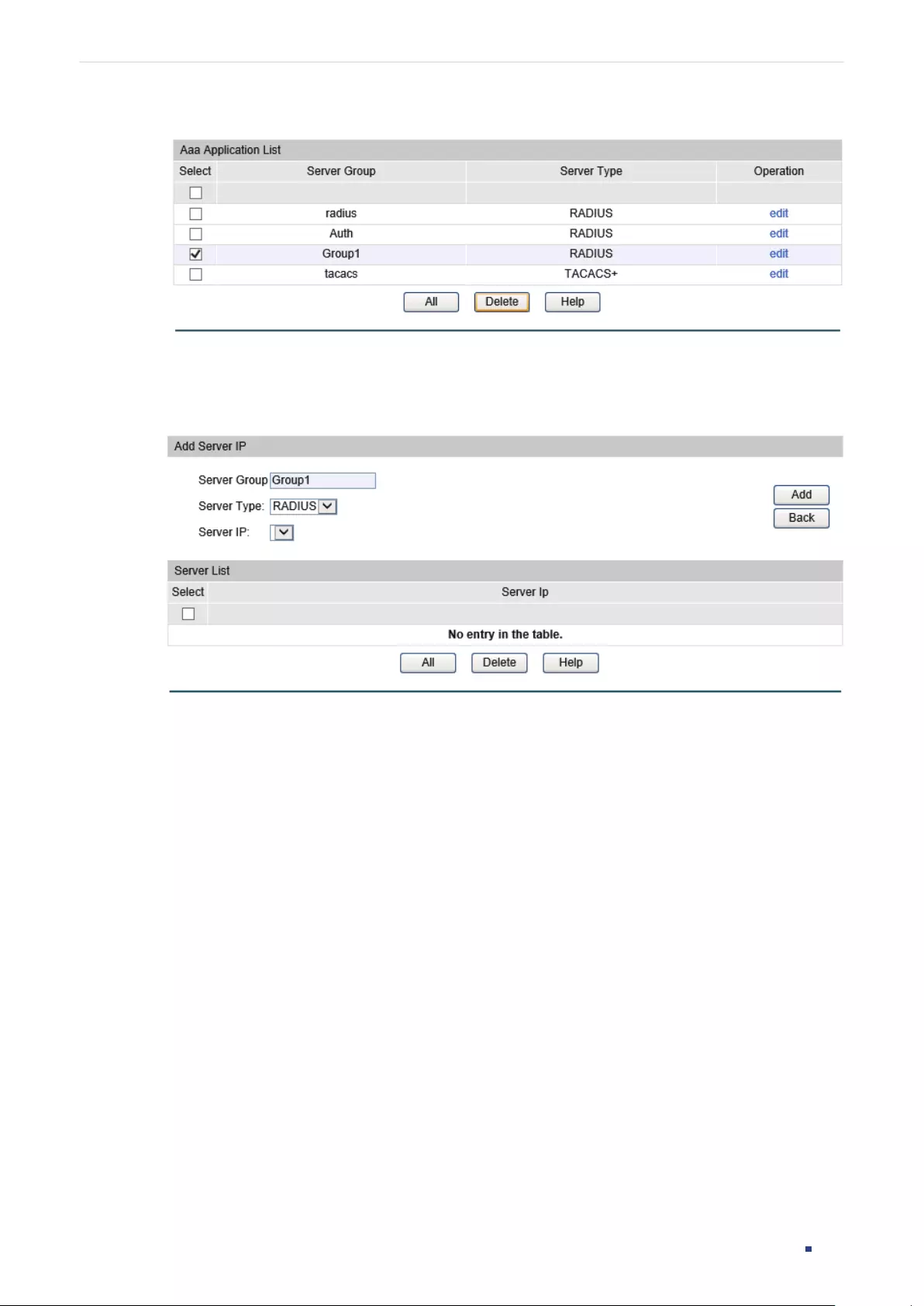
Configuration Guide 798
Configuring Network Security AAA Configuration
Figure 12-5 Edit the Group
3) Select the server to be added to the group from the Server IP drop-down list . Then
click Add to add this server to the server group.
Figure 12-6 Add Server to Group
12.1.4 Configuring the Method List
A method list describes the authentication methods and their sequence to authenticate
the users. The switch supports Login Method List for users of all types to gain access to
the switch, and Enable Method List for guests to get administrative privileges.

Configuration Guide 799
Configuring Network Security AAA Configuration
Choose the menu Network Security > AAA > Method List to load the following page.
Figure 12-7 Add New Method
There are two default methods respectively for the Login authentication and the Enable
authentication.
You can edit the default methods or follow these steps to add a new method:
1) In the Add Method List section, configure the parameters for the method to be added.
Method List Name Specify a name for the method.
List Type Select the authentication type. The following options are provided:
Authentication Login and Authentication Enable.
Pri1- Pri4 Specify the authentication methods in order. The method with priority 1
authenticates a user first, the method with priority 2 is tried if the previous
method does not respond, and so on.
local: Use the local database in the switch for authentication.
none: No authentication is used.
radius: Use the remote RADIUS server/server groups for authentication.
tacacs: Use the remote TACACS+ server/server groups for authentication.
Other user-defined server groups: Use the user-defined server groups for
authentication.
2) Click Add to add the new method.
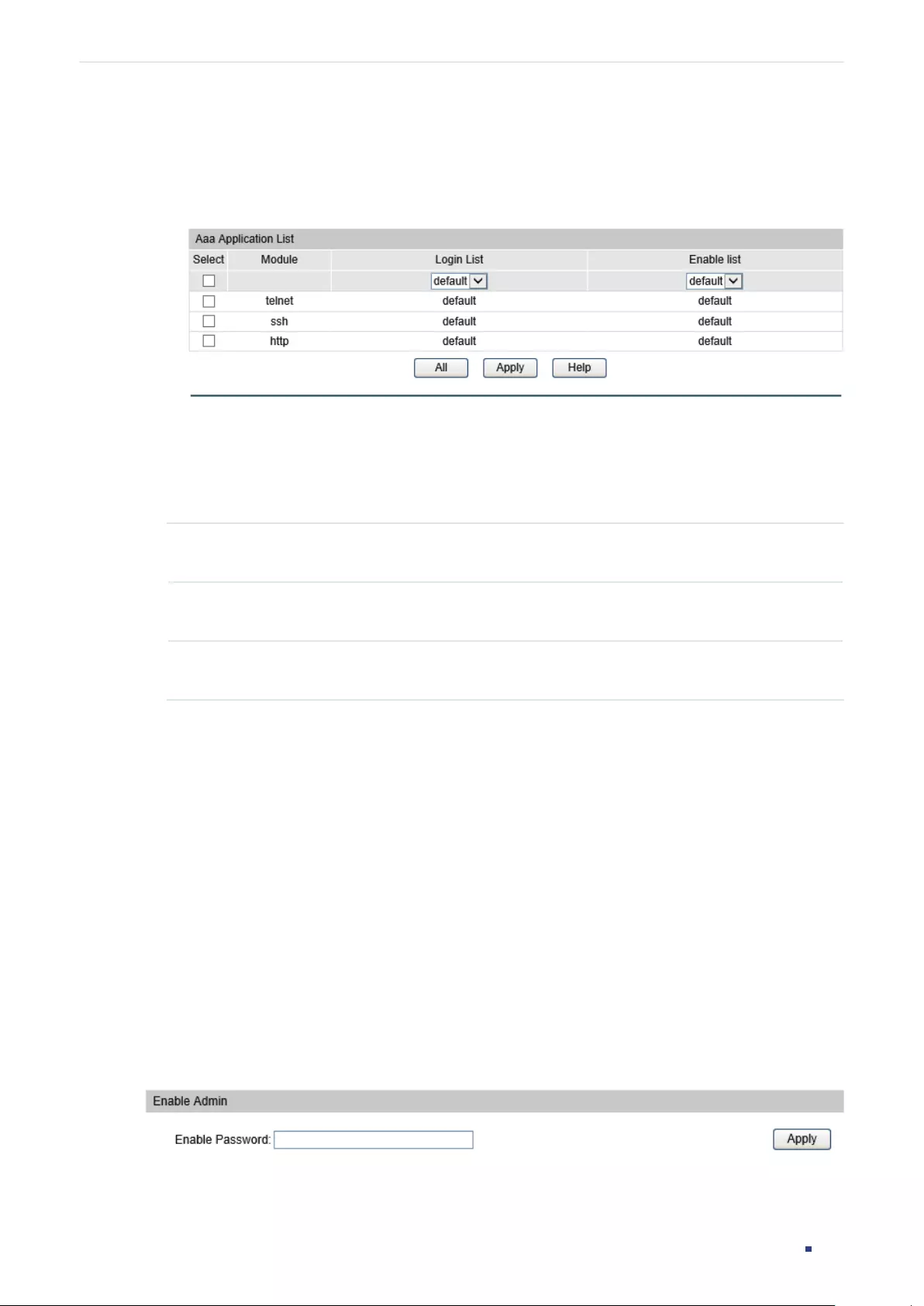
Configuration Guide 800
Configuring Network Security AAA Configuration
12.1.5 Configuring the AAA Application List
Choose the menu Network Security > AAA > Global Config to load the following page.
Figure 12-8 Configure Application List
Follow these steps to configure the AAA application list.
1) In the AAA Application List section, select an access application and configure the
Login list and Enable list.
Module Displays the configurable applications on the switch: console, telnet, ssh and
http.
Login List Select a previously configured Login method list. This method list will
authenticate the users trying to log in to the switch.
Enable List Select a previously configured Enable method list. This method list will
authenticate the users trying to get administrative privileges.
2) Click Apply.
12.1.6 Configuring Login Account and Enable Password
The login account and Enable password can be configured locally on the switch or centrally
on the RADIUS/TACACS+ server(s).
On the Switch
The local username and password for login can be configured in the User Management
feature. For details, refer to Managing System.
To configure the local Enable password for getting administrative privileges, choose the
menu Network Security > AAA > Global Config to load the following page.
Figure 12-9 Configure Enable Password
Specify the Enable password in the Enable Admin section, and click Apply.

Configuration Guide 801
Configuring Network Security AAA Configuration
Tips:
The logged-in guests can enter the Enable password on this page to get
administrative privileges.
On the Server
The accounts created by the RADIUS/TACACS+ server can only view the configurations
and some network information without the Enable password.
Some configuration principles on the server are as follows:
For Login authentication configuration, more than one login account can be created on
the server. Besides, both the user name and password can be customized.
For Enable password configuration:
On RADIUS server, the user name should be set as $enable$, and the Enable password
is customizable. All the users trying to get administrative privileges share this Enable
password.
On TACACS+ server, configure the value of “enable 15“ as the Enable password in the
configuration file. All the users trying to get administrative privileges share this Enable
password.
12.2 Using the CLI
12.2.1 Globally Enabling AAA
Follow these steps to globally enable AAA:
Step 1 configure
Enter global configuration mode.
Step 2 aaa enable
Globally enable the AAA feature.
Step 3 show aaa global
Verify the global configuration of AAA.
Step 4 end
Return to privileged EXEC mode.
Step 5 copy running-config startup-config
Save the settings in the configuration file.
The following example shows how to globally enable AAA:

Configuration Guide 802
Configuring Network Security AAA Configuration
Switch#configure
Switch(config)#aaa enable
Switch(config)#show aaa global
AAA global status: Enable
......
Switch(config)#end
Switch#copy running-config startup-config
12.2.2 Adding Servers
You can add one or more RADIUS/TACACS+ servers on the switch for authentication. If
multiple servers are added, the server with the highest priority authenticates the users
trying to access the switch, and the others act as backup servers in case the first one
breaks down.
Adding RADIUS Server
Follow these steps to add RADIUS server on the switch:
Step 1 configure
Enter global configuration mode.

Configuration Guide 803
Configuring Network Security AAA Configuration
Step 2 radius-server host
ip-address
[ auth-port
port-id
] [ acct-port
port-id
] [ timeout
time
] [
retransmit
number
] [ nas-id
nas-id
] [ key { [ 0 ]
string
| 7
encrypted-string
} ]
Add the RADIUS server and configure the related parameters as needed.
host
ip-address
:
Enter the IP address of the server running the RADIUS protocol.
auth-port
port-id
:
Specify the UDP destination port on the RADIUS server for authentication
requests. The default setting is 1812.
acct-port
port-id:
Specify the UDP destination port on the RADIUS server for accounting
requests. The default setting is 1813. Usually, it is used in the 802.1X feature.
timeout
time
:
Specify the time interval that the switch waits for the server to reply before
resending. The valid values are from 1 to 9 seconds and the default setting is 5 seconds.
retransmit
number
:
Specify the number of times a request is resent to the server if the
server does not respond. The valid values are from 1 to 3 and the default setting is 2.
nas-id
nas-id
:
Specify the name of the NAS (Network Access Server) to be contained in
RADIUS packets for identification. It ranges from 1 to 31 characters. The default value is the
MAC address of the switch. Generally, the NAS indicates the switch itself.
key { [ 0 ]
string
| 7
encrypted-string
}: Specify the shared key. 0 and 7 represent the
encryption type. 0 indicates that an unencrypted key will follow. 7 indicates that a
symmetric encrypted key with a xed length will follow. By default, the encryption type is 0.
string
is the shared key for the switch and the server, which contains 31 characters at most.
encrypted-string
is a symmetric encrypted key with a xed length, which you can copy from
the conguration le of another switch. The key or encrypted-key you congure here will be
displayed in the encrypted form.
Step 3 show radius-server
Verify the configuration of RADIUS server.
Step 4 end
Return to privileged EXEC mode.
Step 5 copy running-config startup-config
Save the settings in the configuration file.
The following example shows how to add a RADIUS server on the switch. Set the IP address
of the server as 192.168.0.10, the authentication port as 1812, the shared key as 123456,
the timeout as 8 seconds and the retransmit number as 3.
Switch#configure
Switch(config)#radius-server host 192.168.0.10 auth-port 1812 timeout 8 retransmit 3
key 123456
Switch(config)#show radius-server
Server Ip Auth Port Acct Port Timeout Retransmit NAS Identifier Shared key
192.168.0.10 1812 1813 5 2 000AEB132397 123456
Switch(config)#end

Configuration Guide 804
Configuring Network Security AAA Configuration
Switch#copy running-config startup-config
Adding TACACS+ Server
Follow these steps to add TACACS+ server on the switch:
Step 1 configure
Enter global configuration mode.
Step 2 tacacs-server host
ip-address
[ port
port-id
] [ timeout
time
] [ key { [ 0 ]
string
| 7
encrypted-
string
} ]
Add the RADIUS server and configure the related parameters as needed.
host
ip-address
:
Enter the IP address of the server running the TACACS+ protocol.
port
port-id
:
Specify the TCP destination port on the TACACS+ server for authentication
requests. The default setting is 49.
timeout
time
:
Specify the time interval that the switch waits for the server to reply before
resending. The valid values are from 1 to 9 seconds and the default setting is 5 seconds.
key { [ 0 ]
string
| 7
encrypted-string
}: Specify the shared key. 0 and 7 represent the
encryption type. 0 indicates that an unencrypted key will follow. 7 indicates that a
symmetric encrypted key with a xed length will follow. By default, the encryption type is 0.
string
is the shared key for the switch and the server, which contains 31 characters at most.
encrypted-string
is a symmetric encrypted key with a xed length, which you can copy from
the conguration le of another switch. The key or encrypted-key you congured here will
be displayed in the encrypted form.
Step 3 show tacacs-server
Verify the configuration of TACACS+ server.
Step 4 end
Return to privileged EXEC mode.
Step 5 copy running-config startup-config
Save the settings in the configuration file.
The following example shows how to add a TACACS+server on the switch. Set the IP
address of the server as 192.168.0.20, the authentication port as 49, the shared key as
123456, and the timeout as 8 seconds.
Switch#configure
Switch(config)#tacacs-server host 192.168.0.20 auth-port 49 timeout 8 key 123456
Switch(config)#show tacacs-server
Server Ip Port Timeout Shared key
192.168.0.20 49 8 123456
Switch(config)#end

Configuration Guide 805
Configuring Network Security AAA Configuration
Switch#copy running-config startup-config
12.2.3 Configuring Server Groups
The switch has two built-in server groups, one for RADIUS and the other for TACACS+. The
servers running the same protocol are automatically added to the default server group.
You can add new server groups as needed.
The two default server groups cannot be deleted or edited. Follow these steps to add a
server group:
Step 1 configure
Enter global configuration mode.
Step 2 aaa group { radius | tacacs }
group-name
Create a server group.
radius | tacacs:
Specify the group type.
group-name
:
Specify a name for the group.
Step 3 server
ip-address
Add the existing servers to the server group.
ip-address
:
Specify IP address of the server to be added to the group.
Step 4 show aaa group [
group-name
]
Verify the configuration of server group.
Step 5 end
Return to privileged EXEC mode.
Step 6 copy running-config startup-config
Save the settings in the configuration file.
The following example shows how to create a RADIUS server group named RADIUS1 and
add the existing two RADIUS servers whose IP address is 192.168.0.10 and 192.168.0.20
to the group.
Switch#configure
Switch(config)#aaa group radius RADIUS1
Switch(aaa-group)#server 192.168.0.10
Switch(aaa-group)#server 192.168.0.20
Switch(aaa-group)#show aaa group RADIUS1
192.168.0.10

Configuration Guide 806
Configuring Network Security AAA Configuration
192.168.0.20
Switch(aaa-group)#end
Switch#copy running-config startup-config
12.2.4 Configuring the Method List
A method list describes the authentication methods and their sequence to authenticate
the users. The switch supports Login Method List for users of all types to gain access to
the switch, and Enable Method List for guests to get administrative privileges.
Follow these steps to configure the method list:
Step 1 configure
Enter global configuration mode.
Step 2 aaa authentication login {
method-list
} {
method1
} [
method2
] [
method3
] [
method4
]
Configure a login method list.
method-list
:
Specify a name for the method list.
method1/method2/method3/method4
:
Specify the authentication methods in order. The rst
method authenticates a user rst, the second method is tried if the previous method does
not respond, and so on. The default methods include radius, tacacs, local and none. None
means no authentication is used for login.
Step 3 aaa authentication enable {
method-list
} {
method1
} [
method2
] [
method3
] [
method4
]
Configure an Enable password method list.
method-list
:
Specify a name for the method list.
method1/method2/method3/method4
:
Specify the authentication methods in order. The
default methods include radius, tacacs, local and none. None means no authentication is
used for getting administrative privileges.
Step 4 show aaa authentication [ login | enable ]
Verify the configuration method list.
Step 5 end
Return to privileged EXEC mode.
Step 6 copy running-config startup-config
Save the settings in the configuration file.
The following example shows how to create a Login method list named Login1, and
configure the method 1 as the default radius server group and the method 2 as local.
Switch#configure
Switch(config)##aaa authentication login Login1 radius local

Configuration Guide 807
Configuring Network Security AAA Configuration
Switch(config)#show aaa authentication login
Methodlist pri1 pri2 pri3 pri4
default local -- -- --
Login1 radius local -- --
Switch(config)#end
Switch#copy running-config startup-config
The following example shows how to create an Enable method list named Enable1, and
configure the method 1 as the default radius server group and the method 2 as local.
Switch#configure
Switch(config)##aaa authentication enable Enable1 radius local
Switch(config)#show aaa authentication enable
Methodlist pri1 pri2 pri3 pri4
default local -- -- --
Enable1 radius local -- --
Switch(config)#end
Switch#copy running-config startup-config
12.2.5 Configuring the AAA Application List
You can configure authentication method lists on the following access applications:
Console, Telnet, SSH and HTTP.
Console
Follow these steps to apply the Login and Enable method lists for the application Console:
Step 1 configure
Enter global configuration mode.
Step 2 line console
linenum
Enter line configuration mode.
linenum
: Enter the number of users allowed to login through console port. Its value is 0 in
general, for the reason that console input is only active on one console port at a time.

Configuration Guide 808
Configuring Network Security AAA Configuration
Step 3 login authentication {
method-list
}
Apply the Login method list for the application Console.
method-list
:
Specify the name of the Login method list.
Step 4 enable authentication {
method-list
}
Apply the Enable method list for the application Console.
method-list
:
Specify the name of the Enable method list.
Step 5 show aaa global
Verify the configuration of application list.
Step 6 end
Return to privileged EXEC mode.
Step 7 copy running-config startup-config
Save the settings in the configuration file.
The following example shows how to apply the existing Login method list named Login1
and Enable method list named Enable1 for the application Console.
Switch#configure
Switch(config)#line console 0
Switch(config-line)#login authentication Login1
Switch(config-line)#enable authentication Enable1
Switch(config-line)#show aaa global
......
Module Login List Enable List
Console Login1 Enable1
Telnet default default
Ssh default default
Http default default
Switch(config-line)#end
Switch#copy running-config startup-config

Configuration Guide 809
Configuring Network Security AAA Configuration
Telnet
Follow these steps to apply the Login and Enable method lists for the application Telnet:
Step 1 configure
Enter global configuration mode.
Step 2 line telnet
Enter line configuration mode.
Step 3 login authentication {
method-list
}
Apply the Login method list for the application Telnet.
method-list
:
Specify the name of the Login method list.
Step 4 enable authentication {
method-list
}
Apply the Enable method list for the application Telnet.
method-list
:
Specify the name of the Enable method list.
Step 5 show aaa global
Verify the configuration of application list.
Step 6 end
Return to privileged EXEC mode.
Step 7 copy running-config startup-config
Save the settings in the configuration file.
The following example shows how to apply the existing Login method list named Login1
and Enable method list named Enable1 for the application Telnet.
Switch#configure
Switch(config)#line telnet
Switch(config-line)#login authentication Login1
Switch(config-line)#enable authentication Enable1
Switch(config-line)#show aaa global
......
Module Login List Enable List
Console default default
Telnet Login1 Enable1
Ssh default default

Configuration Guide 810
Configuring Network Security AAA Configuration
Http default default
Switch(config-line)#end
Switch#copy running-config startup-config
SSH
Follow these steps to apply the Login and Enable method lists for the application SSH:
Step 1 configure
Enter global configuration mode.
Step 2 line ssh
Enter line configuration mode.
Step 3 login authentication {
method-list
}
Apply the Login method list for the application SSH.
method-list
:
Specify the name of the Login method list.
Step 4 enable authentication {
method-list
}
Apply the Enable method list for the application SSH.
method-list
:
Specify the name of the Enable method list.
Step 5 show aaa global
Verify the configuration of application list.
Step 6 end
Return to privileged EXEC mode.
Step 7 copy running-config startup-config
Save the settings in the configuration file.
The following example shows how to apply the existing Login method list named Login1
and Enable method list named Enable1 for the application SSH.
Switch#configure
Switch(config)#line ssh
Switch(config-line)#login authentication Login1
Switch(config-line)#enable authentication Enable1
Switch(config-line)#show aaa global
......
Module Login List Enable List

Configuration Guide 811
Configuring Network Security AAA Configuration
Console default default
Telnet default default
Ssh Login1 Enable1
Http default default
Switch(config-line)#end
Switch#copy running-config startup-config
HTTP
Follow these steps to apply the Login and Enable method lists for the application HTTP:
Step 1 configure
Enter global configuration mode.
Step 2 ip http login authentication {
method-lis
t }
Apply the Login method list for the application HTTP.
method-list
:
Specify the name of the Login method list.
Step 3 ip http enable authentication {
method-lis
t }
Apply the Enable method list for the application HTTP.
method-list
:
Specify the name of the Enable method list.
Step 4 show aaa global
Verify the configuration of application list.
Step 5 end
Return to privileged EXEC mode.
Step 6 copy running-config startup-config
Save the settings in the configuration file.
The following example shows how to apply the existing Login method list named Login1
and Enable method list named Enable1 for the application HTTP:
Switch#configure
Switch(config)#ip http login authentication Login1
Switch(config)#ip http enable authentication Enable1
Switch(config)#show aaa global
......
Module Login List Enable List

Configuration Guide 812
Configuring Network Security AAA Configuration
Console default default
Telnet default default
Ssh default default
Http Login1 Enable1
Switch(config)#end
Switch#copy running-config startup-config
12.2.6 Configuring Login Account and Enable Password
The login account and Enable password can be configured locally on the switch or centrally
on the RADIUS/TACACS+ server(s).
On the Switch
The local username and password for login can be configured in the User Management
feature. For details, refer to Managing System.
To configure the local Enable password for getting administrative privileges, follow these
steps:
Step 1 configure
Enter global configuration mode.
Step 2 enable admin password { [ 0 ]
password
| 7
encrypted-password
}
Set the Enable password. This command uses symmetric encryption.
0 and 7 represent the encryption type. 0 indicates that an unencrypted key will follow. 7
indicates that a symmetric encrypted key with a fixed length will follow. By default, the
encryption type is 0.
password
is a string from 1 to 31 alphanumeric characters or symbols.
encrypted-password
is a symmetric encrypted key with a xed length, which you can copy
from the conguration le of another switch. The key or encrypted-key you congured here
will be displayed in the encrypted form.
enable admin secret { [ 0 ]
password
| 5
encrypted-password
}
Set the Enable password. This command uses MD5 encryption.
0 and 5 are the encryption type. 0 indicates that an unencrypted key will follow. 5 indicates
that an MD5 encrypted password with fixed length will follow. By default, the encryption
type is 0.
password
is a string from 1 to 31 alphanumeric characters or symbols.
encrypted-
password
is an MD5 encrypted password with fixed length, which you can copy from
another switch’s conguration le.
Step 3 end
Return to privileged EXEC mode.

Configuration Guide 813
Configuring Network Security AAA Configuration
Step 4 copy running-config startup-config
Save the settings in the configuration file.
On the Server
The accounts created by the RADIUS/TACACS+ server can only view the configurations
and some network information without the Enable password.
Some configuration principles on the server are as follows:
For Login authentication configuration, more than one login account can be created on
the server. Besides, both the user name and password can be customized.
For Enable password configuration:
On RADIUS server, the user name should be set as $enable$, and the Enable password
is customizable. All the users trying to get administrative privileges share this Enable
password.
On TACACS+ server, configure the value of “enable 15“ as the Enable password in the
configuration file. All the users trying to get administrative privileges share this Enable
password.
Tips:
The logged-in guests can get administrative privileges by using the command
enable-admin and providing the Enable password.

Configuration Guide 814
Configuring Network Security Configuration Examples
13 Configuration Examples
13.1 Example for DHCP Snooping and ARP Detection
13.1.1 Network Requirements
As shown below, User 1 and User 2 get IP addresses from the legal DHCP server, and
User 3 has a static IP address. All of them are in the default VLAN 1. Now, untrusted DHCP
packets need to be filtered to ensure that the DHCP clients (User 1 and User 2) can get the
IP addresses from the legal DHCP server. Additionally, the network needs to be prevented
from ARP attacks.
Figure 13-1 Network Topology
Gi1/0/4
Gi1/0/1
Gi1/0/2
Gi1/0/3
Gi1/0/5
User 3
88-A9-D4-54-FD-C3
192.168.0.33/24
User 1
74-D3-45-32-B6-8D
Attacker/Illegal
DHCP Server
User 2
76-D9-33-56-78-A3
Switch A
Legal DHCP Server
13.1.2 Configuration Scheme
To meet these requirements, you can configure DHCP Snooping to filter the untrusted
DHCP packets from the illegal DHCP server and configure ARP Detection and ARP Defend
to prevent the network from ARP attacks.
The overview of configuration is as follows:
1) Configure DHCP Snooping on Switch A. Set port 1/0/4 that is connected to the legal
DHCP server as the trusted port and other ports as untrusted ports. So that the illegal
DHCP server on any other port cannot assign IP addresses for the clients.

Configuration Guide 815
Configuring Network Security Configuration Examples
2) Configure IP-MAC Binding on Switch A. The binding entries for User 1 and User 2 will be
automatically learned via DHCP Snooping, and you need to manually bind the entry for
User 3.
3) Enable ARP Detection on Switch A to prevent ARP cheating attacks.
4) Configure ARP Defend on Switch A to limit the speed of receiving the legal ARP packets
on each port, thus to prevent ARP flooding attacks.
Demonstrated with T2600G-52TS, the following sections provide configuration procedure
in two ways: using the GUI and using the CLI.
13.1.3 Using the GUI
1) Choose the menu Network Security > DHCP Snooping > Global Config to load the
following page. Because all users are in the default VLAN 1, enable DHCP Snooping on
VLAN 1. Click Apply.
Figure 13-2 Global Config
2) Choose the menu Network Security > DHCP Snooping > Port Config to load the
following page. Set port 1/0/4 as the trusted port and ports 1/0/1-port1/0/3 as
untrusted ports, and click Apply.
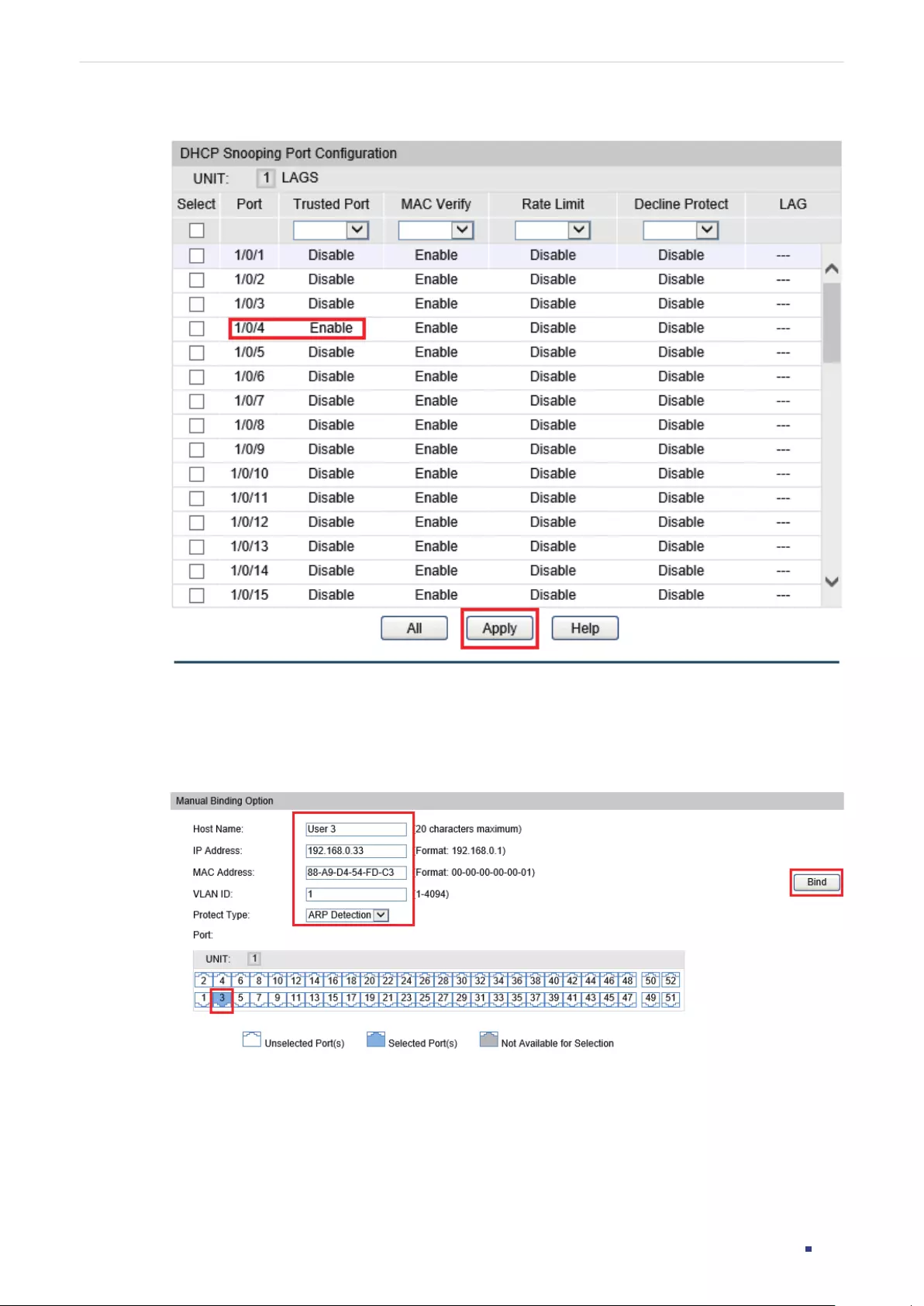
Configuration Guide 816
Configuring Network Security Configuration Examples
Figure 13-3 Port Config
3) Choose the menu Network Security > IP-MAC Binding > Manual Binding to load the
following page. Enter the host name, IP address, MAC address and VLAN ID of User 3,
select ARP Detection as the protect type, and select port 1/0/3 on the panel. Click Bind.
Figure 13-4 Manual Binding
4) Choose the menu Network Security > IP-MAC Binding > Binding Table to load the
following page. Select Source type as All, and click Search to view all the entries that
have been bound.
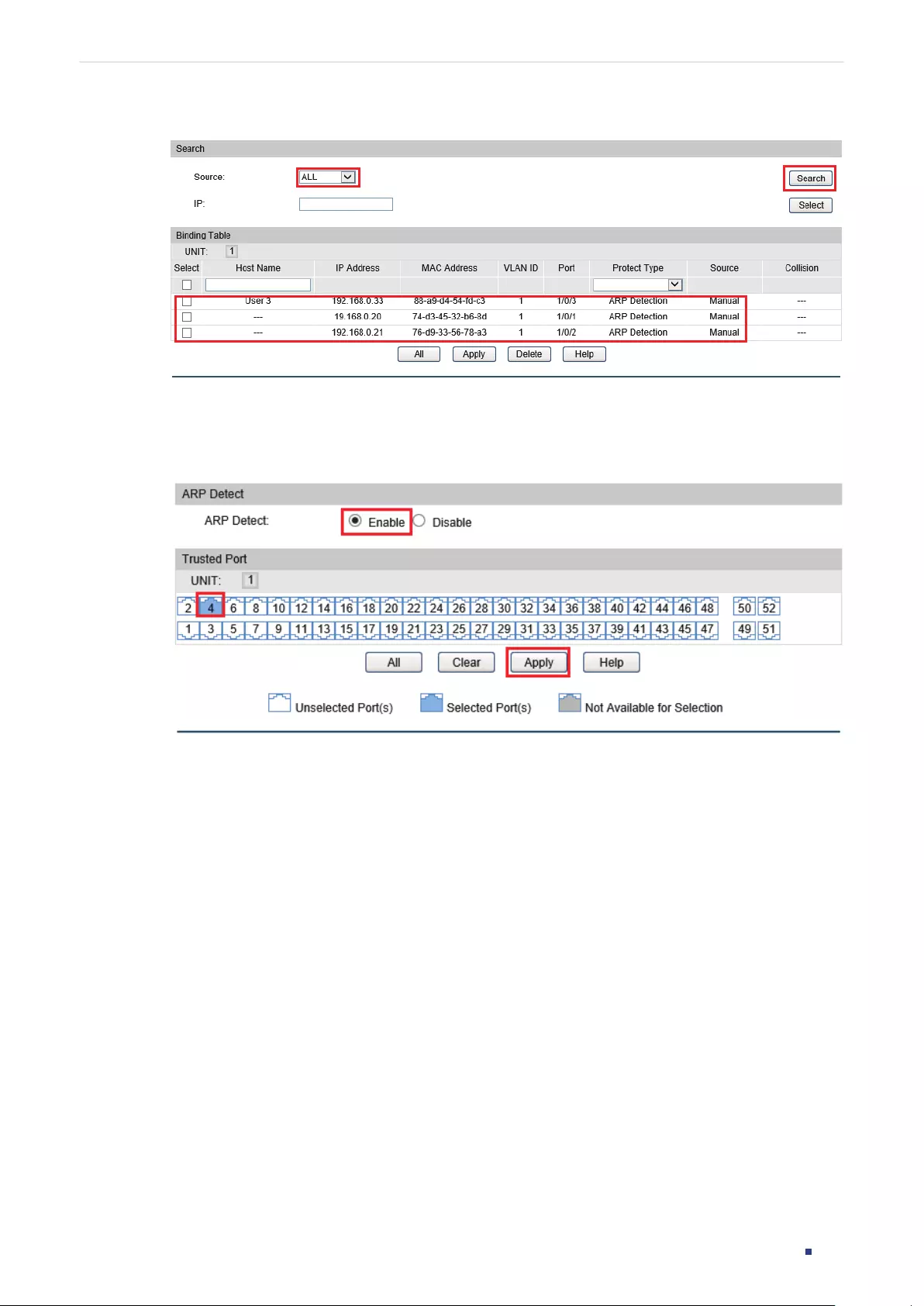
Configuration Guide 817
Configuring Network Security Configuration Examples
Figure 13-5 Binding Table
5) Choose the menu Network Security > ARP Inspection > ARP Detect to load the
following page. Enable ARP Detection and set ports 1/0/4 as trusted port. Click Apply.
Figure 13-6 ARP Detect
6) Choose the menu Network Security > ARP Inspection > ARP Defend to load the
following page. Enable ARP Defend for ports 1/0/1-3 and click Apply.

Configuration Guide 818
Configuring Network Security Configuration Examples
Figure 13-7 ARP Defend
7) Click Save Config to save the settings.
13.1.4 Using the CLI
1) Enable DHCP Snooping globally and on VLAN 1.
Switch_A#configure
Switch_A(config)#ip dhcp snooping
Switch_A(config)#ip dhcp snooping vlan 1
2) Configure port 1/0/4 as a trusted port.
Switch_A(config)#interface gigabitEthernet 1/0/4
Switch_A(config-if)#ip dhcp snooping trust
Switch_A(config-if)#exit
3) Manually bind the entry for User 3.
Switch_A(config)#ip source binding User3 192.168.0.33 88:a9:d4:54:fd:c3 vlan 1
interface gigabitEthernet 1/0/3 arp-detection
4) Enable ARP Detection globally and set port 1/0/4 as a trusted port.
Switch_A(config)#ip arp inspection
Switch_A(config)#interface gigabitEthernet 1/0/4
Switch_A(config-if)#ip arp inspection trust

Configuration Guide 819
Configuring Network Security Configuration Examples
Switch_A(config-if)#exit
5) Configure ARP Defend on ports 1/0/1-3.
Switch_A(config)#interface range gigabitEthernet 1/0/1-3
Switch_A(config-if-range)#ip arp inspection
Switch_A(config-if-range)#ip arp inspection limit-rate 15
Switch_A(config-if-range)#end
Switch_A#copy running-config startup-config
Verify the Configuration
Verify the configuration of DHCP Snooping:
Switch_A#show ip dhcp snooping
Global Status: Enable
VLAN ID: 1
Switch_A#show ip dhcp snooping interface
Interface Trusted MAC-Verify Limit-Rate Dec-rate LAG
--------- ------- ---------- ---------- -------- ----
Gi1/0/1 Disable Enable 0 0 N/A
Gi1/0/2 Disable Enable 0 0 N/A
Gi1/0/3 Disable Enable 0 0 N/A
Gi1/0/4 Enable Enable 0 0 N/A
......
Verify the IP-MAC Binding entries:
Switch_A#show ip source binding
U No. Host IP-Addr MAC-Addr VID Port ACL Col.
-- --- ------ ------- -------- --- ---- --- --
1 1 User1 192.168.0.20 74:d3:45:32:6b:8d 1 Gi1/0/1 ARP-D
1 2 User2 192.168.0.21 76:d9:33:56:78:a3 1 Gi1/0/2 ARP-D
1 3 User3 192.168.0.33 88:a9:d4:54:fd:c3 1 Gi1/0/3 ARP-D

Configuration Guide 820
Configuring Network Security Configuration Examples
Verify the configuration of ARP Detection:
Switch_A#show ip arp inspection
ARP detection global status: Enabled
Port Trusted
Gi1/0/1 NO
Gi1/0/2 NO
Gi1/0/3 NO
Gi1/0/4 YES
......
Verify the configuration of ARP Defend:
Switch_A#show ip arp inspection interface
Port OverSpeed Rate Current Status LAG
Gi1/0/1 Enabled 15 N/A Normal N/A
Gi1/0/2 Enabled 15 N/A Normal N/A
Gi1/0/3 Enabled 15 N/A Normal N/A
Gi1/0/4 Disabled 15 N/A N/A N/A
......
13.2 Example for DHCPv6 Snooping and ND Detection
13.2.1 Network Requirements
As shown below, User 1 and User 2 get IPv6 addresses from the DHCPv6 server, and User
3 has a static IPv6 address. All of them are in the default VLAN 1. Now, untrusted DHCPv6
packets need to be filtered to ensure that the DHCPv6 clients (User 1 and User 2) can get
the IPv6 addresses from the legal DHCPv6 server. Additionally, the network needs to be
prevented from ND attacks.

Configuration Guide 821
Configuring Network Security Configuration Examples
Figure 13-1 Network Topology
Gi1/0/4
Gi1/0/5
Gi1/0/1
Gi1/0/2
Gi1/0/3
User 3
88-A9-D4-54-FD-C3
2001::5
User 1
74-D3-45-32-B6-8D
User 2
76-D9-33-56-78-A3
Switch A
Legal DHCPv6
Server
Atcker/ Illegal
DHCPv6 Server
13.2.2 Configuration Scheme
To meet these requirements, you can configure DHCPv6 Snooping to filter the untrusted
DHCPv6 packets from the illegal DHCPv6 server and configure ND Detection to prevent
the network from ND attacks. The overview of configuration is as follows:
1) Configure DHCPv6 Snooping on Switch A. Set port 1/0/4 that is connected to the illegal
DHCPv6 server as the trusted port and other ports as untrusted ports. So that the illegal
DHCPv6 server on any other port cannot assign IPv6 addresses for the clients.
2) Configure IPv6-MAC Binding on Switch A. The binding entries for User 1 and User 2
will be automatically learned via DHCPv6 Snooping, and you need to manually bind the
entry for User 3.
3) Enable ND Detection on Switch A to prevent ND attacks.
Demonstrated with T2600G-18TS, the following sections provide configuration procedure
in two ways: using the GUI and using the CLI.
13.2.3 Using the GUI
1) Choose the menu Network Security > DHCPv6 Snooping > Global Config to load the
following page. Because all users are in the default VLAN 1, enable DHCPv6 Snooping on
VLAN 1. Set port 1/0/4 as a trusted port. Click Apply. After that, the IPv6-MAC binding
entries of the DHCPv6 clients will be automatically learned via DHCPv6 Snooping.

Configuration Guide 822
Configuring Network Security Configuration Examples
Figure 13-2 Global Config
2) Choose the menu Network Security > IP-MAC Binding > Manual Binding to load the
following page. Enter the host name, IP address, MAC address and VLAN ID of User 3,
select ARP Detection as the protect type, and select port 1/0/3 on the panel. Click Bind.
Figure 13-3 Manual Binding
3) Choose the menu Network Security > ND Detection > ND Detection to load the
following page. Because all users are in the default VLAN 1, enable ND Detection on
VLAN 1. Set port 1/0/4 as a trusted port. Click Apply.
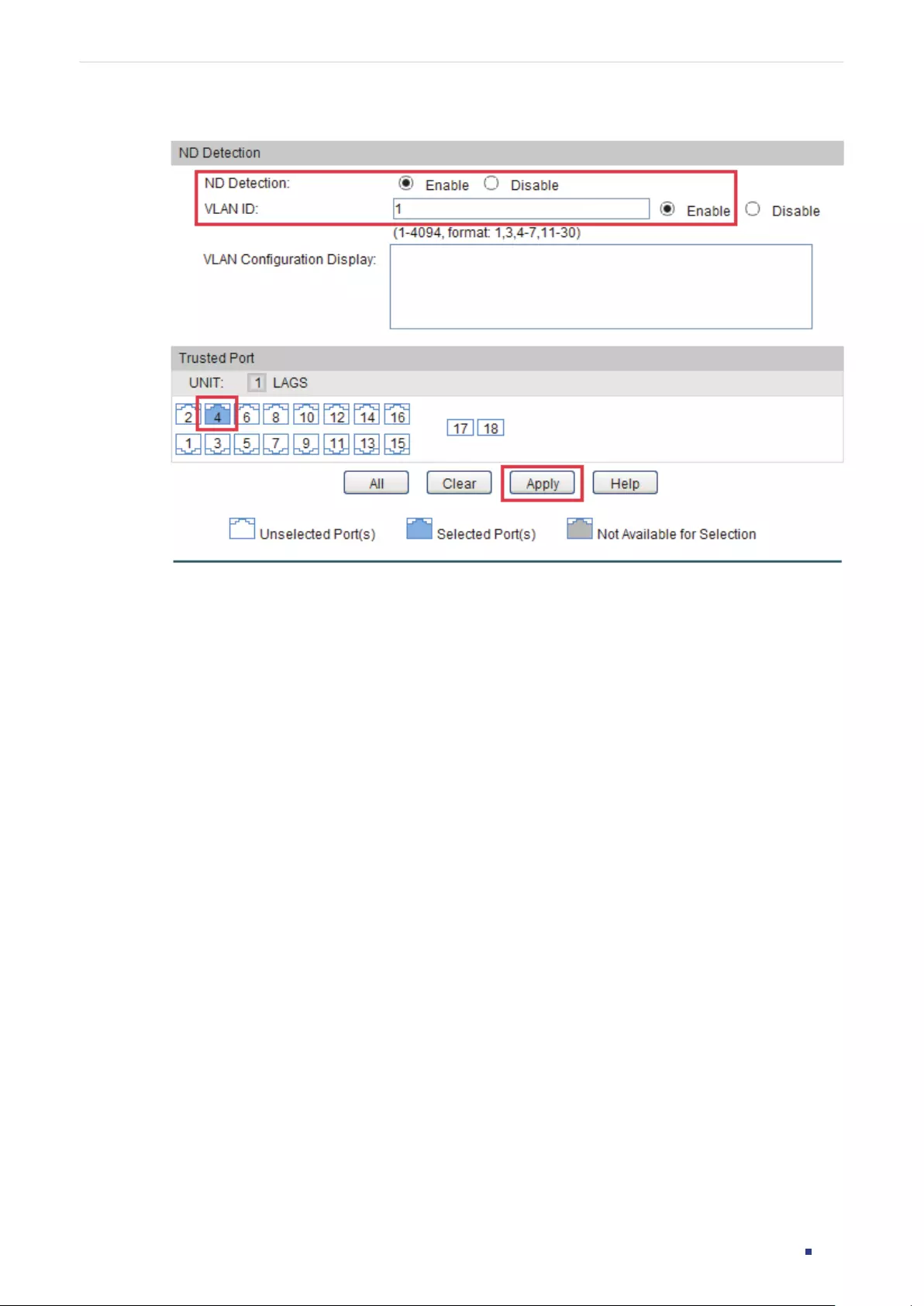
Configuration Guide 823
Configuring Network Security Configuration Examples
Figure 13-4 ND Detection
4) Click Save Config to save the settings.
13.2.4 Using the CLI
1) Enable DHCPv6 Snooping globally and on VLAN 1.
Switch_A#configure
Switch_A(config)#ipv6 dhcp snooping
Switch_A(config)#ipv6 dhcp snooping vlan 1
2) Configure port 1/0/4 as a trusted port.
Switch_A(config)#interface gigabitEthernet 1/0/4
Switch_A(config-if)#ipv6 dhcp snooping trust
Switch_A(config-if)#exit
3) Manually bind the entry for User 3.
Switch_A(config)#ipv6 source binding User3 2001::5 88:a9:d4:54:fd:c3 vlan 1 interface
gigabitEthernet 1/0/3 nd-detection
4) Enable ND Detection on VLAN 1 and set port 1/0/4 as a trusted port.
Switch_A(config)#ipv6 nd detection
Switch_A(config)#ipv6 nd detection vlan 1
Switch_A(config)#interface gigabitEthernet 1/0/4

Configuration Guide 824
Configuring Network Security Configuration Examples
Switch_A(config-if)#ipv6 nd detection trust
Switch_A(config-if)#end
Switch_A#copy running-config startup-config
Verify the Configuration
Verify the configuration of DHCPv6 Snooping:
Switch_A#show ipv6 dhcp snooping
Global Status: Enable
VLAN ID: 1
Switch_A#show ipv6 dhcp snooping interface
Interface Trusted LAG
--------- ------- ---
Gi1/0/1 Disable N/A
Gi1/0/2 Disable N/A
Gi1/0/3 Disable N/A
Gi1/0/4 Enable N/A
Gi1/0/5 Disable N/A
......
Verify the IPv6-MAC Binding entries:
Switch_A#show ipv6 source binding
U No. Host IP-Addr MAC-Addr VID Port ACL Active Source Col.
- --- ---- ------- -------- --- ---- --- ------ ----- ----
1 1 User1 2001::2 74:d3:45:32:b6:8d 1 Gi1/0/1 Both ND-D ND Snooping
1 2 User2 2001::3 76:d9:33:56:78:a3 1 Gi1/0/2 Both ND-D ND Snooping
1 3 User3 2001::5 88:a9:d4:54:fd:c3 1 Gi1/0/3 ND-D ND-D Manual
Verify the configuration of ND Detection:
Switch_A#show ipv6 nd detection
Global Status: Enable
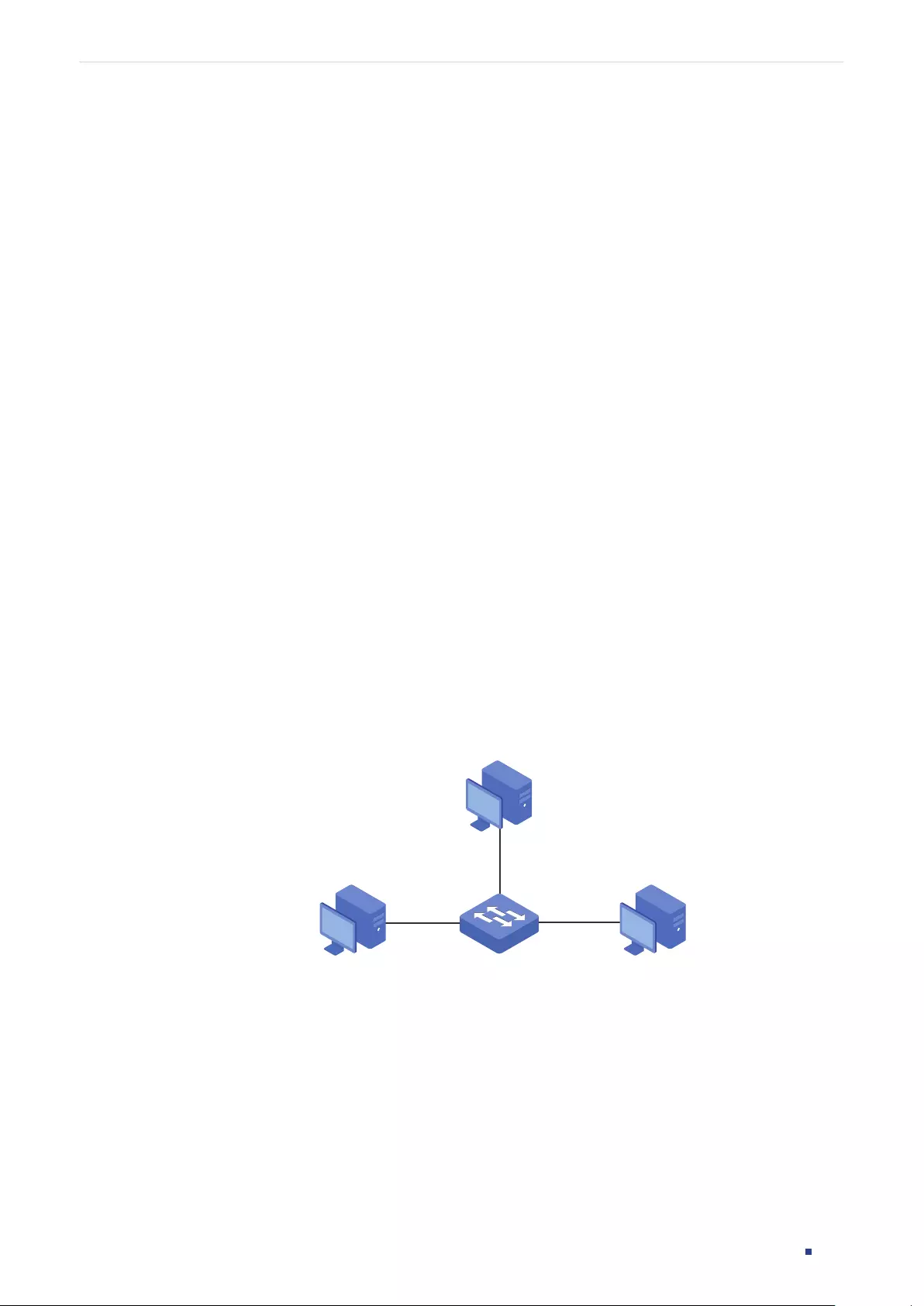
Configuration Guide 825
Configuring Network Security Configuration Examples
VLAN ID: 1
Switch_A#show ipv6 nd detection interface
Interface Trusted LAG
--------- ------- ----
Gi1/0/1 Disable N/A
Gi1/0/2 Disable N/A
Gi1/0/3 Disable N/A
Gi1/0/4 Enable N/A
Gi1/0/5 Disable N/A
......
13.3 Example for IP Source Guard
13.3.1 Network Requirements
As shown below, the legal host connects to the switch via port 1/0/1 and belongs to the
default VLAN 1. It is required that only the legal host can access the network via port 1/0/1,
and other unknown hosts will be blocked when trying to access the network via ports
1/0/1-3.
Figure 13-5 Network Topology
Switch
GI1/0/2 GI1/0/3
GI1/0/1
Legal Host
192.168.0.100
AA-BB-CC-DD-EE-FF
Illegal HostIllegal Host
13.3.2 Configuration Scheme
To implement this requirement, you can use IP-MAC Binding and IP Source Guard to filter
out the packets received from the unknown hosts. The overview of configuration on the
switch is as follows:
1) Bind the MAC address, IP address, connected port number and VLAN ID of the legal
host with IP-MAC Binding.
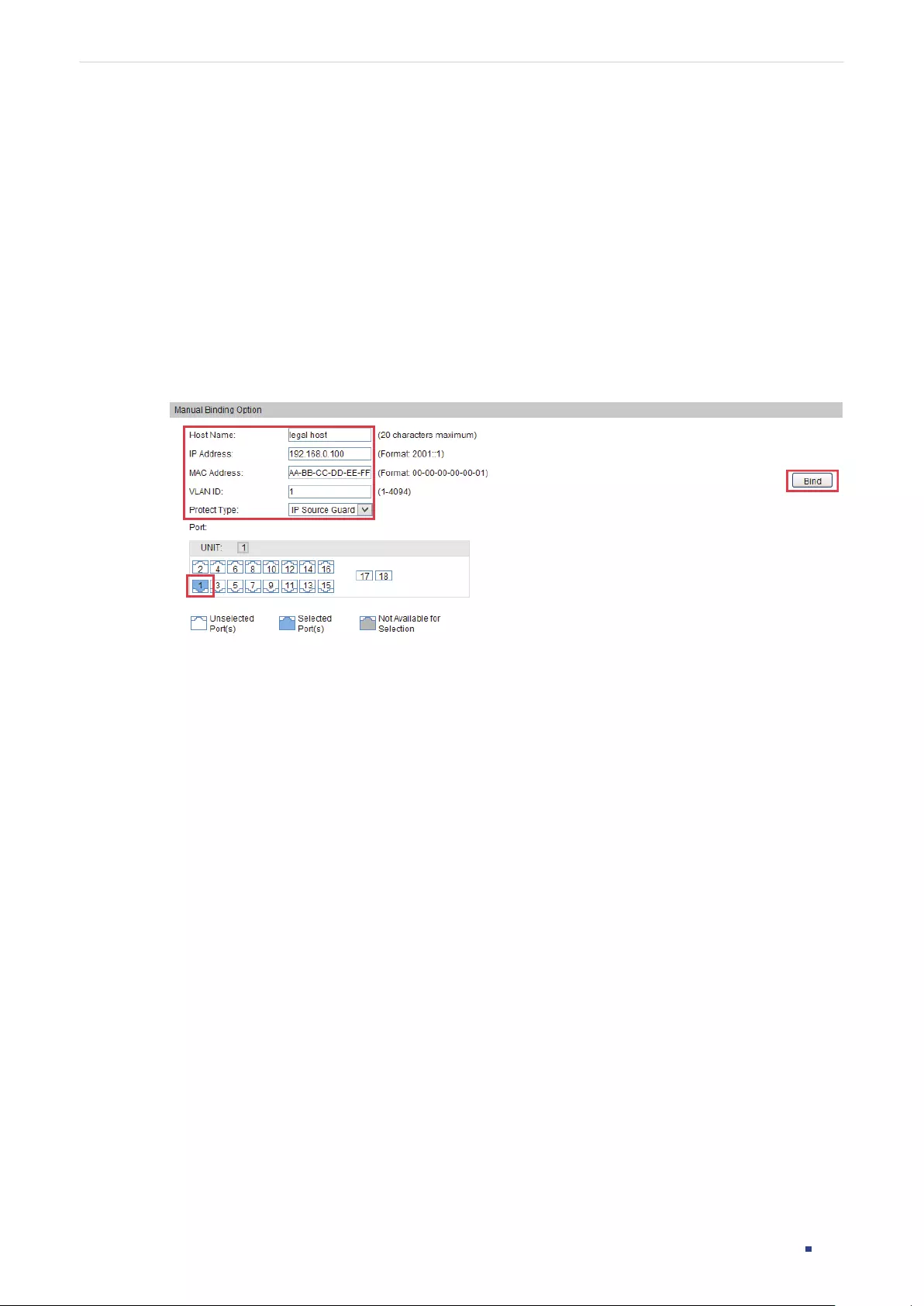
Configuration Guide 826
Configuring Network Security Configuration Examples
2) Enable IP Source Guard on ports 1/0/1-3.
Demonstrated with T2600G-18TS, the following sections provide configuration procedure
in two ways: using the GUI and using the CLI.
13.3.3 Using the GUI
1) Choose the menu Network Security > IP-MAC Binding > Manual Binding to load the
following page. Specify the host name, IP address, MAC address, VLAN ID of the host,
select Protect Type as IP Source Guard, and select port 1/0/1. Click Bind.
Figure 13-6 Manual Binding
2) Choose the menu Network Security > IP Source Guard> IP Source Guard to load the
following page. Select ports 1/0/1-3, configure the IPv4 Security Type as SIP+MAC, and
click Apply. Then the switch will check the packets received from ports 1/0/1-3
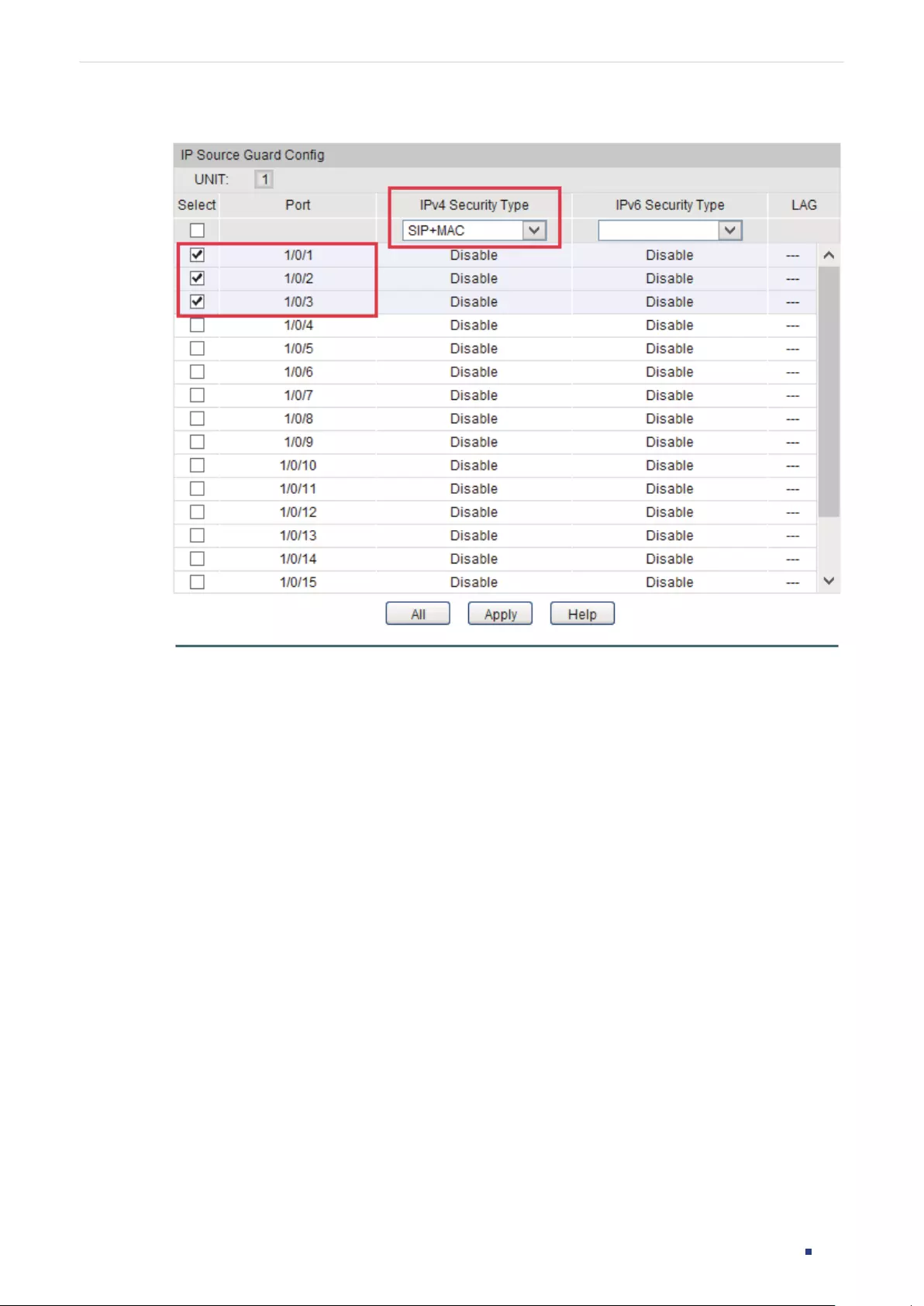
Configuration Guide 827
Configuring Network Security Configuration Examples
Figure 13-7 IP Source Guard
3) Click Save Config to save the settings.
13.3.4 Using the CLI
1) Manually bind the IP address, MAC address, VLAN ID and connected port number of the
host, and apply this entry to the IP Source Guard feature.
Switch#configure
Switch(config)#ip source binding legal-host 192.168.0.100 aa:bb:cc:dd:ee:ff vlan 1
interface gigabitEthernet 1/0/1 ip-verify-source
2) Enable IP Source Guard on ports 1/0/1-3.
Switch(config)# interface range gigabitEthernet 1/0/1-3
Switch(config-if-range)#ip verify source sip+mac
Switch(config-if-range)#end
Switch#copy running-config startup-config

Configuration Guide 828
Configuring Network Security Configuration Examples
Verify the Configuration
Verify the binding entry:
Switch#show ip source binding
U No. Host IP-Addr MAC-Addr VID Port ACL Col.
- --- ---- ------------- -------- --- ------- ------ ----
1 1 legal-host 192.168.0.100 aa:bb:cc:dd:ee:ff 1 Gi1/0/1 IP-V-S
Notice:
1. Here,’Col.’stands for ‘Collision’;’ARP-D’ for ‘ARP-Detection’,and’IP-V-S’ for ‘IP-Verify-
Source’.
2. ’No.’ stands for the actual index of each entry in the binding-table.They may not
actually in the order of 1,2,3,...
Verify the configuration of IP Source Guard:
Switch#show ip verify source
Port Security-Type LAG
Gi1/0/1 SIP+MAC N/A
Gi1/0/2 SIP+MAC N/A
Gi1/0/3 SIP+MAC N/A
......
13.4 Example for 802.1X
13.4.1 Network Requirements
The network administrator wants to control access from the end users (clients) in the
company. It is required that all clients need to be authenticated separately and that only the
authenticated clients can access the Internet.
13.4.2 Configuration Scheme
To authenticate clients separately, enable 802.1X authentication, configure the control
mode as auto, and set the control type as MAC based.
Enable 802.1X authentication on the ports connected to clients.

Configuration Guide 829
Configuring Network Security Configuration Examples
Keep 802.1X authentication disabled on ports connected to the authentication server
and the Internet, which ensures unrestricted connections between the switch and the
authentication server or the Internet.
13.4.3 Network Topology
As shown in the following figure, Switch A acts as the authenticator. Port 1/0/1 is
connected to the client, port 1/0/2 is connected to the RADIUS server, and port 1/0/3 is
connected to the Internet.
Figure 13-8 Network Topology
Internet
Switch A
Authenticator
Client Client
Gi1/0/1
Gi1/0/2Gi1/0/3
Client
RADIUS Server
192.168.0.10/24
Auth Port:1812
Demonstrated with T2600G-52TS acting as the authenticator, the following sections
provide configuration procedure in two ways: using the GUI and using the CLI.
13.4.4 Using the GUI
1) Choose the menu Network Security > AAA > Global Config to load the following page.
Enable AAA function globally on the switch.
Figure 13-9 Enable AAA Function
2) Choose the menu Network Security > AAA > RADIUS Config to load the following
page. Configure the parameters of the RADIUS server.
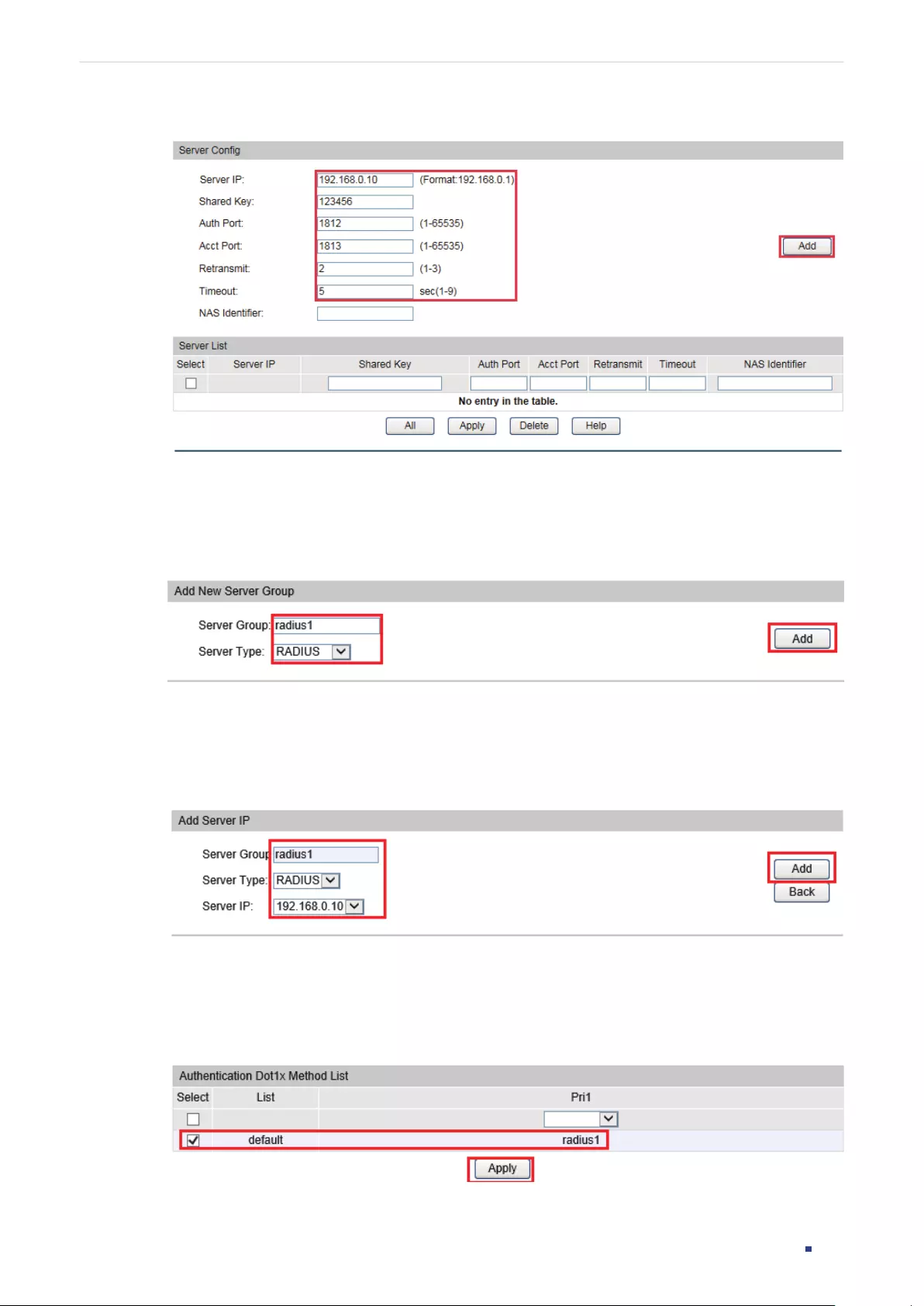
Configuration Guide 830
Configuring Network Security Configuration Examples
Figure 13-10 RADIUS Config
3) Choose the menu Network Security > AAA > Server Group to load the following page.
In the Add New Server Group section, specify the group name as radius1 and the
server type as RADIUS. Click Add to create the server group.
Figure 13-11 Create Server Group
4) On the same page, select the newly created server group and click edit to load the
following page. Select 192.168.0.10 from the drop-down list, and click Add to add the
server to the group.
Figure 13-12 Add Servers to Server Group
5) Choose the menu Network Security > AAA > Dot1x List to load the following page.
In the Authentication Dot1x Method List section, select radius1 as the radius server
group for authentication, and click Apply.
Figure 13-13 Configure Authentication RADIUS Server

Configuration Guide 831
Configuring Network Security Configuration Examples
6) Choose the menu Network Security > 802.1X Authentication > Global Config to load
the following page. Enable 802.1X authentication and configure the Authentication
Method as EAP. Enable the Quiet feature and then keep the default authentication
settings.
Figure 13-14 Global Config
7) Choose the menu Network Security > 802.1X Authentication > Port Config to load
the following page. For port 1/0/1, enable 802.1X authentication, set the Control Mode
as auto and set the Control Type as MAC Based; For port 1/0/2 and port 1/0/3, disable
802.1X authentication.

Configuration Guide 832
Configuring Network Security Configuration Examples
Figure 13-15 Port Config
8) Click Save Config to save the settings.
13.4.5 Using the CLI
1) Enable AAA function globally and configure the RADIUS parameters.
Switch_A(config)#aaa enable
Switch_A(config)#radius-server host 192.168.0.10 auth-port 1812 key 123456
Switch_A(config)#aaa group radius radius1
Switch_A(aaa-group)#server 192.168.0.10
Switch_A(aaa-group)#exit
Switch_A(config)#aaa authentication dot1x default radius1
Switch_A(config)#end
Switch_A#copy running-config startup-config
2) Globally enable 802.1X authentication and set the authentication method; enable the
quiet feature and configure relevant parameters.
Switch_A#configure
Switch_A(config)#dot1x system-auth-control
Switch_A(config)#dot1x auth-method eap
Switch_A(config)#dot1x quiet-period

Configuration Guide 833
Configuring Network Security Configuration Examples
3) Disable 802.1X authentication on port 1/0/2 and port 1/0/3. Enable 802.1X
authentication on port 1/0/1, set the control mode as auto, and set the control type as
MAC based.
Switch_A(config)#interface gigabitEthernet 1/0/2
Switch_A(config-if)#no dot1x
Switch_A(config-if)#exit
Switch_A(config)#interface gigabitEthernet 1/0/3
Switch_A(config-if)#no dot1x
Switch_A(config-if)#exit
Switch_A(config)#interface gigabitEthernet 1/0/1
Switch_A(config-if)#dot1x
Switch_A(config-if)#dot1x port-method mac-based
Switch_A(config-if)#dot1x port-control auto
Switch_A(config-if)#exit
Verify the Configurations
Verify the global configurations of 802.1X authentication:
Switch_A#show dot1x global
802.1X State: Enabled
Authentication Method: EAP
Handshake State: Enabled
Guest VLAN State: Disabled
Guest VLAN ID: N/A
802.1X Accounting State: Disabled
802.1X VLAN Assignment State: Disabled
Quiet-period State: Enabled
Quiet-period Timer: 10 sec.
Max Retry-times For RADIUS Packet: 3
Supplicant Timeout: 3 sec.

Configuration Guide 834
Configuring Network Security Configuration Examples
Verify the configurations of 802.1X authentication on the port:
Switch_A#show dot1x interface
Port State MAB State GuestVLAN PortControl PortMethod Authorized LAG
---- ------ ---------- --------- ----------- ---------- ---------- ---
Gi1/0/1 enabled disabled disabled auto mac-based authorized N/A
Gi1/0/2 disabled disabled disabled auto mac-based authorized N/A
Gi1/0/3 disabled disabled disabled auto mac-based authorized N/A
......
Verify the configurations of RADIUS :
Switch_A#show aaa global
AAA global status: Enable
Module Login List Enable List
Console default default
Telnet default default
Ssh default default
Http default default
Switch_A#show aaa authentication dot1x
Methodlist pri1 pri2 pri3 pri4
default radius1 -- -- --
Switch_A#show aaa group radius1
192.168.0.10
13.5 Example for AAA
13.5.1 Network Requirements
As shown below, the switch needs to be managed remotely via Telnet. In addition, the
senior administrator of the company wants to create an account for the less senior
administrators, who can only view the configurations and some network information
without the Enable password provided.
Two RADIUS servers are deployed in the network to provide a safer authenticate method
for the administrators trying to log in or get administrative privileges. If RADIUS Server 1
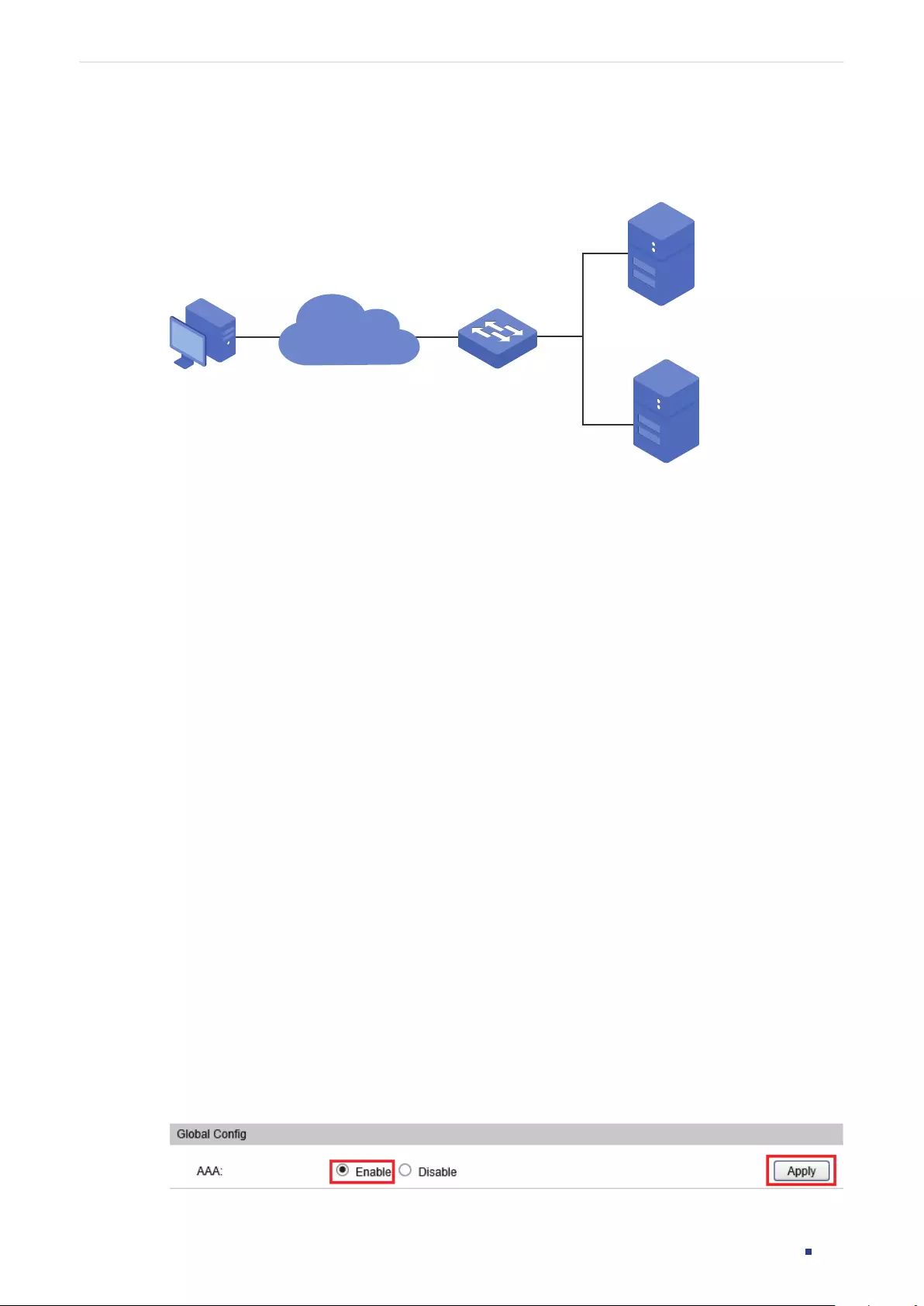
Configuration Guide 835
Configuring Network Security Configuration Examples
breaks down and doesn’t respond to the authentication request, RADIUS Server 2 will work,
so as to ensure the stability of the authentication system.
Figure 13-16 Network Topology
RADIUS Server 1
192.168.0.10/24
Auth Port:1812
RADIUS Server 2
192.168.0.20/24
Auth Port: 1812
Switch Administrator
Management Network
13.5.2 Configuration Scheme
To implement this requirement, the senior administrator can create the login account
and the Enable password on the two RADIUS servers, and configure the AAA feature
on the switch. The IP addresses of the two RADIUS servers are 192.168.0.10/24 and
192.168.0.20/24; the authentication port number is 1812; the shared key is 123456.
The overview of configuration on the switch is as follows:
1) Globally enable AAA.
1) Add the two RADIUS servers on the switch.
2) Create a new RADIUS server group and add the two servers to the group. Make sure
that RADIUS Server 1 is the first server for authentication.
3) Configure the method list.
4) Configure the AAA application list.
Demonstrated with T2600G-28TS, the following sections provide configuration procedure
in two ways: using the GUI and using the CLI.
13.5.3 Using the GUI
1) Choose the menu Network Security > AAA > Global Config to load the following page.
In the Global Config section, enable AAA and click Apply.
Figure 13-17 Global Config

Configuration Guide 836
Configuring Network Security Configuration Examples
2) Choose the menu Network Security > AAA > RADIUS Server to load the following
page. Configure the Server IP as 192.168.0.10, the Shared Key as 123456, the Auth Port
as 1812, and keep the other parameters as default. Click Add to add RADIUS Server 1
on the switch.
Figure 13-18 Add RADIUS Server 1
3) On the same page, configure the Server IP as 192.168.0.20, the Shared Key as 123456,
the Auth Port as 1812, and keep the other parameters as default. Click Add to add
RADIUS Server 2 on the switch.
Figure 13-19 Add RADIUS Server 2
4) Choose the menu Network Security > AAA > Server Group to load the following page.
In the Add New Server Group section, specify the group name as RADIUS1 and the
server type as RADIUS. Click Add to create the server group.

Configuration Guide 837
Configuring Network Security Configuration Examples
Figure 13-20 Create Server Group
5) On the same page, select the newly created server group and click edit to load the
following page. Select 192.168.0.10 from the drop-down list, and click Add to add
RADIUS Server 1 to the group. Then select 192.168.0.20 from the drop-down list, and
click Add to add RADIUS Server 2 to the group.
Figure 13-21 Add Servers to Server Group
6) Choose the menu Network Security > AAA > Method List to load the following page.
Specify the Method List Name as Method-Login, select the List Type as Authentication
Login, and select the Pri1 as RADIUS1. Click Add to set the method list for the Login
authentication.
Figure 13-22 Configure Login Method List
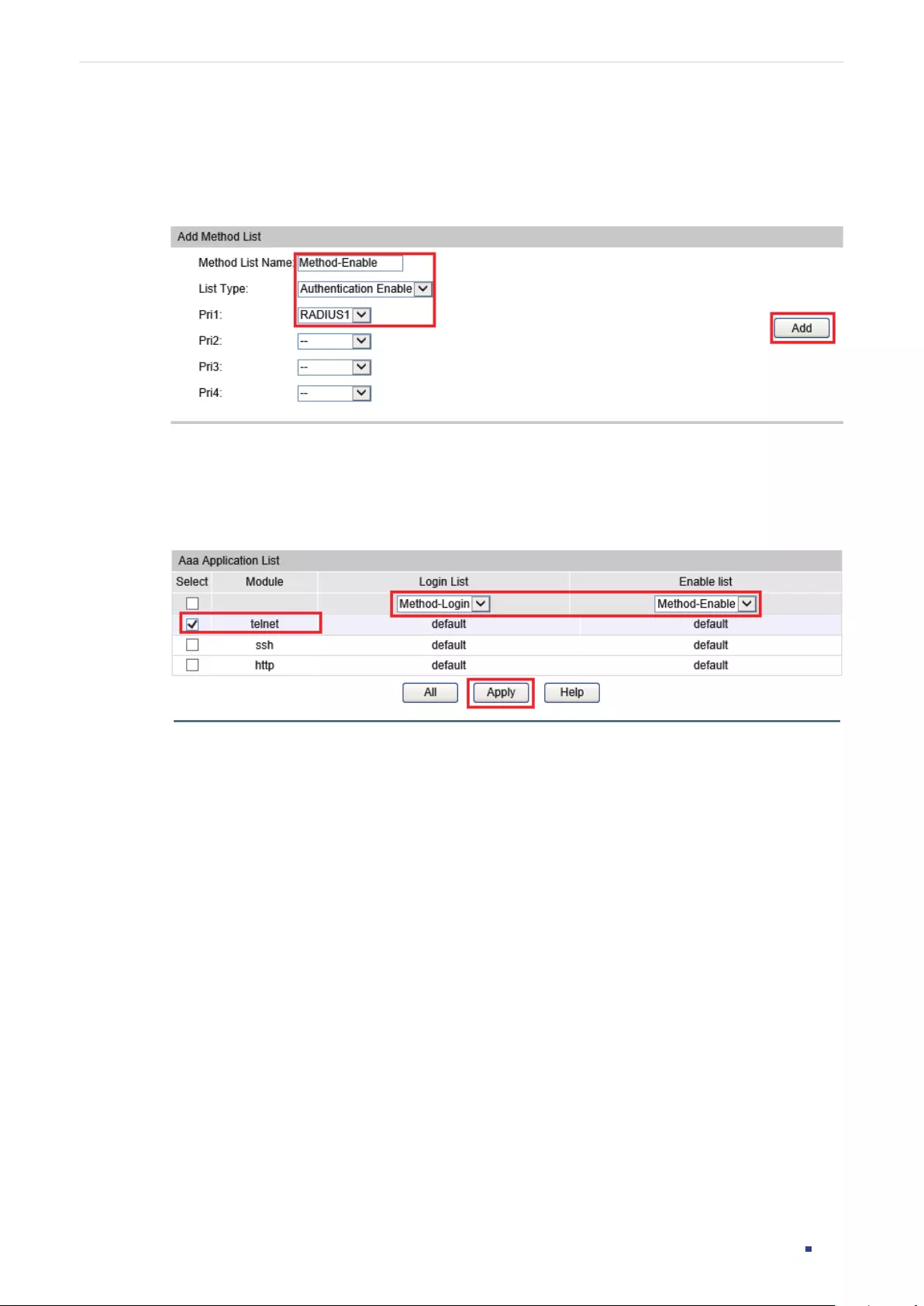
Configuration Guide 838
Configuring Network Security Configuration Examples
7) On the same page, specify the Method List Name as Method-Enable, select the List
Type as Authentication Enable, and select the Pri1 as RADIUS1. Click Add to set the
method list for the Enable password authentication.
Figure 13-23 Configure Enable Method List
8) Choose the menu Network Security > AAA > Global Config to load the following
page. In the AAA Application List section, select telnet and configure the Login List as
Method-Login and Enable List as Method-Enable. Then click Apply.
Figure 13-24 Configure AAA Application List
9) Click Save Config to save the settings.
13.5.4 Using the CLI
1) Enable AAA globally.
Switch#configure
Switch(config)#aaa enable
2) Add RADIUS Server 1 and RADIUS Server 2 on the switch.
Switch(config)#radius-server host 192.168.0.10 auth-port 1812 key 123456
Switch(config)#radius-server host 192.168.0.20 auth-port 1812 key 123456
3) Create a new server group named RADIUS1 and add the two RADIUS servers to the
server group.
Switch(config)#aaa group radius RADIUS1
Switch(aaa-group)#server 192.168.0.10

Configuration Guide 839
Configuring Network Security Configuration Examples
Switch(aaa-group)#server 192.168.0.20
Switch(aaa-group)#exit
4) Create two method lists: Method-Login and Method-Enable, and configure the server
group RADIUS1 as the authentication method for the two method lists.
Switch(config)#aaa authentication login Method-Login RADIUS1
Switch(config)#aaa authentication enable Method-Enable RADIUS1
5) Configure Method-Login and Method-Enable as the authentication method for the
Telnet application.
Switch(config)#line telnet
Switch(config-line)#login authentication Method-Login
Switch(config-line)#enable authentication Method-Enable
Switch(config-line)#end
Switch#copy running-config startup-config
Verify the Configuration
Verify the configuration of the RADIUS servers:
Switch#show radius-server
Server Ip Auth Port Acct Port Timeout Retransmit NAS Identifier Shared key
192.168.0.10 1812 1813 5 2 000AEB132397 123456
192.168.0.20 1812 1813 5 2 000AEB132397 123456
Verify the configuration of server group RADIUS1:
Switch#show aaa group RADIUS1
192.168.0.10
192.168.0.20
Verify the configuration of the method lists:
Switch#show aaa authentication

Configuration Guide 840
Configuring Network Security Configuration Examples
Authentication Login Methodlist:
Methodlist pri1 pri2 pri3 pri4
default local -- -- --
Method-Login RADIUS1 -- -- --
Authentication Enable Methodlist:
Methodlist pri1 pri2 pri3 pri4
default none -- -- --
Method-Enable RADIUS1 -- -- --
......
Verify the status of the AAA feature and the configuration of the AAA application list:
Switch#show aaa global
AAA global status: Enable
Module Login List Enable List
Console default default
Telnet Method-Login Method-Enable
SSH default default
Http default default

Configuration Guide 841
Configuring Network Security Appendix: Default Parameters
14 Appendix: Default Parameters
Default settings of Network Security are listed in the following tables.
Table 14-1 IP-MAC Binding
Parameter Defualt Setting
Protect Type
For Manual Binding: None
For ARP Scanning: None
For DHCP Snooping: All
Table 14-2 IPv6-MAC Binding
Parameter Default Setting
Protect Type
For Manual Binding: None
For ND Snooping: All
For DHCPv6 Snooping: All
Table 14-3 ND Snooping
Parameter Default Setting
ND Snooping Disable
VLAN ID None
Maximum Entry 1024
Table 14-4 DHCP Snooping
Parameter Default Setting
Global Config
DHCP Snooping Disable
VLAN ID Disable
Port Config
Trusted Port Disable
MAC Verify Enable

Configuration Guide 842
Configuring Network Security Appendix: Default Parameters
Parameter Default Setting
Rate Limit Disable
Decline Protect Disable
Option 82 Config
Option 82 Support Disable
Operation Strategy Keep
Option 82 Format Normal
Circuit ID Customization Disable
Circuit ID None
Remote ID Customization Disable
Remote ID None
Table 14-5 DHCPv6 Snooping
Parameter Default Setting
Global Config
DHCPv6 Snooping Disable
VLAN ID Disable
Trusted Port None
Table 14-6 ARP Inspection
Parameter Default Setting
ARP Detect
ARP Detect Disable
Trusted Port None
ARP Defend
Defend Disable
Speed 15 pps
ARP Statistics

Configuration Guide 843
Configuring Network Security Appendix: Default Parameters
Parameter Default Setting
Auto Refresh Disable
Refresh Interval 5 seconds
Table 14-7 ND Detection
Parameter Default Setting
ND Detection Disable
VLAN ID Disable
Trusted Port None
Table 14-8 IP Source Guard
Parameter Default Setting
IPv4 Security Type Disable
IPv6 Security Type Disable
Table 14-9 DoS Defend
Parameter Default Setting
DoS Defend Disable
Table 14-10 802.1X
Parameter Default Setting
Global Config
802.1X Authentication Disable
Auth Method EAP
Handshake Enable
Guest VLAN Disable
Accounting Disable
VLAN Assignment Disable

Configuration Guide 844
Configuring Network Security Appendix: Default Parameters
Parameter Default Setting
Quiet Feature
Quiet Feature Disable
Quiet Period 10 seconds
Retry Times 3
Supplicant Timeout 3 seconds
Port Config
802.1X Status Disable
MAB Disable
Guest VLAN Disable
Control Mode Auto
Control Type MAC Based
Dot1X List
Authentication Dot1x
Method List
List Name: default
Pri1: radius
Accounting Dot1x Method
List
List Name: default
Pri1:radius
Table 14-11 PPPoE ID-Insertion
Parameter Default Setting
Global Config
PPPoE ID-Insertion Disable
Port Config
Circuit-ID Disable
Circuit-ID Type IP
UDF Value None
Remote-ID Disable
Remote-ID Value None

Configuration Guide 845
Configuring Network Security Appendix: Default Parameters
Table 14-12 AAA
Parameter Defualt Setting
Global Config
AAA Disable
RADIUS Config
Server IP None
Shared Key None
Auth Port 1812
Acct Port 1813
Retransmit 2
Timeout 5 seconds
NAS Identifier The MAC address
of the switch.
TACACS+ Config
Server IP None
Timeout 5 seconds
Shared Key None
Port 49
Server Group: There are two default server
groups: radius and tacacs.
Method List
Authentication Login
Method List
List name: default
Pri1: local
Authentication Enable
Method List
List name: default
Pri1: none
AAA Application List
console
Login List: default
Enable List: default

Configuration Guide 846
Configuring Network Security Appendix: Default Parameters
Parameter Defualt Setting
telnet
Login List: default
Enable List: default
ssh
Login List: default
Enable List: default
http
Login List: default
Enable List: default

Configuration Guide 847
Configuring Network Security

Configuring LLDP LLDP
Configuration Guide 849
1 LLDP
1.1 Overview
LLDP (Link Layer Discovery Protocol) is a neighbor discovery protocol that is used for
network devices to advertise information about themselves to other devices on the
network. This protocol is a standard IEEE 802.1ab defined protocol and runs over the
Layer 2 (the data-link layer) , which allows for interoperability between network devices of
different vendors.
With the LLDP feature, network administrators can get the managed network devices’
information from the switch or the NMS (Network Management System), which can
help them know about the network topology, examine the network connectivity and
troubleshoot the network faults.
LLDP-MED (Media Endpoint Discovery) is an extension of LLDP that is used to advertise
information between network devices and media endpoints. It is specially used together
with Voice VLAN to allow VoIP (Voice over Internet Protocol) device to access the network.
VoIP devices can use LLDP-MED for auto-configuration to minimize the configuration
effort.
1.2 Supported Features
The switch supports LLDP and LLDP-MED.
LLDP allows the local device to encapsulate its management address, device ID, interface
ID and other information into a LLDPDU (Link Layer Discovery Protocol Data Unit) and
periodically advertise this LLDPDU to its neighbor devices on the network. The neighbors
store the received LLDPDU in a standard MIB (Management Information Base), making
it possible for the information to be accessed by a Network Management System (NMS)
using a management protocol such as the Simple Network Management Protocol (SNMP).
LLDP-MED allows the network device to send its information including Voice VLAN
information, PoE (Power over Ethernet) capacity and etc. to the media endpoint devices
for auto-configuration. The media endpoint devices (IP phones) receive the Voice VLAN
information and finish the auto-configuration, then send the voice traffic carrying VLAN
tag, which can provide preferential treatment to the voice traffic in the Voice VLAN.
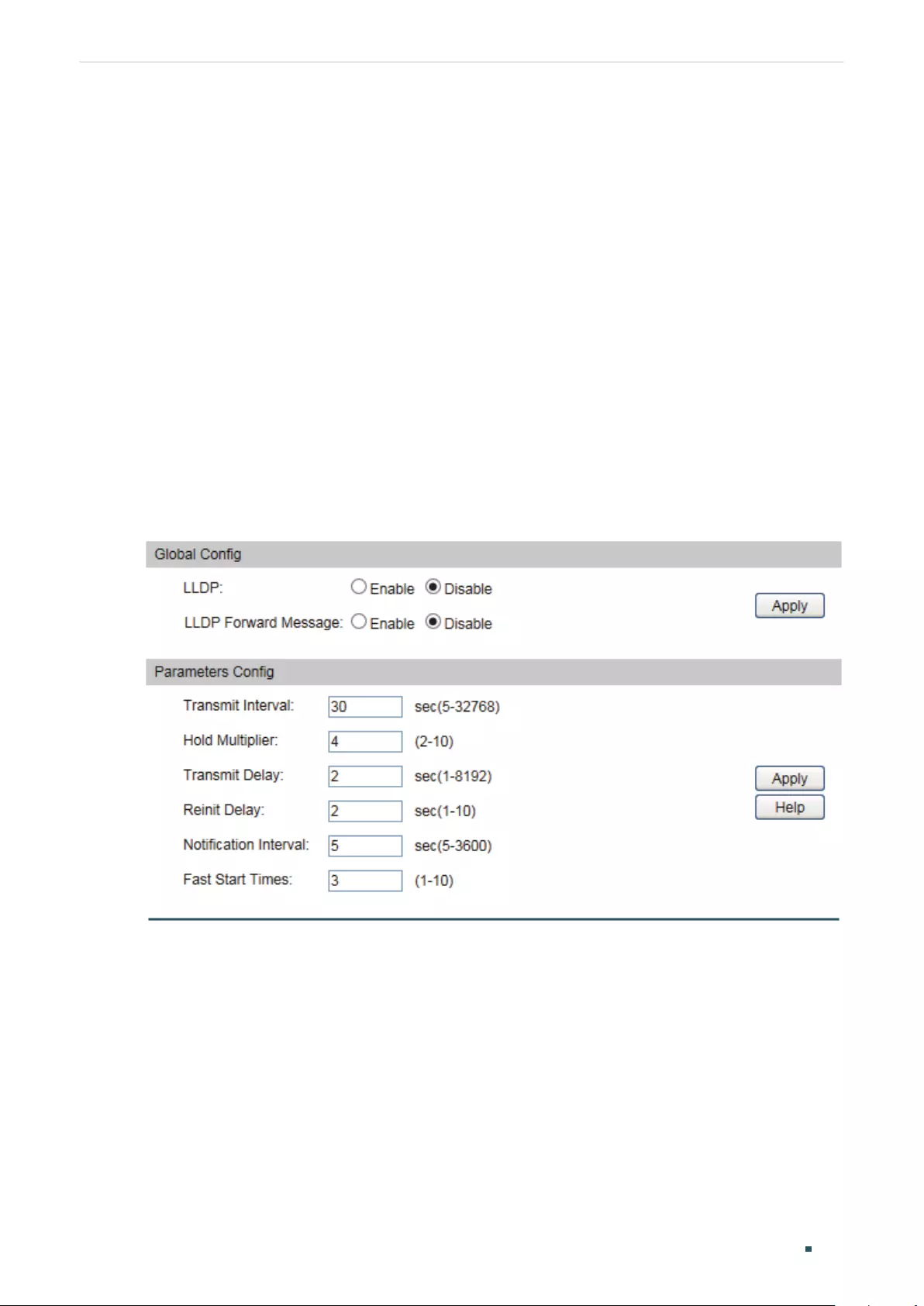
Configuration Guide 850
Configuring LLDP LLDP Configurations
2 LLDP Configurations
With LLDP configurations, you can:
1) Enable the LLDP feature on the switch.
2) (Optional) Configure the LLDP feature globally.
3) (Optional) Configure the LLDP feature for the interface.
2.1 Using the GUI
2.1.1 Global Config
Choose the LLDP > Basic Config > Global Config to load the following page.
Figure 2-1 Global Config

Configuring LLDP LLDP Configurations
Configuration Guide 851
Follow these steps to enable LLDP and configure the LLDP feature globally.
1) In the Global Config section, enable LLDP. You can also enable the switch to forward
LLDP messages when LLDP function is disabled. Click Apply.
LLDP Enable or disable LLDP function globally.
LLDP Forward
Message
Enable or disable the switch to forward LLDP messages when LLDP function is
disabled.
3) In the Parameters Config section, configure the LLDP parameters. Click Apply.
Transmit
Interval
Enter the interval between successive LLDP packets that are periodically sent
from the local device to its neighbors. The default is 30 seconds.
Hold Multiplier Specify the amount of time the neighbor device should hold the received
information before discarding it. The default is 4.
TTL (Time to Live) = Hold Multiplier * Transmit Interval.
Transmit Delay Specify the amount of time that the local device waits before sending another
LLDP packet to its neighbors. When the local information changes, the local
device will send LLDP packets to inform its neighbors. If frequent changes occur
to the local device, LLDP packets will flood. After specifying a transmit delay time,
the local device will wait for a delay time to send LLDP packets when changes
occur to avoid frequent LLDP packet forwarding. The default is 2 seconds.
Reinit Delay Specify the delay time that the local port waits before changing its Admin Status.
When a local port’s Admin Status changes, the local device will send Trap
messages. After specifying a reinit delay time, the local device will wait for a delay
time to send Trap messages to avoid frequent Trap forwarding. The default is 2
seconds.
Notification
Interval
Enter the interval between successive Trap messages that are periodically sent
from the local device to the NMS. The default is 5 seconds.
Fast Start Times Specify the number of LLDP packets that the local port sends when its Admin
Status changes from Disable (or Rx_Only) to Tx&RX (or Tx_Only). The default is 3.
In this case, the local device will shorten the Transmit Interval of LLDP packets
to 1 second to make it quickly discovered by its neighbors. After the specified
number of LLDP packets are sent, the Transmit Interval will be restored to the
specified value.
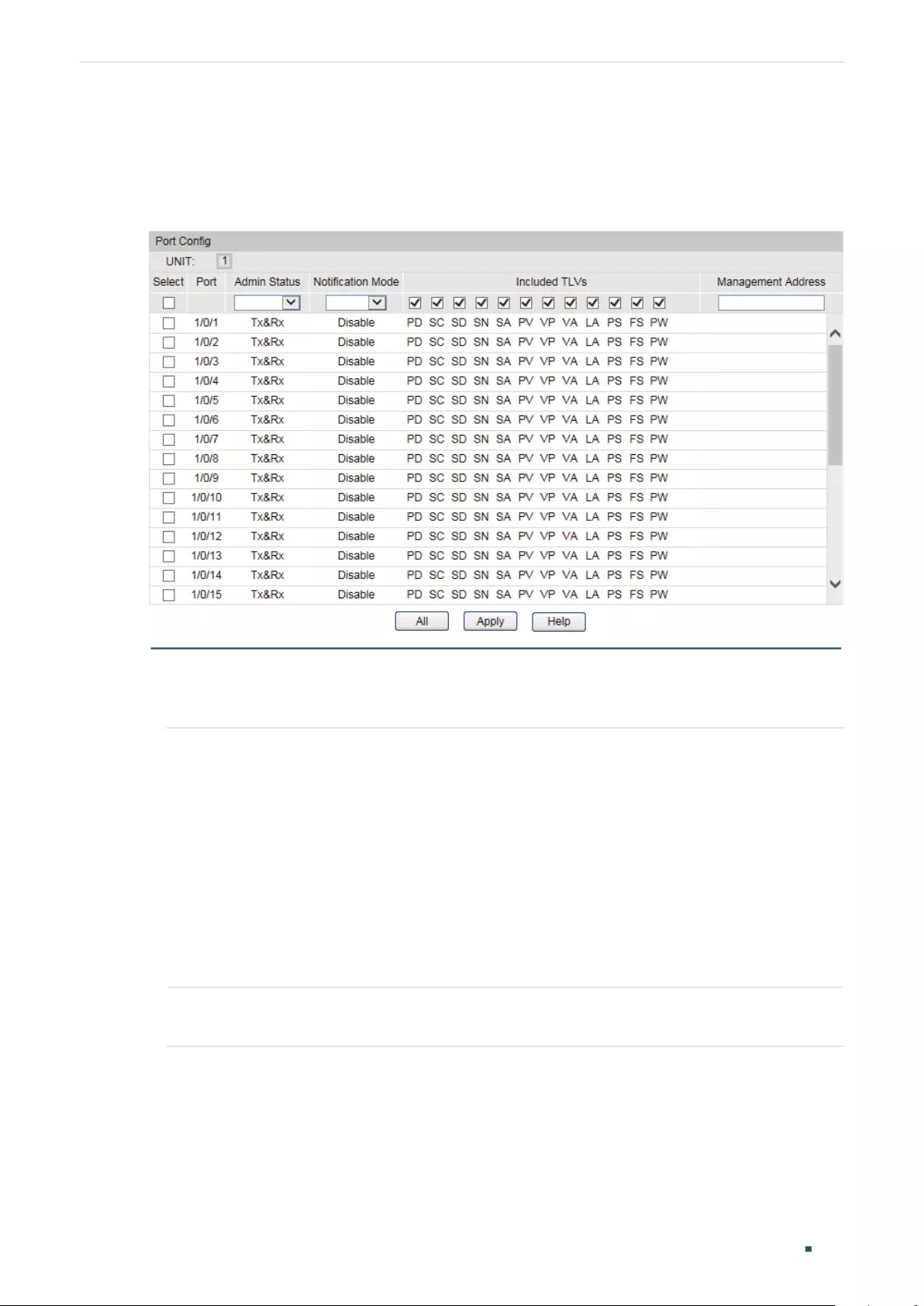
Configuration Guide 852
Configuring LLDP LLDP Configurations
2.1.2 Port Config
Choose th menu LLDP > Basic Config > Policy Config to load the following page.
Figure 2-2 Port Config
Follow these steps to configure the LLDP feature for the interface.
1) Select the desired port and set its Admin Status and Notification Mode.
Admin Status Set Admin Status for the port to deal with LLDP packets.
Tx&Rx: The port will transmit LLDP packets and process the received LLDP
packets.
Rx_Only: The port will only process the received LLDP packets but not transmit
LLDP packets.
Tx_Only: The port will only transmit LLDP packets but not process the received
LLDP packets.
Disable: The port will not transmitLLDP packets or process the received LLDP
packets.
Notification
Mode
Select whether to enable SNMP on the port. If it is enabled, the local device will
send Trap messages to inform the NMS when the local information changes.
2) Select the TLVs (Type/Length/Value) included in the LLDP packets according to your
needs.

Configuring LLDP LLDP Configurations
Configuration Guide 853
Included TLVs Configure the TLVs included in the outgoing LLDP packets.
TP-Link supports the following TLVs:
PD: Used to advertise the port description defined by the IEEE 802 LAN station.
SC: Used to advertise the supported functions and whether or not these functions
are enabled.
SD: Used to advertise the system’s description including the full name and version
identification of the system’s hardware type, software operating system, and
networking software.
SN: Used to advertise the system name.
SA: Used to advertise the local device’s management address to make it possible
to be managed by SNMP.
PV: Used to advertise the 802.1Q VLAN ID of the port.
VP: Used to advertise the protocol VLAN ID of the port.
VA: Used to advertise the name of the VLAN which the port is in.
LA: Used to advertise whether the link is capable of being aggregated, whether
the link is currently in an aggregation, and the port ID when it is in an aggregation.
PS: Used to advertise the port’s attributes including the duplex and bit-rate
capability of the sending IEEE 802.3 LAN node that is connected to the physical
medium, the current duplex and bit-rate settings of the sending IEEE 802.3 LAN
node and whether these settings are the result of auto-negotiation during link
initiation or of manual set override action.
FS: Used to advertise the maximum frame size capability of the implemented MAC
and PHY.
PW: Used to advertise the port’s PoE (Power over Ethernet) support capabilities.
3) Optional. Configure the port's management address for identifying the devices.
2.2 Using the CLI
2.2.1 Global Config
Enable the LLDP feature on the switch and configure the LLDP parameters.
Step 1 configure
Enter global configuration mode.
Step 2 lldp
Enable the LLDP feature on the switch.

Configuration Guide 854
Configuring LLDP LLDP Configurations
Step 3 lldp forward_message
(Optional) Enable the switch to forward LLDP messages when LLDP function is disabled.
Step 4 lldp hold-multiplier
(Optional) Specify the amount of time the neighbor device should hold the received
information before discarding it. The default is 4.
TTL (Time to Live) = Hold Multiplier * Transmit Interval.
Step 5 lldp timer { tx-interval
tx-interval
| tx-delay
tx-delay
| reinit-delay
reinit-delay
| notify-
interval
notify-interval
| fast-count
fast-count
}
(Optional) Configure the timers for LLDP packet forwarding.
tx-interval:
Enter the interval between successive LLDP packets that are periodically sent
from the local device to its neighbors.
tx-delay:
Specify the amount of time that the local device waits before sending another
LLDP packet to its neighbors. The default is 2 seconds.
reinit-delay:
Specify the amount of time that the local device waits before sending another
LLDP packet to its neighbors. The default is 2 seconds.
notify-interval:
Enter the interval between successive Trap messages that are periodically
sent from the local device to the NMS. The default is 5 seconds.
fast-count:
Specify the number of packets that the local port sends when its Admin Status
changes. The default is 3.
Step 6 show lldp
Display the LLDP information.
Step 7 end
Return to Privileged EXEC Mode.
Step 8 copy running-config startup-config
Save the settings in the configuration file.
The following example shows how to configure the following parameters, lldp timer=4,
tx-interval=30 seconds, tx-delay=2 seconds, reinit-delay=3 seconds, notify-iInterval=5
seconds, fast-count=3.
Switch#congure
Switch(cong)#lldp
Switch(cong)#lldp hold-multiplier 4
Switch(cong)#lldp timer tx-interval 30 tx-delay 2 reinit-delay 3 notify-interval 5 fast-
count 3
Switch(cong)#show lldp
LLDP Status: Enabled

Configuring LLDP LLDP Configurations
Configuration Guide 855
LLDP Forward Message: Disabled
Tx Interval: 30 seconds
TTL Multiplier: 4
Tx Delay: 2 seconds
Initialization Delay: 2 seconds
Trap Notification Interval: 5 seconds
Fast-packet Count: 3
LLDP-MED Fast Start Repeat Count: 4
Switch(cong)#end
Switch#copy running-cong startup-cong
2.2.2 Port Config
Select the desired port and set its Admin Status, Notification Mode and the TLVs included
in the LLDP packets.
Step 1 configure
Enter global configuration mode.
Step 2 interface {fastEthernet
port
| range fastEthernet
port-list
| gigabitEthernet
port
| range
gigabitEthernet
port-list
| ten-gigabitEthernet
port
| range ten-gigabitEthernet
port-list
]
Enter interface configuration mode.
Step 3 lldp receive
(Optional) Set the mode for the port to receive LLDP packets. It is enabled by default.
Step 4 lldp transmit
(Optional) Set the mode for the port to send LLDP packets. It is enabled by default.
Step 5 lldp snmp-trap
(Optional) Enable the Notification Mode feature on the port. If it is enabled, the local device
will send Trap messages to inform the SNMP server when local information changes. It is
disabled by default.
Step 6 lldp tlv-select
(Optional) Configure the TLVs included in the outgoing LLDP packets. By default, the
outgoing LLDP packets include all TLVs.
Step 7 lldp management-address {
ip-address
}
Optional. Specify the port’s management IP address. The NMS uses management
addresses to identify the devices.

Configuration Guide 856
Configuring LLDP LLDP Configurations
Step 8 show lldp interface { fastEthernet
port
| gigabitEthernet
port
| ten-gigabitEthernet
port
}
Display LLDP configuration of the corresponding port.
Step 9 end
Return to Privileged EXEC Mode.
Step 10 copy running-config startup-config
Save the settings in the configuration file.
The following example shows how to configure the port 1/0/1. The port can receive and
transmit LLDP packets, its notification mode is enabled and the outgoing LLDP packets
include all TLVs.
Switch#configure
Switch(config)#lldp
Switch(config)#interface gigabitEthernet 1/0/1
Switch(config-if)#lldp receive
Switch(config-if)#lldp transmit
Switch(config-if)#lldp snmp-trap
Switch(config-if)#lldp tlv-select all
Switch(config-if)#show lldp interface gigabitEthernet 1/0/1
LLDP interface config:
gigabitEthernet 1/0/1:
Admin Status: TxRx
SNMP Trap: Enabled
TLV Status
--- ------
Port-Description Yes
System-Capability Yes
System-Description Yes
System-Name Yes
Management-Address Yes
Port-VLAN-ID Yes
Protocol-VLAN-ID Yes
VLAN-Name Yes

Configuring LLDP LLDP Configurations
Configuration Guide 857
Link-Aggregation Yes
MAC-Physic Yes
Max-Frame-Size Yes
Power Yes
Switch(config-if)#end
Switch#copy running-config startup-config
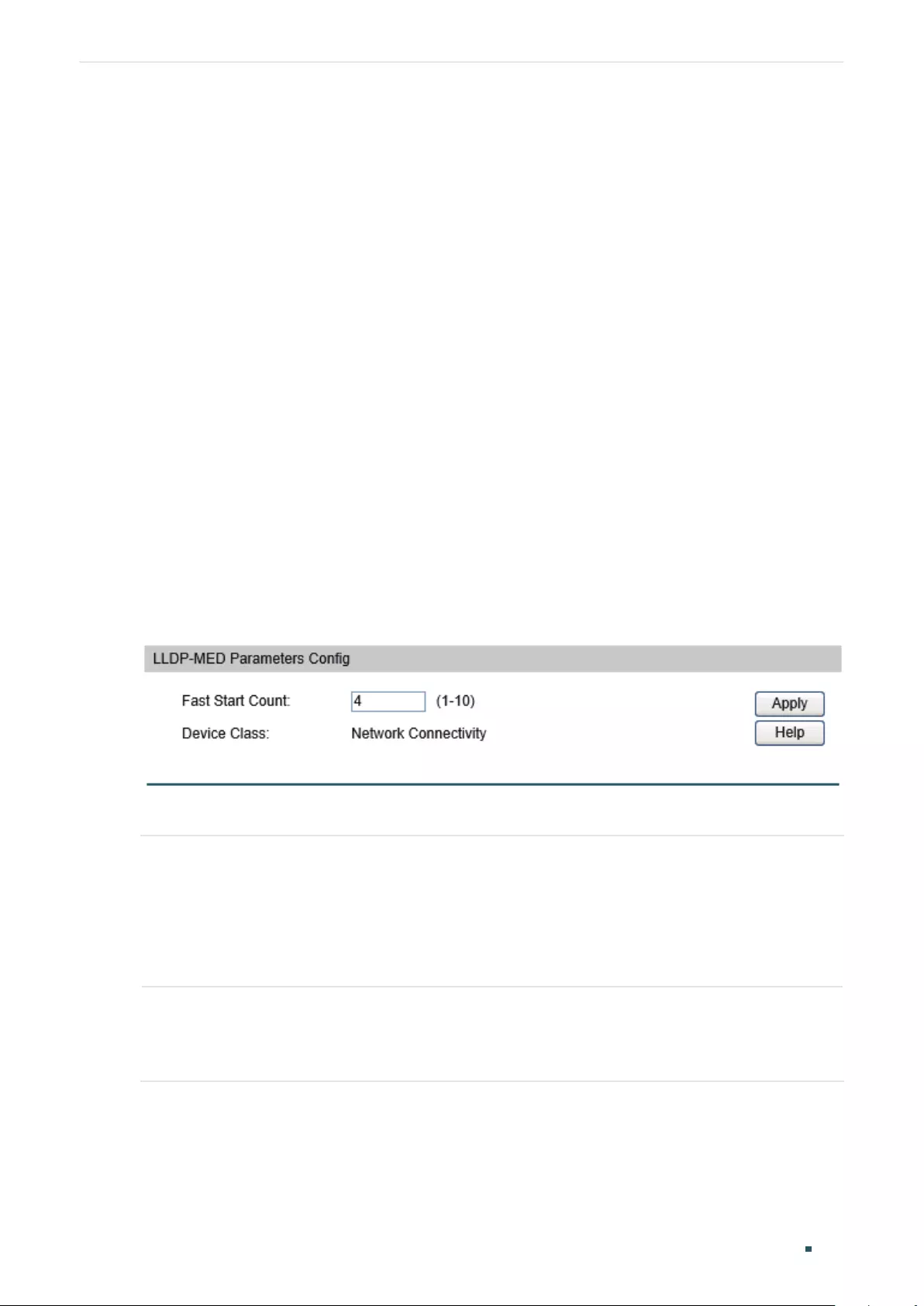
Configuration Guide 858
Configuring LLDP LLDP-MED Configurations
3 LLDP-MED Configurations
With LLDP-MED configurations, you can:
1) Configure the LLDP-MED feature globally.
2) Enable and configure the LLDP-MED feature on the interface.
Configuration Guidelines
LLDP-MED is used together with Voice VLAN to implement VoIP access. Besides the
configuration of LLDP-MED feature, you also need configure the Voice VLAN feature. Refer
to Configuring Voice VLAN for detailed instructions.
3.1 Using the GUI
3.1.1 Global Config
Choose the LLDP > LLDP-MED> Global Config to load the following page.
Figure 3-1 LLDP-MED Parameters Config
Configure the Fast Start Count and view the current device class. Click Apply.
Fast Start Count Specify the number of successive LLDP-MED frames that the local device sends
when fast start mechanism is activated. The default is 4.
If the LLDP-MED status on the port is changed from Disable to Enable, the fast start
mechanism will be activated, and the local device will send the specified number of
LLDP packets carrying LLDP-MED information. After that, the Transmit Interval will be
restored to the specified value.
Device Class Display the current device class.
LLDP-MED defines two device classes, Network Connectivity Device and Endpoint
Device. The switch is a Network Connectivity device.
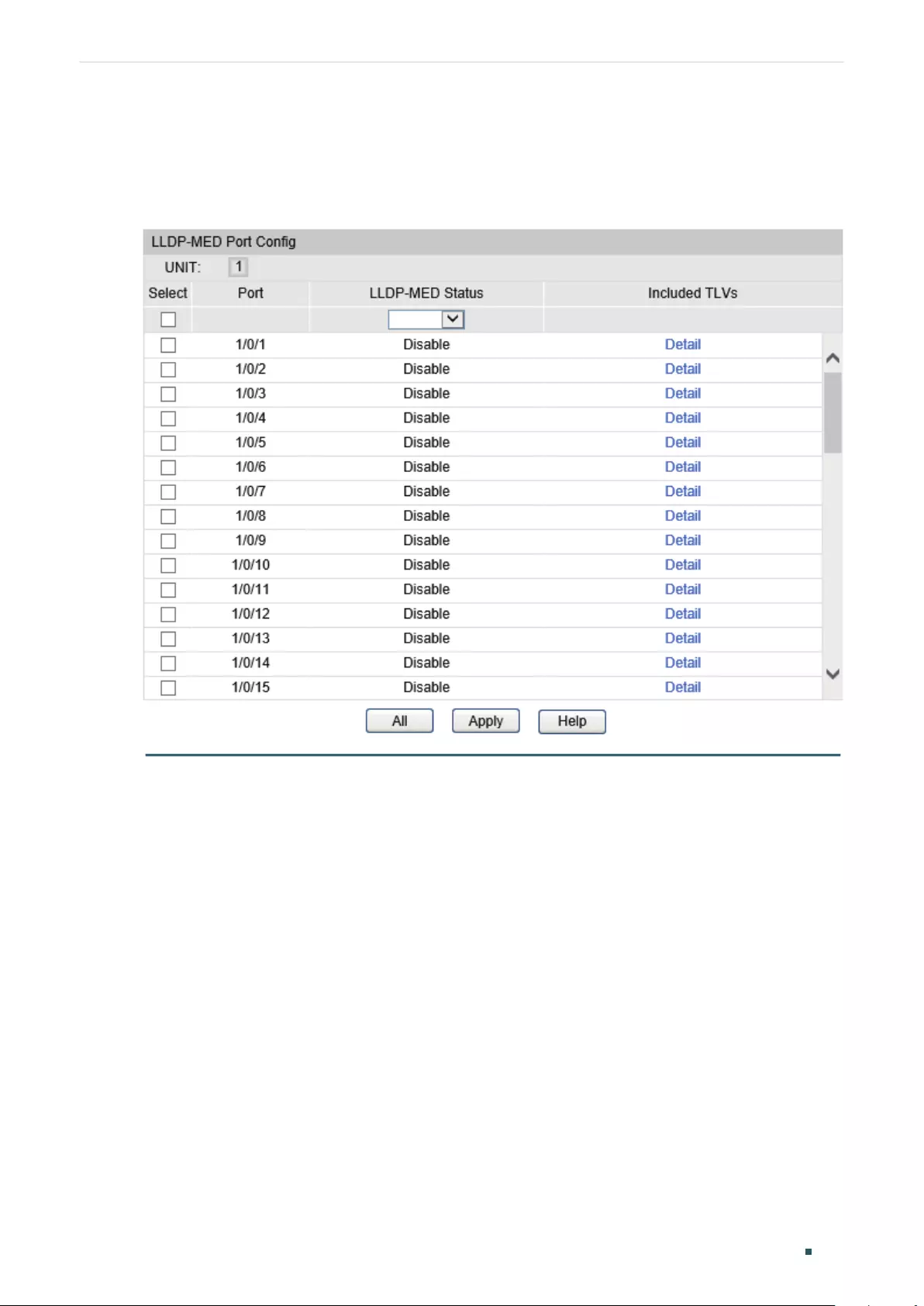
Configuring LLDP LLDP-MED Configurations
Configuration Guide 859
3.1.2 Port Config
Choose th menu LLDP > LLDP-MED > Policy Config to load the following page.
Figure 3-2 LLDP-MED Port Config
Follow these steps to enable LLDP-MED:
1) Select the desired port and enble LLDP-MED. Click Apply.
2) Click Detail to enter the following page. Configure the TLVs included in the outgoing
LLDP packets. If Location Identification is selected, you need configure the Emergency
Number or select Civic Address to configure the details. Click Apply.

Configuration Guide 860
Configuring LLDP LLDP-MED Configurations
Figure 3-3 LLDP-MED Port Config-Detail
Network Policy Used to advertise VLAN configuration and the associated Layer 2 and Layer 3
attributes of the port to the Endpoint devices.
Location
Identification
Used to assign the location identifier information to the Endpoint devices.
If this option is selected, you can configure the emergency number or the detailed
address of the Endpoint device in the Location Identification Parameters section.
Extended
Power-Via-MDI
Used to advertise the detailed PoE information including power supply priority and
supply status between LLDP-MED Endpoint devices and Network Connectivity
devices.
Inventory Used to advertise the inventory information. The Inventory TLV set contains
seven basic Inventory management TLVs, that is, Hardware Revision TLV,
Firmware Revision TLV, Software Revision TLV, Serial Number TLV, Manufacturer
Name TLV, Model Name TLV and Asset ID TLV.
Emergency
Number
Configure the emergency number to call CAMA or PSAP. The number should
contain 10-25 characters.

Configuring LLDP LLDP-MED Configurations
Configuration Guide 861
Civic Address Configure the address of the audio device in the IETF defined address format.
What: Specify the role type of the local device, DHCP Server, Switch or LLDP-MED
Endpoint.
Country Code: Enter the country code defined by ISO 3166 , for example, CN, US.
Language, Province/State etc.: Enter the regular details.
3.2 Using the CLI
3.2.1 Global Config
Step 1 configure
Enter global configuration mode.
Step 2 lldp
Enable the LLDP feature on the switch.
Step 3 lldp med-fast-count
count
(Optional) Specify the number of successive LLDP-MED frames that the local device
sends when fast start mechanism is activated. When the fast start mechanism is activated,
the local device will send the specified number of LLDP packets carrying LLDP-MED
information.
count:
The valid value are from 1 to 10. The default is 4.
Step 4 show lldp
Display the LLDP information.
Step 5 end
Return to Privileged EXEC Mode.
Step 6 copy running-config startup-config
Save the settings in the configuration file.
The following example shows how to configure LLDP-MED fast count as 4:
Switch#configure
Switch(config)#lldp
Switch(config)#lldp med-fast-count 4
Switch(config)#show lldp
LLDP Status: Enabled
Tx Interval: 30 seconds

Configuration Guide 862
Configuring LLDP LLDP-MED Configurations
TTL Multiplier: 4
Tx Delay: 2 seconds
Initialization Delay: 2 seconds
Trap Notification Interval: 5 seconds
Fast-packet Count: 3
LLDP-MED Fast Start Repeat Count: 4
Switch(config)#end
Switch#copy running-config startup-config
3.2.2 Port Config
Select the desired port, enable LLDP-MED and select the TLVs (Type/Length/Value)
included in the outgoing LLDP packets according to your needs.
Step 1 configure
Enter global configuration mode.
Step 2 interface {fastEthernet
port
| range fastEthernet
port-list
| gigabitEthernet
port
| range
gigabitEthernet
port-list
| ten-gigabitEthernet
port
| range ten-gigabitEthernet
port-list
]
Enter interface configuration mode.
Step 3 lldp med-status
(Optional) Enable the LLDP-MED on the port. It is disabled by default.
Step 4 lldp med-tlv-select { [ inventory-management] [location] [network-policy]
[power-management] [all ] }
(Optional) Configure the LLDP-MED TLVs included in the outgoing LLDP packets. By default,
the outgoing LLDP packets include all TLVs.
If LLDP-MED Location TLV is selected, configure the parameters as follows:
lldp med-location {emergency-number
identifier
| civic-address [language
language
|
province-state
province-state
| lci-county-name
county
| lci-city
city
| street
street
| house-
number
house-number
| name
name
| postal-zipcode
postal-zipcode
| room-number
room-
number
| post-office-box
post-office-box
| additional
additional
| country-code
country-
code
| what { dhcp-server | endpoint | switch } ] }
Configure the LLDP-MED Location TLV included in the outgoing LLDP packets. Used to
assign the location identifier information to the Endpoint devices.
identifier:
Configure the emergency number to call CAMA or PSAP. The number should
contain 10-25 characters.
language,province-state,county.etc:
Configure the address in the IETF defined address
format.
Step 5 show lldp interface { fastEthernet
port
| gigabitEthernet
port
| ten-gigabitEthernet
port
}
Display LLDP configuration of the corresponding port.

Configuring LLDP LLDP-MED Configurations
Configuration Guide 863
Step 6 end
Return to Privileged EXEC Mode.
Step 7 copy running-config startup-config
Save the settings in the configuration file.
The following example shows how to enable LLDP-MED on port 1/0/1, configure the LLDP-
MED TLVs included in the outgoing LLDP packets.
Switch(config)#lldp
Switch(config)#lldp med-fast-count 4
Switch(config)#interface gigabitEthernet 1/0/1
Switch(config-if)#lldp med-status
Switch(config-if)#lldp med-tlv-select all
Switch(config-if)#show lldp interface gigabitEthernet 1/0/1
LLDP interface config:
gigabitEthernet 1/0/1:
Admin Status: TxRx
SNMP Trap: Enabled
TLV Status
--- ------
Port-Description Yes
System-Capability Yes
System-Description Yes
System-Name Yes
Management-Address Yes
Port-VLAN-ID Yes
Protocol-VLAN-ID Yes
VLAN-Name Yes
Link-Aggregation Yes
MAC-Physic Yes
Max-Frame-Size Yes
Power Yes

Configuration Guide 864
Configuring LLDP LLDP-MED Configurations
LLDP-MED Status: Enabled
TLV Status
--- ------
Network Policy Yes
Location Identification Yes
Extended Power Via MDI Yes
Inventory Management Yes
Switch(config)#end
Switch#copy running-config startup-config
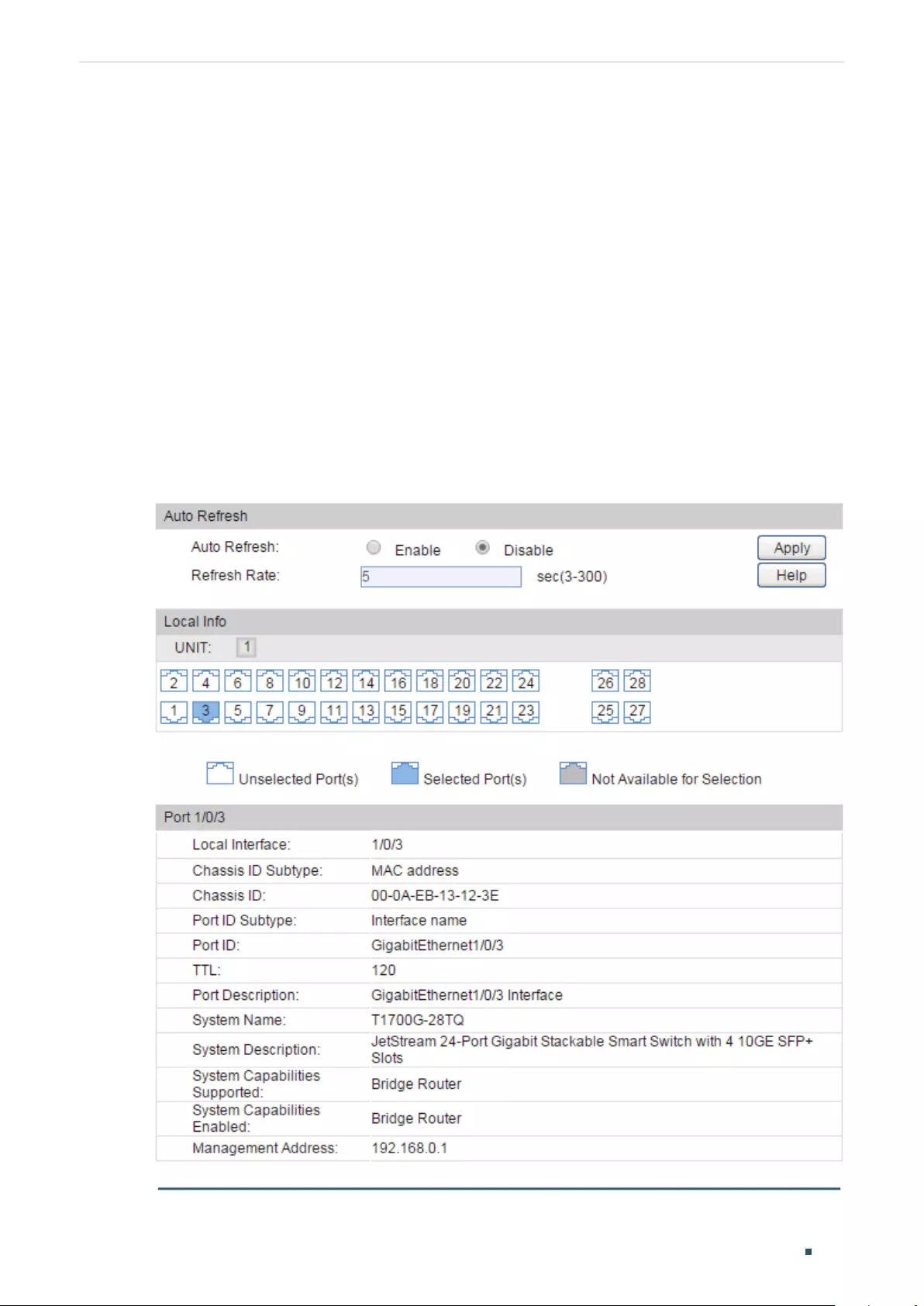
Configuring LLDP Viewing LLDP Settings
Configuration Guide 865
4 Viewing LLDP Settings
This chapter introduces how to view the LLDP settings on the local device.
4.1 Using GUI
4.1.1 Viewing LLDP Device Info
Viewing the Local Info
Choose the menu LLDP > Device Info > Local Info to load the following page.
Figure 4-1 Local Info

Configuration Guide 866
Configuring LLDP Viewing LLDP Settings
Follow these steps to view the local information:
1) In the Auto Refresh section, enable the Auto Refresh feature and set the Refresh Rate
according to your needs. Click Apply.
2) In the Local Info section, select the desired port and view its associated local device
information.
Local Interface Displays the local port ID.
Chassis ID
Subtype
Displays the Chassis ID type.
Chassis ID Displays the value of the Chassis ID.
Port ID Subtype Displays the Port ID type.
Port ID Displays the value of the Port ID.
TTL Specify the amount of time the neighbor device should hold the received
information before discarding it.
Port Description Displays the description of the local port.
System Name Displays the system name of the local device.
System
Description
Displays the system description of the local device.
System
Capabilities
Supported
Displays the supported capabilities of the local system.
System
Capabilities
Enabled
Displays the primary functions of the local device.
Management
Address
Displays the management address of the local device.

Configuring LLDP Viewing LLDP Settings
Configuration Guide 867
Viewing the Neighbor Info
Choose the menu LLDP > Device Info > Neighbor Info to load the following page.
Figure 4-2 Neighbor Info
Follow these steps to view the neighbor information:
1) In the Auto Refresh section, enable the Auto Refresh feature and set the Refresh Rate
according to your needs. Click Apply.
2) In the Local Info section, select the desired port and view its associated neighbor
device information.
System Name Displays the system name of the neighbor device.
Chassis ID Displays the Chassis ID of the neighbor device.
System
Description
Displays the system description of the neighbor device.
Neighbor Port Displays the port ID of the neighbor device which is connected to the local port.
Information Click to view the details of the neighbor device.
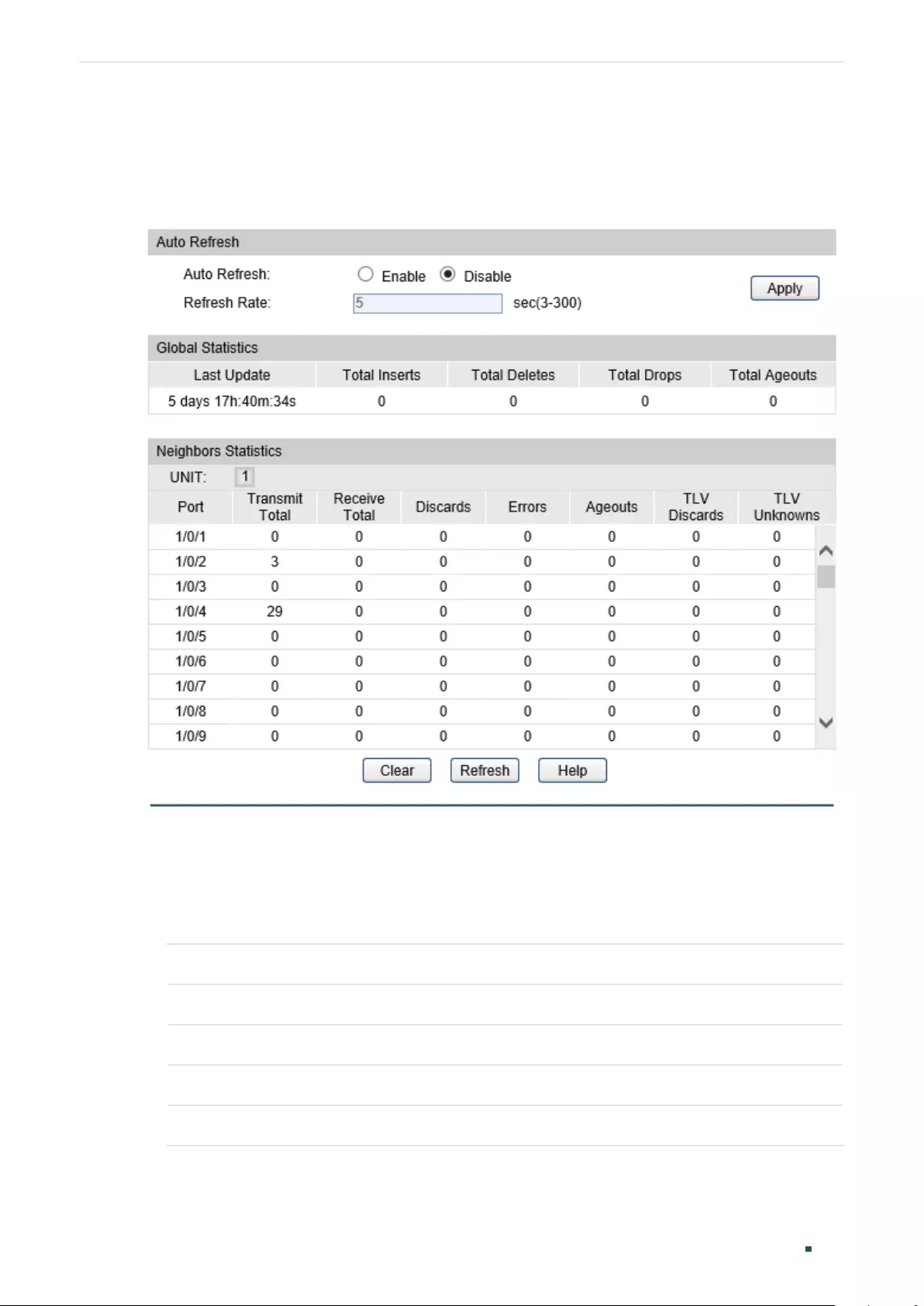
Configuration Guide 868
Configuring LLDP Viewing LLDP Settings
4.1.2 Viewing LLDP Statistics
Choose the menu LLDP > Device Statistics > Statistics Info to load the following page.
Figure 4-3 Static Info
Follow these steps to view LLDP statistics:
1) In the Auto Refresh section, enable the Auto Refresh feature and set the Refresh Rate
according to your needs. Click Apply.
2) In the Global Statistics section, view the global statistics of the local device.
Last Update Displays the time when the statistics updated.
Total Inserts Displays the latest number of neighbors the local device has created.
Total Deletes Displays the latest number of neighbors the local device has removed.
Total Drops Displays the latest number of neighbors the local device has discarded.
Total Ageouts Displays the latest number of neighbors that have aged out on the local device.
3) In the Neighbors Statistics section, view the statistics of the corresponding port.

Configuring LLDP Viewing LLDP Settings
Configuration Guide 869
Transmit Total Displays the total number of the LLDP packets sent via the port.
Receive Total Displays the total number of the LLDP packets received via the port.
Discards Displays the total number of the LLDP packets discarded by the port.
Errors Displays the total number of the error LLDP packets received via the port.
Ageouts Displays the number of the aged out neighbors that are connected to the port.
TLV Discards Displays the total number of the TLVs discarded by the port when receiving LLDP
packets.
TLV Unknowns Displays the total number of the unknown TLVs included in the received LLDP
packets.
4.2 Using CLI
Viewing the Local Info
show lldp local-information interface { fastEthernet
port
| gigabitEthernet
port
| ten-gigabitEthernet
port
}
View the LLDP details of a specific port or all the ports on the local device.
Viewing the Neighbor Info
show lldp neighbor-information interface { fastEthernet
port
| gigabitEthernet
port
| ten gigabitEthernet
port
}
Display the information of the neighbor device which is connected to the port.
Viewing LLDP Statistics
show lldp traffic interface { fastEthernet
port
| gigabitEthernet
port
| tengigabitEthernet
port
}
View the statistics of the corresponding port on the local device.
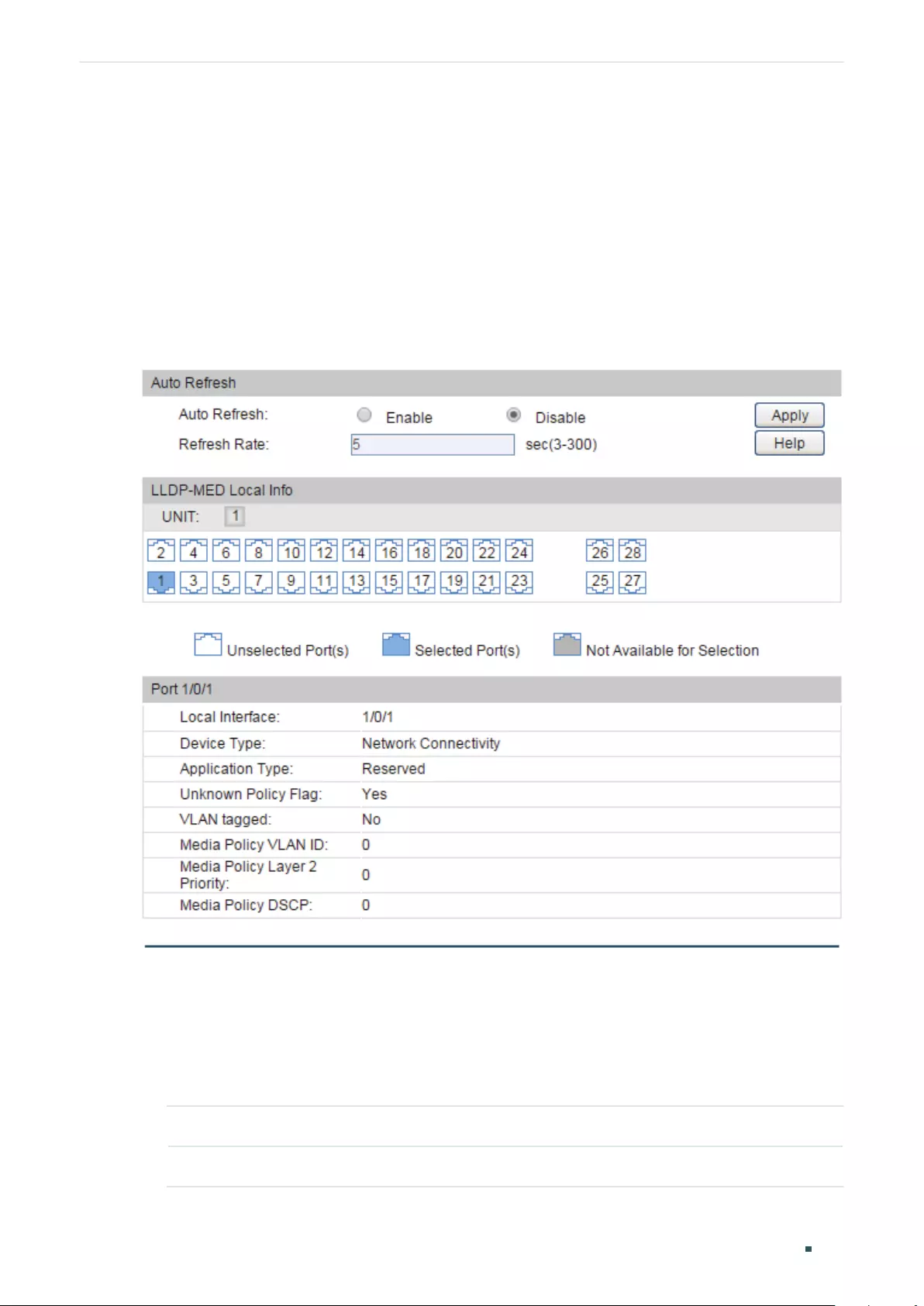
Configuration Guide 870
Configuring LLDP Viewing LLDP-MED Settings
5 Viewing LLDP-MED Settings
5.1 Using GUI
Viewing the Local Info
Figure 5-1 LLDP-MED Local Info
Follow these steps to view LLDP-MED local information:
1) In the Auto Refresh section, enable the Auto Refresh feature and set the Refresh Rate
according to your needs. Click Apply.
2) In the LLDP-MED Local Info section, select the desired port and view the LLDP-MED
settings.
Local Interface Displays the local port ID.
Device Type Displays the local device type defined by LLDP-MED.LLDP-MED.
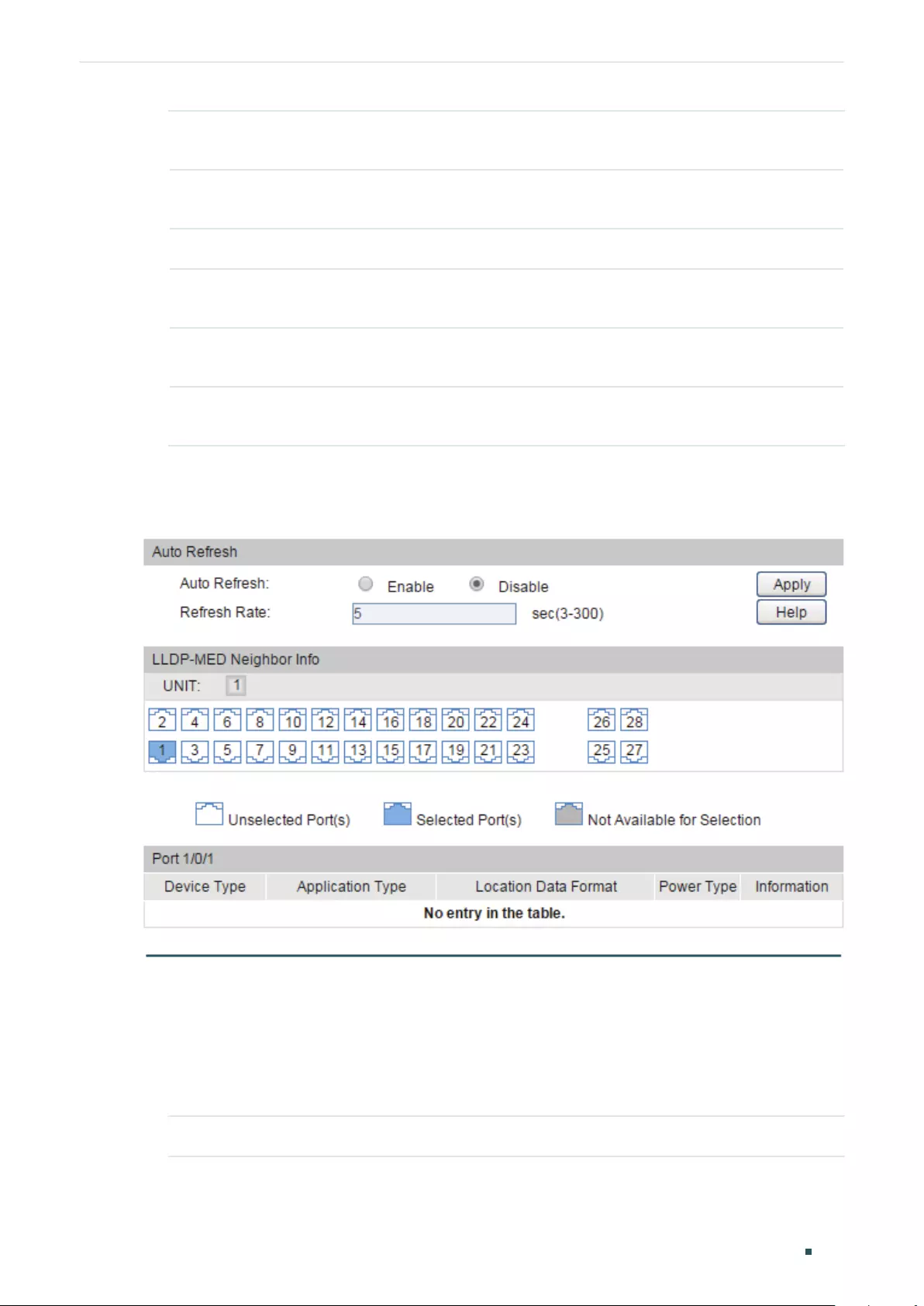
Configuring LLDP Viewing LLDP-MED Settings
Configuration Guide 871
Application
Type
Displays the supported applications of the local device.
Unknown Policy
Flag
Displays the unknown location settings included in the network policy TLV.
VLAN tagged Displays the VLAN Tag type of the applications, tagged or untagged.
Media Policy
VLAN ID
Displays the 802.1Q VLAN ID of the port.
Media Policy
Layer 2 Priority
Displays the Layer 2 priority used in the specific application.
Media Policy
DSCP
Displays the DSCP value used in the specific application.
Viewing the Neighbor Info
Figure 5-2 LLDP-MED Neighbor Info
Follow these steps to view LLDP-MED neighgbor information:
1) In the Auto Refresh section, enable the Auto Refresh feature and set the Refresh Rate
according to your needs. Click Apply.
2) In the LLDP-MED Neighbor Info section, select the desired port and view the LLDP-
MED settings.
Device Type Displays the LLDP-MED device type of the neighbor device.

Configuration Guide 872
Configuring LLDP Viewing LLDP-MED Settings
Application
Type
Displays the application type of the neighbor device.
Location Data
Format
Displays the location type of the neighbor device.
Power Type Displays the power type of the neighbor device.
Information View more LLDP-MED details of the neighbor device.
5.2 Using CLI
Viewing the Local Info
show lldp local-information interface { fastEthernet
port
| gigabitEthernet
port
| ten-gigabitEthernet
port
}
View the LLDP details of a specific port or all the ports on the local device.
Viewing the Neighbor Info
show lldp neighbor-information interface { fastEthernet
port
| gigabitEthernet
port
| ten-gigabitEthernet
port
}
Display the information of the neighbor device which is connected to the port.
Viewing LLDP Statistics
show lldp traffic interface { fastEthernet
port
| gigabitEthernet
port
| tengigabitEthernet
port
}
View the statistics of the corresponding port.
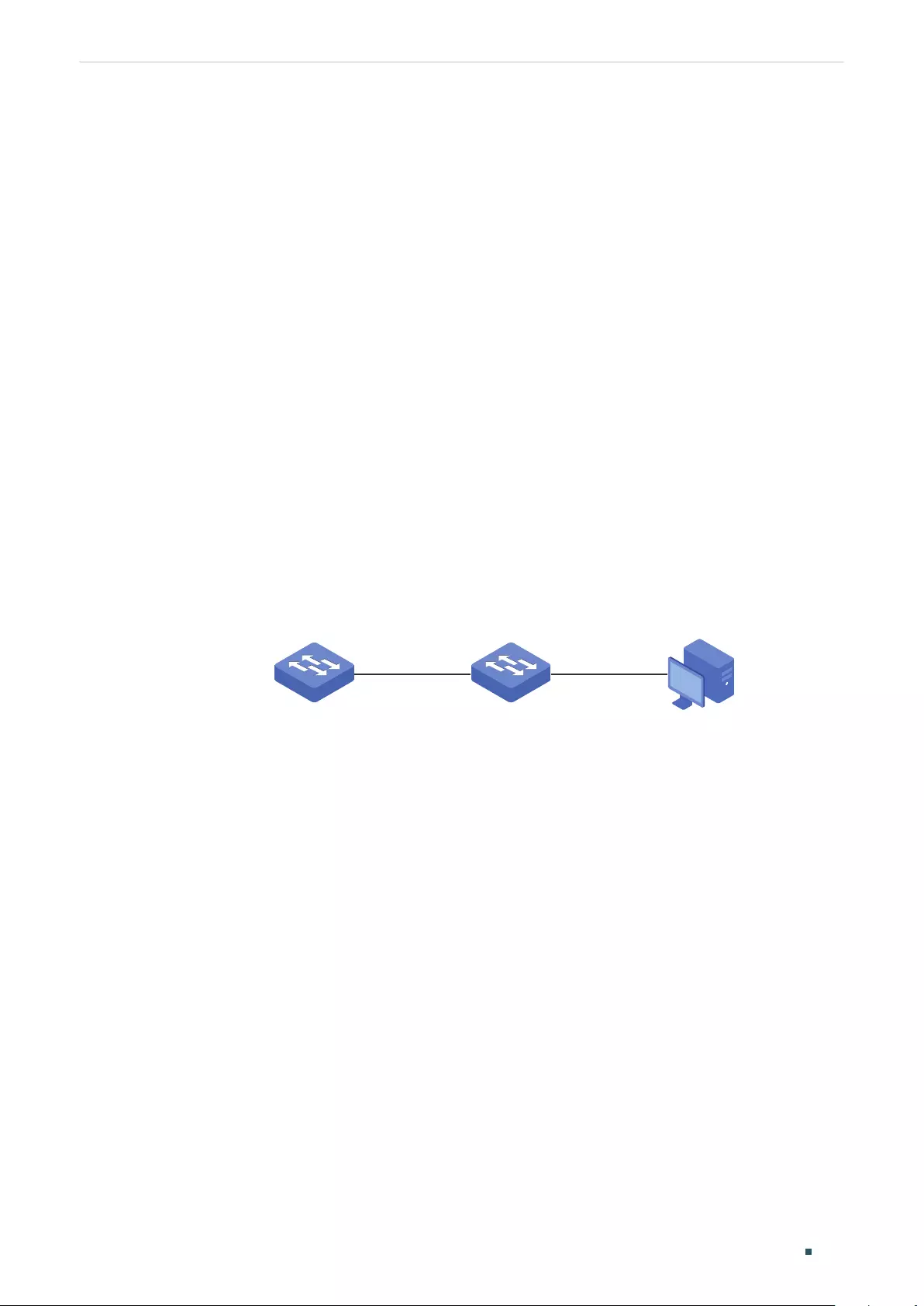
Configuring LLDP Configuration Example
Configuration Guide 873
6 Configuration Example
6.1 Example for Configuring LLDP
6.1.1 Network Requirements
The network administrator needs view the information of the devices in the company
network to know about the link situation and network topology so that he can troubleshoot
the potential network faults in advance.
6.1.2 Network Topology
Exampled with the following situation:
Port Gi1/0/1 on Switch A is directly connected to port Gi1/0/2 on Switch B. Switch B is
directly connected to the PC. The administrator can view the device information using the
NMS.
Figure 6-1 LLDP Network Topology
Gi1/0/1 Gi1/0/2
Switch A Switch B PC
6.1.3 Configuration Scheme
LLDP can meet the network requirements. Enable the LLDP feature globally on Switch A
and Switch B. Configure the related LLDP parameters on the corresponding ports.
Configuring Switch A and Switch B:
The configurations of Switch A and Switch B are similar. The following introductions
take Switch A as an example. Demonstrated with T2600G-28TS, this chapter provides
configuration procedures in two ways: using the GUI and using the CLI.
6.1.4 Using the GUI
1) Choose the menu LLDP > Basic Config > Global Config to load the following page.
Enable LLDP globally and configure the related parameters. Here we take the default
settings as an example.
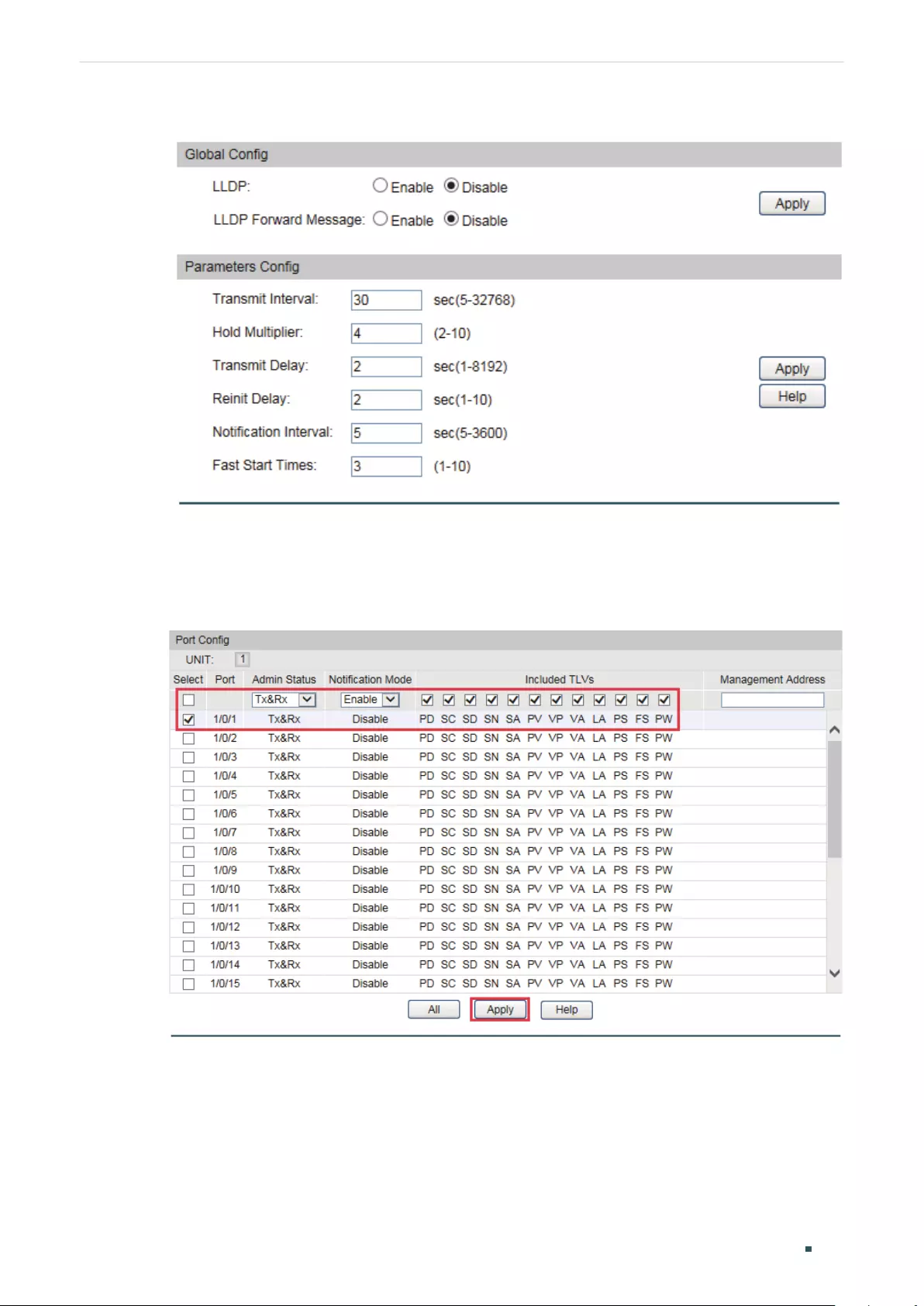
Configuration Guide 874
Configuring LLDP Configuration Example
Figure 6-2 LLDP Global Config
2) Choose the menu LLDP > Basic Config > Port Config to load the following page. Set
the Admin Status of port Gi1/0/1 to Tx&Rx, enable Notification Mode and configure all
the TLVs included in the outgoing LLDP packets.
Figure 6-3 LLDP Port Config
6.1.5 Using CLI
1) Enable LLDP globally and configure the corresponding parameters.
Switch_A#configure
Switch_A(config)#lldp

Configuring LLDP Configuration Example
Configuration Guide 875
Switch_A(config)#lldp hold-multiplier 4
Switch_A(config)#lldp timer tx-interval 30 tx-delay 2 reinit-delay 3 notify-interval 5 fast-
count 3
2) Set the Admin Status of port Gi1/0/1 to Tx&Rx, enable Notification Mode and configure
all the TLVs included in the outgoing LLDP packets.
Switch_A#configure
Switch_A(config)#interface gigabitEthernet 1/0/1
Switch_A(config-if)#lldp receive
Switch_A(config-if)#lldp transmit
Switch_A(config-if)#lldp snmp-trap
Switch_A(config-if)#lldp tlv-select all
Switch_A(config-if)#end
Switch_A#copy running-config startup-config
Verify the Configurations
View LLDP settings globally
Switch_A#show lldp
LLDP Status: Enabled
LLDP Forward Message: Disabled
Tx Interval: 30 seconds
TTL Multiplier: 4
Tx Delay: 2 seconds
Initialization Delay: 2 seconds
Trap Notification Interval: 5 seconds
Fast-packet Count: 3
LLDP-MED Fast Start Repeat Count: 4
View LLDP settings on each port
Switch_A#show lldp interface gigabitEthernet 1/0/1
LLDP interface config:
gigabitEthernet 1/0/1:
Admin Status: TxRx
SNMP Trap: Enabled

Configuration Guide 876
Configuring LLDP Configuration Example
TLV Status
--- ------
Port-Description Yes
System-Capability Yes
System-Description Yes
System-Name Yes
Management-Address Yes
Port-VLAN-ID Yes
Protocol-VLAN-ID Yes
VLAN-Name Yes
Link-Aggregation Yes
MAC-Physic Yes
Max-Frame-Size Yes
Power Yes
LLDP-MED Status: Disabled
TLV Status
--- ------
Network Policy Yes
Location Identification Yes
Extended Power Via MDI Yes
Inventory Management Yes
View the Local Info
Switch_A#show lldp local-information interface gigabitEthernet 1/0/1
LLDP local Information:
gigabitEthernet 1/0/1:
Chassis type: MAC address
Chassis ID: 00:0A:EB:13:23:97
Port ID type: Interface name
Port ID: GigabitEthernet1/0/1
Port description: GigabitEthernet1/0/1 Interface

Configuring LLDP Configuration Example
Configuration Guide 877
TTL: 120
System name: T2600G-28TS
System description: JetStream 24-Port Gigabit L2 Managed Switch with
4 SFP Slots
System capabilities supported: Bridge Router
System capabilities enabled: Bridge Router
Management address type: ipv4
Management address: 192.168.0.226
Management address interface type: IfIndex
Management address interface ID: 1
Management address OID: 0
Port VLAN ID(PVID): 1
Port and protocol VLAN ID(PPVID): 0
Port and protocol VLAN supported: Yes
Port and protocol VLAN enabled: No
VLAN name of VLAN 1: System-VLAN
Protocol identity:
Auto-negotiation supported: Yes
Auto-negotiation enabled: Yes
OperMau: speed(1000)/duplex(Full)
Link aggregation supported: Yes
Link aggregation enabled: No
Aggregation port ID: 0
Power port class: PD
PSE power supported: No
PSE power enabled: No
PSE pairs control ability: No
Maximum frame size: 1518
LLDP-MED Capabilities: Capabilities
Network Policy

Configuration Guide 878
Configuring LLDP Configuration Example
Location Identification
Inventory
Device Type: Network Connectivity
Application type: Reserved
Unknown policy: Yes
Tagged: No
VLAN ID: 0
Layer 2 Priority: 0
DSCP: 0
Location Data Format: Civic Address LCI
- What: Switch
- Country Code: CN
Hardware Revision: T2600G-28TS 2.0
Firmware Revision: Reserved
Software Revision: 2.0.0 Build 20160905 Rel.74744(s)
Serial Number: Reserved
Manufacturer Name: TP-Link
Model Name: T2600G-28TS 2.0
Asset ID: unknown
View the Neighbor Info
Switch_A#show lldp neighbor-information interface gigabitEthernet 1/0/1
LLDP Neighbor Information:
gigabitEthernet 1/0/1:
Neighbor index 1:
Chassis type: MAC address
Chassis ID: 00:0A:EB:13:18:2D
Port ID type: Interface name
Port ID: GigabitEthernet1/0/2
Port description: GigabitEthernet1/0/2 Interface
TTL: 120

Configuring LLDP Configuration Example
Configuration Guide 879
System name: T1600G-52PS
System description: JetStream 48-Port Gigabit Smart
PoE Switch with 4 SFP Slots
System capabilities supported: Bridge Router
System capabilities enabled: Bridge Router
Management address type: ipv4
Management address: 192.168.0.1
Management address interface type: IfIndex
Management address interface ID: 1
Management address OID: 0
Port VLAN ID(PVID): 1
Port and protocol VLAN ID(PPVID): 0
Port and protocol VLAN supported: Yes
Port and protocol VLAN enabled: No
VLAN name of VLAN 1: System-VLAN
Protocol identity:
Auto-negotiation supported: Yes
Auto-negotiation enabled: Yes
OperMau: speed(1000)/duplex(Full)
Link aggregation supported: Yes
Link aggregation enabled: No
Aggregation port ID: 0
Power port class: PSE
PSE power supported: Yes
PSE power enabled: Yes
PSE pairs control ability: No

Configuration Guide 880
Configuring LLDP Configuration Example
6.2 Example for Configuring LLDP-MED
6.2.1 Network Requirements
The marketing department needs establish the voice conversation with the field office.
They want to install IP phones in their office and meet the following requirements:
Save the switch ports for more IP phones due to the limited number of the ports on the
switch in the office;
The voice traffic is transmitted in a separate VLAN to guarantee the voice quality.
The IP phones can finish the Voice VLAN configuration automatically to minimize the
configuration effort.
6.2.2 Configuration Scheme
To save the limited ports on the switch, connect the IP phone and the PC in a series, then
the IP phone and PC can share the same port on the switch.
Configure LLDP-MED to work together with Voice VLAN to guarantee the voice quality and
reduce the configuration effort. Configure the port which the IP phone is connected with,
then IP phone can automatically finish its Voice VLAN configuration using the received
LLDP-MED packets and send tagged voice packets to the switch. Voice packets will be
transmitted in the Voice VLAN while other traffic will be transmitted in the default VLAN.
Please note that the PVID of the port which the IP phone is connected with cannot be the
same as the VLAN ID of the Voice VLAN. Refer to Configuring Voice VLAN for detailed
instructions.
6.2.3 Network Topology
Exampled with the configuration of one IP phone:
One end of the IP phone is connected to the PC, the other end is connect to port Gi1/0/1
on the switch. Port Gi1/0/2 on the switch is connect to the voice gateway.
Figure 6-4 LLDP-MED Network Topology
PC
IP: 172.168.1.222
IP Phone Switch A Voice Gateway
Gi1/0/1 Gi1/0/2
To ensure the voice traffic can be preferentially treated, configure the corresponding
settings on each device in the link. Demonstrated with T2600G-28TS, this section provides
configuration procedures in two ways: using the GUI and using the CLI.
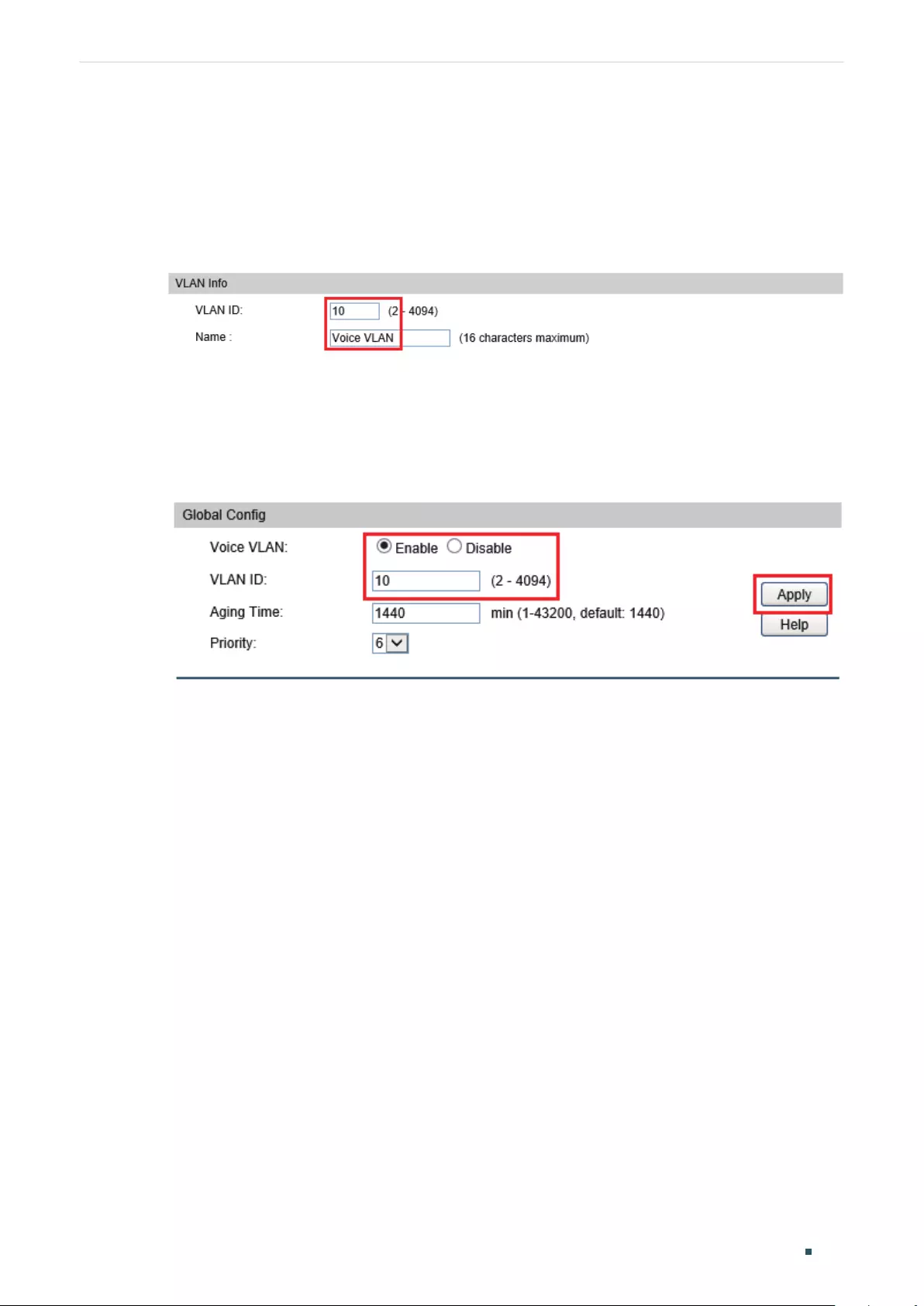
Configuring LLDP Configuration Example
Configuration Guide 881
6.2.4 Using the GUI
1) Choose the menu VLAN > 802.1Q VLAN > VLAN Config to load the following page.
Create VLAN 10, and name it as Voice VLAN.
Figure 6-5 Creating a VLAN
2) Enable and configure the Voice VLAN.
Choose the menu QoS > Voice VLAN > Global Config, enable Voice VLAN and set the
VLAN ID to 10.
Figure 6-6 Configuring Voice VLAN Globally
Choose the menu QoS > Voice VLAN > Port Config, set the Voice VLAN mode on
Gi1/0/1 and Gi1/0/2 as Auto and Manual respectively.

Configuration Guide 882
Configuring LLDP Configuration Example
Figure 6-7 Configuring Voice VLAN Mode on Port 1/0/1
Figure 6-8 Configuring Voice VLAN Mode on Port 1/0/2
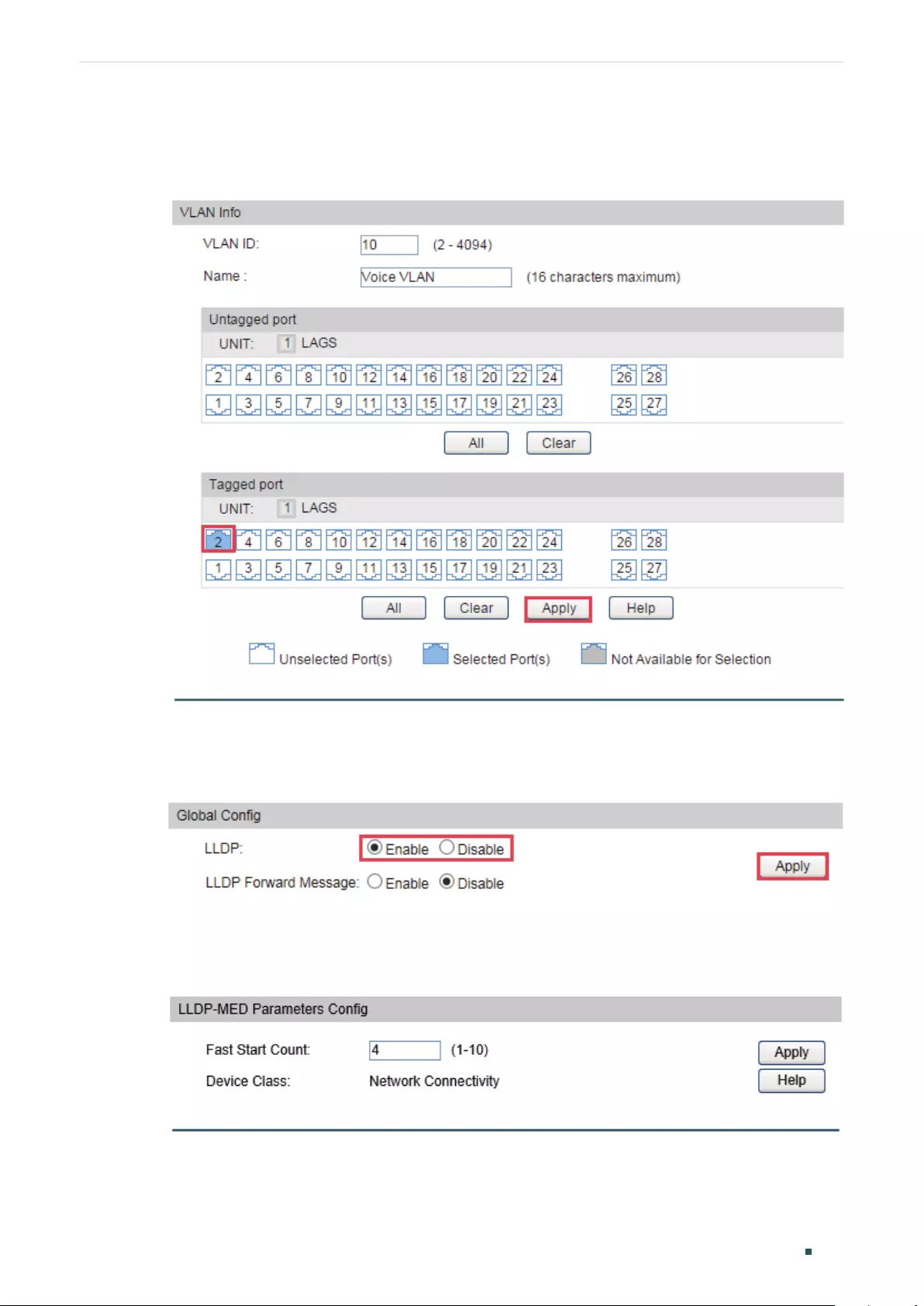
Configuring LLDP Configuration Example
Configuration Guide 883
Choose the menu VLAN > 802.1Q VLAN > VLAN Config to load the following page. Add
port 1/0/2 to the Voice VLAN.
Figure 6-9 Adding Port 1/0/2 to the Voice VLAN
3) Choose the LLDP > Basic Config > Global Config to load the following page and enable
LLDP globally.
Figure 6-10 LLDP Global Config
4) Choose the LLDP > LLDP-MED > Global Config to load the following page and
configure the fast start count. The default is 4.
Figure 6-11 LLDP-MED Global Config
5) Choose th menu LLDP > LLDP-MED > Policy Config to load the following page. Select
port 1/0/1 and enable LLDP-MED.

Configuration Guide 884
Configuring LLDP Configuration Example
Figure 6-12 LLDP-MED Port Config
Click Detail in the Port 1/0/1 entry to configure TLVs included in the outgoing LLDP-
MED packets.
Figure 6-13 LLDP-MED Port Config-Detail
In the Location Identification Parameters section, configure the detailed address of the
IP phone. Click Apply.
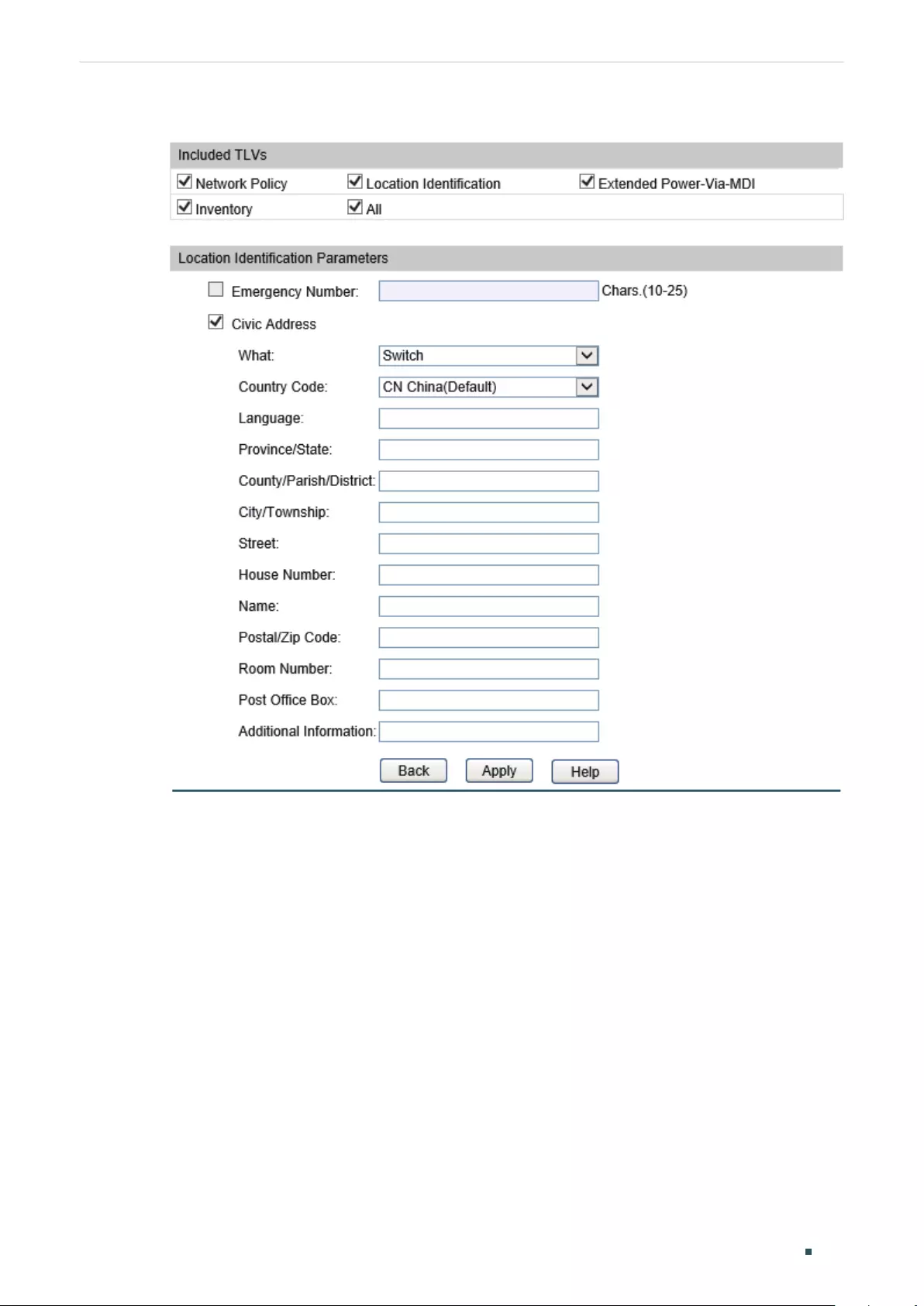
Configuring LLDP Configuration Example
Configuration Guide 885
Figure 6-14 Configure the detailed address of the IP phone
6.2.5 Using the CLI
1) Create VLAN 10 and name it as Voice VLAN.
Switch_A(config)#vlan 10
Switch_A(config-vlan)#name Voice_VLAN
Switch_A(config)#voice vlan 10
2) Configure the Voice VLAN mode on port Gi1/0/1 as Auto.
Switch_A(config)#interface gigabitEthernet 1/0/1
Switch_A(config-if)#switchport voice vlan mode auto
Switch_A(config-if)#exit
3) Configure the Voice VLAN mode on port Gi1/0/2 as Manual and add port Gi1/0/2 to
Voice VLAN.

Configuration Guide 886
Configuring LLDP Configuration Example
Switch_A(config)#interface gigabitEthernet 1/0/2
Switch_A(config-if)#switchport voice vlan mode manual
Switch_A(config-if)#switchport general allowed vlan 10 tagged
Switch_A(config-if)#exit
4) Enable LLDP globally.
Switch_A(config)#lldp
5) Configure the fast start count of LLDP-MED. The default is 4.
Switch_A(config)# lldp med-fast-count 4
6) Enable the LLDP-MED on port Gi1/0/1.
Switch_A(config)#interface gigabitEthernet 1/0/1
Switch_A(config-if)#lldp med-status
7) Configure the LLDP-MED TLVs included in the outgoing LLDP packets.
Switch_A(config-if)#lldp med-tlv-select all
8) Configure the detailed address of the IP phone.
Switch_A(config-if)#lldp med-location civic-address language English lci-city
Vancouver street X east hastings street postal-zipcode V6A 1P9
Verify the Configurations
View global LLDP-MED settings:
Switch_A#show lldp
LLDP Status: Enabled
LLDP Forward Message: Disabled
Tx Interval: 30 seconds
TTL Multiplier: 4
Tx Delay: 2 seconds
Initialization Delay: 2 seconds
Trap Notification Interval: 5 seconds
Fast-packet Count: 3
LLDP-MED Fast Start Repeat Count: 4
View LLDP-MED settings on each port:
Switch_A#show lldp interface gigabitEthernet 1/0/1
LLDP interface config:

Configuring LLDP Configuration Example
Configuration Guide 887
gigabitEthernet 1/0/1:
Admin Status: TxRx
SNMP Trap: Enabled
TLV Status
--- ------
Port-Description Yes
System-Capability Yes
System-Description Yes
System-Name Yes
Management-Address Yes
Port-VLAN-ID Yes
Protocol-VLAN-ID Yes
VLAN-Name Yes
Link-Aggregation Yes
MAC-Physic Yes
Max-Frame-Size Yes
Power Yes
LLDP-MED Status: Enabled
TLV Status
--- ------
Network Policy Yes
Location Identification Yes
Extended Power Via MDI Yes
Inventory Management Yes
View the local information:
Switch_A#show lldp local-information interface gigabitEthernet 1/0/1
LLDP local Information:
gigabitEthernet 1/0/1:
Chassis type: MAC address
Chassis ID: 00:0A:EB:13:23:97

Configuration Guide 888
Configuring LLDP Configuration Example
Port ID type: Interface name
Port ID: GigabitEthernet1/0/1
Port description: GigabitEthernet1/0/1 Interface
TTL: 120
System name: Switch
System description: JetStream 24-Port Gigabit L2 Managed Switch with
4 SFP Slots
System capabilities supported: Bridge Router
System capabilities enabled: Bridge Router
Management address type: ipv4
Management address: 192.168.0.226
Management address interface type: IfIndex
Management address interface ID: 1
Management address OID: 0
Port VLAN ID(PVID): 1
Port and protocol VLAN ID(PPVID): 0
Port and protocol VLAN supported: Yes
Port and protocol VLAN enabled: No
VLAN name of VLAN 1: System-VLAN
Protocol identity:
Auto-negotiation supported: Yes
Auto-negotiation enabled: Yes
OperMau: speed(100)/duplex(Full)
Link aggregation supported: Yes
Link aggregation enabled: Yes
Aggregation port ID: 1
Power port class: PD
PSE power supported: No
PSE power enabled: No
PSE pairs control ability: No

Configuring LLDP Configuration Example
Configuration Guide 889
Maximum frame size: 1518
LLDP-MED Capabilities: Capabilities
Network Policy
Location Identification
Inventory
Device Type: Network Connectivity
Application type: Reserved
Unknown policy: Yes
Tagged: No
VLAN ID: 0
Layer 2 Priority: 0
DSCP: 0
Location Data Format: Civic Address LCI
- What: Switch
- Country Code: CN
- Language: chinese
- Province/State: Guangdong
- County/Parish/District: China
- City/Township: Shenzhen
- Street: Keyuan Road
- Name: South Building No.5
- Postal/Zip Code: 518057
Hardware Revision: T2600G-28TS 2.0
Firmware Revision: Reserved
Software Revision: 1.0.1 Build 20151216 Rel.65850(s)
Serial Number: Reserved
Manufacturer Name: TP-Link
Model Name: T2600G-28TS 2.0
Asset ID: unknown

Configuration Guide 890
Configuring LLDP Configuration Example
View the neighbor information:
Switch_A#show lldp neighbor-information interface gigabitEthernet 1/0/1
LLDP Neighbor Information:
gigabitEthernet 1/0/1:
Neighbor index 1:
Chassis type: Network address
Chassis ID: 192.168.1.117
Port ID type: Locally assigned
Port ID: 64A0E714DC54:P1
Port description: SW PORT
TTL: 180
System name: SEP64A0E714DC54
System description: Cisco IP Phone 7931G,V4, term default
System capabilities supported: Bridge Telephone
System capabilities enabled: Bridge Telephone
Management address type: ipv4
Management address: 192.168.1.117
Management address interface type: UnKnown
Port VLAN ID(PVID):
Port and protocol VLAN ID(PPVID):
Port and protocol VLAN supported:
Port and protocol VLAN enabled:
Protocol identity:
Auto-negotiation supported: Yes
Auto-negotiation enabled: Yes
OperMau: speed(100)/duplex(Full)
Link aggregation supported:
Link aggregation enabled:
Aggregation port ID:
Power port class:

Configuring LLDP Configuration Example
Configuration Guide 891
PSE power supported:
PSE power enabled:
PSE pairs control ability:
Maximum frame size:
LLDP-MED Capabilities: Capabilities
Network Policy
Extended Power via MDI - PD
Inventory
Device Type: Endpoint Class III
Application type: Voice
Unknown policy: No
Tagged: No
VLAN ID: 4095
Layer 2 Priority: 5
DSCP: 46
Application type: Voice Signaling
Unknown policy: No
Tagged: No
VLAN ID: 4095
Layer 2 Priority: 4
DSCP: 32
Power Type: PD Device
Power Source: Unknown
Power Priority: Unknown
Power Value: 7.0w
Hardware Revision: 4
Firmware Revision: tnp31.3-2-0-11.bin
Software Revision: term31.default
Serial Number: FCH1537A2JV
Manufacturer Name: Cisco Systems, Inc.

Configuration Guide 892
Configuring LLDP Appendix: Default Parameters
7 Appendix: Default Parameters
Default settings of LLDP are listed in the following tables.
Default LLDP Settings
Table 7-1 Default LLDP Settings
Parameter Default Setting
LLDP Disable
LLDP Forward Message Disable
Transmit Interval 30 seconds
Hold Multiplier 4
Transmit Delay 2 seconds
Reinit Delay 2 seconds
Notification Interval 5 seconds
Fast Start Times 3
Table 7-2 Default LLDP Settings on the Port
Parameter Default Setting
Admin Status Tx&Rx
Notification Mode Disable
Included TLVs All
Default LLDP-MED Settings
Table 7-3 Default LLDP-MED Settings
Parameter Default Setting
Fast Start Count 4
LLDP-MED Status Disable
Included TLVs All

Configuration Guide 894
Configuring Maintenance Maintenance
1 Maintenance
1.1 Overview
The maintenance module assembles various system tools for network troubleshooting.
1.2 Supported Features
The maintenance module includes system monitor, sFlow (sampled Flow), Log, device
diagnose, and network diagnose.
System Monitor
You can monitor the memory and the CPU utilizations of the switch.
SFlow
The switch provides a packet-based sFlow, which samples one packet out of a specified
number of packets. With the sFlow, you can analyze traffic statistics and monitor the
network usage.
This feature is not supported by T2600G-18TS.
Log
You can check system messages for debugging and network management.
Device Diagnose
You can test the cable connection status, cable length and error length for troubleshooting.
Network Diagnose
The network diagnose function includes Ping test and Tracert test. With them, you can test
the connectivity between the switch and one node of the network, or the connectivity of
the gateways on the path from the source to the destination.
DLDP
DLDP (Device Link Detection Protocol) is a Layer 2 protocol that enables devices
connected through fiber or twisted-pair Ethernet cables to detect whether a unidirectional
link exists. When a unidirectional link appears, the local device can receive packets from
the peer device through the link layer, but the peer device cannot receive packets from the
local device. Unidirectional links can cause a variety of problems, such as spanning-tree
topology loops. Once detecting a unidirectional link, DLDP can shut down the related port
automatically or inform users.
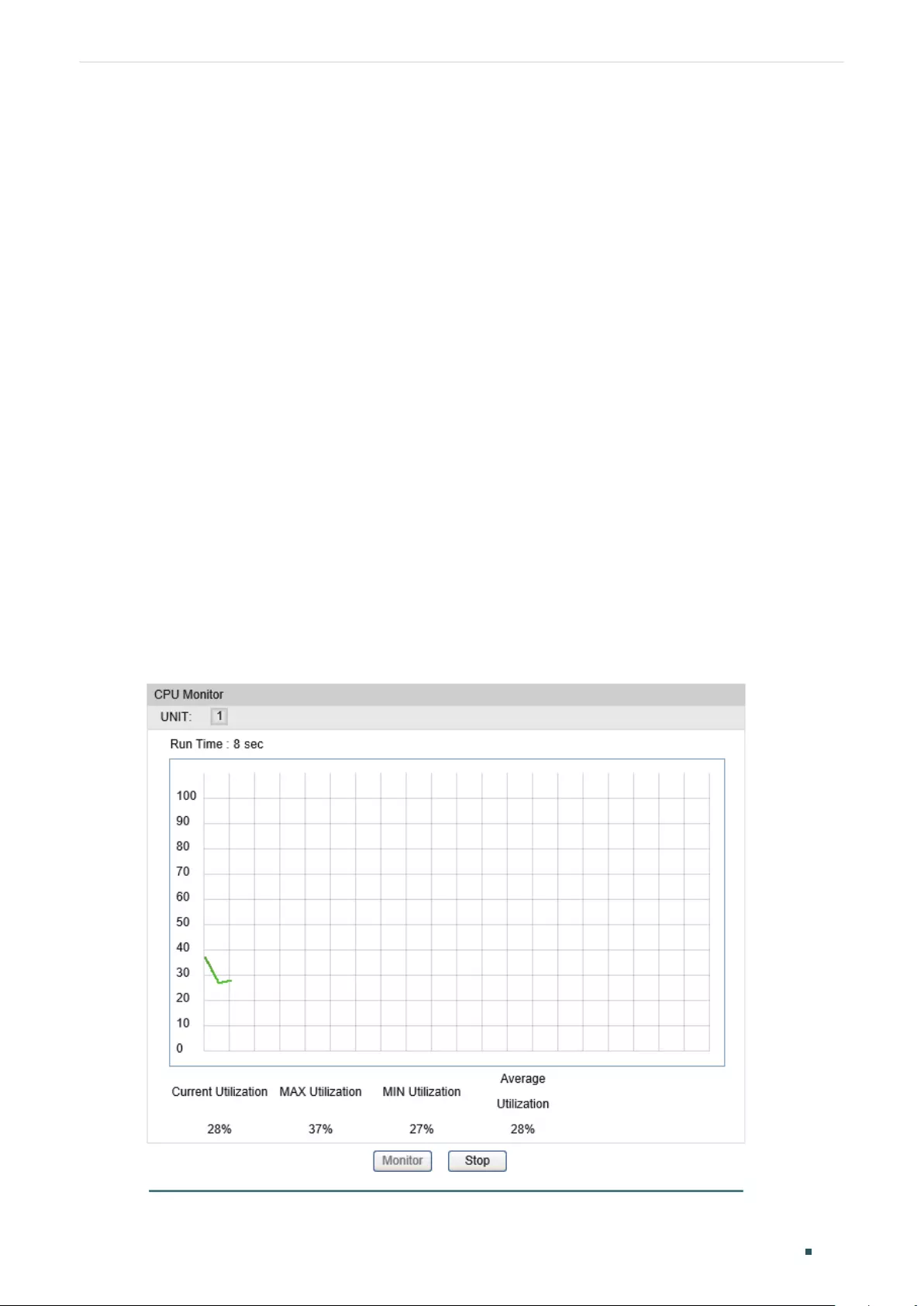
Configuring Maintenance Monitoring the System
Configuration Guide 895
2 Monitoring the System
The system monitor configurations include:
Monitoring the CPU;
Monitoring the memory.
Configuration Guidelines
The CPU and memory utilizations should be always under 80%, and excessive use may
result in switch malfunctions. For example, the switch fails to respond to management
requests. In similar situations, you can monitor the system to verify a CPU or memory
utilization problem.
2.1 Using the GUI
2.1.1 Monitoring the CPU
Choose the menu Maintenance > System Monitor > CPU Monitor to load the following
page.
Figure 2-1 Monitoring the CPU

Configuration Guide 896
Configuring Maintenance Monitoring the System
Click Monitor to enable the switch to monitor and display its CPU utilization rate every four
seconds.
2.1.2 Monitoring the Memory
Choose the menu Maintenance > System Monitor > Memory Monitor to load the following
page.
Figure 2-2 Monitoing the Memory
Click Monitor to enable the switch to monitor and display its memory utilization rate every
four seconds.

Configuring Maintenance Monitoring the System
Configuration Guide 897
2.2 Using the CLI
2.2.1 Monitoring the CPU
On privileged EXEC mode or any other configuration mode, you can use the following
command to view the CPU utilization:
show cpu-utilization
View the memory utilization of the switch in the last 5 seconds, 1minute and 5minutes.
The following example shows how to monitor the CPU:
Switch#show cpu-utilization
Unit | CPU Utilization
No. | Five-Seconds One-Minute Five-Minutes
------+-------------------------------------------------
1 | 13% 13% 13%
2.2.2 Monitoring the Memory
On privileged EXEC mode or any other configuration mode, you can use the following
command to view the memory utilization:
show memory-utilization
View the memory utilization of the switch in the last 5 seconds, 1minute and 5minutes.
The following example shows how to monitor the memory:
Switch#show memory-utilization
Unit | Current Memory Utilization
------+----------------------------
1 | 74%

Configuration Guide 898
Configuring Maintenance SFlow Configuration
3 SFlow Configuration
To complete the configuration, follow these steps:
1) Configure the sFlow collector;
2) Configure the sFlow sampler.
Configuration Guidelines
The sFlow monitoring system consists of an sFlow agent (embedded in a switch or router
or in a standalone probe) and an sFlow collector (installed in a host). To get analytic results,
you should choose a proper collector.
For details on sFlow collectors, refer to http://www.sflow.org.
3.1 Using the GUI
3.1.1 Configuring the SFlow Collector
Choose the menu Maintenance > sFlow> sFlow collector to load the following page.
Figure 3-1 Configuring the SFlow Collector
Follow these steps to configure the sFlow collector:
1) In the Global Config section, enable the sFlow function, specify the sFlow agent IP
address, and then click Apply.
sFlow Status Enable the sFlow function globally on the switch.
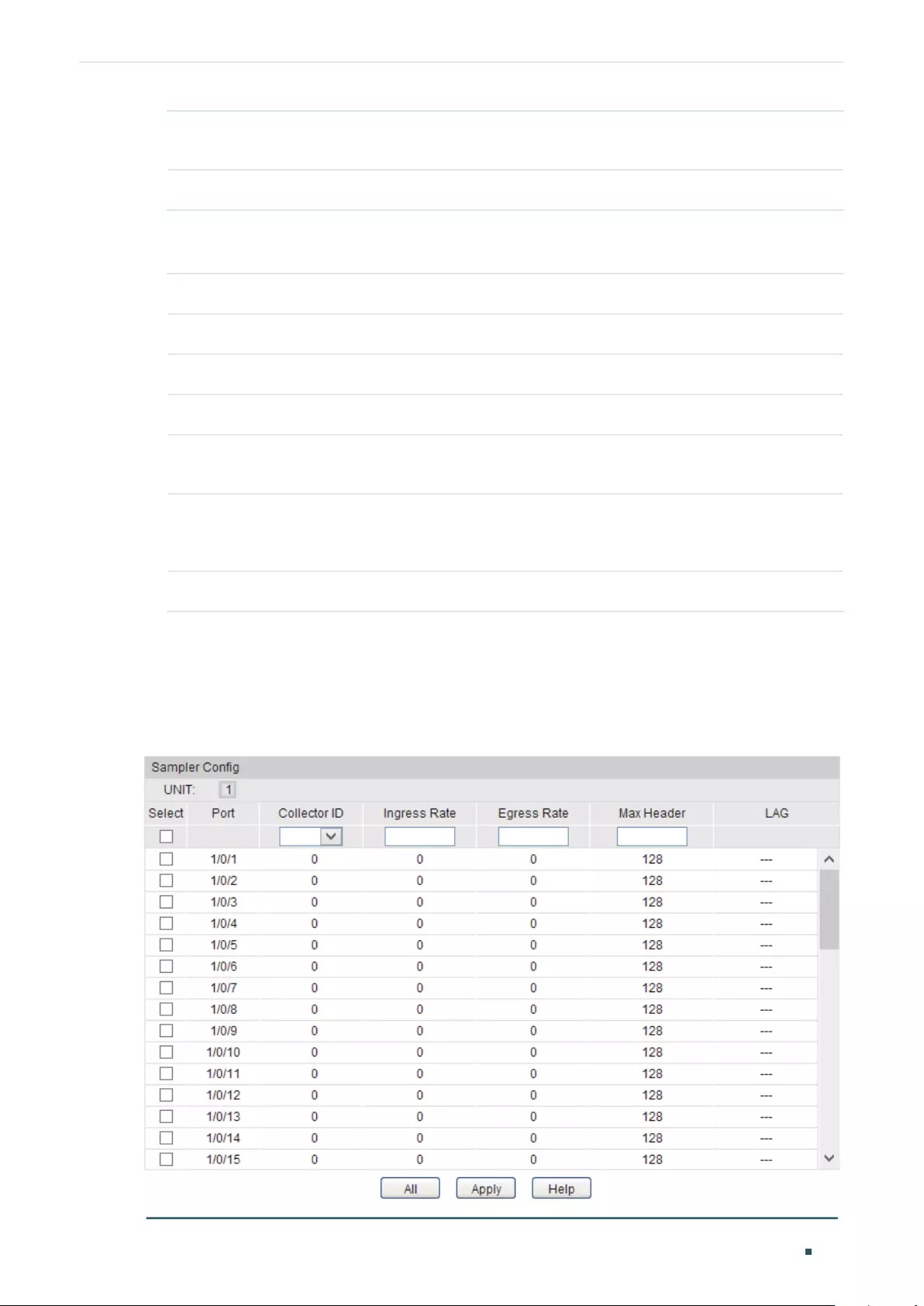
Configuring Maintenance SFlow Configuration
Configuration Guide 899
Agent Address Enter the management IP address of the switch to monitor traffic on the switch
port.
sFlow Version The sFlow version is V5.
2) In the Collector Config section, select a collector to configure relevant parameters,
and click Apply.
Collector ID Select a collector for configuration. The switch supports 4 collectors at most.
Description Give a collector description for identification with 16 characters at most.
Collector IP Enter the IP address of the host that runs the sFlow collector.
Collector Port Specify the UDP port number for the sFlow collector. The default is port 6343.
Max Datagram Specify the maximum number of data bytes that can be sent in a single sample
datagram. The values are from 300 to 1400 bytes and the default is 300 bytes.
Timeout (s) Specify the aging time after which the sFlow collector will become invalid. The
values are from 0 to 2000000 seconds; the default is 0, which means the collector
is always valid.
Lifetime (s) Displays the remaining time of the collector. Lifetime counts down from Timeout.
3.1.2 Configuring the SFlow Sampler
Choose the menu Maintenance > sFlow> sFlow Sampler to load the following page.
Figure 3-2 Configuring the SFlow Sampler

Configuration Guide 900
Configuring Maintenance SFlow Configuration
Follow these steps to configure the sFlow sampler:
1) In the Sampler Config section, set one or more ports to be a sampler and configure
relevant parameters . One port can be bound to only one collector.
Collector ID Select a collector for configuration. The switch supports 4 collectors at most.
Ingress Rate Specify the ingress sampling frequency; then the samplers takes one packet out
of the specified number of packets. The values are from 1024 to 65535 and the
default is 0 which means no packets will be sampled.
Egress Rate Specify the egress sampling frequency; then the samplers takes one packet out
of the specified number of packets. The values are from 1024 to 65535 and the
default is 0 which means no packets will be sampled.
Max Header Specify the maximum number of bytes that should be copied from a sampled
packet. The values are from 18 to 256 bytes; the default is 128 bytes.
LAG Displays the LAG number which the port belongs to.
2) Click Apply.
3.2 Using the CLI
Follow these steps to configure the sFlow:
Step 1 configure
Enter global configuration mode.
Step 2 sflow address {
ipv4-addr
}
Configure the IP address of sFlow agent.
ipv4-addr:
Enter the management IP address of the switch to monitor traffic on the switch port.
Step 3 sflow enable
Enable the sFlow function.
Step 4 sflow collector collector-ID
value
{ [descript
descript
] | [ ip
ip
] | [ port
port
] | [ maxData
maxData
] | [ timeout
timeout
] }
Configure parameters of the sFlow collector.
value
: Enter the ID of the sFlow collector. The values are from 1 to 4.
descript
: Give a collector description for identification with 16 characters at most.
ip
: Enter the IP address of the host that runs the sFlow collector.
port
:
Enter the UDP port number for the sFlow collector. The default is port 6343.
maxData
: Specify the maximum number of data bytes that can be sent in a single sample
datagram. The values are s from 300 to 1400 bytes; the default is 300 bytes.
timeout
:
Specify the aging time after which the sFlow collector will become invalid. The values
are from 0 to 2000000 seconds; the default is 0, which means the collector is always valid.

Configuring Maintenance SFlow Configuration
Configuration Guide 901
Step 5 interface
{ [
gigabitEthernet
port
] | [ range gigabitEthernet
port-list
] }
Configure the sampler on the specified ports.
port/port-list:
The number or the list of the Ethernet ports that you want to monitor.
Step 6 sflow sampler { [ collector-ID
value
] | [ ingRate
ingress-rate
] [ egRate
egress-rate
] |
[maxHeader
maxHeader
] }
Configure parameters of the sFlow sampler.
value
: Enter the ID of the sFlow collector which the sFlow sampler will send sFlow datagrams
to. The values are from 0 to 4. And 0 means no collector is selected.
ingress-rate
: Specify the ingress sampling frequency; then the samplers takes one packet out
of the specified number of packets. The values are from 1024 to 65535 and the default is 0
which means no packets will be sampled.
egress-rate
: Specify the egress sampling frequency; then the samplers takes one packet out of
the specified number of packets. The values are from 1024 to 65535 and the default is 0 which
means no packets will be sampled.
maxHeader
: Specify the maximum number of bytes that should be copied from a sampled
packet. The values are from 18 to 256 bytes; the default is 128 bytes.
Step 7 show sflow { [ global ] | [ collector ] | [ sampler
] }
Verify the sFlow configurations.
global: View the global configuration of sFlow.
collector: View the global configuration of the sFlow collector.
sampler: View the global configuration of the sFlow sampler.
Step 8 end
Return to privileged EXEC mode.
Step 9 copy running-config startup-config
Save the settings in the configuration file.
The following example shows how to configure the switch whose IP address is 192.168.0.1
to send sFlow packets to the host whose IP address is 192.168.0.100. Set the sFlow agent
IP address as 192.168.0.1, the sFlow collector IP address 1 as 192.168.0.100; configure
Gigabit Ethernet port 1 as the sFlow sampler, the Collector-ID as 1, and the ingress rate as
1024:
Switch#configure
Switch(config)#sflow address 192.168.0.1
Switch(config)#sflow enable
Switch(config)#sflow collector collector-ID 1 ip 192.168.0.100
Switch(config)# sflow collector collector-ID 1 port 6343
Switch(config)#interface gigabitEthernet 1/0/1
Switch(config-if)#sflow sampler collector-ID 1

Configuration Guide 902
Configuring Maintenance SFlow Configuration
Switch(config-if)#sflow sampler ingRate 1024
Switch(config-if)#show sflow global
sFlow Status: Enable
Agent Address: 192.168.0.1
sFlow Version: v5
Switch(config-if)#show sflow collector
Collector Col-IP Col-Port MaxData Timeout Lifetime Description
-------- -------------- -------- -------- -------- -------- -----------
1 192.168.0.100 6343 300 0 0
2 0.0.0.0 6343 300 0 0
3 0.0.0.0 6343 300 0 0
4 0.0.0.0 6343 300 0 0
Switch(config-if)#show sflow sampler
Port Collector IngRate EgRate MaxHeader LAG
---------- ---------- ---------- ---------- ---------- ---
Gi1/0/1 1 1024 0 128 N/A
Gi1/0/2 0 0 0 128 N/A
Gi1/0/3 0 0 0 128 N/A
......
Switch(config-if)#end
Switch#copy running-config startup-config

Configuring Maintenance System Log Configurations
Configuration Guide 903
4 System Log Configurations
System log configurations include:
Configuring the local log;
Configuring the remote log;
Backing up log files;
Viewing the log table.
Configuration Guidelines
Logs are classified into the following eight levels. Messages of levels 0 to 4 mean the
functionality of the switch is affected. Please take actions according to the log message.
Table 4-1 Levels of Logs
Severity Level Description Example
Emergencies 0 The system is unusable and you have
to reboot the switch.
Software malfunctions affect the
functionality of the switch.
Alerts 1 Actions must be taken immediately. The memory utilization reaches the
limit.
Critical 2 Cause analysis or actions must be
taken immediately.
The memory utilization reaches the
warning threshold.
Errors 3 Error operations or unusual
processing that will not affect
subsequent operations but that
should be noted and analyzed.
Wrong command or password is
entered.
Warnings 4 Conditions that may cause process
failure and that should be noted.
Error protocol packets are
detected.
Notifications 5 Normal but significant conditions. The shutdown command is applied
to a port.
Informational 6 Normal messages for your
information.
The display command is used.
Debugging 7 Debug-level messages that you can
ignore.
General operational information.
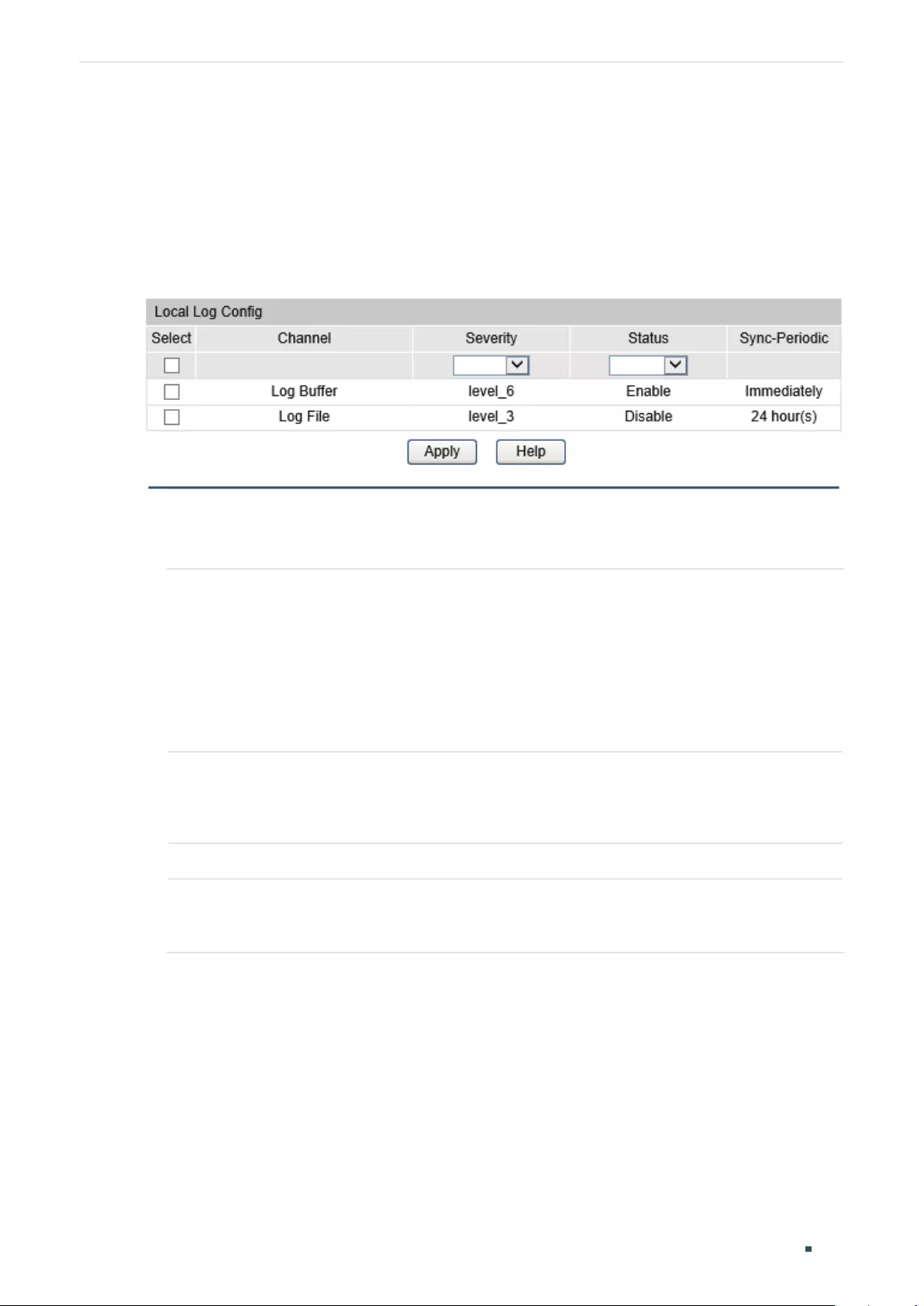
Configuration Guide 904
Configuring Maintenance System Log Configurations
4.1 Using the GUI
4.1.1 Configuring the Local Log
Choose the menu Maintenance > Log> Local Log to load the following page.
Figure 4-1 Configuring the Local Log
Follow these steps to configure the local log:
1) Select your desired channel and configure the corresponding severity and status.
Channel Local log includes 2 channels: log buffer and log file.
Log buffer indicates the RAM for saving system log. The channel is enabled by
default. The information in the log buffer is displayed on the Maintenance > Log>
Log Table page. It will be lost when the switch is restarted.
Log File indicates the flash sector for saving system log. The information in the
log file will not be lost after the switch is restarted and can be exported on the
Maintenance > Log > Backup Log page.
Severity Specify the severity level of the log information that is saved to the selected
channel. Only the log with the same or smaller severity level value can be saved.
There are 8 severity levels marked from 0 to 7. The smaller value means the
higher priority.
Status Enable or disable the channel.
Sync-Periodic By default, the log information is saved in the log buffer immediately, and
synchronized to the log file every 24 hours. If necessary, you can modify the log
synchronization frequency using the CLI.
2) Click Apply.

Configuring Maintenance System Log Configurations
Configuration Guide 905
4.1.2 Configuring the Remote Log
Remote Log enables the switch to send system logs to a host. To display the logs, the host
should run a log server that complies with the syslog standard.
Choose the menu Maintenance > Log> Remote Log to load the following page.
Figure 4-2 Configuring the Remote Log
Follow these steps to configure remote log:
1) Select an entry to enable the status, and then set the host IP address and severity.
Host IP Specify an IP address for the log host.
UDP Port Displays the UDP port that receives and sends the log information. And the switch
uses the standard port 514.
Severity Specify the severity level of the log information sent to the selected log host.
Only the log with the same or smaller severity level value will be sent to the
corresponding log host.
Status Enable or disable the log host.
2) Click Apply.
4.1.3 Backing up the Log File
Choose the menu Maintenance > Log > Backup Log to load the following page.
Figure 4-3 Backup Log
Click Backup Log to save the system log as a file on your computer. If the switch system
breaks down, you can check the file for troubleshooting.
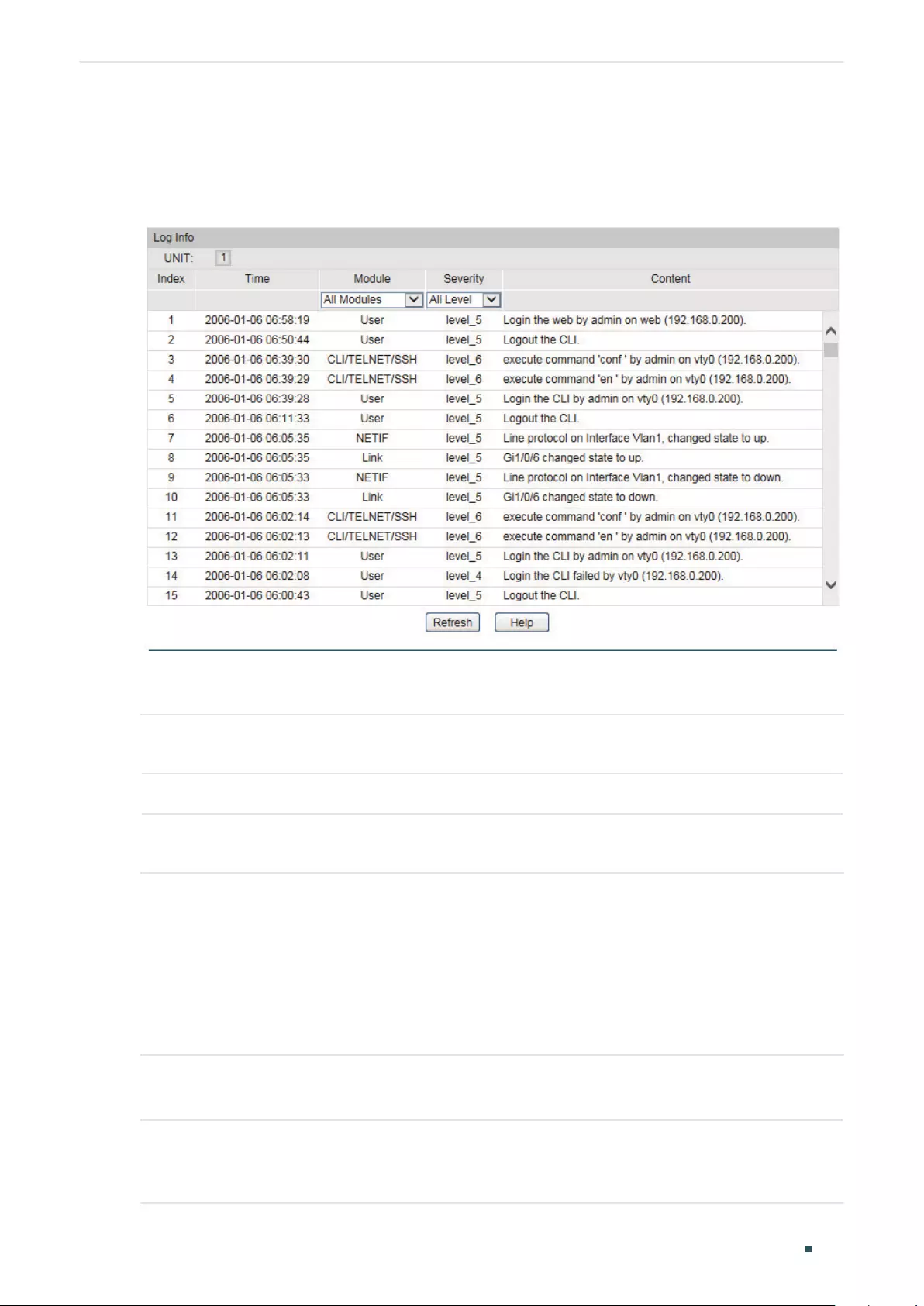
Configuration Guide 906
Configuring Maintenance System Log Configurations
4.1.4 Viewing the Log Table
Choose the menu Maintenance > Log> Log Table to load the following page.
Figure 4-4 Viewing the Log Table
Select a module and a severity to view the corresponding log information.
Time To get the exact time when the log event occurs, you need to configure the system
time on the System > System Info > System Time Web management page.
Module Select a module from the drop-down list to display the corresponding log information.
Severity Select a severity level to display the log information whose severity level value is the
same or smaller.
4.2 Using the CLI
4.2.1 Configuring the Local Log
Follow these steps to configure the local log:
Step 1 configure
Enter global configuration mode.
Step 2 logging buffer
The switch stores the system log messages to the RAM. And the information will be lost when
the switch is restarted. You can view the logs with show logging buffer command.

Configuring Maintenance System Log Configurations
Configuration Guide 907
Step 3 logging buffer level
level
Specify the severity level of the log information that should be saved to the buffer.
level
: Enter the severity level ranging from 0 to 7. The smaller value has the higher priority.
Only the log with the same or smaller severity level value can be saved. The default level is 6,
indicating that the log information of levels 0 to 6 will be saved in the log buffer.
Step 4 logging file flash
Store the log messages in the flash sector of the switch. The information in the flash will not be
lost after the switch is restarted. You can view the logs with show logging flash command.
Step 5 logging file flash frequency { periodic
periodic
| immediate }
Specify the frequency to synchronize the system log file in the log buffer to the flash.
periodic
: Specify the frequency ranging from 1 to 48 hours. By default, the synchronization
process takes place every 24 hours.
immediate: The system log file in the buffer will be synchronized to the flash immediately. This
option means frequent operations on the flash and is not recommended.
Step 6 logging file flash level
level
Specify the severity level of the log information that should be saved to the flash.
level
: Enter the severity level ranging from 0 to 7. The smaller value has the higher priority. Only
the log with the same or smaller severity level value can be saved to the flash. The default level
is 3, indicating that the log message of levels 0 to 3 will be saved in the log flash.
Step 7 show logging local-config
View the configuration information of the local log.
Step 8 end
Return to privileged EXEC mode.
Step 9 copy running-config startup-config
Save the settings in the configuration file.
The following example shows how to configure the local log on the switch. Save logs of
levels 0 to 5 to the log buffer, and synchronize logs of levels 0 to 2 to the flash every 10
hours:
Switch#configure
Switch(config)#logging buffer
Switch(config)#logging buffer level 5
Switch(config)#logging file flash
Switch(config)#logging file flash frequency periodic 10
Switch(config)#logging file flash level 2
Switch(config)#show logging local-config

Configuration Guide 908
Configuring Maintenance System Log Configurations
Channel Level Status Sync-Periodic
------- ----- ------ -------------
Buffer 5 enable Immediately
Flash 2 enable 10 hour(s)
Monitor 5 enable Immediately
Switch(config)#end
Switch#copy running-config startup-config
4.2.2 Configuring the Remote Log
Remote Log enables the switch to send system logs to a host. To display the logs, the host
should run a log server that complies with the syslog standard.
Follow these steps to set the remote log:
Step 1 configure
Enter global configuration mode.
Step 2 logging host index
idx host-ip level
Configure the log host which receives the system logs from other devices. You can remotely
monitor the settings and operation status of other devices through the log host.
idx
: Enter the index of the log host. The switch supports 4 log hosts at most.
host-ip
: Specify the IP address for the log host.
level
: Enter the severity level of the log information that should be sent to each log host.
The range is 0 to 7, and the smaller value has the higher priority. Only the log with the same
or smaller severity level value will be sent to the corresponding log host. The default is 6,
indicating that the log information of levels 0 to 6 will be sent to the log host.
Step 3 show logging loghost [
index
]
View the configuration information of the log host.
index
: Enter the index of the log host to view the corresponding configuration information. If no
value is specified, information of all log hosts will be displayed.
Step 4 end
Return to privileged EXEC mode.
Step 5 copy running-config startup-config
Save the settings in the configuration file.
The following example shows how to set the remote log on the switch. Enable log host 2,
set its IP address as 192.168.0.148, and allow logs of levels 0 to 5 to be sent to the host:
Switch#configure
Switch(config)# logging host index 2 192.168.0.148 5

Configuring Maintenance System Log Configurations
Configuration Guide 909
Switch(config)# show logging loghost
Index Host-IP Severity Status
----- ------- -------- ------
1 0.0.0.0 6 disable
2 192.168.0.148 5 enable
3 0.0.0.0 6 disable
4 0.0.0.0 6 disable
Switch(config)#end
Switch#copy running-config startup-config
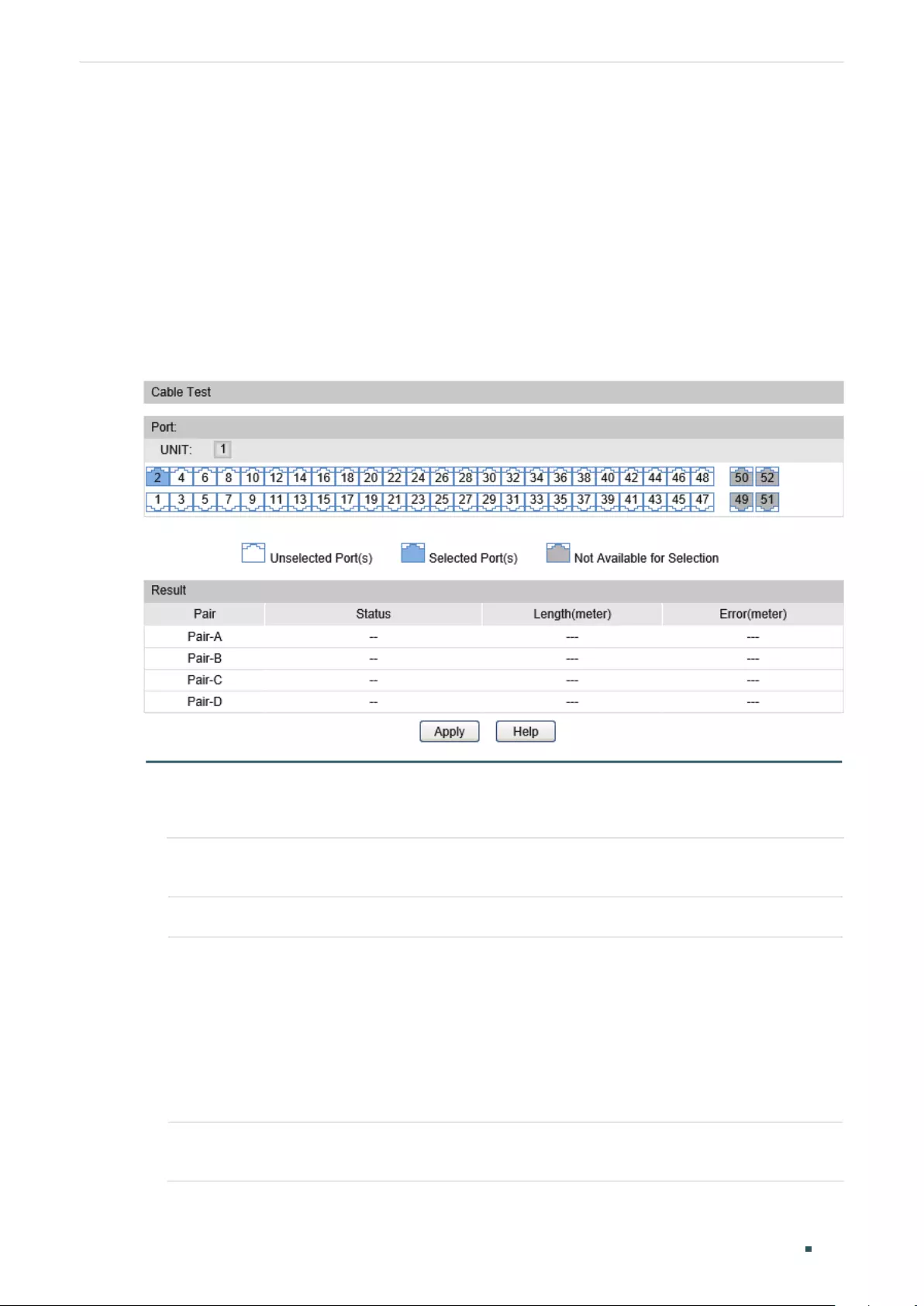
Configuration Guide 910
Configuring Maintenance Diagnosing the Device
5 Diagnosing the Device
5.1 Using the GUI
Choose the menu Maintenance > Device Diagnose > Cable Test to load the following
page.
Figure 5-1 Diagnosing the Device
1) In the Port section, select your desired port for the test.
2) In the Result section, click Apply and check the test results.
Port Select the port for cable testing. The interval between two cable tests for one port
must be more than 3 seconds.
Pair Displays the Pair number.
Status Displays the cable status. Test results include normal, close, open and crosstalk.
Normal : The cable is normally connected.
Close: A short circuit caused by an abnormal contact of wires in the cable.
Open: No device is connected to the other end or the connectivity is broken.
Crosstalk: Impedance mismatch caused by the poor quality of the cable.
Length If the connection status is normal, here displays the length range of the cable. The
value makes sense only when the cable is longer than 30m.

Configuring Maintenance Diagnosing the Device
Configuration Guide 911
Error If the connection status is short, close or crosstalk, here displays the length from
the port to the trouble spot. The value makes sense only when the cable is longer
than 30m.
5.2 Using the CLI
On privileged EXEC mode or any other configuration mode, you can use the following
command to check the connection status of the cable that is connected to the switch.
show cable-diagnostics interface gigabitEthernet
port
View the cable diagnostics of the connected Ethernet Port.
port
: Enter the port number in 1/0/1 format to check the result of the cable test.
show cable-diagnostics careful interface gigabitEthernet
port
View the cable diagnostics of the connected Ethernet Port. When taking the careful cable test, the switch
will only test the cable for the port which is in the link-down status.
port
: Enter the port number in 1/0/1 format to check the result of the cable test.
The following example shows how to check the cable diagnostics of port 1/0/2:
Switch#show cable-diagnostics interface gigabitEhternet 1/0/2
Port Pair Status Length Error
Gi1/0/2 Pair-A Normal 2 (+/- 10m) ---
Pair-B Normal 2 (+/- 10m) ---
Pair-C Normal 0 (+/- 10m) ---
Pair-D Normal 2 (+/- 10m) ---

Configuration Guide 912
Configuring Maintenance Diagnosing the Network
6 Diagnosing the Network
The configuration includes:
Configuring the Ping Test;
Configuring the Tracert Test.
6.1 Using the GUI
6.1.1 Configuring the Ping Test
Choose the menu Maintenance > Network Diagnose > Ping to load the following page.
Figure 6-1 Configuring the Ping Test
Follow these steps to test the connectivity between the switch and another device in the
network:
1) In the Ping Config section, enter the IP address of the destination device for Ping test,
set Ping times, data size and interval according to your needs, and then click Ping to
start the test.
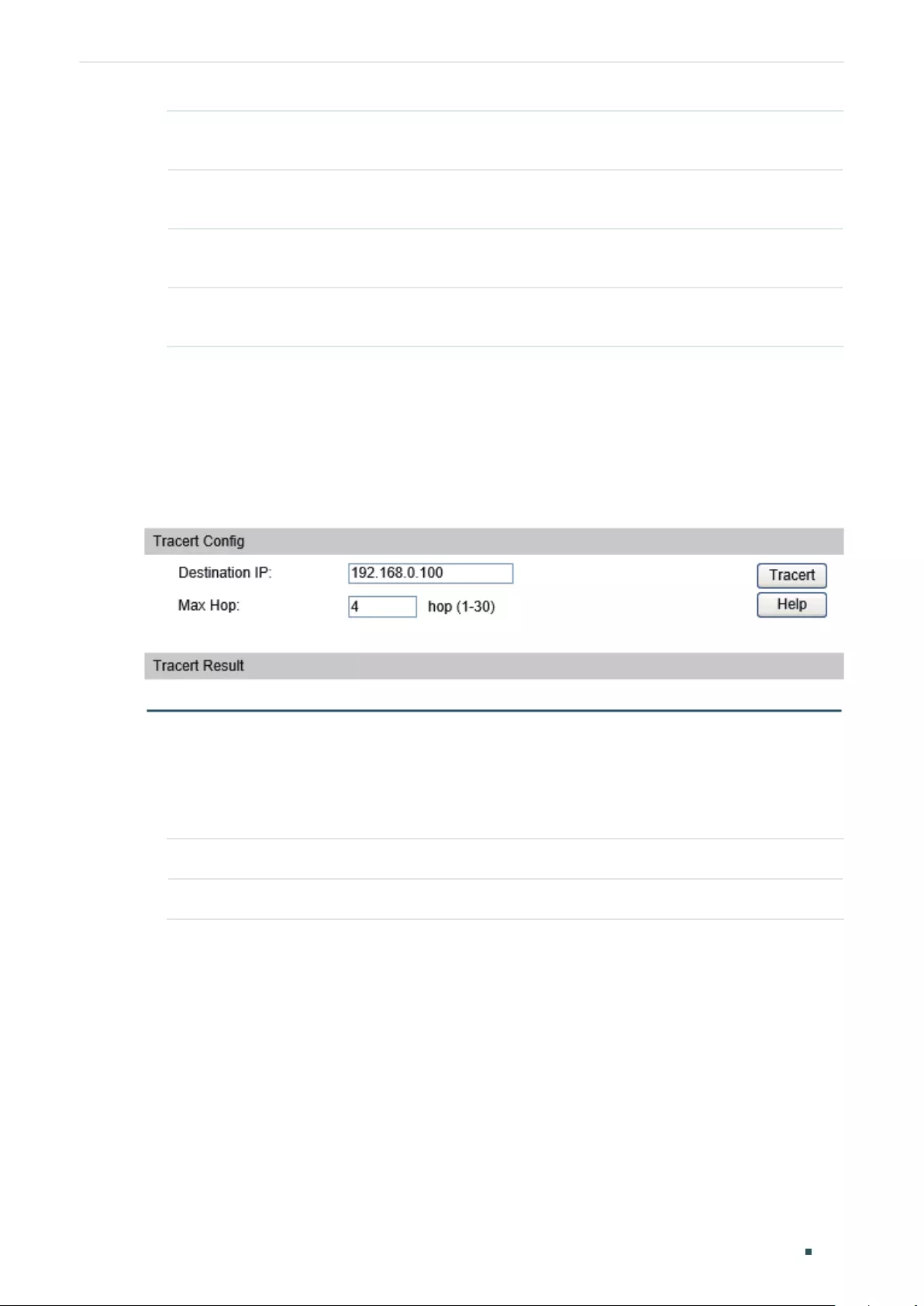
Configuring Maintenance Diagnosing the Network
Configuration Guide 913
Destination IP Enter the IP address of the destination node for Ping test. Both IPv4 and IPv6 are
supported.
Ping Times Enter the amount of times to send test data for Ping test. We recommend that you
keep the default 4 times.
Data Size Enter the size of the sending data for Ping test. We recommend that you keep the
default 64 bytes.
Interval Specify the interval to send ICMP request packets. We recommend that you keep
the default 1000 milliseconds.
2) In the Ping Result section, check the test results.
6.1.2 Configuring the Tracert Test
Choose the menu Maintenance > Network Diagnose > Tracert to load the following page.
Figure 6-2 Configuring the Tracert Test
Follow these steps to test connectivity between the switch and routers along the path from
the source to the destination:
1) In the Tracert Config section, enter the IP address of the destination, set the max hop,
and then click Tracert to start the test.
Destination IP Enter the IP address of the destination device. Both IPv4 and IPv6 are supported.
Max Hop Specify the maximum number of the route hops the test data can pass through.
2) In the Tracert Result section, check the test results.

Configuration Guide 914
Configuring Maintenance Diagnosing the Network
6.2 Using the CLI
6.2.1 Configuring the Ping Test
On privileged EXEC mode or any other configuration mode, you can use the following
command to test the connectivity between the switch and one node of the network.
ping [ ip | ipv6 ] {
ip_addr
} [ -n
count
] [ -l
count
] [ -i
count
]
Test the connectivity between the switch and destination device.
ip: The type of the IP address for ping test should be IPv4.
ipv6: The type of the IP address for ping test should be IPv6.
ip_addr:
The IP address of the destination node for ping test. If the parameter ip/ipv6 is not selected, both
IPv4 and IPv6 addresses are supported, such as 192.168.0.100 or fe80::1234.
-n
count
: Specify the amount of times to send test data for Ping testing. The values are from 1 to 10 times;
the default is 4 times.
-l
count
: Specify the size of the sending data for ping testing. The values are from 1 to 1500 bytes; the
default is 64 bytes.
-i
count:
Specify the interval to send ICMP request packets. The values are from 100 to 1000 milliseconds;
the default is 1000 milliseconds.
The following example shows how to test the connectivity between the switch and the
destination device with the IP address 192.168.0.10. Specify the ping times as 3, the data
size as 1000 bytes and the interval as 500 milliseconds:
Switch#ping ip 192.168.0.10 -n 3 -l 1000 -i 500
Pinging 192.168.0.10 with 1000 bytes of data :
Reply from 192.168.0.10 : bytes=1000 time<16ms TTL=64
Reply from 192.168.0.10 : bytes=1000 time<16ms TTL=64
Reply from 192.168.0.10 : bytes=1000 time<16ms TTL=64
Ping statistics for 192.168.0.10:
Packets: Sent = 3 , Received = 3 , Lost = 0 (0% loss)
Approximate round trip times in milli-seconds:
Minimum = 0ms , Maximum = 0ms , Average = 0ms

Configuring Maintenance Diagnosing the Network
Configuration Guide 915
6.2.2 Configuring the Tracert Test
On privileged EXEC mode or any other configuration mode, you can use the following
command to test the connectivity between the switch and routers along the path from the
source to the destination:
tracert [ ip | ipv6 ] ip_addr [ maxHops ]
Test the connectivity of the gateways along the path from the source to the destination.
ip: The type of the IP address for tracert test should be IPv4.
ipv6: The type of the IP address for tracert test should be IPv6.
ip_addr:
Enter the IP address of the destination device. If the parameter ip/ipv6 is not selected, both IPv4
and IPv6 addresses are supported, such as 192.168.0.100 or fe80::1234.
maxHops
: Specify the maximum number of the route hops the test data can pass though. The range is 1 to
30 hops; the default is 4 hops.
The following example shows how to test the connectivity between the switch and the
network device with the IP address 192.168.0.100. Set the maxhops as 2:
Switch#tracert 192.168.0.100 2
Tracing route to 192.168.0.100 over a maximum of 2 hops
1 8 ms 1 ms 2 ms 192.168.1.1
2 2 ms 2 ms 2 ms 192.168.0.100
Trace complete.

Configuration Guide 916
Configuring Maintenance DLDP Configuration
7 DLDP Configuration
7.1 Using the GUI
Choose the menu Maintenance > DLDP > DLDP Config to load the following page.
Figure 7-1 DLDP Config
Follow these steps to configure DLDP:
1) In the Global Config section, enable DLDP and configure the relevant parameters. Click
Apply.

Configuring Maintenance DLDP Configuration
Configuration Guide 917
DLDP State Enable or disable DLDP globally.
Adver Interval Configure the interval to send advertisement packets. The valid values are from 1
to 30 seconds, and the default value is 5 seconds.
Shut Mode Choose how to shut down the port when a unidirectional link is detected:
Auto: When an unidirectional link is detected on a port, DLDP will generate logs
and traps and shut down the port, and the DLDP link state will transit to Disable.
Manual: When an unidirectional link is detected on a port, DLDP will generate logs
and traps, and then the users can manually shut down the unidirectional link ports.
Web Refresh
State
Enable or disable the web automatic refresh function.
Web Refresh
Interval
Configure the interval to refresh the web page. The valid values are from 1 to 100
seconds, and the default value is 5 seconds.
Interval Specify the interval to send ICMP request packets. We recommend that you keep
the default 1000 milliseconds.
2) In the Port Config section, select one or more ports, enable DLDP and click Apply.
Then you can view the relevant DLDP information in the table.
DLDP State Enable or disable DLDP on the port.
Protocol State Displays the DLDP protocol state.
Initial: DLDP is disabled.
Inactive: DLDP is enabled but the link is down.
Active: DLDP is enabled and the link is up, or the neighbor entries in this device are
empty.
Advertisement: No unidirectional link is detected: this device establishes
bidirectional links with all its neighbors, or DLDP remains in Active state for more
than 5 seconds.
Probe: In this state, the device will send out Probe packets to detect whether the
link is unidirectional. The port enters this state from the Active state if it receives a
packet from an unknown neighbor.
Disable: A unidirectional link is detected.
Link State Displays the link state.
Link-Down: The link is down.
Link-Up: The link is up.

Configuration Guide 918
Configuring Maintenance DLDP Configuration
Neighbour
State
Displays the neighbor state.
Unknown: Link detecting is in progress.
Unidirectional: The link between the port and the neighbor is unidirectional.
Bidirectional: The link between the port and the neighbor is bidirectional.
7.2 Using the CLI
Follow these steps to configure DLDP:
Step 1 configure
Enter global configuration mode.
Step 2 dldp
Globally enable DLDP.
Step 3 dldp interval
interval-time
Configure the interval of sending advertisement packets on ports that are in the
advertisement state.
interval-time
:
Specify the interval time. The valid values are from 1 to 30 seconds. By default,
it is 5 seconds.
Step 3 dldp shut-mode { auto | manual }
Configure the DLDP shutdown mode when a unidirectional link is detected.
auto:
The switch automatically shuts down ports when a unidirectional link is detected. It is
the default setting.
manual:
The switch displays an alert when a unidirectional link is detected. Then the users
can manually shut down the unidirectional link ports..
Step 4 interface {fastEthernet
port
| range fastEthernet
port-list
| gigabitEthernet
port
| range
gigabitEthernet
port-list
}
Enter interface configuration mode.
Step 5 dldp
Enable DLDP on the specified port.
Step 6 show dldp
Verify the global DLDP configuration.
Step 7 show dldp interface
Verify the DLDP configuration of the ports.
Step 8 end
Return to privileged EXEC mode.

Configuring Maintenance DLDP Configuration
Configuration Guide 919
Step 9 copy running-config startup-config
Save the settings in the configuration file.
The following example shows how to enable DLDP globally, configure the DLDP interval as
10 seconds and specify the shutdown mode as auto.
Switch#configure
Switch(config)#dldp
Switch(config)#dldp interval 10
Switch(config)#dldp shut-mode auto
Switch(config)#show dldp
DLDP Global State: Enable
DLDP Message Interval: 10
DLDP Shut Mode: Auto
Switch(config)#end
Switch#copy running-config startup-config
The following example shows how to enable DLDP on port 1/0/1.
Switch#configure
Switch(config)#interface gigabitEthernet 1/0/1
Switch(config-if)#dldp
Switch(config-if)#show dldp interface
Port DLDP State Protocol State Link State Neighbor State
---- ---------- -------------- ---------- --------------
Gi1/0/1 Enable Inactive Link-Down N/A
Gi1/0/2 Disable Initial Link-Down N/A
Gi1/0/3 Disable Initial Link-Down N/A
Gi1/0/4 Disable Initial Link-Down N/A
Switch(config-if)#end
Switch#copy running-config startup-config
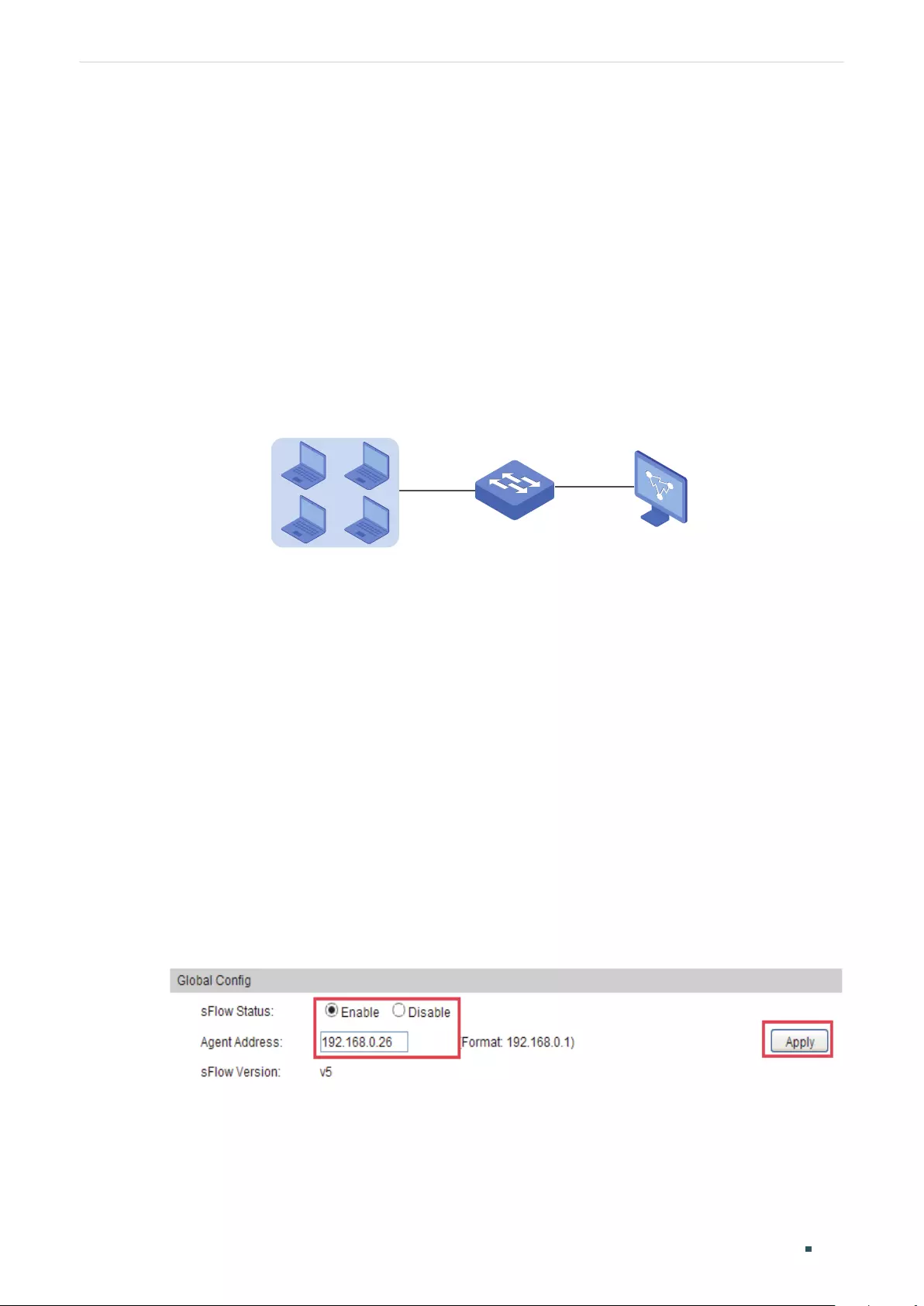
Configuration Guide 920
Configuring Maintenance Configuration Examples
8 Configuration Examples
8.1 Example for Configuring SFlow
8.1.1 Network Requirements
The company network manager needs to monitor and analyze the network usage in
department A.
Figure 8-1 Network Topology
IP: 192.168.0.26/24 IP: 192.168.0.27/24
Department A
Switch PC
Gi1/0/1 Gi1/0/2
8.1.2 Configuration Scheme
The network manager can configure sFlow to monitor and analyze the network. Set the
switch as the sFlow agent that collects traffic data on port 1/0/1, and configure an sFlow
collector on the PC to process sFlow packets and display results.
Demonstrated with T2600G-52TS, this chapter provides configuration procedures in two
ways: using the GUI and Using the CLI.
8.1.3 Using the GUI
1) Choose the menu Maintenance > SFlow > SFlow Collector to load the following page.
In the Global Config section, enable sFlow, set the switch IP address 192.168.0.26 as
the agent address, and click Apply.
Figure 8-2 SFlow Collector Global Config
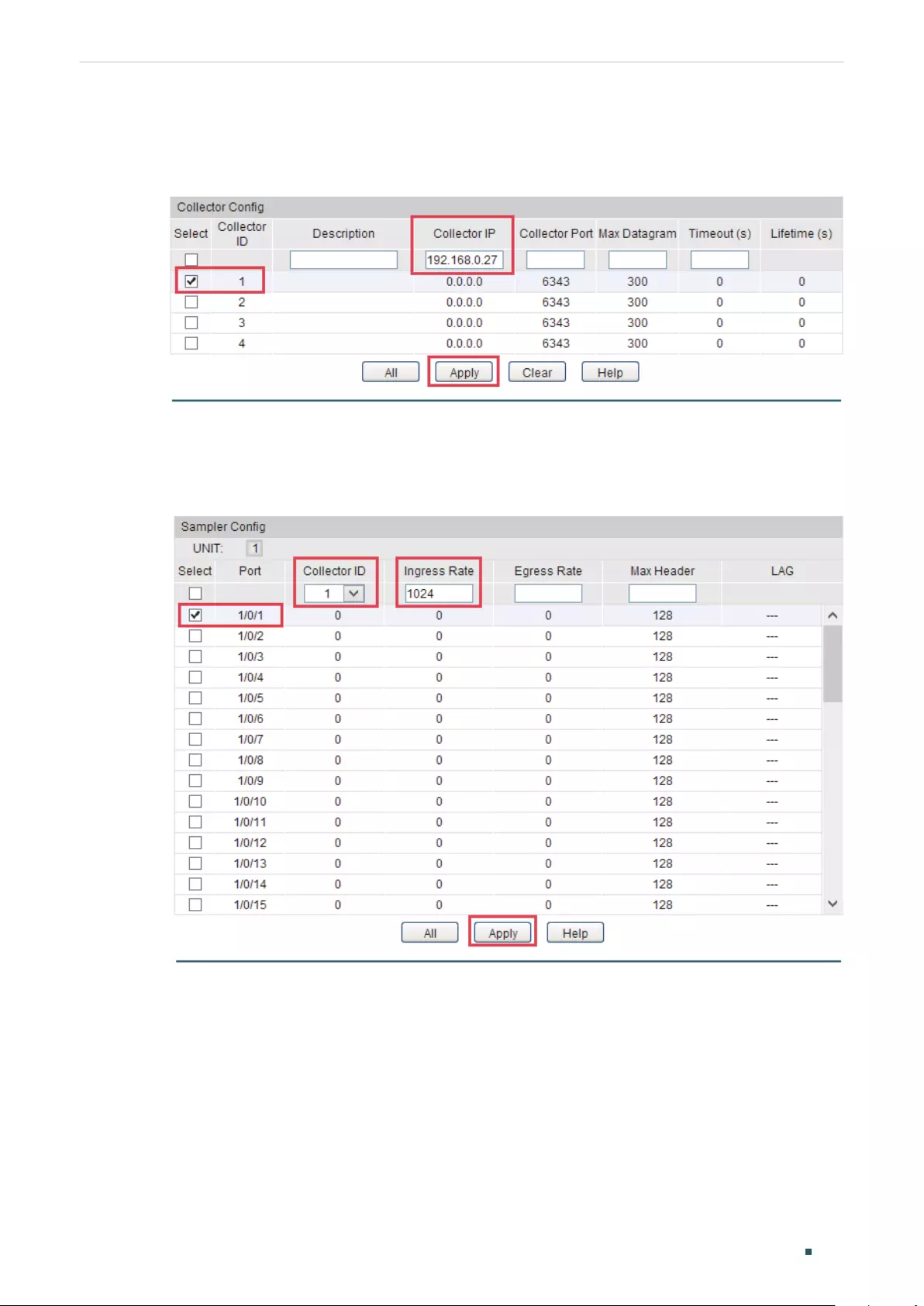
Configuring Maintenance Configuration Examples
Configuration Guide 921
In the Collector Config section, select Collector 1, enter the PC IP address
192.168.0.27 as the collector IP address, and click Apply.
Figure 8-3 Collector Config
2) Choose the menu Maintenance > SFlow > SFlow Sampler to load the following page.
Select collector 1 for port 1/0/1, set the ingress rate as 1024, and then click Apply.
Figure 8-4 SFlow Sampler Config
8.1.4 Using the CLI
1) Configure the sFlow collector.
Switch#configure
Switch(config)#sflow address 192.168.0.26
Switch(config)#sflow enable
Switch(config)#sflow collector collector-ID 1 ip 192.168.0.27

Configuration Guide 922
Configuring Maintenance Configuration Examples
Switch(config)# sflow collector collector-ID 1 port 6343
2) Configure the sFlow sampler.
Switch(config)#interface gigabitEthernet 1/0/1
Switch(config-if)#sflow sampler collector-ID 1
Switch(config-if)#sflow sampler ingRate 1024
Switch(config-if)#end
Switch#copy running-config startup-config
Verify the Configurations
Verify the configuration of global sFlow:
Switch#show sflow global
sFlow Status: Enable
Agent Address: 192.168.0.26
sFlow Version: v5
Verify the configuration of sFlow collector:
Switch#show sflow collector
Collector Col-IP Col-Port MaxData Timeout Lifetime Description
-------- -------------- -------- -------- -------- -------- -----------
1 192.168.0.27 6343 300 0 0
2 0.0.0.0 6343 300 0 0
3 0.0.0.0 6343 300 0 0
4 0.0.0.0 6343 300 0 0
Verify the configuration of sFlow sampler:
Switch#show sflow sampler
Port Collector IngRate EgRate MaxHeader LAG
---------- ---------- ---------- ---------- ---------- ---
Gi1/0/1 1 1024 0 128 N/A
Gi1/0/2 0 0 0 128 N/A
......

Configuring Maintenance Configuration Examples
Configuration Guide 923
8.2 Example for Configuring Remote Log
8.2.1 Network Requirements
The company network manager needs to monitor network of department A for
troubleshooting.
Figure 8-1 Network Topology
IP: 1.1.0.2/16 IP: 1.1.0.1/16
Department A
Switch PC
8.2.2 Configuration Scheme
The network manager can configure the remote log to receive system logs from monitored
devices. Make sure the switch and the PC are reachable to each other; configure a log
server that complies with the syslog standard on the PC and set the PC as the log host.
Demonstrated with T2600G-52TS, this chapter provides configuration procedures in two
ways: using the GUI and Using the CLI.
8.2.3 Using the GUI
1) Choose the menu Maintenance > Log > Remote Log to load the following page. Enable
host 1, and set the PC IP address 1.1.0.1 as the host IP address, and the severity as
level_5; click Apply.
Figure 8-2 Remote Log Host
8.2.4 Using the CLI
Configure the remote log host.
Switch#configure

Configuration Guide 924
Configuring Maintenance Configuration Examples
Switch(config)# logging host index 1 1.1.0.1 5
Switch(config)#end
Switch#copy running-config startup-config
Verify the Configurations
Switch# show logging loghost
Index Host-IP Severity Status
----- ------- -------- ------
1 1.1.0.1 5 enable
2 0.0.0.0 6 disable
3 0.0.0.0 6 disable
4 0.0.0.0 6 disable

Configuring Maintenance Appendix: Default Parameters
Configuration Guide 925
9 Appendix: Default Parameters
Default settings of maintenance are listed in the following tables.
Table 9-1 Default Settings of Local Log
Parameter Default Setting
Status of Log Buffer Enabled
Severity of Log Buffer Level_6
Sync-Periodic of Log
Buffer
Immediately
Status of Log File Disabled
Severity of Log File Level_3
Sync-Periodic of Log
File
24 hours
Table 9-2 Default Settings of Remote Log
Parameter Default Setting
Host IP 0.0.0.0
UDP Port 514
Severity Level_6
Status Disabled
Table 9-3 Default Settings of Ping Config
Parameter Default Setting
Destination IP 192.168.0.1
Ping Times 4
Data Size 64 bytes
Interval 1000
milliseconds
Table 9-4 Default Settings of Tracert Config
Parameter Default Setting
Destination IP 192.168.0.100
Max Hop 4 hops
Table 9-5 Default Settings of DLDP
Parameter Default Setting
Global Config

Configuration Guide 926
Configuring Maintenance Appendix: Default Parameters
Parameter Default Setting
DLDP State Disable
Adver Interval 5 seconds
Shut Mode Auto
Web Refresh State Disable
Web Refresh Interval 5 seconds
Port Config
DLDP State Disable

Configuration Guide 928
Configuring SNMP & RMON SNMP Overview
1 SNMP Overview
SNMP (Simple Network Management Protocol) is a standard network management
protocol, widely used on TCP/IP networks. It facilitates device management using NMS
(Network Management System) software. With SNMP, network managers can view or
modify network device information, and troubleshoot according to notifications sent by
those devices in a timely manner.
The device supports three SNMP versions: SNMPv1, SNMPv2c and SNMPv3.Table 1-1
lists features supported by different SNMP versions, and Table 1-2 shows corresponding
application scenarios.
Table 1-1 Features Supported by Different SNMP Versions
Feature SNMPv1 SNMPv2c SNMPv3
Access Control Based on SNMP
Community and MIB View
Based on SNMP
Community and MIB View
Based on SNMP User,
Group, and MIB View
Authentication
and Privacy
Based on Community
Name
Based on Community
Name
Supported authentication
and privacy modes are as
follows:
Authentication: MD5/SHA
Privacy: DES
Trap Supported Supported Supported
Inform Not supported Supported Supported
Table 1-2 Application Scenarios of Different Versions
Version Application Scenario
SNMPv1
Applicable to small-scale networks with simple networking, low security
requirements or good stability (such as campus networks and small enterprise
networks).
SNMPv2c
Applicable to medium and large-scale networks with low security requirements
and those with good security (such as VPNs), but with busy services in which
the traffic congestion may occur. You can configure Inform to ensure that the
notifications from managed devices are received by network managers.
SNMPv3
Applicable to networks of various scales, particularly those that have high
security requirements and require devices to be managed by authenticated
administrators (such as when data needs to be transferred on public networks).

Configuring SNMP & RMON SNMP Configurations
Configuration Guide 929
2 SNMP Configurations
To complete the SNMP configuration, choose an SNMP version according to network
requirements and supportability of the NMS software, and then follow these steps:
Choose SNMPv3
1) Enable SNMP.
2) Create an SNMP view for managed objects.
3) Create an SNMP group, and specify the access rights.
4) Create SNMP users, and configure the authentication mode, privacy mode and
corresponding passwords.
Choose SNMPv1 or SNMPv2c
1) Enable SNMP.
2) Create an SNMP view for managed objects.
3) Direct configuration: Create a community, specify the accessible view and the
corresponding access rights.
Indirect configuration: See steps 3) and 4) of Choose SNMPv3. In this situation, the user
name functions as the community name, and the Read/Write View is the same for the
user and the group.

Configuration Guide 930
Configuring SNMP & RMON SNMP Configurations
2.1 Using the GUI
2.1.1 Enabling SNMP
Choose the SNMP > SNMP Config > Global Config to load the following page.
Figure 2-1 Global Config
Follow these steps to configure SNMP globally:
1) In the Global Config section, enable SNMP. Click Apply.
2) In the Local Engine section, configure the local engine ID. Click Apply.
Local Engine ID Set the ID of the local SNMP Agent with 10 to 64 hexadecimal digits.
The local engine ID is a unique alphanumeric string used to identify the SNMP
engine on the switch.
3) In the Remote Engine section, configure the remote engine ID. Click Apply.
Remote Engine ID Set the ID of the remote SNMP manager with 10 to 64 hexadecimal digits. If no
remote SNMP manager is needed, you can leave this field empty.
The remote engine ID is a unique alphanumeric string. It is used to identify the
SNMP engine on the remote device thats receives inform messages from Switch.
Note:
The engine ID must contain an even number of characters.
2.1.2 Creating an SNMP View
Create an SNMP view, and configure the content of the view. NMS (Network Management
System) manages MIB (Management Information Base) variables based on the SNMP view.
Choose the menu SNMP > SNMP Config > SNMP View to load the following page.
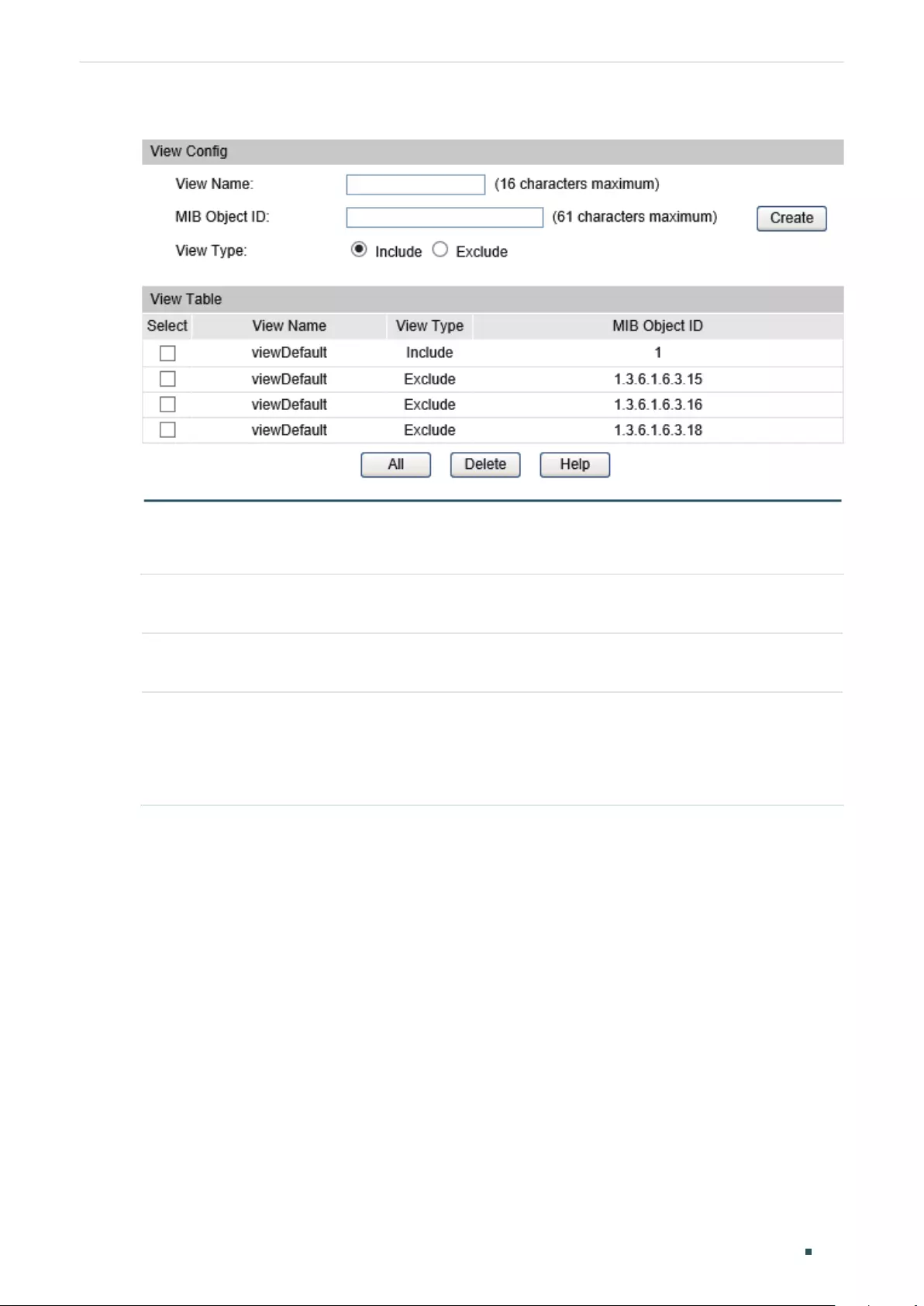
Configuring SNMP & RMON SNMP Configurations
Configuration Guide 931
Figure 2-2 SNMP View
Set the view name and one MIB variable that is related to the view. Choose the view type
and click Create to add the view entry.
View Name Set the view name with 1 to 16 characters. A complete view consists of all MIB objects
that have the same view name.
MIB Object ID Enter a MIB Object ID to specify a specific function of the device. For specific ID rules,
refer to the device related MIBs.
View Type Set the view to include or exclude the related MIB object. By default, it is included.
Include: The NMS can view or manage the function indicated by the object.
Exclude: The NMS cannot view or manage the function indicated by the object.
2.1.3 Creating an SNMP Group
Create an SNMP group and configure related parameters.

Configuration Guide 932
Configuring SNMP & RMON SNMP Configurations
Choose the menu SNMP > SNMP Config > SNMP Group to load the following page.
Figure 2-3 SNMP Group
Follow these steps to create an SNMP Group:
1) Set the group name and security model. If you choose SNMPv3 as the security model,
you need to further configure security level.
Group Name Set the SNMP group name. You may enter 1 to 16 characters.
The identifier of a group consists of a group name, security model and security
level. Groups of the same identifier are recognized as being in the same group.
Security Model Choose the corresponding SNMP version of the security model. By default, it is
SNMPv1.
v1: The security model of the group is SNMPv1. In this mode, community name
match is used for authentication. You can configure the community name on the
SNMP community page.
v2c: The security model of the group is SNMPv2. In this mode, community name
match is used for authentication. You can configure the community name on the
SNMP community page.
v3: The security model of the group is SNMPv3. In this mode, USM (User-Based
Security Model) is used for authentication.
Security Level Set the security level which for the SNMPv3 group. The default is noAuthNoPriv.
noAuthNoPriv: No authentication mode or privacy mode is applied to check or
encrypt packets.
authNoPriv: An authentication mode is applied to check packets, but no privacy
mode is applied to encrypt them.
authPriv: An authentication mode and a privacy mode are applied to check and
encrypt packets.
2) Set the read, write and notify view of the SNMP Group. Click Create.
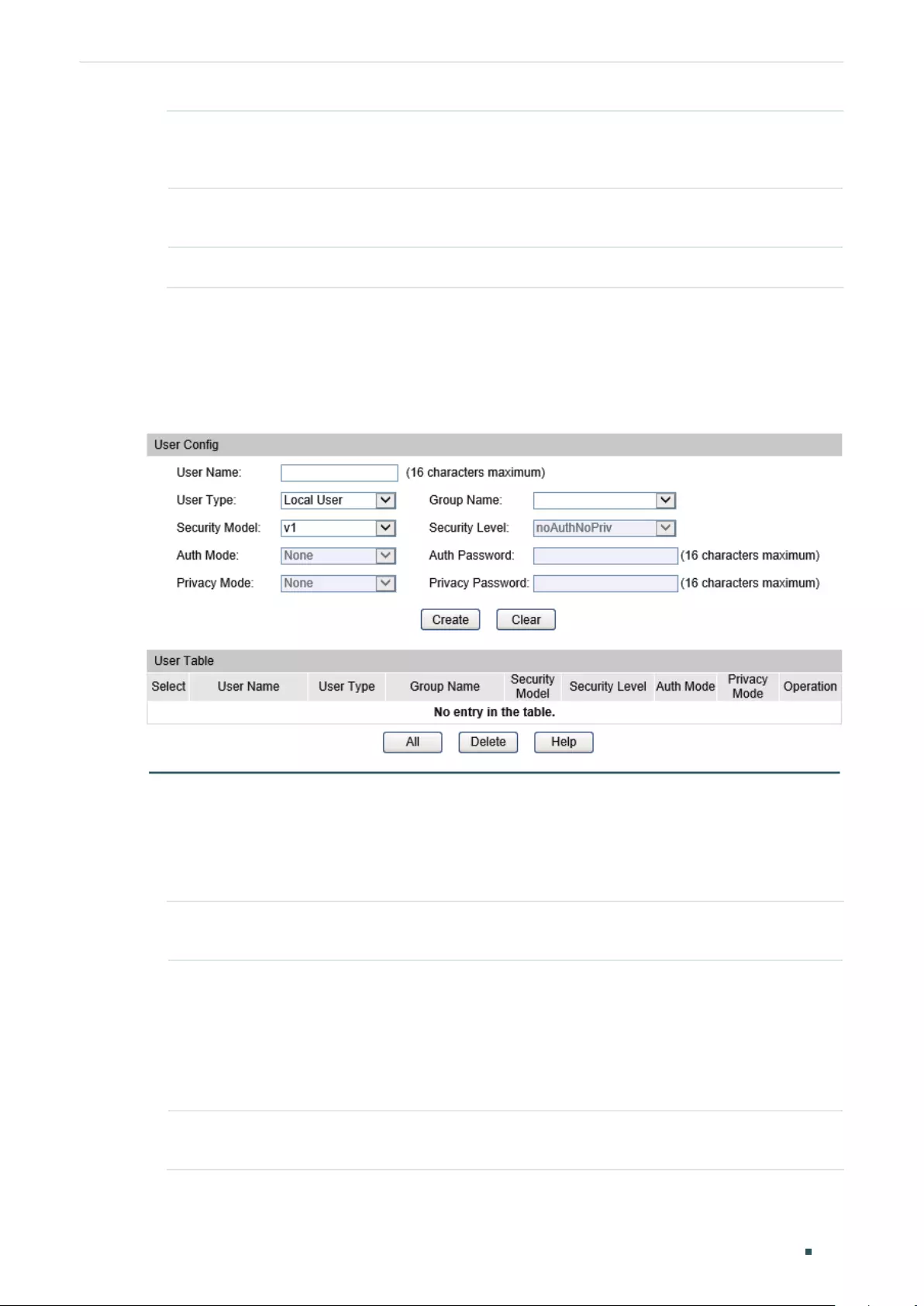
Configuring SNMP & RMON SNMP Configurations
Configuration Guide 933
Read View Choose a view to allow parameters to be viewed but not modified by the NMS.
The view is necessary for any group. By default, the view is viewDefault. To modify
parameters of a view, you need to add it to Write View.
Write View Choose a view to allow parameters to be modified but not viewed by the NMS.
The default is none. The view in Write View should also be added to Read View.
Notify View Choose a view to allow it to send notifications to the NMS.
2.1.4 Creating SNMP Users
Choose the menu SNMP > SNMP Config > SNMP User to load the following page.
Figure 2-4 SNMP User
Follow these steps to create an SNMP user:
1) Specify the user name, user type and the group which the user belongs to. Set the
security model according to the related parameters of the specified group. If you
choose SNMPv3, you need to configure the security level.
User Name Set the SNMP user name. You may use 1 to 16 characters. For different entries,
user names cannot be the same.
User Type Choose a user type to indicate the location of the user. The default is Local User.
Local User: The user resides on the local engine, which is the SNMP Agent of the
switch.
Remote User: The user resides on a remote engine, which is the SNMP Agent of
some other device. For this user type, you need to set the remote engine ID first.
Group Name Choose the group that the user belongs to. Users with the same Group Name,
Security Model and Security Level will be in the same group.

Configuration Guide 934
Configuring SNMP & RMON SNMP Configurations
Security Model Choose the SNMP version of the security model. The default is SNMPv1. The
setting should be identical with that of the specified group.
v1: The group’s security model is SNMPv1.
v2c: In this mode, Community Name is used for authentication. You can configure
Community Name on the SNMP Community.
v3: The group’s security model is SNMPv3.
Security Level Set the security level for the SNMPv3 group. The default is noAuthNoPriv.
noAuthNoPriv: No authentication mode or privacy mode is applied to check or
encrypt packets.
authNoPriv: An authentication mode is applied to check packets, but no privacy
mode is applied to encrypt them.
authPriv: An authentication mode and a privacy mode are applied to check and
encrypt packets.
2) If you have chosen authNoPriv or authPriv as the security level, you need to set
corresponding Auth Mode or Privacy Mode. If not, skip the step.
Auth Mode If you have chosen authNoPriv as the security level, you need to set Auth Mode,
which is None by default.
MD5: Enable the HMAC-MD5 algorithm for authentication.
SHA: Enable the SHA (Secure Hash Algorithm) algorithm for authentication. SHA
algorithm is securer than MD5 algorithm.
Auth Password Set the password for authentication.
Privacy Mode If you have chosen authPriv as the security level, you need to set both Auth Mode
and Privacy Mode. The privacy mode is None by default.
DES: Enable the DES (Data Encryption Standard) algorithm for privacy.
Privacy Password Set the password for encryption.
3) Click Create.
2.1.5 Creating SNMP Communities
If you want to use SNMPv1 or SNMPv2c as the security model, you can create SNMP
communities directly.
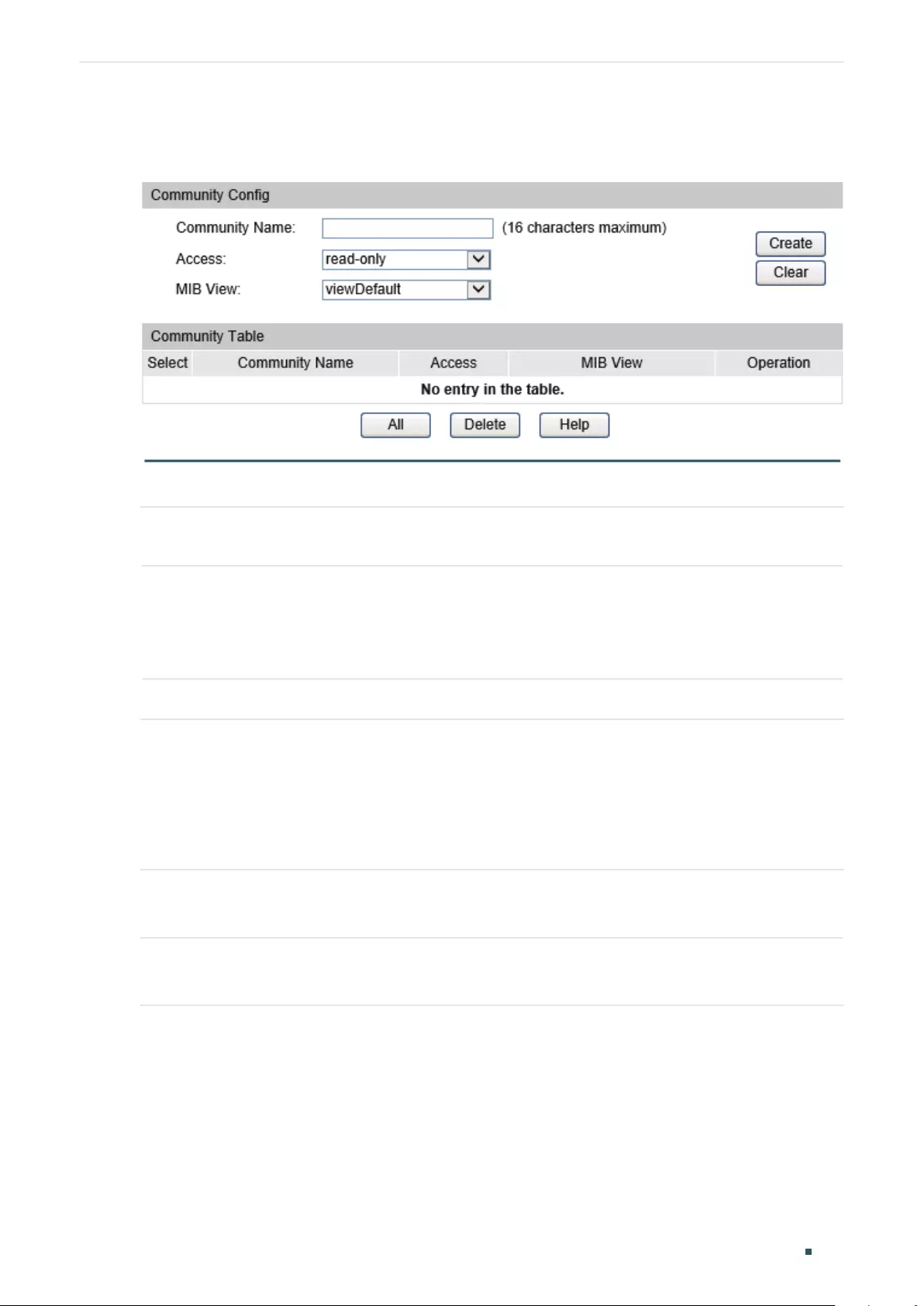
Configuring SNMP & RMON SNMP Configurations
Configuration Guide 935
Choose the menu SNMP > SNMP Config > SNMP Community to load the following page.
Figure 2-5 SNMP Community
Set the community name, access rights and the related view. Click Create.
Community Name Set the community name with 1 to 16 characters. For SNMPv1 and SNMPv2c, the
community name match is used for authentication.
Access Specify the access right to the related view. The default is read-only.
read-only: The NMS can view but not modify parameters of the specified view.
read-write: The NMS can view and modify parameters of the specified view.
MIB View Choose a view to allow it to be accessed by the community. The default is viewDefault.
2.2 Using the CLI
2.2.1 Enabling SNMP
Step 1 configure
Enter global configuration mode.
Step 2 snmp-server
Enabling SNMP.

Configuration Guide 936
Configuring SNMP & RMON SNMP Configurations
Step 3 snmp-server engineID {[ local
local-engineID
] [remote
remote-engineID
]}
(Optional) Configure the local engine ID and the remote engine ID.
local-engineID:
Enter the local engine ID with 10 to 64 hexadecimal digits. The ID must contain
an even number of characters. It is a unique alphanumeric string, used to identify the SNMP
engine on the switch.
remote-engineID:
Enter the remote engine ID with 10 to 64 hexadecimal digits. The ID must
contain an even number of characters. The remote engine ID is a unique alphanumeric string. It
is used to identify the SNMP engine on the remote device that receives inform messages from
Switch.
Note that the switch will automatically generate a local engine ID if the ID is not set or is
deleted.
Step 4 show snmp-server
Displays the global settings of SNMP.
Step 5 show smnp-server engineID
Displays the engine ID of SNMP.
Step 6 end
Return to privileged EXEC mode.
Step 7 copy running-config startup-config
Save the settings in the configuration file.
The following example shows how to enable SNMP and set 123456789a as the remote
engine ID:
Switch#configure
Switch(config)#snmp-server
Switch(config)#snmp-server engineID remote 123456789a
Switch(config)#show snmp-server
SNMP agent is enabled.
0 SNMP packets input
0 Bad SNMP version errors
0 Unknown community name
0 Illegal operation for community name supplied
0 Encoding errors
0 Number of requested variables
0 Number of altered variables
0 Get-request PDUs

Configuring SNMP & RMON SNMP Configurations
Configuration Guide 937
0 Get-next PDUs
0 Set-request PDUs
0 SNMP packets output
0 Too big errors(Maximum packet size 1500)
0 No such name errors
0 Bad value errors
0 General errors
0 Response PDUs
0 Trap PDUs
Switch(config)#show snmp-server engineID
Local engine ID : 80002e5703000aeb132397
Remote engine ID: 123456789a
Switch(config)#end
Switch#copy running-config startup-config
2.2.2 Creating an SNMP View
Specify the OID (Object Identifier) of the view to determine objects to be managed.
Step 1 configure
Enter global configuration mode.
Step 2 snmp-server view
name mib-oid
{include | exclude}
Configure the view.
name :
Enter a view name with 1 to 16 characters.You can create multiple entries with each
associated to a MIB object. A complete view consists of all MIB objects that have the same
view name.
mib-oid :
Enter the MIB object ID with 1 to 61 characters.
include|exclude : Specify a view type. Include indicates that objects of the view can be
managed by the NMS, while exclude indicates that objects of the view cannot be managed
by the NMS.
Step 3 show snmp-server view
Displays the view table.
Step 4 end
Return to Privileged EXEC Mode.

Configuration Guide 938
Configuring SNMP & RMON SNMP Configurations
Step 5 copy running-config startup-config
Save the settings in the configuration file.
The following example shows how to set a view to allow the NMS to manage all function.
Name the view as View:
Switch#configure
Switch(config)#snmp-server view View 1 include
Switch(config)#show snmp-server view
No. View Name Type MOID
--- ------------ ------- ----
1 viewDefault include 1
2 viewDefault exclude 1.3.6.1.6.3.15
3 viewDefault exclude 1.3.6.1.6.3.16
4 viewDefault exclude 1.3.6.1.6.3.18
5 View include 1
Switch(config)#end
Switch#copy running-config startup-config
2.2.3 Creating an SNMP Group
Create an SNMP group and set user access control with read, write and notify views.
Meanwhile, set the authentication and privacy modes to secure the communication
between the NMS and managed devices.
Step 1 configure
Enter global configuration mode.

Configuring SNMP & RMON SNMP Configurations
Configuration Guide 939
Step 2 snmp-server group
name
[ smode {v1 | v2c | v3}] [ slev {noAuthNoPriv | authNoPriv |
authPriv}] [ read
read-view
] [ write
write-view
] [ notify
notify-view
]
Set an SNMP group.
name
:
Enter the group name with 1 to 16 characters. The identifier of a group consists of a
group name, security model and security level. Groups of the same identifier are recognized
as being in the same group.
v1 | v2c | v3 :
Choose a security mode for the SNMP group from the following: SNMPv1,
SNMPv2c, SNMPv3. The default is v1.
noAuthNoPriv | authNoPriv | authPriv :
For groups of SNMPv3, choose a security level
among noAuthNoPriv (no authorization and no encryption), authNoPriv (authorization and
no encryption), authPriv (authorization and encryption). The default is noAuthNoPriv. Please
note that if you have chosen v1 or v2c as the security mode, the security level cannot be
configured.
read-view :
Set the view as read-only. And then the NMS can view parameters of the
specified view.
write-view :
Set the view as write-only. And then the NMS can modify parameters of the
specified view. Please note that the view in write-view should also be in read-view.
notify-view :
Set the view as notify-only view. And then the NMS can get notifications of the
specified view from the agent.
Step 3 show snmp-server group
Displays SNMP group entries.
Step 4 end
Return to Privileged EXEC Mode.
Step 5 copy running-config startup-config
Save the settings in the configuration file.
The following example shows how to create an SNMPv3 group. Name the group as nms-
monitor, enable Auth Mode and Privacy Mode, and set the view as read View and notify
View:
Switch#configure
Switch(config)#snmp-server group nms-monitor smode v3 slev authPriv read View
notify View
Switch(config)#show snmp-server group
No. Name Sec-Mode Sec-Lev Read-View Write-View Notify-View
--- --------------- -------- ------- --------- ---------- -----------
1 nms-monitor v3 authPriv View View
Switch(config)#end
Switch#copy running-config startup-config

Configuration Guide 940
Configuring SNMP & RMON SNMP Configurations
2.2.4 Creating SNMP Users
Configure users of the SNMP group. Users belong to the group, and use the same security
level and access rights as the group.
Step 1 configure
Enter global configuration mode.
Step 2 snmp-server user
name
{ local | remote }
group-name
[ smode { v1 | v2c | v3 }] [ slev {
noAuthNoPriv | authNoPriv | authPriv }] [ cmode { none | MD5 | SHA }] [ cpwd
confirm-pwd
] [
emode { none | DES }] [ epwd
encrypt-pwd
]
Configure users of the SNMP group.
name :
Enter the user name with 1 to 16 characters.
local | remote :
Choose a user type. Local indicates that the user is connected to a local
SNMP engine, while remote means that the user is connected to a remote SNMP engine.
group-name :
Enter the name of the group which the user belongs to. The group is
determined by the group name, security mode and security level.
v1 | v2c | v3 :
Choose a security mode for the SNMP group from the following: SNMPv1,
SNMPv2c, SNMPv3.
noAuthNoPriv | authNoPriv | authPriv :
For SNMPv3 groups, choose a security level from
noAuthNoPriv (no authorization and no encryption), authNoPriv (authorization and no
encryption), authPriv (authorization and encryption). The defaut is noAuthNoPriv. Please
note that if you have chosen v1 or v2c as the security mode, security level cannot be
configured.
none | MD5 | SHA :
Choose an authentication algorithm which is only for the user of
SNMPv3. SHA authentication mode has a higher security than MD5 mode. By default, the
Authentication Mode is none.
confirm-pwd :
Enter an authentication password with 1 to 16 characters excluding question
mark and space. This password in the configuration file will be displayed in the symmetric
encrypted form.
none | DES :
Choose a privacy mode which is only for the user of SNMPv3. None indicates
no privacy method is used, and DES indicates DES encryption method is used. By default,
the Privacy Mode is none. Please note that if you have chosen v1 or v2c as the security
mode, the privacy mode cannot be configured.
encrypt-pwd :
Enter a privacy password with 1 to 16 characters excluding question mark
and space. This password in the configuration file will be displayed in the symmetric
encrypted form.
Step 3 show snmp-server user
Displays the information of SNMP users.
Step 4 end
Return to privileged EXEC mode.
Step 5 copy running-config startup-config
Save the settings in the configuration file.
The following example shows how to create an SNMP user on the switch. Name the user
as admin, and set the user as a remote user, SNMPv3 as the security mode, authPriv as the

Configuring SNMP & RMON SNMP Configurations
Configuration Guide 941
security level, SHA as the authentication algorithm, 1234 as the authentication password,
DES as the privacy algorithm and 1234 as the privacy password:
Switch#configure
Switch(config)#snmp-server user admin remote nms-monitor smode v3 slev authPriv
cmode SHA cpwd 1234 emode DES epwd 1234
Switch(config)#show snmp-server user
No. U-Name U-Type G-Name S-Mode S-Lev A-Mode P-Mode
--- ------ ------ ------ ------ ----- ------ ------
1 admin remote nms-monitor v3 authPriv SHA DES
Switch(config)#end
Switch#copy running-config startup-config
2.2.5 Creating SNMP Communities
For SNMPv1 and SNMPv2c the Community Name is used for authentication, functioning as
the password.
Step 1 configure
Enter global configuration mode.
Step 2 snmp-server community
name
{ read-only | read-write }
mib-view
Configure the community.
name:
Enter a group name with 1 to 16 characters.
read-only | read-write:
Choose an access permissions for the community. Read-only
indicates that the NMS can view but cannot modify parameters of the view, while read-write
indicates that the NMS can both view and modify.
mib-view:
Enter a view to allow it to be accessed by the community. The name contains 1 to
61 characters.
Step 3 show snmp-server community
Displays community entries.
Step 4 end
Return to privileged EXEC mode.
Step 5 copy running-config startup-config
Save the settings in the configuration file.
The following example shows how to set an SNMP community. Name the community as the
nms-monitor, and allow the NMS to view and modify parameters of View:
Switch#configure

Configuration Guide 942
Configuring SNMP & RMON SNMP Configurations
Switch(config)#snmp-server community nms-monitor read-write View
Switch(config)#show snmp-server community
Index Name Type MIB-View
----- ---------------- ------------ --------
1 nms-monitor read-write View
Switch(config)#end
Switch#copy running-config startup-config

Configuring SNMP & RMON Notification Configurations
Configuration Guide 943
3 Notification Configurations
With Notification enabled, the switch can send notifications to the NMS about important
events relating to the device’s operation. This facilitates the monitoring and management
of the NMS.
Configuration Guidelines
To guarantee the communication between the switch and the NMS, ensure the switch
and the NMS are able to reach one another.
Some SNMP extended traps can be configured only with CLI. If needed, please refer
to (Optional) Enabling the SNMP Extended trap, (Optional) Enabling the DDM Trap, and
(Optional) Enabling the Link-status Trap.
3.1 Using the GUI
Choose the menu SNMP > Notification > Notification Config to load the following page.
Figure 3-1 Notification Config
Follow these steps to configure notification:
1) Specify the IP address of the host, the UDP port that sends notifications, and choose
the IP mode according to the network environment.
IP Address If you set the IP Mode to IPv4, specify an IPv4 address for the host.
If you set the IP Mode to IPv6, specify an IPv6 address for the host..
UDP Port Specify a UDP port on the host to send notifications. The default is port
162. For communication security, we recommend that you change the port
number under the condition that communications on other UDP ports are not
affected.

Configuration Guide 944
Configuring SNMP & RMON Notification Configurations
IP Mode Choose an IP mode for the host, which should be coordinated with the IP
Address.
2) Specify the user name or community name used by the NMS, and configure the security
model and security level based on the settings of the user or community.
User Name Specify the user name or community name used by the NMS.
Security Model Choose the corresponding SNMP version for the NMS.
The version should be consistent with settings of the user or community.
v1: The NMS uses SNMPv1.
v2: The NMS uses SNMPv2c.
v3: The NMS uses SNMPv3.
Security Level Choose the security level for the NMS that uses SNMPv3. The setting should
be consistent with that of the specified user or community.
noAuthNoPriv: No authentication mode or privacy mode is applied to check
or encrypt packets.
authNoPriv: An authentication mode is applied to check packets, but no
privacy mode to encrypt packets.
authPriv: An authentication mode and a privacy mode are applied to check
and encrypt packets.
3) Choose a notification type based on the SNMP version. If you choose the Inform type,
you need to set retry times and timeout interval.
Type Choose a notification type for the NMS that uses SNMPv2c or SNMPv3; the
default type is Trap.
Trap: Set the switch to send Trap messages to the NMS. When the NMS
receives a trap message, it will not send a response to the switch. Thus the
switch cannot determine whether the trap is received or not, and the trap that
is not received will not be resent.
Inform: Set the switch to send Inform messages to the NMS. When the NMS
receives an Inform message, it sends a response to the switch. If the switch
does not receive a response within the Timeout interval, it will resend the
Inform message. Therefore, Informs are more reliable than Traps.
Retry Set the retry times for Informs; the default is 3. The switch will resend the
Inform message if it does not receive response from the NMS within the
timeout interval. It will stop sending Inform messages when the retry time
reaches the limit.
Timeout Set the length of time that the switch waits for a response from the NMS after
sending an inform message; the default is 100 seconds. Set the length of time
that the switch waits for a response from the NMS after sending an inform
message; the default is 100 seconds.
4) Click Create.

Configuring SNMP & RMON Notification Configurations
Configuration Guide 945
3.2 Using the CLI
3.2.1 Configuring the Host
Configure parameters of the NMS host and packet handling mechanism.
Step 1 configure
Enter global configuration mode.
Step 2 snmp-server host
ip udp-port user-name
[smode { v1 | v2c | v3 }] [slev {noAuthNoPriv |
authNoPriv | authPriv }] [type { trap | inform}] [retries
retries
] [timeout
timeout
]
Configure parameters of the NMS host and packet handling mechanism.
ip:
Specify the IP address of the NMS Host in IPv4 or IPv6. Please make sure the IP
addresses of the Host and the switch are able to reach to each other.
udp-port:
Specify a UDP port on the host to send notifications. The default is port 162.
For communication security, we recommend that you change the port number under the
condition that communications on other UDP ports are not affected.
user-name:
Enter the name used by the NMS. When the NMS uses SNMPv1 or SNMPv2c,
enter the Community Name; when the NMS uses SNMPv3, enter the User Name of the
SNMP Group.
v1 | v2c | v3 :
Choose a security mode for the SNMP group from the following: SNMPv1,
SNMPv2c, SNMPv3.
noAuthNoPriv | authNoPriv | authPriv:
For SNMPv3 groups, choose a security level from
noAuthNoPriv (no authorization and no encryption), authNoPriv (authorization and no
encryption), authPriv (authorization and encryption). The defaut is noAuthNoPriv. Please
note that if you have chosen v1 or v2c as the security mode, security level cannot be
configured.
trap | inform:
Choose the information type which is only for SNMPv2c or SNMPv3; the
default is trap. When the NMS receives a trap message, it will not send a response to the
switch. Thus the switch cannot determine whether the trap is received or not, and the trap
that is not received will not be resent. When the NMS receives an Inform message, it will
send a response to the switch. If the switch does not receive a response within the Timeout
interval, it will resend the Inform message. Therefore, Informs are more reliable than Traps.
retries :
Set the retry times for Inform messages. The range is 1 to 255 and the default is 3.
The switch will resend the Inform message if it does not receive response from the NMS
within the timeout interval. And it will stop sending Inform message when the retry times
reaches the limit.
timeout :
Set the length of time that the switch waits for a response. The range is 1 to 3600
seconds; the default is 100 seconds. The switch will resend the Inform message if it does
not receive a response from the NMS within the timeout interval.
Step 3 show snmp-server host
Displays the information of the host.
Step 4 end
Return to privileged EXEC mode.

Configuration Guide 946
Configuring SNMP & RMON Notification Configurations
Step 5 copy running-config startup-config
Save the settings in the configuration file.
The following example shows how to set the NMS host IP address as 172.168.1.222, UDP
port as port 162, name used by the NMS as admin, security model as SNMPv3, security
level as authPriv, notification type as Inform, retry times as 3, and the timeout interval as
100 seconds:
Switch#configure
Switch(config)#snmp-server host 172.168.1.222 162 admin smode v3 slev authPriv type
inform retries 3 timeout 100
Switch(config)#show snmp-server host
No. Des-IP UDP Name SecMode SecLev Type Retry Timeout
--- ------ ----- ---- ------- ------ ---- ----- -------
1 172.168.1.222 162 admin v3 authPriv inform 3 100
Switch(config)#end
Switch#copy running-config startup-config
3.2.2 Enabling SNMP Notification
Enabling the SNMP Standard Trap
Step 1 configure
Enter global configuration mode.
Step 2 snmp-server traps snmp [ linkup | linkdown | warmstart | coldstart | auth-failure ]
Configure parameters of basic traps supported on the switch.
linkup:
When a port status changes from linkdown to linkup, the switch sends a linkup trap.
The trap is enabled by default. And the trap can be triggered when you connect a device to
a port.
linkdown:
When a port status changes from linkup to linkdown, the switch sends a linkdown
trap. The trap is enabled by default and can be triggered when you disconnect the device
from the port.
warmstart:
The trap indicates the SNMP feature on the switch is reinitialized with the
physical configuration unchanged. The trap is enabled by default and can be triggered if
you disable and then enable SNMP after the SNMP is completely configured and enabled.
coldstart:
The trap indicates an SNMP initialization caused by the reinitialization of the
switch system. The trap is enabled by default. The trap can be triggered when you reboot
the switch.
auth-failure:
The switch will send the trap when the SNMP request fails in authentication.
The trap is enabled by default.

Configuring SNMP & RMON Notification Configurations
Configuration Guide 947
Step 3 end
Return to privileged EXEC mode.
Step 4 copy running-config startup-config
Save the settings in the configuration file.
The following example shows how to configure the switch to send linkup traps:
Switch#configure
Switch(config)#snmp-server traps snmp linkup
Switch(config)#end
Switch#copy running-config startup-config
(Optional) Enabling the SNMP Extended trap
Step 1 configure
Enter global configuration mode.

Configuration Guide 948
Configuring SNMP & RMON Notification Configurations
Step 2 snmp-server traps { bandwidth-control | cpu | flash | lldp remtableschange | lldp
topologychange | loopback-detection | storm-control | spanning-tree | memory }
Configure parameters of extended traps supported on the switch.
bandwidth-control:
The trap is used to monitor whether the bandwidth has reached the
limit that you have set. The trap is disabled by default. The trap can be triggered when the
feature is enabled and packets are sent to the port with a rate higher than what you have
set.
cpu:
The trap is used to monitor the load status of the switch CPU. And the trap is disabled
by default. The trap can be triggered when the utilization rate of the CPU has exceeded the
limit that you have set. The limit of CPU utilization rate for the switch is 80% by default.
flash:
The trap is used to monitor whether the flash is modified. And the trap is disabled
by default. The trap can be triggered when the flash is modified by saving configurations,
factory resetting, upgrading and importing configurations.
lldp remtableschange: A lldp RemTablesChange notification is sent when the value of lldp
StatsRemTableLastChangeTime changes. It can be utilized by an NMS to trigger LLDP
remote systems table maintenance polls.
lldp topologychange: A notification generated by the local device to sense the change in
the topology that indicates a new remote device attached to a local port, or a remote device
disconnected or moved from one port to another.
loopback-detection:
The feature is used to detect loopbacks. And the trap is disabled by
default. The system will generate the trap when a loopback is detected or cleared.
storm-control: The feature is used to monitor network storms. And the trap is disabled by
default. The system will generate the trap when the rate of broadcast or multicast reaches
the limit of storm control.
spanning-tree:
The feature is used to monitor the spanning tree status. And the trap is
disabled by default. The system will generate the trap in the following situations: a port
changes from non-forwarding state to forwarding state or the other way round; a port
receives a packet with TC flag or a TCN packet.
memory: The feature is used to monitor the memory. And the trap is disabled by default.
The system will generate the trap when the memory utilization exceeds 80%.
Step 3 end
Return to privileged EXEC mode.
Step 4 copy running-config startup-config
Save the settings in the configuration file.
The following example shows how to configure the switch to enable bandwidth-control
traps:
Switch#configure
Switch(config)#snmp-server traps bandwidth-control
Switch(config)#end
Switch#copy running-config startup-config

Configuring SNMP & RMON Notification Configurations
Configuration Guide 949
(Optional) Enabling the DDM Trap
Step 1 configure
Enter global configuration mode.
Step 2 snmp-server traps DDM [ create | delete ]
Enable SNMP extended DDM-related traps.
create: Enable DDM-created trap. It is sent when new DDM is created successfully. By
default, it is disabled.
delete: Enable DDM-deleted trap. It is sent when DDM is deleted successfully. By default, it
is disabled.
Step 3 end
Return to privileged EXEC mode.
Step 4 copy running-config startup-config
Save the settings in the configuration file.
The following example shows how to configure the switch to enable DDM-created trap:
Switch#configure
Switch(config)#snmp-server traps DDM create
Switch(config)#end
Switch#copy running-config startup-config
(Optional) Enabling the DDM Trap
Step 1 configure
Enter global configuration mode.
Step 2 snmp-server traps ddm [ temperature | voltage | bias_current | tx_power | rx_power ]
Enable SNMP DDM traps. DDM function is used to monitor the status of the SFP modules
inserted into the SFP ports on the switch.
temperature: Enable DDM Temperature trap. It is sent when the DDM temperature value
exceeds the alarm threshold or warning threshold.
voltage: Enable DDM Voltage trap. It is sent when the DDM voltage value exceeds the alarm
threshold or warning threshold.
bias_current: Enable DDM Bias Current trap. It is sent when the DDM bias current value
exceeds the alarm threshold or warning threshold.
tx_power: Enable DDM Tx Power trap. It is sent when the DDM Tx power value exceeds the
alarm threshold or warning threshold.
rx_power: Enable DDM Rx Power trap. It is sent when the DDM Rx power value exceeds the
alarm threshold or warning threshold.

Configuration Guide 950
Configuring SNMP & RMON Notification Configurations
Step 3 end
Return to privileged EXEC mode.
Step 4 copy running-config startup-config
Save the settings in the configuration file.
The following example shows how to configure the switch to enable all the SNMP DDM
trap:
Switch#configure
Switch(config)#snmp-server traps DDM
Switch(config)#end
Switch#copy running-config startup-config
(Optional) Enabling the Illegal DHCP Server Trap
Step 1 configure
Enter global configuration mode.
Step 2 snmp-server traps security dhcp-snoop
Enable illegal DHCP server trap to send SNMP trap message when untrusted port has
received DHCP Server packets.
Step 3 end
Return to privileged EXEC mode.
Step 4 copy running-config startup-config
Save the settings in the configuration file.
The following example shows how to configure the switch to enable illegal DHCP server
trap:
Switch#configure
Switch(config)#snmp-server traps security dhcp-snoop
Switch(config)#end
Switch#copy running-config startup-config
(Optional) Enabling the Link-status Trap
Step 1 configure
Enter global configuration mode.

Configuring SNMP & RMON Notification Configurations
Configuration Guide 951
Step 2 interface {fastEthernet
port
| range fastEthernet
port-list
| gigabitEthernet
port
| range
gigabitEthernet
port-list
| ten-gigabitEthernet
port
| range ten-gigabitEthernet
port-list
]
Configure notification traps on the specified ports.
port/port-list:
The number or the list of the Ethernet ports that you desire to configure
notification traps.
Step 3 snmp-server traps link-status
Enable SNMP extended linkup and linkdown traps. By default, it is disabled.
Step 4 end
Return to privileged EXEC mode.
Step 5 copy running-config startup-config
Save the settings in the configuration file.
The following example shows how to configure the switch to enable link-status trap:
Switch#configure
Switch(config)#interface gigabitEthernet 1/0/1
Switch(config-if)#snmp-server traps link-status
Switch(config-if)#end
Switch#copy running-config startup-config

Configuration Guide 952
Configuring SNMP & RMON RMON Overview
4 RMON Overview
RMON (Remote Network Monitoring) together with the SNMP system allows the network
manager to monitor remote network devices efficiently. RMON reduces traffic flow
between the NMS and managed devices, which is convenient for management in large
networks.
RMON includes two parts: the NMS and the Agents running on every network device. The
NMS is usually a host that runs the management software to manage Agents of network
devices. And the Agent is usually a switch or router that collects traffic statistics (such as
total packets on a network segment during a certain time period, or total correct packets
that are sent to a host). Based on SNMP protocol, the NMS collects network data through
communication with Agents. However, the NMS cannot obtain every datum of RMON MIB
because of the limited device resources. Generally, the NMS can only get information of
the following four groups: statistics, history, event and alarm.

Configuring SNMP & RMON RMON Configurations
Configuration Guide 953
5 RMON Configurations
With RMON configurations, you can:
Configuring the statistics group.
Configuring the history group.
Configuring the event group.
Configuring the alarm group.
Configuration Guidelines
To ensure that the NMS receives notifications normally, please complete configurations of
SNMP and SNMP Notification before RMON configurations.
5.1 Using the GUI
5.1.1 Configuring Statistics
Choose the menu SNMP > RMON > Statistics to load the following page.
Figure 5-1 Statistics Config
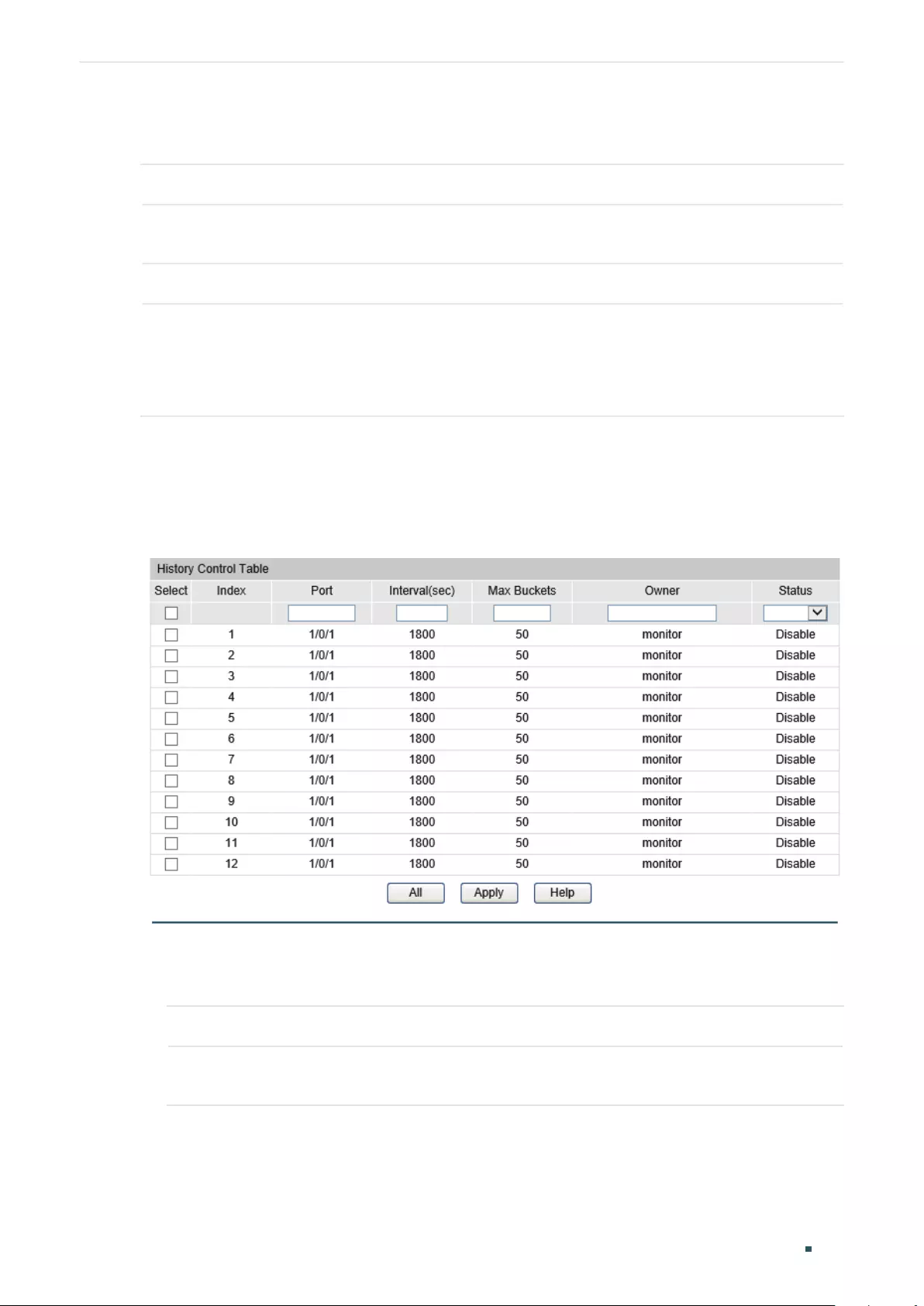
Configuration Guide 954
Configuring SNMP & RMON RMON Configurations
Specify the entry ID, the port to be monitored, and the owner name of the entry. Set the
entry as valid or underCreation, and click Create.
ID Enter the ID of the entry.
Port Click Choose to specify an Ethernet port to be monitored in the entry, or enter the
port number in the format of 1/0/1.
Owner Enter the owner name of the entry with1 to 16 characters.
Status Set the entry as valid or underCreation. By default, it is valid.
Valid: The entry is created and valid.
underCreation: The entry is created but invalid.
5.1.2 Configuring History
Choose the menu SNMP > RMON > History to load the following page.
Figure 5-2 History Control Table
Follow these steps to configure history:
1) Select a history entry, and specify a port to be monitored.
Index Displays the index of history entries. There are 12 history entries all together.
Port Specify a port in 1/0/1 format to be monitored. To change the port, please
enable the entry first.
2) Set the sample interval and the maximum buckets of history entries.
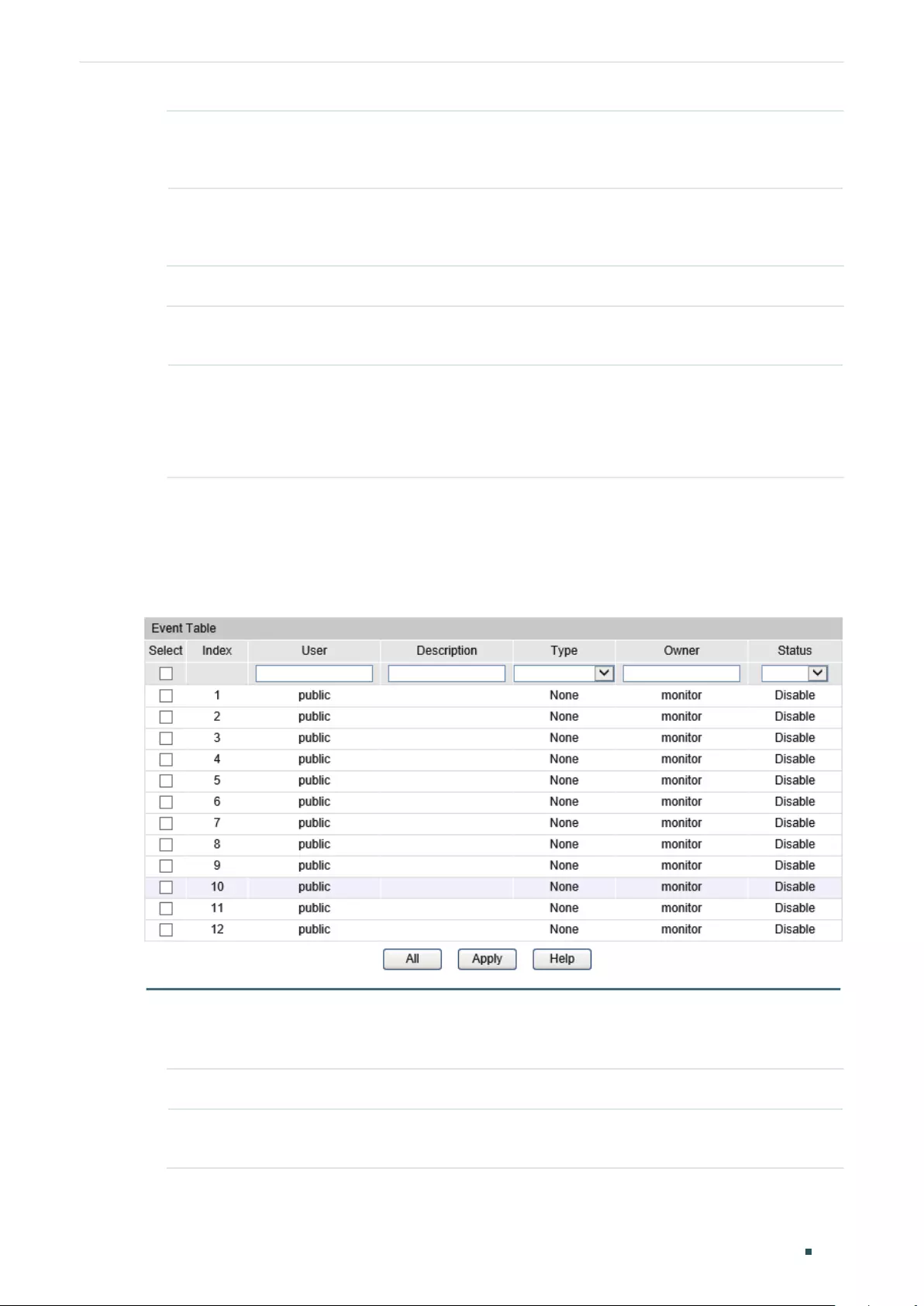
Configuring SNMP & RMON RMON Configurations
Configuration Guide 955
Interval Set the sample interval from 10 to 3600 seconds; the default is 1800
seconds. Every history entry has its own timer. For the monitored port, the
switch collects packet information and generates a record in every interval.
Max Buckets Set the maximum number of records for the history entry. When the number
of records exceeds the limit, the earliest record will be overwritten. The
ranges are from 10 to 130; the default is 50.
3) Enter the owner name, and set the status of the entry. Click Apply.
Owner Enter the owner name of the entry with 1 to 16 characters. By default, it is
monitor.
Status Enable or disable the entry. By default, it is disabled.
Enable: The entry is enabled.
Disable: The entry is disabled.
5.1.3 Configuring Event
Choose the menu SNMP > RMON > Event to load the following page.
Figure 5-3 Event Table
Follow these steps to configure event:
1) Choose an event entry, and set the SNMP User of the entry.
Index Displays the index of event entries. There are 12 event entries all together.
User Enter the SNMP user name or community name of the entry. The name should
be what you have set in SNMP previously. By default, it is public.
2) Set the description and type of the event.

Configuration Guide 956
Configuring SNMP & RMON RMON Configurations
Description Give a description to the event.
Type Specify the action type of the event; then the switch will take the specified
action to deal with the event. By default, the type is None.
None: No action.
Log: The switch records the event in the log, and the NMS should initiate
requests to get notifications.
Notify: The switch initiates notifications to the NMS.
Log&Notify: The switch records the event in the log and sends notifications to
the NMS.
3) Enter the owner name, and set the status of the entry. Click Apply.
Owner Enter the owner name of the entry with 1 to 16 characters. By default, it is
monitor.
Status Enable or disable the entry. By default, it is disabled.
Enable: The entry is enabled.
Disable: The entry is disabled.
5.1.4 Configuring Alarm
Before you begin, please complete configurations of Statistics entries and Event entries,
because the Alarm entries must be associated with Statistics and Event entries.
Choose the menu SNMP > RMON > Alarm to load the following page.
Figure 5-4 Alarm Config
Follow these steps to configure alarm:
1) Select an alarm entry, choose a variable to be monitored, and associate the entry with a
statistics entry.
Index Displays the index of alarm entries. There are 12 alarm entries all together.

Configuring SNMP & RMON RMON Configurations
Configuration Guide 957
Variable Set the alarm variable to be monitored. The switch will monitor the specified
variable in sample intervals and act in the set way when the alarm is triggered.
The default variable is RecBytes.
RecBytes: Total received bytes.
RecPackets: Total received packets.
BPackets: Total broadcast packets.
MPackets: Total multicast packets.
CRC&Align ERR: Packets that range from 64 to 1518 bytes and contain FCS
Error or Alignment Error.
Undersize: Packets that are smaller than 64 bytes.
Oversize: Packets that are larger than 1518 bytes.
Jabbers: Packets that are sent when port collisions occur.
Collisions: Collision times in the network segment.
64, 65-127, 128-255, 256-511, 512-1023, 1024-10240: Total packets of the
specified size.
Statistics Associate the alarm entry with a statistics entry. Then the switch monitors the
specified variable of the statistics entry.
2) Set the sample type, the rising and falling threshold, the corresponding event action,
and the alarm type of the entry.
Sample Type Set the sampling method of the specified variable; the default is absolute.
Absolute: Compare the sampling value against the preset threshold.
Delta: The switch obtains the difference between the sampling values of the
current interval and the previous interval, and then compares the difference
against the preset threshold.
Rising Threshold Set the rising threshold of the variable. When the sampled value exceeds the
threshold, the system will trigger the corresponding Rising Event. The ranges
are from 1 to 2147483647; the default is 100.
Rising Event Specify the index of the event that will be triggered when the sampled value
exceeds the preset threshold.
Falling Threshold Set the falling threshold of the variable. When the sampled value is below
the threshold, the system will trigger the corresponding Falling Event. The
ranges are from 1 to 2147483647; the default is 100.
Falling Event Specify the index of the event that will be triggered when the sampled value is
below the preset threshold.

Configuration Guide 958
Configuring SNMP & RMON RMON Configurations
Alarm Type Specify the alarm type for the entry. By default, the alarm type is all.
Rising: The alarm is triggered only when the sampled value exceeds the rising
threshold.
Falling: The alarm is triggered only when the sampled value is below the falling
threshold.
All: The alarm is triggered when the sampled value exceeds the rising
threshold or is below the falling threshold.
3) Enter the owner name, and set the status of the entry. Click Apply.
Owner Enter the owner name of the entry with 1 to 16 characters. By default, it is
monitor.
Status Enable or disable the entry. By default, it is disabled.
Enable: The entry is enabled.
Disable: The entry is disabled.
5.2 Using the CLI
5.2.1 Configuring Statistics
Step 1 configure
Enter global configuration mode.
Step 2 rmon statistics
index
interface {[ gigabitEthernet
port
] [ ten-gigabitEthernet
port
]} [
owner
owner-name
] [ status { underCreation | valid }]
Configure RMON statistic entries.
index:
Enter the ID of the statistics entry from 1 to 65535 in the format of 1-3 or 5.
port:
Enter the port number in 1/0/1 format to bind it to the entry.
owner-name:
Enter the owner name of the entry with 1 to 16 characters. The default name is
monitor.
underCreation | valid: Enter the status of the entry. UnderCreation indicates that the entry is
created but invalid, while valid indicates the entry is created and valid. By default, it is valid.
Step 3 show rmon statistics [
index
]
Displays the statistics entries and their configurations.
index:
Enter the index of statistics entries that you want to view. The ranges are from 1 to
65535.
Step 4 end
Return to privileged EXEC mode.

Configuring SNMP & RMON RMON Configurations
Configuration Guide 959
Step 5 copy running-config startup-config
Save the settings in the configuration file.
The following example shows how to create two statistics entries on the switch to monitor
port 1/0/1 and 1/0/2 respectively. The owner of the entry is monitor and the entry is valid:
Switch#configure
Switch(config)#rmon statistics 1 interface gigabitEthernet 1/0/1 owner monitor status
valid
Switch(config)#rmon statistics 2 interface gigabitEthernet 1/0/2 owner monitor status
valid
Switch(config)#show rmon statistics
Index Port Owner State
----- ---- ----- -----
1 Gi1/0/1 monitor valid
2 Gi1/0/2 monitor valid
Switch(config)#end
Switch#copy running-config startup-config
5.2.2 Configuring History
Step 1 configure
Enter global configuration mode.
Step 2 rmon history
index
interface { fastEthernet
port
| gigabitEthernet
port
| ten-
gigabitEthernet
port
}
[ interval
seconds
] [ owner
owner-name
] [ buckets
number
]
Configuring RMON history entries.
index:
Enter the index of the history entry from 1 to 12 in the format of 1-3 or 5.
port:
Enter the port number in 1/0/1 format to bind it to the entry.
seconds:
Set the sample interval. The values are from 10 to 3600 seconds; the default is
1800 seconds.
owner-name
:
Enter the owner name of the entry with 1 to 16 characters. The default name is
monitor.
number:
Set the maximum number of records for the history entry. When the number of
records exceeds the limit, the earliest record will be overwritten.
The values are from
10 to
130; the default is 50.

Configuration Guide 960
Configuring SNMP & RMON RMON Configurations
Step 3 show rmon history [
index
]
Displays the specified history entry and related configurations.
index:
Enter the index of history entries that you want to view. The range is 1 to 12, and the
format is 1-3 or 5.
Step 4 end
Return to privileged EXEC mode.
Step 5 copy running-config startup-config
Save the settings in the configuration file.
The following example shows how to create a history entry on the switch to monitor port
1/0/1. Set the sample interval as 100 seconds, max buckets as 50, and the owner as
monitor:
Switch#configure
Switch(config)#rmon history 1 interface gigabitEthernet 1/0/1 interval 100 owner
monitor buckets 50
Switch(config)#show rmon history
Index Port Interval Buckets Owner State
----- --------- ----------- ----------- --------- -----
1 Gi1/0/1 100 50 monitor Enable
Switch(config)#end
Switch#copy running-config startup-config
5.2.3 Configuring Event
Step 1 configure
Enter global configuration mode.

Configuring SNMP & RMON RMON Configurations
Configuration Guide 961
Step 2 rmon event
index
[ user
user-name
] [ description
description
] [ type { none | log | notify |
log-notify }] [ owner
owner-name
]
Configuring RMON event entries.
index:
Enter the index of the event entry from 1 to12 in the format of 1-3 or 5.
user-name:
Enter the SNMP user name or community name of the entry. The name should
be what you have set in SNMP previously. The default name is public.
description:
Give a description to the entry with 1 to 16 characters. By default, the
description is empty.
none | log | notify | log-notify
:
Specify the action type of the event; then the switch will take
the specified action to deal with the event. By default, the type is none. None indicates
the switch takes no action, log indicates the switch records the event, notify indicates the
switch sends notifications to the NMS, and log-notify indicates the switch records the event
and sends notifications to the NMS.
owner-name
:
Enter the owner name of the entry with 1 to 16 characters. The default name is
monitor.
Step 3 show rmon event [
index
]
Displays the specified event entry and related configurations.
index:
Enter the index of event entries that you want to view. The range is 1 to 12, and the
format is 1-3 or 5.
Step 4 end
Return to privileged EXEC mode.
Step 5 copy running-config startup-config
Save the settings in the configuration file.
The following example shows how to create an event entry on the switch. Set the user
name as admin, the event type as Notify (set the switch to initiate notifications to the NMS),
and the owner as monitor:
Switch#configure
Switch(config)#rmon event 1 user admin description rising-notify type notify owner
monitor
Switch(config)#show rmon event
Index User Description Type Owner State
----- ---- ----------- ---- ----- -----
1 admin rising-notify Notify monitor Enable
Switch(config)#end
Switch#copy running-config startup-config

Configuration Guide 962
Configuring SNMP & RMON RMON Configurations
5.2.4 Configuring Alarm
Step 1 configure
Enter global configuration mode.
Step 2 rmon alarm
index
{ stats-index
sindex
} [ alarm-variable { revbyte | revpkt | bpkt | mpkt | crc-
align | undersize | oversize | jabber | collision | 64 | 65-127 | 128-255 | 256-511 | 512-1023
| 1024-10240}] [ s-type {absolute | delta}] [ rising-threshold
r-hold
] [ rising-event-index
r-event
] [ falling-threshold
f-hold
] [ falling-event-index
f-event
] [ a-type {rise | fall | all} ] [
owner
owner-name
] [ interval
interval
]
Configuring RMON alarm entries.
index:
Enter the index of the alarm entry from 1 to12 in the format of 1-3 or 5.
sindex:
Set the index of the related statistics entry from 1 to 65535.
revbyte | revpkt | bpkt | mpkt | crc-align | undersize | oversize | jabber | collision | 64 | 65- 127
| 128-255 | 256-511 | 512-1023 | 1024-10240:
Choose an alarm variable to monitor. The
switch will monitor the specified variable in sample intervals and act in the set way when the
alarm is triggered. The default variable is revbyte.
revbyte means total received bytes; revpkt means total received packets; bpkt means total
broadcast packets. mpkt means total multicast packets; crc-align means packets that range
from 64 to 1518 bytes and contain FCS Error or Alignment Error; undersize means packets
that are smaller than 64 bytes; oversize means packets that are larger than 1518 bytes;
jabber means packets that are sent when port collisions occur; collision means the collision
times in the network segment; 64 | 65-127 | 128-255 | 256-511 | 512-1023 | 1024-10240
means total packets of the specified size.
absolute | delta
:
Choose the sampling mode. The default is absolute. In the absolute mode,
the switch compares the sampling value against the preset threshold; in the delta mode, the
switch obtains the difference between the sampling values of the current interval and the
previous interval, and then compares the difference against the preset threshold.
r-hold
:
Enter the rising threshold from 1 to 2147483647; the default is 100.
r-event:
Enter the event entry index from 1 to 12 to bind it to the rising threshold. The event
entry will be triggered when the sampling value exceeds the preset threshold.
f-hold:
Enter a falling threshold from 1 to 2147483647; the default is 100.
f-event:
Enter the event entry index from 1 to 12 to bind it to the falling threshold. The event
entry will be triggered when the sampling value goes below the preset threshold.
rise | fall | all: Choose an alarm type; the default is all. Rise indicates that the alarm is triggered
only when the sampled value exceeds the rising threshold. Fall indicates that the alarm is
triggered only when the sampled value is below the falling threshold. All indicates that the
alarm is triggered when the sampled value exceeds the rising threshold or is below the falling
threshold.
owner-name:
Enter the owner name of the entry using 1 to 16 characters. The default name
is monitor.
interval:
Set the sampling interval. The value ranges from 10 to 3600 seconds; the default is
1800 seconds.

Configuring SNMP & RMON RMON Configurations
Configuration Guide 963
Step 3 show rmon alarm [
index
]
Displays the specified alarm entry and related configurations.
index:
Enter the index of alarm entries that you want to view. The range is 1 to 12, and the
format is 1-3 or 5.
Step 4 end
Return to privileged EXEC mode.
Step 5 copy running-config startup-config
Save the settings in the configuration file.
The following example shows how to set an alarm entry to monitor BPackets on the switch.
Set the related Statistics entry ID as 1, the sample type as Absolute, the rising threshold
as 3000, the related rising event entry index as 1, the falling threshold as 2000, the related
falling event index as 2, the alarm type as all, the notification interval as 10 seconds, and
the owner of the entry as monitor:
Switch#configure
Switch(config)#rmon alarm 1 stats-index 1 alarm-variable bpkt s-type absolute rising-
threshold 3000 rising-event-index 1 falling-threshold 2000 falling-event-index 2 a-type
all interval 10 owner monitor
Switch(config)#show rmon alarm
Index-State: 1-Enabled
Statistics index: 1
Alarm variable: BPkt
Sample Type: Absolute
RHold-REvent: 3000-1
FHold-FEvent: 2000-2
Alarm startup: All
Interval: 10
Owner: monitor
Switch(config)#end
Switch#copy running-config startup-config

Configuration Guide 964
Configuring SNMP & RMON Configuration Example
6 Configuration Example
6.1 Network Requirements
A company that deploys NMS to monitor the operation status of TP-Link switches has
requirements as follows:
1) Monitor traffic flow of specified ports, and send notifications to the NMS when the
actual rate of transmitting and receiving packets exceeds the preset threshold.
2) Monitor the sending status of specified ports, and regularly collect and save data for
follow-up checks. Specifically, during the sample interval, the switch should notify the
NMS when the number of packets transmitted and received on the port exceeds the
preset threshold; the switch should record but not notify the NMS when the number of
packets transmitted and received is below the threshold.
6.2 Configuration Scheme
1) Set a limit on the rate of the specified ports, and then enable SNMP on Switch A.
Configure SNMP and Notification, and enable Trap notifications on the ports. Switch
A can then send notifications to the NMS when the actual rate exceeds the preset
threshold.
2) After SNMP and Notification configurations, you need to create statistic entries on the
ports to monitor the real-time transmitting and receiving of packets and create history
entries to regularly collect and save related data. Create two event entries: one is the
notify type used to notify the NMS, the other is the log type used to record related
events. In addition, create an alarm entry to monitor BPackets (Broadcast Packets), set
the rising threshold and falling threshold, and bind the rising event to the notify event
entry, and the falling event to the log event entry.

Configuring SNMP & RMON Configuration Example
Configuration Guide 965
6.3 Network Topology
As shown in the following figure, the NMS host with IP address 172.168.1.222 is connected
to the core switch, Switch B. On Switch A, ports 1/0/1 and 1/0/2 are monitored by the NMS;
port 1/0/3 is connected to Switch B. And port 1/0/3 and the NMS are able to reach one
another.
Figure 6-1 Network Topology
Gi1/0/1
NMS
Switch B
Switch A
IP: 172.168.1.222
Gi1/0/2
Gi1/0/3
Demonstrated with T2600G-28TQ, this chapter provides configuration procedures in two
ways: using the GUI and using the CLI.
6.4 Using the GUI
Configuring Rate Limit on ports
Configure the rate limit on required ports. For detailed configuration, please refer to
Configuring QoS.
Configuring SNMP
1) Choose SNMP > SNMP Config > Global Config to load the following page. Enable
SNMP, and set the Remote Engine ID as 123456789a. Click Apply.

Configuration Guide 966
Configuring SNMP & RMON Configuration Example
Figure 6-2 Enabling SNMP
2) Choose SNMP > SNMP Config > SNMP View to load the following page. Name the
SNMP view as View, set MIB Object ID as 1 (which means all functions), and set the view
type as Include. Click Create.
Figure 6-3 SNMP View Configuration
3) Choose SNMP > SNMP Config > SNMP Group to load the following page. Create a
group with the name of nms-monitor, choose SNMPv3 and enable authentication and
privacy, and add View to Read View and Notify View. Click Create.
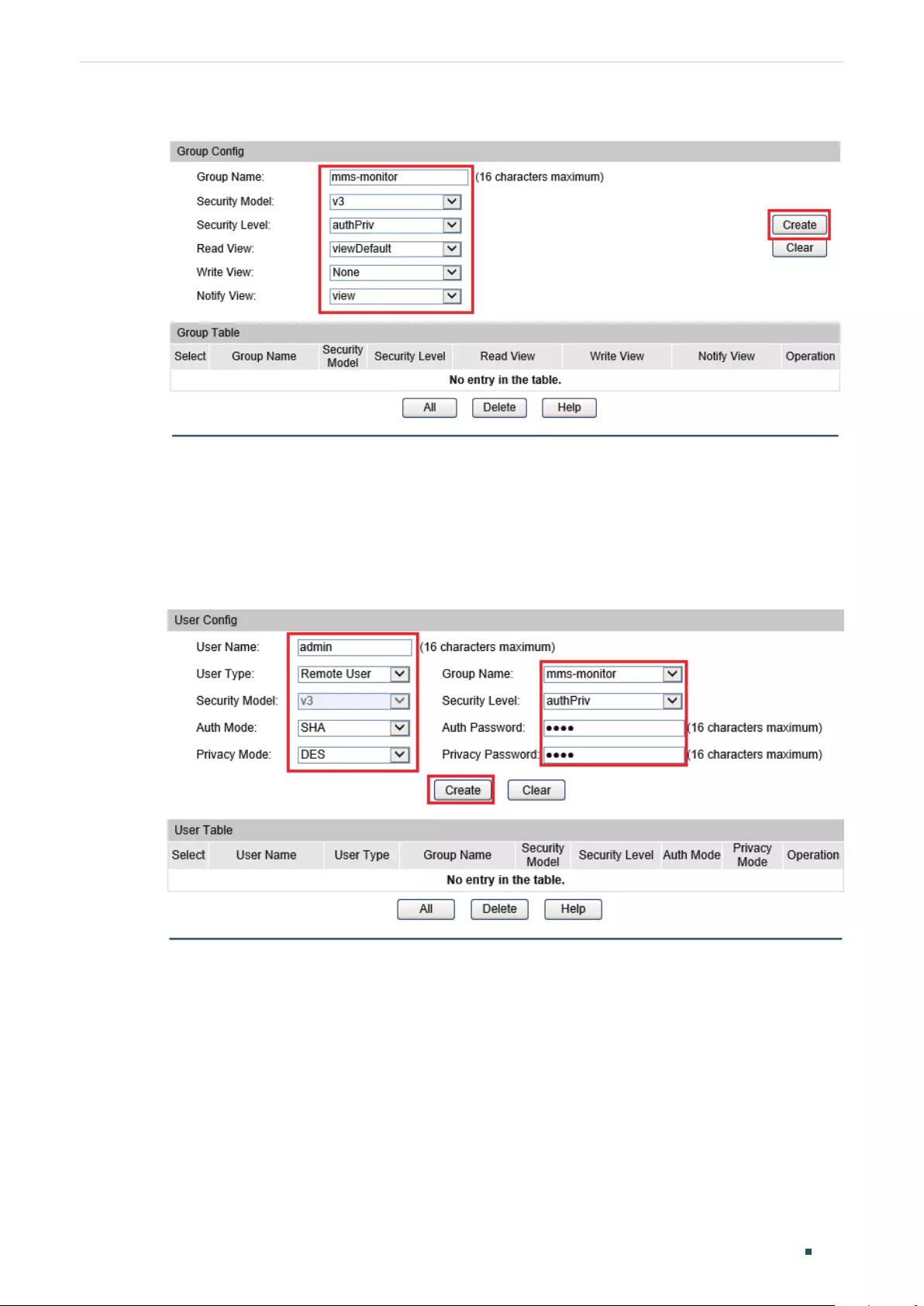
Configuring SNMP & RMON Configuration Example
Configuration Guide 967
Figure 6-4 SNMP Group Configuration
4) Choose SNMP > SNMP Config > SNMP User to load the following page. Create a user
named admin for the NMS, set the user type as Remote User and specify the group
name. Set the Security Model and Security Level in accordance with those of the group
nms-monitor. Choose SHA authentication algorithm and DES privacy algorithm, and set
corresponding passwords. Click Create.
Figure 6-5 User Config
5) Choose SNMP > Notification > Notification Config to load the following page. Specify
the IP address of the NMS host and the port of the host for transmitting notifications.
Set the User, Security Model and Security Level according to configurations of the
SNMP User. Choose the type as Inform, and set the retry times as 3, with the timeout
period as 100 seconds. Click Create.

Configuration Guide 968
Configuring SNMP & RMON Configuration Example
Figure 6-6 Notification Configuration
6) Click Save Config to save the settings.
Enabling Bandwith-control Trap
The feature can be configured only with the CLI. You can enter the following commands
under the CLI configuration mode:
Switch>enable Enter Privileged EXEC Mode.
Switch#config Enter global configuration mode.
Switch(config)#snmp-server traps bandwidth-control Enable Bandwitch-control
trap.
Configuring RMON
1) Choose SNMP > RMON > Statistics to load the following page. Create two entries and
bind them to ports 1/0/1 and 1/0/2 respectively. Set the owner of the entries as monitor
and the status as valid.
Figure 6-7 Configuring Entry 1

Configuring SNMP & RMON Configuration Example
Configuration Guide 969
Figure 6-8 Configuring Entry 2
2) Choose the menu SNMP > RMON > History to load the following page. Configure
entries 1 and 2. Bind entries 1 and 2 to ports 1/0/1 and 1/0/2 respectively, and set the
Interval as 100 seconds, Max Buckets as 50, the owner of the entries as monitor, and
the status as Enable.
Figure 6-9 History Configuration
3) Choose the menu SNMP > RMON > Event to load the following page. Configure entries
1 and 2. For entry 1, set the SNMP user name as admin, type as Notify, description as
“rising notify”, owner as monitor, and status as enable. For entry 2, set the SNMP user
name as admin, type as Log, description as “falling log”, owner as monitor, and status as
enable.
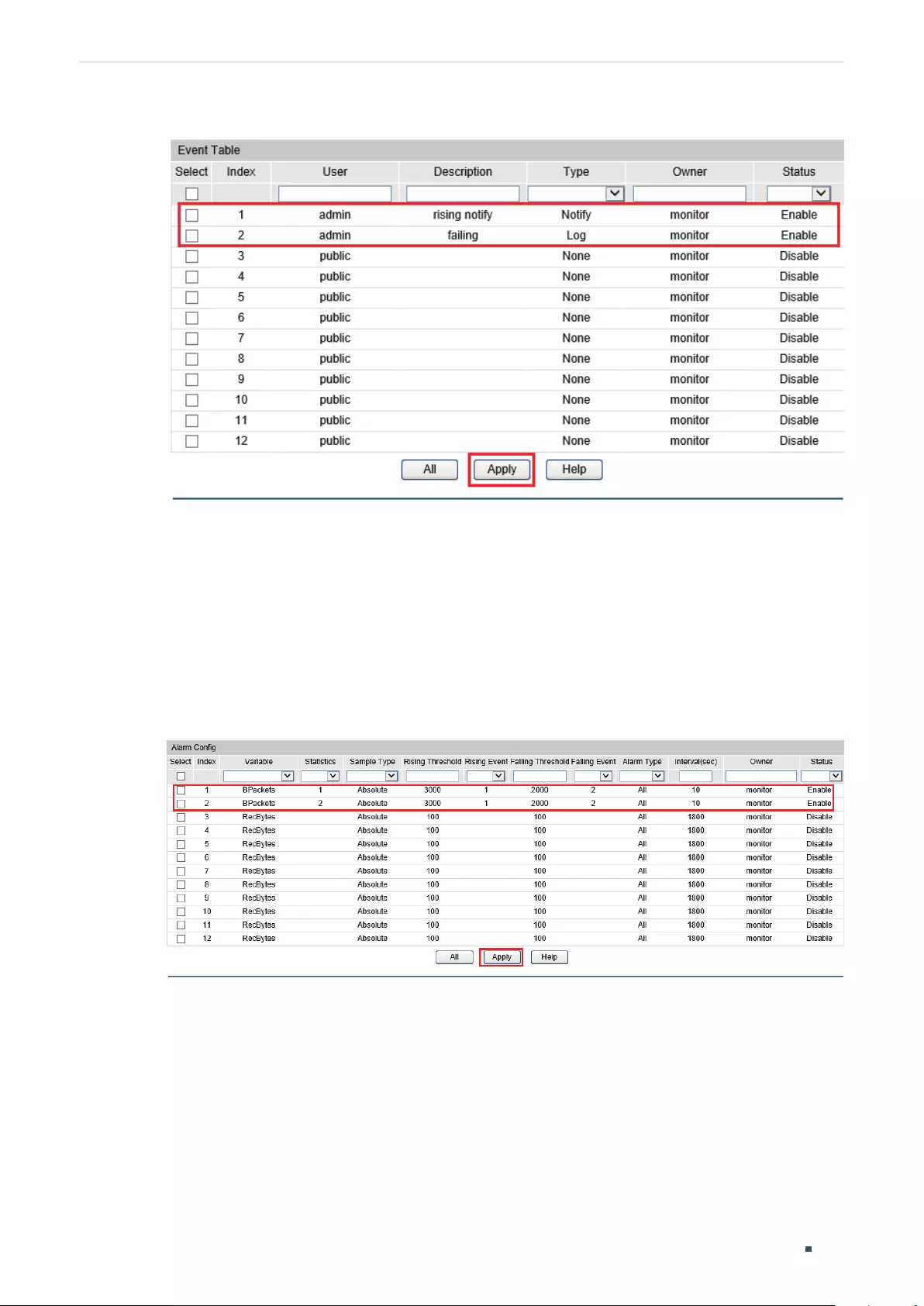
Configuration Guide 970
Configuring SNMP & RMON Configuration Example
Figure 6-10 Event Configuration
4) Choose SNMP > RMON > Alarm to load the following page. Configure entries 1 and 2.
For entry 1, set the alarm variable as BPackets, related statistics entry ID as 1 (bound
to port 1/0/1), the sample type as Absolute, the rising threshold as 3000, associated
rising event entry ID as 1 (which is the notify type), the falling threshold as 2000, the
associated falling event entry ID as 2 (which is the log type), the alarm type as all, the
interval as 10 seconds, the owner name as monitor. For entry 2, set the associated
statistics entry ID as 2 (bound to port 1/0/2). Other configurations are the same as
those of entry 1.
Figure 6-11 Alarm Configuration
5) Click Save Config to save settings.
6.5 Using the CLI
Configuring Rate Limit on ports
Configure the rate limit on required ports. For detailed configuration, please refer to
Configuring QoS.

Configuring SNMP & RMON Configuration Example
Configuration Guide 971
Configuring SNMP
1) Enable SNMP and specify the remote engine ID.
Switch#configure
Switch(config)#snmp-server
Switch(config)#snmp-server engineID remote 123456789a
2) Create a view with the name View; set the MIB Object ID as 1 (which represents all
functions), and the view type as Include.
Switch(config)#snmp-server view View 1 include
3) Create a group of SNMPv3 with the name of nms-monitor. Enable Auth Mode and
Privacy Mode, and set the view as read View and notify view.
Switch(config)#snmp-server group nms-monitor smode v3 slev authPriv read View
notify View
4) Create an SNMP user with the name admin. Set the user as a remote user and configure
the security mode and security level based on the group. Set the Auth Mode as SHA
algorithm, password as 1234, the Privacy Mode as DES, and password as 1234.
Switch(config)#snmp-server user admin remote nms-monitor smode v3 slev authPriv
cmode SHA cpwd 1234 emode DES epwd 1234
5) To configure Notification, specify the IP address of the NMS host and UDP port. Set the
User, Security Model and Security Level according to configurations of the SNMP User.
Choose the type as Inform, and set the retry times as 3, and the timeout period as 100
seconds.
Switch(config)#snmp-server host 172.168.1.222 162 admin smode v3 slev authPriv
type inform retries 3 timeout 100
Enable Bandwith-control Trap
Switch(config)#snmp-server traps bandwidth-control
Configuring RMON
1) Create two Statistics entries to monitor ports 1/0/1 and 1/0/2 respectively. The owner
of the entries is set as monitor, and the status is set as valid.
Switch(config)#rmon statistics 1 interface gigabitEthernet 1/0/1 owner monitor status
valid
Switch(config)#rmon statistics 2 interface gigabitEthernet 1/0/2 owner monitor status
valid
2) Create two history entries and bind them to ports 1/0/1 and 1/0/2 respectively. Set the
sample interval as 100 seconds, max buckets as 50, and the owner as monitor.
Switch(config)#rmon history 1 interface gigabitEthernet 1/0/1 interval 100 owner
monitor buckets 50

Configuration Guide 972
Configuring SNMP & RMON Configuration Example
Switch(config)#rmon history 2 interface gigabitEthernet 1/0/2 interval 100 owner
monitor buckets 50
3) Create two event entries named admin, which is the SNMP user name. Set entry 1 as
the Notify type and its description as “rising notify”. Set entry 2 as the Log type and its
description as “falling log”. Set the owner of them as monitor.
Switch(config)#rmon event 1 user admin description rising-notify type notify owner
monitor
Switch(config)#rmon event 2 user admin description falling-log type log owner monitor
4) Create two alarm entries. For entry 1, set the alarm variable as BPackets, associated
statistics entry ID as 1 (bound to port 1/0/1), the sample type as Absolute, the rising
threshold as 3000, the associated rising event entry ID as 1 (Notify type), the falling
threshold as 2000, the associated falling event entry ID as 2 (the log type), the alarm
type as all, the interval as 10 seconds, and the owner name as monitor. For entry
2, set the associated statistics entry ID as 2 (bound to port 1/0/2), while all other
configurations are the same as those of entry 1.
Switch(config)#rmon alarm 1 stats-index 1 alarm-variable bpkt s-type absolute rising-
threshold 3000 rising-event-index 1 falling-threshold 2000 falling-event-index 2 a-type
all interval 10 owner monitor
Switch(config)#rmon alarm 2 stats-index 2 alarm-variable bpkt s-type absolute rising-
threshold 3000 rising-event-index 1 falling-threshold 2000 falling-event-index 2 a-type
all interval 10 owner monitor
Verify the Configurations
Verify global SNMP configurations:
Switch(config)#show snmp-server
SNMP agent is enabled.
0 SNMP packets input
0 Bad SNMP version errors
0 Unknown community name
0 Illegal operation for community name supplied
0 Encoding errors
0 Number of requested variables
0 Number of altered variables
0 Get-request PDUs
0 Get-next PDUs
0 Set-request PDUs
0 SNMP packets output

Configuring SNMP & RMON Configuration Example
Configuration Guide 973
0 Too big errors(Maximum packet size 1500)
0 No such name errors
0 Bad value errors
0 General errors
0 Response PDUs
0 Trap PDUs
Verify SNMP engine ID:
Switch(config)#show snmp-server engineID
Local engine ID : 80002e5703000aeb132397
Remote engine ID: 123456789a
Verify SNMP view configurations:
Switch(config)#show snmp-server view
No. View Name Type MOID
--- -------------- ------- -------------------
1 viewDefault include 1
2 viewDefault exclude 1.3.6.1.6.3.15
3 viewDefault exclude 1.3.6.1.6.3.16
4 viewDefault exclude 1.3.6.1.6.3.18
5 View include 1
Verify SNMP group configurations:
Switch(config)#show snmp-server group
No. Name Sec-Mode Sec-Lev Read-View Write-View Notify-View
--- ------------- ----------- ---------- --------------- ------------ ----------
1 nms-monitor v3 authPriv View View
Verify SNMP user configurations:
Switch(config)#show snmp-server user

Configuration Guide 974
Configuring SNMP & RMON Configuration Example
No. U-Name U-Type G-Name S-Mode S-Lev A-Mode P-Mode
--- ----------- ------ ------ ------ ----- ------ ------
1 admin remote nms-monitor v3 authPriv SHA DES
Verify SNMP host configurations:
Switch(config)#show snmp-server host
No. Des-IP UDP Name SecMode SecLev Type Retry Timeout
--- ---------------- ----- -------- --------- ---------- ------- ----- --------
1 172.168.1.222 162 admin v3 authPriv inform 3 100
Verify RMON statistics configurations:
Switch(config)#show rmon statistics
Index Port Owner State
----- ---------- --------- -------
1 Gi1/0/1 monitor valid
2 Gi1/0/2 monitor valid
Verify RMON history configurations:
Switch(config)#show rmon history
Index Port Interval Buckets Owner State
----- --------- -------- --------- ---------- ---------
1 Gi1/0/1 100 50 monitor Enable
2 Gi1/0/2 100 50 monitor Enable
Verify RMON event configurations:
Switch(config)#show rmon event
Index User Description Type Owner State
----- ------ ----------- -------- ---------- ----------
1 admin rising-notify Notify monitor Enable
2 admin falling-log Log monitor Enable

Configuring SNMP & RMON Configuration Example
Configuration Guide 975
Verify RMON alarm configurations:
Switch(config)#show rmon alarm
Index-State: 1-Enabled
Statistics index: 1
Alarm variable: BPkt
Sample Type: Absolute
RHold-REvent: 3000-1
FHold-FEvent: 2000-2
Alarm startup: All
Interval: 10
Owner: monitor
Index-State: 2-Enabled
Statistics index: 2
Alarm variable: BPkt
Sample Type: Absolute
RHold-REvent: 3000-1
FHold-FEvent: 2000-2
Alarm startup: All
Interval: 10
Owner: monitor

Configuration Guide 976
Configuring SNMP & RMON Appendix: Default Parameters
7 Appendix: Default Parameters
Default settings of SNMP are listed in the following table.
Table 7-1 Default Global Config Settings
Parameter Default Setting
SNMP Disable
Local Engine ID Automatically
Remote Engine ID None
Table 7-2 Default SNMP View Settings
Parameter Default Setting
View Name None
MIB Object ID None
View Type Include
Table 7-3 Default SNMP View Table Settings
View Name View Type MIB Object ID
viewDefault Include 1
viewDefault Exclude 1.3.6.1.6.3.15
viewDefault Exclude 1.3.6.1.6.3.16
viewDefault Exclude 1.3.6.1.6.3.18
Table 7-4 Default Group Settings
Parameter Default Setting
Group Name None
Security Model v1
Security Level noAuthNoPriv
Read View viewDefault
Write View None
Notify View None

Configuring SNMP & RMON Appendix: Default Parameters
Configuration Guide 977
Table 7-5 Default User Settings
Parameter Default Setting
User Name None
User Type Local User
Group Name None
Security Model v1
Security Level noAuthNoPriv
Auth Mode None
Auth Password None
Privacy Mode None
Privacy Password None
Table 7-6 Default Community Settings
Parameter Default Setting
Community Name None
Access read-only
MIB View viewDefault
Default settings of Notification are listed in the following table.
Table 7-7 Default Host Config Settings
Parameter Default Setting
IP Address None
UDP Port 162
User None
IP Mode IPv4
Security Model v1
Security Level noAuthNoPriv
Type Trap
Retry None in trap mode; 3 times in Inform mode.
Timeout None in trap mode; 100 seconds in Inform mode.

Configuration Guide 978
Configuring SNMP & RMON Appendix: Default Parameters
Table 7-8 Default Statistics Config Settings
Parameter Default Setting
ID None
Port None
Owner None
IP Mode valid
Table 7-9 Default Settings for History Entries
Parameter Default Setting
Port 1/0/1
Interval 1800 seconds
Max Buckets 50
Owner monitor
Status Disable
Table 7-10 Default Settings for Event Entries
Parameter Default Setting
User public
Description None
Type None
Owner monitor
Status Disable
Table 7-11 Default Settings for Alarm Entries
Parameter Default Setting
Variable RecBytes
Statistics None
Sample Type Absolute
Rising Threshold 100
Rising Event None
Falling Threshold 100
Falling Event None
Alarm Type All
Interval 1800 seconds
Owner monitor

Configuring SNMP & RMON Appendix: Default Parameters
Configuration Guide 979
Parameter Default Setting
Status Disable



























